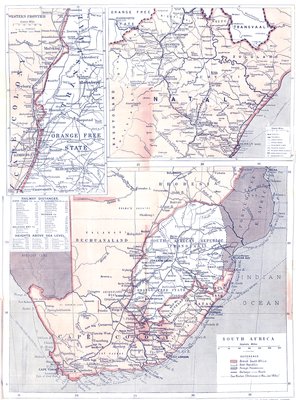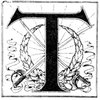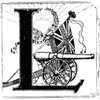*** START OF THE PROJECT GUTENBERG EBOOK 48534 ***
The cover image was created by the transcriber and is placed in the public domain.
[Pg i]
[Pg ii]
WITH THE FLAG TO PRETORIA.

S. Begg.]
HER MAJESTY THE QUEEN VISITING HER WOUNDED SOLDIERS.
The Queen has throughout the war shown the greatest solicitude for the
wounded. On March 22, 1900, Her Majesty paid a visit to the Herbert
Hospital at Woolwich, and personally handed gifts of flowers to over
a hundred wounded men, in each case accompanying the gift with a few
words of sympathy, which often had reference to the services of the
particular man whom she addressed. The patients included survivors from
Colenso, Spion Kop, &c. The Irish soldiers, whose gallantry had been
specially noteworthy, were favoured with special notice. The Queen was
accompanied by the Princess Christian and the Princess Victoria of
Schleswig-Holstein.
[Pg iii]
With the Flag
to Pretoria
A History of the Boer War of 1899-1900
By H. W. WILSON
Author of "Ironclads in Action," &c. &c.
ILLUSTRATED MAINLY FROM PHOTOGRAPHS AND AUTHENTIC SKETCHES
TAKEN IN SOUTH AFRICA
Vol. I.
LONDON
Published by HARMSWORTH BROTHERS, Limited
1900
[Pg iv]
[Pg v]
The chief point of interest in the South African war, apart from
its political aspect, will always be that it was the first great
struggle fought out under the new conditions which smokeless powder
has introduced. No invention has made a greater change in the art
of war than this; the revolution is so profound that it can only be
compared with that brought about by the general adoption of firearms
four hundred years or more ago. So late as the Spanish-American war
of 1898 a large part of the United States army was equipped with the
Springfield rifle, firing smoke-producing powder, so that in that
war, in spite of the fact that the Spanish Army was supplied with the
Mauser, the full consequences of the revolution could not be observed
and ascertained. The British Army, when it took the field in October,
1899, was face to face with factors the precise effect of which could
only be conjectured. Magazine, or, to give them their older name,
"repeating," rifles had been employed as far back as the American Civil
War of 1861-5, though they were in every way vastly inferior to our
modern Mausers and Lee-Metfords. But smokeless powder was a distinctly
novel element.
It is easy to ascribe our defeats in the early part of the war, as some
have ascribed them, to the "stupidity" of the British officers and
generals. At bottom, however, it would seem that much of this unsuccess
was due to the new conditions of war, coupled with the Boer's inherited
capacity for taking cover and his absolute knowledge of the country.
Again and again our men came suddenly and almost without notice under
a deluge of bullets from perfectly invisible rifles. When once engaged
in this manner it was difficult for them to go forward and dangerous
to retreat. There was no means of guessing the strength of the foe.
No dense clouds of smoke revealed at once his location and the exact
volume of his fire. It was uncertain whether we had to deal with 500
men using magazine fire, or with 5,000 firing in a leisurely manner.
There may have been a neglect of reconnaissance, yet against troops
thus concealed personal reconnaissance repeatedly failed. On their side
the Boers had no such difficulty to face in fighting us. All through
our earlier battles we disdained the use of cover and often advanced to
the attack in comparatively close formations—a splendid target.
The same invisibility which marked the Boer riflemen marked also their
artillery, which was not massed, but scattered gun by gun, wide apart
and artfully concealed. As one result of this disposition, we seldom
succeeded in silencing the Boer weapons; but, on the other hand, except
at Spion Kop, they inflicted trivial loss upon us. The enemy's most
effective gun was the "Pom-Pom," which, though it caused infinitesimal
loss of life, was especially dreaded by our soldiers for the great
rapidity of its discharge. The frequent flashes from its muzzle,
however, rendered it comparatively easy to locate and to put out of
action.
It has been often debated whether as science progresses war grows
more bloody. A learned Russian, M. Bloch, had argued, before this
struggle began, that the deadliness of modern weapons rendered mutual
annihilation of the two combatants probable. It need scarcely be said
that this forecast has been disproved by events. There has been nothing
in the present war in the least comparable with the hideous butchery of
Borodino, when, in 1812, with the old flint-lock smooth-bore musket and
smooth-bore cannon, over 30,000 French were killed or wounded out of
125,000, and over 40,000 Russians out of 110,000.
Excluding prisoners, in no case did the British losses in battle reach
one tenth of the force engaged, and in the Spion Kop fighting, where
the heaviest casualties were incurred, they were spread over a week.
Another striking feature is the low proportion of killed. Usually in
the past the killed have numbered one-third to one fourth of the total
wounded. In this war they have generally been from one fifth to one
tenth, and sometimes an even lower fraction, as a result of the use
of the small-bore[Pg vi] bullet. Not only so, but an enormous number of the
wounded have recovered. Thus, taking the Casualty Return of July 11,
we find that of over 12,000 wounded only 695 have died. In Napoleon's
day the proportion would have been more like 5,000, and in the era of
the Franco-Prussian war 3,000. Clearly, then, the risk to life in war
is not increasing. Disease is as deadly as ever, but it may safely be
said that much of our loss would have been preventable with a better
hospital organisation.
We have been asked by several correspondents to set forth in a short
table the losses in the battles recorded in the present volume, and we
take the opportunity of doing so, adding a rough estimate of the Boer
force opposed. The Boer losses, unhappily, cannot be ascertained with
the slightest accuracy, and even the estimates of their armies are
largely conjectural. It should be noted that only combatants—cavalry,
artillery, and infantry—are included in our figures, and that
deductions are made for details absent at the base, for the sick, and
for men not present for duty. The numbers in one or two instances
differ slightly from those of the text of the work, the latest official
returns necessarily differing in some cases from the figures obtained
on the battlefield.
| Battle of |
Date. |
Killed. |
Wounded. |
Prisoners and Missing. |
Total Casualties |
British Force Engaged |
Boer Force Engaged |
| Officers. |
Men. |
Officers. |
Men. |
Officers. |
Men. |
| Dundee |
Oct. 20. |
8 |
40 |
11 |
84 |
25 |
306 |
474 |
3,400 |
7,000 |
| Elandslaagte |
Oct. 21. |
5 |
50 |
30 |
169 |
0 |
4 |
258 |
3,500 |
2,000 |
| Rietfontein |
Oct. 24. |
1 |
11 |
6 |
98 |
0 |
2 |
118 |
5,100 |
7,000? |
| Farquhar's Farm and Nicholson's Nek |
Oct. 30. |
6 |
57 |
9 |
244 |
43 |
925 |
1,284 |
10,000 |
20,000 |
| Belmont |
Nov. 23. |
3 |
50 |
25 |
220 |
0 |
0 |
298 |
8,000 |
3,000? |
| Willow Grange |
Nov. 23. |
0 |
11 |
1 |
66 |
1 |
8 |
87 |
3,500 |
2,000 |
| Enslin |
Nov. 25. |
3 |
13 |
6 |
163 |
0 |
9 |
194 |
7,500 |
2,500 |
| Modder River |
Nov. 28. |
4 |
66 |
20 |
393 |
0 |
2 |
485 |
9,000 |
8,000 |
| Stormberg |
Dec. 10. |
0 |
32 |
7 |
51 |
13 |
619 |
722 |
2,500 |
1,000? |
| Magersfontein |
Dec. 11. |
23 |
148 |
45 |
646 |
0 |
108 |
970 |
12,500 |
10,000 |
| Colenso |
Dec. 15. |
7 |
128 |
43 |
719 |
21 |
207 |
1,125 |
15,000 |
10,000 |
| Week of Battles and Spion Kop |
Jan. 17-24. |
27 |
245 |
53 |
1,050 |
7 |
351 |
1,733 |
17,500 |
12,000 |
| Vaal Krantz |
Feb. 5-7. |
2 |
23 |
18 |
326 |
0 |
5 |
374 |
15,000 |
10,000 |
Some remarks appear to be called for as to the lessons to be derived
from the war, and the directions in which some modification of our
present military system and methods may seem desirable. These remarks
will fitly find a place at the conclusion of our work. In the meantime
let us not forget that if errors of judgment have been committed, they
have been committed by men whose zeal and patriotism has never been
doubted. We cannot refrain, however, from alluding here to the greatest
of all the lessens which this war has taught, not us alone, but all the
world—the solidarity of the Empire. And for that great demonstration
what sacrifice was not worth making!
ERRATA.
p. 4, note beneath top illustration, for "February 26"
read "February 27."
p. 6, note beneath illustration at foot of page, for
"74th regiment" read "94th regiment."
p. 16, note beneath second illustration, for "£250,000"
read "£25,000."
p. 35, line 4 from bottom, for "Dublin Fusiliers" read
"Royal Irish Fusiliers."
p. 108, note beneath portrait of Col. Long, for
"mortally wounded" read "severely wounded."
p. 129, line 15, for "1st Worcesters" read "2nd
Berkshires."
p. 151, line 15, for "Lieutenant Taylor of the Navy"
read "Lieutenant Taylor of the 2nd Yorkshire Light
Infantry."
p. 204, first paragraph: The identity of the prisoner here
referred to has not been established, but the Editor
has received statements which have satisfied him that
ex-Sergeant-Major Greener, of the Royal Engineers,
was never with the Boer army, and that the strong
expression used with regard to him was misapplied.
p. 248, line 39, for "ankle-deep" read "axle-deep."
p. 275, lines 3 and 4, delete the words, "Grey though he
was, this was his first action." (Major Childe, whose
age was 46, had served in the Egyptian campaign of
1882.)
p. 277, note beneath portrait, for "Sir Reginald Clare
Hart, K.C.B., &c." read "Major-General A. FitzRoy
Hart, C.B., commanding the 5th Brigade of the 10th
Division" and cancel remainder of note.
[Pg vii]
|
PAGES |
| Chapter I.—THE EXPLOSION. Oct. 11, 1899. And events previous thereto. |
| The Boer Ultimatum—Intrigues against British supremacy—Great Britain's interest in the Dutch Republics—Common interests of the white peoples—Early history of Cape Colony—Unpopularity of the Dutch East India Company—British capture Capetown—"The Great Trek"—England recognises the Republics—Their attitude towards us—Sir Bartle Frere—Majuba—The Outlanders—The Jameson raid—Kruger—His character—Sir Alfred Milner—The Bloemfontein conference—Transvaal refuses England's demands—War |
3-16 |
| Chapter II.—THE OVERRUNNING OF NORTHERN NATAL. Oct. 11-Oct. 27, 1899. |
| Hurried Preparations for War—The Reserves Mobilised—Enthusiasm of the British Public—Strength of the Forces in Natal and Cape Colony—Strength of the Enemy—The Attack Delayed—Disposition of the Boer Forces—Positions of the British at Dundee and Ladysmith—Battle of Dundee—Symons wounded—Storming of Talana Hill—The Treacherous White Flag—Yule's March—Battle of Elandslaagte—British and Boer Losses—"Remember Majuba!"—Action at Rietfontein—The Boer Tactics—White decides to hold Ladysmith |
17-34 |
| Chapter III.—THE INVESTMENT OF LADYSMITH, MAFEKING, AND KIMBERLEY. Oct. 27-Nov. 1899. |
| The Boers seize the heights dominating Ladysmith—The Battle of Farquhar's Farm—White withdraws to save the town—The guns brought off—Dramatic advent of the Bluejackets—Loss of Carleton's column—Neglect of precautions at Ladysmith—The town beleaguered—Condition of affairs on the Western Frontier—Doubtful attitude of the Schreiner Ministry—First act of war—Attempts to capture Mafeking—The Boers seize Vryburg—Kimberley isolated—Bombardment commenced—Stormberg district abandoned by the British—Attitude of the Cape Dutch |
35-56 |
| Chapter IV.—THE DISPATCH OF THE ARMY CORPS. Oct. 25-Dec. 9, 1899. |
| Dilatoriness of the Government—Full notice to the enemy—Mobilisation begins—Small proportion of cavalry—Loyal action of the Colonies—The greatest Expeditionary Force ever sent over seas—Embarkation of the troops—Food supplies—The voyage out—The plan of campaign—Character of the country—New tactics required—Despatch of the Fifth and Sixth Divisions |
57-69 |
| Chapter V.—THE BEGINNING OF THE ADVANCE IN NATAL AND CAPE COLONY. Oct. 30-Dec. 14, 1899. |
| Natal threatened—Armoured trains—Ladysmith bombarded—Assault on the town—The Boers at Chieveley— Armoured train wrecked near Chieveley—Endeavours to clear the obstruction—Capture of Mr. Winston Churchill—The Estcourt garrison in danger—Shelling of Mooi River Camp—Boer advance checked at Nottingham Road—The Willow Grange fight—Arrival of Lord Dundonald and General Buller—Comparison of the opposing armies—The forward movement begins—Boer position at Colenso—Buller determines to attack |
70-89 |
| Chapter VI.—THE FIRST BATTLE OF COLENSO. Dec. 15, 1899. |
| The battle begins—Bombardment of Fort Wylie—Artillery pushed forward—The Boers open fire—The guns abandoned—General Hart's position—The Dublin Fusiliers attempt to ford the Tugela—Their retirement ordered—Failure to carry Hlangwane—Advance of Hildyard's Brigade—General withdrawal ordered—Death of Lieutenant Roberts—Guns and men captured by the Boers—Retirement effected in good order—Our losses—Scarcity of water—Bravery of the Army Medical Corps—Impressions of an eye-witness—Armistice—A day of blunders |
90-109 |
| Chapter VII.—THE BATTLE OF STORMBERG. Nov. 2-Dec. 10, 1899. |
| Mistakes of the Boer Generals—British withdraw from Naauwpoort and Stormberg—General Gatacre takes command—Advance of the Boers—Omnibus Horses for the Artillery—Conditions of successful attack—Gatacre moves upon Stormberg—The forces detrain at Molteno—The wrong road taken—The column surprised—The fight—Fatigue of the British troops—A gun abandoned—Order to retreat given—The dead and wounded left—Narrow escape of the armoured train—The return to Molteno—British losses—Disastrous results—The Boers seize Colesberg—British re-occupy Naauwpoort—Arrival of General French |
110-129 |
| Chapter VIII.—LORD METHUEN'S ADVANCE. Nov. 10-23, 1899. |
| Lord Methuen takes charge of the Western Campaign—Reconnaissance towards Belmont—Heavy loss of officers—Lord Methuen reinforced—Advance to Fincham's Farm—British victory at Belmont—Chaplain Hill's bravery—Contraventions of usages of war—Boers retreat—Frontal attack criticized—Lord Methuen congratulates the troops |
130-144 |
| Chapter IX.—LORD METHUEN'S ADVANCE—continued. Nov. 23-Dec. 2, 1899. |
| March to Swinks Pan—Advance of Ninth Brigade—Battle of Enslin—Bombardment of the Boer position—Reinforcements sent for—The Bluejackets and Marines take the kopje—British losses—The Queen congratulates the Naval Brigade—Boer losses—Lack of water at Enslin—Lord Methuen's address to the troops—March to Klokfontein—Lord Methuen's available forces—The Boers in force at the Modder River—Disposition of troops—Scene of the battle—Boer preparations—Battle of the Modder—The torture of thirst—Sleep during battle—Arrival of an additional Field Battery—Attempts to cross the river—Retreat of the Boers—Comparison of British and Boer losses—British artillery fire—Characteristics of the fighting—The Boers fire on the Red Cross—Conduct of the Free Staters impugned—Kruger's remonstrances [Pg viii] |
145-171 |
| Chapter X.—THE BATTLE OF MAGERSFONTEIN. Nov. 29-Dec. 12, 1899. |
| New bridge over the Modder—Lord Methuen reinforced—British communications threatened—Position of Magersfontein—Boer defences—Boer methods—Difficulty of relieving Kimberley—Skirmishing—Lord Methuen's plans—Choice of Sunday—Disposition of troops—Attack on Magersfontein kopjes—General Wauchope's premonitions—Night march—Boers open fire—Demoralisation of Highland regiments—Accounts of the fighting—General Wauchope's death—Collapse of Highland Brigade—Artillery support—Reinforcements—Heroism on the field—Protest against Lord Methuen's orders—Artillery cover Highlanders' retreat—Incidents of the battle—British retirement to Modder River—British losses—Cronje's account—Criticism of Lord Methuen's tactics—Burial of General Wauchope |
172-204 |
| Chapter XI.—THE NATION UNDER DEFEAT. Dec. 12, 1899-Jan. 1900. |
| Critical position of Great Britain—Her prestige in danger—Crass ignorance of military affairs—German system—Responsibility of Statesmen and Generals—Government unprepared—Necessity of reorganisation—Former national crises—Measures taken for defense—Change of Generals—Lord Roberts' military career—Lord Kitchener in the Sudan—Embarkation for South Africa—General Hector Macdonald—Offers of the Colonies—Australian and Canadian contingents—Mr. Seddon's loyal speech—Volunteers from Asiatic dependencies—London's contribution—Imperial Yeomanry—Gloomy outlook |
205-234 |
| Chapter XII.—THE FLANK MOVEMENT IN NATAL. Dec. 15, 1899-Jan. 16, 1900. |
| Further preparations for the relief of Ladysmith—Burial of Lieutenant Roberts—Destruction of Colenso road-bridge—Picket surprised by Boers—Fifth Division reaches Natal—Want of howitzers—Arrival of a balloon and traction engines—Christmas in camp—Disposition of relief force—Boer positions—Mr. Winston Churchill escapes—Boer attack on Cæsar's Camp—Messages from Ladysmith—Relief force attacks Colenso—Advances on Springfield and Hussar Hill—Fail to draw the Boers—Further message from Ladysmith—Storm ends a desultory movement—The flag still flying in Ladysmith—Heroes in rags—Mud everywhere—Composition of the relief force—The army moves—Hampered by baggage—Difficulties of the march—Dundonald seizes Zwart Kop—The pont intact—The Boers entrenching—General Buller's plan of attack—The crossing of Potgieter's Drift |
235-262 |
| Chapter XIII.—SPION KOP. Jan. 16-27, 1900. |
| Warren's Divisions cross the Tugela—The enemy entrenching—The artillery and transport cross—A long delay—Spion Kop bombarded—Lyttelton's feigned attack—The cavalry seize Acton Homes—Desultory movements before Spion Kop—Change of plan—Advance on the left ordered—Capture of Three-tree Hill and Bastion Hill—Death of Major Childe—Assault ordered and countermanded—Lyttelton's advance—Warren telegraphs for howitzers—Rumoured relief of Ladysmith—Another day of little progress—Pathetic humour—Assault ordered and postponed—Another council of war—Warren reinforced—The storming force—Ascent of Spion Kop—A Boer picket surprised—The storming force halts too soon—Tardy reinforcements—Botha determines to recapture the hill—Positions of the opposing forces—The Boers bombard the British position—Woodgate wounded—Thorneycroft put in command—A frightful struggle—Lack of artillery support—Boer attempts to rush the position—The King's Royal Rifles storm a ridge—Desperate straits—Confusion of commands—Thorneycroft determines to withdraw—Scene on the hill after the battle—Losses in the action—The retreat—Causes of the defeat |
263-307 |
| Chapter XIV.—VAAL KRANTZ. Jan. 30-Feb. 7, 1900. |
| Substantial reinforcements—Guns taken to summit of Zwart Kop—Plan of attack on Vaal Krantz—Lie of the land—Another crossing of the Tugela—Demonstration towards Brakfontein—Bombardment of Vaal Krantz—Infantry storm the height—Difficulty of holding the position—Disappearing guns—Renewed attacks—Council of war—Evacuation of the ridge—Losses—Disappointment in Britain |
308-319 |
| Chapter XV.—COLESBERG AND THE WEST. Dec. 1899-Feb. 10, 1900. |
| General French's position—Engagements near Arundel and Rensburg—The Boers fall back on Colesberg—British camp moved to Rensburg—Fighting round Coles Kop—French's mobility—Loss of a commissariat train—Both sides reinforced—General Schœman repulsed—Death of Major Harvey—Boers driven back—Disaster to the Suffolks—Occupation of Slingersfontein—Guns and supplies hauled up Coles Kop—Small actions near Colesberg—Boer attack near Slingersfontein—Guarding the railway junctions—Gradual withdrawal of British forces—A ride for life—Accuracy of Australian shooting—Coles Kop and Slingersfontein evacuated—British retire to Arundel—Seizure of German steamers—Lord Roberts conciliates the Colonials—Reorganisation of transport—Roberts and Kitchener leave Capetown—Lord Methuen keeps the enemy busy—Demonstrations towards Koodoesberg Drift—Roberts in camp—Preparations for the great blow—Composition of the Grand Army |
320-345 |
| Chapter XVI.—THE GRAND ARMY RELIEVES KIMBERLEY. Feb. 10-16, 1900. |
| Lord Roberts addresses the officers—Cavalry leaders—Advance to Ramdam—French at Waterval Drift—De Kiel's Drift secured—Sunset on the veldt—Cronje's optimism—The cavalry push forward—Heat and thirst—Veldt on fire—Rondeval and Klip Drifts seized—Advance of the infantry—Halt at the Modder—Cavalry opposed—Lancers clear a nek—In touch with Kimberley—Capture of Alexandersfontein—Entry into Kimberley—Bivouac in a Boer camp—C.I.V.s' baptism of fire—Seizure of Jacobsdal—Convoy attacked by De Wet—Waggons abandoned—Cronje's retreat—The Boers carry off their big gun—Orders to head Cronje |
346-364 |
[Pg x]
[Pg 1]

WITH THE FLAG TO PRETORIA.
"He is out on active service,
Wiping something off a slate."—Kipling.
[Pg 2]

From a photograph by Bassano.
FIELD-MARSHAL LORD ROBERTS OF KANDAHAR, K. P., V. C., &c.
Born at Cawnpore, India, 1832; son of General Sir Abraham Roberts,
G.C.B.; educated at Eton, Sandhurst, and Addiscombe; Second Lieutenant
(Bengal Artillery), 1851; Lieutenant, 1857; Captain, 1860; Brev. Major,
1860; Brev. Lieut.-Colonel, 1868; Brev. Colonel, 1875; Major-General,
1878; Lieut.-General, 1883; General, 1890; raised to the peerage, 1892;
Field-Marshal, 1895. D.A.Q.M.G. throughout the Indian Mutiny; served in
Abyssinia, 1867-8; commanded the Kuram Field Force, 1879, Kabul Field
Force, 1879-80, Kabul-Kandahar Field Force, 1880; in Afghanistan, 1880;
in Burma, 1886. Commander-in-Chief (Madras), 1881; Commander-in-Chief
in India, 1885-93; Commander of the Forces in Ireland, 1895, and in
South Africa, December, 1899.
[Pg 3]
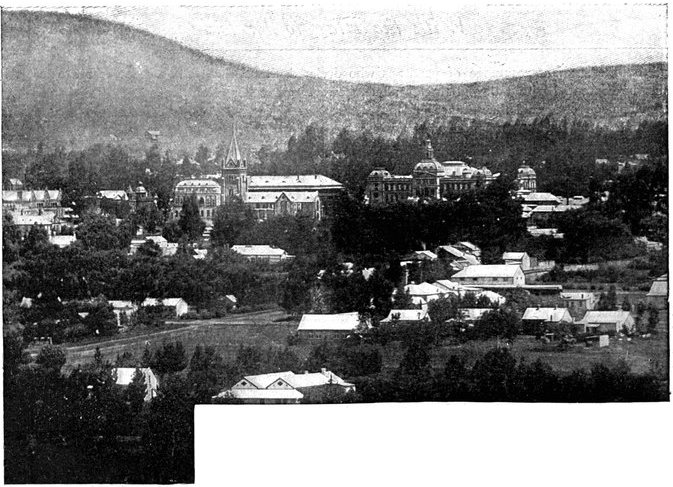
PRETORIA.
WITH THE FLAG
TO PRETORIA
The Boer Ultimatum—Intrigues against British
supremacy—Great Britain's interest in the Dutch
Republics—Common interests of the white peoples—Early
history of Cape Colony—Unpopularity of the Dutch
East India Company—British capture Capetown—"The
Great Trek"—England recognizes the Republics—Their
attitude towards us—Sir Bartle Frere—Majuba—The
Outlanders—The Jameson raid—Kruger—His
character—Sir Alfred Milner—The Bloemfontein
conference—Transvaal refuses England's demands—War.
On October 11, 1899, began what was to prove the greatest struggle in
which England has engaged since the peace that followed Waterloo. For
at 5 p.m. on that day the forty-eight hours allowed by the Transvaal
Government for a favourable answer to its ultimatum expired, and the
forces of the two Boer Republics put themselves in motion to carry out
their favourite threat of sweeping the English from South Africa into
the sea.
The Boer Ultimatum.
Thus came the explosion—the culminating catastrophe of a decade of
race-hatred in South Africa, the inevitable and certain result of
British moral cowardice and surrender in the past. Twenty years back it
had been foreseen and foretold by the prophets; for the last five years
before the hour of conflict the British nation had felt instinctively
that it was drawing steadily nearer; had watched with apprehension the
enormous armaments of the Transvaal, and heard with rage and shame the
story of the persistent oppression by the Boers of thousands of loyal
British citizens.
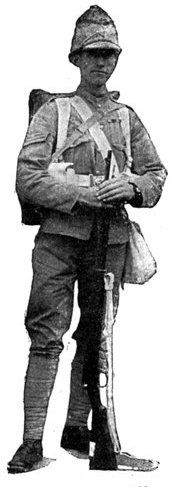
"A GENTLEMAN IN KHAKI."
Khaki, originally used in India only, but now universal in foreign
campaigns, is a canvas-like fabric, cool in summer and warm in winter.
It is precisely the colour of the dusty, yellow-brown veldt, and its
name is derived from the Persian word for dust.
[1652-1709.
All men had dreaded it; many had striven to avert it; many more had
prayed that it might not come in their day. But it had come at last and
found Great Britain utterly unprepared, still clinging against hope
to the hope of peace, confused and distracted by false predictions
that the Boers would never fight,[Pg 4] and by the ignorant assurance of
partisans who declared that Britain must never resort to force, but
must be contented with talk and threats alone, however grave her
grievances.
Intrigues against British Supremacy.
Napoleon once said that France and England would never remain at peace;
their peace would be only suppressed war. And it might as truly be said
of the Transvaal that, since the great betrayal of British interests
which followed Majuba and which gave self-government back to the Dutch
Republic, it had never been at peace with Britain, but had for eighteen
years maintained barely concealed hostilities against all things
British. It had armed, plotted, lied, conspired, intrigued, oppressed,
prevaricated for the one great end of domination in South Africa at
whatever cost. Like the upas tree of the fable, it had corrupted the
soil of South Africa with its poison; it had blasted loyalty to Great
Britain in the surrounding territories; it had become a centre, and
a rallying point for all that was most bitterly opposed to British
supremacy and to the ideals which have made our race so great. The one
principle upon which its power was founded was the inequality of the
white races—the servitude of the Englishman to the Dutch.
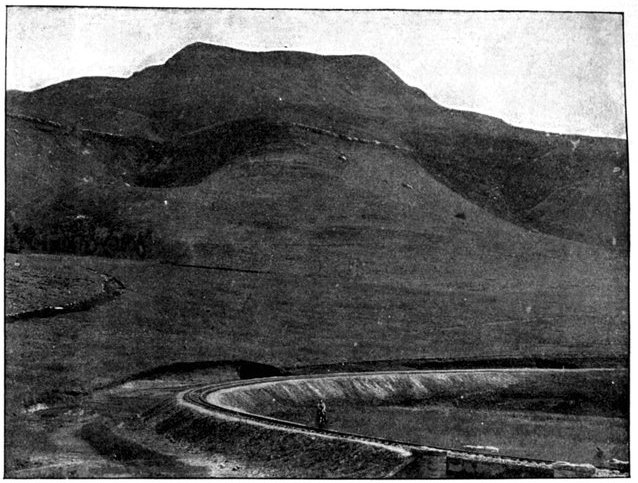
MAJUBA HILL.
The scene of the disastrous defeat which we suffered at the hands of
the Boers on February 27, 1881. At that time there was no railway in
this portion of Natal, and the country was even more sparsely populated
than at present.
The great principle upon which the British Empire has been built up is
that all men are equal before the law, and that all civilised races
stand upon precisely the same footing. As we profoundly believe, not
that we English are the favoured people of God, but that so long as we
are faithful to the noblest call of duty and to the highest instincts
which are in us as a race, we are helping the cause of progress,
which is the cause of God, we know that, whatever checks, whatever
vicissitudes, whatever disappointments may befall, we march to victory.
Our cause is the cause of liberty and of the right.
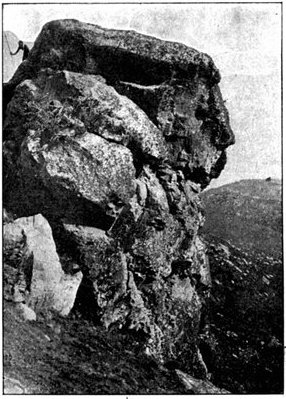
FIGURE-HEAD ROCK, MAJUBA.
If we look at the map of South Africa as it stood in the days before
the war, we shall observe that in the centre of British territories,
cut off from all access to the sea, lay two states, one independent of
England—the Orange Free State; the other, the Transvaal, in a position
of quasi-independence. For a few miles, it is true, the Transvaal
boundary on the east is conterminous with Portuguese possessions;
indeed, it approaches very close to the magnificent harbour of Delagoa
Bay.
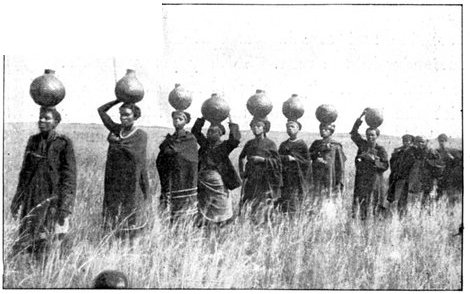
KAFFIR WOMEN CARRYING BEER.
The natives make a fermented drink from mealies (Indian corn) which
is known as Kaffir beer. It is carried from one kraal to another by
strings of women walking in Indian file and carrying on their heads
great yellow gourds containing their favourite drink.
1652-1709.] Conflict of Races in South Africa.
Great Britain's Interest in the Dutch Republics.
But with this exception the two Boer States are closely shut in by
British colonies. Hence of necessity the British Empire must always
have been profoundly[Pg 5] interested in the internal condition of these two
Dutch republics. Had they been peaceful and orderly States, as was the
Orange Free State up to that evil day when it became demoralised by the
gold lavished from the Transvaal secret service funds, they might have
existed in perfect amity. Had they been content to accept things as
they were, there could have been no quarrel.
In the British colonies of Natal and Cape Colony, the one to the
south-east of the Boer Republics, the other to the west and south-west,
were many thousands of Dutch, closely connected by family and by race
with the inhabitants of those republics. It was the one desire of the
Government of the Transvaal to unite these Dutch against the English,
and to sap their loyalty, though they had no grievances and had been
given in every respect the same privileges as the Englishmen.
No other theory will explain the conduct of the Transvaal. It had
assumed the title of "South African Republic," and taken to itself a
four-coloured flag as emblem of the future union of Transvaal, Orange
Free State, Cape Colony, and Natal under its sovereign influence.
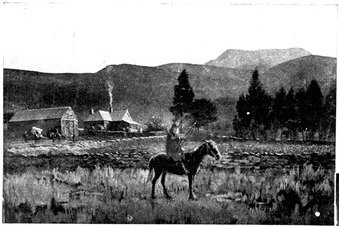
O'NEILL'S HOUSE.
Temporary hospital for wounded men brought from Majuba; the house where
the Anglo-Boer Convention was held in 1881 and the treaty signed.
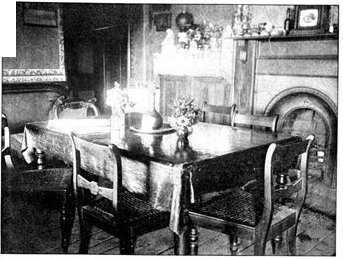
O'NEILL'S HOUSE.
The room in which the Convention of 1881 was signed.
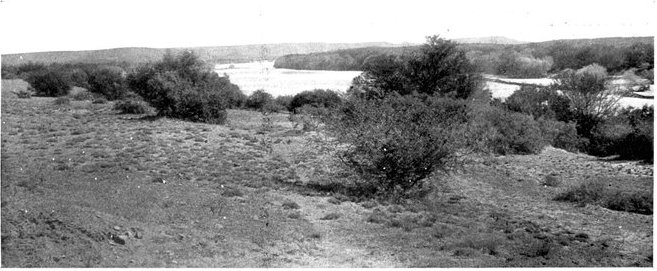
VIEW ON THE ORANGE RIVER, FROM THE RAILWAY BRIDGE.
The Orange River divides Cape Colony from the Orange Free State. This
view is taken from a railway bridge connecting the two, and looking up
stream. The Orange River is one of the few South African rivers that
rarely, if ever, dries up.
[1652-1709
The conflict of races in South Africa was complicated by the presence
of the Bantu peoples, who gradually overcame the original inhabitants
of South Africa, the Hottentots and Bushmen, and are[Pg 6] themselves
a conquering race, who increase in numbers with the peace which
civilisation brings, and who do not suffer, as do many dark-skinned
peoples, from the white man's vices and diseases.[1]
Common Interests of the White Peoples.
Though accurate statistics of the proportion of English and
Dutch-speaking inhabitants in the various South African states cannot
be obtained, it is probable that in British and Dutch South Africa
there were, in 1899, 400,000 Englishmen or men of English descent,
500,000 Dutch, and 3,500,000 Indians, Malays, Hottentots, and natives
of the various Kaffir tribes. In Cape Colony and the Orange Free
State of the white races the Dutch preponderated; in the Transvaal,
Natal, and Rhodesia, the British. Instinct should have united the
white peoples, for, dwelling amidst a vast number of Bantus, warlike
by nature and intelligent above the common run of negro, both white
peoples were face to face with a common danger—a danger which the many
fierce struggles with the great tribes of the Zulus, Matabele, and
Basutos, had in the past proved to be a very real and ever-present one.
Here were the very conditions which should have produced peace and
amity—two kindred white races of the same faith, and almost of the
same blood, confronted by hourly peril from the blacks.
Why, then, was it that Englishmen and Dutchmen could not dwell in
peace? Hereafter we shall have to follow the whole sad story out in
detail; in this place it may suffice briefly to recapitulate the most
essential facts.
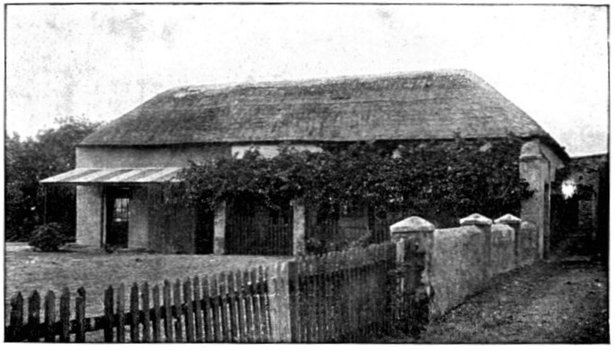
OLD DUTCH HOUSE IN PAPENDORP IN WHICH THE CAPITULATION
OF THE CAPE FROM HOLLAND TO GREAT BRITAIN WAS SIGNED IN 1806.
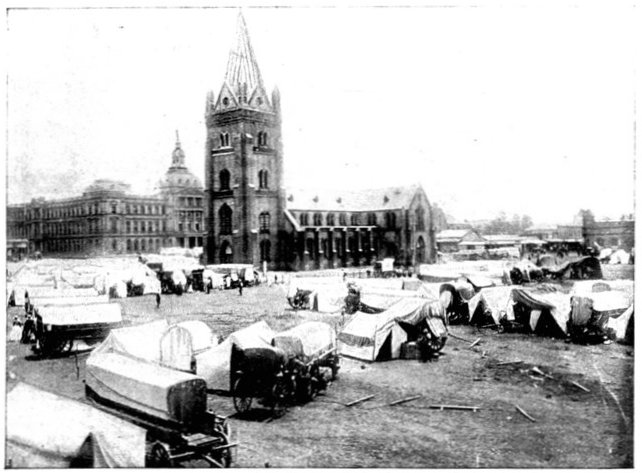
PRETORIA NACHTMAAL.
Four times a year the country Boers come into Pretoria for Nachtmaal
(Holy Communion). They outspan their waggons on the Church Square, camp
out for a week with their wives and families, and do their shopping for
the ensuing three months.
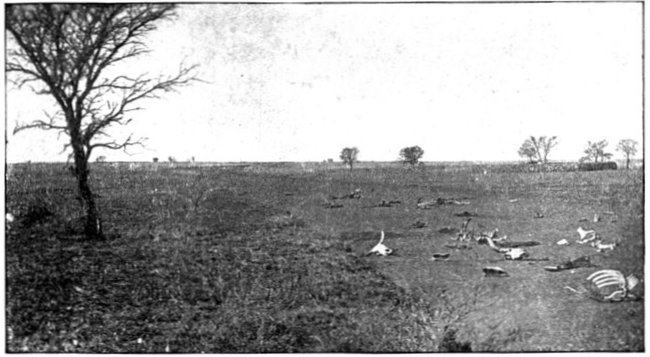
BATTLEFIELD OF BRONKHORST SPRUIT.
The scene of the battle between the Boers and the English in 1881, when
a detachment of the 94th regiment was surprised by a party of the enemy
in ambush and nearly annihilated.
Early History of Cape Colony.
1709-1833.] Early History of Cape Colony.
Capetown was first occupied by the Dutch East India Company in 1652 as
a naval station on the road to India. At first it was only a military
post; five years later a dozen men were allowed to settle outside the
limits of the Dutch fortress, buying and selling under most stringent
regulations laid down by the Company. The Dutch forcibly took the land
from the Hottentots where they could not obtain its cession for a
consideration. Gradually they increased in numbers and spread inland;
at the close of the seventeenth century they were reinforced by a
number of Huguenots, exiled from France on account of their religion,
and for the most part men of high birth and noble character. The new
comers attempted to keep their tongue and identity, but in 1709 the
Dutch Company forbade all use of French in official communications, and
the language rapidly became obsolete.
[Pg 7]
A homogeneous Dutch community grew up in this remote region—for the
Cape was, in the seventeenth and eighteenth centuries, one of the
least-explored and most out-of-the-way parts of the earth—which knew
no literature but the Bible, which preserved the manners and traditions
of the seventeenth century, and which from its frequent disputes with
the Dutch East India Company's tyrannical government imbibed a rooted
aversion to all laws and restraints.
It was a strong, old-world community, which retrograded rather than
advanced as time went on, which in its utter isolation escaped the
soothing influence of civilisation, and in which every man, as far as
he could, did that which was right in his own eyes.
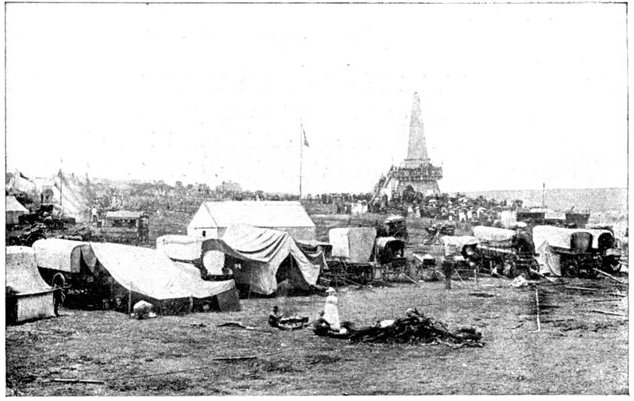
THE PAARDEKRAAL COMMEMORATION.
The Paardekraal (Horse-pound) Monument erected near Krugersdorp by the
Boers to commemorate their independence. Periodically great meetings
are held here, when prayers are offered and patriotic speeches made.
Beneath the monument is a sort of cellar, into which every Boer in
passing throws a stone as a token of his visit.
Unpopularity of the Dutch East India Company. British
capture Capetown.
The colonists were perpetually in conflict with the hated Dutch East
India Company; they were in open revolt when in 1795 a British force
appeared off Table Bay and captured Capetown. There was at first no
antagonism between the conquerors and the colonists. When the Cape was
re-occupied in 1806, it having been restored to Holland in the peace of
1802, Sir Home Popham was able to trust very largely to the colonists
for the defence of the place. He lays emphasis on their dislike for the
Dutch Company and on their loyalty to the Union Jack.
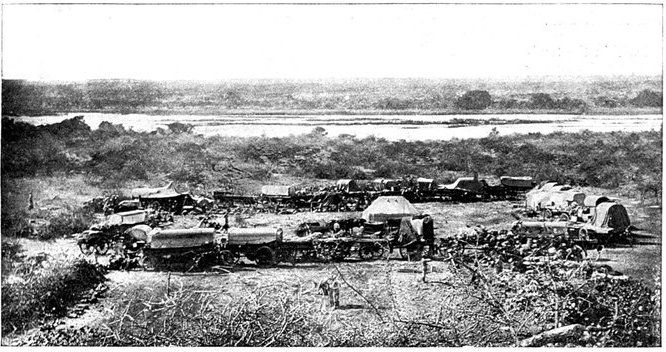
A LAAGER, SHOWING THE LONG CAPE WAGGONS USED IN A "TREK."
When Boers are trekking, or travelling from one place to another, they
outspan their waggons at night and put them end-on in the form of an
oblong. The cattle are tethered in the centre, and the interstices of
the wheels filled up with wacht-een-beitje or wait-a-bit thornbush.
[1837-1854
It was not until England began to interfere with the treatment of the
natives by the Dutch colonists that Dutch discontent first showed
itself. The prohibition of the use of the Dutch language in official
documents and in the law courts, the abolition of slavery in 1834—for
which most inadequate compensation was made by England—and the
meddling in the government of the colony by[Pg 8] doctrinaires in England
who knew and cared little or nothing for the peculiar circumstances,
familiar to the men on the spot, caused general irritation amongst
a people always averse to law and order, and by nature inclined to
nomadic habits.
"The Great Trek."
The abolition of slavery was the immediate cause which led to "the
Great Trek" in 1837, when many hundreds of Dutch colonist-farmers
or "Boers," as they now came to be called, went forth with their
waggons and women and children and belongings into the vast, unknown,
mysterious, remote lands which then bordered upon the colony. They
settled down in what is now Natal, the Orange Free State, and the
southern Transvaal.
Natal was annexed by England in 1843; the Orange Free State in 1848,
after the Boers had been defeated at Boomplaats in the first real
engagement fought in South Africa between the English and the Dutch
colonists.
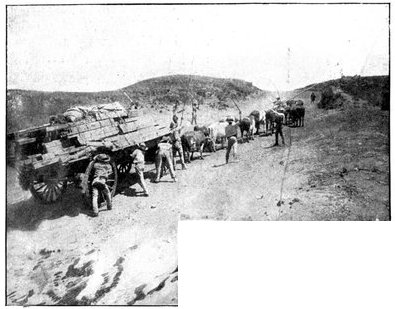
"STUCK" ON THE DRAKENSBERG.
The Drakensberg Mountains form the northern boundary of Natal, dividing
that colony from the Orange Free State. The passes are of a difficult
and often dangerous nature for waggon-transit.
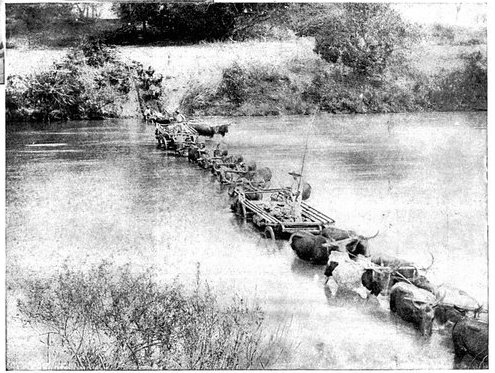
FORDING A RIVER IN THE TRANSVAAL.
Except after heavy rains all the rivers are easily crossed at the
different drifts or fords, and after a long, dusty trek, the team of
sixteen oxen enjoy the coolness of the water, and linger in the stream
for as long as their drivers will permit.
England recognises the Republics.
In 1852 the independence of the Transvaal was recognised by the Sand
River Convention, with the express stipulation that slavery should
never be permitted within the territories of the Republic. Two years
later England abandoned the Orange Free State for no reason whatever,
except her dislike for onerous responsibilities.
All this while war with the Kaffir tribes had continued, in which
British soldiers did most of the work and the British people paid
most of the cost. All this while, too, one able man after another was
going out from England to govern South Africa, and, because his ways
were not the home government's ways, was returning in disgrace. Sir
Benjamin D'Urban, Sir Harry Smith, Sir George Grey, all walked the same
sad road; all did what was wise, far-sighted, and just; all gained
the respect of the English and the Dutch in the colony, and all alike
were over-ruled, interfered with, or recalled. Jerusalem stoned the
prophets; England preferred not to listen to them: either had in the
end to pay bitterly for this refusal to hear and learn the truth.
[Pg 9]
1854-1877.] The Zulu War.
And thus there grew up in South Africa two independent Dutch
communities, outside the pale of our Empire, and this, too, in a
country which nature clearly meant to be one organic whole.
Their attitude toward us.
These two republics differed much in their attitude to England. The
Orange Free State was always on friendly terms; the Transvaal always
more or less hostile. The Orange State was reasonably well governed;
the Transvaal became an anarchic, loosely compacted, lawless, bankrupt
country, where decent government was unknown. Its chequered existence
ended for a time in 1877, when, with treasury empty, and threatened on
the one hand by Cetewayo and the Zulus and on the other by the Bantu
chief Secocoeni, it was annexed in the name of Great Britain by Sir
Theophilus Shepstone.
Having taken over the Transvaal, England proceeded to break up the
power of the Zulus and to subdue Secocoeni. Trade revived, and
everything looked well, though there was still a good deal of veiled
discontent, due to the British failure to grant self-government,
when for party purposes, to eject Lord Beaconsfield from office, Mr.
Gladstone began to declaim against the "invasion of a free people," as
he called the annexation of the Transvaal. He was followed by Mr. John
Morley and Mr. Leonard Courtney, and by most of his party in this kind
of talk.
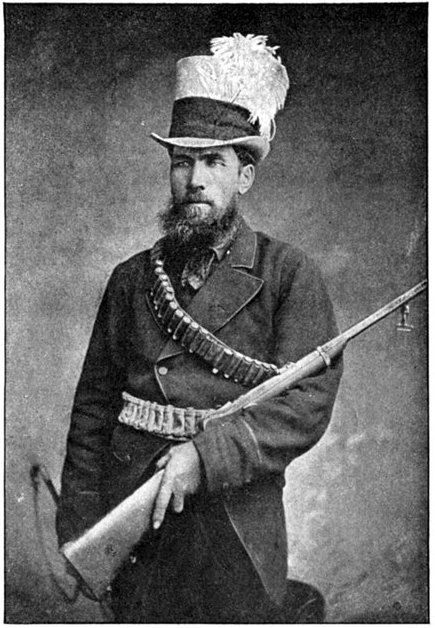
A BOER COMMANDANT IN FIGHTING KIT.
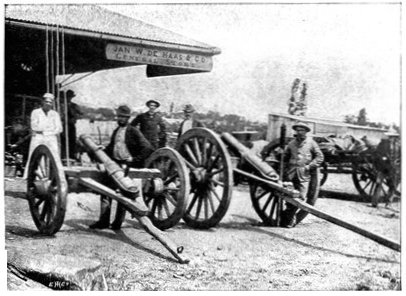
BOER CANNON USED IN THE WAR OF 1881.
These are old Boer cannon made by inexperienced workmen, and said to be
fashioned from the iron rims of wheels taken off the British waggons
captured at Bronkhorst Spruit. They form a remarkable contrast with the
modern guns with which the Boers are now armed.
Never have rash and foolish words so swiftly come home to harass the
speakers, as in this case. Mr. Gladstone achieved his object, and
attained power for what afterwards proved to be the most disastrous and
humiliating period in British history. His speeches had been reprinted
in the Transvaal, and had inspired hopes which the Boers now expected
him to fulfil. They were disappointed. On June 8, 1880, he wrote to
a Transvaal deputation, "Our judgment is that the Queen cannot be
advised to relinquish the Transvaal," and that "obligations have been
contracted which cannot now be set aside."
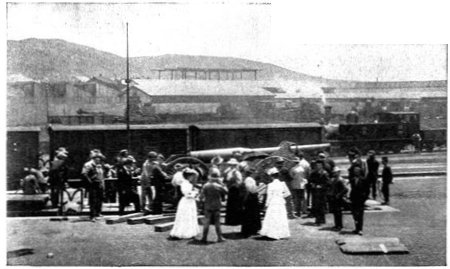
A BOER "LONG TOM" AT PRETORIA STATION, EN ROUTE FOR THE
SCENE OF WAR.
This powerful weapon, a Creusot gun of 5·9 inches calibre, has a range
of 10,000 yards. It was christened "Long Tom" by our men at Ladysmith,
where one of these guns was disabled in a night sortie. With equal
aptness a Boer gun whose shells constantly fell short was nicknamed
"Weary Willie."
[Pg 10]
[1877-1881
Sir Bartle Frere.
But though outwardly Mr. Gladstone's attitude was the attitude of
a strong man, he took no precautions to meet Boer discontent. The
warnings of Sir Bartle Frere, the British governor at the Cape, were
unheeded. Sir Michael Hicks-Beach had thrown him over once because he
had not been able to prevent the Zulu war; Mr. Gladstone now recalled
him at the very time when a brave, loyal, far-sighted, single-hearted
man, such as Bartle Frere undoubtedly was, was most needed in South
Africa. Abandoned by both parties, betrayed, and treated with a
contumelious contempt which his noble services had never deserved, he
turned his face sadly towards England. Two months later the Transvaal
rose in revolt.
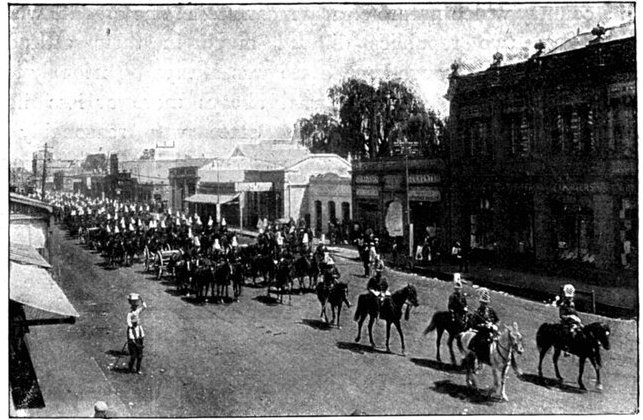
FREE STATE ARTILLERY AT BLOEMFONTEIN.
The standing armies of both the Orange Free State and the Transvaal
consist of a few hundred State Artillery, largely recruited and
officered by Germans and Hollanders. This picture shows the Orange
Free State Artillery in gala uniform on the way to parade. They are
commanded by Major Albrecht, a German.
Majuba.
In quick succession three checks, or positive defeats, were inflicted
upon a small British force, the most serious that of Majuba. The
British government had announced that, come what might, it would
suppress the insurrection, but losing heart and terrified by the
prospect of a Dutch rising in the Cape, it conceded to the insurgents
a limited measure of self-government, and strove to delude the world
by talk of magnanimity. It explained that there was real nobility in
receding from its pledges and giving way to a small but victorious
force of Boers. Many people at the time doubted this nobility, and
by an explicit statement of Lord Kimberley on November 14, 1899, the
surrender is now known to have been due to cowardice, and to cowardice
alone.
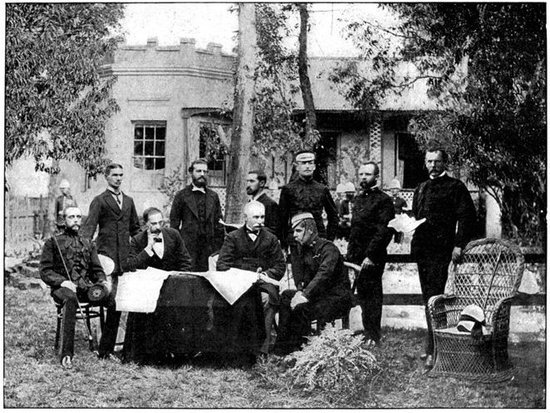
SIR BARTLE FRERE (the centre figure at the table),
STAFF, CHAPLAIN, AND SECRETARY OUTSIDE THE BRITISH RESIDENCY IN
PRETORIA, 1880.
A settlement based upon cowardice could never last, could never prove
satisfactory. The Transvaal Government used Mr. Gladstone's fears as
a lever to extort a fresh convention and get fresh concessions. Its
attitude to England was almost openly hostile.
The Outlanders.
1881-1896.] The English a Subject Race.
And now the discovery of gold brought immense wealth and a large
British population into its midst. The rights of that British
population, known as Uitlanders or Outlanders, had been very
inadequately guaranteed by Mr. Gladstone, who foresaw nothing, and
thus failed hopelessly in the greatest department of statesmanship.
The Transvaal Boers remained what[Pg 11] they had been in the days of the
Great Trek and in the early forties. They kept all the power in their
own hands and made of the English—from whose wealth, however, and
from whose energy they took ample toll—a subject race, excluded from
all voice in the management of affairs, deprived of the rights of free
speech and of free press, unable to obtain justice in the Boer courts,
openly insulted and outraged without hope of redress. Corruption was
rampant in the governing circles.
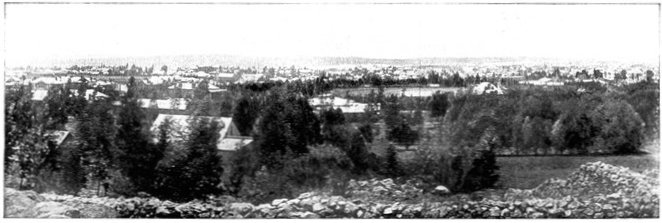
JOHANNESBURG.
Up to September 1886 there was not a single house on the site of the
now flourishing town of Johannesburg. It owes its existence entirely to
the discovery of gold, of which a reef 130 miles long runs through the
town and district.
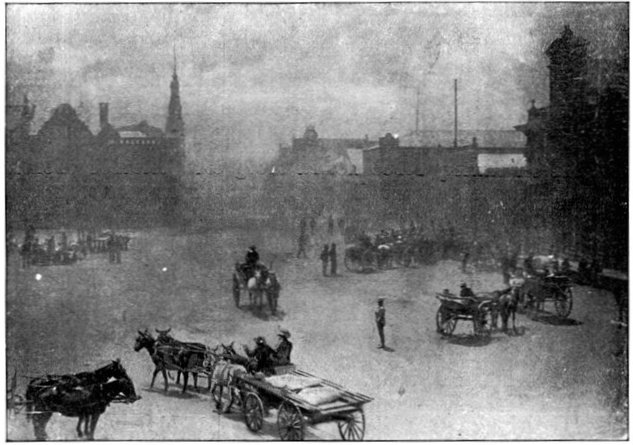
A DUST STORM IN JOHANNESBURG.
This is a very cloudy view of Goldopolis. Periodically, especially in
winter, vast dust storms prevail, which obscure everything with an
opaque gritty haze as thick as a London fog, and far more unpleasant.
The tone of the Dutch Parliament or Raad reflected the temper of the
whole Boer community, which may have been suited to the seventeenth
century, but was wholly out of place at the close of the nineteenth.
Pillar-boxes were effeminate; locusts were a plague sent from God, and
might not be interfered with; railways had not the divine blessing and
brought all manner of calamity; the firing of bombs to bring down rain
was impious profanity; the size of neckties ought to be regulated by
the authorities. At every turn there were fierce expressions of hatred
for England and Englishmen. Foreigners were called in to help hold down
the English; the government openly and undisguisedly coquetted with
Germany and with any power which it believed hostile to the British
Empire.
The Jameson Raid.
Then came the Jameson Raid, provoked by misgovernment and by the
growing exasperation throughout the British Empire, but in itself
indefensible. It failed signally, and left no heroic memory of resolute
fighting to the end against overpowering odds, but only shame and
sorrow in its trail. Yet it at least served to rivet the gaze of
England upon what was happening in South Africa. Even before the raid
the Transvaal Government had begun to arm; it now proceeded to build
up a great military power, purchasing cannon literally by the hundred
and rifles by the thousand, erecting immense fortifications at Pretoria
and Johannesburg, and concluding a secret alliance with the Orange Free
State. The money for these armaments was wrung from the Outlanders. By
the lavish use of secret service funds the press of Continental Europe
was set yelling against England, and treason was fomented in Cape
Colony.
1881-1896.
The treatment of the Outlanders went from bad to worse, till Englishmen
and Englishwomen were murdered, like Edgar and Mrs. Applebee, without
redress. No great nation could permit its subjects[Pg 12] to suffer
continued humiliation in a country over which that nation had certain
rights—however shadowy—and it grew monthly more certain that Great
Britain must at last intervene.
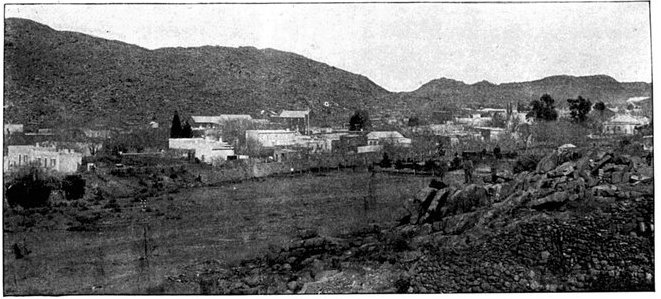
COLESBERG: PRESIDENT KRUGER'S BIRTH-PLACE.
Seventy-four years ago Paul Kruger was born in the neighbourhood of
Colesberg in Cape Colony. He left it with his parents in 1837, at the
time of "the Great Trek," and travelled northwards to the wild country,
which eventually became the South African Republic.
Kruger.
The president and the evil genius of the Transvaal through this epoch
was Stephanus Paulus Johannes Kruger, born in Cape Colony on October
10, 1825. He was a man of indomitable courage and extraordinary force
of character—a fighting man from his youth up. His coolness was shown
on one occasion, when, out hunting, he suddenly one day, from the top
of a kopje—a hillock such as cover the surface of the upland plains
of South Africa—saw a large number of Kaffirs evidently advancing
to attack him. He sat calmly down without betraying the slightest
trepidation, shook the sand from his rough raw-hide shoes, and then
waved and signalled with his rifle as if to a considerable force of
Boers behind him under shelter of the kopje. The Kaffirs, convinced by
his show of boldness that he was not alone, precipitately retreated.
His character.
As a diplomatist, Mr. Kruger earned Bismarck's commendation. The
great German, who had met him, saw in him the strongest man of our
time. He was, however, destitute of that noble instinct without which
statesmanship builds upon the shifting sands—the instinct of justice
and fair play. Personally corrupt, since he was not above charging very
heavy travelling expenses for a certain trip in which he was the guest
of Cape Colony; winking at or openly justifying corruption in others;
laying up a colossal fortune out of the stealings of himself and his
friends from the State, he had all the uncouthness and all the iron
determination of an Abraham Lincoln, but lacked the great American's
cleanness of hand and love of justice and of right.
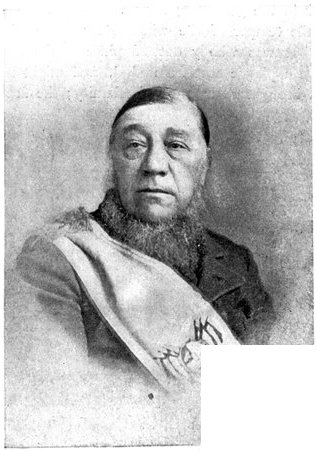
PRESIDENT KRUGER.
Born at Rustenberg, near Colesberg, Cape Colony, October 10, 1825.
Emigrated across the Vaal, 1837. Member of Executive Council under
President Burghers, 1872. President of Transvaal since 1883; re-elected
1888, 1893, 1898.
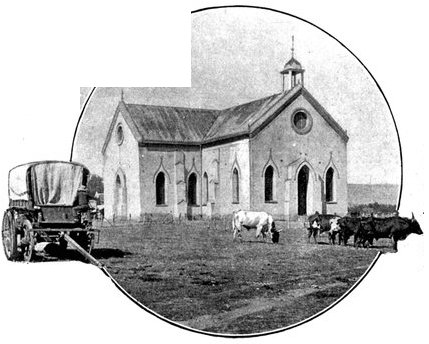
DOPPER CHURCH, PRETORIA.
The Dopper or Quaker Church, Pretoria, where President Kruger very
often preached. It stood directly opposite his house, and has quite
recently been replaced by a more modern structure.
1881-1896.] Character of President Kruger.
Mr. Kruger was by birth a peasant, and remained to the end a peasant in
ideas. His will power was coupled with a subtle cunning; his horizon
was narrow, and[Pg 13] limited and never expanded; his mind was always filled
with suspicion and jealousy of all that he could not understand. His
patriotism had not prevented him from taking office under the British
Government, and asking from that government higher pay. His attitude to
the Outlanders, were these of British nationality, was one of insolent
contempt. When Johannesburg presented a petition asking for reforms, he
remarked, "Ah! that's just like my monkey. You know I keep a monkey in
my back yard, and the other day, when we were burning some rubbish, the
monkey managed to get his tail burnt, whereupon he bit me. That's just
like these people in Johannesburg. They burn their tails in the fire of
speculation and then they come and bite me."
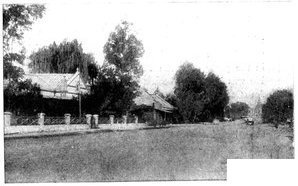
THE PRESIDENT'S HOUSE, PRETORIA.
This house was given to Paul Kruger by a man named Nellmapius, the
original liquor concessionaire, as a small token of gratitude. The only
outward signs of its purpose are the flagstaff and a lazy sentry.
"Protest! protest!" he said on another occasion, "what is the good of
protesting? You have not got the guns! I have."
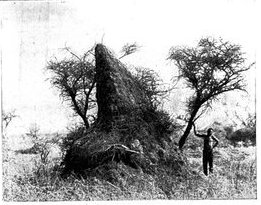
A MONSTER ANT-HILL.
The veldt throughout South Africa, but particularly in parts of the
Transvaal, is dotted at frequent intervals by ant-heaps, some of which
are as large as the one shown above. The natives use the smaller ones
as ovens, first driving out the ants by smoke, and then hollowing out
the inside.
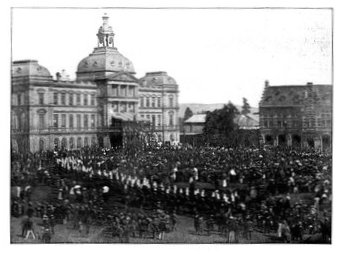
THE RAADZAAL, PRETORIA.
After the General Election to the Volksraad or Parliament of the
Transvaal in 1898, the new members were formally sworn in, and
President Kruger made a speech from the balcony under the awning to
the crowd waiting in Church Square. The soldiers are the Pretoria
Volunteers in their gala uniform.
The outward appearance of Mr. Kruger is in keeping with his sinister
personality. A shabby frock coat deluged with coffee stains, a seedy
silk hat without gloss, an immense scarf of office which sorts
grotesquely with this apparel, and ill-fitting trousers barely long
enough to meet the boots, are his familiar habiliments. He smokes and
drinks coffee incessantly. He has the fervent piety of a Torquemada;
believes himself under the peculiar protection of God; and interlards
his discourse with religious ejaculations, as if God could smile upon
tyranny and corruption. He has exaggerated the outward roughness of
Cromwell, forgetting, however, that, to complete the picture, the vast
tolerance, which is Cromwell's greatest merit, is required.
[Pg 14]
[1896-1899.
Sir Alfred Milner.
To meet this man in a duel of giants, England sent out her greatest
and ablest administrator. Sir Alfred Milner went to his arduous task
with the solid approval—even with the prayers—of the whole nation.
Messrs. Morley and Courtney, and all the faint hearts that masquerade
in the party of Little Englanders, blessed the choice. He was known to
be wise, moderate, restrained, strong. An Oxford man, he had learnt,
in a school which imparts character even more than learning, that the
Englishman's duty is not to seek wealth, luxury, or ease, but, in the
highest sense, to live well. He did not parade religion, but then it
was in his heart. He did not talk of patriotism, but then he had never
been in foreign pay, like Mr. Kruger. His manners were not uncouth,
his dress was that of the ordinary world. No act of meanness, of
corruption, of unscrupulousness can be imputed to him. His career had
been one of unsullied brilliance. He was "straight," as he was brave.
At Cape Colony he was welcomed by all. He made no move, but sat still
and studied the country, studied the situation, studied Mr. Kruger and
Mr. Kruger's policy. He followed impassively the machinations of the
Bond, the Dutch party which had organised itself in Cape Colony. Mr.
Kruger fancied that here was another man who could be twisted round his
thumb, but he was greatly mistaken. Sir Alfred Milner was only striving
to discover the truth before he took action.
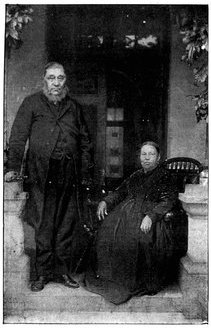
OOM PAUL AND TANT' SANNIE.
Paul Kruger and Mrs. Kruger, after whom Mr. Chamberlain enquired on a
memorable occasion. The President has been twice married; the present
Mrs. Kruger was a Miss Malan. The couple are familiarly known in South
Africa as "Uncle Paul and Aunt Sannie."
The Bloemfontein Conference.
The crisis drew nearer when an immense petition to the Queen was
forwarded by the Outlanders, praying for redress of their grievances. A
conference was arranged between President Kruger and Sir Alfred Milner
at Bloemfontein, and at it Sir Alfred put forward minimum demands—for
a reform of the franchise in the Transvaal, by which the Outlanders
would be able to obtain votes, and for a redistribution of seats. The
demands were refused, Mr. Kruger offering very much less, and the
conference broke up.
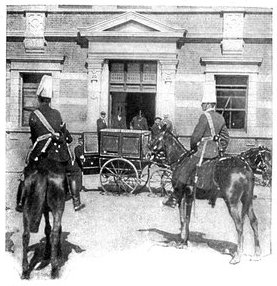
SIR A. MILNER AND PRESIDENT KRUGER LEAVING THE
CONFERENCE AT BLOEMFONTEIN, June, 1899.
No greater contrast can be imagined than the young, dapper, cultured
diplomatist, and the rugged, wily, and uncultured old President.
Sept. 1899.] British Demands Refused.
Then followed a long diplomatic battle between the British Government
and Mr. Kruger. Something on our part was conceded of Sir Alfred's
minimum, but not by Sir Alfred; nothing was conceded by the Transvaal,
which at every turn asserted its right to be considered a "sovereign
independent state." Mr. Kruger, as he had[Pg 15] always prophesied, was aided
and encouraged in his resistance by a certain party of Englishmen which
denounced Sir Alfred Milner, pretended that England was aiming at "the
destruction of the Transvaal Republic," and asserted that England must
concede, and ought to concede, because the nation would never go to war.
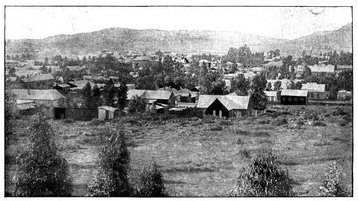
BLOEMFONTEIN, CAPITAL OF THE ORANGE FREE STATE.
Finally, on September 8, a British note was despatched demanding
a franchise attainable after five years' residence, a greater
representation for the Outlander majority in the Volksraad—the
Transvaal parliament—and equality of the Dutch and English languages
in that Parliament. An early answer was required. At the same time
5,000 troops were ordered from England and 5,000 from India to South
Africa, where our garrison did not much exceed 7,000 men.
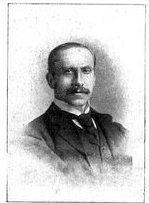
[Photo by Elliott & Fry.
SIR ALFRED MILNER.
Son of a doctor of medicine; was educated in Germany, and at King's
College, London, and Balliol College, Oxford; barrister, 1881; engaged
in journalism, 1882-5; Private Secretary to Mr. Goschen, 1887-9;
Under Secretary for Finance in Egypt, 1889-92; Chairman of Board of
Inland Revenue, 1892-7; K. C. B., 1895; Governor of the Cape, and High
Commissioner of South Africa since 1897.
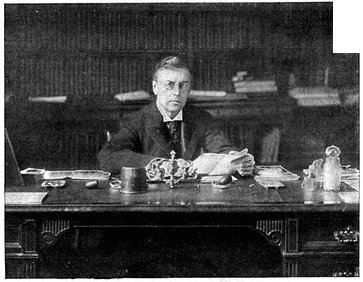
[Photo by Elliott & Fry.
RT. HON. JOSEPH CHAMBERLAIN.
Born in London, 1836; son of a Birmingham screw manufacturer; Chairman
of Birmingham School Board, 1873; Mayor, 1874-5-6; M. P. for Birmingham
since 1876; President of the Board of Trade, 1880; President of the
Local Government Board, 1886, both under Mr. Gladstone. He differed
from that leader on the question of Home Rule, and resigned, 1886. In
1895 he became Secretary of State for the Colonies in Lord Salisbury's
administration.
Transvaal refuses England's demands.
On the 16th the Transvaal replied with a flat refusal of the vital
demands. At the same time came news of immense military preparations
in the Transvaal and of a general exodus of British subjects from
Johannesburg. Yet England still waited in hope of a peaceful
settlement, and the government even now failed to take the steps which
should have been taken at once; it did not engage transports, mobilise
an army, and with all possible speed despatch it to South Africa.
[Pg 16]
[Oct. 7-9, 1899.
How terrible was the danger, how near the British Empire in South
Africa to its fall in the days which followed the 16th, was not at the
time apprehended by the public. Yet the government knew, or should have
known. Not till October 7, in face of the hourly growing peril, was
mobilisation ordered in England.
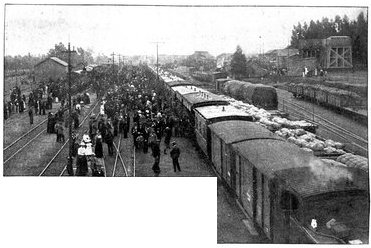
REFUGEES LEAVING JOHANNESBURG.
Owing to the immense crowds of refugees leaving Johannesburg, the
rolling stock of the Netherlands South African Railway was unequal
to the demands made upon it, and very many hapless Uitlanders had
to travel hundreds of miles in cattle trucks, amid terribly trying
discomforts.
War!
On the 9th, the Boer ultimatum was handed in, demanding the withdrawal
of the troops which had reached South Africa since June 1, 1899, and
of all troops on their way. There was only one possible answer to this
insolent missive—War.
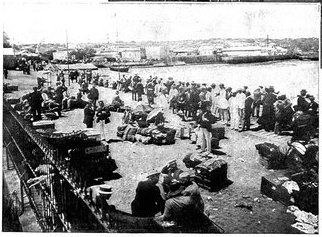
REFUGEES WAITING TO EMBARK AT LOURENÇO MARQUES.
Lourenço Marques is the nearest seaport to Pretoria, and belongs to
Portugal. The photograph was taken on the occasion when many refugees
from the Transvaal waited all night on the jetty for the ship Avondale
Castle, which had been stopped by H. M. S. Philomel and compelled
to discharge at Durban £25,000 in specie consigned to the Transvaal
Government.
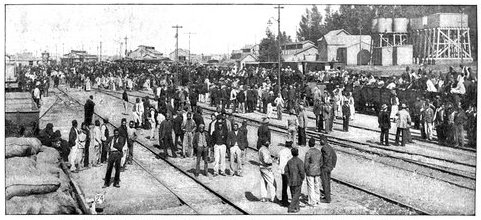
BRITISH SUBJECTS LEAVING JOHANNESBURG AFTER THE
PRESENTATION OF THE ULTIMATUM.
[Pg 17]
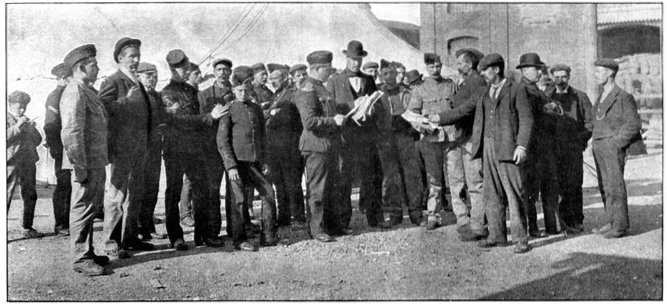
[Photo by Gregory.
RESERVES MOBILISING AT SOUTHAMPTON
"His regiment didn't need to send to find him."
CHAPTER II.
THE OVERRUNNING OF NORTHERN NATAL.
Hurried Preparations for War—The Reserves
Mobilised—Enthusiasm of the British Public—Strength
of the Forces in Natal and Cape Colony—Strength of
the Enemy—The Attack Delayed—Disposition of the
Boer Forces—Positions of the British at Dundee and
Ladysmith—Battle of Dundee—Symons wounded—Storming
of Talana Hill—The Treacherous White Flag—Yule's
March—Battle of Elandslaagte—British and Boer
Losses—"Remember Majuba!"—Action at Rietfontein—The
Boer Tactics—White decides to hold Ladysmith.
Hurried preparations for war.
The Transvaal ultimatum for the moment united all Englishmen. No one
was found to suggest the idea of surrender to such monstrous and
treasonable demands. The calling out of the reserves began amidst
an excitement which has never been paralleled in our day. Time,
unfortunately, was required to get the troop-ships ready, for the
Admiralty had not been given a fair chance. Time was also required for
the collection of transport, without which no army can move. Horses,
mules, tinned meat and food of all kinds, had to be purchased hurriedly
in every direction. The sense of public anxiety was augmented by the
knowledge that the army sent out could not be in South Africa, ready
for work, within six weeks from the date when mobilisation began. And
very much might happen in that time.
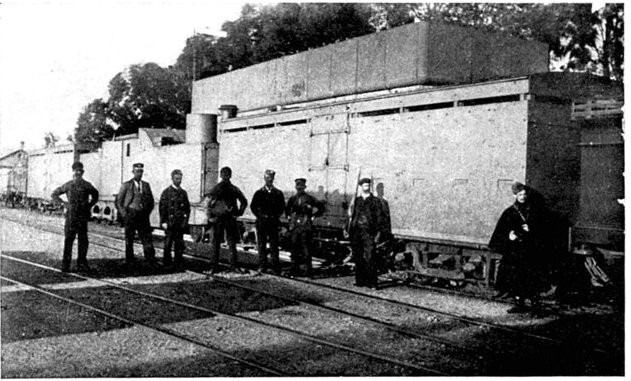
ARMOURED TRAIN FIRED UPON BY THE BOERS.
This train was attacked by the Boers near Spyfontein, October 15.
An attack on a similar train three days earlier, at Kraaipan, near
Mafeking, was the first overt act of war.
The Reserves mobilised.
Yet there was outward calm. The reservists answered the call like
Englishmen; like men, that is to say, who know a painful duty lies
before them and will do it. Scarcely one was missing when the time
given them to rejoin had elapsed. Deserters, who had shipped for
America, of their own free will came back to fight the Boers. Men rose
from beds of sickness that they might serve with the old colours and
not betray the confidence reposed in them. There was no exultation, no
desire to fight for fighting's sake, only a calm determination to end
the twenty years' purgatory of misrule in the Transvaal by coming to
the aid of brother Englishmen.
[Pg 18]
[Oct. 1899.
Enthusiasm of the British public.
The nation, too, began to feel that it had a solemn duty to its
soldiers. Vast crowds followed the reservists to the points of
mobilisation; eyes were dim at the thought of the sacrifice these brave
men were making. For they were going to adventure "life and love and
youth for the great prize of death in battle," at their country's call.
They were exchanging, many of them, comfort and comparative ease for
the hunger and rain and cold of the dreary bivouac, for the toilsome
march beneath the burning sun of the veldt, for torture by wounds, and
death in its most terrifying forms. They were leaving behind them women
and children who looked to them for daily bread. Yet they came with a
single heart; came cheerfully, and gave to their country all that they
had to give as the choicest offering of their love and devotion.
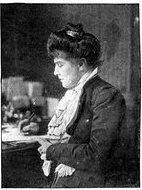
[Photo by Elliott & Fry.
LADY RANDOLPH CHURCHILL,
née Miss Jennie Jerome. Of American parentage; she is the mother of
two sons, one of whom, Mr. Winston Churchill, was recently a prisoner
in Pretoria, having displayed conspicuous bravery in a small fight at
which he was present as a newspaper correspondent. Lady Randolph was
instrumental in organising the hospital ship Maine as a token of
American brotherhood with Great Britain.
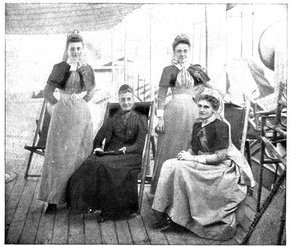
[Photo by Gregory.
MISS NORMAN AND NURSING SISTERS ON BOARD THE S.S. "TROJAN."
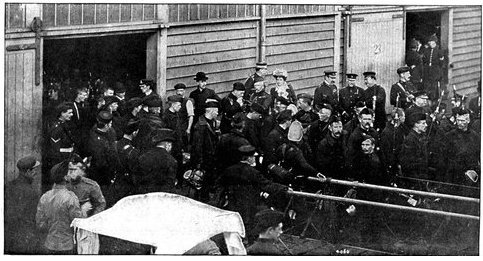
[Photo by Gregory.
DEPARTURE OF THE 1st BATTALION, RIFLE BRIGADE: H.R.H. THE DUKE OF
CONNAUGHT LIGHTING THE MEN'S CIGARETTES.
Oct. 1899.] Hospital Ships and Relief Funds.
Those who at home and in ease were to reap the fruits of their love
and devotion responded to the best of their power. Employers announced
that they would pay half wages to the women and[Pg 19] children whose
bread-winners had been called away; enormous funds were raised to
support the widowed and the fatherless of those who should fall, and
to keep in comfort the families of the soldiers. Workmen subscribed
their shillings; the well-to-do their guineas; the rich their thousands
of pounds. The most intensely national of poets, Mr. Rudyard Kipling,
appealed in touching verse to the nation's heart. In answer to his
appeal women sent their rings, children their pence, and the poor and
humble gifts in kind. No names were published; the giving was simple
and unostentatious, and therefore all the nobler. Thus our soldiers
were made to feel that they went forth to battle with the nation's love
and with its fervent prayers.
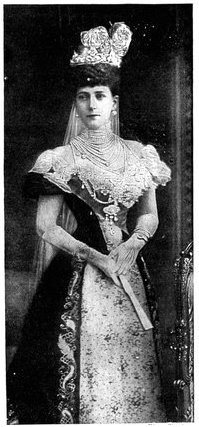
[Photo by W. & D. Downey, Ebury Street.
THE "PRINCESS OF PITY."
The latest photograph of H. R. H. the Princess of Wales in Drawing-room
dress.
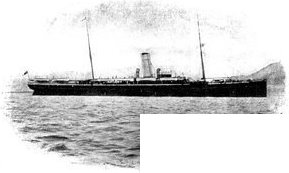
THE "PRINCESS OF WALES" HOSPITAL SHIP; FORMERLY THE
"MIDNIGHT SUN" EXCURSION STEAMER.
Her Royal Highness, ever to the front in the cause of suffering
humanity, has taken the keenest and most earnest interest in the
fitting-up of this hospital ship towards the cost of which she has made
a large private grant of funds.
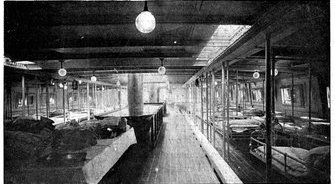
[Photo by Gregory.
THE ALEXANDRA WARD ON BOARD THE "PRINCESS OF WALES" HOSPITAL SHIP.
Nor were these schemes all. The Princess of Wales—Princess of Pity she
has rightly been called—at the head of the Red Cross Society, with
private effort, equipped hospitals and hospital ships; Lady Randolph
Churchill, widow of a man who loved England, who strove for honest
reform, and whose name will not soon be forgotten, of American birth
herself, raised, with the aid of other American ladies in London, a
fund for a hospital ship; Lady White, the wife of the British general
in Natal, collected a great sum to furnish the soldiers of the heroic
Natal Field Force with Christmas gifts; every steamer carried away
to the Cape presents of provisions, dainties, clothing, tobacco and
cigarettes, for the men fighting in the field. From the Queen on her
throne to the peasant in his cottage all gave liberally. The flood
gates of generosity were opened; a universal impulse of patriotism
moved the nation.
[Pg 20]
[Oct. 1899.
Strength of the forces in Natal and Cape Colony.
Meantime in South Africa the situation was one of the utmost peril.
The Transvaal had originally intended to despatch its ultimatum on
September 17 or 18, and then to begin the war. At this date none of
the reinforcements from England or from India had arrived. The British
troops available were four battalions of infantry,[2] two regiments of
cavalry, three batteries of field artillery, and one mountain battery
in Natal, under the orders of Major-General Sir Penn Symons, a total of
about 5,000 men and 18 guns. In Cape Colony were only two-and-a-half
battalions, or 2,000 men all told, under General Sir F. Walker.
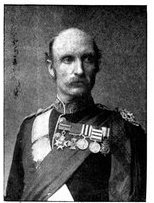
[Photo Window & Grove.
GENERAL SIR GEORGE STEWART WHITE.
Born 1835; son of J. R. White, Esq., of Whitehall, co. Antrim; educated
at Sandhurst; entered the Army, 1853; served in Indian Mutiny; captain,
1863; Major, 1873; was in the Afghan War of 1878-80, and present at the
occupation of Kabul, and in the expedition to Maidan, Sharpur; Military
Secretary to Viceroy of India; Lieut.-Colonel, Gordon Highlanders,
1881; Colonel, 1885; Assistant Adjutant and Quartermaster-General
in Egypt; commanded a brigade in Burmah, 1885-86 (for which service
he was promoted Major-General, and thanked by Indian Government),
and an expedition into Zhob; Commander-in-Chief in India, 1893-8;
Quartermaster-General to the Forces, 1898.
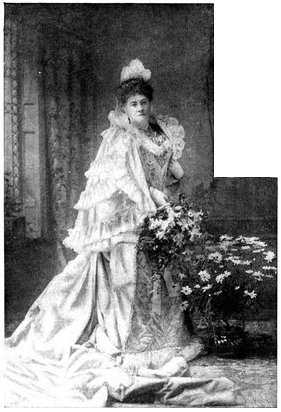
[Photo by Gunn & Stuart.
LADY WHITE.
Strength of the Enemy.
Against these the Transvaal alone could put into the field 40,000 or
50,000 men with 70 or 80 guns. The Orange Free State could dispose of
10,000 to 15,000 men with 30 or more guns. Thus, if the Boer forces
had advanced in the third week of September, they could unquestionably
have swept the British out of Natal, and have made themselves masters
of the whole of northern Cape Colony. With the fighting qualities which
they have since displayed, they must have surrounded and captured the
diminutive British detachments which kept vigil close to the frontiers
of a formidable military power. Why, then, was the attack delayed?
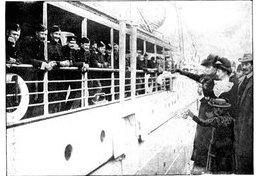
[Photo by Gregory.
OFF TO THE WAR!
Bidding farewell to the Army Service Corps at Southampton.
The attack delayed.
Oct. 1899.] The Boer Forces Mobilised.
In the first place the Orange Free State was not at that date ready to
throw in its lot with the Transvaal. It had no quarrel whatever with
England, and many Englishmen lived happily within its borders. Only a
prodigal use of[Pg 21] Mr. Kruger's secret service funds, and the desperate
exertions of the Free State President, Mr. Steyn, obtained the consent
of its Volksraad to the war. Moreover, when that consent had been
obtained its armaments were incomplete. Ammunition was wanting; and
so, reluctantly, all movement was postponed by the plotters against
the British Empire till the first day of October. Even then, it was
calculated, it would be easy to sweep the "rooineks" into the sea,
as but few of the Indian troops would have arrived. By October 1 the
Transvaal completed its mobilisation, and was ready to attack. It was
expected that the first Boer victory would be followed by a tremendous
uprising of the Cape Dutch, the disloyal of whom had been armed and
were in constant correspondence with Pretoria.
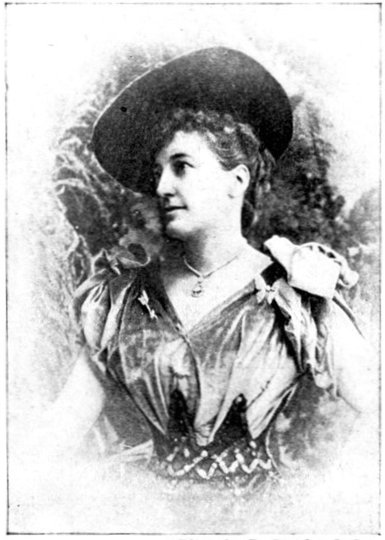
[Photo by R. Stanley & Co.
LADY SYMONS.
Widow of General Symons, and promoter of a fund for the widows and
orphans of soldiers.
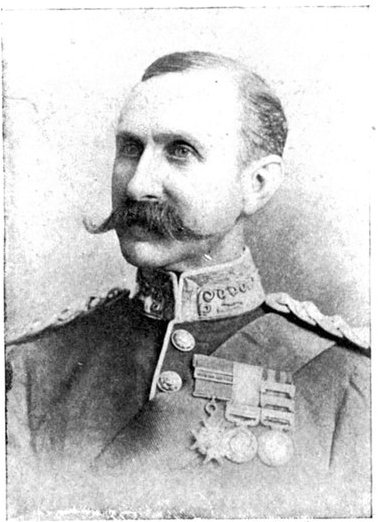
[Photo by R. Stanley & Co.
GENERAL SIR W. PENN SYMONS,
Who fell in the assault on the Boer position commanding Dundee.
But on October 1 good fortune once more intervened to save our empire.
The Transvaal commandoes had assembled, but transport and commissariat
were so defective that the Boers were in danger of starvation. The
want of rain, too, had left the veldt bare and dry, without grass
or sustenance for horses and cattle. It would, therefore, be almost
impossible without commissariat for men and beasts to subsist. Delay
was thus forced upon the Boers. The transport arrangements were
improved, while the commandoes watched eagerly for the first rains, due
in early October, which were to be the signal of action for them, and
of slaughter for the hapless British soldiery.

[Photo by Gregory.
GOOD BYE, DADDY!
A Pipe-Major of the Scots Guards starting for the front.
Disposition of the Boer forces.
[Oct. 1899.
The main Boer forces threatened Natal, which colony, from its
passionate loyalty to the mother country, was peculiarly odious to Mr.
Kruger. The Transvaalers were assembled, 15,000 to 20,000 strong, at
Zandspruit, just across the frontier of the extreme northern angle of
Natal; the Free Staters, 10,000 or more strong, were to the west of the
many passes which cross the Drakensberg range, threatening the whole
north of the colony. The lie of the frontier hereabouts gave the enemy
great advantages. Natal sends up a narrow wedge-shaped strip of country
between the Free State and the Transvaal. From Ladysmith, at its base,
to the most northerly point, this wedge is 50 miles long. How to defend
the wedge with a small force was the British problem. If a force were
placed at the northernmost point it would be liable to be cut off
and surrounded by the Free Staters crossing the passes and seizing
positions[Pg 22] in its rear, while the Transvaalers attacked in front. If
stationed farther south the same risk remained, though it would be
easier to retire. If the whole wedge were abandoned the political
effect would be disastrous.
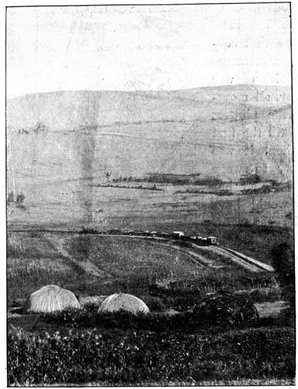
LAING'S NEK.
The "Nek" is the ridge between the two hills; it was the scene of a
battle in 1881, and over it the Boers swarmed into Natal in 1899.
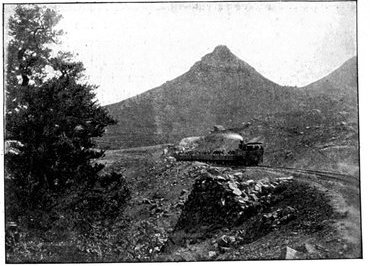
ELANDSLAAGTE: THE SCENE OF THE BATTLE.
Positions of the British at Dundee and Ladysmith.
Before the landing of the reinforcements, receiving news of the secret
Boer conspiracy to invade the colony, General Sir Penn Symons, in
command in Natal, decided to abandon the extreme north of the wedge,
where lie the ill-omened battlefields of Laing's Nek, Majuba, and
the Ingogo, and to place as large a force as he could spare at the
small town of Dundee, 35 miles from Ladysmith and connected with it
by railway. When the reinforcements from India arrived in the first
week of October, and General White took over the command in Natal,
this detachment was strengthened, and the main force established at
Ladysmith. The Dundee force, under Symons, was 4,600 strong with 18
guns; the Ladysmith division, under White, numbered about 7,500 men
with 24 guns. The latter was reinforced by Natal troops and volunteers
in the first ten days of war, till on October 20 it may have reached
9,000. Meantime, this weak little army remained almost unconscious of
the storm which was about to burst upon it, for the opinion generally
held by British officers was that, owing to his bad transport and
defective organisation, the enemy would not be able to move south for
some weeks.
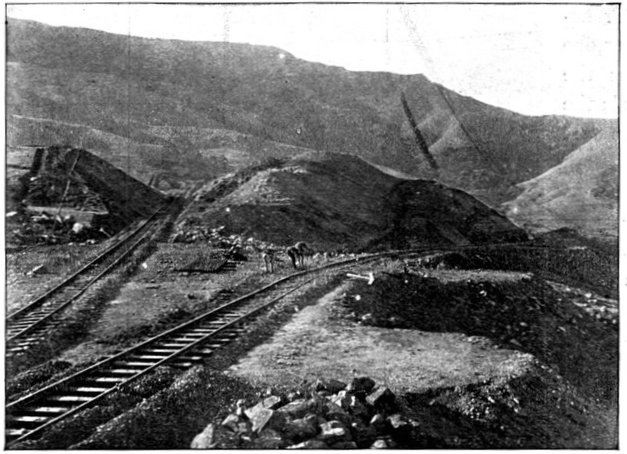
GLENCOE.
The railway on the left runs to Pretoria; that on the right to Dundee.
Oct. 19, 20, 1899.] The Campaign Opens.
The early days of the war in Natal encouraged this belief. On October
12 the Boers seized Laing's Nek and began crossing the Drakensberg in
small parties. A few shots were exchanged between the scouts on either
side, but there was no real fighting. No one fancied that Dundee was in
any danger; on the 16th, a correspondent wrote from Ladysmith that the
enemy was expected to remain inactive. Nor were any great precautions
taken by General Symons. His officers reconnoitred from time to time;
patrols and pickets were out; the main force lay in a valley dominated
by lofty hills,[Pg 23] some point on which he meant to occupy when the
approach of the enemy made it necessary. As he could not know from what
quarter the enemy would come, this central position was perhaps the
best that could be assumed. There was little ammunition at Dundee, and
the place was entirely dependent for most things, including supplies,
upon its communications with Ladysmith.
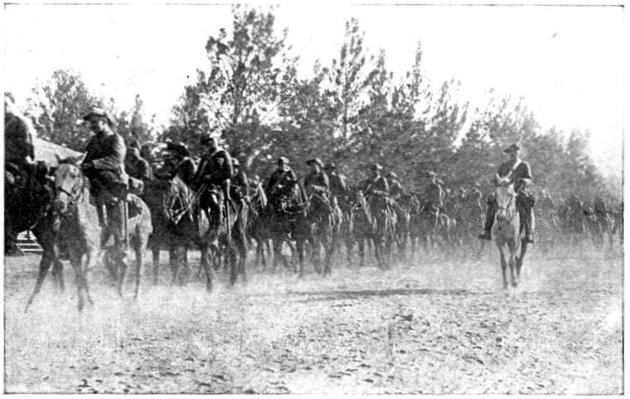
[Photo by H. Nicholls.
NATAL CARBINEERS LEAVING LADYSMITH FOR THE FRONTIER.
The Boers, perfectly informed of the British position, and directed
by skilful strategists, had really determined to attack this Dundee
force with the greater part of their army. The Johannesburg commando,
2,000 strong, under General Kock, opened operations by moving south
from Laing's Nek, and on October 19 seized a position at Elandslaagte,
astride of the railway between Dundee and Ladysmith. A train laden with
supplies was captured by the Boers. The 20th was fixed by Generals
Joubert and Meyer for the annihilation of General Symons' force. Meyer
was to attack from the east with 7,000 men, Joubert from the north-west
with 17,000. On the night of the 19th, Meyer's men seized Talana Hill,
a precipitous height to the east of and overlooking the British camp at
Dundee. They placed several guns in position there. At 2·30 a.m. of the
20th a British picket was driven in. The night was dark and misty; as
the dawn spread over the grey hills, out of the mist came the boom of
a heavy gun, and a shell dropped plump in the middle of the astonished
Britishers.
Battle of Dundee.
Thus General Symons was taken completely by surprise. But in this
emergency he showed a courage and a decision which were above all
praise. As the day broke he put his breakfastless, hungry men into line
of battle and sent out his three field batteries to respond to the
enemy's artillery fire, which now grew very galling. Along the ridge of
Talana Hill, through the thick, wet mist, the Boers could be at times
made out. So long as they remained there our position was untenable.
They must be dislodged, and dislodged at whatever cost.
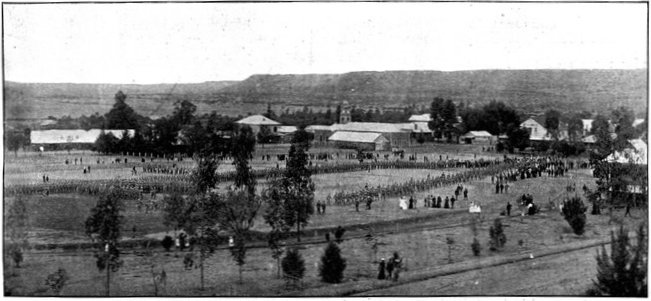
ROYAL DUBLIN FUSILIERS MARCHING OUT OF LADYSMITH FOR
DUNDEE.
Oct. 20, 1899.
From the British camp the ground for some distance sloped down to a
river bed; then followed a short stretch of gently rising ground, and
at the foot of Talana Hill a narrow belt of wood. This[Pg 24] passed, the
real ascent began. Halfway up the hill and just at the point where the
declivity steepened almost to a precipice ran a stone wall, parallel
to the ridge. The Boer position was one of extreme strength. It gave
their picked shots excellent cover, and enabled their rifles and cannon
to sweep with the deadliest effect the slopes below, over which the
British must advance.
While the Dublins, King's Rifles, and Irish Fusiliers went forward to
the river bed, the British artillery cannonaded the ridge at a range of
2,000 yards. The Boer guns, after a two hours' duel, either withdrew or
were silenced; the moment for the infantry assault had come. And what
an assault! to be delivered by three battalions, with present for duty
not more than 2,000 men, upon a seemingly impregnable position, held by
5,000 marksmen whose fame had filled the world.
In extended order, with the British guns firing furiously over their
heads, the three battalions went forward. They reached the wood under
a terrible fire from the heights above; in the wood men began to drop
under the rain of bullets. The Royal Irish Fusiliers and King's Rifles
lost their formation amidst the trees and undergrowth, which spread
confusion and gave no shelter from the pitiless Mausers of the enemy.
Yet the line did not halt. Slowly it gained ground, passed out of the
upper edge of the wood, and began to cross the Aceldama between it and
the wall.
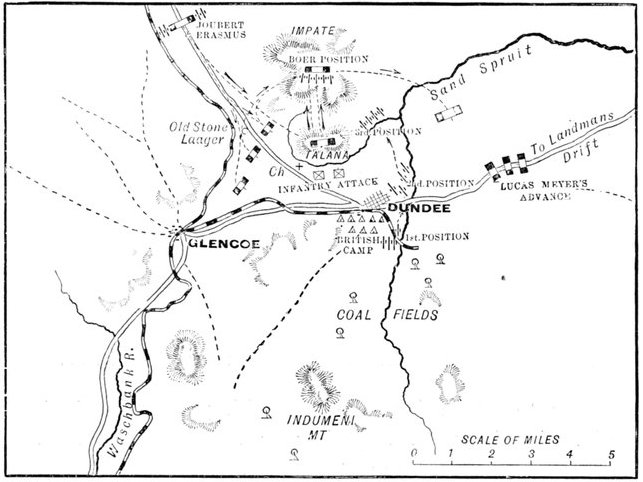
PLAN OF THE BATTLE OF DUNDEE.
October 20, 1899.
Symons wounded.
All the morning General Symons had exposed himself with perfect
indifference to death. He was everywhere, conspicuous by reason of
the lancer with a red flag who followed him to mark his position for
his aide-de-camps. He rode to the lower edge of the wood to tell his
men that they must take the hill, to encourage them by his presence,
and to give them that praise which only the bravest of the brave can
bestow in battle with effect. "You are fine fellows," he shouted to
them. Just after he had spoken, as he was galloping back, he was struck
by a bullet in the groin and mortally wounded. So long as he could
he concealed his wound; then, as his strength failed, he fell or was
lifted from his horse and was carried off the field, calm and confident
to the last. He sent a message to his men that the wound was but
slight, and that he would soon be with them again.
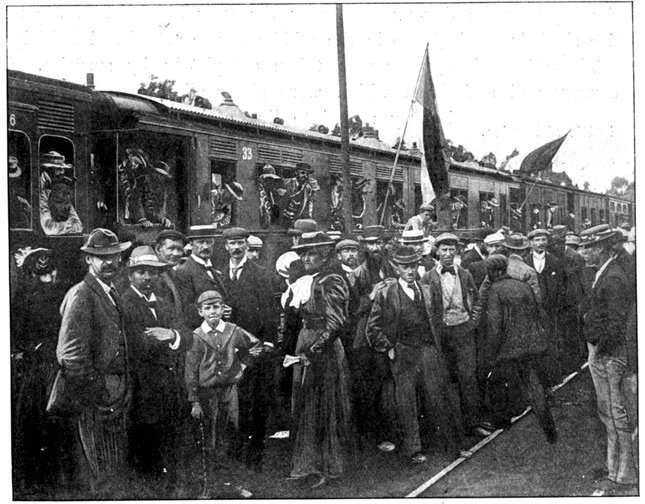
BOER BURGHERS LEAVING JOHANNESBURG FOR THE FRONT.
Oct. 20, 1899.] The Battle of Dundee.
Storming of Talana Hill.
At 10 o'clock the tide of the British advance had surged up to the
stone wall. Under shelter of this there was a prolonged halt while
the artillery bombardment of the ridge continued. Yet so[Pg 25] heavy was
the Boer rifle fire that it was death to leave the shelter of the
wall. About 12, however, there came a lull, and instantly the British
line dashed forward with drums beating, bugles sounding, and officers
in advance. This was the most perilous stage of the combat, for, as
our infantry painfully won its way up the last ascent, the British
artillery had perforce to cease its fire. Under a terrific rain of
bullets the thin brown line worked slowly forward towards the flaming
ridge; for the last time the bugles sounded; bayonets were fixed; and
with fierce cheers the top was won. Here fell Colonel Gunning and
Captain Pechell, in front of their men, as soldiers and Englishmen
should fall. The Boers did not wait to meet the last charge. As the
hill was crowned they galloped off, leaving 100 dead and wounded behind
them, and two flags.

F. C. Dickinson.] [From a Sketch made on the spot.
STORMING OF TALANA HILL.
The treacherous white flag.
The guns had moved up; the enemy were below us and before us, open
to the swift massacre which well-handled artillery can inflict upon
demoralised masses of men. But the guns did not open; the enemy had
hoisted the white flag, and by this shameful ruse covered the retreat.
A great opportunity was lost. Worse still was to follow. The 18th
Hussars and mounted infantry had been despatched to work round the
enemy's flank; in attempting this a squadron of cavalry and most of the
mounted infantry were surrounded by overwhelming forces of Boers and
captured. Thus, though the British infantry had fought gloriously, and
given freely of its life-blood, the success was an almost fruitless
one. The victory did, indeed, save the British force from annihilation,
and showed what Britons, well led, could do; beyond that it had no
results. It was purchased, too, at a great price. Forty-seven British
dead and 221 wounded strewed the slopes of Talana; 208 of the flanking
cavalry and mounted infantry were missing or prisoners.
[Pg 26]
[Oct. 20-24, 1899.
Yule's march.
The battle won, ammunition for another fight was wanting. Ladysmith was
cut off; on the 21st Joubert showed in force to the north, and two big
40-pounders, to which the British had nothing that could effectively
reply, began to bombard the camp. A new position was taken up to the
south of Dundee, out of range of the enemy's big guns. Hence, on the
22nd, General Yule, who had succeeded to the command after General
Symons' fall, hearing of the victory of Elandslaagte, marched with a
detachment to intercept the flying Boers. The task was too serious a
one for his small force, and he had to return. So dangerous was his
position growing hour by hour, that late that evening he determined
to retreat. The night was rainy and misty; at 9 p.m. he marched out
with all his transport, abandoning his camp and his wounded, even
the stricken Sir Penn Symons, and set his face for Beith. He was not
molested; on the 23rd, with beating hearts, the little brigade of
Britishers, now only 4,000 strong, crossed the difficult pass through
the Biggersberg, where a single handful of Boers might well have barred
all passage, and brought about a terrible disaster: the pass, however,
was unguarded. Thereafter the way was plain. On the 24th Sir George
White's guns were heard; next day the advance of the column gained
touch with the main British force. On this day General Symons died
in the enemy's hands, and was buried sadly at night by a small body
of Englishmen and English sympathisers in Dundee. A message from our
gracious Queen and well-won promotion came too late for his dying ears.

R. Caton Woodville.] [From photo taken on the
Battlefield.
GORDONS ADVANCING AT ELANDSLAAGTE.
The retreat of the Dundee force was admirably conceived and well
executed. Yet it is impossible to deny that the gravest risks were
run by hanging on to a very exposed position with a small force. Had
the Boers shown their wonted activity, the detachment must have been
destroyed or captured. It owed its escape to gallant fighting and good
luck.
Oct. 20,21, 1899.] Operations at Elandslaagte.
While these things had been happening at Dundee, General White, at
Ladysmith, had not been inactive. Much of his attention had been
occupied by the Orange Free State commandoes, which showed in great
strength, perpetually threatening Ladysmith and the route to Colenso,
but always[Pg 27] retreating when any attempt was made to bring them to
battle. This was good strategy, and an essential part of the campaign
for the capture of Dundee and its garrison. On the 19th the arrival
of a small force of the enemy at Elandslaagte and the capture of a
train at the station there became known. A previous train, which was
actually standing in the station when the Boers arrived on the scene,
escaped through the daring and presence of mind of the engine-driver,
who turned on full steam and dashed through the enemy towards Dundee,
before they could bring guns to bear.
On the 20th General French went out towards Elandslaagte with a few
mounted infantry and some cavalry, supported by two battalions, to
reconnoitre. As the troops moved off, far away from the north-east came
the dull booming of the cannon, which told of battle raging at Dundee.
The day was so rainy and misty that little could be ascertained. The
British troops fell back in the afternoon, and heard the cheering news
of a great victory at Dundee.
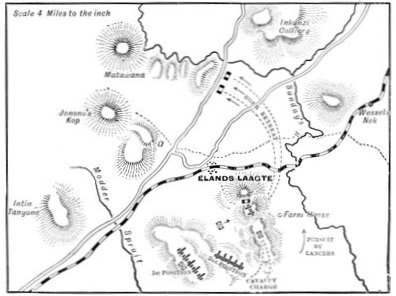
PLAN OF THE BATTLE OF ELANDSLAAGTE.
Battle of Elandslaagte.
On the 21st General French once more left Ladysmith, very early. He had
with him the Imperial Light Horse, raised from the British Outlanders,
six guns of the Natal Artillery, and 400 of the Manchester regiment
in a train. An armoured train accompanied the cavalry. Elandslaagte
was very cautiously approached, but towards 8·30 a.m. the enemy came
into sight. The Boers were riding about on the small plain in which
Elandslaagte is situated; their main position was on a long, rocky
ridge which dropped at the northern end to a "nek" or pass, where
could be discerned their camp. Beyond this again was a small detached
hill. Just behind the camp rose a high, conical mountain, on which
breastworks of stone could be made out, dominating the whole position.
Black figures could be seen all along the sky-line of the ridge,
indicating that the enemy was in force.
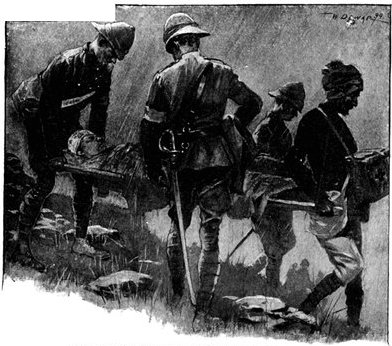
W. Dewar.]
REMOVING THE WOUNDED AFTER THE BATTLE OF ELANDSLAAGTE.
This operation had to be performed in a pouring rain and in almost
total darkness.
The Natal Artillery opened the battle by directing a fire upon the
railway station. At once the Boers replied. Two shells, beautifully
aimed, fell right amongst the British guns, putting one ammunition
waggon out of action. Our weapons were old and feeble 7-pounders, the
Boer guns long-range quick-firing 14-pounders—the weapons lost in the
shameful Raid, and now by strange retribution pointed against the brave
men who had to pay for the deplorable mistakes of the past. Nothing
but withdrawal could have saved the Natal Artillery. The guns fell
back and the British force hastened out of range, while General French
telegraphed instantly for reinforcements.
[Pg 28]
[Oct. 21, 1899.
A couple of hours later these began to come up. First arrived the 5th
Lancers and two batteries of field artillery, tearing along with double
teams at a gallop. Then came Colonel Ian Hamilton, who had fought and
received more than one wound in the struggle with the Boers in 1881. He
brought with him the rest of the Manchesters and 1,200 Devonshires and
Gordon Highlanders. This gave General French a total of 2,000 infantry,
480 artillery, and about 800 cavalry; he was now able to return and
resume the attack.
The two British field batteries opened a furious fire on the Boer guns,
which were located on the top of the long ridge; the British cavalry
pushed round to the left and right of the Boer position; the British
infantry, in open formation—Gordons and Manchesters on the right,
dismounted men of the Imperial Light Horse in the centre, and Devons on
the left—prepared to advance to the assault when the cannon had done
their work. It was to be Talana Hill over again, but this time with a
weaker Boer force.
The enemy's guns were fought with the most obstinate courage; shrapnel
constantly burst amidst them: three times their gunners fell back and
each time returned to their work. The roar of the artillery duel filled
the air, yet in spite of all its sound and fury, the loss of life on
either side was as yet small.

Max Cowper.] [After a photograph.
LANDING AT CAPETOWN OF COMMANDANT PRETORIUS, WOUNDED AND CAPTURED AT
ELANDSLAAGTE.
The day was advancing, and if the position was to be carried before
night fell, the stormers must advance, though the British artillery
preparation was still far from complete. As the hours wore on, General
French sent in his infantry to the assault. A thunderstorm raged over
the scene of carnage as the line went forward, adding to the grandeur
of the spectacle. The British advance across the plain under a fearful
fire was splendidly conducted; the Devons were as steady as on parade,
firing volleys from time to time and always slowly gaining ground, till
they reached the foot of the final steep ascent which led to the summit
of the ridge. Men were dropping every moment; the Mauser bullets sang
through the air thick as swarms of bees, while in front the crest of
the ridge glowed with the perpetual rifle fire of the enemy against the
inky blackness of the storm-clouds.
[Pg 29]
Oct. 21, 1899.] The First British Victory of the
War.
On the right, the Gordons, Manchesters, and Light Horse were also
pushing forward. With a roar of cheering they gained the top of the
ridge, living and dead and dying in one compact mass. The air rang with
tumultuous shouts; the bugles sounded the charge, for the Gordons had
yet to storm their way along the ridge under a withering stream of lead
which poured from an eminence at its further end; Colonel Ian Hamilton
was playing his last card. But the Gordons, after a brief check, swept
on along the ridge, tearing down or cutting the barbed wire fences
which in half-a-dozen places intersected it. Each fence, each stop,
meant death to many gallant men. At last, however, the Boer guns were
gained; the Devons too came pouring up the hill, and a torrent of
British soldiery swept exultant upon the last Boer remnants.

J. Finnemore.]
CHARGE OF THE LANCERS AFTER THE BATTLE OF ELANDSLAAGTE.
The men at the enemy's guns were bayonetted, and some volleys were
poured in upon the host of fugitives tearing down the other side of the
hill. A few unwounded and many wounded prisoners were taken.
But as the enemy fled in the falling darkness, the Lancers and Light
Horse rode at them. From the nature of things they could give no
mercy. The terrible steel spears did their work amongst the yelling,
panic-stricken fugitives; the Light Horse, too, had much to avenge—the
murder of Edgar and innumerable shameful outrages in the past—and they
avenged it. It was a complete and decisive victory, the first that had
been gained in the war.
British and Boer losses.
[Oct. 21, 1899.
The British losses were heavy, considering that less than 3,000 men
had been engaged on our side. Fifty-five were killed and 199 wounded,
the Gordons suffering most severely. One-third of the half-battalion
engaged was left upon the ground, and fourteen officers, amongst whom
was their colonel, were killed or wounded. The Imperial Light Horse
also lost their colonel, Scott-Chisholm, shot three times in quick
succession as he reached the top of the ridge. Major Sampson, who had
fought the Boers before, and suffered for the honour[Pg 30] of an Englishman
long years of imprisonment in Pretoria Jail, now poured out his blood
once more for his country. What the enemy's loss was it is impossible
to say; 65 Boers were buried by the British on the ridge, at least 50
were killed by the Lancers, and as many more may have been removed
before the assault. In killed alone the Boers must have lost 150. Two
hundred prisoners, mostly wounded, were taken, and probably 200 wounded
were removed. The Johannesburg commando, about 2,000 strong, was
completely broken up.
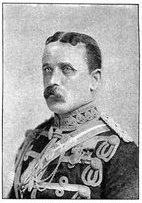
[Photo by Lambert Weston, Folkestone.
MAJOR-GENERAL J. D. P. FRENCH.
Born in 1852. Served in the Militia, but joined the 8th Hussars as
Lieutenant in Feb. 1874, and changed to the 19th Hussars in March.
Captain 1880. Major 1883. Served in the Nile Expedition in 1884-5, and
accompanied Sir H. Stewart's column in the attempt to rescue Gordon
at Khartoum. Lt.-Colonel, 1885. Colonel, 1889. In command of Cavalry
Division in South Africa with rank of Lt.-General, 1899; won the
victory of Elandslaagte, Major-General 1900 (in recognition of his
services in relieving Kimberley).
"Remember Majuba!"
As a feat of arms on the British part the victory was a wonderful one.
Words can scarcely give an idea of the strength of the Boer position.
"Remember Majuba!" shouted the victorious troops, and it was Majuba
over again, but with the difference that this time it was the Boers who
were beaten. They fought bravely, but it is sad to relate that there
were many instances of the most discreditable savagery on their part.
A burgher deliberately shot two wounded British soldiers, when several
Britishers came on him at his bloody work. He dropped on his knees and
cried for mercy, but got what he deserved. A Gordon officer was killed
by a Boer to whom he gave quarter. Another Boer showed a white flag and
then emptied a revolver into the approaching Britishers, who were off
their guard.
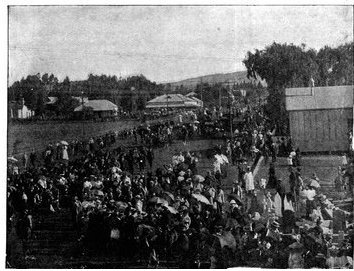
FUNERAL OF THE BOER GENERAL KOCH AT PRETORIA.
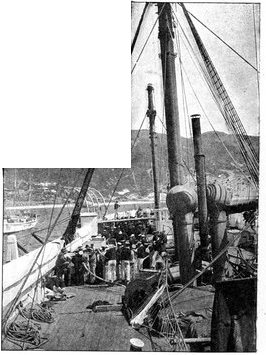
BOER PRISONERS ON BOARD H.M.S. PENELOPE AT SIMONSTOWN.
Oct. 21, 1899.] After the Battle.
Amongst the wounded Boers were many men of note in the Transvaal.
General Koch was wounded, and his son, Judge Koch, who had acquitted
the murderers of the British subject, Edgar, at Johannesburg some
months[Pg 31] before, was killed. Colonel Schiel, a German officer who had
directed the Boer artillery and had in the past been guilty of inhuman
atrocities to the natives, was severely wounded.
Night fell before the battle was over. The rain still poured down, the
wind was bitterly cold; and the agony endured by the wounded, lying out
on that stony mountain without shelter, food and water, was terrible.
With all the expedition that was possible in the inky darkness the
field of battle was searched for living men. The badly wounded were
carried down the slopes to the enemy's captured camp; the slightly hurt
gathered, Boers and Englishmen, round the camp fires. Our men gave the
best places—the snuggest corners, if there could be any snug corners
in the open on such a night as that—to their enemies.
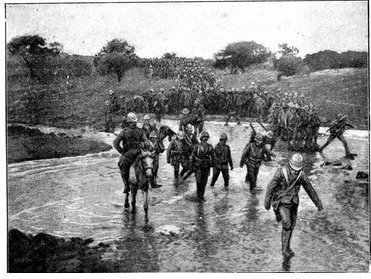
[Photo by G. Lynch.
GENERAL YULE'S MARCH.
From a photograph taken at a drift on the road.
With daylight General French's force marched back to Ladysmith. Among
the prizes of the battle were the train, officers and correspondents,
captured by the Boers on the 19th.
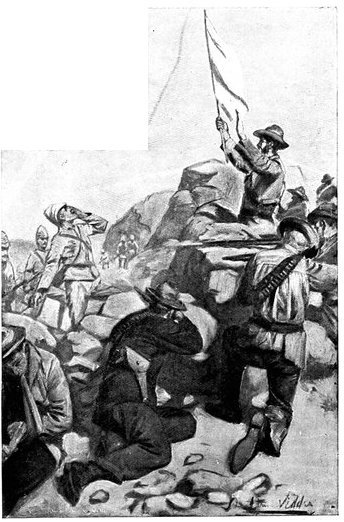
[S. H. Vedder.
ABUSE OF THE WHITE FLAG BY THE BOERS AT ELANDSLAAGTE.
During the later stages of the action General White had been present.
Yet with knight-like generosity he refused to take over the command
or to assume for himself any credit. His despatch gave the glory to
General French alone.
Action of Rietfontein.
[Oct. 24, 1899.
A day later, on October 23, the Boers were once more at Elandslaagte,
this time in very great force. Fearing that they would work across the
railway and cut off General Yule's retreat, General White determined
to occupy their attention. Early on the 24th 3,000 infantry, four
batteries of artillery, and 1,500 cavalry and mounted infantry moved
out from Ladysmith. Ten miles had been covered, and the British force
was still five miles from Elandslaagte, when the Boers were found
several[Pg 32] thousand strong in a formidable position along a ridge near
Rietfontein, on the little stream known as Modder Spruit. On two lofty
eminences, Matawana's Kop and Jonono's Kop, they had artillery. Their
skirmishers were driven in, and our guns at once unlimbered and opened
a hot fire, which was as warmly returned. Attempts were made by the
British to work round the enemy's flank, but this, with the small
number of men available, was quite impossible.
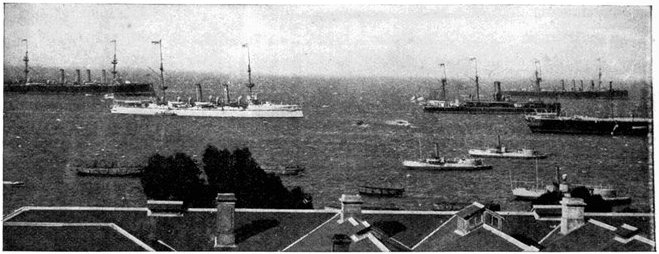
BRITISH WARSHIPS AT SIMONSTOWN THE DAY AFTER THE BATTLE
OF ELANDSLAAGTE.
Flags were run up to the mastheads in honour of the British victory.
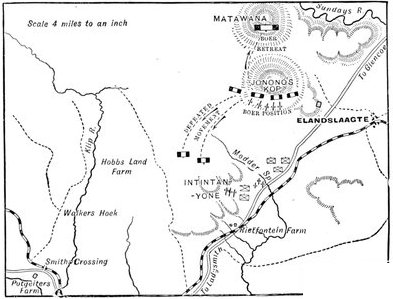
PLAN OF THE ACTION AT RIETFONTEIN.
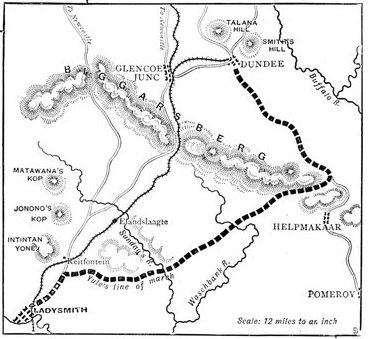
MAP OF GENERAL YULE'S MARCH FROM DUNDEE TO LADYSMITH.
The enemy in turn endeavoured to achieve the same manœuvre against our
forces, and the attempt was not repulsed without difficulty or loss.
The firing was very heavy, yet the British troops, it was noticed,
shot as steadily and as accurately as the Boers, showing how vast an
improvement had been effected in the training of our army since the
dark days of 1881. As for the Boer artillery, its aim was magnificent,
but its projectiles were bad. The British infantry, covering the
British gunners, suffered heavily. The Gloucesters, in the forefront of
the battle, lost their colonel and 63 men killed, wounded, or missing.
As the morning wore on there was difficulty in preventing what had been
intended only for a skirmish growing into a furious pitched battle. At
last, about 1 p.m., the welcome news arrived that General Yule's column
was near enough to be safe. It had heard the roar of the firing, and
was hurrying towards the field to co-operate. Keeping in touch with
Yule, General White withdrew his men and marched back to Ladysmith. The
British loss was heavy, considering that this was little more than a
skirmish, and that no assault on the enemy's position was delivered: 12
were killed, 104 wounded, and 2 missing. The Boers, probably, suffered
to about the same extent.
[Pg 33]
Oct. 27, 1899.] Exposed Situation of Ladysmith.
Three days passed before further operations were undertaken. General
Yule's men were wearied with hard marching: General White's with
continuous marching, counter-marching, and fighting, and rest had to
be given to the infantry. The enemy used the time to bring down troops
from the north; Joubert's thousands and his powerful artillery took
post round the north and east of Ladysmith; other thousands from the
Free State continued the line of investment to the west and south. On
the 27th they showed with men and guns near Pieter's, on the railway
between Ladysmith and Colenso, with the obvious intention of cutting
General White's communications with the rear. Only the efforts of
General French with the British cavalry kept them back.
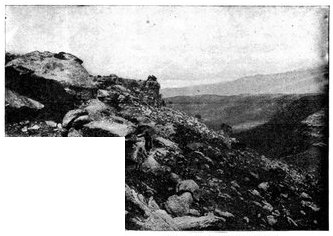
SLOPES OF INTINTANYONE.
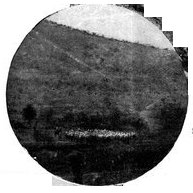
ROYAL DUBLIN FUSILIERS AT THE FOOT OF INTINTANYONE THE
DAY BEFORE THE BATTLE.
The Boer tactics.
The Boer strategy was of archaic simplicity, but great effectiveness;
it aimed at enveloping the British forces, in small detachments,
entrenching Boer commandoes round the British camps, bringing up
artillery of the heaviest possible calibre, and then inviting attack.
The Boers themselves rarely assaulted. They had infinite patience,
and, when once the British were shut in, waited for time and hunger to
accomplish the required object.
The town of Ladysmith was badly situated for defensive purposes. It was
dominated by two high hills which rose the one to the north-east and
the other to the east, known as Lombard's Kop and Bulwana Mountain,
four or five miles distant. To the rear of the town was the Klip River,
which was fordable except during heavy rains. Here centred the roads
and railways from the Transvaal, from the Free State, and from eastern
and southern Natal. Here also great quantities of stores and ammunition
had been accumulated, in readiness for a forward move. The distance by
railway from Pietermaritzburg, the capital of Natal, was 119 miles;
from Durban, the real British base, 189 miles.
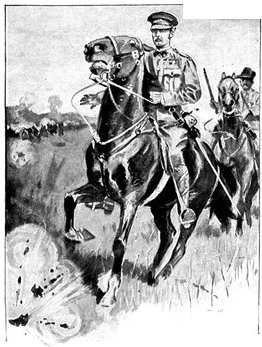
GENERAL SIR GEORGE WHITE UNDER FIRE AT ELANDSLAAGTE.
[Oct. 27, 1899.
White decides to hold Ladysmith.
General White had now to arrive at a most critical decision. He had to
determine whether he should hold on to Ladysmith or abandon the place
and fall slowly back. It was already clear that the Boers were far
stronger than anyone in the British army had supposed. They had heavy
artillery, with which the British force was utterly unprovided, and
even their field-guns had on[Pg 34] occasion outranged ours. They had fought
splendidly; after each battle and each British victory it was said that
the "moral effect" would be enormous, yet, nevertheless, the Boers
always advanced, and appeared to come up smiling. Moreover, certain
circumstances had taken the edge off our victories. After Dundee the
Boers had captured a great part of our cavalry; and Yule's retreat
left them all our wounded of that battle. After Elandslaagte had come
Rietfontein, in which they had fully held their own. They had overrun
the northern wedge of Natal, and were confident of driving the British
into the sea.
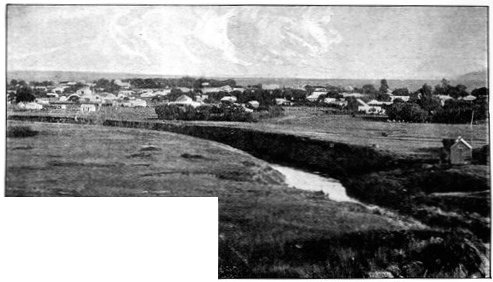
NEWCASTLE, NATAL.
This little town, near the Transvaal border, was abandoned by the
British when concentrating at Dundee and Ladysmith. The late Mr.
Escombe, formerly Premier of Natal, was staying here, and was one of
the last to leave.
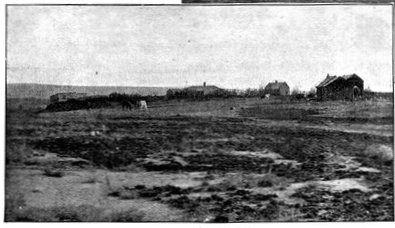
FORT AMIEL, NEWCASTLE.
No substantial help could be expected for three weeks; the only
reinforcements immediately available were the Border Regiment and the
Rifle Brigade, at the most 1,600 men, which were landing at Durban
on their way from Europe. But if General White fell back the moral
effect would be very bad, and the difficulty of preventing the enemy
from overrunning the centre of Natal and plundering the loyalists very
great; moreover, the vast accumulation of British stores and ammunition
at Ladysmith would have to be either destroyed or abandoned if our army
retreated.
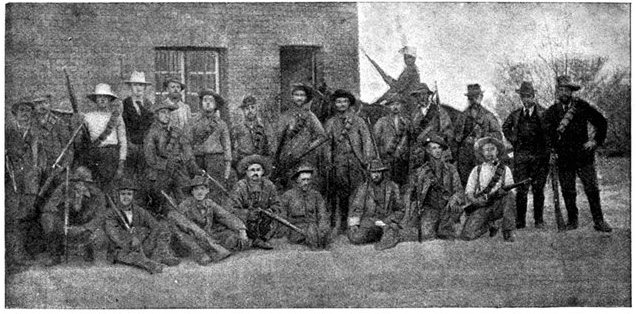
HOLLANDERS IN POSSESSION AT FORT AMIEL, NEWCASTLE.
These Hollanders must not be confused with the Boers; they are natives
of Holland in the pay of the Transvaal Government. The photograph shows
a party of them in occupation of Fort Amiel, after the abandonment of
Newcastle by the British.
General White, therefore, decided to hold the town. He had now under
his orders about 12,000 men and 48 guns—36 15-pounders of the field
artillery and 12 7-and 9-pounders of little value. Of the total force
about 2,400 were mounted men. Against these the Boers had from 25,000
to 30,000 men and a large number of guns. They were, to a man, mounted,
and good horsemen; many of them knew the country; all were accustomed
to the peculiar warfare which the terrain in South Africa renders
necessary.
[Pg 35]
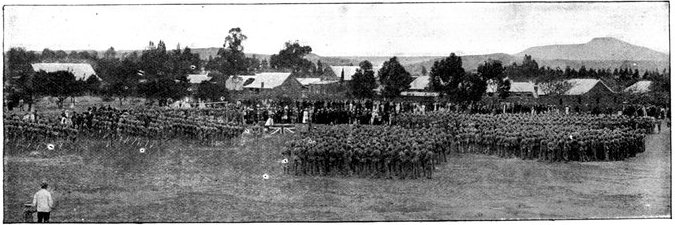
A SUNDAY SERVICE IN LADYSMITH.
CHAPTER III.
THE INVESTMENT OF LADYSMITH, MAFEKING, AND KIMBERLEY.
The Boers seize the heights dominating Ladysmith—The
Battle of Farquhar's Farm—White withdraws to
save the town—The guns brought off—Dramatic
advent of the Bluejackets—Loss of Carleton's
column—Neglect of precautions at Ladysmith—The
town beleaguered—Condition of affairs on the
Western Frontier—Doubtful attitude of the Schreiner
Ministry—First act of war—Attempts to capture
Mafeking—The Boers seize Vryburg—Kimberley
isolated—Bombardment commenced—Stormberg district
abandoned by the British—Attitude of the Cape Dutch.
On October 27 a strong British column marched out of Ladysmith and
reconnoitred. The enemy, being not as yet in sufficient strength, or
possibly anxious to draw the British on, fell back, and there was
nothing more than an interchange of shots.
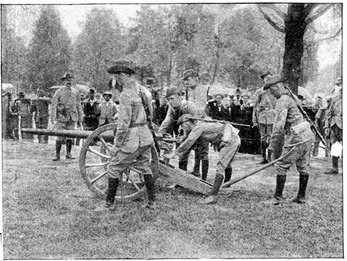
MARITZBURG HOTCHKISS GUN DETACHMENT.
Shut up in Ladysmith; Lieut. Walker in command.
The Boers seize the heights dominating Ladysmith.
There was a lull until the 30th. Between the 26th and 29th the Boers,
repeating their Dundee tactics, seized the ridge to the north of
Ladysmith known as Pepworth Hill, about 7,000 yards from the town,
and placed two or more heavy 40-pounder siege guns in position there.
They also brought up a large number of smaller guns—Schneider-Canet
quick-firers and Maxim automatic 1-pounders—from the ample store
with which the gold wrung from the Outlanders had provided them, and
throwing up entrenchments, further strengthened a naturally strong and
commanding position.
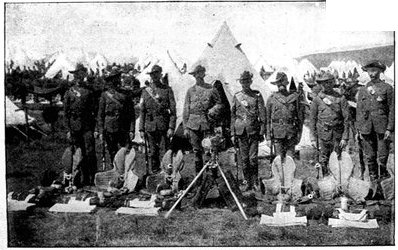
NATAL CARBINEERS WITH MAXIM GUN.
This picture represents the detachment under Lieut. Gallway in camp at
Ladysmith. They were taken prisoners in the battle of Dundee.
[Oct. 29, 1899.
On October 29 a war balloon which had just arrived from England was
sent up, and the Boer positions were reconnoitred. Late in the evening
the greater part of two battalions of infantry—the Gloucesters and
Dublin Fusiliers—under Colonel Carleton, with a mountain battery, a
total of about 1,200 men, were detailed to move out, under cover of[Pg 36]
night, to seize two hills close to the Klip River and six miles to the
north of Ladysmith, thus securing the British left for next day's work.
The only enemies expected to be encountered in this direction were the
Free Staters, who were reported to be in no great force.
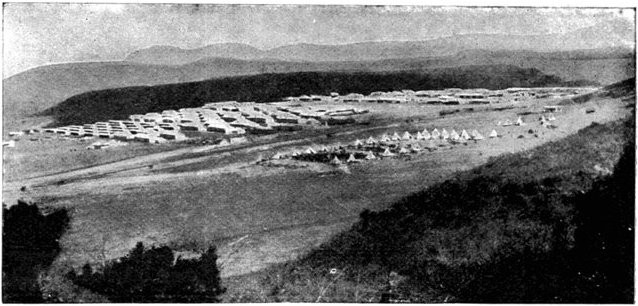
LADYSMITH CAMP IN THE EARLY DAYS OF THE WAR.
To the right of Carleton was Colonel Ian Hamilton with three battalions
of infantry, the Imperial Light Horse, and three batteries. He took
post facing Pepworth Hill during the night. On his right again was
a brigade, five battalions strong, under Colonel Grimwood, with
three batteries, facing the Boer position at Farquhar's Farm, to the
north-east of Ladysmith.
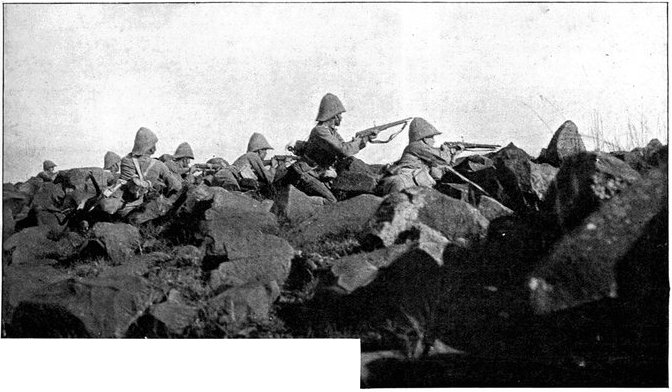
[Photo by H. Nicholls, Johannesburg.
THE DEVONS IN ACTION.
This photograph was taken on the battlefield, and represents the
Devonshire regiment in a position facing Pepworth Hill, firing from
behind boulders, which form an effective cover. One of the men, having
just fired, has risen to watch the effect of his shot. The photograph
demonstrates the absence of smoke from modern rifle-fire.
Last of all, on the extreme British right, was General French with the
whole of the cavalry. Only a skeleton force was left behind to defend
Ladysmith. The main attack was to be delivered by Hamilton's brigade
upon Pepworth Hill.
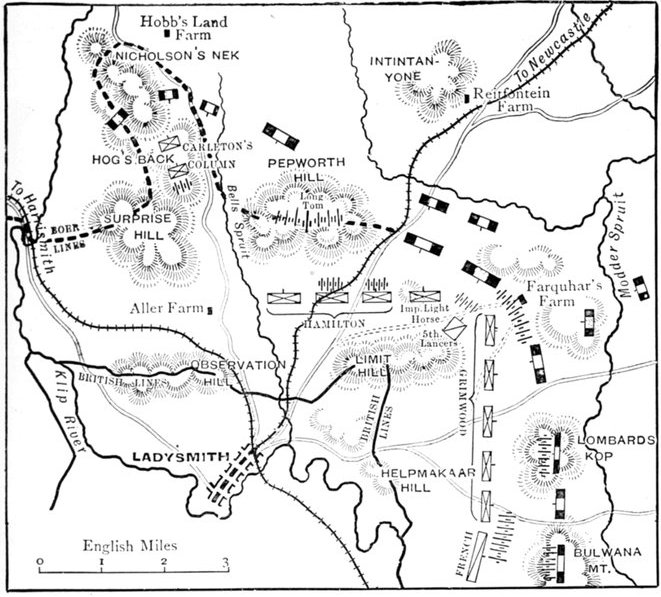
PLAN OF THE BATTLE OF FARQUHAR'S FARM.
Oct. 30, 1899.] The Boers Reinforced.
Dawn came, and with it an unpleasant accompaniment in the shape of
shells from the big Boer 40-pounders, which fell in the town. The
battle opened when the British troops were noticed by the enemy to be[Pg 37]
drawn up in the appointed positions. In front of our men were green
swelling hills or frowning ridges, the skylines broken only by the
enemy's entrenchments and here and there by their field-guns. The whole
country, indeed, seemed alive with their hosts, which held in ample
force the horseshoe-shaped heights dominating Ladysmith from the east
and north-east.
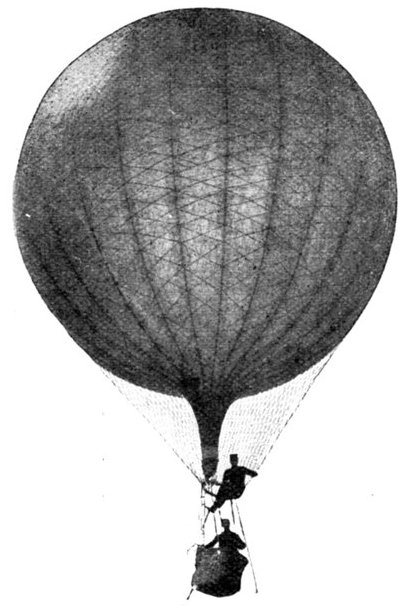
WAR BALLOON IN USE AT LADYSMITH.
The Battle of Farquhar's Farm.
The enemy's field artillery opened from Pepworth Hill and Farquhar's
Farm upon the British infantry; the British artillery kept under cover
and did not reply till the hostile guns, which fired smokeless powder
and which were therefore most difficult to find, had been located.
Then at last our batteries got to work, and a fierce duel began. The
ridge and the plain below were both one sheet of flame. The main Boer
artillery position was soon a mass of small clouds of smoke from our
bursting shrapnel. About 6·50 the enemy's guns seemed to be silenced,
or fired only spasmodically, whereupon our guns shelled the gullies of
the heights in which the Boer marksmen lay for shelter, driving them
back. Gradually our artillery fire also abated, and the battle paused.
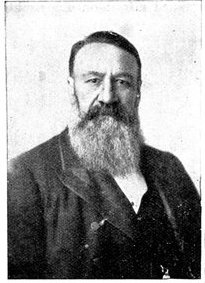
GENERAL JOUBERT, COMMANDING THE FORCES OF THE TRANSVAAL.
General Pietrus Jacobus Joubert, born at Cango, Cape Colony, 1833;
State Attorney of Transvaal, 1867; acted as President during Kruger's
absence in Europe, 1883-84. Has twice been an unsuccessful candidate
for the Presidency.
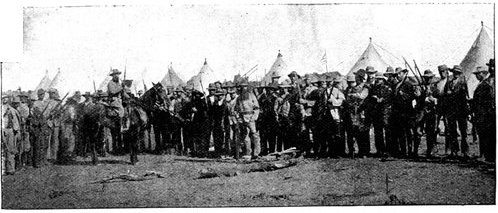
A BOER COMMANDO.
When occasion arises for a Boer commando to be called out, the Field
Cornet or local magistrate rides round to the neighbouring farms and
commandeers, i.e. orders out, the farmers into the field. They go
out just as they are, with rifle, bandolier, their horse, and a piece
of biltong, or dried meat, in their pocket. A collection of some two
or three hundred farmers from one particular district is termed a
commando.
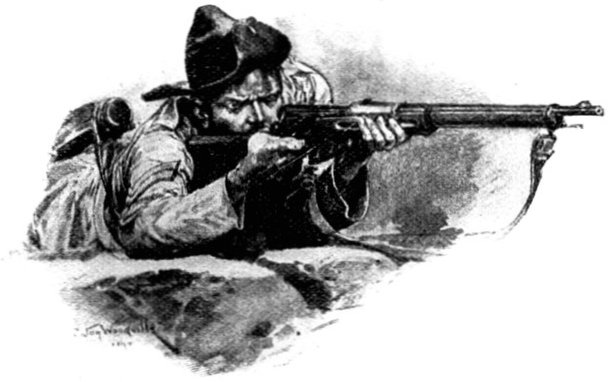
A BOER SHARPSHOOTER.
R. Caton Woodville.] By permission of H. Graves & Co.
[Oct. 30, 1899.
From the column on the left no news had arrived. About six heavy
firing was heard in its direction; an hour later came the crash of
a furious fusillade, in which the growl of the Maxim could plainly
be heard. To this quarter was shortly afterwards seen moving a very
strong commando of the enemy. It was observed pouring down a far-off
hill "like a colony of ants on the march." The roar of firing on the
left grew louder, and the battle broke out with renewed vigour over
all the wide sweep of the quadrant. The Boer guns opened once more; it
was clear that the enemy had been strongly reinforced. They showed all
round in such strength that the Imperial Light Horse on the left centre
had to fall back, and the British artillery in this quarter changed
position slightly to meet the oncoming foe. A heavy fire checked the
Boer advance, but could not defeat it; to prevent the main British
force from being cut off from its left, our troops were thrust forward,
battalion by battalion, until every available man was in line.[Pg 38]
Two British batteries pushed forward into the open and dosed the
Boer 40-pounders and other guns on Pepworth Hill with shrapnel so
effectively that they almost ceased fire.
On the right, however, fresh Boer weapons were each minute coming
into line, and the artillery preponderance hitherto on our side was
threatening to pass from us. The enemy's automatic 1-pounder guns were
particularly annoying, directing their stream of small but deadly
shells upon our guns and our infantry. Yet so splendidly was the
British artillery handled that once more it got the better of the foe,
checked the counter-attack on the right, and was paving the way for
an infantry assault upon the Boer position at Farquhar's Farm when
suddenly the most disquieting news arrived from Ladysmith.
White withdraws to save the town.
This was an urgent message from Colonel Knox, in command of the town,
to Sir George White, stating that the enemy appeared to be on the
verge of making a determined attack on Ladysmith and the British camp
from the north. Without doubt the Boers advancing in this quarter were
the commandoes which should have been held back by Carleton's unlucky
column. General White could do nothing but retreat; there was only a
mere handful of men in Ladysmith. But to withdraw his forces from a
pitched battle, in the presence of a vastly superior enemy, was no easy
task.

John Charlton.]
BRINGING OFF THE GUNS.
Oct. 30, 1899.] Heroism of the Field Artillery.
The battlefield at this moment was a strange spectacle. Though hill
and plain spurted continuous flame, a man standing midway between
the two armies could have discerned little. It was not the battle of
the past with masses of men theatrically manœuvring amidst clouds of
smoke, but the battle of to-day—of the future—a weird, empty-looking
smokeless field, where only the fearful din of hidden guns and rifles,
of Maxims, Nordenfelts and Hotchkisses, of bursting shell and shrapnel,
told of the presence of two combatant peoples. The troops, even the
guns, were, as far as could be, behind cover, whence it followed that
the effects of the artillery fight, though nerve-shaking enough, were
incommensurate on either side with all the tremendous sound and fury.
The air was thick[Pg 39] with splinters, shells, shrapnel, and bullets, yet
this mighty storm burst for the most part ineffectually on the veldt.
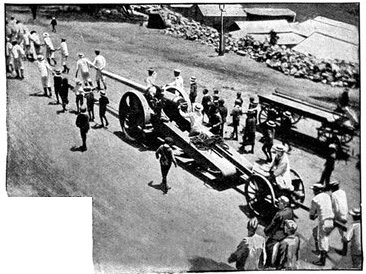
NAVAL 45-POUNDER (4·7) GUN.
This is one of the guns of H.M.S. Doris, mounted on Captain Scott's
improvised carriage, and brought from the Cape to Durban by H.M.S.
Powerful. The photograph was taken while the gun was on its way to
the front.
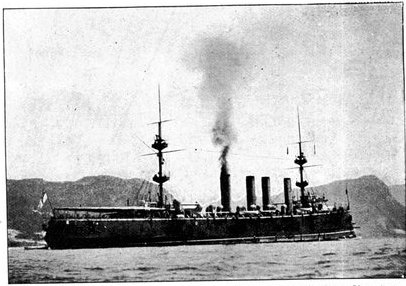
[From a Photograph taken at Simonstown.
H.M.S. "POWERFUL."
Brought half a battalion from Mauritius, on Captain Lambton's own
initiative, when proceeding from China to the Cape; and furnished the
contingent which arrived so opportunely at Ladysmith during the battle.
The guns brought off.
The two battalions of the King's Royal Rifles were the leading
infantry, and as they were ordered to retreat came under a heavy fire,
and were thrown into disastrous confusion. Indeed, for a moment it
looked like complete rout, and had the enemy snatched his opportunity
that would have been the end of the Ladysmith army. But with superb
devotion the 53rd Field Battery galloped forward and prepared to offer
the last sacrifice which artillery can make—to save the army at the
cost of its own annihilation. The automatic Maxim shells rained upon
the guns; a cloud of dust hid the 15-pounders from view; but the
gunners stuck manfully, heroically to their task under a terrible
cross-fire. For half-an-hour they held their ground; one limber was
shattered; five out of six horses of one gun were killed. Then, at
last, the five intact guns fell back. Nor was the sixth gun abandoned.
Bombardier Saunders, Gunners Bright and Barron, and Drivers Macpherson,
Darcy, and Stoddard, under Captain Thwaites, dashed back with a team
and limber from the waggons and under a tremendous fire brought off the
last weapon.
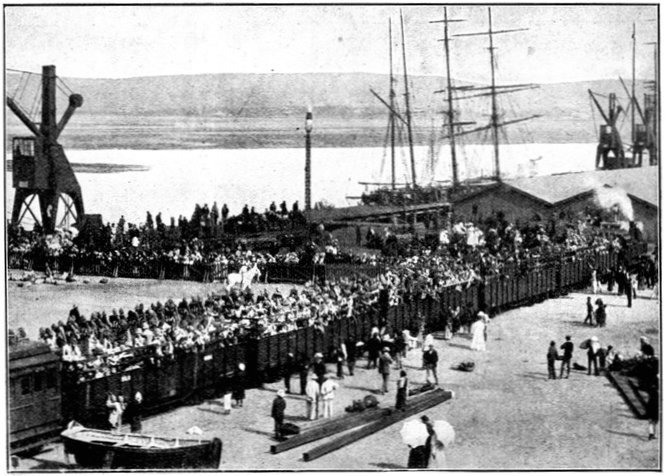
LANDING AT DURBAN OF REINFORCEMENTS FOR LADYSMITH.
The enthusiasm of the loyal colonists found expression in their lavish
gifts to the soldiers and sailors on the way to the front. Cigars,
pineapples, pillows, and ladies' visiting cards were pressed upon them,
the last with promises to send anything which might be needed, "on
demand."
[Oct. 30, 1899.
This half-hour's delay was the salvation of Ladysmith. Already one of
the two battalions[Pg 40] from Durban, the 2nd Rifle Brigade, had arrived
by train and deployed upon the battlefield, a most welcome help and
reinforcement. The 53rd and 13th Batteries covered the retreat in the
centre, the one withdrawing while the other shelled the enemy. As the
town of Ladysmith was neared it was discovered that the report of an
intended Boer attack had been either unfounded or premature. But the
Boer 40-pounders on Pepworth Hill were pouring a galling fire into
the town. Help was needed to keep these long range guns in order, for
none of our field artillery weapons could drive their projectiles the
required distance. Help was dramatically forthcoming.
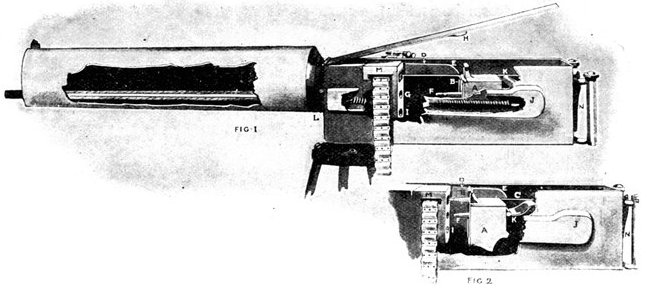
MAXIM AUTOMATIC GUN.
The action of this gun will be readily understood on reference to this
section. The block A travels to and fro on the guides C (one on each
side). It is provided with a rising front B, which at each stroke
runs up the inclined plane E, along the upper guide D, and picks up a
cartridge from the continuous belt shown just below the letter M. At
the next stroke this cartridge F is driven into the orifice G in line
with the barrel and fired. The empty case is then withdrawn, and at
the next stroke is forced into the orifice I, whence succeeding cases
push it on till it drops out at L. The gun is started by hand, but when
once working the "recoil" from the explosion of the cartridge drives
the block A back, and the springs K and J then force it forward again.
This reciprocating motion is kept up so long as the thumbs are pressed
against the springs N. The barrel is surrounded by a cylinder full of
water to keep it cool.
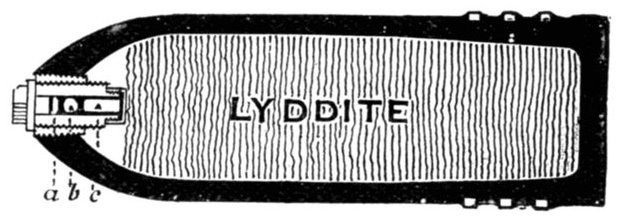
LYDDITE SHELL
As fired by the large naval guns at Ladysmith. a detonating pellet;
b weight; c guncotton priming.
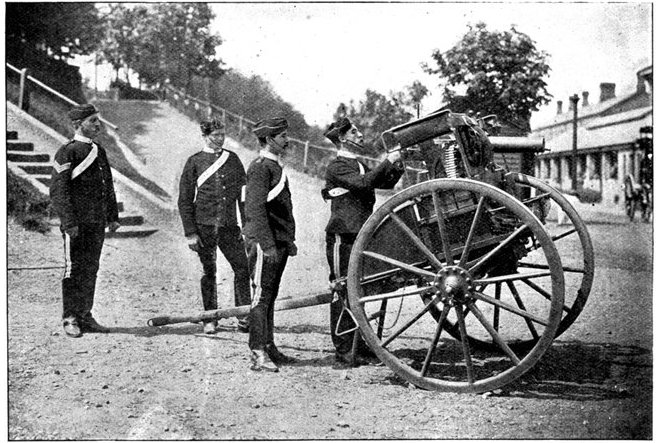
[Photo by Gregory.
SIGHTING A MAXIM GUN.
In this case the gun is mounted on a galloping carriage. Sometimes it
is mounted on a tripod, as shown in the illustration at the foot of
page 35.
Dramatic advent of the Bluejackets.
Oct. 30, 1899.] The Disaster of Nicholson's Nek.
Early that morning a Naval Brigade, 280 strong, from H.M.S. Powerful,
under the orders of Captain Lambton, had arrived on the scene, bringing
two Maxims, four long naval 12-pounders, and two 45-pounders. These
weapons had been taken from on board the ships of the Cape Squadron or
from the reserve naval stores, and by the ingenuity of Captain P. Scott
of the Navy, and Assistant-Engineer Roskruge, had been mounted upon
special carriages which would permit their being handled in the field.
The sailors had with them a large supply of lyddite shells—shells
charged with the terrible high explosive which had been tried for the
first time in war at Omdurman, and which kill, without apparent injury,
men fifty yards away from the spot where they burst, by the mere shock
of their detonation. The bluejackets had come post-haste, standing on
no ceremony, travelling up all night by train from Durban. The big
45-pounders were too heavy and cumbrous to be got into position in the
exceeding[Pg 41] emergency; the 12-pounders, however, at once moved out to
the aid of the hard-pressed Natal Field Force.
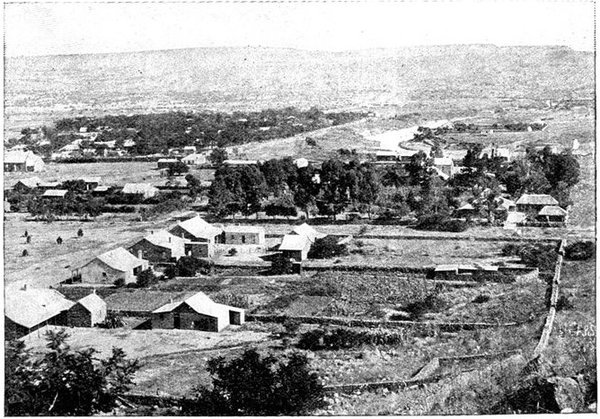
[Photo by Pearse.
LADYSMITH AND THE KLIP RIVER.
The sturdy bluejackets, splendidly led, had whipped one of their guns
into position almost before their arrival was known. "Action!" and the
breech was opened and closed: "Fire!" and a shell went sailing towards
the Boer 40-pounders. Then followed the fearful crash of the common
shells. Eight missiles from the Navy gun did the work: the enemy's
fire was stilled; and one more great record was added to the countless
achievements of the ever-ready British Navy. Silence fell upon the
field, and it was possible to number the slain.
In this battle, known as that of Farquhar's Farm, the British losses on
the centre and right were about 60 killed and 240 wounded.
Loss of Carleton's Column.
The afternoon wore on and no news came in from Carleton's column on the
left. Disaster had evidently befallen it, for stragglers and wounded
brought in during the morning stories of an extraordinary stampede of
mules during the night, which had thrown the little force into complete
confusion.
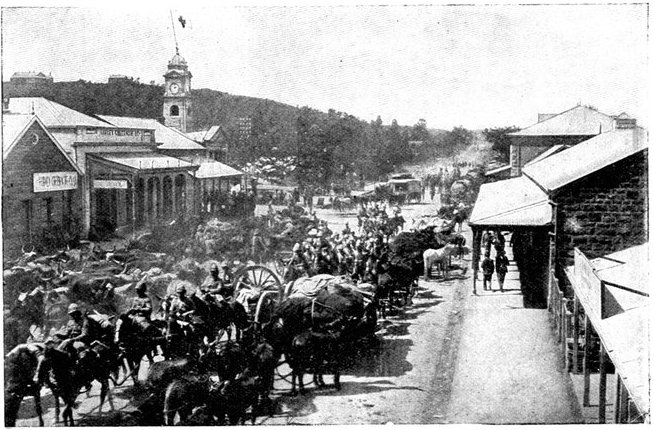
[Photo by H. Nicholls, Johannesburg.
ARTILLERY RETURNING TO LADYSMITH AFTER THE BATTLE OF FARQUHAR'S FARM.
The waggons on either side of the street were loaded with ammunition
and commissariat for a three or four days' fight. Owing to the disaster
at Nicholson's Nek they never went into the field. The red-cross flag
was flying from the Town Hall, which had been turned into a hospital.
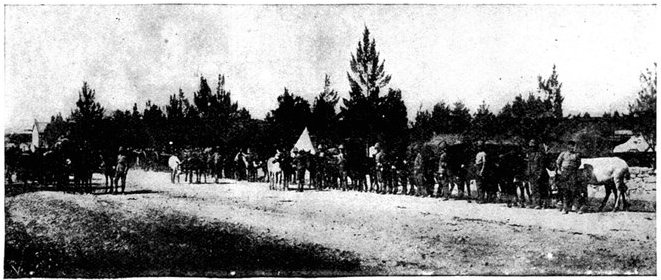
TRANSPORT MULES AT LADYSMITH.
The stampeding of some of these mules led to the disaster at
Nicholson's Nek.

BRITISH PRISONERS, CAPTURED AT NICHOLSON'S NEK, ON THE
ROAD FROM THE STATION TO THE RACE-COURSE, PRETORIA.
[Oct. 30, 1899.
Oct. 30, 1899.] A Hopeless Struggle.
What had happened was as follows. The column started at 10·30 p.m.,
with the Royal Irish Fusiliers leading, the six mountain guns and
208 mules in the centre, and the Gloucesters bringing up the rear.
The night was very dark, but through the darkness could be heard the
ominous sound[Pg 42] of the snapping of breech-blocks on either flank, and
occasionally the clear ring of a dropped rifle, indicating that the
enemy was close at hand. Nearing the point which was to be seized the
column had to make its way through a defile. While in the midst of
this defile a shot was suddenly fired, and great boulders were rolled
down from the precipitous mountain walls. On this the troops by order
lay down and waited. As they were waiting a Boer picket galloped
furiously through the midst of our men, and the mules took fright,
easily wrenched themselves loose from the prostrate mule-drivers, and
bolted back upon the Gloucesters. The Gloucesters in their turn mistook
the terrified animals for a commando of Boers and fired upon them,
increasing the turmoil and confusion. Nothing could stop the battery
mules, and they tore through the ranks, taking with them the animals
laden with the reserve ammunition for the infantry. The plight of the
column was hopeless; it was in too great disorder promptly to retreat,
and when daylight came it seized the nearest position available,
some miles short of its original destination. This position was a
flat-topped, stony hill, commanded by a ridge to the south, by a kopje
to the east, and by two hills to the west, which were speedily occupied
by the Boers. The British troops did the best they could; rough
breastworks were built of stones and a brave resistance was offered to
the terrible fire which the enemy speedily poured in from close range
on all sides. But any success was out of the question; it only remained
for the officers and men to be shot down till[Pg 43] they could surrender
with honour, or till Sir George White could send them help from
Ladysmith. About 9 the Boer fire became very galling, and it was almost
impossible for the British troops to reply. None of the enemy could be
seen: there was only a persistent shower of bullets to indicate his
presence. In no direction could shelter be obtained. The bullets came
from east, west, north, and south.
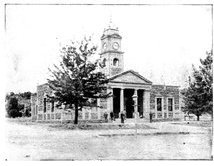
THE TOWN HALL. LADYSMITH.THE TOWN HALL. LADYSMITH.
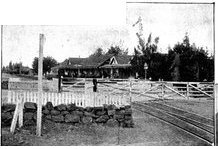
LADYSMITH RAILWAY STATION.
This station was shelled by the Boers while the civilians were
entraining to leave the town, but little damage was done.
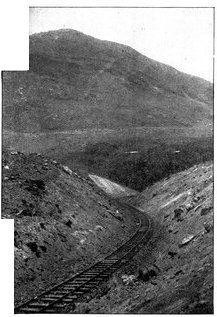
A CUTTING ON THE NATAL RAILWAY, NEAR LADYSMITH.
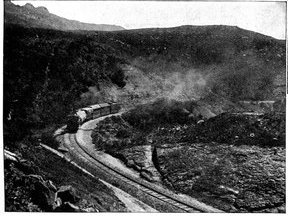
THE LAST MAIL-TRAIN OUT OF LADYSMITH.
Two companies of Gloucesters held the culminating point of the hill
to the south. Soon after 9 they were driven back by the enemy's fire,
when a party of Boers climbed to the position and swept the plateau at
very close range with their rifles. Shelter was sought by the British
soldiers upon the reverse slope of the hill, but even here they were
found and shot down by the rifles of the enemy. Orders were given to
the Irish Fusiliers to fix bayonets and die like men, when suddenly
the "Cease fire!" sounded, and it was seen that someone in the British
force had raised the white flag. The fury of the subalterns and of the
soldiers was indescribable. Their rifles had to be forced from many of
the men, and there were not a few who flung themselves down and sobbed
at the shame and dishonour. Yet the column was in hopeless plight, and
further resistance could only have meant useless slaughter. Twenty-nine
officers, 898 men, and four guns of the mountain battery thus passed
into the enemy's hands. Of the four guns, however, two were useless.
About 150 men in all, many wounded, escaped into Ladysmith with tidings
of the disaster, and 86 more, all wounded, were under flag of truce
brought into the British hospitals. The killed on the field of battle
numbered 52.
[Pg 44]
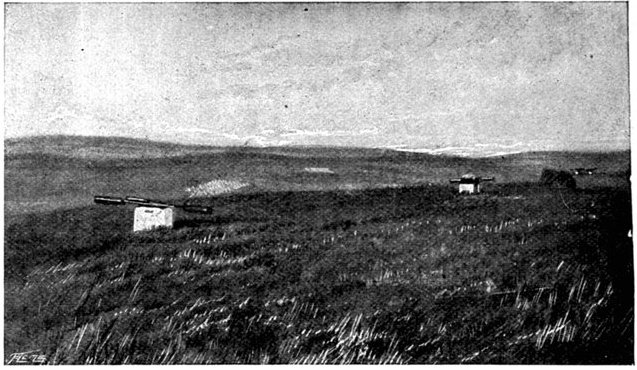
[Photo by Capt. Lascelles Davidson.
DUMMY GUNS SET UP BY THE BRITISH TO DRAW THE ENEMY'S FIRE.
[Oct. 30-Nov. 2, 1899.
As the result of this defeat, it became certain that Ladysmith must
stand a siege. Yet even now the town was not emptied of civilians, as
it should have been, though all non-residents, who were for the most
part spies, were ordered to take themselves off. The cavalry, who would
be useless in a siege, were not sent south. The railway to the north
of Ladysmith had not been destroyed, but was allowed to fall into the
hands of the Boers intact, so that they were able to bring up from
Johannesburg and Pretoria stores, munitions, and guns. This was a very
serious mistake, as the Boers' weakest point was their transport; with
the railway in their hands they were able with ease to maintain the
siege.
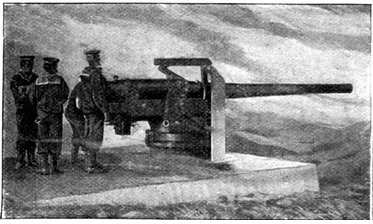
4·7-INCH NAVAL GUN, AS MOUNTED FOR DEFENSIVE PURPOSES.
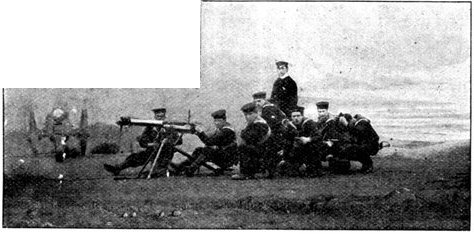
NAVAL DETACHMENT WITH MAXIM GUN ON TRIPOD STAND.
Neglect of precautions at Ladysmith.
In other directions there was an unfortunate amount of carelessness.
For instance, on November 2 a Boer ambulance containing British wounded
was allowed to enter the town, and was not immediately taken charge of
by the British medical staff. It was afterwards discovered that the
driver was a foreign artillery officer in the Boer service, who used
his opportunity to examine the weak points of the town. This ruse was
certainly unjustifiable, but steps might well have been taken to guard
against it, for our generals knew by this time the character of the
enemy. There were other grave abuses of the Red Cross flag; on October
30 the Boers masked one of their laagers with an ambulance, and on the
31st they built an emplacement for a gun under shelter of the sacred
emblem.
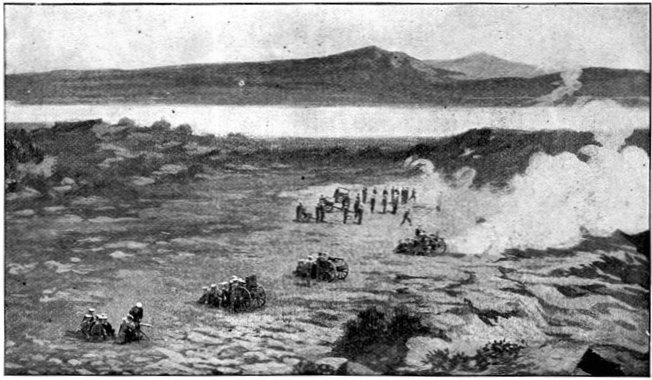
NAVAL QUICK-FIRING GUN DETACHMENT.
The town beleaguered.
On the night of the 31st all preparations for a siege were made.
Earthworks were constructed by the garrison, the naval 4·7's placed in
the best position, and ammunition and stores distributed at various
points wide apart so as to be safe from fire.
[Pg 45]

John Charlton.]
NATAL FIELD ARTILLERY DESCENDING THE BANK OF A "SPRUIT" OR STREAM.
[Pg 46]
[Nov. 3, 1899.
November 1 was spent in getting in the wounded, under a flag of truce.
Next day the Boers bombarded the town, mortally wounding Lieutenant
Egerton, but had one of their laagers captured by the British cavalry
and a battery of artillery. In the afternoon General French left
by train for Pietermaritzburg; at Pieters, two stations south of
Ladysmith, the Boers were in position with a Maxim 1-pounder and fired
on the train. The General only escaped death by lying on the floor of
the compartment, as projectiles riddled the side of the carriage. The
engine-driver showed great pluck and presence of mind, and this, the
last train to leave Ladysmith, got through the enemy's lines in safety.
Later in the afternoon railway and telegraph communications were
interrupted, and Ladysmith was isolated.
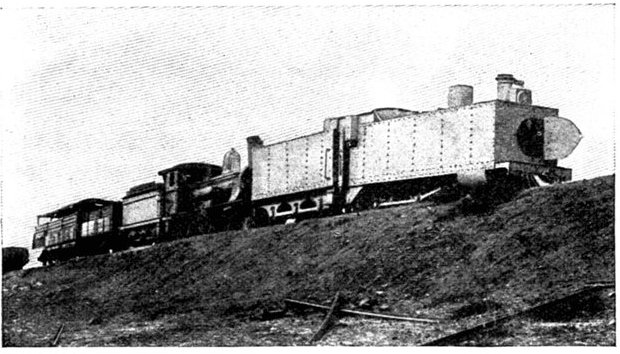
THE ARMOURED TRAIN DESTROYED BY THE BOERS AT KRAAIPAN.
The destruction of this train was the first overt act of war (see page
49). Kraaipan is a station between Mafeking and Vryburg on the Cape to
Cairo Railway.
On the 3rd a sortie towards Bulwana Mountain was made by the besieged
force, but the Boers were found to be too strong to be attacked.
Already the enemy was developing an advance southwards into the heart
of Natal; on the 2nd, Colenso, where lay a small British garrison of
bluejackets and Dublin Fusiliers, was shelled, and the probability
of the detachment being isolated and overwhelmed was so great, that
it was, perhaps somewhat precipitately, withdrawn. The great railway
bridge across the Tugela fell into the enemy's hands. Here, again,
it would have been wise for the British troops to have broken up the
bridges instead of leaving them for the enemy's use. It was certain
that the Boers, when they should be at last driven back, would not be
so obliging.
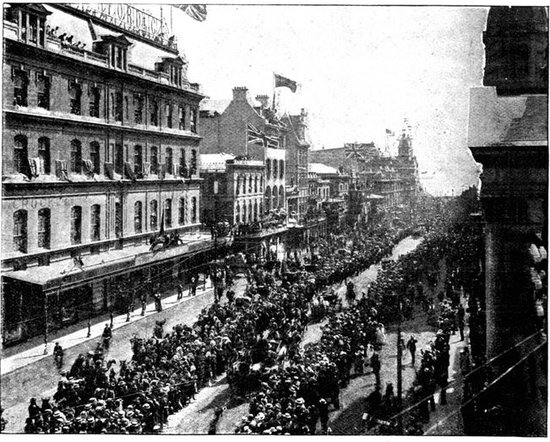
GENERAL BULLER'S ARRIVAL AT CAPETOWN.
General Buller arrived at Capetown on the 31st October, the day after
the battle at Farquhar's Farm and the disaster at Nicholson's Nek. He
received a most enthusiastic welcome. The photograph represents the
scene in Adderley Street.
The situation in Natal was now unfortunate in the extreme. No British
reinforcements were within reach. The main army in the Colony was
beleaguered in Ladysmith; between the Boers and Durban were only the
Colonial troops, at the outside not much over 2,500 strong, a few
seamen landed from the British warships, and two regular battalions,
the Dublin Fusiliers and the Borderers. A bold, decided advance, and
the Boers might yet make good their boast of hoisting the four-coloured
flag over Durban.
Condition of affairs on the Western Frontier.
Oct. 1899.] British Forces in Cape Colony.
Meantime on the western frontier of the Boer republics the enemy was
hard at work. The British forces in this direction were altogether
insignificant. At De Aar, an important railway junction on the line
between Capetown and Kimberley, was a handful of British troops
guarding a great accumulation of stores for the use of the Army Corps
when it arrived. The camp was practically undefended, and was open[Pg 47] to
a daring attack, for the garrison was too weak to occupy the heights
which commanded it. Hopetown, on the Orange River, to the north of
De Aar, was occupied by a diminutive force. At Orange River station
the great bridge over the Orange River was held by a detachment of
bluejackets, and by a handful of infantry entrenched at either end.
Beyond that point, which is over 580 miles by rail from Capetown,
the line to Kimberley had to be left unguarded. In Kimberley was a
detachment of the Loyal North Lancashire battalion, a battery of
garrison artillery with some old 7-pounder muzzle-loaders, and a
considerable number of volunteers raised and armed by the De Beers
Company, which worked the diamond mines. The main difficulty was the
provisioning of the place, for there were some 10,000 Kaffir workers in
the mines, who were not permitted by the Boers to go to their homes.
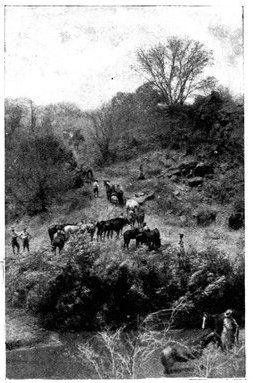
COL. PLUMER'S FORCE WATERING HORSES, ON THE WAY FROM
BULUWAYO TO TULI.
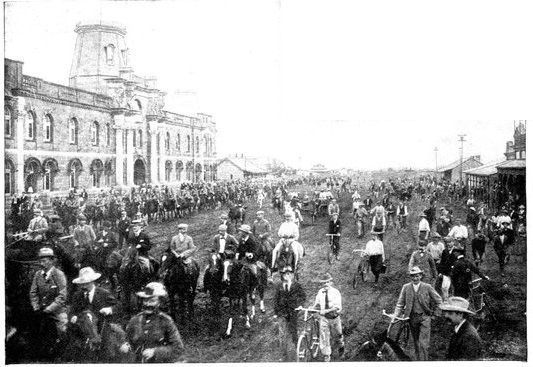
COLONEL PLUMER'S FORCE MARCHING OUT OF BULUWAYO.
[Oct. 1899.
Kimberley lies close to the Free State frontier and 647 miles north of
Capetown. In an analogous position close to the Transvaal frontier,
230 miles further to the north, and on the long railway which descends
from Rhodesia to the sea, stands Mafeking, with Vryburg halfway between
it and Kimberley. At Mafeking had assembled a small British force of
irregulars, raised by Colonel Baden-Powell, an officer of exceptional
dash and capacity, from the splendid material available in Rhodesia,
and some detachments of the British South Africa Company's police.
Still further to the north and more than a thousand miles from the
Cape were other small[Pg 48] detachments under Colonel Plumer, at Palapye,
Makloutsi, and Tuli, on the northern frontier of the Transvaal. Between
these detachments and Mafeking, between Mafeking and Kimberley, between
Kimberley and Orange River, the communications could not be protected,
and were certain to be broken. Thus from the first it was evident that
Mafeking and Kimberley would have to stand sieges of considerable
duration.
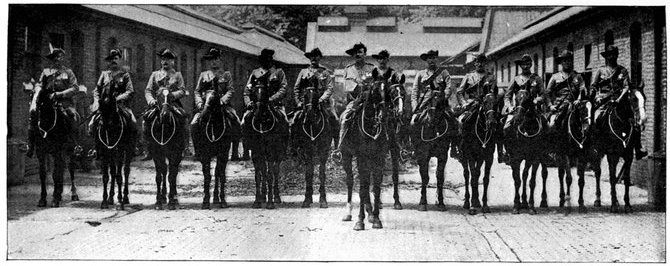
RHODESIAN HORSE.
The Rhodesian Horse was originally formed during the Matabele War, in
the course of which it did magnificent service. A contingent is here
shown under the command of Lieut. Maurice Gifford. A detachment of this
regiment proceeded to the relief of Mafeking under Colonel Plumer and
repulsed the Boers on more than one occasion.
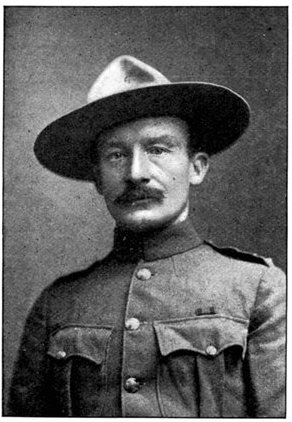
[Photo by Elliott & Fry.
COLONEL R. S. S. BADEN-POWELL.
Colonel R. S. S. Baden-Powell, who is commanding the plucky little
garrison of Mafeking, is forty-three years old, and was educated at
Charterhouse. He joined the 13th Hussars in 1876, and has seen service
in India, Afghanistan, and South Africa. His recently published
textbook on the art of scouting has had an enormous circulation. He has
also written many books of travel and sport, is a noted amateur artist
and actor, and equally at home at scouting, fighting, pigsticking,
polo, big-game shooting, hunting, yachting, acting, singing, writing,
and painting. Major, 1892; Lt.-Colonel, 1896; Colonel, 1897.
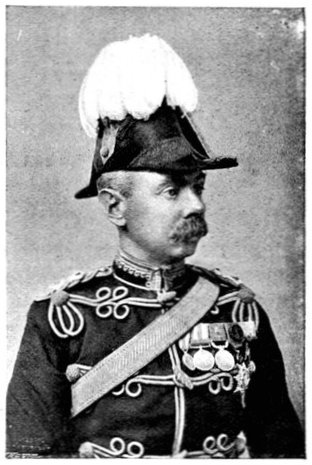
[Photo by Bassano.
LT.-COLONEL HERBERT S. O. PLUMER.
Has seen much active service in Africa. He was present at El Teb
and Tamal in the Soudan War of 1884; and in South Africa, under Sir
F. Carrington in 1896, he raised and commanded a corps of Mounted
Riflemen. He commands the gallant little contingent of Rhodesians whose
business it is to relieve Mafeking. Col. Plumer has an unusually happy
knack of being able to get on well with colonial troopers.
On the southern frontier of the Free State handfuls of troops occupied
the important railway junctions of Naauwpoort and Stormberg, and there
were British outposts at Aliwal North. It should be explained that
three railways run from the littoral of Cape Colony inland to the Free
State or the Free State frontier. The first comes up from Capetown to
Kimberley by De Aar; the second from Port Elizabeth to Bloemfontein
by Rosmead Junction and Naauwpoort; the third from East London by
Stormberg to Springfontein on the Bloemfontein and Port Elizabeth
railway. Lines from De Aar to Naauwpoort and from Rosmead to Stormberg
connect the three. Stormberg and Naauwpoort were therefore points of
the utmost strategical importance.
Doubtful attitude of the Schreiner Ministry.
Oct. 11-17, 1899.] The War on the Western
Frontier.
The attitude of the Dutch Ministry in power in Cape Colony was so
dubious that defensive preparations were rendered most difficult. Mr.
Schreiner, the Cape Premier, allowed tons of ammunition and hundreds
of railway trucks to enter the Free State just before the war, and
seems to have taken no steps of any kind to protect the Colony against
invasion. The Cape Mounted Police, a superb body of men, 1,900 strong,
the Cape Mounted Rifles, 1,000 strong, and the Cape Volunteers, 4,000
strong, were not drawn upon for defence as they should have been. The
volunteers were not properly armed or supplied with ammunition. In[Pg 49]
fact, the Cape Ministry appeared to hold to the view that a strict
neutrality ought to be preserved by the Colony. There may have been
an object not altogether unfriendly in this—to keep quiet the Cape
Dutch—or there may have been real disloyalty. But had 5,000 or 6,000
Cape Colonials been available at the outset, Stormberg could have been
firmly held, and the Boers prevented from besieging Kimberley.
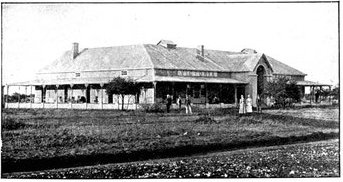
VICTORIA HOSPITAL, MAFEKING.
Repeatedly fired on by the Boers during the siege.

FORT AT MAFEKING.
First Act of War.
The Boers opened proceedings on the western frontier by advancing on
October 11 under Commandant Cronje from Zeerust to Mafeking, while
they broke the railway both to the north and south. On the 13th the
siege began. On the night of the 12-13th an armoured train, bringing
up two 7-pounder guns and ammunition, which had been sent forward from
Capetown, was derailed at Kraaipan, a station forty miles south of
Mafeking, and its contents and the party in charge were captured. The
engine-driver and one man succeeded in escaping to the south. This was
the first example which showed the utter uselessness of armoured trains
operating without any support. A rail removed or thrown out of gauge,
and they were at the enemy's mercy.
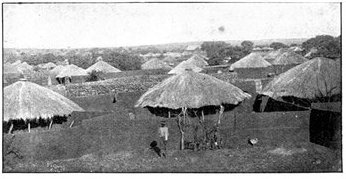
NATIVE VILLAGE, MAFEKING.
The Boers seem to have anticipated an easy and an early success at
Mafeking. The resources of the place were small; the garrison all told
did not exceed 1,200 men, and was ill provided with artillery. But
there was a large accumulation of stores and ammunition, which would
at least enable the defenders to hold out for some months. Cronje had
under him 4,000 or 5,000 men with good artillery, and had all the
resources of the Pretoria arsenals and magazines behind him. He could
draw guns of the heaviest calibre if he wanted them.
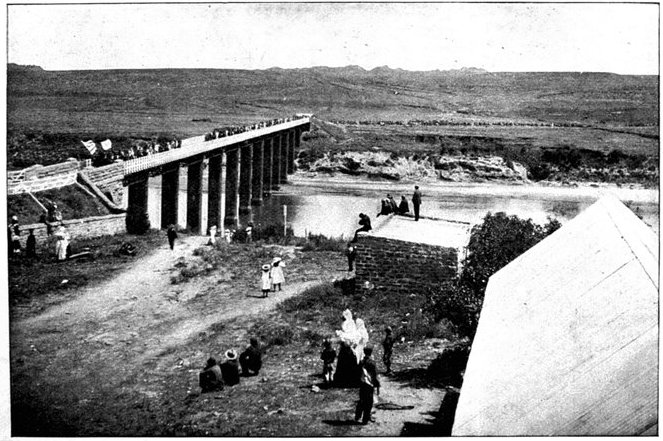
BOER COMMANDO CROSSING ALIWAL BRIDGE.
Attempts to capture Mafeking.
Oct. 17-31, 1899.
On the 14th the enemy were engaged by the garrison, with an armoured
train supporting, and were driven back with some loss. On the 17th the
Boers began to shell the town[Pg 50] with small field guns, but caused no
loss. A few houses were slightly damaged, a dog was killed, and that
was all. On the night of this day, as the Boers were pushing their
trenches dangerously near the British lines, a sortie was brilliantly
executed by Captain Fitzclarence with sixty men. He stormed the enemy's
position at the point of the bayonet, and did great execution amongst
the Boers, who were taken wholly by surprise. Various little sorties
took place during the next few days, and Cronje gave courteous notice
that he intended to bombard. At the same time he cut off the British
water-supply.
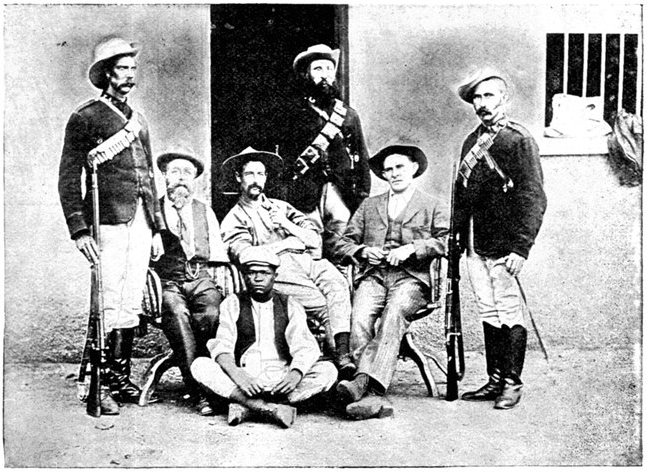
BRITISH PRISONERS SEIZED AT VRYBURG.
The three armed men who are standing up are typical Boers of the
district. Their prisoners are—Hellawell, of the London Daily Mail
and the Cape Times, in the centre; Townshend, of the Bechuanaland
News, on the left; Lelyveldt, a compositor, on the right of the group;
and a native guide.
On the 24th the Boers placed three heavy siege guns in position, and
with them shelled the town, while the smaller weapons kept up a heavy
fire. Three bedrooms were wrecked, the gas plant destroyed, and the
town set on fire. Next day the bombardment was resumed, and the enemy
massed for an assault, compelling the little British force to leave
the bomb-proofs and line the trenches. Day after day these experiences
continued till on the 31st an assault was actually delivered upon
Cannon Kopje, an outlying hill protected by a small fort. The Boers
advanced under cover of the fire of four 15-pounder field guns and of
a 5·9-inch siege gun, but were repulsed after a long and desperate
struggle, in which the little garrison suffered severely and lost the
services of Captains Marsham and Pechell, both of whom were killed.
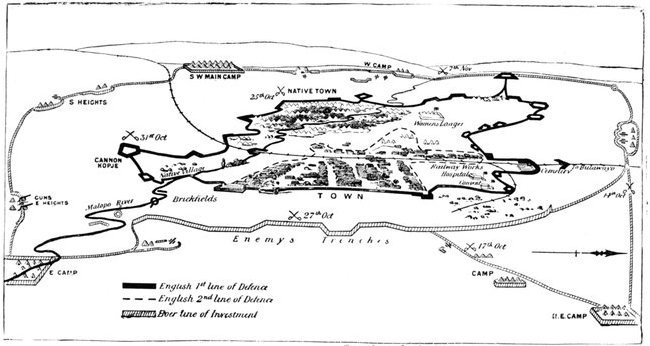
[From a sketch by a British officer, brought through the enemy's lines by a native runner.
PLAN OF MAFEKING,
Showing the British and Boer lines and the spots where fighting took
place during the early days of the siege.
To keep his men in good spirits, always a hard task in a long siege,
Colonel Baden-Powell held impromptu concerts, at which fragments of
popular operas were given by the ladies and officers in the town. He
speedily obtained the complete confidence of his men. No precaution
was neglected; everything was foreseen; and in spite of his limited
resources he was never beaten. By common agreement between the British
and the Boers, Sunday was observed as a day of truce. Once or twice
when the Boers were noticed to be digging trenches on that day,
"B.-P.," as his men called him, drew Cronje's attention to the fact,
and the digging stopped. The Boers, however, persistently shelled the
hospital and a convent which the nuns had refused to abandon. These
heroic ladies attended the sick and wounded, and took the fullest share
in the hard work, setting an example which was above all praise.
[Pg 51]
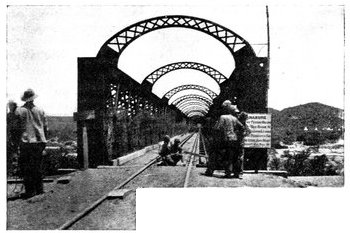
ORANGE RIVER BRIDGE.
This bridge, carrying the railway from the Cape to Kimberley and
Mafeking, marked the northern position of the British during the early
days of the war. Although weakly held, it did not fall into the enemy's
hands. The photograph shows the camp of the small force which held the
northern or exposed end of the bridge.
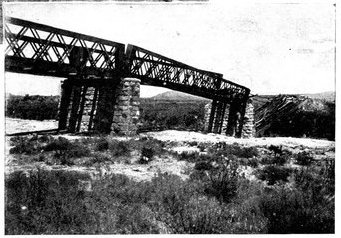
OORLOG'S SPRUIT BRIDGE, BETWEEN COLESBURG AND NORVAL'S
PONT. DESTROYED BY BOERS, November 5.
Oct. 17-31, 1899.] Bombardment of Mafeking.
On November 7 the garrison made a very successful sortie, drawing the
Boers under the fire of our ambushed artillery by a feigned retreat.
The enemy broke and fled in great disorder, losing heavily. After this
an interval of Boer inactivity followed, though the town was constantly
shelled. Cronje, with a good number of his men, was withdrawn, as his
services were wanted elsewhere, and Commandant Snyman replaced him. The
position of the biggest of the Boer guns was altered; the Boer field
artillery left for the south.
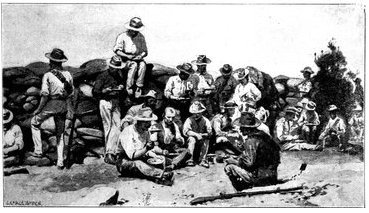
G. Soper.] [
From a photograph by J. E. Neilly.
A LULL IN THE FIGHTING: DINNER-TIME AT MAFEKING DURING THE SIEGE.
This photograph represents the interior of the "Graveyard Redan," at
the cemetery, and is shown on the extreme right of the plan on opposite
page.
[Oct. 12-15, 1899.
The accuracy of the Boer fire was great. Seven successive shots from
the 5·9-inch gun struck the front of one of the forts, completely
destroying the earthworks, though, strangely enough, there was no loss
of life. The convent was hit eight times; a shell struck a hotel and,
bursting, moved a billiard table some inches without[Pg 52] injuring those
who were playing billiards. Another shell took off the roof of a house
in which five men were breakfasting without wounding any of the five.

SCENE AT COLESBERG AT THE READING OF SIR ALFRED MILNER'S
PROCLAMATION AGAINST DISLOYALTY.
The Boers seize Vryburg.
Turning from gallant little Mafeking to the earlier stages of the
siege of Kimberley, Boer forces had assembled at Boshof and Jacobsdal,
the one to the north-east, the other to the south of that town, in
readiness for a move when President Kruger gave the signal. On October
12 the Jacobsdal commando crossed the frontier, seized Modder River
station, telephoned to Kimberley to try to find out the force in
the town, and then made all preparations for the destruction of the
iron bridge which spans the river at this point. The Boshof commando
advanced on Riverton, a station on the railway to the north of the
town, drove back a detachment of Cape Police, and looted and wrecked
the town. On the 15th a brush between an armoured train with British
troops on board and a small Boer force took place at Spytfontein,
ten miles south of Kimberley. Several of the enemy were killed and
wounded without any British casualties. On the same day Vryburg, half
way between Kimberley and Mafeking, was evacuated by the Bechuanaland
Police and seized by the enemy. On the 17th the Modder River bridge was
destroyed with dynamite, a previous attempt to blow up the bridge-piers
having failed. The Boers employed a number of "skilled Continental
engineers," whose whereabouts and nationality will have to be inquired
into after the war, to accomplish the work. Finally, Belmont station,
a few miles north of the Orange River, was occupied by a detachment
and fortified, while demonstrations were actually made against Orange
River station. Thus Kimberley was thoroughly isolated and cut off from
the outer world. The enemy now proceeded to "annex" Bechuanaland to
the Transvaal, and Griqualand West to the Orange Free State, and to
"commandeer" or expel all residents within these districts. Those who
were "commandeered" had to serve against their own country. Most of the
British residents took to flight, but a few who remained were seized
and impressed for the Boer armies, in violation of all the dictates of
international law and of the laws of war.
[Pg 53]
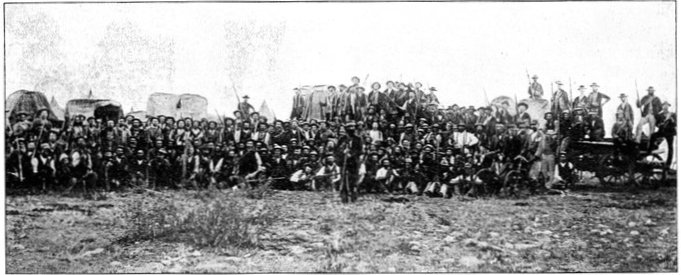
THE CAPTORS OF VRYBURG.
The Lichtenburg commando, reinforced largely by rebel farmers from Cape
Colony.
Oct. 24-30, 1899.] Fighting at Kimberley.
To protect Kimberley from assault a hedge of thorn bushes was built
round the town and earthworks were raised. The enemy, however, at first
kept at a very respectful distance, and seemed contented simply to
intercept communications. On October 24 a reconnoitring party under
Major Turner went out to the north along the railway and came into
collision with a small Boer force. Reinforcements were telegraphed for
to Kimberley, and a couple of companies of North Lancashires with two
armoured trains were sent up the line. The Boers were driven back; they
lost Commandant Botha and several men, while the British had 24 killed
and wounded. There was great excitement in Kimberley during the fight,
crowds pouring out to watch the little British force at its work.
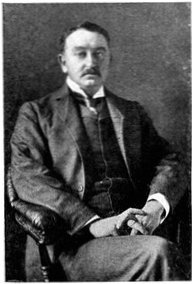
[Photo by Bassano.
RIGHT HON. CECIL JOHN RHODES, P.C.
Born in 1853; the fourth son of the late Rev. Francis W. Rhodes, Rector
of Bishop Stortford. He went to South Africa about 1870 in a poor state
of health; eventually settled in Kimberley, and after many years of
very hard work effected the amalgamation of the various diamond mining
interests into the De Beers Company; has been Premier of Cape Colony;
conceived and organised the Chartered Company of British South Africa;
a thorough and ardent Imperialist, a wonderful man of business, and
the builder of Greater South Africa. His personal exertions during the
recent siege of Kimberley endeared him to every one in the beleaguered
town.
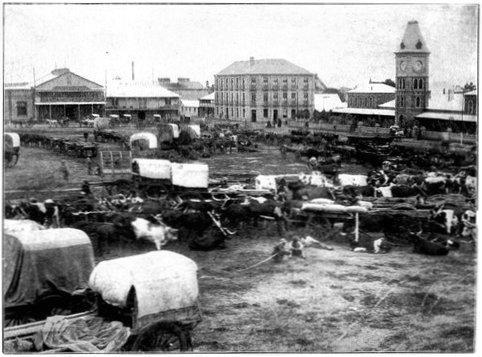
[Photo by N. P. Edwards.
KIMBERLEY MARKET PLACE.
Kimberley isolated.
Oct.-Nov. 1899.
Bombardment commences.
At the end of October the Boer force besieging the town was
strengthened by detachments from Mafeking, and probably by recruits
from amongst the disloyalists in the Griqualand West district. The
investment became closer, and[Pg 54] the enemy began to show more daring. On
November 1, either by accident or by one of the enemy's shells, the
dynamite stores of the De Beers Mining Company were exploded, causing
a fearful shock and great alarm in the town. On the 7th, after two
days' notice had been given, the bombardment of Kimberley began. About
70 shells, most of them of small size and very inferior quality, were
fired by the enemy, but with no other result than to shatter a cooking
pot. Amidst general mirth the fragments of this vessel were put up to
auction, the best specimens fetching as much as a couple of pounds.
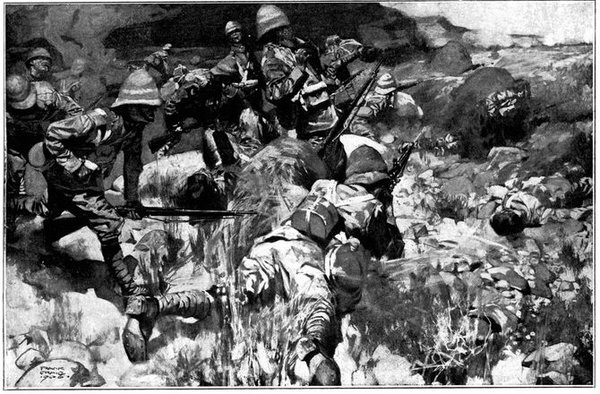
Frank Craig.]
SEIZING A KOPJE.
Stormberg district abandoned by the British.
On the southern frontier the Boers remained inactive all October.
Small detachments of them were observed at Bethulie, at Norvals
Pont, and at the Colesberg Bridge. A larger commando 1,500 strong,
with three guns, was noticed drilling and practising on the north
bank of the Orange River. At this date 2,500 Boers were watching the
Basutos, who, it was feared, would take advantage of the war to wipe
off old scores. But owing to the tact and skill of Sir G. Lagden, the
British Resident in Basutoland, this tribe of Kaffir warriors was
kept so thoroughly in hand that it soon became safe for the enemy to
withdraw their commandoes and move them to Norvals Pont and Bethulie.
The Boers were further emboldened by the victory of Joubert before
Ladysmith on October 30. On November 1 they crossed the Orange River
in all directions and in considerable force, their main body making
Stormberg Junction, some fifty miles south of the Free State border,
its objective.
Oct.-Nov. 1899.] The Boers in Cape
Colony.
Stormberg Junction was a point the possession of which was almost vital
to the British forces. It was easily defensible, and if lost might be
very hard to retake. It commanded the lines of communication between
the advance from East London and the advance from Port Elizabeth, so
that if it fell into the enemy's hands the eastern portion of Cape
Colony would be entirely cut off from the west. Through the later weeks
of October it had been occupied by a small naval brigade with guns, and
by a detachment of the Berkshire regiment. On November 3, by express
orders from General Buller, this little garrison retired and fell back
upon Queenstown, farther down the East London[Pg 55] railway. At the same
time a skeleton force at Naauwpoort was withdrawn to De Aar. The Boers
pushed forward slowly; Aliwal North was occupied and rechristened
Oliviersfontein, in honour of the Boer commandant; then they appeared
in some force at Burghersdorp, some miles to the north of Stormberg,
and destroyed a bridge at Steynsburg, on the line between Stormberg
and Naauwpoort Junction. The disloyal farmers of this district crowded
in numbers to the Free State flag, and the "commandeering" of British
subjects and confiscation of British property went on merrily. It was
a terrible time for the loyal Britishers, who had foreseen what was
coming, but whose warnings had uniformly been disregarded.
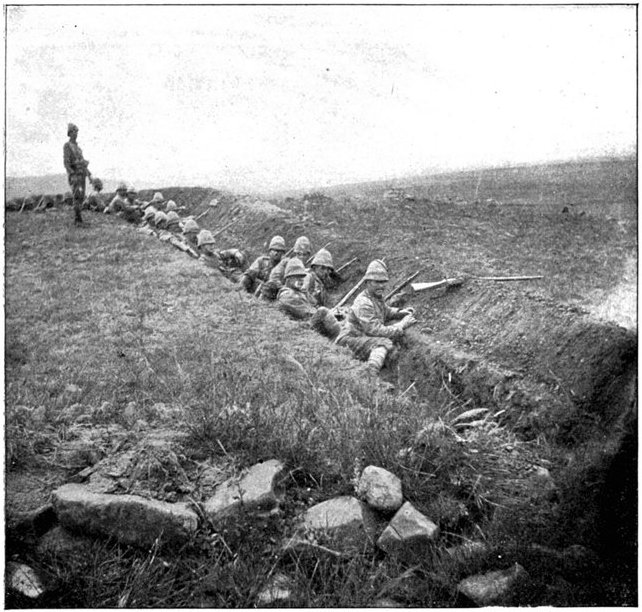
[From a Photograph.
FACING THE BOERS.
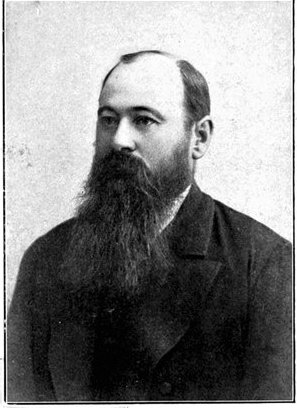
EX-PRESIDENT STEYN.
Martinus Theunis Steyn, President of the Orange Free State, was born
at Wynburg (about 50 miles N.E. of Bloemfontein) Oct. 2, 1857. His
father was a waggon-builder and farmer. He lived an outdoor life during
his early years, and at twelve went to school at the Grey College
in Bloemfontein. At nineteen he was sent to study law in Holland
and England, and returned to his native State when twenty-five. He
practised at the bar of the Supreme Court, became Attorney-General and
(in 1889) a judge. In 1895, on the retirement of Mr. Reitz, he was
elected President. It was not until September 1899 that he definitely
threw in his lot with Kruger and the Transvaal Boers in opposition to
the British Government.
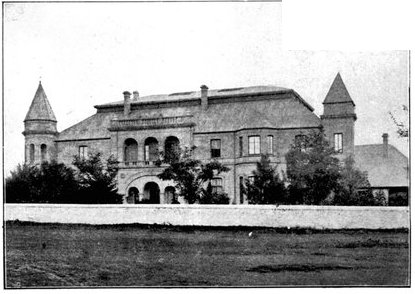
THE PRESIDENCY, BLOEMFONTEIN.
Formerly the official residence of President Steyn.
Attitude of the Cape Dutch.
During these weeks there were signs of ferment in all directions in
the Colony. The Boers had expected a rising of all the Dutch, and
asserted that they had received promises to that effect from the
leaders of the Bond or Dutch party at the Cape. Rifles and ammunition
had certainly been surreptitiously poured into the Colony from the
north and distributed to those whom the Boers thought they could
trust. Trains with troops and munitions of war on board were fired
upon well to the south of De Aar, and obstructions on many occasions
were found placed upon the line. But the general attitude of the
Dutch Colonials was a hedging one. They had no real grievance against
the Imperial Government, which had given them the fullest measure of
self-government, and, though sympathising warmly with the Boers, and
sharing to some extent their dream of an independent South Africa under
Boer rule, they waited for some big success before irrevocably throwing
in their lot with the enemies of the British Queen.
[Pg 56]

HER MAJESTY ADDRESSING THE WIVES AND CHILDREN OF THE
HOUSEHOLD CAVALRY AND RESERVISTS AT WINDSOR, November 29, 1899.
After reviewing the 1st Battalion of the Grenadier Guards, Her Majesty,
with that unfailing sympathy which since the opening of war has
endeared her more than ever to her subjects, spoke some words of good
cheer to the wives and children of the Life Guards, the Blues, and the
Reservists, who had that morning left for South Africa.
[Pg 57]
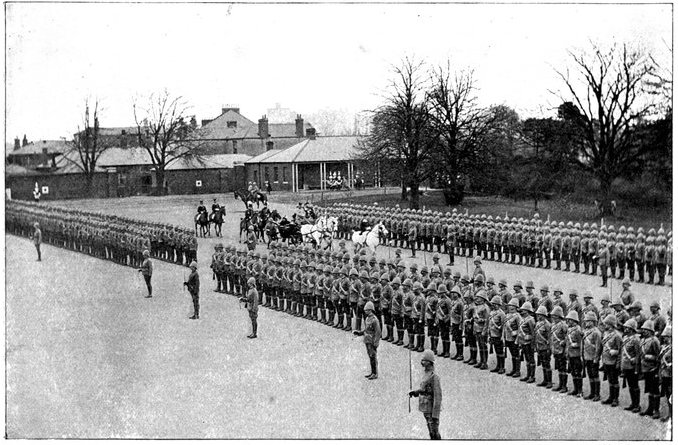
[Photo by Gregory.
HER MAJESTY REVIEWING AT WINDSOR THE COMPOSITE REGIMENT OF HOUSEHOLD
CAVALRY UNDER ORDERS TO PROCEED TO THE CAPE (November 11, 1899).
The regiment consisted of men selected from the 1st and 2nd Life Guards
and the Horse Guards Blue; preference was given to light weights, out
of consideration for the horses. H.R.H. the Prince of Wales had bidden
the regiment farewell on the preceding day.
CHAPTER IV.
THE DESPATCH OF THE ARMY CORPS.
Dilatoriness of the Government—Full notice to the
enemy—Mobilisation begins—Small proportion of
cavalry—Loyal action of the Colonies—The greatest
Expeditionary Force ever sent over seas—Embarkation
of the troops—Food supplies—The voyage out—The plan
of campaign—Character of the country—New tactics
required—Despatch of the Fifth and Sixth Divisions.
Dilatoriness of the Government.
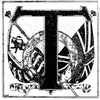
The first reinforcements for the British army in South Africa to
leave England after the tension became acute were three batteries of
artillery, which had been ordered out as far back as September 8.
Their despatch had been talked of for some months before, but such was
the irresolution and timidity of the Cabinet that delay after delay
had occurred. Even now, though these guns were most urgently needed,
they were not sent out in the fastest procurable transports, but,
with a strange neglect of military necessities, were placed on board
two comparatively slow ships—the Zibenghla and Zayathla. Both
cleared on September 25, but instead of being able at once to proceed,
were detained by defects in boilers or by heating of the coal in the
bunkers. The Zibenghla did not leave the Mersey until October 7;
the Zayathla, a little more fortunate, got away from Queenstown on
September 29. This ill-omened delay is significant in view of later
events. Finally the Zayathla reached Capetown on October 25 and the
Zibenghla on the 30th, having occupied, in one way and another, 30
to 35 days on a voyage which could have been accomplished with ease
by vessels of moderate speed in 20 or 21 days. It is quite clear that
those responsible for providing funds—cheapness was alleged as an
excuse for selecting such slow vessels—had completely misapprehended
the gravity of the crisis, and forgotten Nelson's great saying,
Five minutes make the difference between victory and defeat. It is
impossible with our British system of administration to discover who
exactly was to blame, but clearly someone made a very serious mistake.
[Pg 58]
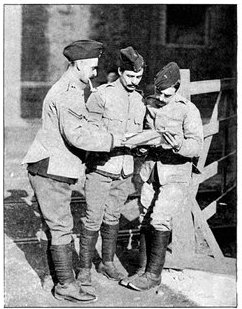
RESERVISTS AT SOUTHAMPTON DOCKS READING THE LATEST NEWS
FROM THE FRONT.
The alacrity with which the Reservists answered to the call to the
colours has already been mentioned (p. 17).
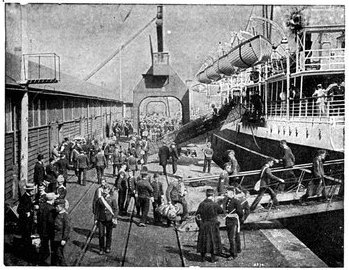
[Photo by Gregory.
EMBARKATION OF THE NORTHUMBERLAND FUSILIERS AT SOUTHAMPTON.
[Oct.-Nov. 1899.
Full notice to the enemy.
The British army had been so organised and prepared by the War Office
and successive Cabinets that no considerable body of men was ready to
take the field on immediate notice. An elaborate process had to be
gone through before any considerable number of squadrons, batteries,
and battalions could leave our shores. The immature boys and raw
recruits had to be weeded out and replaced by reservists who had left
the colours. To call up the reservists the consent of Parliament was
necessary, and to convene Parliament some notice would of course have
to be given. The whole system was admirably adapted to ensure our
enemies having the very fullest notice and the very fullest warning
of our intentions; and, as has been seen already, the Boers were not
slow to take advantage of our ineptitude. How we should have fared in
like circumstances against a European enemy must be left to conjecture.
There would have been no such lethargy as the Boers displayed in the
first week of war.
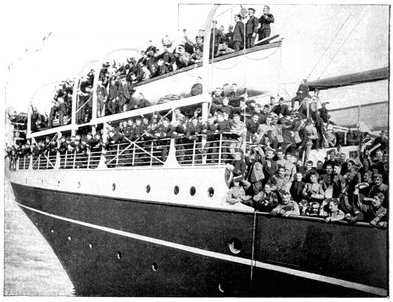
[Photo by Gregory.
OFF!
S.S. German with 1st Battalion Rifle Brigade leaving Southampton.
Had the mobilisation been completed, as many urged, in May or June, the
Boers could not have gained a month's start, since in May and June the
grass upon the veldt is too scanty to permit of extensive movements.
They could not well open their campaign until October, when the first
heavy rains fall. Yet in the end it may be that the Boers were defeated
by our own unsuspiciousness. Had our Army Corps been sent out in May
or June the Republics would have "climbed down," Britain would have
once more gone to sleep, and Mr. Kruger would have waited till we were
entangled in hostilities with some great power, and then have struck us
with terrible effect.
[Pg 59]
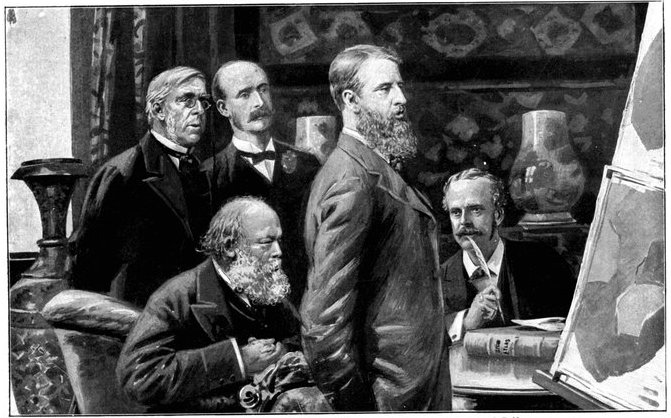
Rt. Hon. G. J. Goschen. Marquis of Lansdowne.
Marquis of Salisbury. Duke of Devonshire. Rt. Hon. A. J. Balfour.
THE COMMITTEE OF NATIONAL DEFENCE.
Oct.-Nov. 1899.] Strength of the Army
Corps.
Mobilisation begins.
The order to mobilise was issued on October 7, but the mobilisation did
not officially begin till the 9th. There was—indeed there could be—no
hurry over the operation, for transports were not ready, but had to be
prepared as rapidly as possible. The total force which it was decided
to despatch was as follows:—
|
Nom. strength. |
Fighting strength. |
Guns. |
| 1 Cavalry Division |
5,500 |
4,820 |
12 |
| 3 Infantry Divisions |
30,000 |
26,430 |
54 |
| Corps Troops |
5,000 |
3,450 |
48 |
| Line of Communications and Reserves |
11,000 |
11,000 |
— |
|
51,500 |
45,700 |
114 |
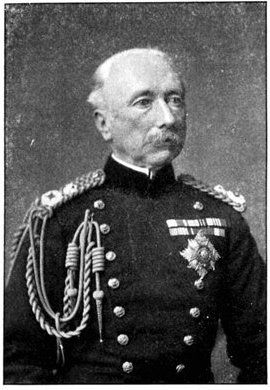
[Photo by the Stereoscopic Co.
FIELD-MARSHAL VISCOUNT WOLSELEY, K.P., &c.; COMMANDER-IN-CHIEF OF THE
ARMY.
Born in 1833, son of Major Garnet Joseph Wolseley; is of Irish birth.
Entered the Army 1852; Captain, 1855; Major, 1858; Lt.-Colonel, 1859;
Colonel, 1865; Governor of Natal, 1875; Lt.-General and Governor of
Cyprus, 1878; Commander of Forces in Ireland, 1890-95; General, 1882;
Field-Marshal, 1894. Served in Burmah, the Crimea, at Lucknow, in China
and Canada; commanded the Red River Expedition, 1870, the Ashantee
Expedition, 1873; the Egyptian Expedition, 1882, and the Gordon Relief
Expedition, 1884. As Commander-in-Chief at home he shares with Lord
Lansdowne, the Secretary of State for War, the responsibility for the
number and equipment of the troops sent out.
The "fighting force," it should be explained, includes only cavalry,
artillery, and infantry, and excludes engineers, army service corps,
and ammunition columns. Thus the total strength of these three arms
despatched to South Africa was under 46,000 men. In many of the
published estimates the "troops on the line of communications" were
placed at 10,000, but they were actually much under 10,000, being only
seven battalions strong. To these, 4,000 "reserves at base" had to be
added. Thus it would appear that from the first the Army Corps was
below its theoretical strength.
Small proportion of cavalry.
[Oct.-Nov. 1899.
Some further facts have to be noted, as they will help to explain
certain of the British reverses. Out of this 46,000 men only 5,600 men
were mounted—cavalry or mounted infantry. This is a smaller proportion
than would be found in any European army of the same size, and was
dangerously small in view of the fact that in South Africa we were to[Pg 60]
encounter an enemy who was mounted to a man. Nor was the artillery as
strong as might have been desired. A German corps of the same size
would have had five more batteries, or 30 more guns. In the course
of the war our need of artillery was such that batteries had to be
improvised from the guns carried on board our warships.
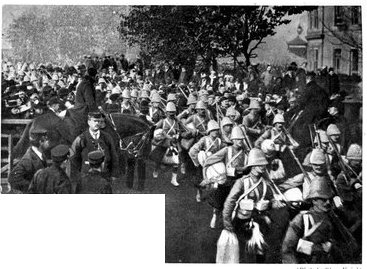
[Photo by Chas. Knight.
THE BLACK WATCH LEAVING ALDERSHOT.
Like all the other regiments ordered out, the Royal Highlanders (better
known as the "Black Watch") under General Wanchope, who was afterwards
killed at Magersfontein, was cheered by enthusiastic crowds as it left
for Africa.
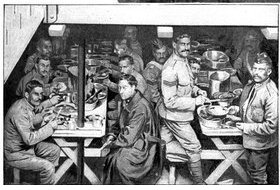
[Photo by Gregory.
TOMMY AS SEA-COOK. DINNER-TIME ON BOARD A TRANSPORT.
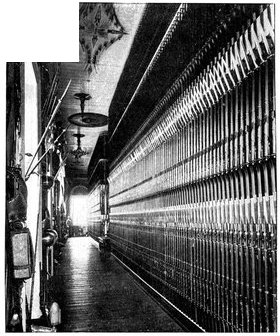
[Photo by Stephen Cribb.
STORES TO DRAW UPON: RIFLES IN THE ARMOURY AT PORTSMOUTH.
Loyal action of the Colonies.
To the above totals a certain number of Colonial troops must be added.
Canada, New Zealand, New South Wales, Queensland, Victoria, Western
Australia, South Australia, and Tasmania, all proffered aid, but,
unfortunately, the British Home Government did not avail itself to
the fullest extent of their tendered assistance. It restricted the
contribution of men, in all cases except that of Canada, to small
detachments, and did not want even these to be composed of mounted
troops. But, though the Colonial forces probably scarcely exceeded
2,000, their appearance upon the scene gave fresh proof of the
solidarity of the British Empire, and was a striking earnest of the
loyalty of the Colonies.
[Pg 61]
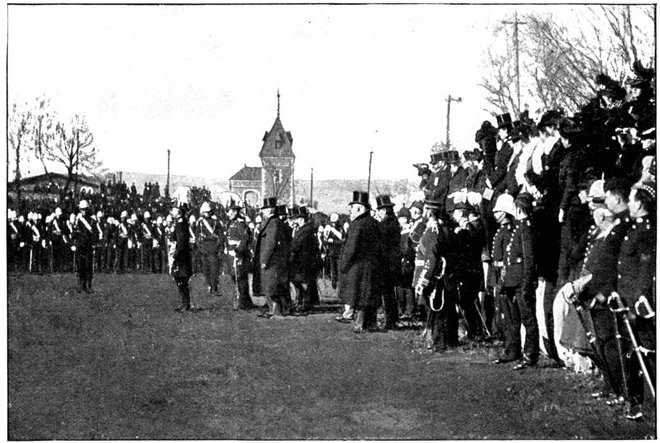
THE SEND-OFF OF THE CANADIAN CONTINGENT FROM QUEBEC.
The photograph represents the Governor-General, Lord Minto, addressing
the troops. The French-Canadian Premier, Sir Wilfrid Laurier, and the
Mayor of Quebec, also addressed them.
Oct.-Nov. 1899.] Enthusiastic Loyalty of
the Colonies.
While Australia and Canada thus responded to the great call of duty,
Natal made the most prodigious efforts, to which fuller attention will
have to be given hereafter. She placed some 4,000 or 5,000 of her
scanty white population in the field, and her sons proved themselves
on the field of battle gallant men and skilful soldiers, winning
well-deserved tributes from all the British generals. At Durban
were many thousands of refugees from the Transvaal, eager to serve
against the Boers, but owing to the parsimony of the Home Government
indifferent use was made of their enthusiasm. Where we might have
had 5,000 good volunteers only 1,000 were raised. The Imperial Light
Horse, composed almost entirely of Outlanders, speedily made a name for
itself, and fought with invariable heroism and devotion.
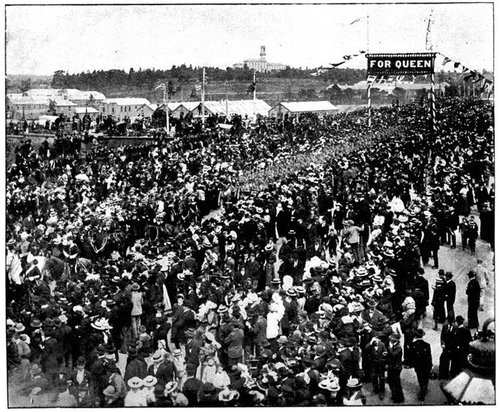
THE VICTORIAN CONTINGENT CROSSING PRINCE'S BRIDGE,
MELBOURNE.
As in England, so in all the Colonies, immense crowds gathered to
witness the departure of volunteers for the front. This demonstration
of the loyalty of the Colonies is certainly one of the most gratifying
of the results of the war.
The greatest expeditionary force ever sent over seas.
[Oct.-Nov. 1899.
When the mobilisation in England began the army organisation worked
very satisfactorily and smoothly. No such task as the transport of an
expeditionary force, 50,000 strong, six thousand miles over sea had
ever before been undertaken in the whole record of military history. In
the Crimean war we had moved 33,000 men with 3,350 horses and 54 guns a
distance of about three thousand miles, and that was considered a very
great feat. With each increase in the distance the space that must be
allowed man and horse grows, and an extra amount of food and stores
must be[Pg 62] carried. For very short voyages of a few hours or less one
man can be shipped for each ton of the vessel's displacement. For such
a trip a steamer like the Britannic could carry 5,000 or 6,000 men.
Actually, she embarked only 1,200 men on the voyage to South Africa,
for this reason, that if the troops were to arrive in good health and
fit for service, they could not be packed on board like sardines. The
British soldier is a valuable and expensive product, and far more
carefully treated than the Frenchman or Russian.
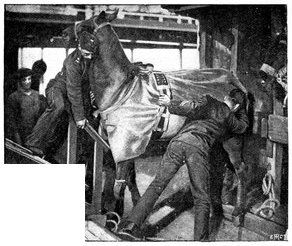
[Photo by Gregory.
GETTING CAVALRY HORSES ON BOARD.
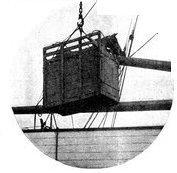
The Admiralty was charged with the duty of hiring and fitting
transports. It was decided that, as the supply train for the army
could not be ready in South Africa for some weeks, vessels of only
moderate speed should be chartered. In acting thus the extremity of the
emergency seems to have been in some degree overlooked. Long before
the first batch of troop-ships was half way to the Cape troops were
most urgently needed in all directions. In Natal and in central Cape
Colony our generals might have been able to dispense with an elaborate
transport system by making use of the railways. Of the steamers
chartered the great majority steamed 12 or 13 knots. The Aurania
of 17 knots, Britannic of 16, and Roslin Castle of 15, were the
fastest chosen. Though the cavalry and artillery should, strictly
speaking, have sailed first, since horses always require some days'
rest on land before they are fit for hard work after a long voyage, the
time required to provide the horse-transports with proper fittings was
so considerable that very few were able to leave with the head of the
Army Corps.
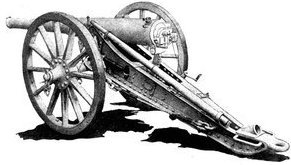
Armstrong, Whitworth & Co.]
12-POUNDER NAVAL FIELD-GUN.
The picture represents the 12-pounder gun on field carriage, as used at
Ladysmith and elsewhere.
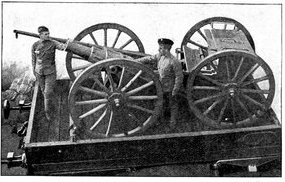
[Photo by Gregory.
A 6-INCH HOWITZER OFF TO THE FRONT.
This is one of the weapons of the siege train intended for the
bombardment of Pretoria, and used against Cronje at Paardeberg.
Embarkation of the troops.
Oct.-Nov. 1899.] Food for the Voyage.
On Friday, October 20, the first batch of troops, 5,000 strong,
embarked at Southampton in four steamers; on the 21st, 5,615 were
shipped; on the 22nd, 4,864; and on the 23rd, 6,335, making a total in
four days of over 21,000 men. The troops were of splendid physique, a
large proportion[Pg 63] being reservists; their conduct was sober, steady,
and irreproachable. As for the embarkation, it was conducted in every
case with machine-like order and precision. "It was almost automatic,"
says an eye-witness; "no one gave orders; there was not the slightest
fuss or flurry. Every one in every rank knew exactly what he had to
do." As the ships one by one cast loose there was a roar of cheering
from their decks and from the shore. Thus did the soldiers of the Queen
set out upon that voyage from which, alas! too many of them were never
to return.
The supplies carried on board each ship had to be very considerable
in view of the length of the voyages. Taking, as an example, the
Sumatra, which conveyed 1,200 men to the Cape; she was furnished
with 6,000 lb. of preserved meat, 14 tierces of salt beef, 21 barrels
of pork, 2,500 lb. of preserved potatoes, 400 lb. of compressed
vegetables, 670 lb. of salt, 100 lb. of mustard, 60 lb. of pepper, 150
gallons of vinegar, 100 lb. of pickles, 1,250 lb. of rice, 1,300 lb. of
split peas, 6,000 lb. of sugar, 140 barrels of flour, 336 lb. of suet,
900 lb. of raisins, 1,300 lb. of coffee, 113 lb. of chocolate, 1,300
lb. of treacle, 4,520 lb. of oatmeal, and 10,800 lb. of biscuit. These
were the government supplies to be issued free as rations to the men.
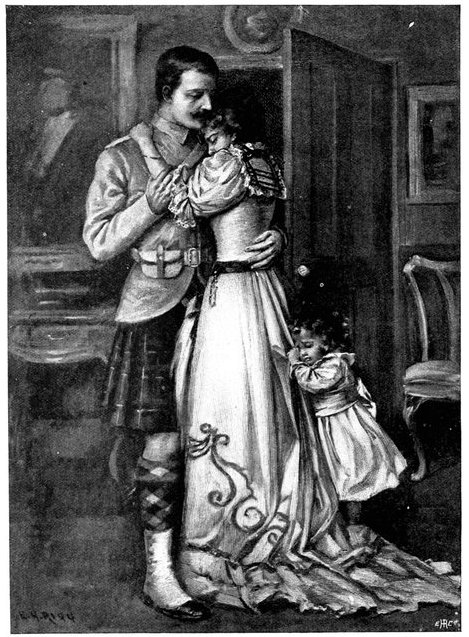
E. M. Rigg.]
THE LAST EMBRACE.
In addition the canteen laid in stores of corned beef, lunch biscuits,
ginger-nuts, bloater-paste, brawn, butter, cheese, tinned haddocks,
herrings, lobsters, mackerel, jam and marmalade, sauces, sausages,
potted meats, condensed milk, blacking, laces, soap, tobacco, and other
necessaries and luxuries. These the soldiers would have to purchase out
of their none too generous pay. Though from the above list it might
seem that nothing was wanting, there were complaints, not without
foundation, of both the quality and the quantity of the food in some of
the ships. The Arawa's meat was discovered, on inspection just before
she left, to be bad and had to be renewed.
There were one or two other mischances, as might indeed be expected
in an enterprise of such magnitude. The Rapidan from Liverpool with
remounts on board encountered very heavy weather in the Irish Channel,
and had to put back with heavy loss in horses. The Manchester Port
had shipped some compressed forage which, being damp, heated on board,
and detained her till it could be removed.
[Pg 64]
[Oct.-Nov. 1899.
The total tonnage engaged in the movement of the Army Corps, its
supplies, and its transport was about 600,000, exclusive of vessels
chartered for the divisions which followed later. Yet so vast were the
shipping resources of England that the withdrawal of this great number
of steamers from the mercantile marine only slightly affected the cost
of freight.
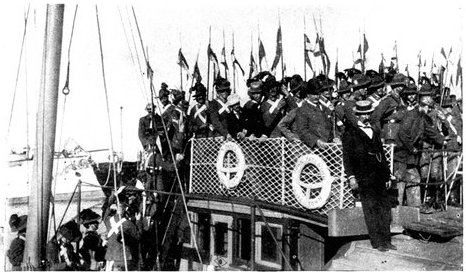
ARRIVAL OF NEW SOUTH WALES LANCERS AT CAPE TOWN FROM
ENGLAND.
This detachment, being the only Colonial force in England when war
broke out, was accorded an overwhelmingly enthusiastic send-off by the
immense crowds who lined the London Streets to see them march to the
railway station.
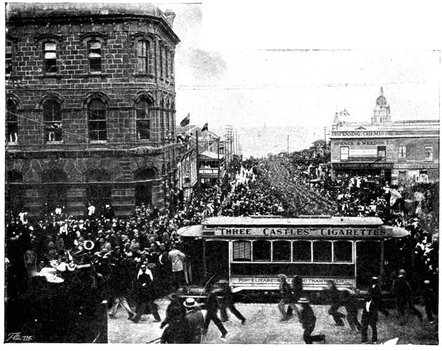
ARRIVAL OF THE WELSH FUSILIERS AT PORT ELIZABETH.
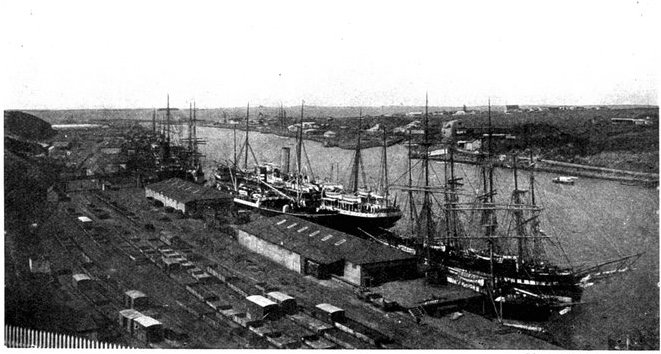
[Photo by G. W. Wilson & Co.
BUFFALO HARBOUR, EAST LONDON; WHERE PART OF THE ARMY CORPS LANDED.
The voyage out.
Nov. 1899.] Sir Redvers Buller's Plans.
The voyage was covered by the Channel Squadron and its cruisers. At
Gibraltar were the eight battleships of the squadron; between Gibraltar
and the Canaries, patrolling the route, the cruisers Furious,
Pactolus, and Pelorus; and at the Canaries the 20-knot vessels
Niobe and Diadem. Nor were these attentions superfluous. Some days
before the time when the transports began to arrive at the Canaries a
strange cruiser appeared, which had been built in France for Brazil and
sold, no one knew to whom. Before the war there had been talk of Boer
privateers, and this vessel was a most suspicious intruder. She was
watched night and day by the cruiser Niobe, but it was possible that
she had confederates. Accordingly, orders were given[Pg 65] to the transports
on leaving the Canaries to put out all lights and to alter course,
steaming 100 miles to the west of the usual trade route. Nothing
happened, however, and the Boer cruiser, if Boer cruiser the stranger
really was, vanished. It would be interesting, however, to know what
subsequently became of her.
The last of the Army Corps transports left England on November 9, and
on the same day the first arrival at Capetown was recorded. This was
the Roslin Castle, which had left Southampton on October 20 with
General Hildyard, his staff, and one battalion of his brigade. She
was at once sent on to Durban by the Commander-in-Chief, Sir Redvers
Buller, who had reached Capetown on October 31. The next transports in
were the Moor, which arrived on the 10th, the Yorkshire, Lismore
Castle, Aurania, and Hawarden Castle on the 11th, and the Gascon
on the 12th. Thereafter every day for a week saw the arrival of more
ships and men.
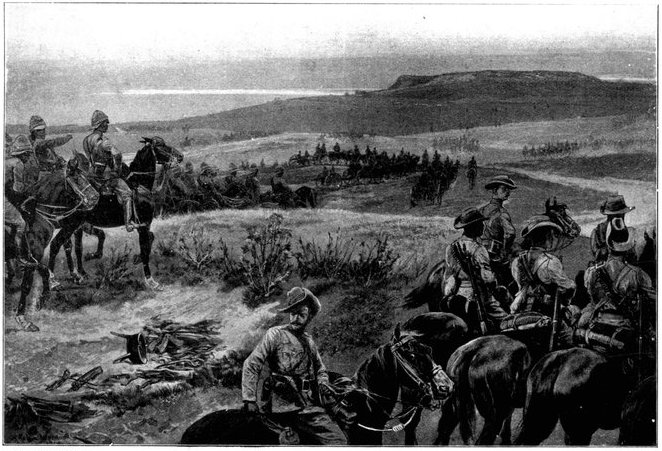
R. Caton Woodville.]
A RECONNAISSANCE IN FORCE.
The plan of campaign.
[Nov. 1899.
The original plan of campaign had been as follows:—The three British
divisions under Generals Lord Methuen, Clery, and Gatacre were to
land respectively at Capetown, Port Elizabeth, and East London. From
each of these seaports a railway line leads inland: from Capetown to
Kimberley and Buluwayo on the line which will one day run throughout
the length of Africa "from the Cape to Cairo"; from Port Elizabeth
to Bloemfontein; and from East London to Springfontein on the Port
Elizabeth and Bloemfontein railway. On nearing the Orange River these
three lines converge on a front of about 100 miles, the Capetown and
Kimberley line at Orange River station, a distance of some 570 miles,
that from Port Elizabeth at Norvals Pont, 328 miles by the railway,
and that from East London at Bethulie, a distance of 290 miles. The
use of three lines of railway, which in any case would have been very
much to our advantage, was the more desirable from the fact of the
South African lines being single tracks, with but scanty accommodation
for the returning trains, and few facilities for the transport of
huge quantities of stores and war material. It was probably intended
to effect the concentration a little south of the[Pg 66]
Orange River, or perhaps ultimately upon Orange River station, where
the Capetown and Kimberley line crosses the river. The three divisions
would then have advanced on Bloemfontein. Meantime the original idea
was that Sir George White would be able to keep the enemy at bay in
Natal. This was a lamentable miscalculation, and the fact that after
twenty days of war he was enveloped, defeated, and shut up in Ladysmith
with 12,000 men profoundly affected the whole conduct of the campaign.
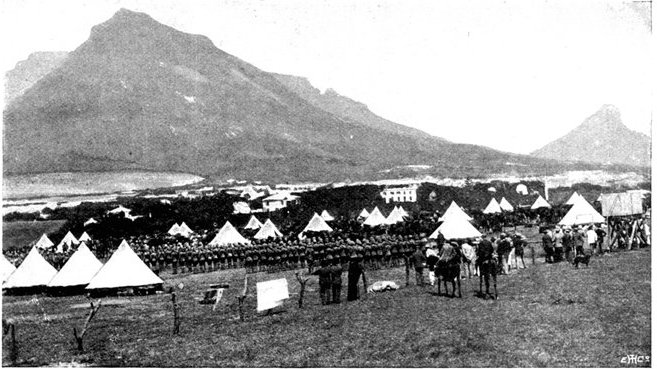
OUDEMOLEN CAMP.
12th Lancers parading one hour after receiving orders to proceed to the
front.
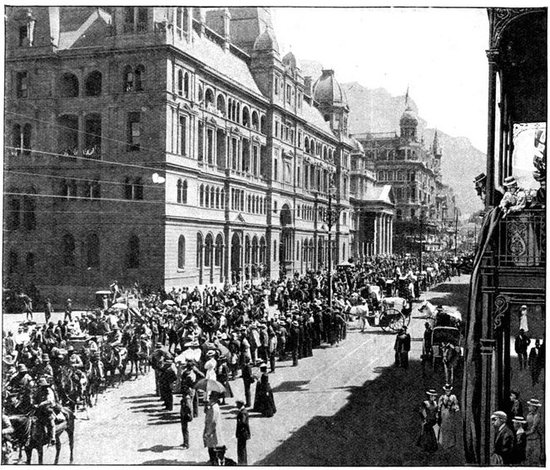
ARRIVAL OF NEW SOUTH WALES LANCERS IN CAPE TOWN.
Passing the General Post Office in Adderley Street.
The problem before General Buller when he reached South Africa was a
difficult one to resolve. Was he to depart from his plan of campaign
and detach a great part of his force to Natal to relieve Ladysmith?
If he did so, an advance on Bloemfontein must be almost indefinitely
postponed. Or was he to advance resolutely upon Bloemfontein and to
trust to such strategy drawing off the Boers from Natal to the defence
of the threatened capital of the Free State? But, in this case,
how could he be certain that the Boers would not "swap queens"—or
determine to take Ladysmith with the 12,000 British troops inside the
town, and allow Bloemfontein to fall? It is possible that political
pressure decided the problem; but, be this as it may, General Buller
eventually decided to move about half his force to Natal. One division,
that under Lord Methuen, received orders to undertake an advance upon
Kimberley, which town was reported to be in some straits, though the
published despatches were cheerful enough in tone. Lord Methuen began
to concentrate at De Aar. General Gatacre, with a greatly attenuated
force, was sent to East London, to operate in what is perhaps the most
difficult region of all South Africa, in the midst of a population
thoroughly disloyal.
[Pg 67]
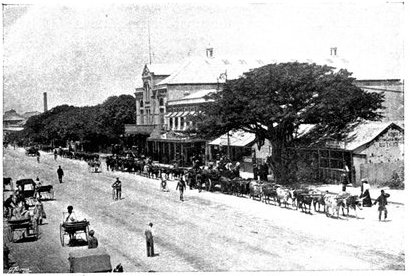
MARINES WITH HEAVY GUNS PASSING THROUGH DURBAN.
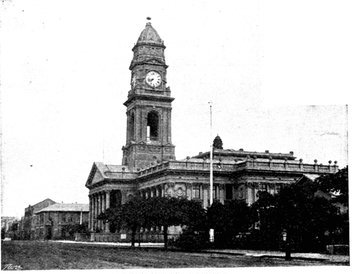
DURBAN TOWN HALL.
This building claims to be the finest in Natal. It has been fitted up
and used as a hospital during the war.
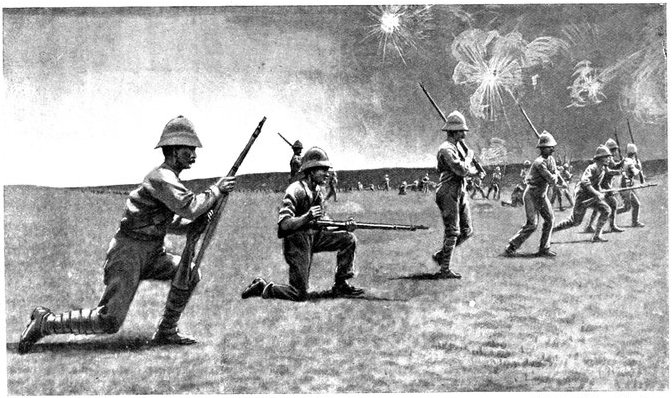
[Photo by the Biograph Company.
FEELING THE ENEMY.
The "firing-line" approaching within rifle range. From an instantaneous
photograph of troops actually in action.
Nov. 1899.] Climate of South Africa.
Character of the country.
[Nov. 1899.
A word must now be devoted to the terrain in South Africa. Except in
Natal the country through which the advance was about to take place
is generally arid, waterless, and unproductive. The climate is dry,
salubrious, and generally hot. Rain is almost unknown except in the
rainy season, which includes the months from mid-October to mid-March.
Over a great part of Western Cape Colony the rainfall is less than 10
inches; in Central Cape Colony and the west of the Free State it ranges
between 15 and 25 inches. In consequence of this diminutive rainfall
forage for horses and mules is difficult to obtain in any but the wet
season, and South Africa generally cannot maintain its own population,
but has to import breadstuff's. The physical[Pg 68] structure of the country
is a vast table-land, 2,500 to 5,000 feet in height, lying on both
sides of the great Drakensberg Range, the topmost summits of which
rise to 11,000 feet. As in most mountainous regions, the climate of
this great upland is hot by day and cold by night. The rivers, for the
most part, shrink in the dry season to mere chains of stagnant pools;
the Orange River alone is able to float small boats along the greater
part of its course at all times of the year. When the rains do come
the tricklets swell to formidable torrents, and can only be crossed
with difficulty. The surface of the interminable table-land or veldt
is broken by innumerable low hills or kopjes, which are covered with
boulders, affording the finest possible shelter for marksmen. Here and
there rise the low conical mounds which mark the nests of white ants,
and which give equally good cover. Desolate, monotonous, and forbidding
though this land appears at first sight, its charm grows upon the
traveller. Its very dryness makes it a healthy home for the white
races; its air is clear and stimulating to a degree.
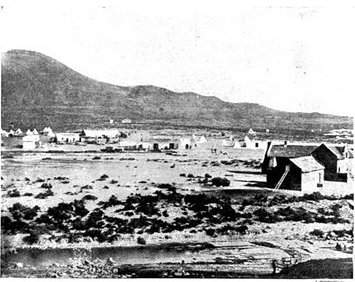
A VIEW IN THE KARROO.
The northern portion of Cape Colony and much of the Orange Free State
is of the arid character indicated in this photograph. It is dotted
with ant-hills and with low scrub.
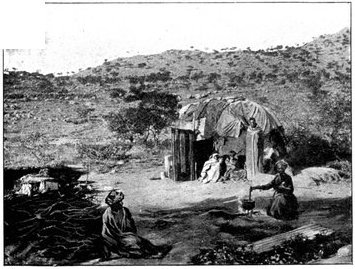
A KAFFIR HUT IN THE KARROO.
New tactics required.
In such a country as this the tactics of Europe cannot be employed. The
general's greatest difficulty will be to provision and water his men
and beasts of burden. The absence of good roads compels entire reliance
upon railways, and gives them an importance which they nowhere else
possess. Yet, liable as they are to interruption by a single daring
horseman, they are most untrustworthy lines of communication, as was
seen again and again during the course of the war.
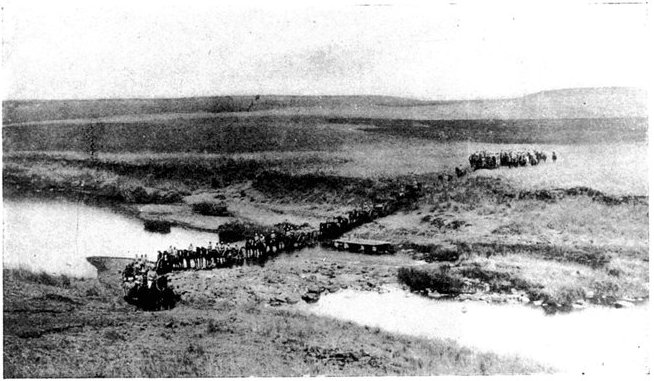
A BATTERY OF ARTILLERY CROSSING A DRIFT.
The rivers in South Africa are subject to rapid fluctuations in volume.
A river which is easily fordable in the morning, may by night be quite
impassable, and this fact has had to be reckoned with by our Generals.
Buller, in particular—"The Ferryman," as a humourist dubbed him on
account of his frequent crossing and recrossing of the Tugela—found
his operations greatly obstructed by the swollen river.
Despatch of the Fifth and Sixth Divisions.
Nov.-Dec. 1899.] Despatch of the Fifth
and Sixth Divisions.
When the news of the defeat of Sir George White on October 30 reached
England the Government did not, as might have been anticipated, gather
from this the extreme need for large reinforcements, or awake to the
gravity of the war. Three battalions were ordered out to replace the
men lost at Nicholson's Nek, but[Pg 69] a steady stream of reinforcements
was not kept flowing towards the Cape. There was talk of mobilising a
Fifth Division, but the mobilisation was not begun until November 13,
and thus 10 days were wasted at a time when every moment was precious.
Nor was there any haste in the despatch of this Division; the first
transport conveying troops belonging to it did not leave till November
24, the last not until December 9, forty days after the disaster. The
Sixth Division was not mobilised until December. Had both divisions
been mobilised on November 3 or 4, it may safely be predicted that the
misfortunes which befell British arms in South Africa during the second
week of December would not have had to be recorded. Whatever may have
been the cause of these delays, it is certain that they occasioned deep
disappointment, not only to the generals at the front, whose despatches
again and again adverted to the necessity for more men, and especially
for more cavalry and artillery, but also to the public at home, who
throughout had manifested their readiness to meet any expense and to
make any sacrifice to secure a prompt and permanent settlement. There
were rumours of friction between the War Office and the Treasury,
but Sir Michael Hicks-Beach has indignantly repudiated the charge of
parsimony. Lord Wolseley has, however, frankly admitted that the forces
of the enemy were underestimated; an error into which, unfortunately,
we fall again and again.
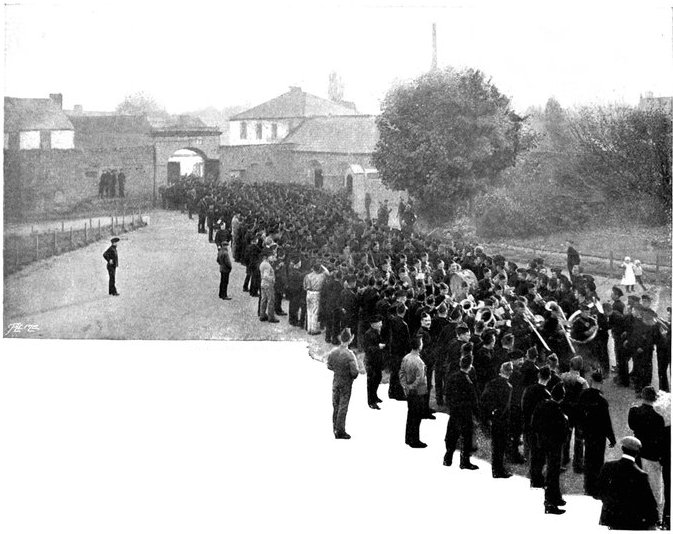
[Photo by Argent Archer.
RESERVISTS AT KILKENNY.
The photograph represents the playing into barracks at Kilkenny of the
last batch of reservists of the King's Royal Rifles (3rd Battalion).
Of this regiment the Duke of Cambridge is Colonel-in-Chief, and Sir
Redvers Buller Colonel-Commandant.
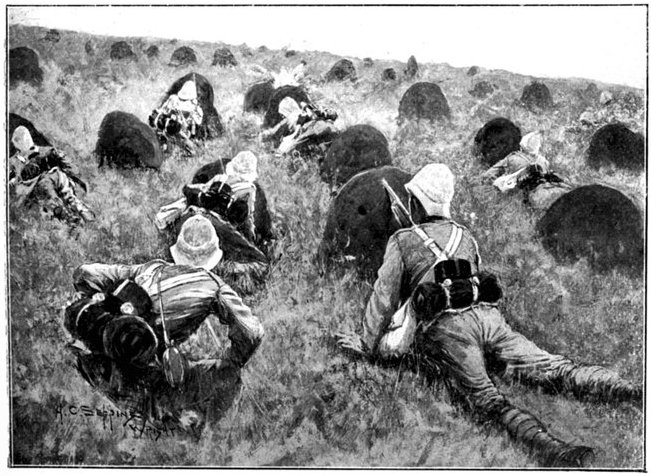
PLAYING THE BOER GAME.
British soldiers using ant-hills and boulders for cover.
[Pg 70]
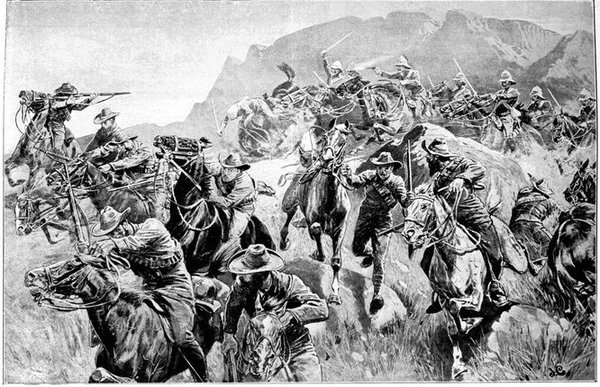
S. Charlton.]
BRITISH CAVALRY DRIVING IN A BOER OUTPOST.
CHAPTER V.
THE BEGINNING OF THE ADVANCE IN NATAL AND CAPE COLONY.
Natal threatened—Armoured trains—Ladysmith
bombarded—Assault on the town—The Boers
at Chieveley—Armoured train wrecked near
Chieveley—Endeavours to clear the obstruction—Capture
of Mr. Winston Churchill—The Estcourt garrison in
danger—Shelling of Mooi River Camp—Boer advance
checked at Nottingham Road—The Willow Grange
fight—Arrival of Lord Dundonald and General
Buller—Comparison of the opposing armies—The forward
movement begins—Boer position at Colenso—Buller
determines to attack.
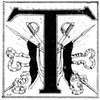
The Boer success before Ladysmith on October 30 was not promptly
followed up, probably because of the want of a properly organised
transport, and the diminutive British forces outside the beleaguered
town were given three or four very precious days to prepare for the
worst. Colenso, we have seen, was evacuated on November 2, and the
British garrison withdrawn to Estcourt, 27 miles farther south. The
Boers occupied a strong position on a hill known as Grobler's Kloof,
a little to the north of the Tugela, commanding thoroughly the roads
between Ladysmith and Colenso. Upon this hill they placed heavy guns
and erected entrenchments with two objects—the first to prevent the
advance of a relief force from the south, the second to shut in Sir
George White. They also showed well to the south of Colenso, in the
neighbourhood of Frere, having apparently marched by the roads which
lead down into the centre of Natal from the Upper Tugela region. They
did not immediately occupy Colenso, but they made all preparations to
destroy the two bridges, should such a measure become necessary.

Frank Craig.]
COLD STEEL: BRITISH SOLDIERS DRIVING THE BOERS FROM A KOPJE.
[Pg 72]
Natal threatened.
[Nov. 1899.
The danger for Natal was great. Captain Percy Scott of the Terrible
landed with a large number of guns and bluejackets to defend Durban;
works were erected at Pietermaritzburg, the capital of the Colony,
and volunteer forces were raised with all possible expedition. The
Imperial Infantry Corps, 1,000 strong, was enrolled at Durban and
Pietermaritzburg; Murray's Mounted Volunteers, Thorneycroft's Mounted
Infantry, the Umvoti Mounted Volunteers, and the Durban Light Infantry
were among the other regiments raised by the Colony.
[Pg 71]
Hundreds of refugees from Colenso and the abandoned districts poured
down into the seaboard of Natal, yet there was no sign of panic. The
women especially distinguished themselves by their fortitude and
bravery in this hour of sad calamity. Nor did the Colonists reproach
the Home Government, which had failed, in spite of many entreaties,
adequately to garrison the Colony, though to the irresolution and
tardiness displayed by the authorities at home all these sufferings
were due.
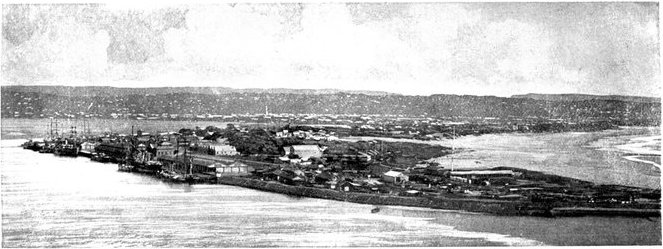
DURBAN, THE BRITISH BASE IN NATAL.
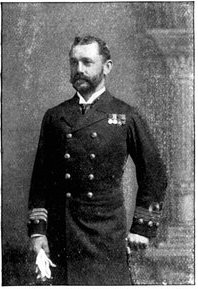
CAPTAIN PERCY SCOTT, C.B., OF H.M.S. "TERRIBLE."
Under Captain Scott's direction a number of 45-pounder naval guns were
rapidly supplied with carriages, which gave them mobility and rendered
them available as a sort of heavy field-gun. So mounted, they were
of the greatest service both in the defence of Ladysmith and in our
numerous assaults upon Boer positions. Captain Scott also designed a
railway truck to carry the gun, and from which it could be fired.
[Photo by West, Southsea.
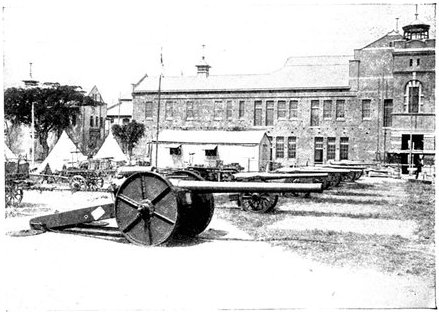
GUNS LANDED BY THE "TERRIBLE" AT DURBAN, ON CAPT.
SCOTT'S CARRIAGES.
Armoured trains.
An armoured train daily proceeded from Estcourt to reconnoitre in the
direction of Colenso. Why this dangerous and clumsy contrivance should
have been used for such a purpose it is difficult to say. The lives of
somewhere about 100 men were daily risked upon an errand which could
have been accomplished with infinitely greater ease by half-a-dozen
mounted infantry. The train was tied of necessity to one line of
advance or retreat; it was a conspicuous object, and made enough noise
with its puffing and blowing to alarm all the Boers for miles around.
Nothing could be easier for them than to bring up and lay their guns on
some particular point of the line, removing one or two rails. If this
were done after the train had passed, its retreat might be cut off and
its capture rendered certain. The risk was a matter of common talk in
the British camp, yet these foolhardy expeditions continued day by day.
[Pg 73]
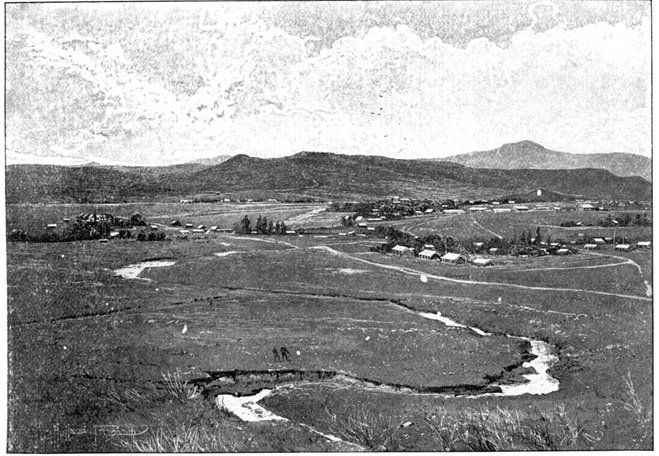
ESTCOURT.
Nov. 4-9, 1899.] Armoured Trains in Natal.
On November 5 the armoured train carried two companies of the Dublin
Fusiliers close to Colenso, when the enemy was sighted. The infantry
detrained, but, as it was clearly seen that the Boers were endeavouring
to cut the British line of retreat, entrained again and fell back
towards Estcourt. Then the enemy in his turn retired, and the train
advanced cautiously as far as Colenso station, while the British
troops entered the town and removed at their leisure four waggon loads
of shell, provisions, and stores. On the 9th the train advancing on
Colenso found the line torn up about a mile from that town.
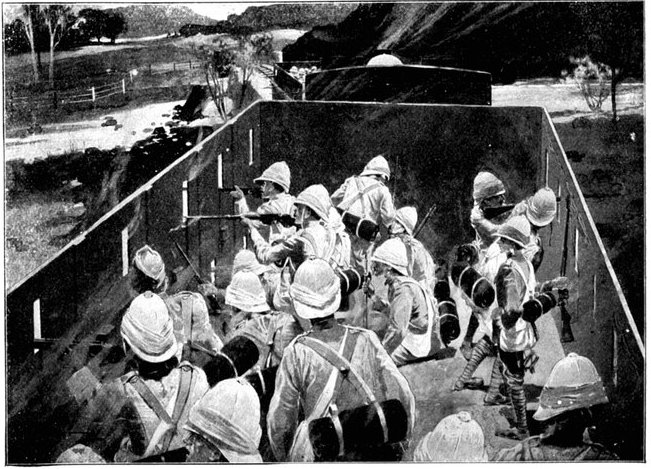
INSIDE AN ARMOURED TRAIN.
Ladysmith bombarded.
Meantime the Boers had steadily bombarded Ladysmith. Day by day their
heavy guns poured shell and shrapnel into the town, doing, however,
very little damage, and inflicting insignificant loss of life. On
November 4 General White opened negotiations with Joubert, in command
of the Boer forces, for the removal of the sick and the women and
children, who should have been sent away before the siege began, but
who, with the lamentable want of foresight which characterised all our
operations, had been allowed to remain in the town till the investment
was complete. It is natural for a general officer in command of an
investing force to refuse to allow a besieged force to rid itself of
its encumbrances, but Joubert suggested that the non-combatants should
be removed to a certain point outside the zone of fire. This point
was afterwards known in the British camp as "Funkumdorf"; few of the
wounded and very few indeed of the women consented to remove to it.
In fact, the bearing of the British women was here, as in all other
quarters, heroic, and above all praise.
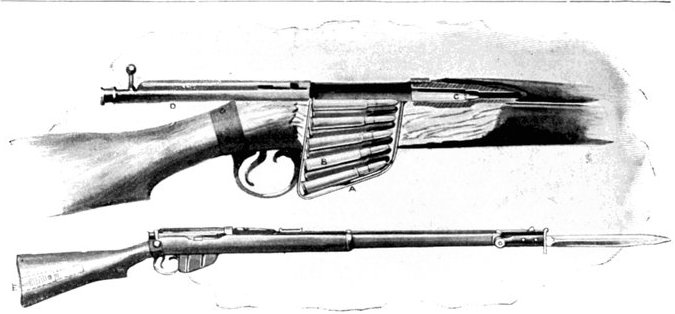
THE LEE-ENFIELD RIFLE, USED BY THE BRITISH TROOPS.
The cartridges B are placed singly in the magazine A,
from which a spring at the bottom forces them upwards till one of them
enters the breech, when it is pushed forward by the bolt D
into the chamber C and fired. The withdrawal of the bolt
ejects the spent cartridge. There is a slide which, when required, cuts
off the magazine and allows single cartridges to be used. F is
a cleaner and oilcan carried within the butt.
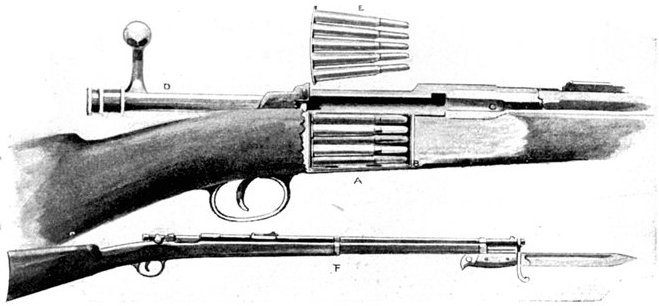
THE MAUSER RIFLE, USED BY THE BOERS.
The cartridges E are carried in a holder, from which, by
one pressure of the thumb, they are released and dispose themselves
in proper order in the magazine A. They are pressed upwards
by a spring B, and forced, one at a time, into the chamber
C by the bolt D. The rifle is sometimes provided with
a bayonet, but this the Boers do not carry.
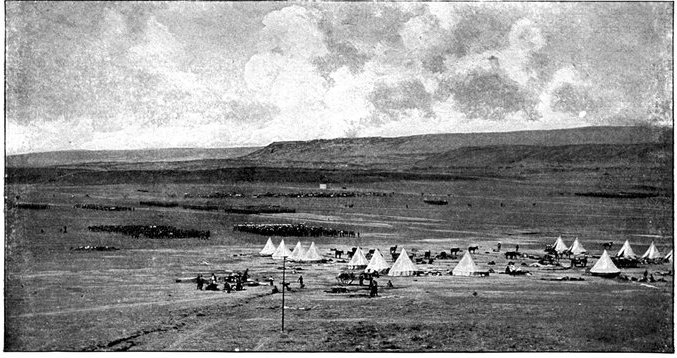
LADYSMITH CAMP AND UMBULWANA.
Assault on the town.
[Nov. 9, 1899.
Nov. 9-15, 1899.] The Armoured Train
Disaster.
On the 9th the Boers delivered a half-hearted assault upon Ladysmith,
and were repulsed with some loss. The main attack came from the north,
and was[Pg 74] met by the King's Royal Rifles and the Rifle Brigade. It was
never pressed home, as the Boers did not approach within a thousand
yards of the British works. They could be seen in all directions just
out of range massed for an advance, but the advance was never made.
There was a furious interchange of rifle and cannon fire, but little
more. The British losses were absurdly small—only three killed and
seventeen wounded. To what extent the enemy suffered it was difficult
to say, but there is reason to think that the Boer losses were far
heavier. When the conflict died away, the naval weapons fired a salute
of twenty-one guns in honour of the Prince of Wales' birthday, and
the troops sang the National Anthem "to the accompaniment of shrapnel
and 100-lb. shells from the Boer guns shrieking through the air."
Altogether the result of the fight was such as to make the enemy
very chary of attacking our works, and to put fresh spirit into the
beleaguered force. On this same day Mr. Kruger threatened that unless
a Transvaal spy, named Marks, who had been arrested and confined in
Ladysmith, were released, he would execute six British officers. The
threat was received with the contempt which it deserved. It appeared
that Marks was a member of the Transvaal detective service who had
been in[Pg 75]
Natal gathering information before the war. As such his detention was
perfectly justifiable; indeed, in any European struggle he would have
been summarily shot.
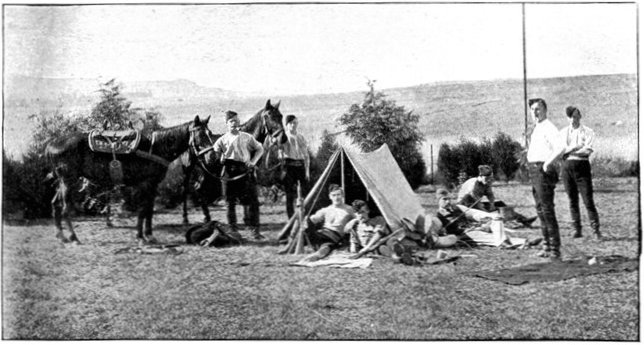
THE EYES OF THE ARMY, NATAL POLICE ON PATROL.
The Boers at Chieveley.
On November 12 the first ray of light pierced the deep gloom in Natal,
when the first troops of General Hildyard's brigade landed from the
Roslin Castle at Durban. They were at once sent up country to
Estcourt. On this same day a general movement of Boers coming from the
Free State began upon Central Natal. On the 13th the railway line was
destroyed at Chieveley, one station to the south of Colenso. A force
of about 500 Boers was seen at Chieveley on this day. The armoured
train arrived while they were actually at work destroying the line and
temporarily drove them back. About the same time parties of Boers were
seen at Estcourt, and some alarm began to be felt for the troops at
that place. On the 14th the Lismore Castle and Yorkshire arrived
at Durban, on the 15th the Gascon, and on the 16th the Hawarden
Castle, and landed fresh reinforcements, which were hurried up to
General Hildyard at Estcourt.
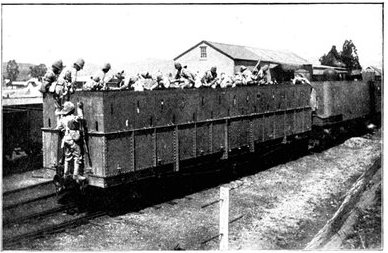
THE DUBLIN FUSILIERS CLIMBING INTO THE ARMOURED TRAIN ON
THE DAY OF THE DISASTER.
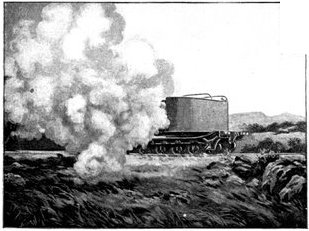
FIRING A GUN FROM AN ARMOURED TRAIN.
Armoured train wrecked near Chieveley.
[Nov. 15, 1899.
On the 15th a second and easily preventable reverse befell our troops
in Natal, causing general discouragement. This was the derailment
of an armoured train near Chieveley—a catastrophe which had been
foreseen for some days by every private and subaltern in the British
camp. Early on the 15th the train, with a company of Dublin Fusiliers,
half a company of Durban Light Infantry, and one wretched little
muzzle-loading 7-pounder gun from H.M.S. Tartar, mounted on a truck
and manned by bluejackets, left Estcourt. The train passed Frere, the
station south of Chieveley, in safety without seeing any Boers. Just
beyond Chieveley, however, the enemy were made out in some strength
upon a hill. A message reporting this fact was sent back to Estcourt,
whereupon the train was promptly ordered to return to Frere. The order
was obeyed, but when less than two miles from Frere, a hill in front
commanding the line at a distance of only 600 yards, was seen to be
held by the enemy. The Boers gave no sign of life till the train
was close under them, and then opened a tremendous fire from their
rifles and from two field guns and a Maxim automatic one-pounder.
Simultaneously the driver of the locomotive put on all steam and the
train headed furiously down a steep gradient towards Frere. But the
enemy[Pg 76] had made full preparations. A large stone had been placed on the
line, and this derailed the leading truck (containing plate-layers'
tools, a breakdown gang, and the guard), an armoured car behind it, and
another truck. The occupants were flung through the air, and several of
them severely injured. The engine, one armoured car, and the truck with
the 7-pounder, kept the rails.
Endeavours to clear the obstruction.
Unfortunately the derailed armoured car and truck blocked the line
and had to be removed. The Boer guns had changed their position, and
opened a pitiless fire at a range of 1,300 yards. None the less, the
men of the Durban Light Infantry and the Dublin Fusiliers, led by
Captain Haldane and Mr. Winston Churchill—sometime a lieutenant in
the Army and now acting as a newspaper correspondent—bravely set to
work. Shells and bullets rained upon them, yet, in spite of this, one
truck was dragged backwards and then toppled over so as almost to clear
the line; it still overlapped slightly, and the engine was set to work
to butt it aside. There was great danger of derailing or injuring the
locomotive in this operation. Attempt after attempt was made carefully,
with unsuccess. Each time the engine moved it a little, but only a
little, and the successive pushes failed to clear the line. At last,
however, a well-aimed shell struck the locomotive, setting the wood
with which it was protected on fire, and the driver in despair turned
on full steam. With a grating, tearing sound the engine tore its way
past, but, unhappily, the armoured car and truck behind it parted their
couplings, and could not be got past the obstruction. They had to be
abandoned.

THE DISASTER TO THE ARMOURED TRAIN NEAR CHIEVELEY.
In which Mr. Winston Spencer Churchill, the special correspondent
of The Morning Post, son of the late Lord Randolph Churchill,
distinguished himself by his gallant conduct.
As many of the wounded as possible were placed on the engine, and
keeping on the further side of it the survivors retreated. The Boers,
however, poured in such a hot fire that order soon vanished from the
British force. The engine had to put on steam to escape; the infantry
were left behind, and dropped here and there crying for help. A few
were doubling to some houses for shelter, when a wounded private raised
the white flag.
[Pg 77]
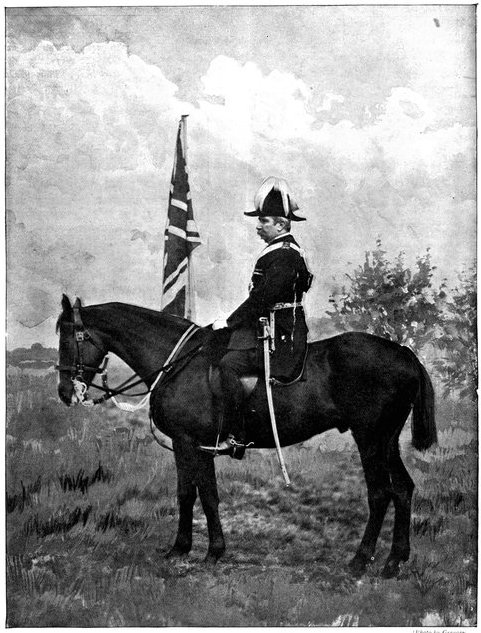
[Photo by Gregory.
GENERAL SIR REDVERS BULLER, K.C.M.G., K.C.B., V.C.
Born, 1839; entered 60th Rifles, 1858; served in China, 1860; Red
River Expedition, 1870; Ashanti War, 1874; Kaffir War, 1878; Zulu War,
1878-9; Deputy Adjutant-General, 1885; Under Secretary for Ireland,
1887; Adjutant-General, 1890; Lieut.-General, 1891; in command at
Aldershot, 1898; appointed to command of Army Corps, South Africa,
1899. Sir Redvers Buller arrived in Capetown October 31; having matured
his plans he went on to Natal, arriving on November 25.
[Pg 78]
[Nov. 15, 1899.
Capture of Mr. Winston Churchill and eighty men.
At once the Boers galloped in upon the shattered remnants and demanded
their surrender. Churchill was captured with the party; he had been
on the engine, but upon reaching Frere had gallantly jumped down and
gone back into the battle. Five of the British force were killed;
twenty wounded and sixty unwounded prisoners were taken; fifteen
wounded escaped on the engine, and about twenty men who were not on
the engine got away through the bush. Thus needlessly and wastefully
were a hundred men, whom the country could ill spare, thrown away. The
defeat had, however, one excellent result. It thoroughly discredited
the armoured train, and this death trap was used no more. Henceforward
scouting was done by mounted men. The Boer detachment which had
effected this capture was 300 strong, part of a commando of about
3,000 men who were moving south under General Joubert to raid Natal.
The unhappy British prisoners were assembled and marched to Colenso,
whence they were despatched to Pretoria. They were treated with extreme
kindness. The Boer commander complimented them upon their defence, and
permitted them to see the guns which had wrought their discomfiture.
These were of the latest type, quick-firers, using fixed ammunition
(i.e., with shell and cartridge made up together as in rifle
ammunition), and of much greater range than British field guns.
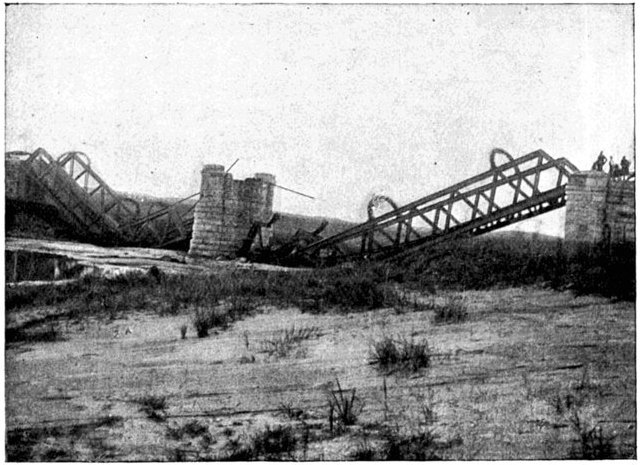
FRERE BRIDGE, DESTROYED BY THE BOERS, November 24.
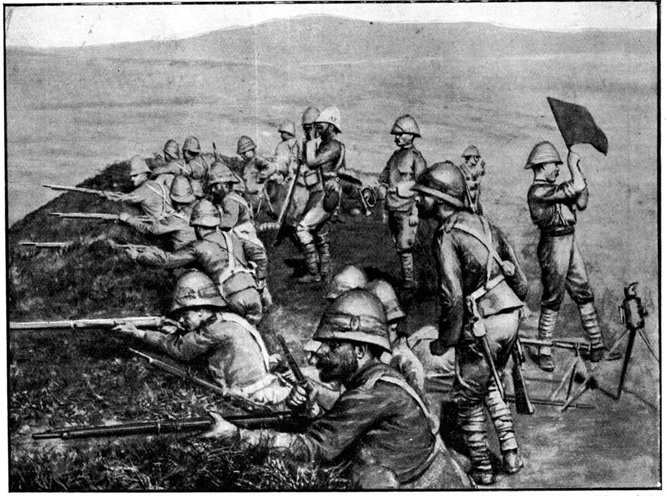
[Photo by the Biograph Co.
AT CHIEVELEY: SIGNALLING FOR REINFORCEMENTS.
The Estcourt garrison in danger.
Nov. 15-20, 1899.] The Boers in Central Natal.
In face of the Boer advance, the position of the garrison at Estcourt,
which did not reach 3,000 men, became very serious. The place was
commanded by heights from which the Boer long-range guns could bombard
with effect, and from the numerical weakness of the British force and
the want of water these heights could not be occupied by our men. There
were no cavalry or mounted infantry beyond a couple of hundred men
to meet and keep touch with the enemy. The only artillery available
was composed of one or two naval 12-pounders and the Natal Government
obsolete 9-pounder muzzle-loaders. The Home Authorities in their
wisdom had decided that this was to be an infantry war; and the result
was that the Boers by their extreme mobility, and the ubiquity which
resulted from that mobility, were able to do what they liked. They
could collect great quantities of cattle and loot, could isolate the
British garrisons in Natal, and almost invest them. Had they determined
to destroy the railway, the cul[Pg 79]verts, and the railway bridges south of
Colenso the damage and delay caused would have been very great, but for
some inscrutable reason they did little beyond wrecking the iron bridge
at Frere and tearing up the rails in one or two places.
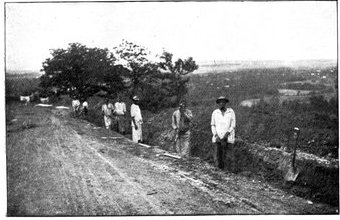
KAFFIRS DIGGING A TRENCH FOR THE BRITISH AT CHIEVELEY.
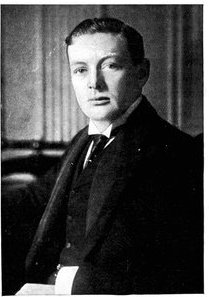
[Photo by Elliott & Fry.
MR. WINSTON LEONARD SPENCER CHURCHILL
Is the eldest son of the late Lord Randolph Churchill, and inherits
many of his father's brilliant qualities. He was born on November 30,
1874, and is therefore only a little over twenty-six years old. He
was educated at Harrow and Sandhurst, and entered the Army in 1895.
He served with the Spanish forces in Cuba in that year, and saw much
Indian service with the Malakand Field Force in 1897; was orderly
officer to the late Sir William Lockhart, and was attached to the 21st
Lancers with the Nile Expeditionary Force in 1898, and present at the
battle of Khartoum. On November 15, 1899, when an armoured train was
captured by the Boers at Chieveley, Lieut. Churchill distinguished
himself by his bravery; he was taken prisoner and deported to Pretoria,
where he remained in prison at the State Model School for many weeks.
On January 14 he escaped, and, after enduring very many hardships, he
reached Delagoa Bay, and again went to the front.
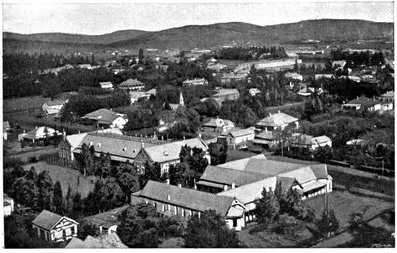
PRETORIA.
Showing in the foreground (above the point marked) the Model Schools
where the British officers were imprisoned.
[Nov. 20-22, 1899.
Shelling of Mooi River Camp.
As the transports reached Durban a considerable force of British troops
assembled at Estcourt between November 16 and 19. Two battalions
of infantry, Bethune's mounted infantry—raised in Natal—and two
batteries of artillery were the first to arrive. On the 18th there
was skirmishing between the Boers and the British troops a couple of
miles to the north of Estcourt. The enemy raised the Transvaal Flag
at Weenen and scoured the whole country on both sides of the railway
between Colenso and Estcourt. On the 19th Boers were seen at Highlands,
two stations to the south of Estcourt and close to Mooi River, where a
small British force was encamped. It was decided to attack the enemy
under cover of darkness, and on the 20th 900 British infantry, 450
mounted men and two naval guns moved out from Estcourt under Colonel
Hinde. But at the last minute news was received that the Boers were far
stronger than had been supposed. Colonel Hinde hesitated to attack,
and the opportunity was lost. On the 21st the British column tardily
approached the enemy's position, and was about two[Pg 80] miles off it when
intelligence arrived that another Boer commando was approaching the
railway from the west. Fearful of being cut off, after indulging in a
little skirmishing with the Boers the British fell back to the railway,
entrained, and retired precipitately to Estcourt. In the evening, the
railway and telegraph south of Estcourt were broken and the British
force there isolated. On the same day Mooi River Camp, where were 4,000
or 5,000 British troops, was shelled at extreme range. The boldness of
the Boers is proved by the fact now known that they ventured upon this
daring act in the face of a far superior force of disciplined troops
with a second superior force to their rear.
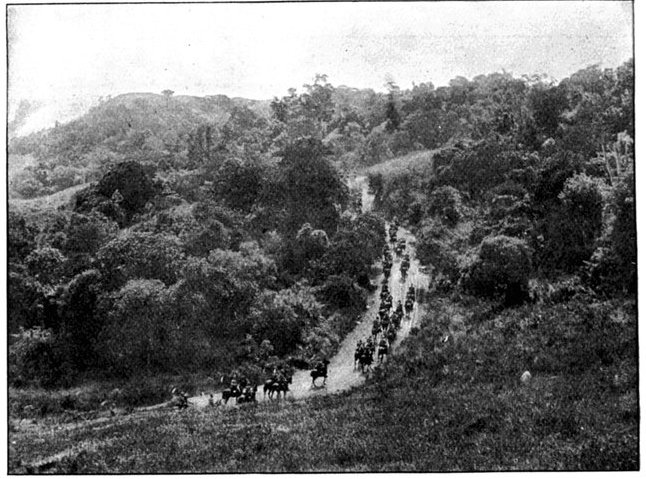
LANCERS AT NOTTINGHAM ROAD.
The most southerly point reached by the Boers in Natal.
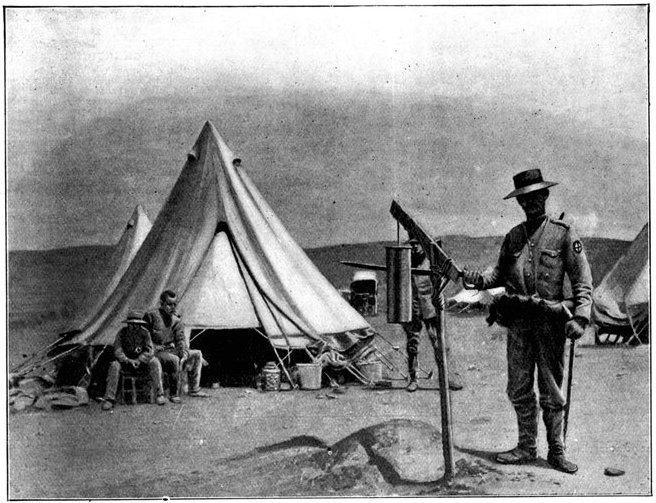
THE CLOCK OF CHIEVELEY CAMP.
The cartridge-case of one of the large naval guns was used as a bell, a
sword serving as clapper to strike the hours.
By this Boer advance a small party of Natal Police, under Captain
Cayzer, who had gone to Weenen to maintain signalling communication
with Ladysmith, were all but cut off. They had an exciting time of it.
Having climbed a mountain 5,000 feet high and set up their instruments,
just as night fell a native brought them news that they were in the
very midst of 1,200 Boers. Fortunately the night was pitch dark,
pouring with rain, and in the plash of the deluge they were able to
steal their way unperceived down a precipitous disused Kaffir track.
At the bottom, however, it was found that Captain Cayzer's horse had
broken its fetlock. One of the police took the Captain up behind, and
in this plight the party rode before the enemy first into Greytown and
then on to Pietermaritzburg.
Boer advance checked at Nottingham Road.
The most southerly point reached by small raiding parties of the Boers
was Nottingham Road, twelve miles to the south of Mooi River Camp. Here
they looted farms, destroyed the farmers' furniture, and did an immense
amount of wanton damage.
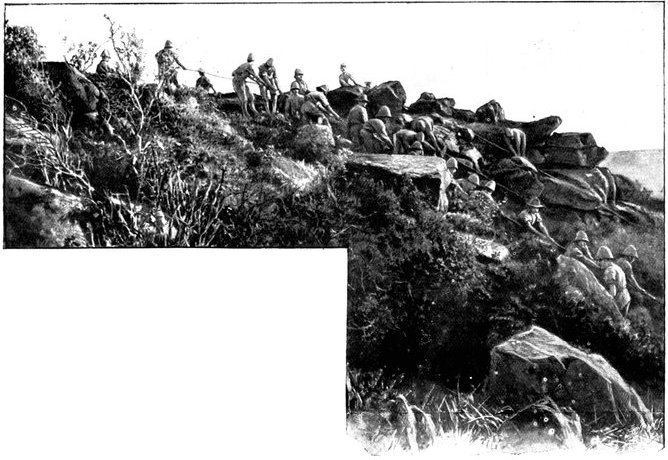
TOUGH WORK FOR TOMMY; DRAGGING A HEAVY GUN UP A HILL.
[From an Instantaneous Photograph.
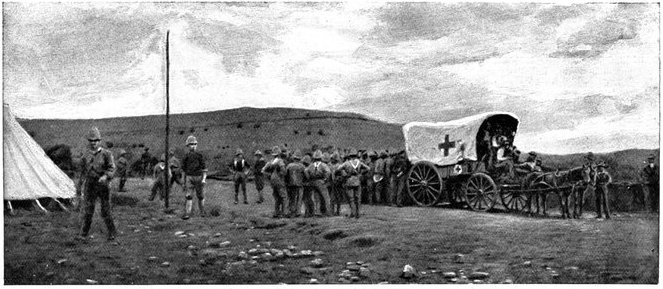
BRINGING IN THE WOUNDED FROM THE WILLOW GRANGE FIGHT.
The Willow Grange fight.
Nov. 22, 1899.] The Action at Willow Grange.
[Nov. 22-24, 1899.
To check this advance an effort was at last made on the 22nd by the
troops at Estcourt. In the afternoon of that day the West Yorkshires,
East Surreys, and Durban Light Infantry, with a naval 12-pounder,
moved to Willow Grange. The gun[Pg 81] was dragged up a steep hill known as
Klobber's Kop. The Boers were in position upon Brynbella Hill, three
miles away, and fired a couple of shots at the gun. During the night
the column was strengthened by all the available mounted troops—two
more battalions and a battery of artillery. The West Yorkshires and the
East Surreys then advanced to storm the Boer position at daybreak in
a terrific hailstorm, during which hailstones fell as big as eggs and
wounded two or three men. They climbed the slopes of Brynbella and were
close to the Boer camp when a picket challenged and opened fire. In a
moment the British troops with fixed bayonets were upon the picket,
but the Boers in camp had taken the alarm and fled along a ridge which
extended for about a thousand yards, to the main force, now seen to be
posted at the further extremity of the ridge. A heavy fire was opened
upon the West Yorkshires, and the battalion promptly took shelter
behind a low stone wall. Here the Boer guns shelled them with effect,
while as the naval gun was unfortunately unable to reach the enemy, the
British had no artillery of their own to reply. The position was quite
untenable;[Pg 82] there was nothing left except for the infantry to retire.
The retreat was covered by the mounted men, and by a squadron of the
Imperial Light Horse; it was not effected without difficulty, as the
Boers poured in a tremendous fire, moving their guns forward to shell
the infantry. The British losses were eleven killed and sixty-seven
wounded, while Major Hobbs and eight men were taken prisoners. Major
Hobbs had stayed behind to give aid to a wounded man. The affair was
far from satisfactory, as the British force, with a great numerical
preponderance, failed to dislodge or capture the enemy's commando. It
had, however, in the end the desired result, since the Boers became
anxious about their retreat and at once began to fall back.
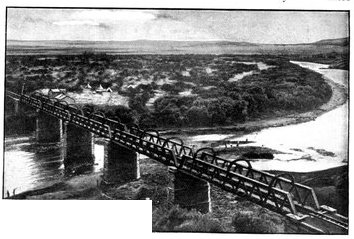
COLENSO RAILWAY BRIDGE.

BRINGING A BOER MESSENGER INTO THE BRITISH CAMP.
Bearers of messages between the opposing commanders, and in many cases
ordinary prisoners of war, are blindfolded before being led into
camp, in order that they may not be able to report particulars of the
defences.
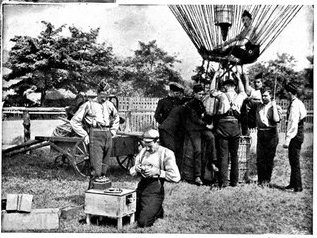
[Photo by Knight.
GETTING A WAR-BALLOON READY: ADJUSTING THE TELEGRAPHIC APPARATUS.
Nov. 24-30, 1899.] British Concentration
Effected.
Arrival of Lord Dundonald and General Buller.
This foray was not without its comic side. On November 24 the 6,000
British troops at Mooi River manned the trenches and prepared to do or
die, under the impression that the enemy, in overpowering force, was
all around. At that very moment the Boer commandos, 3,000 strong, were
scuttling back to Colenso with their plunder, only too pleased to be
unmolested. The high-water mark of the Boer advance had been reached.
On the[Pg 83] 24th the Estcourt force pushed forward to Frere unopposed,
but found that further progress was stopped by the destruction of the
railway bridge over the Blaauwkrantz. The engineers at once went to
work to build a trestle bridge. In the next two days the railway was
repaired between Estcourt and Mooi River. On the 30th Lord Dundonald,
who had arrived and taken over the command of the mounted troops,
pushed forward with 1,400 mounted infantry and a battery of artillery
to Colenso, and drew a very heavy fire from the Boer positions. After
reconnoitring these he fell back without the loss of a man. On the same
day the railway bridge at Colenso was blown up by the Boers.
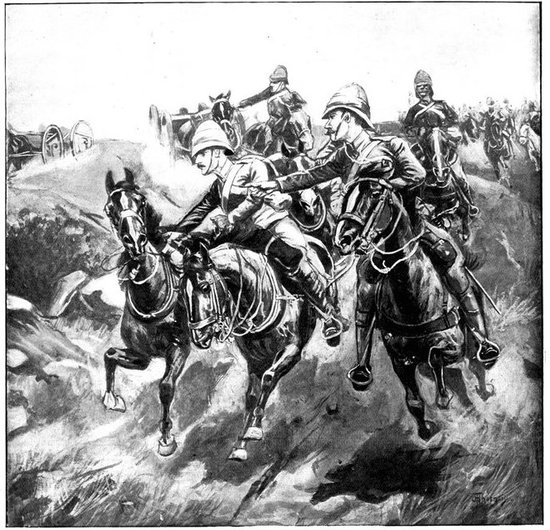
BRINGING UP A BATTERY OF FIELD ARTILLERY.
In the meantime, during the closing weeks of November and the early
days of December, no less than sixteen battalions of infantry, two
regiments of cavalry, and five batteries of field artillery had
arrived at Durban, and with them had come General Buller to take over
the command. Added to the 4,000 men already under arms in the colony
outside Ladysmith, they gave an available British force in the field of
a little over 21,000. In this force the infantry numbered 18,000, the
cavalry and mounted infantry 2,600, and the artillery 750 with 30 guns.
A mountain battery armed with six miserable little screw seven-pounder
muzzle-loaders should be added to this total.
[Pg 84]
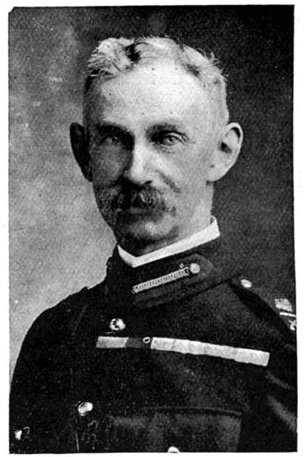
[Photo by Debenham & Smith.
MAJOR-GENERAL GEOFFRY BARTON, C.B.,
Took part in the Ashanti War of 1873-4, and in the Zulu War of 1879 in
command of the 4th Battalion of the Natal Native Contingent. He again
saw active service in the Egyptian War of 1882 as D.A.Q.G., and went
through the battles of Kassassin and Tel-el-Kebir. During the Soudan
campaign of 1885 he was Assistant Military Secretary to Sir Gerald
Graham. He commands the 6th Brigade of the South African Field Force.
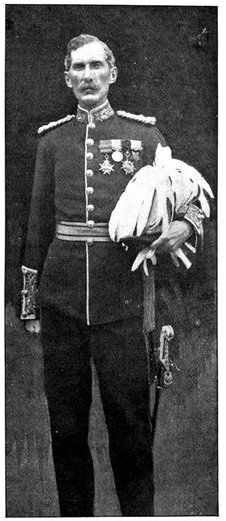
[Photo by Evelyn, Aldershot.
MAJOR-GENERAL HENRY JOHN THORNTON HILDYARD, C.B.
Had the command, until the beginning of the war, of the 3rd Infantry
Brigade at Aldershot. Originally destined for the Navy, in which he
served from 1859 to 1867; three years later he entered the Army, and
in 1876 became Captain in the Highland Light Infantry. From that time
forward his advance was rapid, and he attained his present rank in
1899. He served with the Egyptian Expedition in 1882, and was present
at Kassassin and Tel-el-Kebir. From 1893 to 1898 he was Commandant of
the Staff College. Commands the 2nd brigade in South Africa.
[Nov. 1899.
Comparison of the opposing armies.
Certain points must now be noted as bearing upon the adequacy of this
force for the work which was before it—the work of clearing a way to
Ladysmith. In the first place the strength of the enemy was believed
to be at least 25,000, and might easily be nearer 35,000. General
Buller was thus, even adding in as available the 10,000 effectives
at Ladysmith, by no means certain of outnumbering the enemy. In the
second place he would have to act on the offensive, and would have to
assail or "turn" strong Boer positions. To "turn" a position, it need
scarcely be said, is to work round it. But positions held, as were
these, by good and mobile troops cannot be successfully assailed, and
certainly cannot be turned unless there is a considerable advantage of
numbers on the assailants' side. In point of mobility General Buller's
infantry could not compare with the Boers, who were, of course, to
a man mounted, who slept in the open and needed no such elaborate
transport system as is required in the British Army. While the British
soldier was moving five miles the Boer could cover fifteen. Again, in
artillery, which must be used freely to pave the way for an infantry
attack, General Buller's army was very weak. The usual proportion in
European armies is five guns to every thousand men; he had only thirty
field guns, instead of 105, to 21,000 men. Finally, his mounted force
was inadequate, and his transport system hastily improvised.
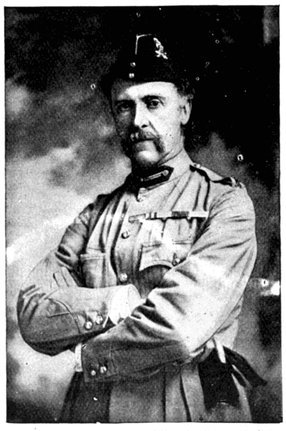
[Photo by Elliott & Fry.
MAJOR-GENERAL THE HON. NEVILLE GERALD LYTTELTON, C.B.,
Took command of the 2nd Infantry Brigade at Aldershot last year. He was
born in 1845, and was educated at Eton. He joined the Rifle Brigade in
1865, and served with it in Canada and India, seeing a good deal of
active service. A.D.C. to Lord Spencer, Viceroy of India, from 1868 to
1873, and Military Secretary to Sir John Adye, Governor of Gibraltar,
and to Lord Reay, Governor of Bombay. He went through the Egyptian
campaign of 1882, and commanded a brigade in the Nile Expedition
of 1898, being present at the battle of Khartoum. He was Assistant
Military Secretary at the War Office during 1897 and 1898, and now
commands the 4th Brigade in South Africa.
All these considerations militated strongly against any substantial
success. It is not known whether he asked of the Home Government a
larger force, but if he did it was not granted him. Yet 50,000 men with
200 field guns would have been not one whit too great a strength for
the proper performance of his task. Here as elsewhere in South Africa
the disasters which befell British arms may be traced to these three
causes—under-estimating the enemy's force, attempting to effect most
difficult operations in a difficult country with inadequate strength,
and failure to observe the precautions which the lessons of the past
have shown to be necessary.
Nov.-Dec. 11, 1899.] Composition of the
British Force.
In the last week of November, General Buller's army was reinforced by
two naval 4·7-inch guns and fourteen 12-pounders, which[Pg 85] had been sent
ashore from the Terrible for the defence of Durban. These weapons,
from their great range and extreme power, were a valuable addition to
the British artillery, though, mounted on improvised carriages and
drawn painfully by oxen, they could not compare in mobility with our
field guns. They were manned by bluejackets, who proved themselves
formidable marksmen.
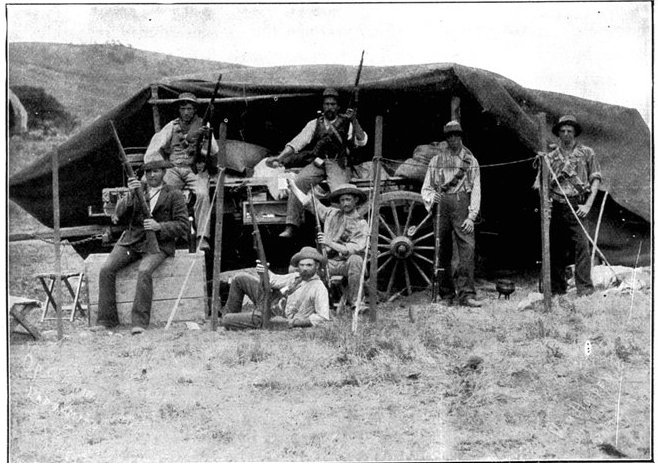
[Photo by Van Hoepen.
SOME OF THE MEN WHO KEPT US OUT OF LADYSMITH.
Boer farmers with their servants encamped on a hill overlooking the
town.
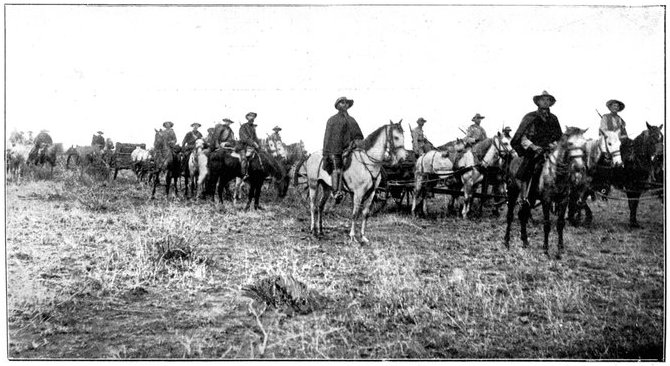
BOER COMMANDO WITH MAXIM GUN DRAWN BY HORSES.
The forward movement begins.
On December 11th everything was ready for a forward movement. The
troops were disposed as follows:—
| Hildyard's Brigade. |
Lyttelton's Brigade. |
Barton's Brigade. |
Hart's Brigade. |
| 2nd Royal West Surrey. |
2nd Scottish Rifles. |
1st Royal Welsh Fusiliers. |
1st Connaught Rangers. |
| 2nd West Yorkshire. |
1st Durham Light Infantry. |
2nd Royal Irish Fusiliers. |
1st & 2nd Rl. Dublin Fusiliers. |
| 2nd East Surrey. |
1st Rifle Brigade. |
2nd Royal Scots Fusiliers. |
1st Royal Inniskilling Fusiliers. |
| 2nd Devonshire. |
3rd King's Royal Rifles. |
2nd Royal Fusiliers. |
1st Borderers. |
| 14th and 66th Field Batteries. |
63rd and 64th Field Batteries. |
| Dundonald's Mounted Brigade. |
| 1st Royal Dragoons. |
Composite Regiment of Mounted Infantry. |
Thorneycroft's Mounted Infantry. |
| 13th Hussars. |
Bethune's Mounted Infantry. |
South African Light Horse. |
| 7th Field Battery. |
[Pg 86]
[Dec. 12-14, 1899.
Barton's brigade was the first to move out from Frere Camp. At dawn on
December 12 it advanced to a kopje three miles south of Colenso. From
this kopje the ground sloped smoothly and gently down to the River
Tugela, hidden in its deep bed by scrub and brushwood.
Boer position at Colenso.
To the north in a hollow lay the tin roofs of the little village of
Colenso and the road bridge, which the Boers had left intact. Across
the river the outline of the enemy's works could be vaguely made out by
powerful glasses along the slopes of two strongly fortified kopjes and
beyond these on the high hills which rise to the north-west and which
are known as Red Hill and Grobler's Kloof. At Fort Wylie, on a low hill
just across the river, was another strong Boer position close to the
railway and commanding the two bridges. Away on the extreme British
right rose the steep purple slopes of Mount Inhlawe on the southern
bank of the river. This mountain towered to a height of over 4,000
feet, dominating the whole neighbourhood. From its slopes and summit an
enfilading fire could be directed upon any force attempting to cross
the river near Colenso. It was held in strength by the Boers, who had
built a military bridge over the Tugela to the north of it, though the
fact was as yet unknown to the British. Nearer Colenso were the heights
of Monte Cristo and Hlangwane, both, like Inhlawe, held by the Boers.
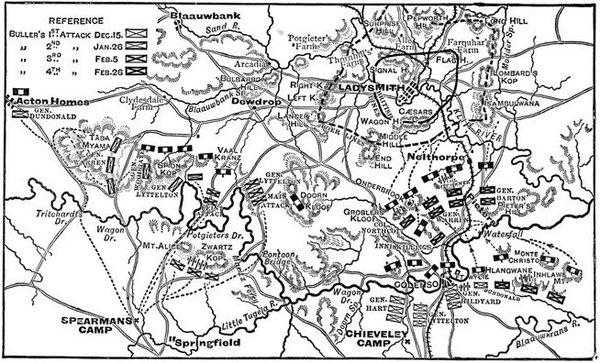
MAP SHOWING BULLER'S THREE UNSUCCESSFUL AND FINAL
SUCCESSFUL ATTEMPT TO DRIVE THE BOERS FROM THEIR POSITION ON THE
TUGELA.
The naval guns followed close on the heels of Barton, and took up a
position facing Colenso on the evening of the 12th. On December 13 they
opened fire on the Boer entrenchments at 7,200 yards, giving particular
attention to the two kopjes. No reply could be drawn from the enemy.
From time to time small groups of Boers were seen scattering as shells
fell, but except for this there was silence in their positions.
On the 14th Hildyard's, Lyttelton's, Hart's, and Dundonald's brigades
followed in the steps of Barton's, and encamped to the north of
Chieveley, in sight of Colenso. The naval guns advanced somewhat and
again bombarded the kopjes and Fort Wylie, at times also shelling a
laager which could be seen 10,000 yards away, on a ridge beyond the
river. Once more the Boers maintained absolute silence, and very few of
them were seen. The general impression was that they were falling back,
and that they did not intend to hold the line of the Tugela.
[Pg 87]
Dec. 14, 1899.] Preparations for the Great
Battle.
Buller determines to attack.
That evening General Buller determined to force the passage of the
river with all his troops on the 15th. The mounted troops under
Dundonald were to occupy Hlangwane Hill, covered by the 7th Battery;
the English [Hildyard's] and Irish [Hart's] Brigades, supported by
artillery, to advance towards the river and endeavour to cross by the
fords, Hart's Brigade by the Bridle Drift, above Colenso, Hildyard's by
the main ford close to the iron railway bridge. The 7th Battery was,
if possible, to take up a position on Hlangwane Hill so as to enfilade
the enemy's position. Barton's Brigade was to take ground between
Hildyard's and Dundonald's, Lyttelton's between Hildyard's in the
British centre and Hart's on the British left, ready to support either.
The naval 4·7's and four of the 12-pounders, under Captain Jones of
H.M.S. Forte, took up a position on the top of an eminence two miles
from Colenso, prepared to set to work when the advance began.
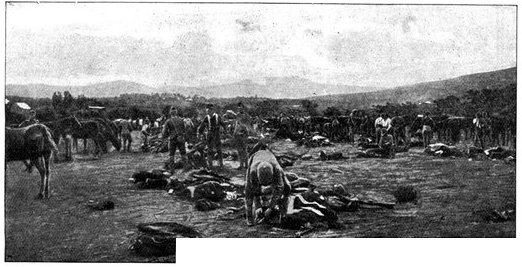
THORNEYCROFT'S MOUNTED INFANTRY PACKING KIT AT MOOI
RIVER CAMP, BEFORE GOING INTO ACTION.
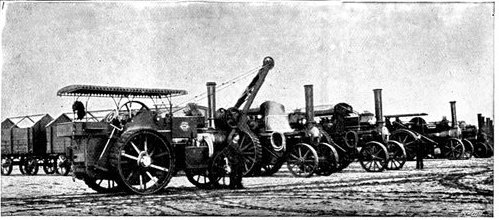
STEAM ROAD LOCOMOTIVES USED BY THE BRITISH GENERALS IN
SOUTH AFRICA TO BRING UP SUPPLIES.
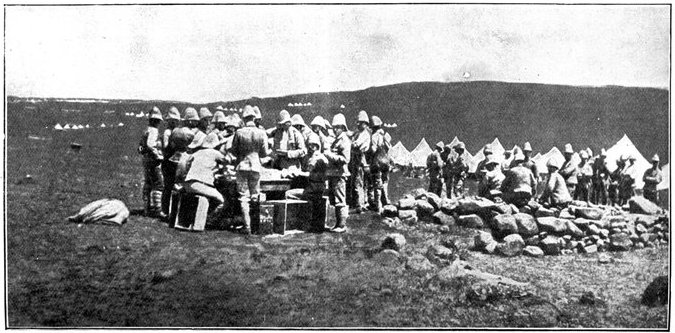
[Photo by Lieut. Crawford.
LETTERS FROM HOME: DISTRIBUTING THE BRITISH MAIL IN CAMP.
[Pg 88]
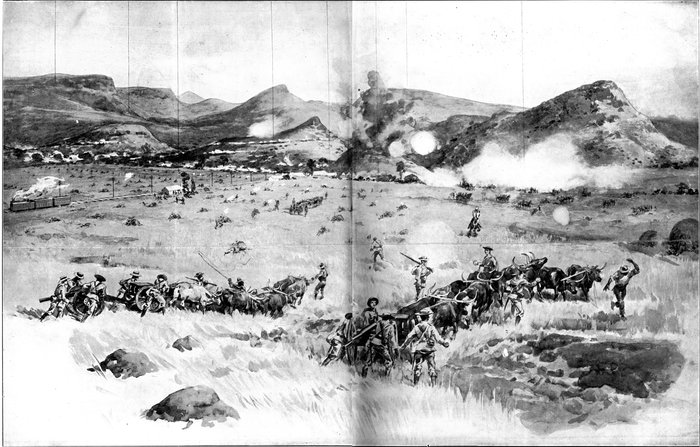
PANORAMA OF THE BATTLE OF COLENSO.
[From a Sketch by Capt. W. S. Carey.
This picture includes about 2½ miles of the river, which divided the
contending armies. It is taken from behind the British positions,
looking almost due north towards Ladysmith, which lies behind the hills
a little to the left of the centre. In the foreground are the 4·7-inch
naval guns being brought into position by ox-teams. To the left is an
armoured train, and in the extreme right a portion of a Kaffir kraal.
[Pg 89]
[Pg 90]
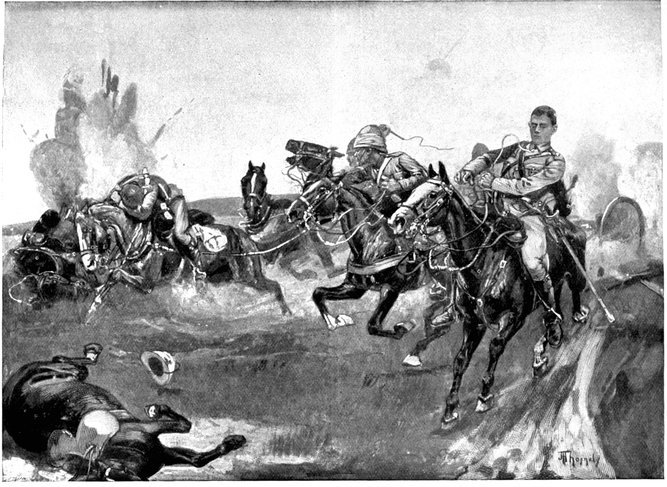
DEATH OF LIEUTENANT ROBERTS, ONLY SON OF FIELD-MARSHAL
LORD ROBERTS OF KANDAHAR, IN AN ATTEMPT TO RECOVER THE ABANDONED GUNS
AT COLENSO.
Lieut. Roberts is seen on the extreme right of the picture. He fell
mortally wounded; Capt. Congreve returned to his assistance, and
brought him in.
CHAPTER VI.
THE FIRST BATTLE OF COLENSO.
The battle begins—Bombardment of Fort Wylie—Artillery
pushed forward—The Boers open fire—The guns
abandoned—General Hart's position—The Dublin
Fusiliers attempt to ford the Tugela—Their retirement
ordered—Failure to carry Hlangwane—Advance of
Hildyard's Brigade—General withdrawal ordered—Death
of Lieutenant Roberts—Guns and men captured by
the Boers—Retirement effected in good order—Our
losses—Scarcity of water—Bravery of the Army Medical
Corps—Impressions of an eye-witness—Armistice—A day
of blunders.
The battle begins.
Long before day broke the infantry began to move off in huge masses.
The men were in the best and highest of spirits, expecting easy
victory. To this cheerfulness the general opinion of the Staff that
the enemy were on the point of retreating contributed greatly.
Gradually the dense columns opened out into skirmishing order, and the
eagerly-looked-for day began to break, radiant, clear, intensely hot,
over the distant ridges of the Drakensberg.
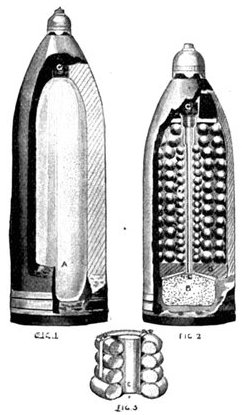
COMMON AND SHRAPNEL SHELLS.
Fig. 1 shows a "common shell;" on exploding, its fragments are hurled
in all directions, and if charged with a high explosive, such as
lyddite, the mere concussion caused by the release of the gases will
cause death at a considerable distance. Shrapnel shell (Fig. 2) is
filled with metal balls, which, on the explosion of the charge of
powder, B, are flung forward in the face of the enemy. Fig. 3
represents the cartridge, of cordite, used in howitzers. Both shells
are here shown with fuses attached, which may be arranged to fire the
charge either after the lapse of a given number of seconds, or on
impact. The fuse communicates with the charge through the channel,
C.
Bombardment of Fort Wylie.
Dec. 15, 1899.] Opening of the Battle.
The crash of the naval 12-pounders, opening fire on Fort Wylie at
4,000 yards, began the battle at 4·45. They fired slowly till the day
grew higher and all preparations were completed, when they poured in
a terrific storm of shells and shrapnel. On their right the 14th and
66th Field Batteries and six naval 12-pounders under Colonel Long
took up the bombardment. There[Pg 91] was still no sign of life from the
long, indistinct lines of Boer entrenchments, flickering through the
heat-mist which rose under the burning sun from the parched ground. Far
away and well out of range a few small groups of Boers could be made
out through field-glasses, apparently watching the British artillery
fire. So complete was the silence of the enemy that the conjecture that
the position had been abandoned became almost a conviction.
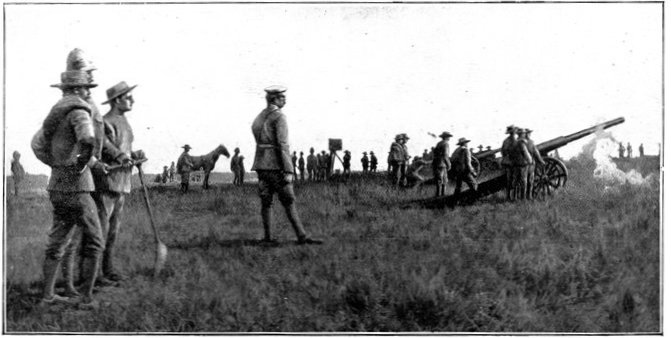
[Photo by the Biograph Company.
GENERAL BULLER WITNESSING THE FIRING OF THE NAVAL GUNS IN THE BATTLE OF
COLENSO.
Artillery pushed forward.
The Boers open fire.
[Dec. 15, 1899.
At this point, Colonel Long, with the artillery in the centre,
determined to push closer in, where his 15-pounder field guns could
fire with better effect, though he had received orders to keep his two
batteries under cover of Barton's brigade, and only to use the naval
12-pounders at long range. He was, it would seem, fully under the
impression that the enemy had retired, and refused to listen to the
entreaties of one or two junior officers, who dreaded some trick on the
part of the Boers. He was confirmed in this impression by two scouts
whom he sent forward. One rode close up to the river bank; the other
actually set foot on the road bridge without seeing a single enemy.
This was a carefully calculated ruse of the Boers, and it succeeded.
Confidently, Colonel Long directed the 14th and 66th Field Batteries
and six naval guns under Lieutenant James to advance to a point barely
800 yards from the Tugela and 1,200 yards from Fort Wylie, crossing
on the way two dongas. This position was more than a mile in front of
the slowly advancing infantry of Hildyard's brigade. The two batteries
galloped forward, outstripping their infantry escort; the naval guns
followed more slowly, when suddenly a single shot rang out from one of
the hills behind Colenso. It was the signal for the Boers to open fire.
Instantly the whole northern bank of the river broke into flame with a
fearful crackling and spluttering, above which could be heard the loud
and heavy hammering of the Boer 1-pounder automatic guns. A deluge of
projectiles from rifle, cannon, and machine gun descended upon Colonel
Long's artillery. The gunners faced the storm with stubborn heroism,
neither flinching from their work nor showing any undue haste. The
guns were calmly unlimbered, picked up the range, and then opened fire
on Fort Wylie. Two of the naval 12-pounders had crossed the rearmost
donga, but all the oxen dragging these were in a moment killed or
stampeded by the Boer fire, and the sailors had, perhaps luckily for
them, to drag the weapons back to the other four 12-pounders, which
now unlimbered and opened from a position considerably to the rear
of Colonel Long's batteries. The great 4·7's, far behind, gave all
the aid they could in beating down the fire of Fort Wylie. The Boer
works, at this point, were wreathed[Pg 92] in one continuous cloud of smoke
from the bursting shells. With the dense green fumes which the lyddite
projectiles scattered as they exploded, it seemed as though the hill
had broken bodily into flame and was being consumed by subterranean
fires. Yet in the midst of this cyclone of death the Boer gunners,
behind their earthworks, worked their guns as steadfastly as the
British gunners. The latter, unhappily, stood in the open space before
Colenso with half-a-mile of smooth open ground behind them—a splendid
target at close range.
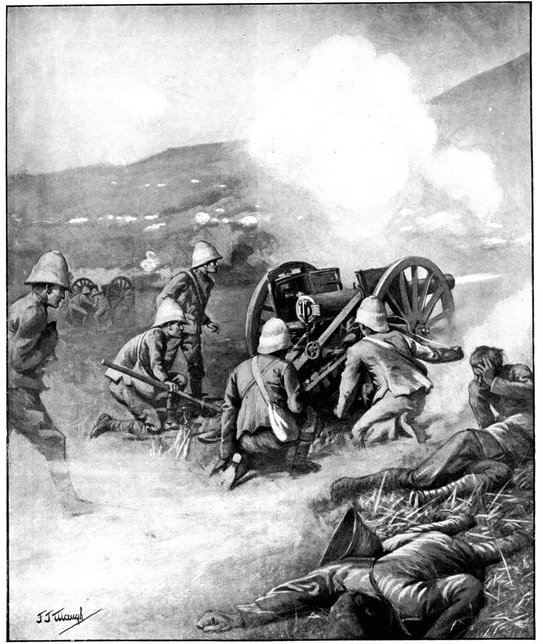
No. 5 GUN OF THE 14th BATTERY IN ACTION AT COLENSO.
Two men continued to serve this gun after all their comrades had been
shot down. Finally they also were killed, and the gun was left standing
alone.
[Pg 93]
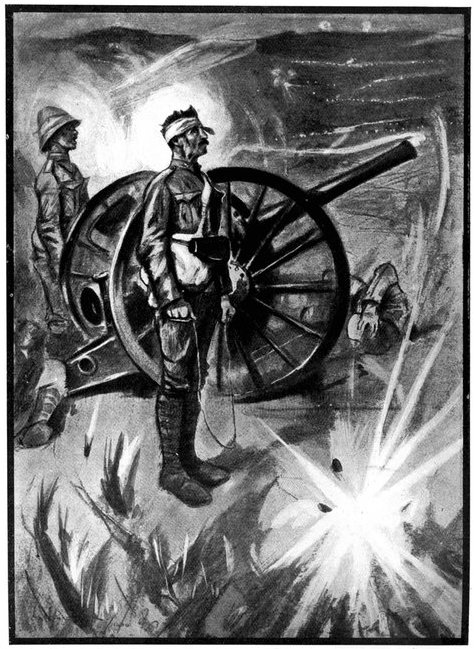
FACING DEATH: THE LAST TWO GUNNERS OF THE 14th BATTERY.
Dec. 15, 1899.] Hopeless Situation of the Two
Batteries.
And now on all sides the fight grew furious. Far away on Grobler's
Kloof, and on Red Hill, invisible cannon were booming, while from Red
Hill to Hlangwane invisible marksmen were raining death upon their
assailants. The greatest difficulty with which the British had to
contend was that there was no enemy to be seen, no clear target to fire
at. The dancing blaze of the Boer Mausers was unaccompanied by smoke,
and gave no object for the sights of rifle or field gun. The Boers
themselves lay perdu in deep entrenchments, firing in almost complete
security through loop-holes. Their most advanced position in the scrub
near Colenso, not 300 yards from Colonel Long's guns, was hidden by the
undergrowth.
The guns abandoned.
[Dec. 15, 1899.
The two British batteries before Colenso were in an utterly hopeless
situation. In a few minutes, most of their horses, two-thirds of their
men, Captains Goldie and Schrieber, and Colonel Long himself, had
fallen dead or wounded. Help was sent for to keep down the enemy's
rifle fire, but help did not come. Colonel Long, shot through the arm
and liver, was urged to abandon the guns, but firmly refused, replying,
"Abandon, be damned! we never abandon guns!" Yet the fury of the
enemy's fire at last drove the survivors back to the nearest donga.
There they remained, from time to time rushing forward, when there came
a lull in the hail of bullets, to re-open fire. The pitiless storm,
however, would always again descend. The diminished detachments caught
by its fury would fall to the ground, swept from their feet by the
blast of death. Yet so long as there was ammunition in the limbers, one
of the twelve pieces continued to fire at intervals, till at last only
two men were left. One bowed his head and suddenly fell forward prone
upon his gun, the other, the last survivor, turned, and disdaining
flight, was walking slowly back as if on parade to the donga in the
rear, when a bullet struck him, and he, too, was numbered among the
lost. Thus did the gunners of the Royal Artillery answer the call of
duty. In the donga behind the guns crouched or lay a few unwounded and
a large number of wounded, among them Colonel Long, now delirious, and
ever repeating in words of agony and admiration, "Ah! my gunners! My
gunners are splendid! Look at them!" Over the donga swept the hail of
lead and shrapnel, and it was death to show the head above it. Behind
it stretched the smooth level slope, devoid[Pg 94] of cover, swept by the
enemy's fire, and across this it was almost impossible to send the
much-needed aid.
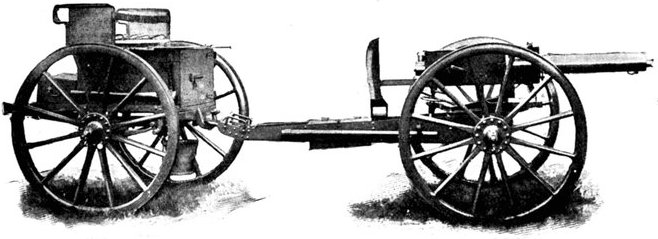
THE VICKERS-MAXIM 1-POUNDER.
Used by the Boers, and variously called by our men "Pom-pom" and
"Ten-a-penny."
The naval 12-pounders had, as we have seen, taken up a position 400
yards to the rear of the doomed field batteries. Here, almost without
support, they kept up a steady fire, and, wonderful to relate, lost
only four men wounded. There were many narrow escapes. The little
1-pounder shells from "Pom-Pom," the automatic Maxim, fairly rained
about the guns. Three passed between the legs of Lieutenant Ogilvy,
R.N., while he was watching the effect of his fire through his glasses,
yet did not harm him.
General Hart's position.
While these things were happening in the centre, on the left and
right the attack had been equally unsuccessful. On the left General
Hart advanced in column, with two field batteries, toward the drift.
Soon after six the enemy suddenly opened upon the brigade, which was
still marching in close order, with shell and shrapnel. The brunt of
this artillery fire was borne by the Dublin Fusiliers and Connaught
Rangers, who sustained heavy losses. A 45-pounder on Grobler's Kloof,
another of the same calibre on Red Hill, and several smaller guns fired
steadily at them, and the two field batteries seemed unable to effect
much against these weapons. The range was too great, and there was,
moreover, difficulty in locating them. The strident crash of the Maxims
in the enemy's lines was not the least unnerving of the dangers which
had to be faced.
But at length the British troops deployed and advanced in open order,
company by company, in desperate rushes towards the ford. The nearer
they drew the hotter became the enemy's fire, till it was wonderful
to observers that any human being could live in it. And still the
enemy was invisible, and the British troops had nothing to fire at.
Men sobbed with rage at the fact that they were so helpless. The two
field batteries, far too few for the work, could produce no impression
whatever upon the dimly-seen Boer trenches, within which the enemy lay
in almost perfect security, and the Boer guns left them alone, as if in
derision, devoting all their energy to the advancing line of soldiery.
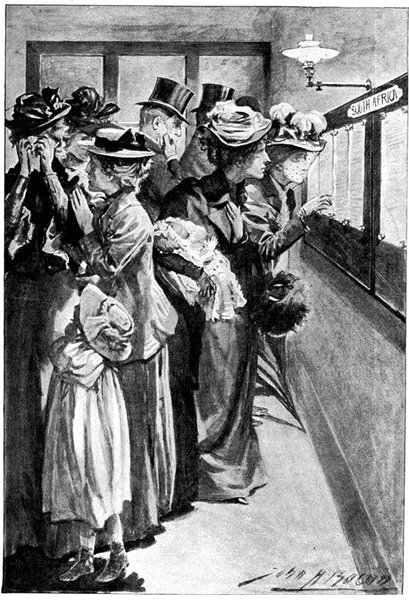
J. H. Bacon.] [
Sketched from life.
THE CASUALTY LIST AT THE WAR OFFICE.
From the earliest days of the war, drawn, white faces anxiously
examined the lists of killed and wounded posted up at the War Office in
Pall Mall. Perhaps the most moving scenes witnessed here followed the
announcement that the Grenadier Guards—many of them London men—had
been in action and lost heavily at Belmont, November 23.
Dec. 15, 1899.] The Dash Across the River.
The Dublin Fusiliers attempt to ford the Tugela.
At last the Dublin Fusiliers reached the ford and attempted to cross.
But the Boers had dammed the river, and in place of three feet of water
there were seven. Yet, burning with enthusiasm and with determination
to get at[Pg 95] their enemies, a number of men plunged boldly in. Several
were carried down by their heavy rifles and cartridges; others were
caught by the barbed wire which the Boers had placed in the stream.
Only a handful reached the other side, climbed the steep bank, and, led
by a colour-sergeant who had been first up the hill at Elandslaagte,
with the words, "Let's make a name for ourselves and die!" doubled
forwards towards a kraal, a little way beyond the river. Among them
was the heroic Bugler Dunne, a mere boy, who on this day displayed the
most devoted valour. In the advance upon the kraal one by one the men
dropped wounded; no one reached it but the sergeant. Alone he could
do nothing; so he turned and fled unharmed, crossed the river, and
regained his battalion.
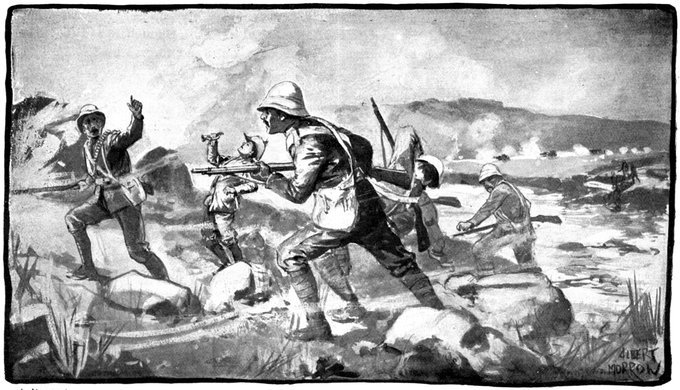
A. Morrow.]
"LET'S MAKE A NAME FOR OURSELVES AND DIE!": DASH OF THE DUBLINS ACROSS
THE TUGELA.

MAP OF THE BATTLE OF COLENSO.
Their retirement ordered.
[Dec. 15, 1899.
Failure to carry Hlangwane.
At this point came the order to retire. It was with the utmost
difficulty that the officers could persuade their men to fall back.
The enemy redoubled his fire; the big 45-pounders fired shrapnel and
shell with all possible rapidity; and it was not until the naval
4·7's were able to answer them with lyddite that they were held in
check. To disentangle the Irish Brigade and cover its withdrawal, half
Lyttelton's Brigade came to its help. Then both brigades, as they fell
back, moved to the centre to[Pg 96] support the final and desperate effort
of Hildyard to carry the Colenso ford. On the right also the attack
had failed. Dundonald's Brigade was at the base of Hlangwane about 5
a.m., and formed up for the attack. The stiffest work was assigned to
the Colonials, the South African Light Horse climbing the hill straight
towards the top, while the Composite Regiment and Thorneycroft's
Mounted Infantry worked round the spurs of the mountain on their right.
At first no sign of the enemy could be seen. As the roar of battle
rose from Colenso behind, the Light Horse breasted the steep slope.
It seemed as though the hill was as good as won, when a sharp fire
was opened from the summit, and simultaneously Thorneycroft's mounted
men were attacked by a large body of the enemy on their exposed right
flank. Now was the time to send in support from Dundonald's command or
Barton's Brigade, both near at hand; but no support came. Probably the
officers named had not received clear instructions; possibly the whole
attention of the Staff was riveted upon the guns in the centre. Be this
as it may, Thorneycroft was compelled to retire. Heavily outnumbered,
unable to see the enemy, exposed to every shot on the bare slopes of
the mountain, the men fell sullenly back with 136 killed and wounded.
The failure to carry Hlangwane made it practically impossible for the
Army to cross the Tugela.
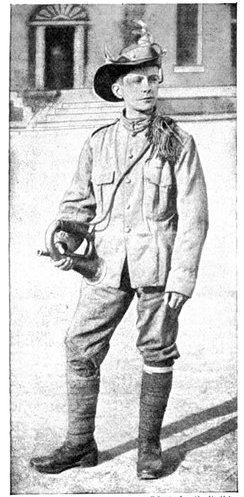
[Photo by S. Cribb.
BUGLER JOHN F. DUNNE
Bugler Dunne, of the Dublin Fusiliers, a lad of only fourteen, insisted
on accompanying the column in the advance on Colenso; and whilst in the
firing line was severely wounded in two places during the attempt to
force the passage of the Tugela. He was invalided home, and recovered
his health on the voyage. When he arrived in England he was received
with the greatest enthusiasm, and became the unwilling object of a
public ovation. He was presented to the Queen at Osborne, and as he had
lost his bugle in the Tugela, Her Majesty gave him a new one, with a
suitable inscription thereon. He is a native of the Isle of Man, and
his father and brother are both in the Army.
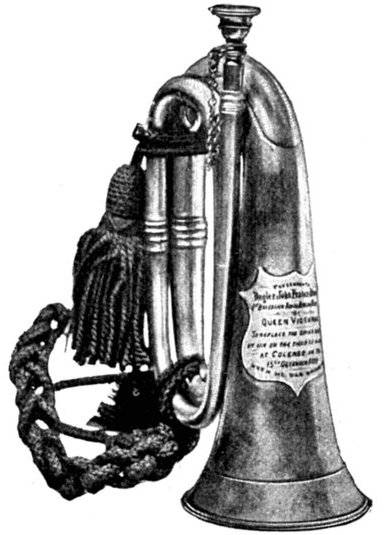
[Rudall, Carte & Co.
BUGLE PRESENTED TO BUGLER DUNNE BY HER MAJESTY TO REPLACE ONE LOST AT
COLENSO.
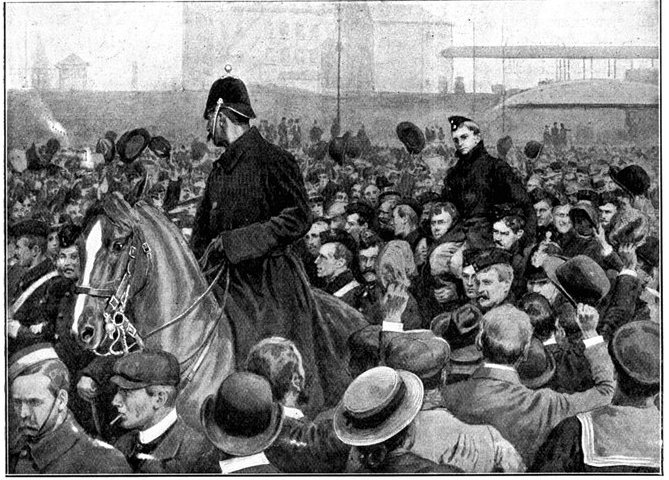
F. Dadd, R.I.] [After Photos, by S. Cribb.
THE CHAIRING OF BUGLER DUNNE AT PORTSMOUTH.
Advance of Hildyard's Brigade.
Dec. 15, 1899.] Hildyard's Brigade Ordered
Forward.
In the centre the battle still raged with unabated violence. Indeed,
as our men fell back on the left and right the enemy's fire in this
quarter grew in fury and intensity. The Boers' attention was no longer
diverted, and they were able to concentrate all their strength and
energy to meet Hildyard's assault. To have had any chance of success
it should have been made simultaneously with Hart's onset on the
left. Hart having failed, had it not been for the desperate position
of Colonel Long's guns close to the river and in the very centre of
the enemy's fire, a retreat would without[Pg 97] doubt have been the wisest
course. It should have been no part of the British plan to commit
our men to a profitless combat in which they could only be shot down
without effective reply. But though the plight of the twelve guns does
not seem as yet to have been known to the commander-in-chief, he sent
Hildyard forward.
Hildyard's Brigade, led by the Royal West Surreys and the Devons,
in superb array descended the gentle slopes which led down from the
British camp to the village of Colenso. There was no cover of any
kind, and the whole terrain over which they moved was swept at first
by the Boer cannon and automatic guns, and then, as our men drew
nearer, by the far deadlier rifles of the enemy. "With magnificent
hardihood both battalions walked erect," says Mr. Bennet Burleigh,
the Daily Telegraph correspondent. "With death filling the air and
tearing the ground, onward they went, the most superb spectacle of
invincible manhood. Common soldiers in stained, creased khaki uniforms,
homeliest of drab—they were heroes bound to command the admiration
of the world." From the extreme weakness of the British artillery it
was impossible to beat down the fire from the enemy's trenches near
Colenso. No guns were available, for the 14th and 66th Field Batteries
were out of action, and from the lie of the ground the naval weapons,
which alone remained in this portion of the field, were unable to
direct their projectiles upon the enemy. Yet in spite of the fact that
their onset was virtually unsupported the West Surreys forced their way
into the brushwood around Colenso, and even reached the outskirts of
the village. A tremendous roar of firing came up from the hollow; then
the Boers were seen from the naval 4·7 battery to stream out of Colenso
and swarm up the slopes of Fort Wylie. The naval guns, however, lost
their opportunity, since at that distance the swarm of fugitives was
taken for British soldiers assaulting.
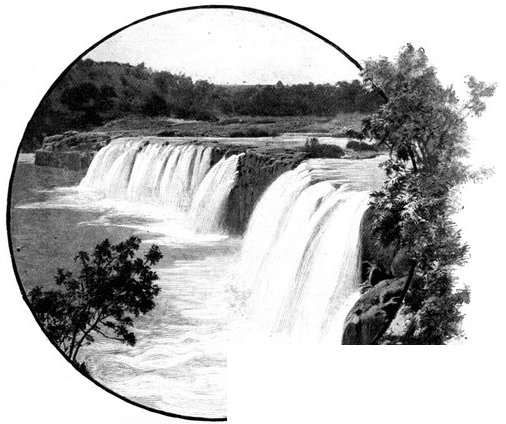
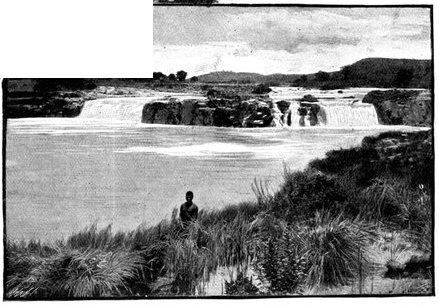
Photos by G. W. Wilson & Co., Aberdeen.]
THE FALLS OF THE TUGELA.
These two falls are about a couple of miles apart, and lie a little
below Fort Wylie, and quite close to the scene of the great battle.
[Dec. 15, 1899.
At this point, when the troops were in a good position for crossing
the river and assaulting Fort Wylie, General Buller at last heard of
the catastrophe to the two field batteries. It was[Pg 98] represented to
him as even worse than it really was, since the six naval 12-pounders
were said to have been silenced with Colonel Long's guns. The terrible
news that the artillery, which he so urgently needed and upon which he
had relied to cover the final rush of the stormers, had been thrown
away may well have staggered the general. Without the support of guns
he considered that Fort Wylie could not be taken. There seemed to be
nothing left but a withdrawal, and a withdrawal was ordered, though the
Colonel of the Surreys begged to be allowed to attempt the rescue of
the lost guns and to be permitted to hold Colenso till nightfall.
While the Surreys were drawing off attention in the direction of
Colenso two companies of Devons had crossed the railway and had gone
to the help of the field guns. They were supported by two companies of
Scots Fusiliers from Barton's brigade. But this half battalion could
effect little or nothing. It was forced to take shelter in the donga
behind the guns, whence it fired steadily at the Boer trenches some
hundreds of yards away.

S. T. Dadd.]
BRINGING OUT AN AMMUNITION WAGGON UNDER HEAVY FIRE AT COLENSO.
To see what could be done, and in response to urgent messages for help
from Colonel Long, about 9·30 General Buller with General Clery and
their Staff rode down to the guns under a terrific fire. "Out of this,
please," he said to the naval 12-pounders which had fought so bravely
and with so much constancy behind the dongas, and these guns were moved
back by the bluejackets, but only with the greatest difficulty. No less
than 32 of the oxen which dragged them had been shot, and the black
drivers had all bolted. An ammunition waggon had perforce to be left
behind for the moment, but even it was not finally abandoned. A heroic
Natal farmer named Pringle went out alone with a team of slow-moving
oxen, deliberately inspanned them under fire, and withdrew the waggon.
It now remained, if possible, to save the twelve field guns, 400 yards
or more to the front in the very vortex of a storm of shot and shell
which broke over them all the more fiercely as the Boers realised what
was purposed.
[Pg 99]
Dec. 15, 1899.] Victoria Cross Heroes.
Death of Lieutenant Roberts.
Into this hell rode Lieutenant Roberts, only son of the Field-Marshal,
an officer of infinite promise, Captain Schofield, and Captain
Congreve. With fresh teams of horses they strove to limber up the guns,
but under the tempest of death men and horses were swiftly swept away.
Roberts fell stricken with five bullets, mortally wounded. Congreve's
tunic was torn to shreds by bullets, and he himself was wounded.
Schofield alone seemed to bear a charmed life, and though six bullets
passed through his clothes he came off without a scratch, and succeeded
in getting away two guns of the 66th Battery. All this while General
Buller had sat cool and determined upon his horse, eating sandwiches
under the terrible fire. He himself was struck by a spent bullet, which
coursed round his ribs without inflicting a serious wound. Captain
Hughes, his staff doctor, was blown to pieces by a shell which burst
amongst the group; Lord Gerard, one of his aide-de-camps, had his horse
shot through the neck; and several of the Natal Police, acting as
escort, had their horses grazed or wounded, and themselves had bullets
through their clothes. Three teams of horses were brought up from the
7th Field Battery under Captain Reed, and plunged into the inferno. One
team was harnessed to an ammunition waggon, but before they could move
were almost all shot, and Reed himself was wounded. There was nothing
for it but to abandon the other ten guns and order a general retreat.
THE FOUR COLENSO V.C.'s.
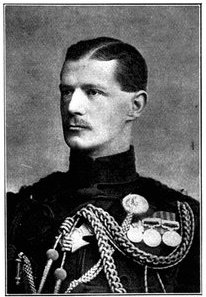
[Photo by Chancellor, Dublin.
THE LATE LIEUT. ROBERTS,
V.C.
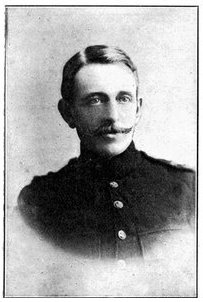
[Photo by Knight, Aldershot.
CAPT. CONGREVE,
V.C.
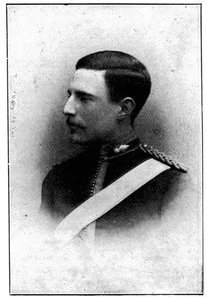
[Photo by Chancellor, Dublin.
CAPT. REED,
V.C.
The Victoria Crosses so gallantly won were presented to Capt. Reed
and Corporal Nurse by General Buller, at Ladysmith, on March 18, at a
special parade of the troops held for the purpose.
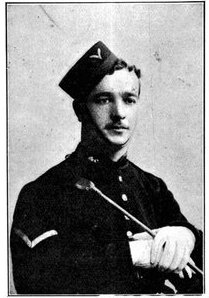
[Photo by Hawke, Plymouth.
CORPORAL NURSE,
V.C.
Corporal Nurse obtained his Cross for assisting his superior officers
in the attempt to save the guns. Capt. Schofield was not awarded the
decoration solely because he acted under orders.
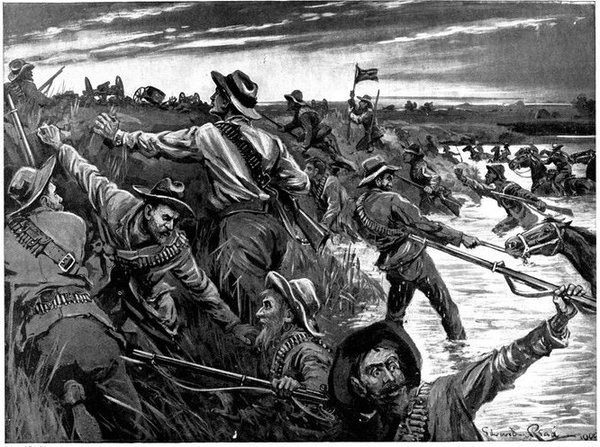
Edward Read.]
THE BOERS CROSSING THE TUGELA TO CAPTURE THE BRITISH GUNS.

[From the Painting by Therese Schwartze.
OUR GALLANT FOEMAN: THE LATE GENERAL JOUBERT.
Piet Joubert, Commandant-General of the Boer forces, died at Pretoria
on March 27, 1900. He was of Huguenot descent. Sir George White has
spoken of him as "a soldier and a gentleman, a brave and honourable
opponent," and Lord Roberts telegraphed his respectful sympathy to the
family of the distinguished General, "whose personal gallantry was
only surpassed by his humane conduct and chivalrous bearing under all
circumstances." The captive British officers in Pretoria sent wreaths
for his coffin.
Guns and men captured by the Boers.
[Dec. 15, 1899.
Even now it would have been possible, in the opinion of some, to
withdraw the British infantry out of range of the Boer rifles and
entrench a force in a position 1,000 yards or so away from the guns,
when any attempt on the part of the enemy to cross the river could
have been defeated. If the naval guns on the crest of the ridge above
Colenso had kept their place and supported this force it would have
been practically impossible for the Boers to get near the guns, and
the weapons could have been withdrawn under cover of night. As it was
the Staff forgot to give orders to the Devons and Scots Fusiliers in
the donga to retire, and the men remained there till evening, when
the Boers boldly crossed the stream, captured the ten [Pg 100]
[Pg 101]
[Pg 102]guns, and
surrounded the men in the donga, making treacherous use, it is said,
of the white flag. The ten guns had not been in any way disabled, as
the gunners had expected to be able to return and serve them. The
breech-blocks had not been carried off, and it would appear that in
spite of the complaints of shortness of ammunition a large quantity of
British shrapnel and cartridges was taken by the enemy—probably in the
ammunition waggons to the rear of the guns.
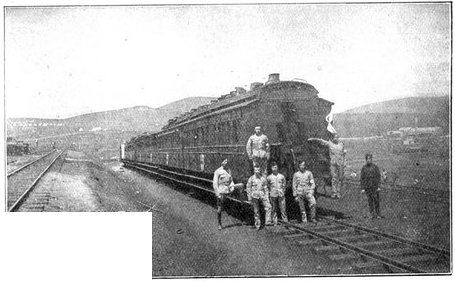
No. 1 FIELD HOSPITAL TRAIN AND STAFF.
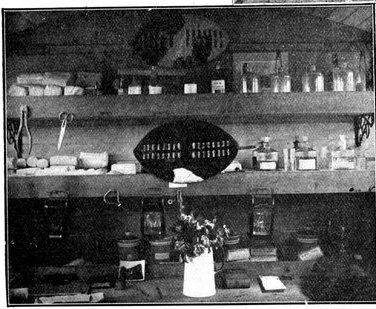
THE DISPENSARY AND SURGERY OF THE HOSPITAL TRAIN.
Only two officers are known to have escaped unhurt from "the donga of
death." These were Captains Herbert and Fitzpatrick. Before they made
their desperate attempt they shook hands with each other and with those
who were left unwounded. Then Captain Herbert dashed out and got away
unwounded, but with his horse shot in the neck. Captain Fitzpatrick
followed at full speed, and he too reached safety. A third officer had
only covered a few yards when a shell burst under him and killed him
and his horse instantly.
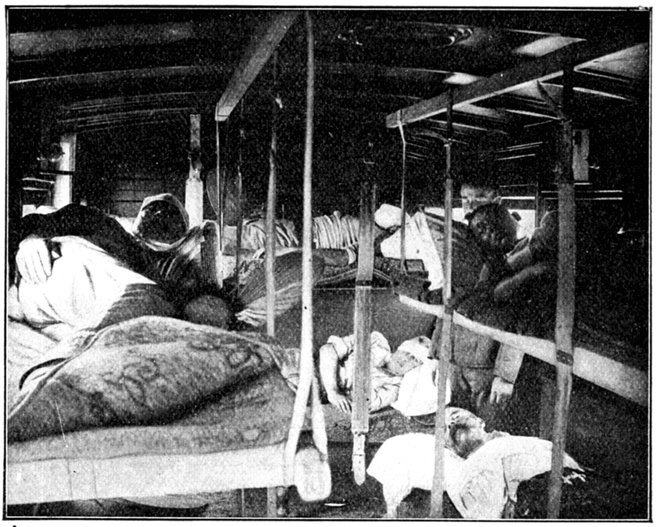
INTERIOR OF HOSPITAL TRAIN.
Retreat effected in good order.
Dec. 15, 1899.] The British Losses.
And now in all directions the British troops were falling back from
the field of battle and disaster. It was a scene, says one who was
present, "that can never be forgotten by those who were privileged to
see it. Slowly, steadily, with correct intervals, as if on parade, only
better, our magnificent infantry fell back; no doubling, no bunching
together, they stood within 500 yards of the Boer position. Here was
no romance of war, no charging of battalions amid a storm of cheers,
nothing to brace up the spirits to one glorious effort in which danger
is forgotten; nothing but the stream of bullets and shells. From our
position I could plainly see the thin dust-coloured lines retiring.
Presently, clank, clank from the Maxim-Nordenfelt and a group of men
would fall; again an officer might be seen walking slowly in rear of
his company; you looked again, and a speck of khaki was all that could
be seen. The use of smokeless powder has added greatly to the horrors
of[Pg 103] war; this was the strange thing about the battle of Colenso, the
utter absence of smoke, and the clearness with which each incident
could be seen. At last, covered by the Cavalry Brigade and the 7th
Battery, the wearied infantry returned. Twelve hours' fighting in
the burning sun, losses over 1,200—not so bad for our boy soldiers.
Absolutely undefeated, unshaken by what they had passed through, our
magnificent infantry at last could rest."
Not so much with the Commander-in-Chief as with his impetuous
subordinates rested the blame for this disastrous day. The entanglement
of the guns it was which had the greatest part in piling up the British
losses and converting what was almost a success into a humiliating
defeat. Had the British artillery been stronger, even this rash move
might not have proved so calamitous as it ultimately was. Forty guns
might have beaten down the Boer fire, which twelve guns were utterly
unable to check.
Our losses.
The total British losses were 132 killed, 765 wounded, and 228 missing
or prisoners; a total of 1,125. The heaviest sufferers were the two
field batteries—the 14th losing 50 and the 66th Battery 42 men, out of
a probable total present in each case of 140 men. The Dublin Fusiliers
lost 218 men out of about 1,000. As the force actually engaged did
not number more than 15,000, when all deductions had been made, the
casualties were a high percentage. The loss in killed was unusually
small, and a very great number of the wounded were only very slightly
injured—for the most part shot in the foot. As to the enemy's losses
it was impossible to speak with any accuracy. Very few Boers were seen
during the fighting, and it would appear that at the outside 200 or 250
were killed and wounded, mainly by the British artillery fire. Thus our
troops suffered heavily without inflicting serious casualties upon the
enemy.
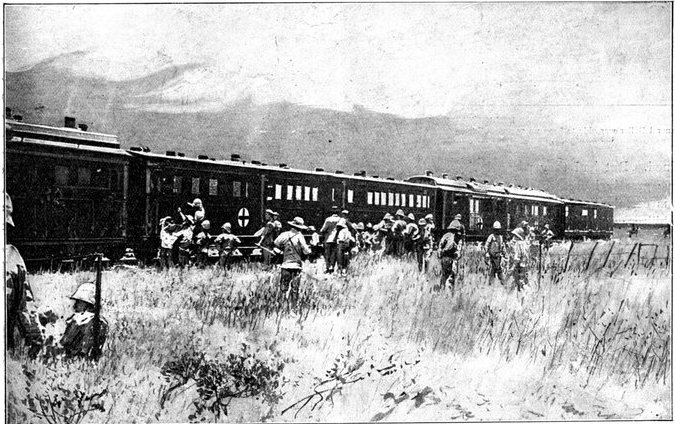
[Photo by Major Brazier-Creagh, R.A.M.C.
THE FIELD HOSPITAL TRAIN AT THE BATTLE OF COLENSO.
[Dec. 15, 1899.
It is noteworthy that in the fighting no estimate whatever could be
arrived at as to the Boers' strength. Whether they numbered 10,000,
15,000, or 20,000, no one knew, and no one could even guess. It was
evident that the trenches and the position generally were very strongly
held. The ranges are believed to have been carefully measured, and wire
entanglements had been constructed close to the enemy's works, so that
storming them would have been a matter of exceptional difficulty, even
without the swift and deep river as a further obstacle in their front.
It does not appear that[Pg 104] the Boers weakened their force surrounding
Ladysmith during the action. The garrison there probably did not expect
a battle, and so made no move.
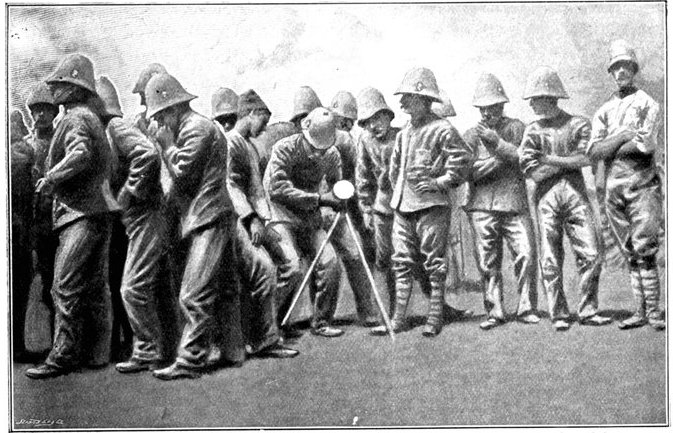
[Photo by the Biograph Company.
HELIOGRAPHING INTO LADYSMITH.
General Buller was able to keep up communication with Ladysmith,
as Lord Methuen was with Kimberley, by means of the heliograph, an
apparatus for reflecting sunlight in flashes indicating letters and
words.
As serious as the loss of over a thousand men in the none-too-strong
relief column was the loss of ten guns. This reduced Sir Redvers
Buller's available artillery to the contemptible total of twenty field
pieces. It is wonderful that the Boers made no attempt whatever to
follow up their victory; instead, they seemed perfectly satisfied with
the results that had been obtained. But had they pressed vigorously
upon the British flanks during the retirement, they might have greatly
increased the casualties in our ranks, and, perhaps, have converted
defeat into catastrophe. It is certain that they were strong enough to
do this had they been well directed, and their own mobility was such
that they could have had no fear of any untoward consequences resulting
to themselves from such a course of action.
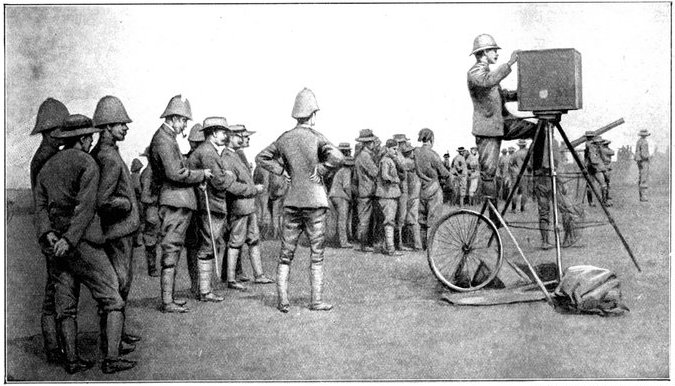
[Photo by the Biograph Company.
A NOVEL FEATURE OF THE BATTLEFIELD: THE BIOGRAPH CAMERA IN OPERATION
DURING THE BATTLE OF COLENSO.
[Pg 105]

FIRST AID TO THE WOUNDED: THE ARMY MEDICAL CORPS AT WORK
UNDER A HEAVY FIRE AT COLENSO.
Dec. 15, 1899.] Conduct of the Wounded.
Scarcity of water.
The day was fiercely hot and water was scarce, which greatly increased
the sufferings of the British troops. The wounded, especially, had to
endure terrible agony under the scorching sun, yet the demeanour of
the men was above all praise. None complained; few uttered a groan;
they faced pain with a heroic stoicism. A man who was shot through
the abdomen had a cup of water brought to him by an orderly as he lay
writhing with parched mouth. "Take it to my pal first," he said, "he is
worse hit than me." It was the spirit of Sir Philip Sidney. A drummer
boy of fourteen sat, with his left arm shattered, on the ambulance,
eating a biscuit. Admiring his bravery and endurance, an officer went
up to him and gave him half-a-crown. "Thank you," said the lad, "but
would you mind putting it in my pocket, as I mustn't let go of my
biscuit." Thus were the sublime and the ridiculous blended around those
sorrowful tents to which the stricken painfully pilgrimaged from all
parts of the field. Some limped in as best they could; others were
borne on stretchers; all, as they arrived, were given food.
Bravery of the Army Medical Corps.
[Dec. 15, 1899
Within the tents the surgeons plied their work of merciful cruelty.
"Each of the three operating tents," says Sir William McCormac,
"contained two operating tables, and as fast as a patient was taken
off the table another took his place. Awaiting their turn, the wounded
were lying outside in rows, which were being continually augmented by
the civilian bearers coming in from the field. As each wounded man
reached the hospital he was served with a hot cup of Bovril, large cans
of which were boiling outside the tents. The way in which the wounded
had been dressed on the field, and each man ticketed with the nature of
his wound, his name, and regiment, was excellent, and was very useful
for identification. This also saved much time at the field hospitals,
because the seriously wounded could be at once discriminated[Pg 106] from the
more trivial cases.... The praise of the regimental officers and men in
respect to the way in which the Royal Army Medical Corps had done their
duty under heavy fire was unanimous and unstinted. An officer of the
Devons, wounded in the foot, told me that he managed to get to a hut
near the bank of the river, which was being used as a dressing station.
This hut was continually under heavy fire, and he described the
behaviour of the medical officers as magnificent.... The work performed
in the operating tents was, in my opinion, of great efficiency, the
operations being deliberately carried out with skill and despatch under
the very trying circumstances of intense heat, hurry, and excitement
all round. The Royal Army Medical Corps officers of these hospitals had
started their surgical work about 3 a.m., and when I visited them in
the evening they were still hard at it, having had no food meanwhile
and no time for rest, and the work went on for hours afterwards.
Altogether some 800 patients passed through the field hospitals during
the day. The men showed the utmost pluck and endurance."
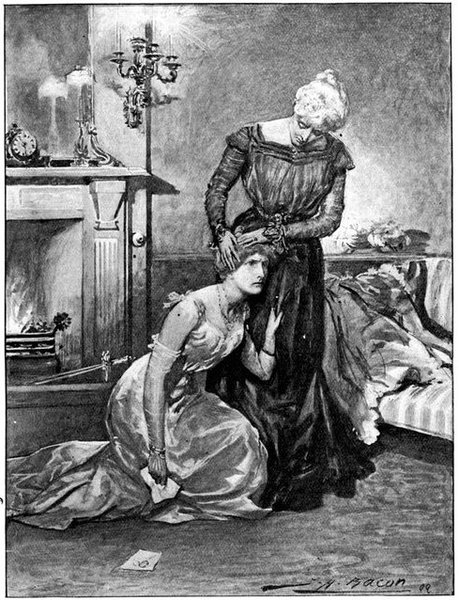
THE FATAL TELEGRAM: "KILLED IN ACTION."
And yet in the midst of the scene of suffering and sorrow one thing
consoles the heart. Why was it that these men faced these frightful
conditions and endured the rain of bullets and shrapnel and shell
splinters? Was it not because of their faith in those unseen things for
which the Christian martyr of old laid down his life? The martyr died
for God; these men were ready to endure all things for duty and for
their country. Of such motives the Englishman rarely speaks. Yet in the
heart of the nation "there is an instinctive recognition that a man's
part is not to shirk the hardships or escape from the sorrows of life."
It was this recognition that had brought thousands of men—"duke's son,
cook's son, son of a belted earl"—of their own free will thousands of
miles across the sea to lay down their lives in the flower of their age.
Impressions of an eye-witness.
Dec. 15, 1899.] Our Wounded Well-treated by the
Boers.
The impression produced upon spectators by the fight is thus described
by one who was present, not as a correspondent or combatant. "X and
I," he writes, "were present through that massacre of our poor brave
troops and volunteers at Colenso on Friday; on the battlefield, within
the lines actually. Shells burst within a thousand yards of us. We
saw the dead and wounded carried away till cart after cart was full
to heartbreaking overflowing. The wonderful artillery practice and
the roar and rattle of rifles, Hotchkiss, Maxims, and cannon, up to
the great earth-rending lyddite death-dealers, kept us in a state of
excited enthusiasm. X had nightmare, as you may imagine, that night,
and details of the scenes we witnessed[Pg 107] must have been sickening enough
reading for you. If this was only a 'reconnaissance in force,' what
must a battle be?... I often feel as if I were out of my mind, or in
some dream or other state, for it is all bewildering and stupefying,
and this intense heat in any case grievously affects me. No rain, no
cessation of its suffocating fury night or day. How can the troops
endure it?"
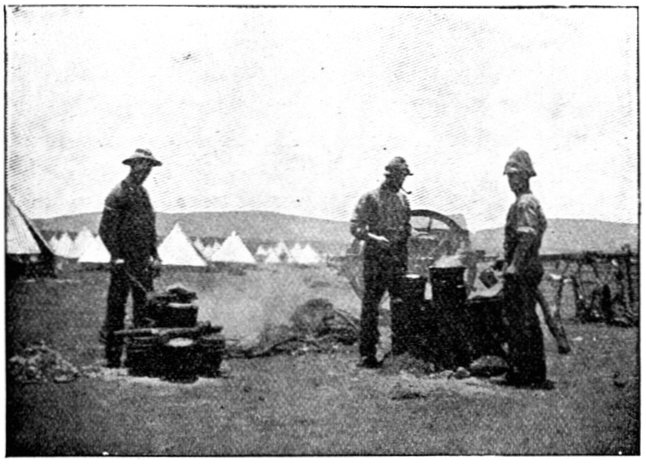
HOSPITAL COOKS PREPARING BEEF-TEA.
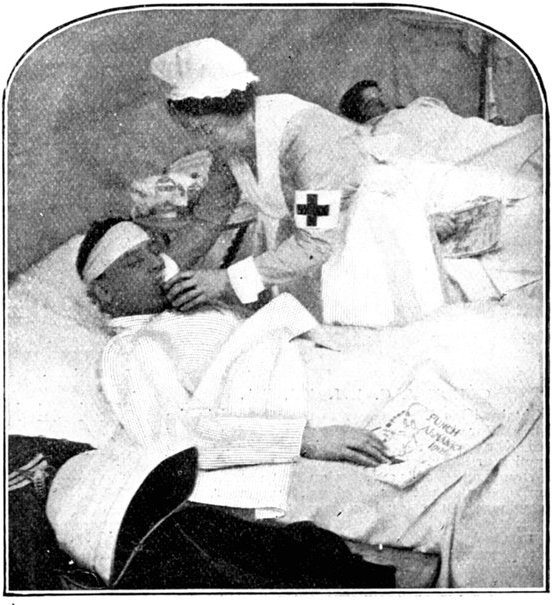
IN A FIELD HOSPITAL ON THE TUGELA RIVER.
That night the defeated general telegraphed to the Home Government
a brief and manly account of the unlucky day. He neither minimised
nor exaggerated the disaster. He has been censured for opening his
melancholy dispatch with the words, "I regret to report serious
reverse;" but if this was not a "serious reverse" speech has no
meaning. It was a matter of absolute necessity to give the authorities
at home true and exact information as to the situation, that they might
be able to gauge correctly the measures necessary to meet the danger.
Not General Buller for making this report, but the home authorities,
for publishing it, must be blamed, if there is to be any blame.
Armistice.
Thus checked, the General next day obtained an armistice for the
purpose of burying the dead and recovering any of the wounded who might
have escaped notice. The dead were found to have been stripped of their
clothes by the Boers, who were short of clothing themselves, though
the wounded near the enemy's lines on the previous day had been very
kindly treated and given water. They were deprived of their arms and
accoutrements, but were allowed by the enemy to be carried off by our
stretcher-bearers and ambulances, only the slightly wounded officers
being detained as prisoners.
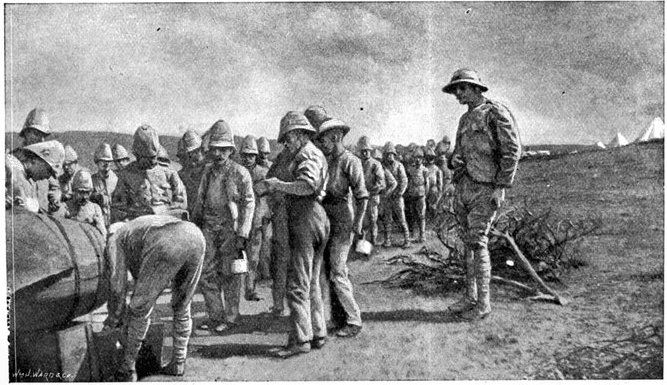
THIRSTY SOLDIERS TAKING THEIR TURN AT THE WATER-BARREL.
The scarcity of water is one of the great obstacles to the rapid
movement of troops in South Africa.
A day of blunders.
[Dec. 15, 1899.
The enemy throughout fought with great courage and determination,
but it must be remembered that they[Pg 108] had the advantage of strong
entrenchments. They displayed particular restraint and coolness in
sitting quiet under a tremendous bombardment, and in allowing General
Buller's men to advance to relatively close quarters before fire was
opened. What is wonderful is that the British Intelligence Department
in the field seems to have known very little of the enemy's disposition
and entrenchments. The day was a day of tragic blunders issuing in
great and unnecessary sacrifice of men. That the loss was not far
heavier is surprising in view of the intensity and volume of the
enemy's fire. The casualty list at least proved that the Boers were not
the marksmen they had been supposed to be.
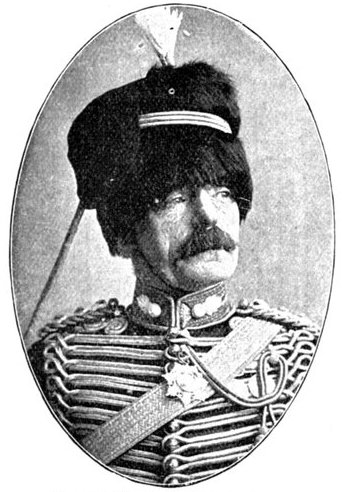
COLONEL C. J. LONG, R.A.
Obtained his Lieutenancy in 1870; served in the Afghan War of 1878-80,
and in the Soudan under Lord Kitchener in 1897-8 as commandant of the
Egyptian artillery. He was present at the battle of Khartoum, and for
his services on that occasion was mentioned in despatches. Colonel,
September, 1899; in command of the Royal Artillery at Colenso, where
his anxiety to get within effective range of the enemy led to the loss
of ten guns. In that action he was severely wounded.
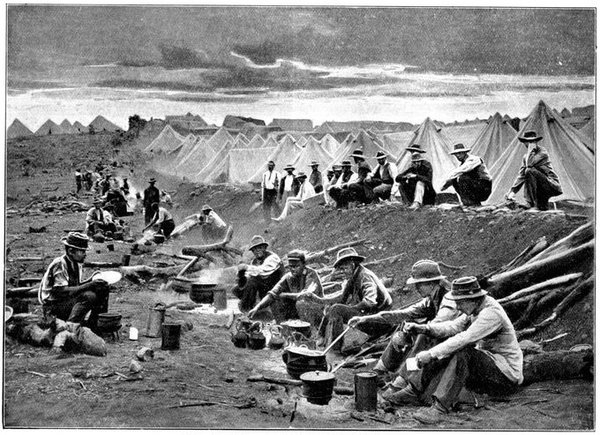
IN A BOER LAAGER: COOKS PREPARING A MEAL.
Why the attack failed.
Dec. 15, 1899.] Causes which Led to our Defeat.
As has been pointed out already, General Buller's army was from the
first insufficient—insufficient in numbers, and especially weak in
artillery. In the opinion of most correspondents on the field—an
opinion justified by the final success in February—there could be no
chance of success unless Mount Hlangwane, upon the British right, were
captured. In Boer hands this position gave an excellent sallying-point
whence to direct counter attacks upon the British flank and line of
communications. Judging by the measure of success which a small force
of Colonials obtained in their assault upon this hill, it would have
been possible with greater strength, which was available, to have
carried it. General Barton's brigade, 3,500 strong, was hardly engaged
in the battle, yet, when appealed to for assistance, the general
refused to send it. Mr. Bennet Burleigh, who does not write hastily,
considers[Pg 109] that half a battalion put into the fight at this point might
have turned the scale. With Hlangwane in British hands the Colenso
lines would have become untenable for the Boers, and the enemy must
have fallen back upon Pieters. But at Pieters, if they had fought in
December, they would have had to face the great risk of the Ladysmith
garrison breaking in upon their rear. For at that date Sir George
White's army was capable of moving, and had its cavalry and artillery
in fair condition. So that the capture of Hlangwane on December 15
might well have brought with it the immediate relief of Ladysmith.
Again, it is curious that seemingly no one in the British Army was
aware that the Boers had entrenched positions to the south of the
Tugela. Yet their dispositions in the Modder River fight, which had
occurred more than a fortnight previously, so that the Staff had had
full time to acquaint itself with the details, should have led to the
conclusion that it was at least probable there were such entrenchments
to the south of the river.
A third cause of the defeat was the utter untrustworthiness of the maps
of the district, although Natal had for two generations been a British
colony, and though a considerable British garrison had for years been
stationed in Ladysmith.
Next there were the actual mistakes of generals in the field. And here
it should be remembered in extenuation that while the non-combatant of
average intelligence, sitting in an armchair, can often point out after
the event what ought to have been done, and what was done wrongly, such
critics have not to face the storm and excitement of battle, in which
men are only too apt to forget or neglect the teaching of history. It
is a classical saying that the best general is he who makes the fewest
mistakes, and the proverb is itself an admission that mistakes in war
are inevitable.
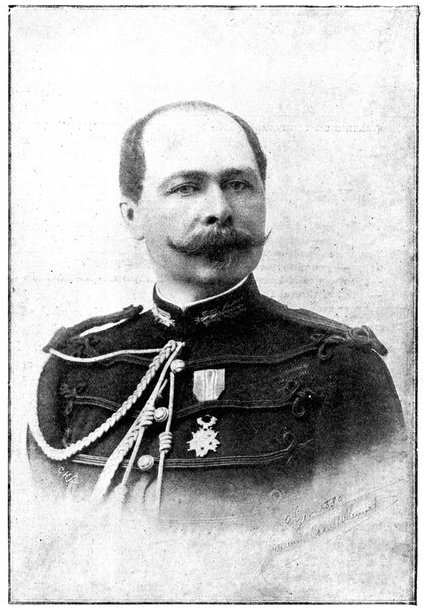
THE LATE GENERAL DE VILLEBOIS-MAREUIL
Sought out by Dr. Leyds on the outbreak of hostilities, Count de
Villebois-Mareuil, who retired from active service in the French Army
in 1896, hastened to Africa, and set to work to elaborate a plan
of campaign in Natal. He is said to have been responsible for the
disposition of the Boers at Colenso and elsewhere on the Tugela, and
to have been present and active in directing the repulse of Buller's
attack. He was killed in an action near Boshof, in the Orange Free
State, where he and some seventy men were surrounded and killed or
captured by Lord Methuen, April 5, 1900.
In their management of the battle the Boers had the assistance
and counsel of Colonel de Villebois-Mareuil, a French officer of
distinction, who, at a huge salary, had been enlisted to advise their
generals. But they paid little or no attention to his counsel. At the
time it was supposed that the Boer victory was largely to be attributed
to him. We now know that it was due to the errors of the British War
Office and the mistakes of the British generals.
[Pg 110]

STARTING ON THE FATAL MARCH: ROYAL IRISH RIFLES MARCHING
FROM BUSHMAN'S HOEK IN PREPARATION FOR THE BATTLE OF STORMBERG.
CHAPTER VII.
THE BATTLE OF STORMBERG.
Mistakes of the Boer Generals—British withdraw from
Naauwpoort and Stormberg—General Gatacre takes
command—Advance of the Boers—Omnibus Horses
for the Artillery—Conditions of successful
attack—Gatacre moves upon Stormberg—The forces
detrain at Molteno—The wrong road taken—The column
surprised—The fight—Fatigue of the British troops—A
gun abandoned—Order to retreat given—The dead and
wounded left—Narrow escape of the armoured train—The
return to Molteno—British losses—Disastrous
results—The Boers seize Colesberg—British re-occupy
Naauwpoort—Arrival of General French.
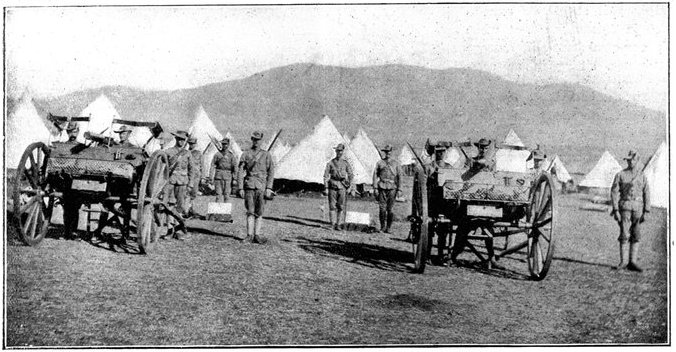
KAFFRARIAN RIFLES' CAMP AND MAXIM GUNS, BUSHMAN'S HOEK.
Mistakes of the Boer Generals.
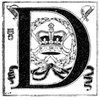
During early November the operations of the Boers in the central field
Nov. 1899.] The Boers Miss an Opportunity.
of war, along the Cape Colony frontier from Aliwal North to Orange
River Station, were languid in the extreme. Numerous small bodies of
the enemy had appeared in this region, which, as we have seen, was
denuded of all defence and open to any attack; but there was no energy
or combination. Had the scattered commandos been united into one body
and directed by one able brain, they might with little or no difficulty
have pushed south into the very heart of Cape Colony. At Cradock and
Graaff Reinet they had hundreds or thousands of sympathisers, who only
waited for their coming to rise. Ensconced in this mountainous and
difficult[Pg 111] country, astride of the railway which runs northward from
Port Elizabeth, and threatening on the one side the line from Capetown
to De Aar, and on the other the railway from East London to Stormberg,
they could have rendered any advance in Cape Colony impossible till
they had been dislodged. The army assailing them would have been
compelled to fight in a miniature Switzerland, where roads, towns and
mountains were only very incorrectly depicted on existing maps. We can
guess from General Buller's troubles in Natal during the advance on
Ladysmith what would have been the issue of such a campaign. For the
British Government, unlike the French or Italian, had never taken the
trouble to prepare its Army for the special contingencies of mountain
war. It seemed to expect that by a special dispensation of Heaven it
would always find level ground upon which to fight.

[Photo by H. Nicholls, Johannesburg.]
GENERAL GATACRE'S CAMP, WITH QUEENSTOWN IN BACKGROUND.

AN OSTRICH FARM AT GRAAF REINET, IN THE CENTRE OF THE
DISAFFECTED DISTRICT.
[Pg 112]
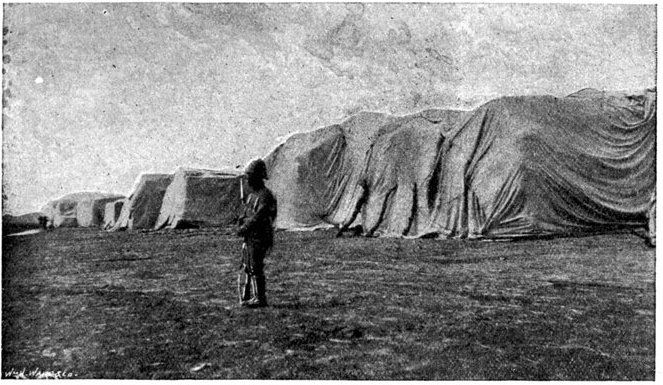
MOUNTAINS OF STORES AT NAAUWPOORT.
[Nov. 1899.
We see, then, that if the gravest mistakes had been made by British
generals, the enemy committed yet more colossal blunders. There was
nothing whatever to prevent the Boers from detaching 10,000 men from
Natal in early November and sending another 5,000 south from before
Kimberley, which would have been more hopelessly isolated if the rails
had been broken in the vicinity of Victoria West, far to the south of
De Aar, than it was when the line was cut only at Spytfontein. It is
certain that their foreign advisers, and in particular Dr. Leyds, urged
such a course upon the Boers. They were, one would suppose, shrewd
enough to understand the immense advantages which carrying the war so
far south would give them, but it may be that their armies had the
weakness of all peasant forces, hastily levied and ill-compacted, and
that the individual Boers shrank from going so far afield from their
homes.
British withdraw from Naauwpoort and Stormberg.
The tiny British garrisons had at General Buller's order evacuated
Naauwpoort and Stormberg, the first on the 2nd and the second on the
3rd of November. From Naauwpoort the British fell back to De Aar, and
from Stormberg to Sterkstroom and Queenstown, the latter place only
ninety miles from East London. There they remained a fortnight in
hourly danger of attack, waiting for the tardy transports that conveyed
the Army Corps. Meantime the Boers occupied Barkly East, Aliwal North,
Jamestown, Burghersdorp and Colesberg. At Aliwal North they seized a
loyal Dutch magistrate, Mr. Hugo, and made him stand upon the bridge
while they were crossing, as they were fully under the impression that
it had been mined. This gentleman displayed such devotion to his Queen,
and such unswerving fidelity to Britain, that he had afterwards to fly
for his life, leaving behind him his wife and children.
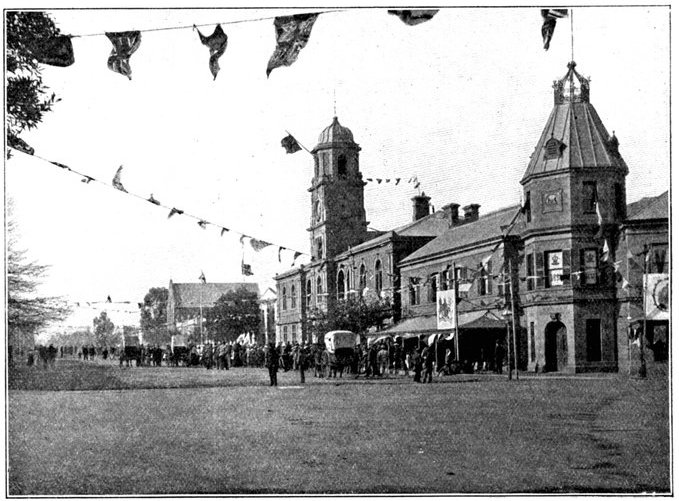
[Photo by L W. Ford, Queenstown.
QUEENSTOWN: THE TOWN HALL.
The photograph represents the principal street in Queenstown as
decorated on the occasion of the Queen's Diamond Jubilee.
General Gatacre takes command.
[Nov. 18-19, 1899.
On the 15th an armoured train with a small detachment of the Berkshires
reconnoitred to a point well beyond Stormberg, and returned, without
incident and without seeing[Pg 113] anything of the enemy, to Queenstown.
On November 18 General Gatacre himself arrived with his staff from
Capetown, accompanied by a portion of the 2nd Royal Irish Rifles.
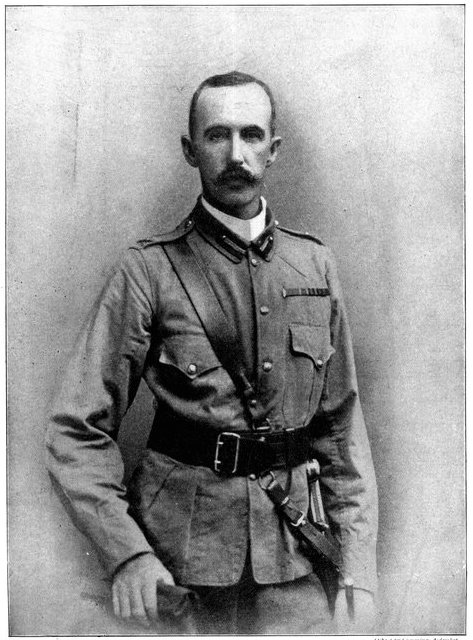
[Photo by Cumming, Aldershot.
LIEUT.-GENERAL SIR WILLIAM FORBES GATACRE, K.C.B., D.S.O.
Born 1843. Entered the Army in 1862; was Instructor of Military
Surveying at the Royal Military College, 1875-9; Deputy-Adjutant
and Q.M.G. with the Hazara Expedition, 1888; served in Burma, 1889,
Chitral, 1895, Soudan, 1898, and commanded the British Division at
the battle of Khartoum; in command of South-Eastern District, 1898;
appointed to command the 3rd Division in South Africa, with rank of
Lieut.-General, October, 1899.
[Pg 114]
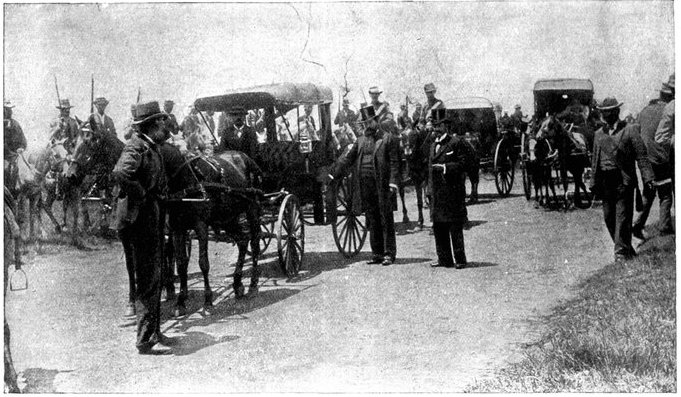
PRESIDENT STEYN AND HIS GUARD OF HONOUR OF FREE STATE
BURGHERS.
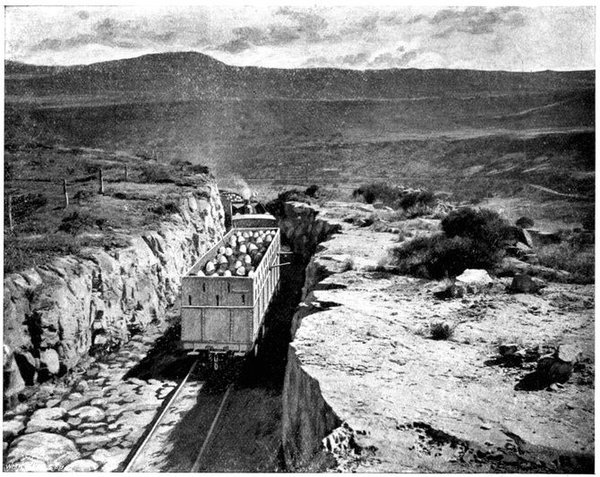
RAILWAY CUTTING AT STORMBERG: BRINGING UP TROOPS IN AN
ARMOURED TRAIN.
Nov. 21-Dec. 1, 1899.] Gatacre's
Reinforcements Diverted.
Sir William Gatacre had the reputation of being an excellent though
somewhat too daring general. He had great experience in savage warfare;
in Chitral he had commanded a brigade and won golden opinions; in
Egypt he had served under Lord Kitchener, that exact disciplinarian
and stern judge of men, and had commanded the British brigade at the
Atbara, where he led in person the impetuous assault upon the Dervish
zeriba. At Omdurman he had charge of the British division. He was a
man of the most intense energy—"Back-acher" was his nickname among
his soldiers—sparing others not more than himself. On Sunday, the
19th, he addressed his men at Church Parade and told them the news
of the repulse of the Boer attack by the Ladysmith[Pg 115] garrison. On the
21st he reconnoitred Bushman's Hoek, an important point on the railway
between Queenstown and Stormberg, where the road and line climb to
a great height over a shoulder of the Stormberg range, and where he
placed a small detachment of Colonial troops. Halting at Sterkstroom,
he reviewed and congratulated upon their appearance the Kaffrarian
Rifles—a local force. Next day he moved his little force, composed of
the Irish Rifles, Berkshire Mounted Infantry, and a few Cape Mounted
Rifles, forward to Putter's Kraal. He had with him six screw mountain
guns and six Maxims of the Cape Mounted Police. Here he halted some
days and waited for reinforcements. The want of men in Natal for the
relief of Ladysmith and the protection of the Colony being pressing,
his troops were for the most part diverted and he was sacrificed.
Advance of the Boers.
Now, at last, the enemy moved. On November 26 a commando of about 1,500
Boers advanced from Burghersdorp and seized Stormberg Junction, thus
cutting off all communication between General Gatacre on the one side
and the British forces at De Aar on the other. At the same time there
were reports that 3,000 Transvaalers were moving to Burghersdorp,
but as a matter of fact the majority of them appear to have gone to
Colesberg. Some, however, with a heavy 40-pounder and at least one
field gun did join the Stormberg commando.
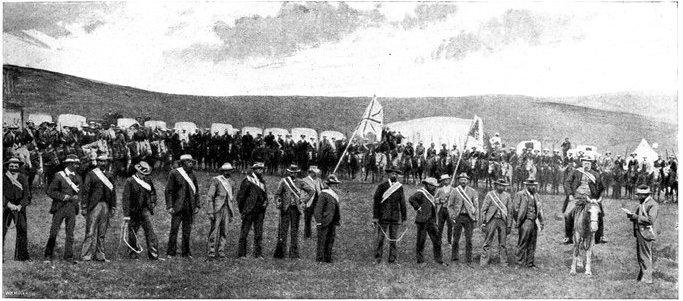
WAPENSCHOUWING AT BARKLY EAST.
Much of the Boer accuracy of marksmanship may be attributed to their
periodical Wapenschouwings. These are Bisley contests in miniature.
From far and near the Boers (in times of peace) assemble at the farm of
the Landdrost, or principal man of the district, and for three or four
days engage in rifle shooting contests for prizes in money and kind.
The occasion is made use of for various Boer festivities, in which
dancing always forms a prominent part. No regular targets are used, but
bottles or empty paraffin tins are suspended at various distances, and
accuracy of aim is encouraged by continual shifting of the objects to
be fired at, so that the sighting has to be guessed by the marksman.
[Pg 116]
[Dec. 2-6, 1899.
By December 1 only two of the eight battalions forming General
Gatacre's division had arrived. He had still no cavalry and no
artillery.
Omnibus horses for the Artillery.
On the 2nd, Dordrecht, a small place some miles to the north-east of
Sterkstroom, was occupied by a commando of the enemy numbering about
500 men. About this date there were probably 3,000 Boers in all in the
Stormberg district, but they were much scattered and showed little
sign of mischief. Meantime the small British column was reinforced by
two field batteries, the 74th and 77th. Their horses, however, after
the long voyage were in very poor condition. Fully half of them were
omnibus or tram horses, without the slightest artillery training,
though the batteries might well have had a week's careful exercise in
England, since they only left on November 2. Most of the horses had
only been received a few hours before the embarkation took place, and
were, in consequence, quite new to their work. An ammunition column
followed the two batteries, but the supply of ammunition was barely
sufficient for one great battle. All these deficiencies hampered the
general terribly, and account in some degree for his ill-fortune.
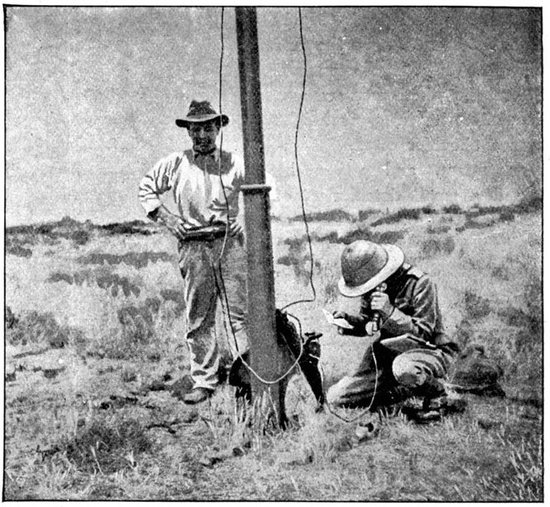
TAPPING THE TELEGRAPH WIRE: A FREQUENT INCIDENT IN WAR.
A quaint story of the omnibus horse is told by The Times
correspondent with the column:—
"One of the drivers," he writes, "who had been entrusted with the
charge of a sick horse in addition to an ex-tramcar animal, proceeded
to mount the latter, regardless of the fact that it, probably, had
not had a saddle on its back since it was a colt. The result was much
kicking and rearing, combined with an obstinate determination to remain
otherwise stationary. The man got angry, and, uttering a variety of
anathemas, began to ply his spurs with vigour and intention. Just as
the contest culminated another driver standing by called out, 'Stow
them spurs, Jack; ring yer bloomin' bell!'"
On December 6 the column had a field day, but Colonials and military
observers noted with alarm that no attempt was made to teach the troops
to make use of the advantages of the ground. There was the same blind
rushing at the enemy's supposed position, after quite insufficient
artillery preparation, as in most of the early and sanguinary
encounters of this war.
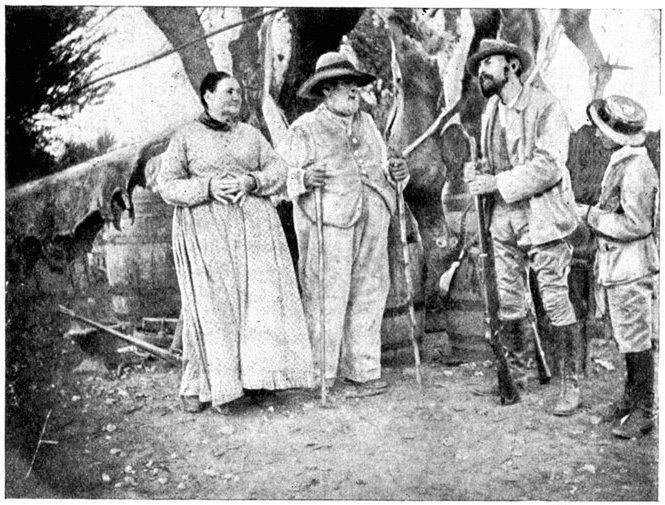
[Photo from life.
NOT SO DENSE AS THEY SEEM.
The Englishman is endeavouring to obtain information from the old Boer
farmer and his vrouw (wife). The figures are very characteristic; Boers
of both sexes in middle life develop a tendency towards obesity.
Conditions of successful attack.
Dec. 6-7, 1899.] More Cavalry and Artillery
Needed.
A few words must here be said as to the method of fighting battles
in modern war. The first step is to ascertain by scouting and
reconnaissance the exact position of the enemy, and, as far as may be,
his strength. Against the Boers, as indeed against any enemy, this
is a matter of exceptional[Pg 117] difficulty. Even the greatest generals
in the past, when smokeless powder and long-range rifles did not
exist, and when it was far easier to approach to close quarters, have
found themselves mistaken in such matters. The force and position of
the enemy ascertained, the next thing is to conceal from him your
own intentions and, as far as possible, to strike him unexpectedly.
This was not easy for the British campaigning in a country openly or
secretly disloyal.
When the general has determined upon battle he brings up his artillery
on the enemy's flank and front, and steadily bombards. This is known
as the artillery preparation. Its object is as much to cow as to kill
the foe—to render his shooting uncertain, and to pave the way for
the final attack, which is delivered by the infantry in very open
formation, crawling forward and taking advantage of all cover, till at
last the men are close enough to rush in and use the bayonet. While the
artillery preparation is proceeding, infantry and cavalry work round
the enemy's two flanks and endeavour to get behind him, so as to cut
off his retreat and ensure the capture of his men and guns.
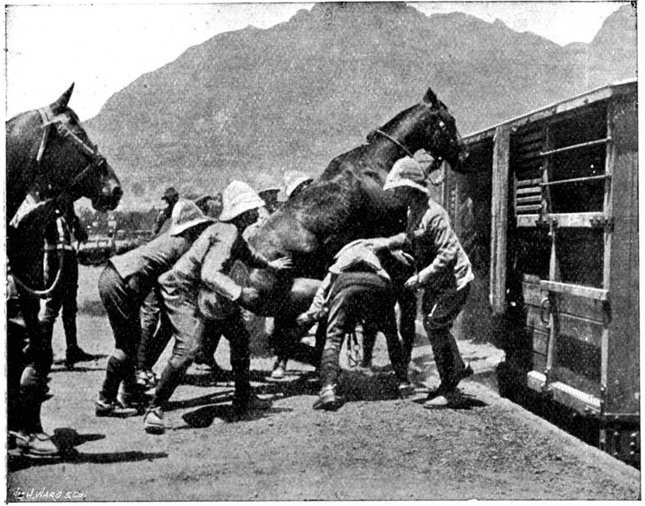
A REFRACTORY MOUNT.
Under the conditions of their subsidies, the Government "commandeered"
a number of horses from the principal omnibus and tramway companies;
horses more accustomed to running in front of a car than to riding
inside one.
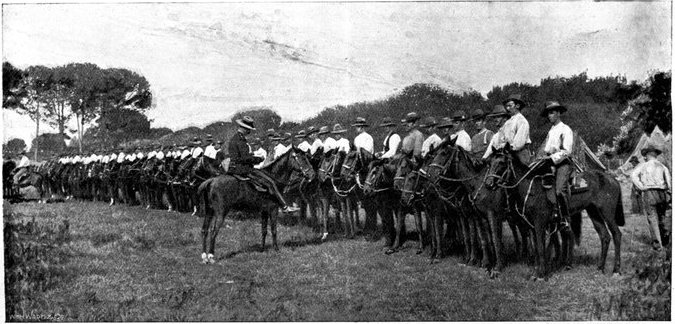
[Photo by Murison.
EVERY MAN HIS OWN HORSE-BREAKER.
Parade of the New South Wales Lancers on untrained horses at the
Remount Depot, Stellenbosch.
[Dec. 6-7, 1899.
Thus to attack the Boers with success three things were wanted: a good
and numerous artillery; an infantry force sufficient to storm the Boer
positions after the artillery preparation; and cavalry or mounted
infantry in abundance to follow up success and convert it into victory.
Yet, as we have seen, the proportion of artillery sent to South Africa
with our army was absurdly low, and the cavalry and mounted infantry
were enormously below the generals' requirements. Again and again
in the course of the despatches we find our officers complaining
that their hard-won little victories were barren of results owing to
the insufficiency of these two arms. These facts are of the utmost
importance, because they prove that our failure in South Africa, far
from being due to "inevitable"[Pg 118] causes, was the result of the complete
disregard of the rules of military science, and, indeed, of common
sense. In the words of Napier's history of the Peninsular War, "it is
fitting first to expose the previous preparations and plans of the
Cabinet, lest the reader, not being fully awakened to the difficulties
cast in the way of the English generals by the incapacity of the
Government, should, with hasty censure or niggard praise, do the former
injustice."
All through these days of early December, General Gatacre was urged
and pressed by the British loyalists in Eastern Cape Colony to push
forward, stop the enemy plundering their farms, and prevent disloyal
Colonists from joining the hostile standard. The pressure upon him
grew constantly till he was unable to resist it. Against his own
will—against his better judgment—he determined to attempt a perilous
enterprise in a region which is difficult and mountainous, of which
there were no correct maps, and where every inch of the ground was,
through the help of the rebels, known to the enemy.
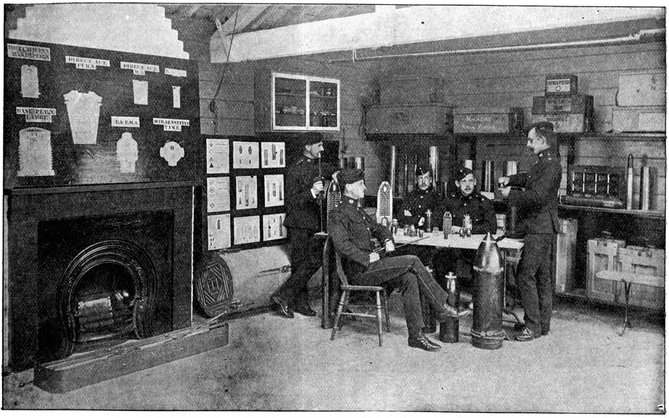
[Photo by Cribb, Southsea.
TEACHING THE USE OF SHELLS AND FUSES.
On the table are several specimens of shrapnel shells, cut in section
to show their construction. Over the fire-place is a series of diagrams
illustrating the various kinds of fuses.
Gatacre moves upon Stormberg.
On December 7 he decided to convey 2,500 men and six guns northward
by train to Molteno on the next day, and marching thence by night to
attack the enemy's laager at Stormberg at dawn on the morning of the
9th. Unfortunately, on the 8th he was unable to start, and had to
postpone his effort to the next day. Thus there is reason to think that
the Boers, through this delay, had full warning of his intentions.
The attack having been determined upon, it would have been expected
that he would make use of the wing of the Berkshire regiment which
had garrisoned Stormberg before its abandonment, and which knew the
ground well. But that regiment was left behind to guard communications.
It would have been expected that the rules laid down by military
authorities for night attacks would be observed. They are as follows:
That the line of advance should be most carefully reconnoitred by the
general in person, full information obtained as to the enemy, and the
attacking column covered by a swarm of scouts and patrols to obviate
all chance of a surprise. None of these precautions had been taken, and
entire reliance was placed upon guides, four in number, whom events
proved hopelessly untrustworthy. This was in spite of the drill-book
caution that men who know the country well by day are not to be
depended upon at night unless they have often covered the road in the
dark.
[Pg 119]
Dec. 9, 1899.] Gatacre Decides to Risk an Attack.
The forces detrain at Molteno.
On the 9th the move began. The troops entrained at Putter's Kraal at
4 a.m. They numbered 966 of the 2nd Northumberland Fusiliers, some
400 of the 2nd Royal Irish Rifles, 300 of the 1st Royal Scots, and
two batteries of field artillery with twelve 15-pounders. The mounted
infantry, 257 strong, moved by road with 42 Cape Police. The journey to
Molteno in open trucks took two hours longer than had been expected,
owing to delays on the railway. Upon the way 440 more men of the 2nd
Royal Irish Rifles were picked up at Bushman's Hoek, and 100 Royal
Scots dropped to guard the camp. In consequence of the vexatious
delays, instead of three hours' rest being given the men at Molteno,
before undertaking the march, only one hour could be spared. At 9·15
p.m. the infantry marched off into the darkness to cover by a wide
detour the last nine miles intervening between Molteno and the enemy's
position. To watch Molteno itself the remnant of the Royal Scots was
left.
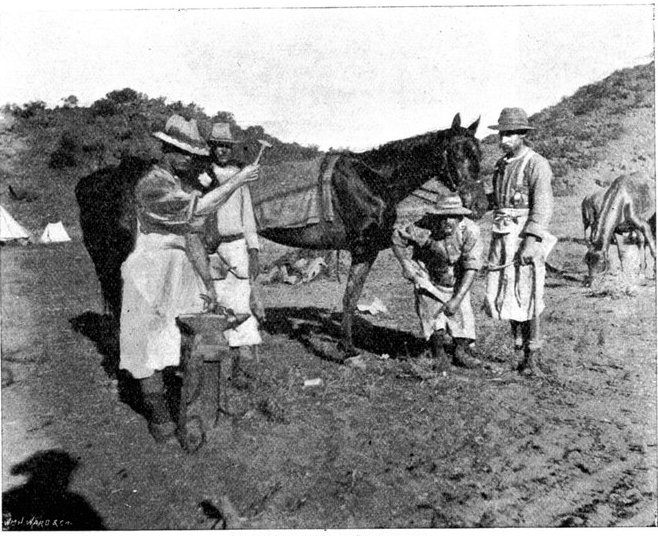
FARRIERY IN THE FIELD.
Army blacksmiths at work shoeing horses.
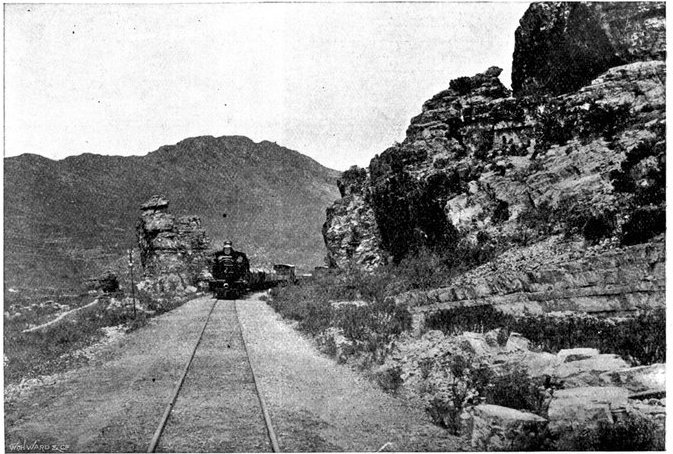
SCENE ON THE RAILWAY.
Showing precipitous rocks such as checked the charge of the
Northumberland Fusiliers and Irish Rifles.
[Dec. 9-10, 1899.
"No operation of war," says Mr. Winston Churchill, "is more critical
than a night march. Over and over again in every country frightful
disaster has overtaken the rash or daring force that has attempted it.
In the gloom the shape and aspect of the ground is altered. Places,
well known by daylight, appear strange and unrecognisable. The smallest
obstacle obstructs the column, which can only crawl sluggishly forward
with continual checks and halts. The effect of the gloom upon the
soldiers' nerves is not less than on the features of the country.
Each man tries to walk quietly, and hence all are listening for the
slightest sound. In such hours doubts and fears come unbidden[Pg 120] to the
brain, and the marching men wonder anxiously whether all will be well
with the army, and whether they themselves will survive the event. And
if suddenly out of the black silence there burst the jagged glare of
rifles and the crash of a volley, followed by the yell of an attacking
foe, the steadiest troops may be thrown into confusion."
As the column stole off into the darkness with gun-wheels muffled in
hide to prevent the tell-tale creaking that might warn the enemy, an
ominous signal was seen. Far away on the right there flashed several
times towards Stormberg a bright light. No one then knew its meaning,
yet unquestionably it was to tell the enemy that the night march had
begun. Already the run of ill-luck which marked the operations of this
column had set in; 160 of Brabant's Horse, 235 of the Cape Police, four
7-pounders, and a Maxim at Penhoek ought to have marched to effect a
junction at Molteno with General Gatacre's force. A telegram which he
had handed in to a telegraph clerk at Molteno with the order was not
transmitted, and so they failed to arrive. The General did not observe
the precaution of requesting a message acknowledging the receipt of his
instructions, nor did he duplicate the despatch.
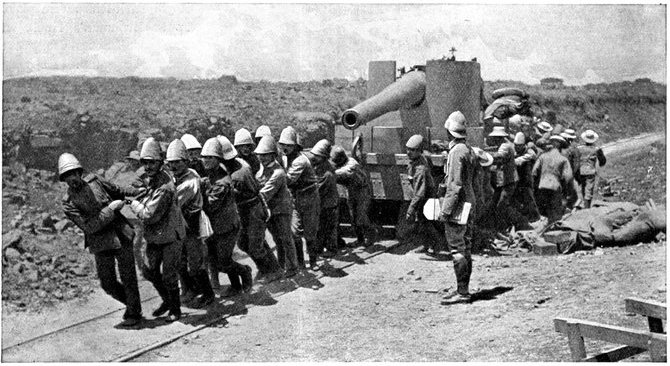
WARM WORK UNDER A BLAZING SUN: BRINGING UP A GUN BY
HAND-LABOUR.
The wrong road taken.
A little beyond Molteno the road forks. To the left runs the Steynsburg
road, which at the last moment was taken by the column. From it a
mountain track led by a detour to the enemy's position. To the right
ran the direct Stormberg road, which General Gatacre had originally
decided to follow. He did not inform the Intelligence Officer at
Molteno of his change of plan, nor did he post an officer at the
junction of the roads to direct those who were following as to his
course. In consequence, the Field Hospital, ammunition waggons, a
Maxim, a detachment of Royal Irish Rifles, and a bearer company took
the wrong road at the start; then, finding that they did not come up
with the column, returned to Molteno, only to be told that the road
they had taken was the right one. Once more they wearily retraced their
steps and bivouacked in sight of Stormberg at 2·30 a.m. Nothing could
as yet be made out of the British column.
Dec. 10, 1899.] The Enemy Found at Last.
Hour after hour that column had marched in the darkness; the full
distance to the enemy's position had been covered, yet the guides found
they were nowhere near Stormberg. The night slipped away; day began
to break, and it became plain that surprise was not to be hoped for.
The order was given to "fix bayonets," and about 4·15 a.m. of the 10th
the troops, after seven hours continuous marching, weary and utterly
exhausted, reached the foot of Rooi Kop, the mountain[Pg 121] overlooking
Stormberg Junction, on which the enemy were intrenched. The guides
had mistaken the way and had led the force eighteen miles instead of
nine miles, coming in upon the enemy's right rear instead of his right
front. Though two of the Berkshire Regiment with the force had drawn
attention to the mistake when the proper turning was passed, they were
not listened to, such was the blind trust reposed in the guides. The
latter were questioned, and persisted that they were in the right; they
were, they said, taking a somewhat longer line to avoid a rough patch
of road.
The column surprised.
If at this moment the uselessness of persisting in the enterprise
with worn-out men had been realised, and a prompt retreat ordered,
no mischief would have resulted. But, far from retreating, the force
pushed on in the dim light carelessly, in close order, as though
there had been no enemy within miles. "No cheering, men, but get in
silently with the bayonet," was General Gatacre's only order. In the
breaking daylight, an admirable target, the column defiled past a line
of kopjes. Suddenly from these burst forth the flash of rifles, and a
staggering fire was poured in upon the mass of men beneath.
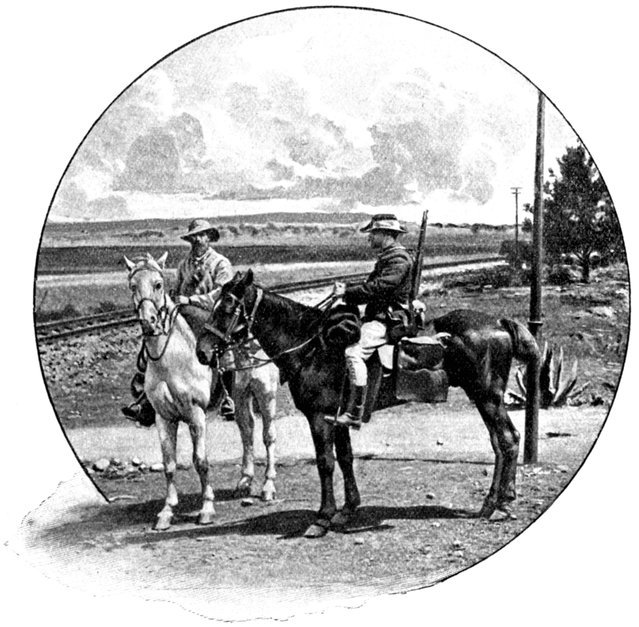
A BOER VEDETTE.
The fire was so fierce that it stopped the column's progress. The
British, and not the enemy, had been surprised. And the British soldier
after twenty-four hours of weary journeying by train, waiting under
arms, and marching, was in no condition to grapple with a fresh enemy,
ensconced in positions of great natural strength. Yet, recovering from
their first astonishment and consternation at the murderous fire,
the British regimental officers and privates of the Northumberland
Fusiliers and Irish Rifles dashed at the kopjes.
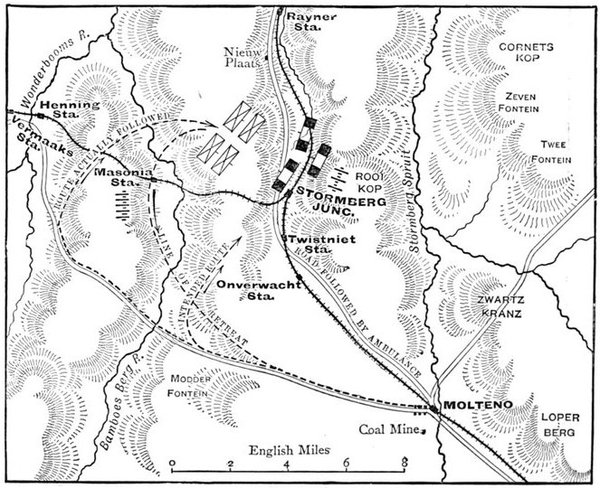
MAP OF THE BATTLE OF STORMBERG.
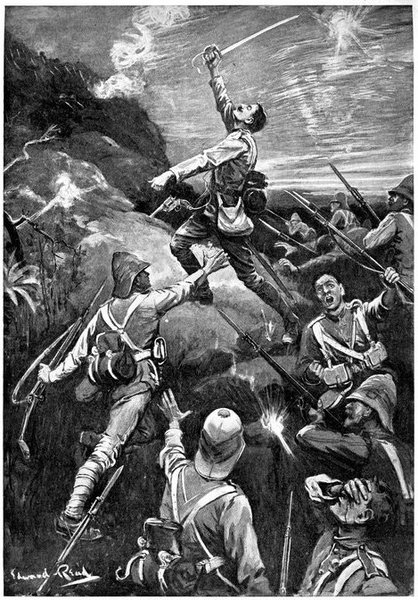
THE BATTLE OF STORMBERG: CHARGE OF THE NORTHUMBERLAND
FUSILIERS.
The fight.
Dec. 10, 1899.] The Charge Checked.
Both battalions were simultaneously entangled in the fight. No
organised body of reserves was left to support the skirmishers or feed
the advancing line with fresh men. The stormers, under a tremendous
fire from an invisible enemy only eighty yards away, forced their
way up the steep and stony slopes, encountering wire fences in which
many were caught and delayed. "The Boers," wrote a bandsman of the
Northumberland Fusiliers, "had put up fences with spikes in, and when
we got halfway through we stuck fast. The Boers were laughing at us.
My haversack stuck fast in the fence, [Pg 122]
[Pg 123]and there I was struggling,
with the bullets flying all round me. I managed to get the haversack
off and left it in the fence. Our regiment was 1,100 strong, now we
don't muster much over 500." They neared the top, advancing from
boulder to boulder, when just below a stone wall held by the enemy
they found before them a vertical precipice. It was only a few feet
high—a few feet of sheer unclimbable rock—but such an obstacle will
repel the efforts of the best mountaineer, much more those of weary and
heavy-laden infantry under the very muzzles of the enemy's rifles. At
the same time the Boer artillery opened fire with a heavy 40-pounder of
long range and two quick-firing field pieces. Desperate attempts were
made to scale the precipice, but ladders alone could have enabled the
men to surmount it, and ladders were wanting. At this moment several
shells from the rear burst amongst them. There was nothing for it but
for the infantry to retire and hold the best position they could reach
near at hand.
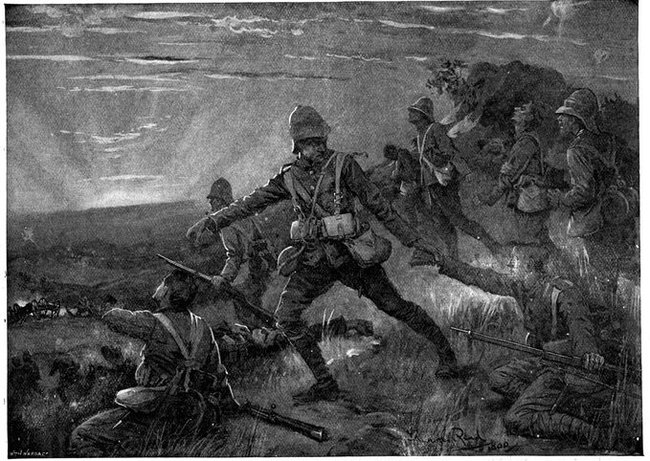
THE RETREAT AFTER THE BATTLE OF STORMBERG.
Fatigue of the British troops.
So exhausted were the men by their long march and by the climb, that
when the retreat began many threw themselves down and instantly fell
asleep under the enemy's fire. No efforts of their officers or comrades
could keep them awake. Men fell in a heavy slumber as they staggered
down the mountain side. Others had not the endurance left to march back
through the bullet-swept zone behind them, and sank down on the kopjes
waiting to be made prisoners, because they felt escape was beyond their
strength. The remnant painfully picked their way down the slopes under
the pitiless hail from the Mausers, and doubled back across the 500
yards of open veldt to the nearest cover. It was a terrible scene, and
had the Boers shown the smallest energy or attempted a charge, General
Gatacre's whole force must have been captured or destroyed.
[Dec. 10, 1899.
A gun abandoned.
The two batteries of artillery had been caught by the enemy's fire on
the march. The ground was so unfavourable that they could not promptly
come into action. They had to wheel and gallop back some hundreds of
yards. At this moment a gun stuck fast in boggy ground; the team of[Pg 124]
horses dragging it was instantly shot down by the enemy, and it had
to be abandoned. The other eleven weapons selected a position and
promptly opened on the crest of the kopjes held by the Boers. On them
they directed a most effective shell fire, but, unhappily, some of
their projectiles fell short and dropped among the British infantry,
as they were painfully trying to scale the precipice just below the
Boer position, adding to the confusion. Such accidents are almost
inevitable in war. The Boer shells in reply came fast and thick. The
enemy's 40-pounder was infinitely more powerful and of far longer range
than the British field pieces. The manner in which our gunners stuck
to their dangerous work under its projectiles was one of the consoling
features of this sorrowful day.
Order to retreat given.
The attack had failed so hopelessly that, under the cover of this
artillery fire, General Gatacre rallied his men and gave the order
to retreat. But it was difficult to draw the infantry, once heavily
engaged, out of the fight. Some were too weary to move; others lay fast
asleep under the Boer works; others, again, with the stubborn fighting
instinct of the British soldier, preferred to hold their ground, in the
vain hope of snatching eventual victory. Those, however, who responded
to the order proved that their spirit had not been broken by calamity.
They showed a bold front, formed up on a low line of hills covered by
the artillery, and in perfect order began the retrograde movement.
The two batteries of artillery fired alternately, the one falling
back while the other was in action, and held off the Boers. But the
retreat was long and difficult, as the British troops had to describe a
complete semi-circle, everywhere commanded by the Boer guns, around a
central point held by the enemy.
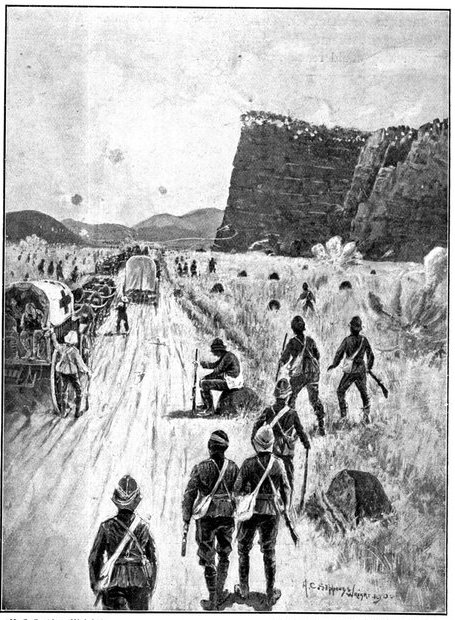
H. C. Seppings Wright.] [
From a Sketch by Lieut. T. N. F. Davenport.
THE RETREAT FROM STORMBERG.
The drawing represents the withdrawal of guns and ambulance waggons
towards Molteno. The steep crags on the right were occupied by the
Boers. Our men being well scattered, the enemy's shells did little
damage.
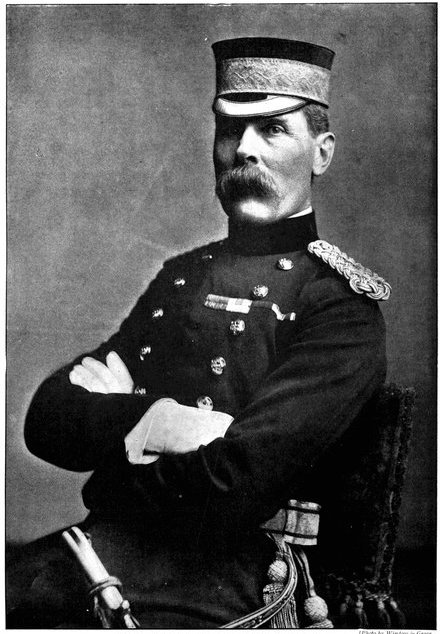
[Photo by Window & Grove.
LIEUT.-GENERAL LORD METHUEN, K.C.V.O., C.B., C.M.G., J P
Paul Sanford, Lord Methuen, was born in 1845, and entered the Scots
Guards in 1864. He was sent on special service to the Gold Coast in
1873, and in the following year became Brigade-Major at Ashanti and for
the Home District. Two years later he was appointed Assistant Military
Secretary to the Commander-in-Chief in Ireland. From 1877 to 1881 he
was Military Attaché to the British Embassy at Berlin. He commanded
Methuen's Horse and the Field Force during the Bechuanaland Expedition
of 1884-5, and was Deputy-Adjutant-General in South Africa in 1888.
From 1892 to 1897 he commanded the Home District, and at the beginning
of the war with the Transvaal he was given the command of the First
Division of the Army Corps. He arrived in Capetown to take over this
command on November 10, 1899.
The dead and wounded left.
[Dec. 10, 1899.
It has been said that British soldiers are better at an advance than
a retreat. In retreat the very best troops, especially if galled by
artillery to which they can make no reply, are apt to break and run.
But the soldiers of the Northumberland Fusiliers and Royal Irish Rifles
in this hour displayed a steadiness above all praise—a stubbornness
and endurance which proved their splendid quality, and showed them
equal to any work when well led. They ground their teeth, indeed, as
they saw the dead and wounded left behind unaided and untended. They
flung themselves down when the great 40-pounder shells came [Pg 125]
[Pg 126]hissing
amongst them, and then, when the explosion had come and gone, leapt
up to shake their fists at the Boers. But they did not quicken their
pace. The officers set a splendid example. General Gatacre was in the
most exposed position: wherever the enemy's fire was hottest there he
was certain to be found. The company officers appealed to the men and
helped them in their weary progress. The men in turn aided those of the
wounded who could walk. Lieutenant Stevens of the Irish Rifles, shot
through both lungs, was carried by four gallant privates, who forgot
their own fears and their own weariness in their soldier-like devotion.
He himself made light of his terrible wound, and laughed at the odd
pertinacity of a black policeman, who had used the opportunity of the
action to lay hands upon certain stampeded Boer horses, thus turning
even battle and defeat to personal profit.
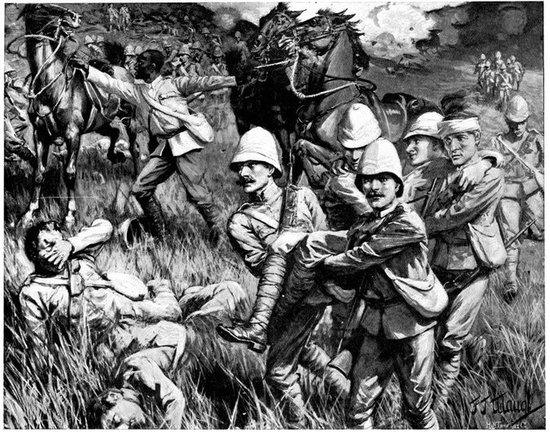
THE RETURN FROM STORMBERG: LIEUTENANT STEVENS CARRIED BY
FOUR PRIVATES.
Narrow escape of the armoured train.
Hour after hour this terrible retreat continued, both officers and
privates staggering, weary, footsore, exhausted, along, expecting each
moment to find that the enemy had intercepted them. But the enemy
showed the usual Boer want of enterprise, and was content merely to
fire shell from the 40-pounder, which for the most part did not burst.
At last, more than thirty hours after their start, the dejected troops
straggled back into Molteno. In some degree they were covered for the
last mile or two of their retreat by an armoured train, which had
advanced towards Stormberg during the fighting, and which had barely
escaped derailment and capture. The fish-plates of the rails were seen
to have been removed some few yards beyond the place where the train
halted, and a Boer gun was observed trained in readiness to play upon
the wreck.
[Pg 127]
Dec. 10, 1899.] Compassionate Townspeople.
The return to Molteno.
A private who was in the battle gives this account of the
retreat:—"The hills were unscalable, and after fighting for nearly
six hours we had the order to retire as well as we were able, leaving
most of our wounded and killed behind, as the Boers were working round
to cut us off as we were retiring. We got into Molteno with about
forty-six wounded men about five o'clock at night, after being on the
march for about twenty-two hours. The poor fellows were dropping by
dozens along the road with sunstroke and exhaustion all the way along,
but it made up for all when we got to Molteno. The people were waiting
for us with tea, bread and butter, and everything we could wish for,
and we were glad of it, too, as no man or beast had had anything to eat
or drink, except what we had in our water-bottles, from the time we
started till we returned. Directly the Boers saw a stretcher party go
to pick a man up they fired volleys into them. No one blames General
Gatacre for getting into the trap; everyone is willing to stick to him
and go up and have another go at the brutes. I saw one Maxim gun and
about forty men of theirs go up with one shell of ours. They must have
lost ten times more than us."
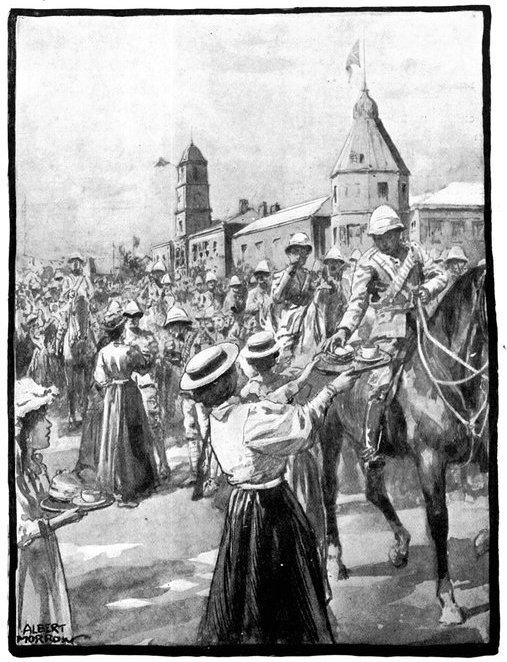
BACK IN MOLTENO: THE TOWNSPEOPLE GIVING REFRESHMENTS TO
THE TROOPS.
Great disaster as was the battle of Stormberg, it was in no way
dishonourable to the private soldier or subaltern officer. These had
fought gallantly and stubbornly; they failed not from any want of
courage or devotion, but because the task set them was beyond the
strength of man. Brave in the advance, they were cool and deliberate in
the retreat. In the military qualities of the common Englishman there
had been no decline since the great days of the past, and this battle
proved it.
[Dec. 10, 1899.
British losses.
The losses were heavy. Besides one gun which stuck in a bog, another
weapon overturned and fell into a watercourse, where it was captured
by the enemy. The killed were thirty-one and the wounded fifty-eight,
almost all taken prisoners, while 633 unwounded men were also captured
by[Pg 128] the enemy. A few wounded officers and men were brought into Molteno
from the battlefield by the troops. The British loss in officers was
lighter than usual; but Lieutenant-Colonel Eager, of the Royal Irish
Rifles, was mortally wounded, and both the majors of this battalion
were wounded. The enormous total of prisoners taken was due simply and
solely to the exhaustion of the men.

DETRAINING ARTILLERY AT NAAUWPOORT.
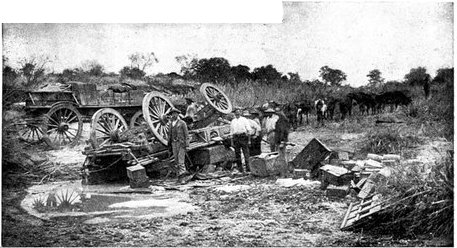
AN AWKWARD ACCIDENT.
The capsizing of a waggon on any of the South African coach-roads is by
no means an unusual sight. It is usually caused by careless driving,
as, for example, by attempting to drive straight across a watercourse
or "sluit" on the road instead of taking the waggon diagonally over it,
so as to lessen the strain. On more than one occasion, as on the road
to Stormberg, a like accident has occurred to our guns.
The Boer force which inflicted this grievous punishment was said, by
the enemy, to have been only 800 strong. It certainly did not exceed
1,500. It was composed of very indifferent material, a fact which
heightened the deplorable nature of the reverse. It displayed neither
vigour nor enterprise, and this though its losses were absurdly
small—five killed and sixteen wounded. At this low cost it had
completely paralysed General Gatacre's column and cut up two of the
finest battalions in the British Army.
It was not the enemy's generalship or marksmanship that won this Boer
success, but the strange run of ill-luck in General Gatacre's column,
and the neglect of all ordinary precautions. As a matter of fact, the
Boer shooting was exceedingly bad, and all who witnessed the action
were astounded to discover that so few had been killed and wounded on
the British side. Surprised as the column was, in close formation, it
should have been all but annihilated.
Disastrous results.
The natural result of the defeat was that the Dutch in the district,
who had been sitting on the fence to see which side would win, joined
the victors. Some hundreds of farmers at once repaired to the Federal
standard. General Gatacre found his position so doubtful that he
thought fit to retire from Molteno and fall back to Bushman's Hoek,
where he established his headquarters.
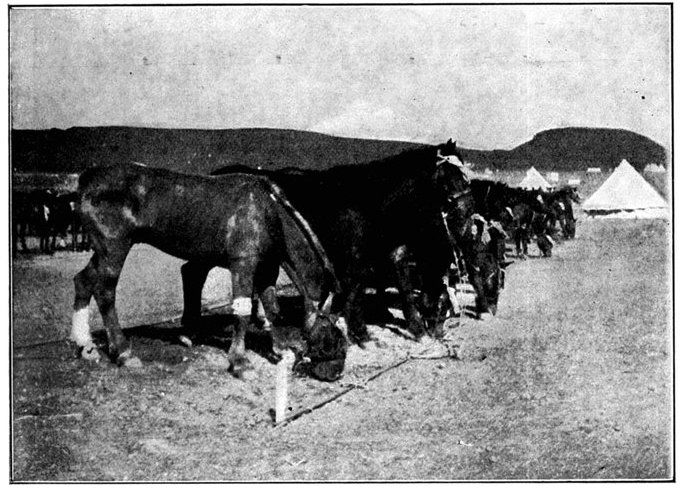
DUMB VICTIMS: WOUNDED HORSES AT NAAUWPOORT.
Nov. 1-15, 1899.] Situation at Colesberg.
There were stories that, as soon as he discovered that his[Pg 129] guides had
misled him, he drew his revolver and shot them. A court of inquiry
investigated the behaviour of the guides after the battle, and decided
that they had erred through inadvertence, not treachery.
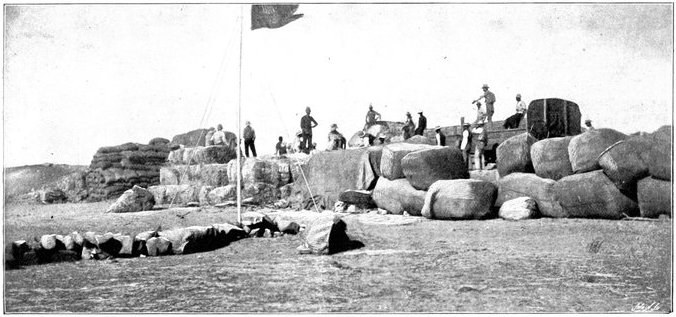
[Photo by Fyne, Capetown.
OFF-LOADING HAY AT ARUNDEL: THE ARMY SERVICE CORPS AT WORK.
The Boers seize Colesberg.
Towards Colesberg the enemy began operations on November 1, crossing
the bridge and advancing to the southward. Naauwpoort had been
evacuated, and they had the whole of the country between that place and
the Orange River at their mercy. They blew up the road bridge across
the river north of Colesberg and a railway bridge on the Colesberg and
Norvals Pont line, which looked rather as though they were afraid of a
British advance than as if they meant a serious invasion. At last, on
the 15th, they seized Colesberg.
British re-occupy Naauwpoort. Arrival of General French.
The growing aggressiveness of the Boers compelled the despatch of a
British force to watch them and protect the immense depots of stores at
De Aar. On November 19 Naauwpoort was re-occupied, and three days later
General French with 3,000 men (amongst whom were the 2nd Berkshires,
6th Dragoons, New Zealanders, and New South Wales Lancers) followed in
support to Hanover Road, between De Aar and Naauwpoort. Next day he
proceeded through Naauwpoort with an armoured train and a couple of
hundred men, and found the Boers near Arundel. This was the high-water
mark of their advance in the central field of war.
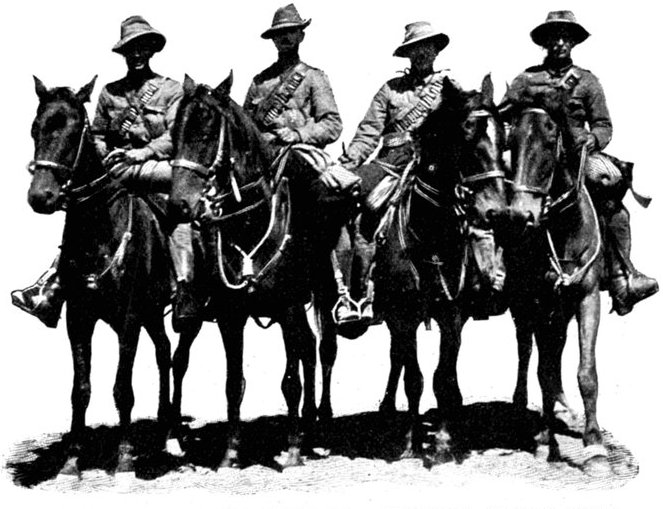
BRITONS FROM THE ANTIPODES: NEW ZEALANDERS WITH GENERAL
FRENCH'S DIVISION.
The British and the Boers interchanged shots, but the casualties were
insignificant. General French pushed north towards Arundel on the 25th,
and repaired the railway line, which had been broken in one or two
places. On December 6 he advanced and seized Tweedale, a station south
of Arundel; on the 7th occupied Arundel, and next day pushed forward
with the greater part of his force towards Rensburg. The enemy opened a
heavy fire upon the British mounted infantry and cavalry, including the
New Zealanders and New South Wales Lancers, but no casualties occurred.
With Arundel in the hands of General French, and a cavalry brigade
watching the enemy, all danger to De Aar vanished. But the force was
too weak to do more than keep the enemy in check until reinforcements
should arrive.
[Pg 130]
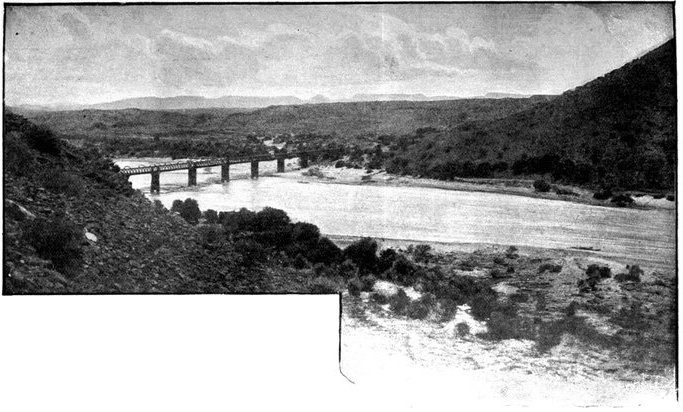
ORANGE RIVER BRIDGE.
Lord Methuen takes charge of the Western
Campaign—Reconnaissance towards Belmont—Heavy loss
of officers—Lord Methuen reinforced—Advance to
Fincham's Farm—British victory at Belmont—Chaplain
Hill's bravery—Contraventions of usages of war—Boers
retreat—Frontal attack criticised—Lord Methuen
congratulates the troops.
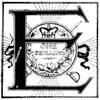
Early in November the situation at Kimberley began to cause some
uneasiness in South Africa. The town was one of considerable size; the
food supplies in it were not large in proportion to its population;
its fighting resources and garrison were limited; and it lay in an
extremely exposed position. The fall of Kimberley would have a most
unfavourable effect upon the disloyal Dutch of Cape Colony, and would
place vast financial resources, in the shape of the diamond mines,
in the hands of the Boers. But if a British relief force succeeded
in fighting its way to Kimberley, and if it could protect the
seventy-seven miles of railway communication to Orange River Station in
its rear, it would be excellently placed for an invasion of either the
Free State or the Transvaal.
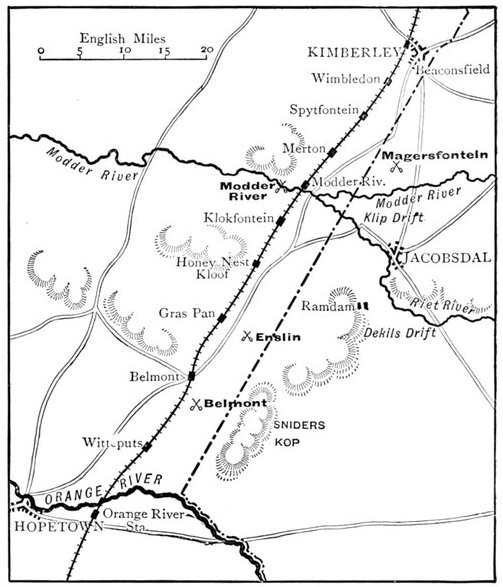
MAP SHOWING LORD METHUEN'S ADVANCE FOR THE RELIEF OF
KIMBERLEY.
The spots marked ⚔, are the scenes of battles; the dotted line is the
boundary of the Orange Free State.
Lord Methuen takes charge of the Western Campaign.
On November 10, Lieutenant-General Lord Methuen, the Commander of
the First Division, landed at Capetown and received instructions to
organise a flying column for the relief of the diamond city. Lord
Methuen was an officer of distinguished service, though this was the
first time that he had held an independent command with a large body of
troops. He had fought in the Ashantee and Egyptian Wars, and in 1884-5
had raised a body of horse when the Bechuanaland dispute seemed likely
to cause trouble. He was a man of energy and intense self-confidence,
fond of sententious maxims, reputed a good tactician. In appearance he
was tall and big-framed, with a slight stoop. In action he displayed
all the bravery and coolness of the typical British officer.
[Pg 131]
Nov. 10, 1899] The British Base at De Aar.
The base for his column had been, before his arrival, established at De
Aar, where thousands upon thousands of tons of biscuit, meal, forage
and ammunition had been accumulated in readiness for his advance.
Mules by the thousand and ox waggons by the score followed the stores.
There was a time when General Buller himself was expected to take
charge of the western field of war, and at De Aar a superb tent, an
iron bathroom, and a sumptuous kitchen with a fine battery of culinary
accessories were prepared for him. But the needs of Natal distracted
him and he never came.
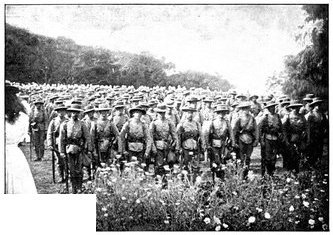
BLUEJACKETS, IN KHAKI, AT SIMONSTOWN, STARTING FOR THE
FRONT.
These are some of the men who fought so valiantly at Graspan. Seamen
strongly object to the khaki jackets, which fit closely around the
neck; a very disagreeable change from the loose-fitting naval jackets.
In charge of the camp and the stores were 800 of the Yorkshire Light
Infantry, an old muzzle-loading 9-pounder, a Hotchkiss 6-pounder, and
150 men of the Engineers and Army Service Corps. When the garrison was
withdrawn from Naauwpoort, these were reinforced by nine 15-pounder
field-guns of the Field Artillery and 400 of the Berkshire Regiment.
The force at the Orange River bridge, sixty miles to the north, which
was now in touch with the enemy, was also strengthened till it mustered
about 2,500 men, composed of the 9th Lancers, Rimington's Guides—a
regiment of horse raised in Cape Colony—the Northumberland Fusiliers,
the Royal Munster Fusiliers, nine guns of the Field Artillery, and an
armoured train.
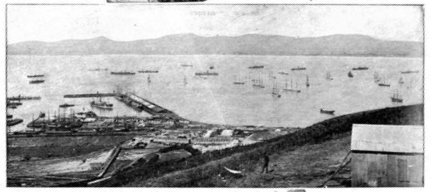
THE DOCKS, CAPE TOWN, November 18, 1899.
Showing transports in the bay and harbour; so many large vessels had
never before been seen in Table Bay. The covered jetty is known as
"The South Arm," and is where all the troops disembarked. Trains ran
alongside, and went direct from the docks to the front.
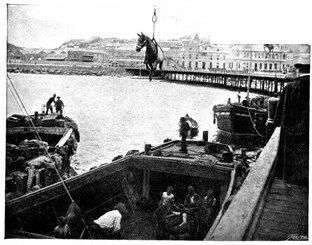
LANDING MULES AT PORT ELIZABETH.
Great numbers of mules, purchased in South America and elsewhere, were
conveyed in special vessels to South Africa for transport purposes.
[Nov. 10, 1899.
The main British camp lay to the south of the river and of the red
iron bridge which spans its muddy waters. To the north the bridge head
was entrenched and held by a small detachment. Away to the[Pg 132] north and
east and west stretched the monotonous veldt covered with sage-green
brushwood, its surface broken here and there by abruptly-rising, stony
hills.
Reconnaissance towards Belmont.
The first encounter with the enemy in this quarter took place on
November 10. On this day a reconnaissance was carried out to the
north-west by a small column under Colonel Gough, 700 strong, composed
mostly of mounted men—cavalry and infantry—and having with it one
field battery. The column left Orange River on the 9th, and, pushing
forward, located a Boer position on a long semicircular ridge, nine
miles to the east of Belmont. Attempts were successfully made to compel
the enemy to disclose the extent of his position and the strength of
his force. For that purpose two squadrons of Lancers threatened the
enemy's left, and 200 mounted infantry his right, while the artillery
opened fire. The enemy replied but feebly. Then the mounted infantry
pushed rapidly forward, hoping to get behind the Boers and cut off
their retreat. More troops were signalled for to Orange River, and at
once all the men remaining in camp were entrained and sent forward.
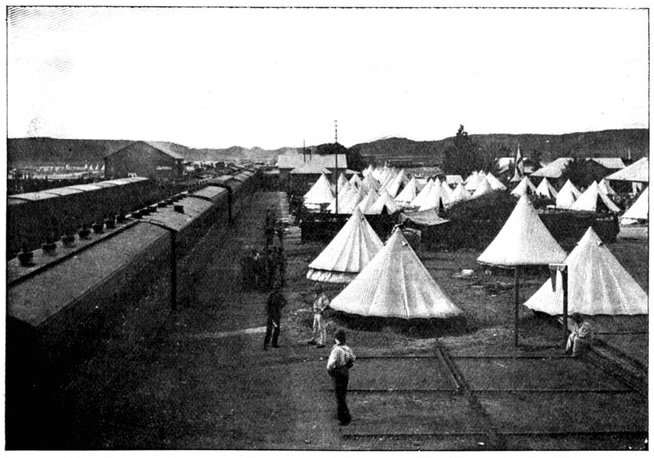
THE NUCLEUS OF A GREAT MILITARY DEPOT. ORANGE RIVER CAMP
IN THE EARLY DAYS OF THE WAR.
Unfortunately, the mounted infantry in their movement failed to make
out a small party of Boers, ensconced behind good cover, and came
under an unexpected and terrible fire, which in a few moments killed
Colonel Keith-Falconer, mortally wounded Lieutenant Wood, and hit two
other officers and two privates. The attempt to outflank the Boers had
to be immediately abandoned—and it was well that it was abandoned.
Colonel Gough supposed he had before him only 700 men and one gun under
Commandant Vandermerwe. Much uncertainty prevailed all through the
war as to the Boer numbers, but it is probable that the force opposed
to him was at least twice and possibly three times as strong as he
supposed.
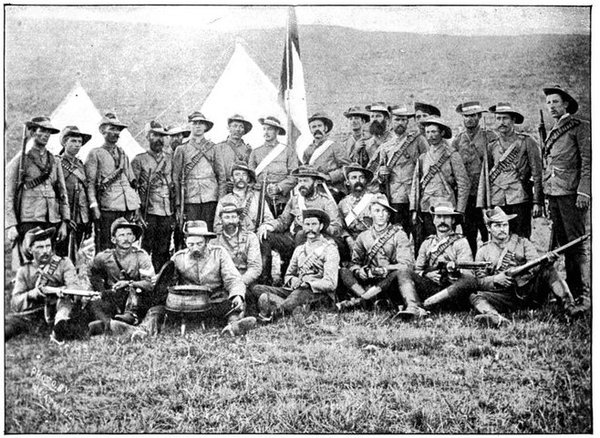
BOER POLICE AT THE FRONT.
Armed with Mausers and cook-pot.
Heavy loss of officers.
Nov. 10-20, 1899.] Lord Methuen Ready to
Move.
The heavy loss in officers on this occasion struck the last blow at
the system of distinguishing officers from men by their equipment and
uniform.[Pg 133]
Though officers and men alike wore khaki, the officers' buttons were
polished till they shone like jewels, whereas the men were forbidden
to polish any part of their equipment; the officers carried swords
with gleaming silver hilts, whilst the men had their rifles carefully
dulled. It followed that the officer was discernible at a great
distance, and the Boers, with very correct military instinct, made use
of this fact to pick them off. A certain number of the best shots with
good field-glasses were detailed for this purpose. In acting thus the
Boers were in no way transgressing the customs of war. In the great
Continental armies instructions are given to the best shots to aim at
the officers, as by the loss of its leaders the best force in the world
is speedily paralysed. Henceforward in all the British columns the
officer was to carry a rifle and to dress exactly like the men. This
measure had immediate effect, considerably reducing the high proportion
of loss in the commissioned ranks, though from the nature of things the
officer, being in front of his men, must always be more exposed than
they.
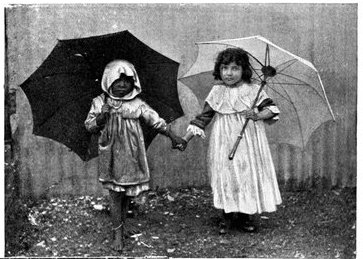
CHILDREN OF THE EMPIRE.
The native question has always been a bone of contention between the
British and the Boers; the latter regard the Kaffirs as mere chattels,
whilst our own rule secures for the natives of Africa, as of all
other parts of our world-empire, the elementary rights of liberty and
justice.
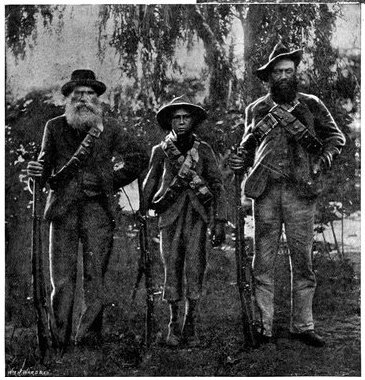
[Photo by Van Hospen.
THREE GENERATIONS AT THE WAR.
Boys of fifteen and sixteen, as well as many grey-bearded men, are
found in the ranks of the Boers. Their method of fighting makes drill
to a large extent superfluous; anybody who can shoot can fight under
their tactics.
Lord Methuen reinforced.
[Nov. 20, 1899.
At length, on November 20, the organisation of Lord Methuen's column
was complete and all was ready for a start. It was composed almost
wholly of infantry, and that the very finest in the British Army.
Its brigades were two in number—the Ninth and the Guards. The Ninth
Brigade, under Major-General Fetherstonhaugh, comprised the 1st
Northumberland Fusiliers—the famous "Fighting Fifth," who for eighteen
months had had but a fortnight in bed, continually facing privations in
Crete, in the Sudan, and wherever campaigning was to be done—the 2nd
Yorkshire Light Infantry, the 2nd Northampton Regiment—with terrible
memories of Majuba—and half the 1st Loyal North Lancashire. The Guards
Brigade, under Major-General[Pg 134]
Colvile, was made up of four Guards battalions, magnificent in
appearance and physique, as gallant in action as well conducted in the
barracks of the Empire's capital—the 1st and 2nd Coldstreams, the
3rd Grenadiers, and the 1st Scots Guards. All the battalions of this
brigade were at full strength, or if anything over strength, so that
Lord Methuen's total force of infantry mustered about 7,500 men.
To support this superb infantry there should have been artillery
galore; to cover its movements cavalry and mounted infantry without
stint. But whereas forty guns were about the right proportion, in the
light of all experience, for the division, its guns were only twelve
in number, of the 18th and 75th Field Batteries. To these were added
four long 12-pounders, in charge of a small naval brigade, composed of
seamen and marines from the ships on the Cape Station, and commanded
by Flag-Captain Prothero, of H.M.S. Doris. The consequences of this
inadequate supply of artillery will be seen at every turn. The heroic
infantry had to be flung upon the entrenched positions of unshaken
enemies, and had to sustain heavy losses. A great price was paid in
British blood for the deficient equipment of our army.
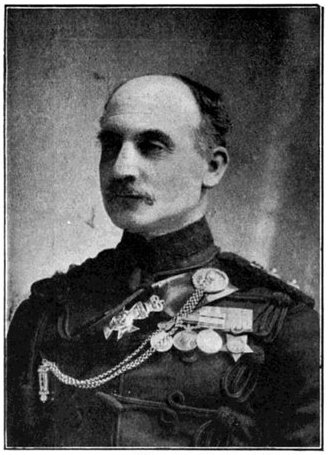
[Photo by Hughes & Mullins.
GENERAL FETHERSTONHAUGH,
Who was severely wounded through the shoulder at Belmont, was in
command of the 9th Brigade at that battle, having been transferred from
Lieut.-Colonel (half pay) of the King's Royal Rifles. He went through
the Zulu War of 1879, and was in the Nile Expedition of 1884-5. He
joined the service in 1867, and was appointed to the 31st Regiment. In
1863 he joined the 60th Rifles, and eventually commanded that regiment.
After his wound at Belmont, his command was transferred to General
Pole-Carew.
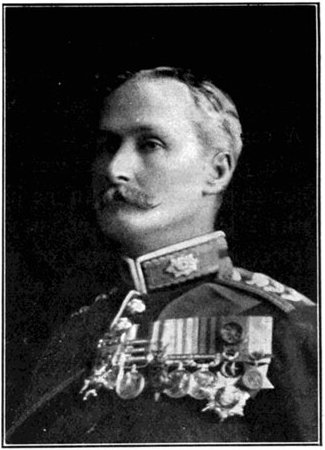
[Photo by H. W. Barnett, Park Side.
GENERAL POLE-CAREW, C.B.,
Was specially referred to by Lord Methuen for his services at the
passage of the Modder River. His command of the 2nd Battalion
Coldstream Guards only terminated last year; he had entered that
regiment as Ensign in 1869. During the Second Afghan War he acted as
A.D.C. to Lord Roberts; and to H.R.H. the Duke of Connaught in the
Expedition against Arabi Pasha. He went through the Burmese War of
1886, and for his gallant conduct was awarded the C.B.
Of mounted men there were a hundred or so of Rimington's Scouts, two
squadrons of the 9th Lancers, and some companies of mounted infantry.
In all they may have totalled 500 men. Yet in the European proportion
more like 1,500 cavalry were required, with a couple of batteries of
horse artillery. Of horse artillery there was none at all, nor was
there a single howitzer with the column. These facts, evident to all,
raised in the minds of a few sinister doubts as to the future success
of the column, which doubts were only too painfully justified by
events. It was clear from the start that no victory could be followed
up, and no decisive blow inflicted. Yet here as elsewhere the generals
and the men anticipated swift and certain success. The Boers before
them were believed to be weak in numbers, ill-organised, and of low
fighting capacity. The rapid advance to Kimberley would, it was
thought, be scarcely contested.
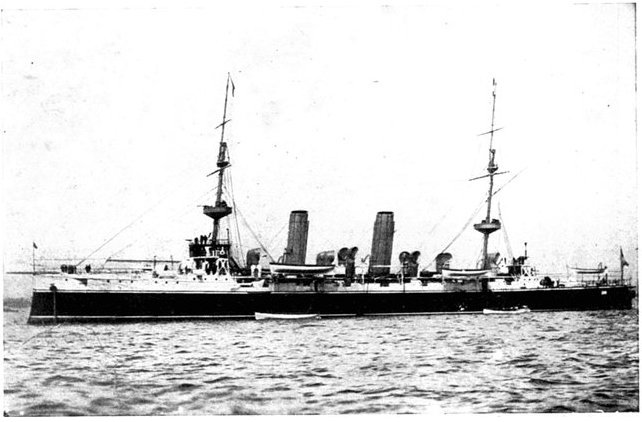
[Photo by Cribb.
H.M.S. "DORIS."
The "Doris," the flagship of Rear-Admiral Harris at the Cape, supplied
the commander and some of the men who fought under Lord Methuen, and in
the Admiral's cabin Cronje was confined after his surrender.
Nov. 20-21, 1899.] Nearing the Enemy.
The column was, in consequence, to march in the lightest possible
order. Baggage and stores were cut down; officers were to have no
tents; Lord Methuen himself was to set the example of sleeping in his
cloak in the open; the men were[Pg 135] loaded as lightly as possible. The
regiments marched without bugle or drum, as it was feared that the
sound of these instruments would give information of movements to the
enemy.
At midnight of the 20th-21st, the column stood to arms, 9,000 strong,
waiting the order to advance. Lord Methuen had always been a great
believer in night marches and night attacks upon the enemy, and on
this campaign seized the first opportunity of putting his ideas into
execution. Then for hours the column waited under the star-lit sky. At
two the moon rose, but still no order came. The serpent-like array of
men, horses and guns waited, silent, immobile—waited impatiently. At
last, soon after 2·30, the long-looked-for order arrived. The Guards'
Brigade, with the cavalry and artillery, strode off through the scented
night; as day was breaking over the kopjes to the east, the Ninth
Brigade followed.
Advance to Fincham's Farm.
The first day's march was a short one of nine miles to Fincham's
Farm or Witteputts, half way between Orange River and Belmont. Yet,
though short, it tried the men severely. As the sun rose the heat grew
tropical, and water there was none till Fincham's Farm was reached. The
line of route lay across the undulating, thirsty veldt, sand-floored,
overgrown with brown scrub, along the foot of perpetual kopjes. Nothing
was seen of the enemy, yet the Boer scouts dogged the column and noted
its every movement.

A NOTED SCOUT.
Sergeant Cunningham, of Rimington's "Tigers." They are so called from
the fact of their wearing a piece of tiger skin around the hat.
At Fincham's Farm the column halted for the night, and next day marched
to Belmont. Here it was known that the enemy would be found and a
battle fought. While the infantry marched into camp, Lord Methuen
pushed forward with the two batteries of artillery and the naval guns,
and carefully examined the Boer position.
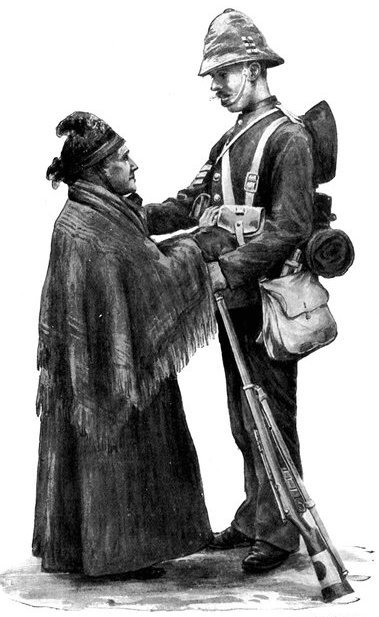
[Photo by Gregory.
HIS MOTHER'S FAREWELL.
A soldier of the Scots Guards ordered on active service.
[Nov. 21-23, 1899.
Some miles to the east of the railway rose a line of kopjes running
north-west and south-east—to the north known as Table Hill, in the
centre as Gun Hill, and to the south afterwards called Fryer's Kopje.
These were held by the Boers. Behind rose a second and loftier line of
heights, broken in the centre by a deep "nek" or pass, in which was
known to be the Boer laager. This line of heights was defended by stone
breast[Pg 136]works, and was also held by the enemy. The key to it was Mont
Blanc, to the south-east of the nek.
Lord Methuen took every precaution to prevent the enemy from guessing
the proximity of his 9,000 men. Only the artillery moved forward, and
in a futile way shelled the foremost line of kopjes. Our guns were,
as in every battle of the war, outranged by the enemy's artillery.
A big weapon in the hands of the Boers made superb shooting, and
had the projectiles and fuses been good, would have inflicted heavy
loss. As things were, there were only two men wounded in the British
force, whereas the enemy had six killed or wounded. The latter figure,
however, must be entirely conjectural.
The infantry in camp, meanwhile, received orders to march out at 1·30
a.m. of the next day, the 23rd, to deliver an attack upon the enemy at
dawn. This was the first occasion upon which most of the men had ever
been engaged. So far they had faced only discomfort; now they were to
confront mutilation, pain, and sudden death. They were to learn what
war was: "It was not play. It was not pleasure. It was not sport under
the greenwood tree, but a savage encounter with desperate adversaries,
who dealt death and grievous wounds with impartial hands." Yet these
thoughts depressed and saddened few in the camp; rather, perhaps, the
excitement tended to raise their spirits. From general to private all
looked forward to the breaking of the day and the coming of the moment
when the flower of the British Army should measure its strength against
the detested Boer.
The army had out-marched its transport, and that night the men had
little or nothing to eat. They filled their water bottles, left
behind their great-coats, and, some time later than the appointed
hour, marched silently forth into the darkness in one long line, the
Northumberland Fusiliers on the left, the Northamptons and Yorkshires
in the centre, and the Guards on the right. No words were spoken; no
sounds made; yet now and again the creaking of the waggons startled
the soft night air and gave more audible warning than a multitude of
talking men. Again, when the railway was crossed, the wire fence had to
be cut away with an axe, as it seems that our troops were not equipped
with wire-cutters. This made a tremendous noise and might have been
heard miles away; so that the enemy could not but have been very well
aware of the advance of the British.
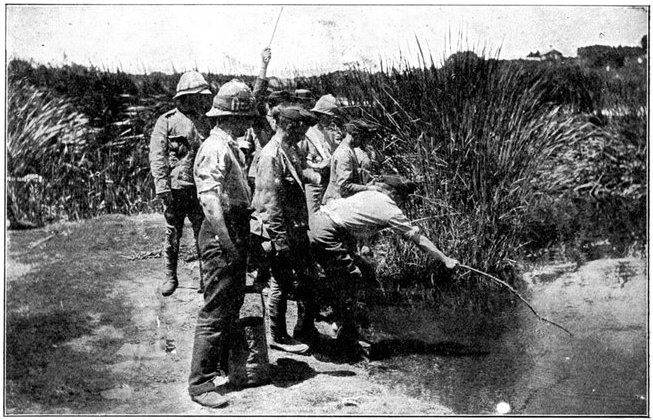
[Photo by J. E. Bluton, Capetown.
PLAY.
Tommy can fish for sticklebacks with as much zest—and as little
art—in South African waters as in the fountain in Bushey Park or the
Thames at Hammersmith.
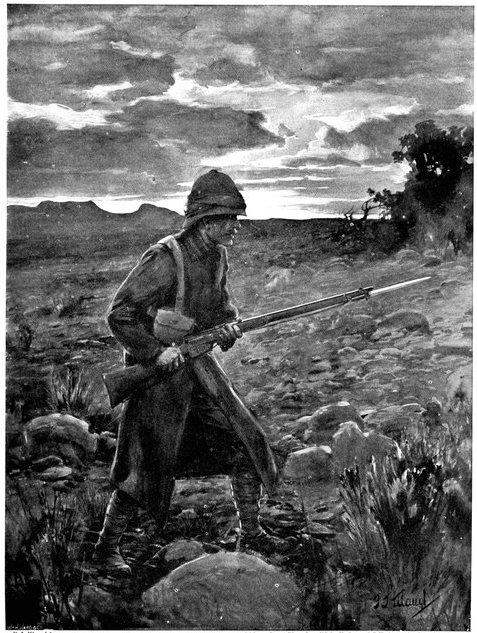
F.J. Waugh.] [
After a Stereo-Photo from life by
Underwood & Underwood. Copyrighted 1900.
DEADLY EARNEST.
The lonely sentinel on the wide veldt experiences many a nerve-shaking
terror in the still night hours, knowing as he does that he is
surrounded by subtle foes, accustomed to find sufficient shelter in any
scrap of scrub or stone.
[Nov. 23, 1899.
And now over the kopjes before the British Army broke the untimely
day. The land lay silent, and, as the line pushed forward, the little
"dikkopfs" rose from the veldt with their melancholy cry. All chance of
surprise had gone. Dawn had come and found the British troops not close
upon the enemy's position, but some distance away. That distance would
have to be crossed in daylight under a murderous fire. The men advanced
in open order to assault the first line of kopjes, where as yet no sign
whatever of the enemy could be discovered. "A death-like silence," says
Mr. Kinnear, the Central News correspondent with the column, "hung over
all. Nothing was to be heard but the swish, swish, in measured cadence
of the soldiery as they brushed through the low bush. An order was
issued by the commanders of battalions to 'Withhold fire and attack
with the [Pg 137]
[Pg 138]bayonet.' ... And still the Boers were silent in their
trenches and our artillery refrained from speaking out."
Puzzling as was the silence of the Boers, the silence of the British
artillery was still more curious. The soldier in his attacks likes to
hear the roar of his own guns; it gives him moral courage and a sense
of support. He dislikes an enemy who awaits his onset in absolute
silence and withholds fire till the last moment. Upon the kopjes no
enemy could be discerned; the hills seemed so many huge lifeless
stone-heaps, tenanted only by scorpions and lizards.
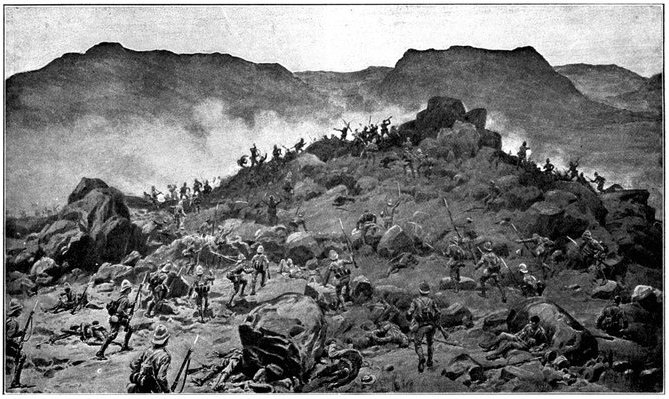
F. Dadd, R.I.] [From a Sketch by a British Officer.
THE BATTLE OF BELMONT.
The line of infantry reached the foot of the kopjes and began the
ascent, each man four paces from his neighbour, without supports or
reserves. At this instant the slopes burst into flame, and a strange,
unearthly crackling and sputtering ran along the front of the advancing
soldiers. "You could see nothing but men dropping all round you,"
writes a private in the Scots Guards. This fire at close ranges should
have been annihilating, and yet, as a matter of hard fact, not very
many men went down. The Boers seemed to be nervous and alarmed at the
steady and determined approach of our infantry; after the first few
rounds they shot most indifferently and failed to use their splendid
opportunity. They had almost complete shelter behind great boulders and
stone walls, whereas our troops had to scale on hands and knees the
steep and stony slopes. In the assault the Grenadiers, who were in too
close formation, suffered most.
British victory at Belmont.
Nov. 23, 1899.] Incidents of the Battle.
The British troops with a roar of cheering reached the summit of the
kopjes and used their bayonets upon the Boers, whom they caught amidst
the boulders. Here fell Private St. John, a famous boxer, in hand-grips
with the enemy. Writes a brother private of his battalion:—"At the
battle of Belmont we fought hand to hand. I was just behind David St.
John when he was shot. He stuck his bayonet right through a Boer and
could not get it out again. He tried to throw the man over his shoulder
to get him off, and then another Boer came up and shot him through
the head. Then another of our men put his bayonet through that Boer's
heart." But the main body of the enemy had already discreetly retired.
The Boers with their agile little ponies could wait till the stormers
were close upon them, and then leap upon their steeds and gallop off to
their fresh position in the rear, thus baulking our[Pg 139] soldiers of their
prey at the very moment when against any other enemy the battle would
have been gained. There was not cavalry or horse artillery to drive
home the blow and keep the foe "on the run." And thus the fight had to
be fought over and over again.
Halting on the summit, to give time for the artillery, which had
now been ordered to open fire on the high ground beyond the line of
kopjes, to do its work, the infantry re-formed, while a heavy shrapnel
fire was poured in upon the enemy's second position. The Boer guns
responded vigorously, but without doing much harm. An artillery duel
of an hour-and-a-half's duration followed, yet it cannot be said that
any full or complete preparation for the assault was achieved by the
British guns. They were too few in number, and they fired for too short
a time. About 5·45 a.m. the advance was resumed.
Chaplain Hill's bravery.
This time the fighting was harder and the men suffered more. The Ninth
Brigade lost its general, Fetherstonhaugh, wounded while leading. He
had cantered up and down his fighting line attended by his staff, and
so doing drew a severe fire from the enemy upon his men, who could not
reply from fear of hitting him. At last a soldier in the ranks shouted
in humorous indignation, says Mr. Kinnear, "—— thee! Get thee to——,
and let's fire!" Mont Blanc was stormed by the 1st Coldstreams with
splendid dash, while the Northamptons and Northumberlands attacked
a high ridge to the south of it. Here Chaplain Hill, of the Ninth
Brigade, covered himself with honour. He followed the fighting line
and administered the last consolation of the Sacrament to the dying,
standing erect where no man dared to show himself amidst the hail of
bullets. It was a noble and inspiring picture; the fallen soldier prone
in the grip of death; the priest upright and serene; around on every
side the tumult of battle and the rush of the storming line. "Get
down," shouted an officer to the chaplain; "you have no right to risk
your life." "This is my place and I am doing my special business," was
the answer. And the bullets left him unscathed.
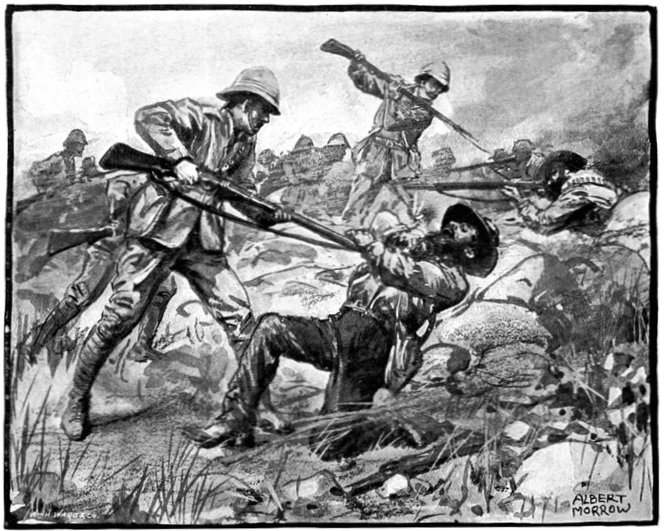
A. Morrow.]
DAVID ST. JOHN KILLED WHILE BAYONETTING A BOER.
Contraventions of usages of war.
[Nov. 23, 1899.
As the ridge of the second position was gained, the Boers once more
took to flight, carrying with them, for the most part, their killed and
wounded. A few small parties were, however, cut off and made prisoners.
At this juncture there was the usual and apparently inevitable abuse
of the white flag. One was raised when the British storming line was
only fifty yards away. Our men at once ceased fire, whereupon a shot
was fired at our men by one of the party which had raised the white
flag. Nor was this an isolated incident. Colonel Crabbe, of the 3rd
Grenadiers, and Lieutenant Willoughby were slightly wounded by men
who fired upon them under cover of the white flag; Mr. Knight, the
gallant correspondent of the Morning Post, was shot in the arm with an
explosive bullet in the same manner. But even more[Pg 140] horrible treachery
was displayed by a wounded Boer to Lieutenant Blundell. That officer
stooped to give his disabled enemy a drink of water, when the Boer shot
him, inflicting a mortal wound.
While the storming of the second ridge was proceeding, the Naval
Brigade rendered valuable aid by shelling the enemy's position at
1,800 yards. The field artillery, too, poured in a heavy fire. Nothing
was more admirable than the manner in which the British infantry went
forward under a perfect tempest of bullets and carried one after
another of the Boer lines of defence with never a check. The men
cheered at each rush; as they mounted the slopes, through the crackle
of the musketry came, from the rear, the stirring tunes of a regimental
band. It was the Scots Guards' band, stationed well behind the firing
line, the only one that played its regiment into action.
"By George! A British infantryman is a plucky chap!" wrote an artillery
officer of this stage of the battle. "The bullets were coming quite
thick enough for us where we were, so you can tell what it was like for
them climbing those hills. I believe our fire helped the Coldstreams a
lot in driving out the Boers; anyhow, they have written to thank us for
having lessened much their losses. After the place was taken the Boers
were off down the other side like lightning and away. We went round to
the right flank of the hills and saw them a long way off on another
range of hills. Eventually we started back to camp about 10·30 a.m. and
watered horses, arriving back about 1·30. The left flank was carried in
much the same way. Altogether, it was rather a good battle. The place
we attacked is, I believe, called Kaffirs' Kop. We were in action, I
suppose, about an hour. I was surprised at not feeling more alarmed; as
a matter of fact, one has too much to think about."
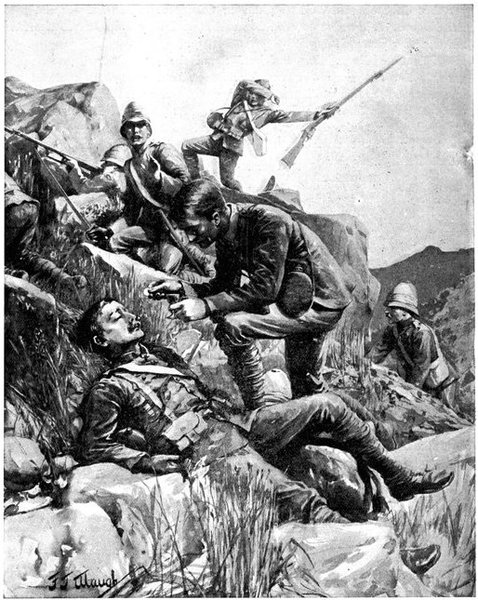
F. J. Waugh.]
CHAPLAIN HILL'S ACT OF DEVOTION.
Administering the Sacrament to a dying soldier under heavy fire.
After the second position of the enemy had been stormed, yet a third
was captured by the Guards, covered by the heavy fire of the artillery.
This terminated the fighting.
[Pg 141]
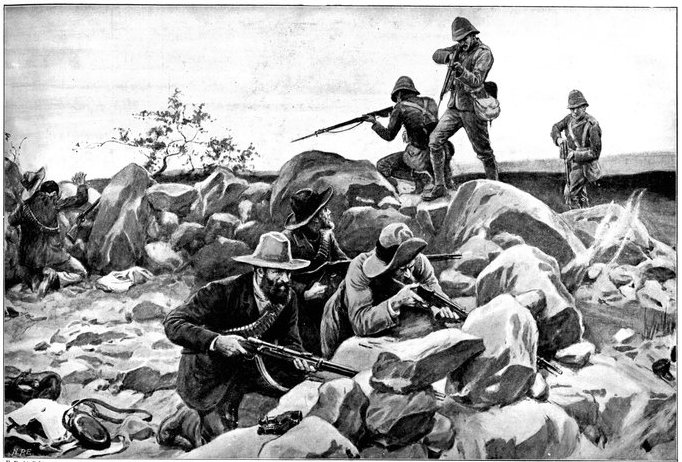
F. Dadd, R.I.] [From a sketch by a British Officer.
BOERS SURPRISED ON A KOPJE AT BELMONT BY THE GRENADIER GUARDS.
[Pg 142]
[Nov. 23, 1899.
Boers retreat.
About 6 a.m. the enemy was in full retreat and the battle was won. It
remained to follow up the victory, but unhappily the Lancers were too
few and too exhausted with their hard work to inflict much damage. It
has since been asserted by Boer prisoners taken at Paardeberg that all
their guns might have been captured. They expressed contempt for our
cavalry, but perhaps they did not understand the difficulties which
it had to face. Be this as it may, the Boers were able to get away,
leaving behind them, however, sixty-four waggons and a large quantity
of ammunition. The waggons were destroyed and the ammunition exploded
by Lord Methuen. Eighty-three Boers were said to have been killed and
twenty wounded, and about thirty unwounded prisoners were taken. Among
these were a German commandant of artillery and six field cornets.
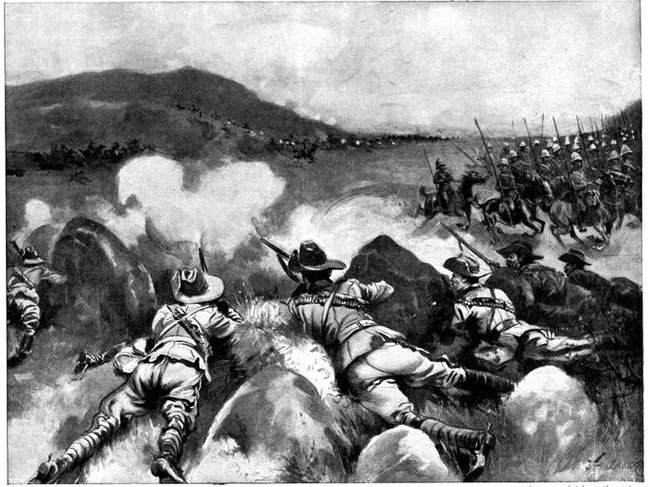
J. Finnemore, R.B.A.] [
After a sketch on the spot.
THE NEW SOUTH WALES LANCERS' BAPTISM OF FIRE.
The New South Wales Lancers first saw active service at Belmont, where
they covered the retirement of the 9th Lancers, who, in attempting to
cut off a number of Boers, were in turn pursued by them.
The British losses were heavy considering the immense numerical
advantage which Lord Methuen possessed, and of which little use was
made. Fifty-three officers and men were killed and 245 wounded, of
whom twenty-two died of their wounds. The scene after the battle was a
very sad and terrible one. It is thus described by Mr. Kinnear:—"The
Boer rifles appeared to have got in chiefly in the abdomen and lower
limbs. The khaki was dyed so deeply with crimson that some of the dead
and wounded must have received more than half-a-dozen shots. Indeed,
it was frequently discovered through the campaign, notably in the case
of officers, that they had been hit five or six times. This proves, I
think, that in spite of the order removing badges and other marks of
rank, the keen-eyed enemy is able to spot and pot his man."
Nov. 23, 1899.] Frontal Attack not Intended.
The dead lay tranquil as if overcome by Death's twin brother Sleep.
Silence came upon the victorious soldiery as they turned their gaze
upon these sad victims of the conflict, who had offered[Pg 143] up the last
and greatest sacrifice that man can make. The wounded, too, were
silent. Few complained; they bore their pain with stoicism, or even
made light of their wounds. Lieutenant Russell, with his face streaming
blood, maintained that he had nothing more than a scratch. The
ambulance corps and bearers moved to and fro amongst them, bandaging
the wounds, administering relief, and preparing them for passage down
to Wynberg, whither all the less serious cases were despatched by the
hospital train.
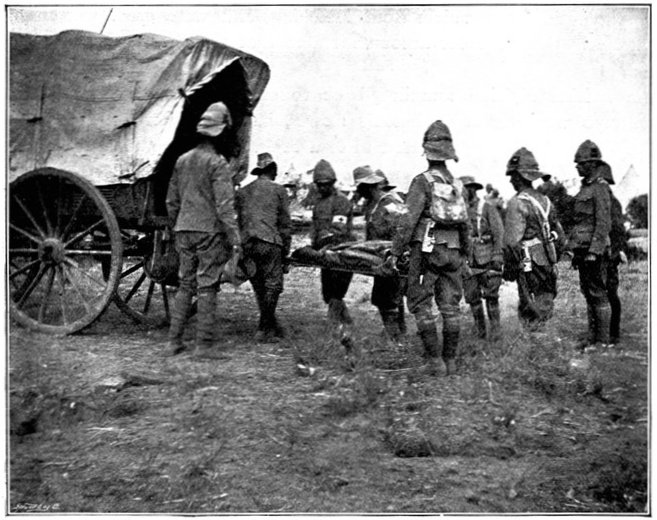
REMOVING THE DEAD.
Frontal attack criticised.
From the first the wisdom of "taking the bull by the horns," or
attacking full in front the Boer positions, was questioned in England.
It was asked why did not Lord Methuen, with quite three men to the
enemy's one, surround them, or only make a demonstration in front while
delivering his real attack from the flank. Again, if he determined
to attack in front, it was questioned why he did not make a greater
use of his artillery, instead of flinging his superb infantry upon an
intact and entrenched enemy. By a fuller artillery preparation, it was
said, many lives might have been saved, and not impossibly the Boers
might have been dislodged with infinitesimal British losses. Some of
these doubts have not yet been answered, but from Lord Methuen's own
despatches it is clear that the frontal attack was not of his planning.
He meant to fall upon the enemy's flank, but here, as at Stormberg, a
succession of accidents prevented the general's original intentions
from being carried out, and rendered the task of the infantry very much
harder. In attacking, at all costs, when it was evident that the Boers
were on the alert, and when the intended flank movement had failed,
Lord Methuen wished to show the enemy that the British soldier was
morally his superior; that no position of whatever strength could stop
the British Army, and that an invisible foe, raining death upon our men
in the open, was no terror.

MAUSER CARTRIDGE.
The charge is of "smokeless powder" (hornified nitro-cellulose).

LEE-ENFIELD CARTRIDGE.
Charged with cordite (nitro-glycerine and guncotton).

DIAGRAM SHOWING THE "RIFLING" OF A LEE-ENFIELD RIFLE.
The spiral grooves cause the bullet to rotate rapidly on leaving
the barrel. The twist of the rifling in a Mauser runs the opposite
way; this latter weapon weighs nearly ¾ lb. less than the British
(Lee-Enfield) pattern, and the bullet leaves the muzzle at a velocity
of 2,034 feet per second as against 2,000 feet, the speed in the case
of the Lee-Enfield.
[Nov. 23, 1899.
The moral effect upon the Boers was, in fact, considerable, though not,
perhaps, so great as the British staff at the time supposed. A prisoner
told the British soldiers that the Boers believed in their ability
to hold their position against all the armies of the world. They had
expected the arrival[Pg 144] of General Cronje with four or five thousand
Transvaalers from Mafeking, and were greatly incensed at his failure to
put in an appearance. Official Boer accounts stated that twelve Boers
only were killed and forty wounded.
After its baptism in blood the British division marched back to camp,
leaving behind it the battlefield over which the great vultures were
already wheeling slowly, having gathered swiftly and strangely from all
quarters. In camp Lord Methuen delivered to it a brief, soldierly, and
sympathetic address:—
Lord Methuen congratulates the troops.
"Comrades," he said, "I congratulate you on the complete success
achieved by you this morning. The ground over which we have had to
fight presents exceptional difficulties, and we had as an enemy a past
master in the tactics of mounted infantry. With troops such as you are,
a commander can have no fear as to the result.
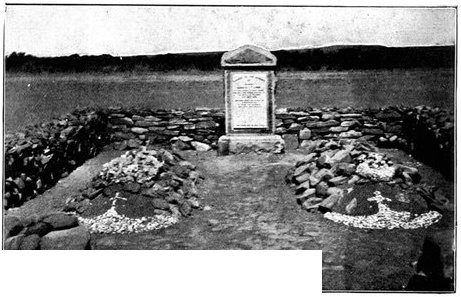
GRAVES OF THE SOLDIERS KILLED AT BELMONT.
Erected by the Duke of Edinburgh's Own Volunteer Rifles.
"There is a sad side, and you and I are thinking as much of those
who have died for the honour of their country, and of those who are
suffering, as we are thinking of our victory."
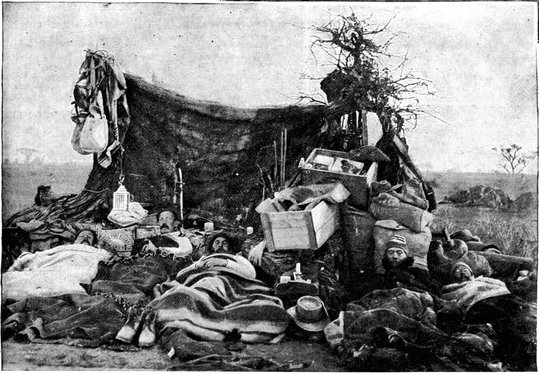
SLEEPING OUT ON THE VELDT.
How our soldiers make themselves comfortable—when they can.
And not they alone were thinking of the dead and the wounded. When
it became known in London that the Guards' brigade was likely to go
into action, large and anxious crowds began to assemble about the War
Office in Pall Mall, and to besiege the lobby where the casualty lists
are usually posted. Not for many years had scenes so sad and pathetic
been witnessed in that temple of official routine. Many of the men
had friends and relatives in London, and thus the capital was moved
by a stronger personal interest than in the case of regiments whose
headquarters are in the provinces.
The misuse of the white flag and the fact that not a few of his men
had been wounded with "dum-dum" or expansive bullets drew from Lord
Methuen a dignified letter of protest which he addressed to the Boer
commander, but which unfortunately did not have the effect of stopping
the practices complained of.
[Pg 145]
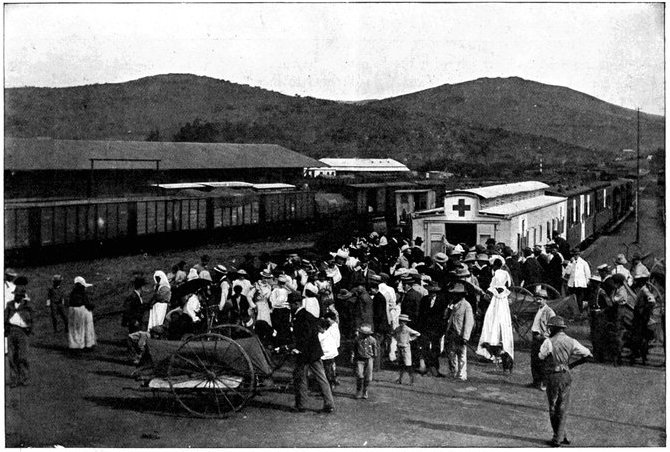
ARRIVAL OF A TRAINLOAD OF WOUNDED BOERS AT PRETORIA.
CHAPTER IX.
LORD METHUEN'S ADVANCE—continued.
March to Swinks Pan—Advance of Ninth Brigade—Battle
of Enslin—Bombardment of the Boer
position—Reinforcements sent for—The Bluejackets
and Marines take the kopje—British losses—The Queen
congratulates the Naval Brigade—Boer losses—Lack
of water at Enslin—Lord Methuen's address to
the troops—March to Klokfontein—Lord Methuen's
available forces—The Boers in force at the Modder
River—Disposition of troops—Scene of the battle—Boer
preparations—Battle of the Modder—The torture of
thirst—Sleep during battle—Arrival of an additional
Field Battery—Attempts to cross the river—Retreat
of the Boers—Comparison of British and Boer
losses—British artillery fire—Characteristics of the
fighting—The Boers fire on the Red Cross—Conduct of
the Free Staters impugned—Kruger's remonstrances.
March to Swinks Pan.
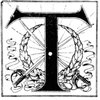
The night of the 23rd and morning of the 24th were spent in camp near
Thomas' Farm while the Engineers, supported by the armoured train,
repaired the railway line. In the afternoon of the 24th the camp was
struck and the force marched seven miles north to Swinks Pan, over the
waterless veldt, leaving the 1st Scots Guards and two companies of
Munster Fusiliers—who had come up from Orange River—to hold Belmont
station, in the neighbourhood of which there was still a small Boer
force 500 strong. This day the armoured train had a brush with the
Boers, in which three officers and men were killed or wounded. At
Swinks Pan there was a good water supply, and there the column halted.
Away to the east rose kopjes, which, the scouts had ascertained, were
held by Boers. The enemy's strength, however, could only be guessed
at; it was placed at 400 men. Events showed very plainly that this was
a ludicrous underestimate. The Boers had closely dogged the column,
though rarely or never seen. At Swinks Pan traces of their presence and
smouldering camp fires were discovered, showing that their scouts had
been close at hand.
[Nov. 25, 1899.
That night the column received orders to be under arms at dawn, when a
move was to be made for Graspan, where was the enemy's position. The
Boer force being believed insignificant, only the Ninth Brigade, with
the artillery, cavalry and mounted infantry would, it was thought, be
required.[Pg 146]
The Guards were accordingly left with the baggage—they had done the
hardest work at Belmont and had fully earned the right to a rest—and
were directed to march north to Enslin, which was to be the next
halting point.
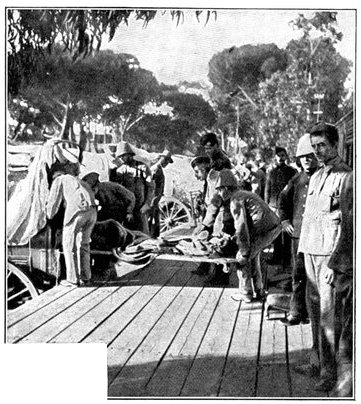
DETRAINING THE WOUNDED AT WYNBERG.
Advance of the Ninth Brigade.
Soon after 6 a.m. of the 25th, the Ninth Brigade found itself in
front of the Boer position. This lay along a line of low but steep
hills; upon the extreme left, connected with these hills by a long,
grassy ridge, was a small, stony kopje, which is thus described by
Colonel Verner: "Five hundred yards from the kopje's summit the
plain rose gradually, and scattered boulders were to be seen. Two
hundred yards nearer, the slope steepened and the boulders were more
numerous. Another hundred and fifty yards and the slope became almost
a precipice—a mass of rock and scree—and could only be climbed on
hands and knees in many places. Here and there were vertical patches
of cliff; everywhere rocks and boulders gave fine cover." Here, it was
afterwards discovered, was posted the old guard of the Boer force—a
party of 300 Transvaalers, but recently arrived from Kimberley. The
enemy's strength was actually between 2,000 and 3,000, with one
heavy gun, five field guns, a Maxim 1-pounder automatic—the dreaded
"Pom-Pom" which Lord Methuen's men were now to face for the first
time—and a rifle-calibre Maxim. The Boers were under the command of
General Delarey; they appear to have been a different force from that
which had fought at Belmont.
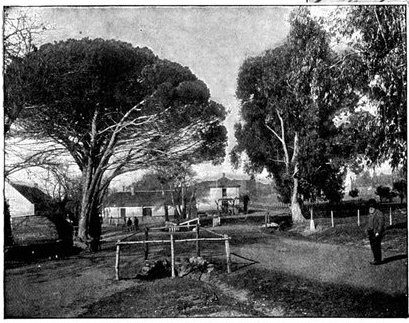
THE VILLAGE OF WYNBERG.
Battle of Enslin.
Bombardment of the Boer position.
Nov. 25, 1899.] Trying to Silence an Unseen Gun.
In consequence of the heavy loss which he had sustained in storming
the kopjes at Belmont without full artillery preparation, Lord Methuen
brought up his field batteries and two naval guns, and opened the
battle by a prolonged bombardment of the Boer position. Already, about
6 a.m., the enemy had fired the first shot at a party of Rimington's
Scouts who ventured within range. The field-guns began their work at
a range of 2,500 yards, and then closed in to 1,500. The naval guns
opened at 5,000 yards and closed to 2,800. The Boers vigorously replied
with their guns, but as these were scattered and not massed together,
as they furthermore fired smokeless powder, and were in some cases
posted just behind the crest of the ridge, they were almost impossible
to locate. Indeed, in this battle, as in the Belmont action, the
enemy's invisibility was nerve-shaking. There were no masses of men
to be seen and made into targets; no gleaming array of guns invited a
deluge of projectiles. But for the crackling roar and the quick, heavy
banging of the "Pom-Pom" and the field-guns, but for the[Pg 147] flashes of
fire from the rifles, the line of kopjes might have been the haunt of
only the little "dikkopf" and the great South African vulture.
The feature of the artillery fight was a duel between the "Pom-Pom"
and the 18th Field Battery. "The Boer gun," says Mr. Julian Ralph,
the brilliant correspondent of the Daily Mail, "was never seen, and
the man who served it never once saw us. His piece was hidden beyond
the ridge on the further slope, and a comrade gave him his range and
direction. For a long time this gunner devoted his attention to one
of the field batteries. Next he attacked the black mass made by their
horses and limbers. Later he paid his respects to the naval gun and its
crew. He never achieved perfect excellence, for he did no damage to
any British gun; he killed but two horses in the field, and he wounded
but five of our men altogether. And yet he got his range so quickly
and well, and he was so persistent and so wholly invisible, that our
men set their teeth in grim determination to destroy him. They had
for a target nothing but the thin smoke which rose over his gun, but
into that little floating cloud they planted shot and shell, until at
the end of the day they had given out 210 rounds, if I remember the
extraordinary figure correctly. All the other Boer guns were silenced
before this one was, and at twenty minutes to ten this was silenced and
every gun of the enemy was speechless."
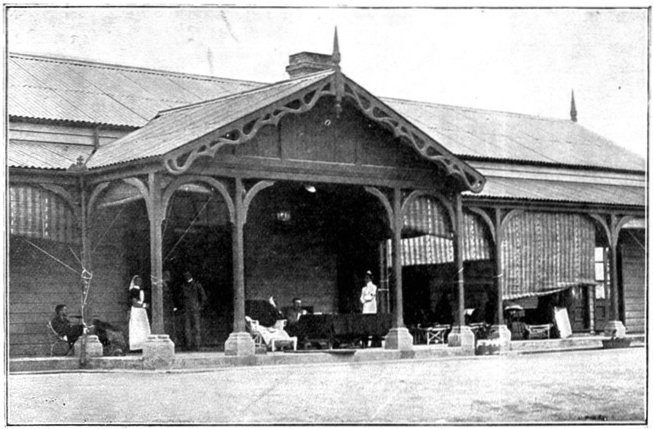
NO. 1 BASE HOSPITAL, WYNBERG.
Where our wounded officers are nursed.
Says an officer in command of one section (two guns) of the 18th Field
Battery:—"I had a warm time of it, from a quick-firing gun, firing
one-inch common shell, but luckily all the rounds (about 100) fell
just about 100 yards beyond my guns. We didn't get a scratch. In the
meantime I plugged away at the right hand line of kopjes, but couldn't
for the life of me see where their cursed little gun was."
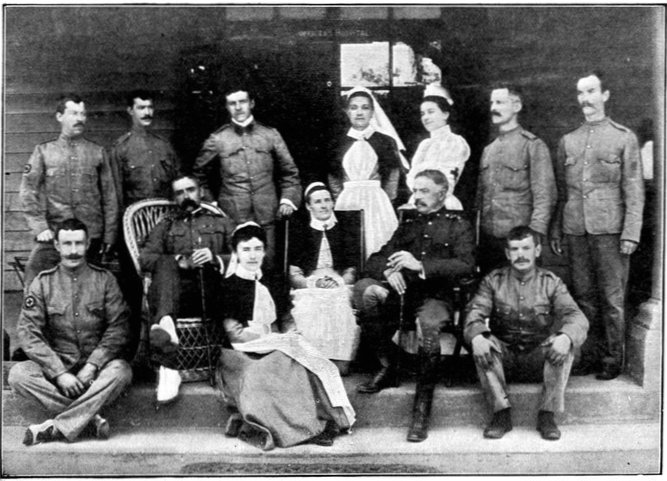
[Photo by Fyne, Capetown.
STAFF OF THE OFFICERS' HOSPITAL AT WYNBERG.
[Nov. 25, 1899.
Reinforcements sent for.
Noting the intensity of the artillery and rifle fire,[Pg 148] and receiving
reports that a fresh commando of the enemy was advancing from the
north-east and threatening his rear, Lord Methuen came to the
conclusion that the Boer force before him was far stronger than 400.
Accordingly he heliographed orders back to Belmont to the battalion of
Coldstreams and to the Guards' Brigade, now on their march to Enslin,
for them to hasten immediately to his help.
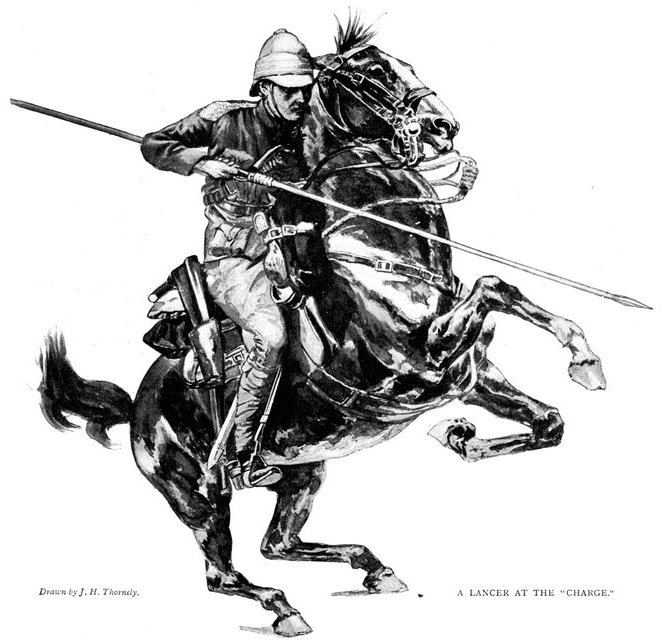
Drawn by J. H. Thornely. A LANCER AT THE "CHARGE."
The British artillery fire soon appeared to get the Boer fire under.
From the first the enemy had wasted ammunition at absurd ranges upon
our guns with but little effect, seeming more intent on fancy shooting
than upon doing any real damage. To all who watched the bombardment of
the kopjes it appeared impossible that any living thing could be left
upon them. A perfect hailstorm of shrapnel descended upon the stony
slopes, yet, as was afterwards discovered, with but inconsiderable
effect. The Boers had for the most part fallen back from the slopes
which faced our guns to the other side of the ridge, where they lay
behind the boulders in almost complete security.
[Pg 149]
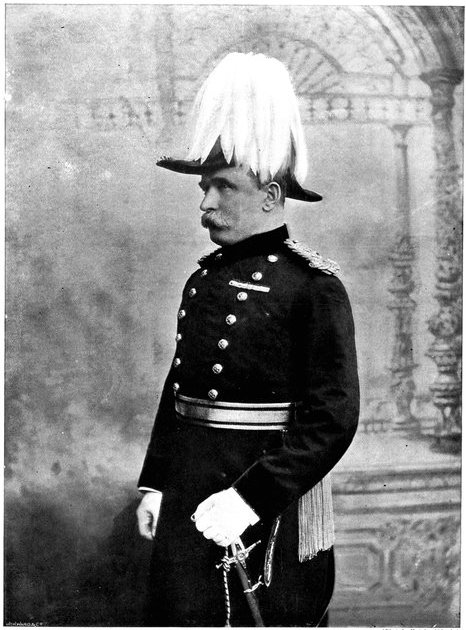
[Photo by Knight, Aldershot.
GENERAL FRENCH.
A brief sketch of General French's career is given on p. 30 of this
work. He was in command of the forces which routed the Boers at
Elandslaagte; left Ladysmith by the last train which succeeded in
getting out of that town before it was invested; took up the command of
the forces operating in the Colesberg district, November 10, 1899; led
the cavalry division which effected the relief of Kimberley, under Lord
Roberts's orders, February 15, 1900, and helped to enclose Cronje and
compel his surrender, February 27. He has since taken an active part in
the operations around Bloemfontein and Wepener. He has the advantage of
leading that arm—cavalry—which is able to meet the enemy on something
like equal terms; but his operations have been crowned with an amount
of success which marks him out as a specially able commander.
[Pg 150]
[Nov. 25, 1899.
About 7 a.m. the infantry began to work forward under cover of the
artillery fire, to assault the isolated kopje upon the left of the Boer
position. The Boer right was merely watched by five companies of the
Northumberlands; the Yorkshire Light Infantry, marines and seamen of
the Naval Brigade, and North Lancashires were concentrated against the
kopje. The Naval Brigade led the storming force, extended in a single
line, each man six paces apart from his neighbour on either hand. "As
the line passed me," writes Colonel Verner, "I noted how each hard,
clean-cut face was from time to time anxiously turned towards the
directing flank, so as to satisfy each individual that the interval
and dressing were properly kept.... No better kept line ever went
forward to death or glory." As they began the ascent, advancing by
brief rushes in very open order, the hill suddenly appeared to swarm
with enemies; from the crest, from behind every boulder, poured a
murderous fire. The naval officers of the brigade still carried swords
and could be readily distinguished; they were the target of every Boer
rifle. "In the breathing time between the rushes of the assailants,"
says Colonel Verner, "one conspicuous figure was to be seen standing
erect, and marking the station taken up by the Naval Brigade. This
was their commanding officer, Captain Prothero, R.N., a man of great
stature and immense physique, who elected thus to stand leaning on
his walking-stick while his men, lying prone, gathered breath for
another rush.... Eventually the inevitable occurred and he was seen
to drop, happily only wounded and out of action for a time." It was
at this point that Commander Ethelston of the Powerful was hit
half-a-dozen times and killed, and that Major Plumbe of the Marines,
who was gallantly leading in front of his men, closely followed into
the storm of battle by his little terrier, staggered, shouting to his
superb soldiers not to mind him, but to advance. He never rose again.
There too fell Captain Senior, side by side with his field officer. So
terrible was the fire, so annihilating its effects upon the Brigade,
which had drawn into closer and closer order as the hill steepened and
the space narrowed, that the order was given to retire upon the last
cover.
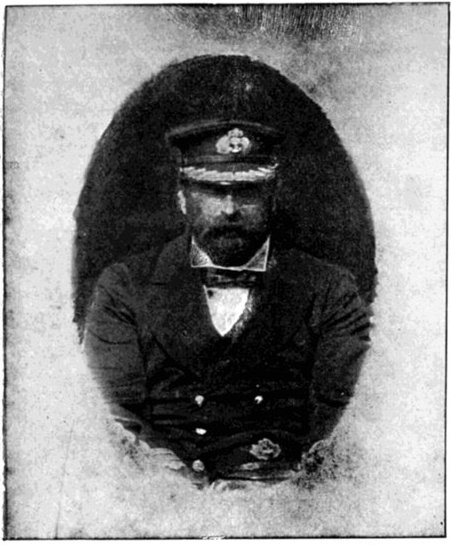
[Photo by Symonds.
FLAG-CAPTAIN PROTHERO.
Of H.M.S. Doris. Wounded in action at the battle of Enslin.
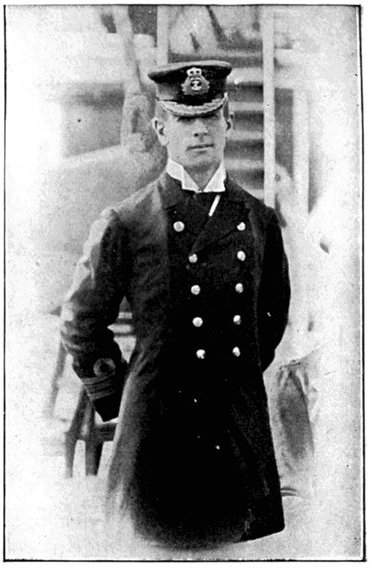
[Photo by Symonds.
COMMANDER ETHELSTON.
Of H.M.S. Powerful. Killed in action at the battle of Enslin.
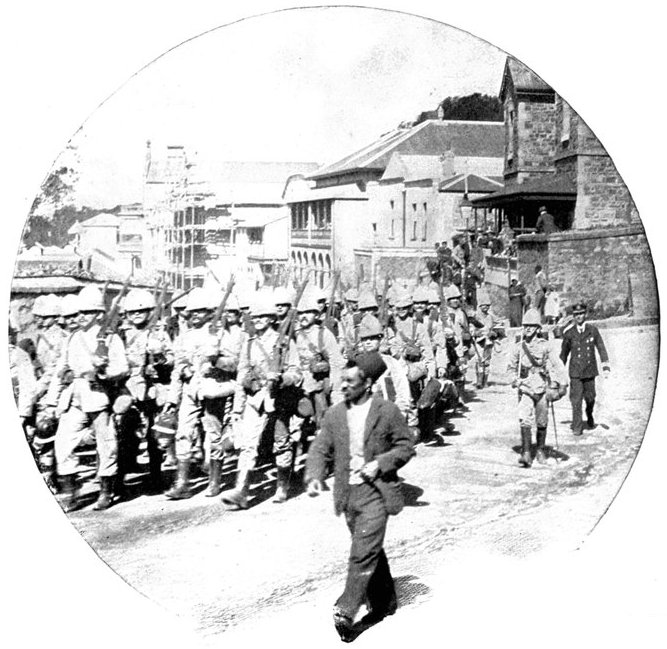
MARINES OF THE NAVAL BRIGADE WHICH FOUGHT AT ENSLIN.
The detachment is here represented marching out of Simonstown on its
way to the front. The officer in khaki walking alone is Capt. Senior,
who was killed in the battle of Enslin (perhaps better known as the
battle of Graspan).
[Pg 151]
Nov. 25, 1899.] "Take that Kopje, and be Hanged to
it!"
The Bluejackets and Marines take the kopje.
For a moment it seemed as though the attack had failed. But the
artillery poured its fire upon the crest of the ridge with more
vehemence than ever; and up the slopes in very open order, firing and
cheering, came the Yorkshire Light Infantry to the support of the
hard-pressed Naval Brigade, while the Loyal North Lancashires and
Northumberlands, too, were sweeping forward upon the line of heights
held by the Boers. Once more the seamen and marines pressed upward at
an order from the wounded Captain Prothero: "Men of the Naval Brigade,
advance at the double; take that kopje and be hanged to it." Full in
the front of them was Midshipman Huddart of the Doris, who even in
that band of heroes won a name for conspicuous and amazing bravery.
At the bottom of the hill he had fallen hit in the arm; halfway up he
was shot through the leg; yet staggering forward he reached the summit
of the blood-stained slope, where, shot once more, in the stomach, he
breathed forth his young life. Thus died the officers of the Royal
Navy. For the last few yards of the advance the Boers could no longer
fire with safety upon their assailants. Their very position became
disadvantageous as the slopes were so steep that they had to stand
up to see their assailants, and in the deluge of shrapnel and rifle
bullets which beat upon the summit, this was almost certain death.
Lieutenant Taylor of the 2nd Yorkshire Light Infantry and Lieutenant
Jones of the Marines, the last in spite of a bullet in his thigh, were
the first into the Boer entrenchments at the top. They were closely
followed, and the kopje was won.
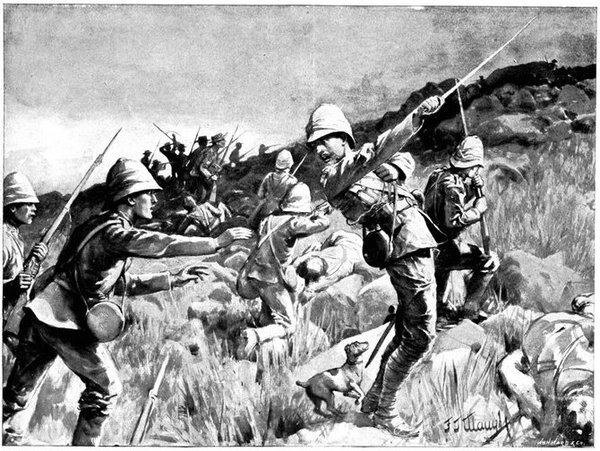
F.J. Waugh.]
DEATH OF MAJOR PLUMBE AT THE BATTLE OF ENSLIN.
His little terrier followed him up the hill and kept watch by him for
hours after he had been mortally wounded, until he was picked up by the
ambulance.
[Nov. 25, 1899.
Throughout the advance of the Naval Brigade the naval officers behaved
with the most reckless and devoted courage. "Your fellows are too
brave," said a soldier-officer of famous gallantry to a sailor-officer.
"It is utterly useless for you to go on as you do, for you will only
all get killed in this sort of warfare. I saw your officers walking
about in front of their men, even when the latter were taking cover,
just as if they were carrying on on board ship." "Did you watch the
Naval[Pg 152] Brigade?" said Colonel Barter to a staff officer. "By Heaven, I
never saw anything so magnificent in my life."
The scene on the summit is thus described by The Times
correspondent:—"The hill-top was almost dripping with blood; not a
boulder escaped its splash of crimson, and the innumerable splinters
and chips of the ironstone blocks indicated the terrific nature of our
fire. Most of the dead or wounded Boers were carried off—thirty of the
more severely wounded were found in their hospital a quarter of a mile
away—but here and there a dead man proved that here the Transvaal had
sent its men down for the first time to meet the oncoming column."
"I shall never forget the faces of some of those who had fallen in the
final rush," says Colonel Verner, of the dead of the Naval Brigade.
"They lay about in every attitude, many with their rifles, with
bayonets fixed, tightly clutched in their hands, and in some cases
still held at the charge. There were the same hard-featured, clean-cut
faces, which but a short time before I had watched laboriously
skirmishing across the veldt, now pale in death, but with the same set
expression of being in terrible earnest to see the business through."
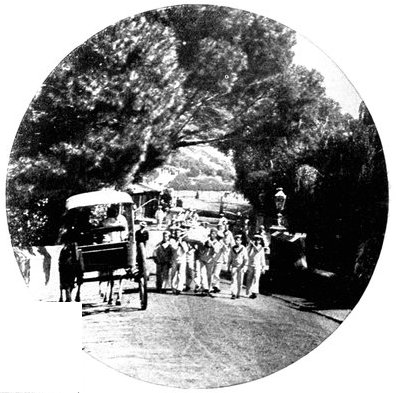
SAILORS CARRYING THEIR WOUNDED COMRADES TO THE HOSPITAL
AT SIMONSTOWN.
The enemy fled towards his right along the ridge; others mounted their
horses and made off to the north. The Lancers and Rimington's Scouts
essayed pursuit, but hurrying after the enemy had to pass between two
seemingly untenanted kopjes. As the mounted men drew near to these, the
slopes burst into flame and a sheet of lead checked the pursuit. The
force which thus suddenly intervened was afterwards believed to have
been a detachment of Transvaalers under General Cronje, whose coming
Delarey was awaiting. The cavalry were too exhausted to follow up. "For
the second time," wrote Lord Methuen, "I longed for a Cavalry Brigade
and Horse Artillery Battery to let me reap the fruits of a hard-fought
action." Had he been able to launch a strong force of mounted men
upon the enemy, the Boer guns must have been captured, the Boer army
destroyed, and the relief of Kimberley without further fighting might
well have been assured. There would then have been no Modder River, no
Magersfontein. As it was, all that could be done was for the artillery
to shell the fugitives at long range.
The deadliness of the Boer fire is seen in the heavy losses of the
Naval Brigade and in the fact that most of those who reached the summit
of the kopje unwounded had bullets through their clothes or equipment.
A marine officer had his water bottle and revolver shot away, his
leather belt cut, and the magazine of his rifle carried off by a
bullet, but escaped injury himself.
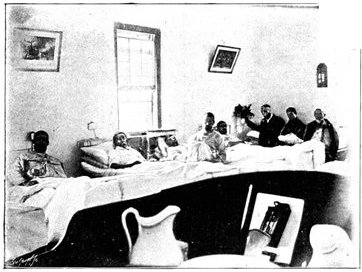
WOUNDED SAILORS IN THE ROYAL NAVAL HOSPITAL AT
SIMONSTOWN.
[Pg 153]
Nov. 25, 1899.] Losses at Enslin.
British losses.
The Queen congratulates the Naval Brigade.
The British losses were sixteen officers and men killed, 169 wounded,
of whom four died of their wounds, and nine missing. The Naval Brigade
was by far the heaviest sufferer, as it lost no less than 101 officers
and men, out of a total of 365 on the field. The Marines left nearly
half their strength upon the ground, the "Blue Marines" or Marine
Artillery being the hardest hit of all, with twenty-six killed and
wounded out of a strength of fifty-seven. Yet men questioned whether
it was wise to use up the magnificent personnel of the fleet in such
attacks, when this personnel is none too strong, and when it takes
years to train seamen. After the battle the Brigade was deservedly
thanked by the Queen. "The Queen desires," ran her telegram, "that you
will convey to the Naval Brigade who were present at the action of
Graspan, Her Majesty's congratulations on their gallant conduct, and at
the same time express the Queen's regret at the losses sustained by the
Brigade."
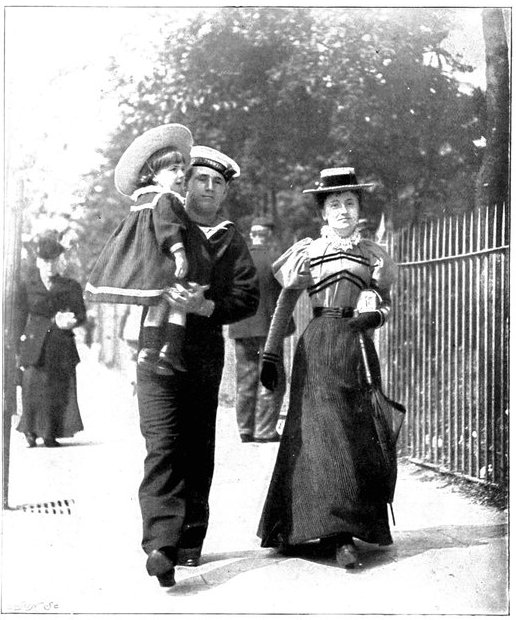
[Photo by Cribb, Southsea.
HOME FROM THE WAR.
Boer losses.
The Boer losses in the action can only be guessed at. Twenty-one dead
were found on the field and buried; thirty wounded Boers were captured
in the enemy's hospital, and a few unwounded men were also taken. Among
the prisoners was Mr. Jeppe, a Transvaal millionaire, and Commandant
Rissik. In all, the enemy's casualties probably exceeded our own,
and may be placed at from 200 to 240. The Jacobsdal commando, 180
strong, alone lost forty-six men killed and wounded. Here, as before
at Belmont, there was the same violation of the white flag, with,
superadded, gross misuse of the red cross flag.
Lack of water at Enslin.
[Nov. 25, 26, 1899.
From the battle, which was known officially by the name of Enslin,
though it had occurred near the tiny village of Graspan, the army
marched to Enslin and there bivouacked. There was little or no water,
and this added greatly to the suffering of the troops after the
morning's terrible fight under a sweltering sun. The men crowded round
the locomotives and offered immense sums—a whole year's pay—for a
cup of water from the tenders, but in vain. The engine-drivers had
received the strictest orders on no account to part with their water.
One soldier was seen lying flat under a steam pipe, striving to catch
in his mouth the scanty drops. Nor was there any too much food. Nothing
beyond the service rations had been able[Pg 154] to keep pace with the column.
The men had to do without the little canteen luxuries which add so
much to the pleasure of a soldier's life. The officers had to fare
upon bully beef and compressed vegetables, despite the champagne and
delicacies which the thoughtful mess caterers had brought out from
England only to be stacked in mountainous piles at De Aar.
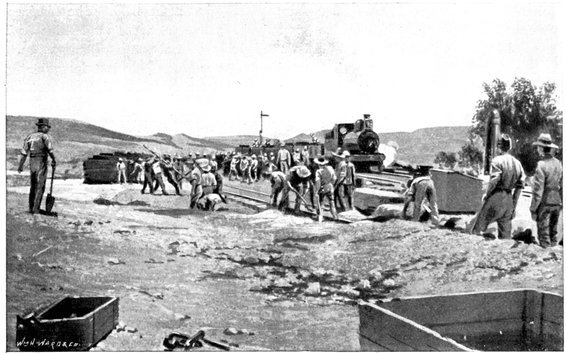
REPAIRING THE RAILWAY NEAR ENSLIN.
Lord Methuen's address to the troops.
At Enslin Lord Methuen addressed his troops upon the morning after
the battle. He congratulated them upon the work they had done, and
expressed his appreciation of their gallant endurance of hardship. The
work was the severest encountered by the British Army for many a long
day. They had, in front of them, an enemy to whom they could not afford
to give one point, whose tactics had been excellent, and whose courage
he recognised and admired. When called upon to fight for his country,
he preferred to fight against such a foe—a foe worthy of his steel. He
hoped that he and his men had gained each other's confidence, and that
they would all do their duty as Englishmen should do.
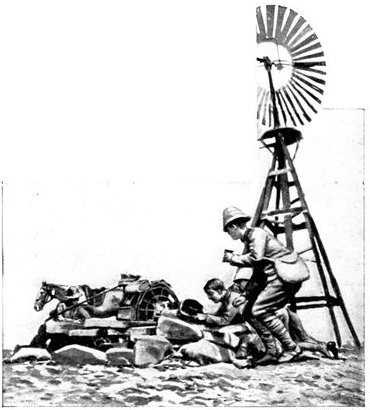
[Photo by R. W. Paul.
THIRSTY SOLDIERS AT THE WATERWHEEL AT BELMONT.
The water is drawn up by means of a chain of buckets passing over a
wheel which is actuated by a windmill.
He went on to the painful topic of the abuse of the white flag and
red-cross flag, describing as dastardly the conduct of the enemy in
firing on ambulance waggons, the shooting of a British officer by a
wounded Boer, and the use of Dum-Dum bullets; but he refused to believe
that these acts were characteristic of the enemy. He would give them
credit, until he was convinced to the contrary, that they, like the
British, wished to fight "fair and square."
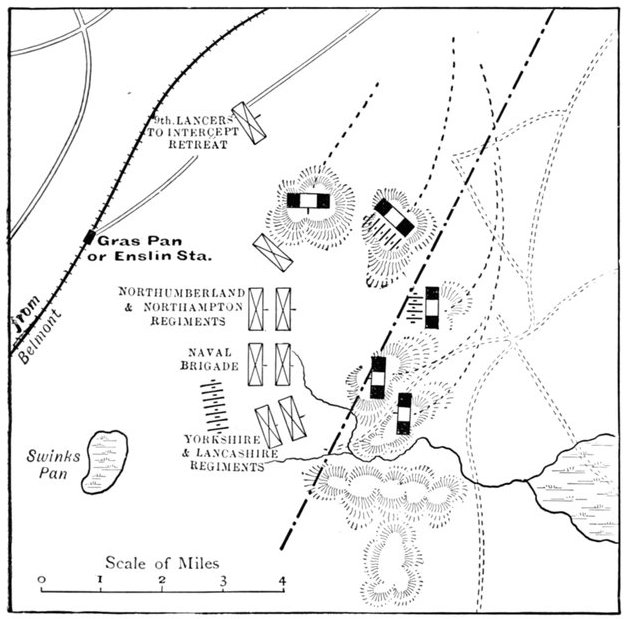
PLAN OF THE BATTLE OF ENSLIN OR GRASPAN.
[Pg 155]
Nov. 26-28, 1899.] Advance to Modder River.
March to Klokfontein.
From Enslin the division marched to Klokfontein, only eight miles from
Modder River. The railway and telegraph were repaired as the column
advanced. At Klokfontein the army suffered the usual torments for want
of water. The muddy water of the stagnant pools, which were the only
source of supply discovered, was eagerly drunk by the heavy-laden,
thirsty men. Word was passed that there would be plenty of the precious
fluid next morning at the Modder River, but for only too many in the
British column that moment of supreme satisfaction when raging thirst
is quenched was never to come.
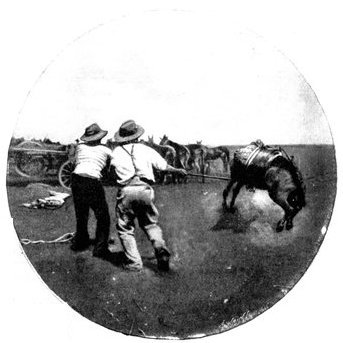
AN OBJECTION TO WORK.
The loading of a number of pack-mules is apt to be trying to the temper
and even to the muscles.
So the column encamped with orders to march at dawn and breakfast on
the Modder. Lord Methuen, his staff, even the British scouts, had been
deceived by rumours artfully spread to the effect that the enemy would
make no stand before Spytfontein, some miles beyond the Modder River.
A reconnaissance on the 27th revealed no sign of the enemy. "There
was," says Mr. Kinnear, "an absurd contempt for the enemy on the part
of the Headquarters Staff, and an indifference most pronounced as to
his whereabouts and strength. At Graspan Lord Methuen expected a brush
with 800 Boers. He encountered over 3,000 of the enemy. But this taught
no lesson, until we became almost like the courtiers of King Louis,
who neither learned anything nor forgot anything." Yet, in justice to
a much-criticised general, it should be remembered that Lord Methuen
on the afternoon of the 27th personally examined Modder River bridge,
and rode within 300 yards of what afterwards proved to be the Boer
position. The enemy did not stir or move; no shots were fired; and no
sign whatever of the presence of 8,000 or 9,000 men could be detected.
Lord Methuen's available forces.
At Klokfontein Lord Methuen was reinforced by a fine Highland
battalion, the 1st Argyll and Sutherlands. Deducting all losses he had
now 8,000 infantry, 400 cavalry and mounted infantry, and 300 artillery
with twelve guns. At Belmont, in his rear was the 62nd Field Battery
with six more guns. It will be seen that the column still remained
pitifully weak in two essential components of an army—cavalry and
artillery.
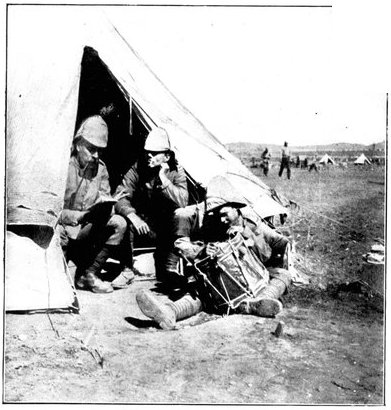
[Stereo-Photo by Underwood & Underwood. Copyright 1900.
THE DRUMMER BOY'S LETTER HOME.
The drum-head makes a very fair writing table.
[Nov. 28, 1899.
The Boers in force at the Modder River.
At dawn of November 28th the division got under arms and cheerfully
marched off to disperse the handful of demoralised fugitives who were,
it was reported, all that would be encountered at[Pg 156] Modder River. From
the Modder it was to bend eastwards to Jacobsdal and come in upon the
flank of the Boers at Spytfontein. The early morning air was clear
and cold, but the breakfastless men marched joyously down the gentle
slopes, eight miles long, towards the eagerly desired water. A few
minutes of skirmishing was the most that anyone expected. Yet early
in the morning—seemingly while the division was on the march—Lord
Methuen received disquieting news. This was to the effect that the
Boers were in great force at the Modder. Still he felt no great
anxiety; he had been told that the Riet and Modder Rivers were fordable
everywhere, and therefore he thought that he could easily outflank
the enemy and drive them from their positions. He does not appear to
have communicated the news to his subordinate generals and battalion
commanders. Indeed, so free from care was he, that he gave his cook
orders to get his breakfast ready as his line of men neared the Modder
River. Still, the approach to the river was made in very open order and
no reasonable precaution was neglected.
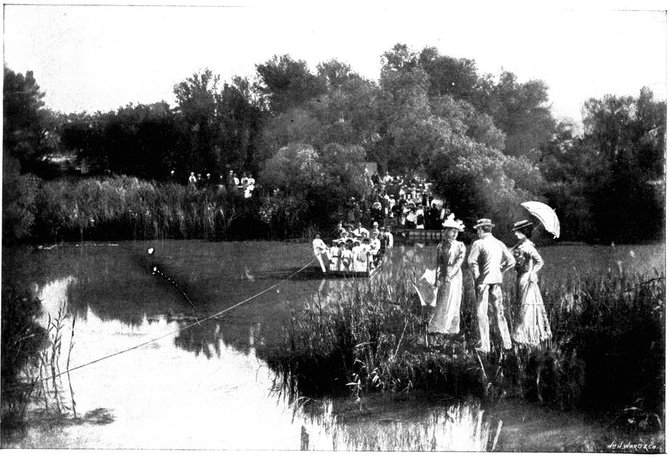
A PLEASURE PARTY ON THE MODDER RIVER.
The Modder, a little above the bridge, is the favourite resort of the
jaded Kimberley folk for picnics and boating.
Disposition of troops.
The disposition of the British troops was as follows:—On the right
was the Guards' Brigade, with the Scots Guards, Grenadiers, and 2nd
Coldstreams in line from right to left, and the 1st Coldstreams
following in support. On the left was the Ninth Brigade, under
Major-General Pole-Carew, composed of the Northumberland Fusiliers,
Yorkshires, and North Lancashires in line from right to left, with the
Argyll and Sutherland Highlanders in support. The two field batteries
were on the right, where also were the Lancers and mounted infantry.
To the rear were the transport and ammunition waggons in charge of the
Northamptons.
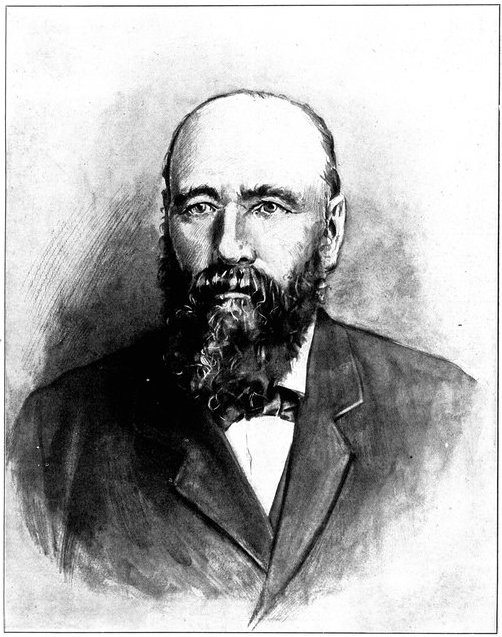
[Re-drawn from a photograph.
GENERAL P. J. CRONJE.
Commanded the Boers in the beginning of the investment of Kimberley,
subsequently at Magersfontein and Paardeberg, where he surrendered
together with 4,000 men to Lord Roberts. Cronje is a man of 65 years of
age, who has always been a bitter enemy of England. In 1881 he was in
command at the siege of Potchefstroom, where he behaved with terrible
cruelty and unfairness to the garrison, which eventually surrendered
to him, with the honours of war, on March 21, although an armistice
had been in force since the 6th, of which Cronje had kept them in
ignorance. It was to him also that Dr. Jameson surrendered on January
1, 1896.
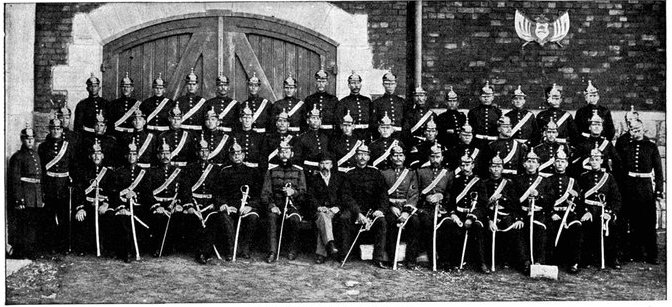
THE FREE STATE ARTILLERY.
The standing army of the Orange Free State, commanded by Major
Albrecht, who sits near the centre of the front row in the photograph,
in a light uniform braided across the front.
Nov. 28, 1899.] General Cronje Commands the
Boers.
[Nov. 28, 1899.
Scene of the battle.
About the centre of the British front was the railway to Kimberley,
which crosses the Modder upon an iron bridge. That bridge had been
entirely destroyed by the Boers, and culverts on the line two miles
to the south of the river had been blown up, thereby rendering it
impossible for the armoured train with Lord Methuen's column to
approach. Half-a-mile to the east of the railway bridge was the
confluence of the Riet and Modder Rivers, the Riet coming in from
the south-east[Pg 157] and the Modder from the north-east. As far as the
confluence, the width of the bed of the Riet is about 300 yards; below
the confluence the stream, now known as the Modder, flows in a bed[Pg 158] 400
to 500 yards wide. Two miles below the railway bridge a dam had been
erected to make a sheet of water for pleasure seekers from Kimberley,
and the banks of the river were thickly covered with trees and
brushwood. In this sylvan scene straggled a village consisting mainly
of hotels, built of corrugated iron, stone, brick, adobe, and mud. In
spite of Lord Methuen's information as to the fordability of the river,
there were only three drifts—one over the Riet on the extreme British
right; the other in the centre close to the railway bridge, and the
third on the left just below the dam.
Boer preparations.
Unknown to Lord Methuen, the Boers had made the most elaborate
preparations to meet his force. General Cronje was in command of the
Boers, and had with him from 8,000 to 10,000 men, one half of whom were
Transvaalers. Entrenchments had been constructed for five miles along
both banks of the river. They were masked by shrubs and brushwood, and
even the best field-glass could not detect their outline. On the Boer
right were the Free Staters under Delarey; on the left the Transvaalers
under Cronje. On the north bank of the river were stationed seven field
guns, with one heavy gun—probably a 100-pounder—on high ground, about
two miles back. On the tongue of land between the Riet and Modder,
ready to enfilade the British, were a "Pom-Pom" and two field guns,
whilst several Maxims and machine guns were scattered along the enemy's
front.
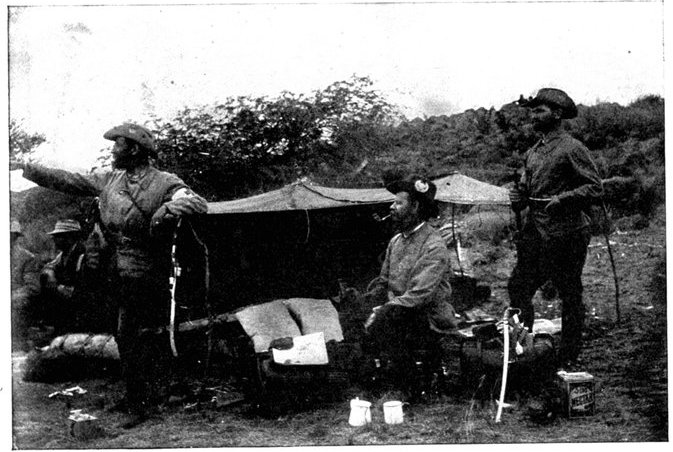
MAJOR ALBRECHT.
In command of the Free State Artillery at Modder River.
[Pg 159]
Nov. 28, 1899.] The Battle of the Modder.
Battle of the Modder.
The artillery and mounted troops were in advance of the British line.
The first glimpse of the enemy was gained about 6·30 a.m., when a body
of 500 mounted Boers was made out away on the right. They rode rapidly
towards the enemy's left, at once drawing the cavalry and mounted men
in pursuit. Then a Boer gun on the British right opened fire. So far
there had been no sign of life west of the junction of the Riet and the
Modder, and it was thought that the village was not held by the enemy.
The British 18th and 75th Field Batteries at once unlimbered on the
right and opened fire at an extreme range of about 4,500 yards. The
Boer artillery on the eastern half of the enemy's position replied,
but very languidly. Here, as before at Belmont and Graspan, it was
most difficult to locate the hostile guns. They were not massed, but
scattered singly, in strongly entrenched and well-masked gun-pits, so
that the only sign of their presence was a flash and faint film of
blue-white smoke, which instantly dissolved into the air. For some time
this long-range skirmish continued; then, gradually, the Boer guns
seemed to be silenced by the British shrapnel, and it was thought that
a small rearguard in the British front was falling back under cover of
the desultory cannonade.
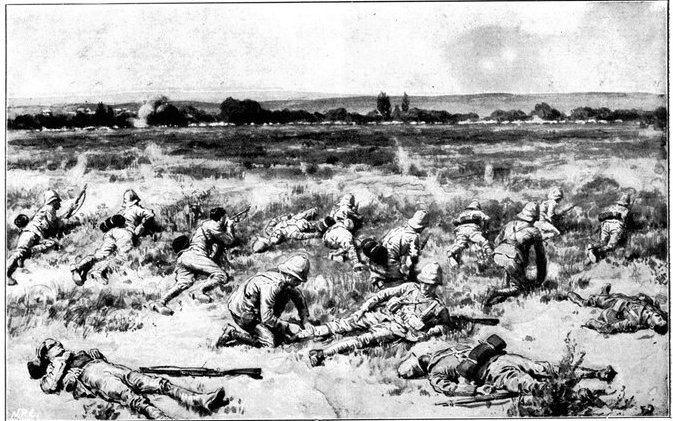
[From a sketch by a British Officer.
THE BATTLE OF MODDER RIVER, AS SEEN FROM THE GUARDS' LINES.
Accordingly, the Guards received orders to develop their advance.
Neglected by the enemy's artillery they pushed rapidly forward and
reached a point only about 800 yards from the enemy's trenches,
descending the smooth, grassy slope, which led gently down to the
river. Far away to the left a thin, long line of khaki-clad men pressed
forward, the Ninth Brigade following the example of the Guards. The
enemy's plan, it was afterwards learnt from prisoners, was to permit
the British troops to approach within 400 yards, and then to open on
them from ambush an annihilating fire. But this design was foiled by
the clumsy nervousness of the Free Staters in the trenches to the south
of the river. When they saw the British troops only 800 yards off them,
they held that the enemy was quite near enough, and in defiance of
their orders opened a terrific fire.
[Nov. 28, 1899.
Along the whole extent of the Boer front ran an appalling crackling
uproar, above which could plainly be heard the terrible pom-pom-pom of
the Maxim. The effects of this fire were amazing; the leading ranks
fell to the earth in an instant, killed or wounded. The Scots Guards'
Maxim detachment was[Pg 160] annihilated in half-a-dozen shots by the Maxim
1-pounder; the sergeant in charge was killed, and every man with the
gun was placed hors de combat. Staggered by the sudden fury and
intensity of the fire, which seemed to deliver a continuous sheet of
missiles, the soldiers of the Guards and the Ninth Brigade found that
they could no longer advance. They scorned the cowardly alternative of
retreating, and as the only other course left to them, threw themselves
prone on the ground.
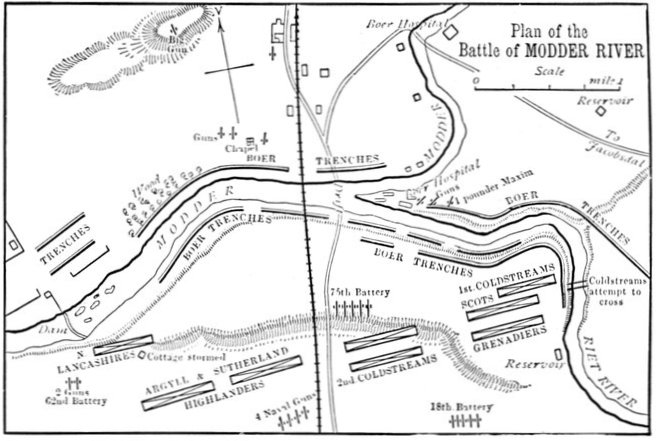
Plan of the Battle of MODDER RIVER
The same course was followed by the men in every part of the field,
simultaneously, as if by instinct. From the wide extent and vehemence
of the fire, it was clear that the British were confronted by a
great force, and that a desperate action must be fought before the
eagerly longed for water could be reached. It was simply impossible to
extricate the British army, the battle having once been joined in this
manner. No flank attack could be delivered where almost every man was
engaged with the enemy directly before him. Lord Methuen found himself
for the second time committed to a struggle which he had not planned,
and could do little or nothing but trust to his superb soldiers
wearing the enemy down. He telegraphed at once to Belmont for the 62nd
Field Battery to march with all possible speed to his assistance, and
directed two companies of Munster Fusiliers to entrain and advance to
the battlefield. This done, he turned to the control of the battle.
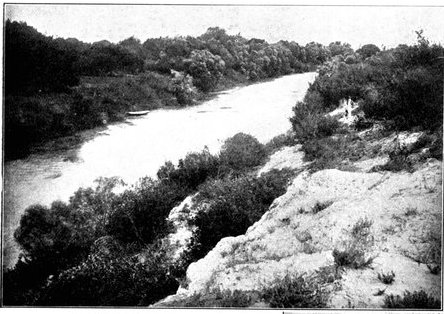
THE MODDER RIVER.
Showing the banks with their lining of bushes, from behind which the
Boers opened a murderous fire upon the British at 800 yards.
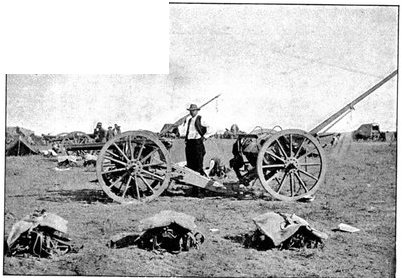
BOER ARTILLERY AT MODDER RIVER.
Nov. 28, 1899.] Sufferings of the Troops.
The two British batteries on the field pushed in upon the centre
of the Boer position, and at a range of about 2,000 yards began to
deliver a storm of shrapnel upon the village and the Boer trenches. The
whereabouts of these had to be guessed, for there was still no sign of
the enemy. The battlefield appeared empty of men—the British soldiers
prostrate on the ground, the Boers artfully concealed; and few who
fought through that long day in our ranks saw even a single opponent.
The men fired at what they thought was the enemy's position, fired at
the flash of the guns, fired at the quarter from which came the heavy
hammering of the big Maxim. That,[Pg 161] even so, they shot to some purpose
was known when after the battle the shield of the Maxim was found
splashed gray with British bullets.
The torture of thirst.
After the British infantrymen threw themselves down, their losses were
singularly small. Fortunately the soldiers had left their great coats
with the baggage, for these, being dark in colour, would have shown up
against the brown surface of the veldt and the dingy hue of the khaki,
and so have drawn the enemy's fire. At first some officers attempted
to stand up and lead their men forward, but such attempts immediately
drew a perfect storm of bullets. One brave sergeant who endeavoured
to lead a rush was hit half-a-dozen times. The men suffered agonies
from thirst and want of food and the intense heat of the sun. As the
morning went on the heat rose to 110°, and the sun's rays scorched and
blistered the bare legs of the Highlanders in the most painful manner.
If a breath of wind blew to relieve them, it would ruffle their kilts
and instantly draw the enemy's fire with deadly effect. The few drops
of tepid muddy water in the water bottles were speedily exhausted. In
their frantic eagerness to drink, men would rise, though they knew
this meant certain death or wounds, and would attempt to crawl to the
water carts in the rear. In this manner the Coldstreams lost many men,
till it was realised that to bring the carts near the rear was a cruel
and irresistible temptation. As for the wounded, they had to lie and
suffer if they could not crawl back to the rear. The bearer companies
displayed the utmost devotion, yet they lost so heavily that they could
not show themselves within the bullet-swept zone where lay most of the
wounded. Nor could ammunition be sent to the firing line; after one
or two attempts the men in front had to be left entirely to their own
resources.
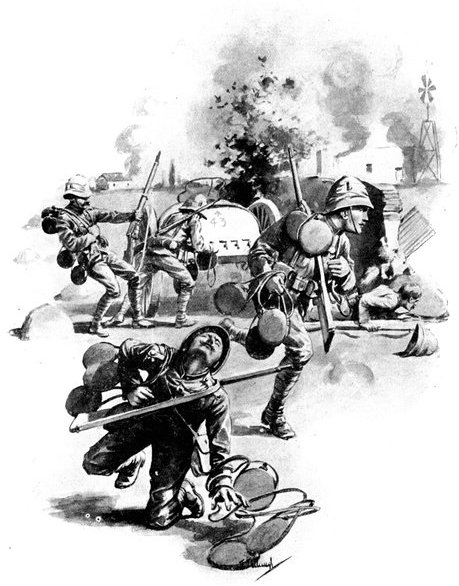
[After a sketch by Mr. Fred Villiers
HEROIC ATTEMPT TO FETCH WATER FOR THE FIRING LINE.
The sketch represents some of the men who dashed across the zone of
fire, drawing water for their comrades. Many of them were shot down by
Boers specially told off for the purpose, long before they could reach
the firing-line again.
[Nov. 28, 1899.
So hot was the fire, so keen the enemy's watch upon the surface of
the plain that the slightest movement attracted a rain of bullets.
An officer put up his hand; in a moment a storm of projectiles[Pg 162]
whistled over him. He did not repeat the experiment. "If one asked a
comrade for a drink of water," says Mr. Ralph, the correspondent of
the Daily Mail, "he saw the bottle or the hand that was passing it
pierced by a Dum-dum or with a 1-pounder Nordenfelt shell. Or if he
raised his head to writhe in his pain he felt his helmet shot away.
From the rear ammunition carriers and stretcher bearers walked boldly
forward until, the moment they were within range, a sheet, a torrent
of bullets and small shells raked the air as jets of water spurt from
a flower-sprinkler. But that image is too faint, for the jets were all
whistling or shrieking, throwing up fountains of red sand, exploding
in hundreds of detonations like echoes of the guns that spewed them.
At this, down upon their bellies dropped the stretcher bearers and
the cartridge carriers, and there they lay for hours, never rising or
attempting to rise without loosening this torrent anew." The Maxim
shells rushing through the air "like so many jets of steam released
from the highest pressure, and singing like little steam whistles," had
great moral effect. One, landing between an unhappy soldier's legs,
shattered both his thighs. Yet, speaking generally, the moral effect
was greater far than the material.
Among the other torments which were patiently endured, not the least
were the ants which sallied forth in thousands and bit and stung the
soldiers, when the many ant hills dotted over the plain were broken up
by the enemy's artillery.
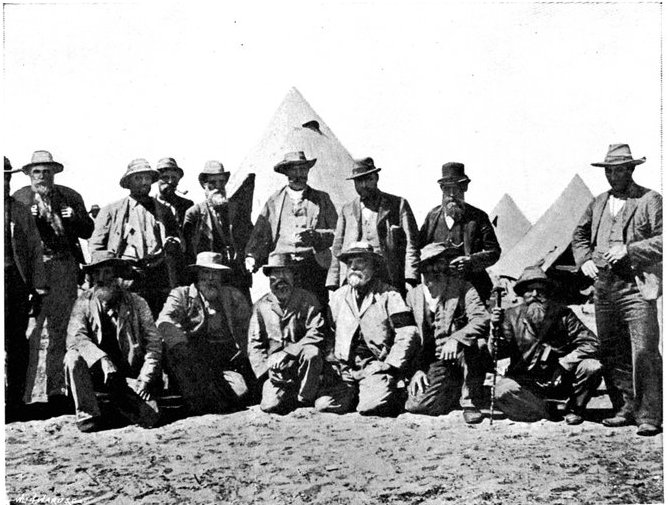
Stereo-photo by Underwood & Underwood. Copyright 1900.
SOME OF CRONJE'S OFFICERS.
The Commandants who fought under Cronje at Modder River, Magersfontein,
and Paardeberg; from a photograph taken after their capture by Lord
Roberts.
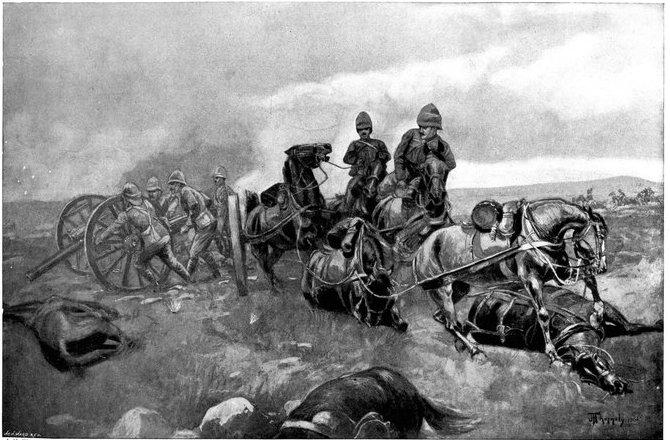
J. H. Thornely.]
THE BATTLE OF MODDER RIVER: THE 62ND BATTERY UNLIMBERING UNDER A
WITHERING FIRE FROM AN INVISIBLE ENEMY AT 800-YARDS RANGE.
Sleep during battle.
[Nov. 28, 1899.
Arrival of an additional field-battery.
Hour after hour the fierce, monotonous battle continued, while the
pitiless sun waxed higher and higher, and at last began to decline.
Always the British field artillery kept its position in the open,
its gunners working like demons to save their comrades and shake the
enemy's nerves. Always the tempests of bullets passed, for the most
part innocuous, over the prone infantry. Always the enemy's rifles
crackled and his guns pounded and banged. As the day went on the
extreme tension and anxiety yielded to utter lassitude. The nerves
could accept no fresh impression, and in the infernal uproar whole
ranks were seen sleeping peacefully. Some were even killed or wounded
as they slept. As time went on and our men could make no advance and
gain no ground, matters began to look more serious. Would twelve
guns ever be able to dominate and silence the fire of so strongly
entrenched an enemy? To outward appearances but little impression had
been made. The Boer guns often seemed to have been silenced, but after
intervals of quietude would always reappear and open in another place.
Yet the persistent roar of guns behind them cheered and reassured
the British infantry, and the persistent rain of shrapnel, though no
one in our army knew it, was beginning to weaken the resolution of
the Free Staters in the [Pg 163]
[Pg 164]foremost trenches. About noon, it is said,
some were shot by their own side for attempting to bolt. And now, as
the afternoon wore on, came much-needed help. The 62nd Field Battery,
after a twenty-five miles' march, in which four of the horses had
fallen dead, dashed upon the field and opened on the Boer left. Says
an officer of the battery:—"Things were looking very black when Lord
Methuen came up to our Colonel and asked him to send his batteries
up closer (we were then 1,500 yards from the Boer trenches, and you
must understand that a rifle carries 2,500 yards). Our Colonel did. We
then advanced up past our own infantry, and came into action about 900
yards off, closer than artillery had ever taken up position before.
After severe loss on our side we managed to silence the Boer guns. The
order was then given to retire, and we got out of range and were on the
point of congratulating ourselves on being so lucky, when up rode an
orderly giving us instructions to go and relieve the Guards. Our Major
advanced.... We took up our position 800 yards from the Boer trenches,
and, by Jove! the Boers let us have a fearful reception. Before I
got my horses out they shot one of my drivers and two horses ... and
brought down my own horse. We then got my gun round on the enemy, when
one of my gunners was shot through the brain and fell at my feet.
Another of my gunners was shot whilst bringing up shell, and I began to
feel queer.... At last we had a look in, and our shells began to tell;
we were firing six rounds a minute, and were at it until it was too
dark to fire any more."
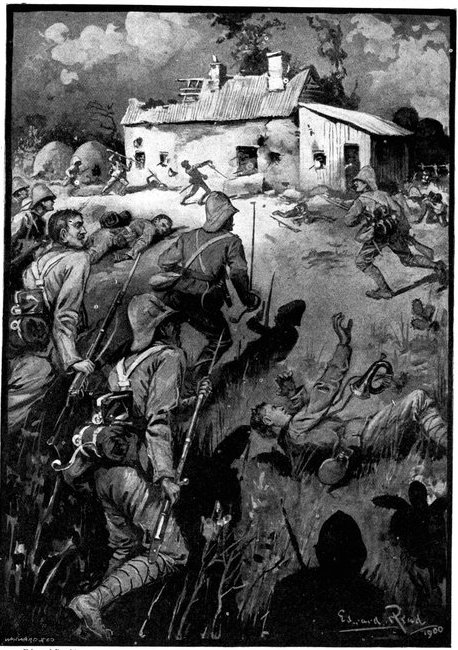
Edward Read.]
THE STORMING OF A FARMHOUSE BY THE YORKSHIRES AND LANCASHIRES.
Attempts to cross the river.
Nov. 28, 1899.] The River Crossed by Highlanders
and Yorkshiremen.
Lord Methuen had ridden over in the afternoon from the right to the
left. On the right a desperate attempt to cross the Riet and get at
the enemy had just failed. Colonel Codrington had led a party of
Coldstreams, twenty-four men strong, across the river, but they missed
the ford and had to swim for it. When they reached the other side they[Pg 165]
found themselves unsupported and exposed to a concentrated fire, so
that there was nothing for it but retreat. Two of the party were all
but drowned, when the others, unfastening their putties, made long
lines of them and threw them to the exhausted men. It is pleasant to
relate that all of this brave little band regained the British lines.
On the left several attempts had been made by the Ninth Brigade,
splendidly led by General Pole-Carew, to cross the river, the approach
to which had been secured by the Yorkshires and Lancashires. These two
battalions stormed a farmhouse and a kraal just to the south of the
dam, though the Boers were present in force. Several of the enemy were
bayoneted in the mêlée about the house. Further to the left a line of
low kopjes was captured at the point of the bayonet, and the British
left was firmly based on the river.
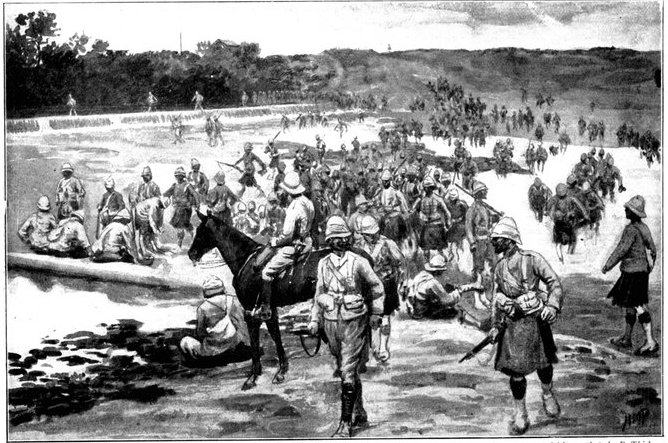
H. M. Paget.] [
After a photo by R. Thiele.
CROSSING THE MODDER BY THE DAM.
The photograph represents some of Lord Methuen's men crossing the
river after the battle. On the left is the dam by which the Yorkshires
crossed under a heavy fire and obtained a temporary footing on the
north bank of the river.
The first attempt to cross was made by the Yorkshiremen, a few of whom
pushed into the stream above the dam. They were led by Lord Methuen in
person. But the fire was too hot for anything to live under it, and
the detachment was driven back with heavy loss, Lord Methuen himself
receiving a painful flesh wound which compelled him to hand over the
command. Next, a company of the Highlanders forded or swam the river
and reached the further bank, where, on the following day, five of the
bravest were found dead in the enemy's trenches. The others were driven
back. Once more General Pole-Carew led the brave Yorkshiremen forward,
this time to the dam that crossed the river. Here, under a heavy fire,
the men one by one made their way along a rickety iron bar in the water
just over the sluices, clinging to the uprights in which slid the
sluice gates. One by one, in spite of the fire, they gained the other
side, where gradually 400 men formed up—a band of heroes—and began
to push forward along the north bank to take the enemy in the flank.
General Pole-Carew sent for reinforcements. Colonel Northcott, of the
staff, was directed by Lord Methuen to bring them up, but, before
he could reach General Pole-Carew, fell mortally wounded by a shell
splinter in the neck.
[Pg 166]
[Nov. 28, 1899.
Retreat of the Boers.
Unfortunately, the success of this flanking movement was not generally
known, and the Yorkshiremen were taken for Boers, so that our troops
and batteries, as well as the enemy's, fired upon them. This compelled
them to fall back, but their mere appearance on the north bank had
finally upset the equanimity of the Free Staters. These had no
confidence in themselves or in their leaders; many of them were for the
first time under fire, and the fearful sights of the battlefield shook
their equilibrium. Most terrible of all was a tall red-bearded Boer
who had been wounded fearfully by a shell, and walked to and fro, his
whole face one mass of blood, his eyes torn out, calling frantically
to his comrades. At 2 p.m. a large number of the enemy were seen to
ride off towards Jacobsdal; at 4·0 there was something resembling a
general stampede. The fugitives retired along the deep river bed, and
thus their flight escaped the notice of the British column, else the
attack might have been pushed, when there is every reason to think
a great victory would have been obtained and the enemy's artillery
captured. But the most advanced companies of the Guards' Brigade had
no ammunition left and none could be sent them; moreover, as it was
impossible for a mounted man to show himself within 1,500 yards from
the Boer trenches, no orders could be given. It was, therefore, decided
to move three battalions of the Guards under cover of night across the
river to the left and to storm the position, and till nightfall to rest
content with what had been won.
As evening drew on and the sun sank, the long duel ceased, after eight
hours of continual firing, with only two short intervals of abatement.
At this point, unknown to the British, the remainder of the enemy
precipitately retreated, leaving behind them their guns and many of
their wounded. Late in the night they mustered up courage to return and
remove all that they had left. The British, for their part, bivouacked
on the field, the men sleeping where they had fought. The night was
bitterly cold after the sweltering heat of the day, and this, in the
absence of their great-coats, caused the men great suffering.
When morning came, eight shots from the naval 12-pounders gave the
signal for a forward move. The scouts and patrols, however, on
cautiously advancing towards the Boer lines, found them abandoned. The
British army then pushed rapidly across and seized the position vacated
by the enemy—victors in one of the strangest battles of modern times.
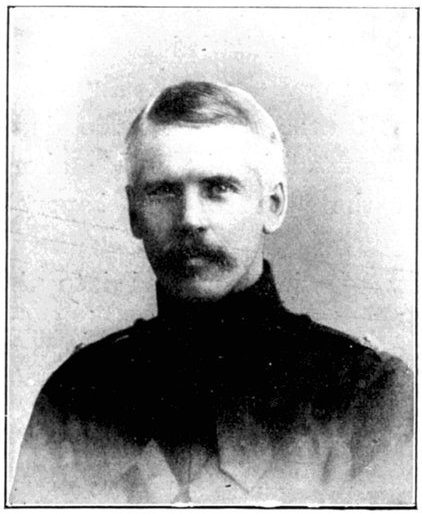
[Photo by Lock & Whitfield.
COLONEL NORTHCOTT.
Mortally wounded at the Battle of Modder River while bringing up
reinforcements for General Pole-Carew.
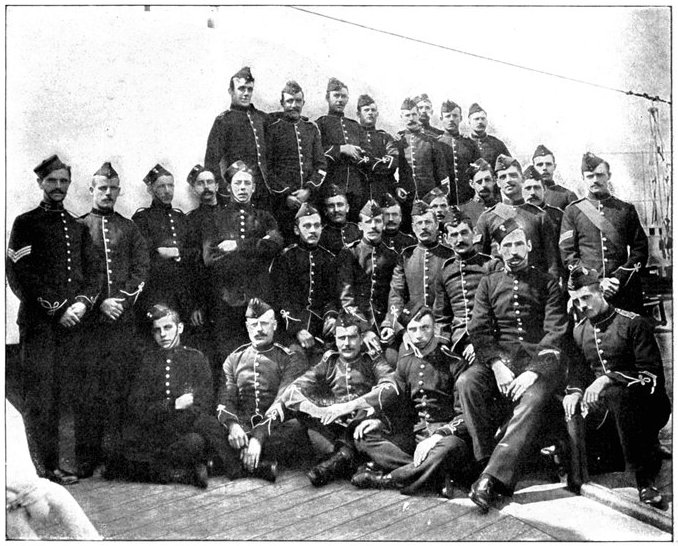
[Photo by S. Cribb, Southsea.
"THE BRAVEST OF THE BRAVE."
Detachment of Royal Marines from H.M.S. Powerful who took part in the
battles of Belmont, Enslin or Graspan, Modder River, and Magersfontein
(except two, who were shut up in Ladysmith). All these men were
wounded.
[Pg 167]
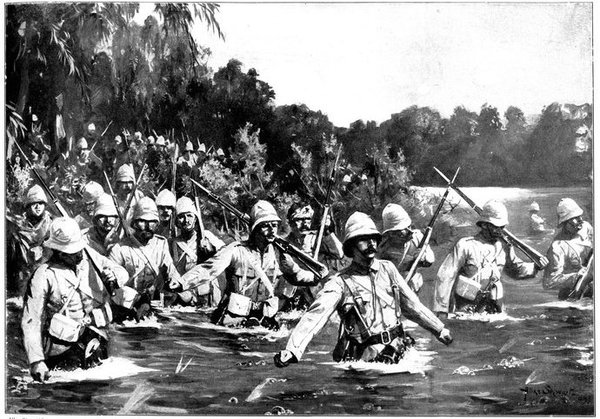
Allan Stewart.]
THE HIGHLANDERS' DASH ACROSS THE MODDER.
[Pg 168]
[Nov. 28, 1899.
Comparison of British and Boer losses.
In view of the terrific nature of the Boer fire the British losses were
by no means heavy. Four officers and sixty-six men were killed, twenty
officers and 393 men were wounded, of whom thirty-one died of their
wounds, and two were missing—it is to be feared drowned in valiant
efforts to cross the river. This made a total of 485 casualties in
a total force which at the close of the battle mustered over 9,000.
Therefore the British losses were a little over five per cent. It is
impossible to do more than guess at the Boer casualties; probably they
were much less than ours, inasmuch as the enemy was the defending force
and quite invisible; sixty killed and 300 wounded will be about the
truth. It was said, indeed, by prisoners and non-combatants that the
Boers lost 160 in killed alone, but this figure is wholly conjectural
and very untrustworthy. Their official accounts only acknowledged the
loss of seventeen killed and wounded among the Transvaalers, which was
certainly an absurd underestimate. The son of the Boer General Delarey
was among those placed hors de combat.
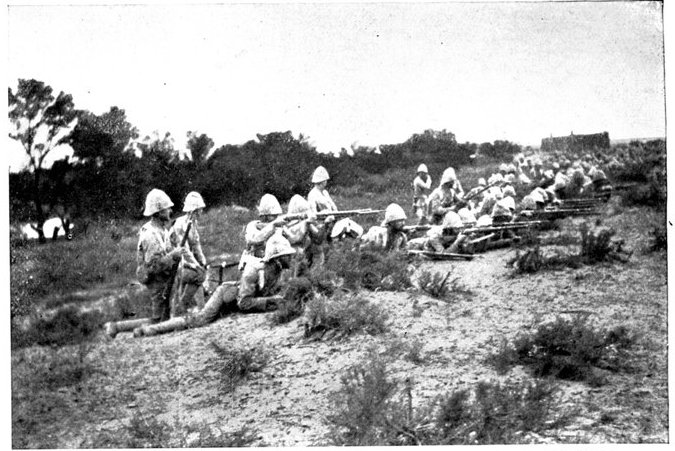
BRITISH SOLDIERS OCCUPYING THE ENEMY'S POSITIONS AT
MODDER RIVER.
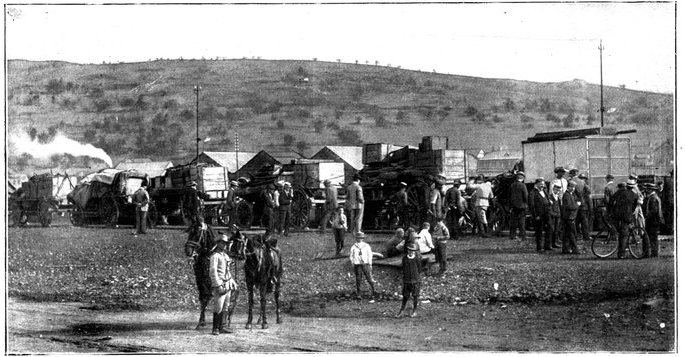
AN AMMUNITION TRAIN LEAVING PRETORIA FOR THE FRONT.
Nov. 28, 1899.] No Flanking Movement Possible.
Though the battle of the Modder River was not in any sense a great
victory, it was a victory extremely creditable to the stubbornness
and fighting qualities of the British soldier and to the resolute
determination of the much decried British general. To dislodge from
the strongest possible entrenchments a force which was at least equal,
and perhaps superior in strength, to the British division, which was
composed of brave, self-reliant marksmen, mounted, and so without fear
for[Pg 169] their line of retreat, and which was in artillery quite as strong
as Lord Methuen, was a most brilliant feat of arms.
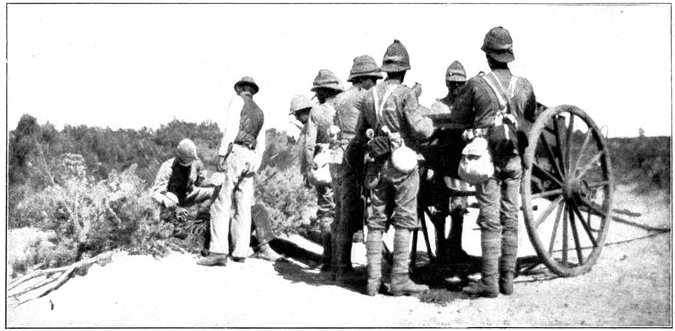
[Photo by H. C. Shelley.
BRITISH SOLDIERS PICKING UP WOUNDED BOERS AFTER THE BATTLE OF MODDER
RIVER.
The cart has been hacked to pieces with bayonets to make a flat surface
to carry the wounded.
British artillery fire.
The British artillery especially distinguished itself by the rapidity
and accuracy of its fire. Yet there were times when a quicker-firing
gun would have been invaluable, especially in preparing for the rushes
across the river. As it was, the four naval guns fired 514 rounds; the
18th Battery no less than 1,100; the 75th 900; and the 62nd, which
came late, 500. In all, 3,000 projectiles of twelve and fifteen pounds
weight were poured upon the Boer trenches.
Lord Methuen has been blamed for failing to attempt a flanking attack,
when he did discover the real strength and position of the enemy.
But, as we have seen, the discovery was made too late to permit of
the withdrawal of any considerable force, and the confusion caused
by such a movement might well have been seized by the enemy for a
counter-attack. Three times during the battle the young bloods among
the Transvaalers pressed Cronje to permit them to deliver such an
attack, believing that our men were demoralised. Three times he refused.
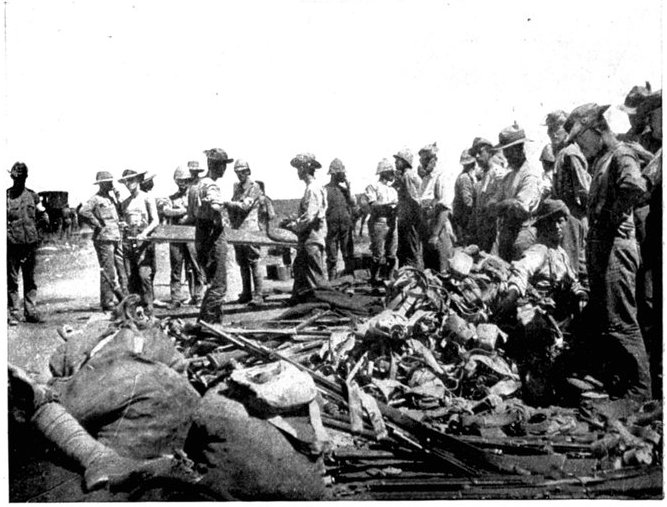
GATHERING THE ARMS AND ACCOUTREMENTS OF THE DEAD.
Characteristics of the fighting.
[Nov. 28, 1899.
What rendered the battle so severe an ordeal to the nerves was the new
conditions under which it was fought. Tempests of bullets suddenly
descended—no one could say from what quarter. Throughout, the enemy
was invisible even to the best field glasses, and this more than
anything filled the soldiery with despair of coming to hand-grips—the
one kind of battle for which they had been taught to prepare. The new
weapons, especially the 1-pounder Maxim, created a terrible impression.
In short, the British troops were tried upon this eventful day in
the rudest manner. Unhappily, the[Pg 170] battle produced a feeling of deep
depression in Lord Methuen's army, where the soldiers did not realise
how much they had achieved. If a rapid advance on the 29th had been
possible, it is certain that Cronje and his army would have been driven
back helter-skelter. But the mischief of undertaking a difficult
campaign with inadequate forces now manifested itself. No large body of
reinforcements was available to carry Lord Methuen's division forward
with a rush. There was no cavalry brigade, no horse artillery battery
to turn the enemy's entrenchments. Moreover the batteries with the
column had not sufficient ammunition for another action, and a halt
was imperatively needed to replenish limbers and waggons from the
none-too-extensive supplies at the base. In the days of delay which
followed the battle, all the results of the victory were lost.
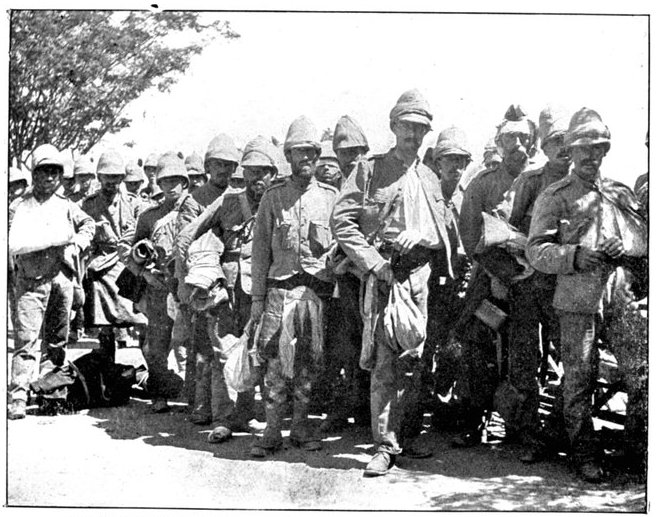
"SLIGHTLY WOUNDED:" PHOTOGRAPHED AT MODDER RIVER.
An examination of the Boer trenches revealed the terrible effectiveness
of the British artillery fire. The walls and roofs of the houses in
the village were wrecked; iron outbuildings were so perforated with
rifle and shrapnel bullets that they resembled gigantic colanders; the
enemy's trenches were ploughed up by the shells and bullets. About
fifty dead Boers were found on the field, either lying where they had
fallen or hastily buried. Their trenches were full of all kinds of
débris; amidst thousands and thousands of expended cartridges were
rifles, bandoliers, bottles of Bass, mackintoshes, and odds and ends of
equipment. Hundreds of riderless horses galloped over the field. They
were captured by privates and sold for a few shillings or a handful of
cigarettes.
The Boers fire on the Red Cross.
There were many abuses of the customs of war. The Boers fired upon
stretcher bearers and trained their "Pom-Pom" upon the ambulances.
They employed expanding bullets, and are said, though the story wants
corroboration, to have placed one of their guns in a place where it was
sheltered by the red cross flag, flying over a neighbouring hospital,
and to have removed a Maxim in an ambulance.
Conduct of the Free Staters impugned.
The conduct of the Free Staters in the battle roused the fierce
resentment of Cronje and the Transvaalers. But for these recreants,
they said, the British Army must have been driven back. They
communicated to President Kruger the news of their allies' cowardice,
and he in turn complained to Mr. Steyn in these terms:—
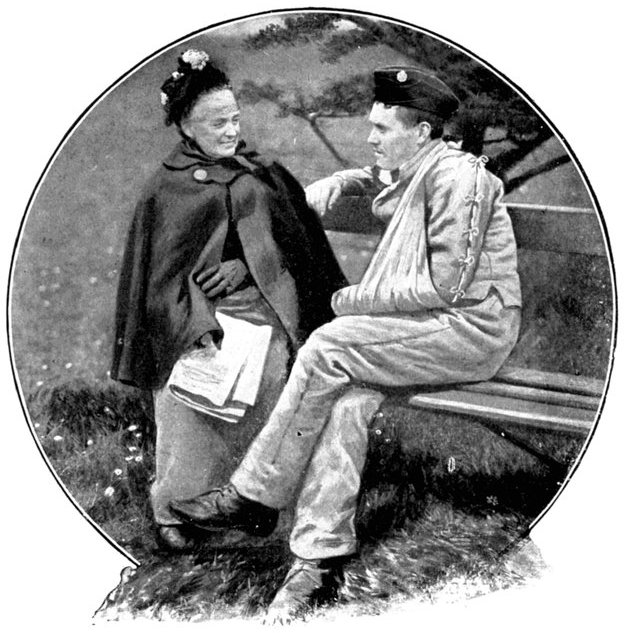
[Photo by Gregory.
"INVALIDED HOME."
Kruger's remonstrances.
Dec. 2, 1899.] Exhortations of the Presidents.
"It was with regret that we learned that only about 1,000 men of the
Free State fought in the last battle, and that many of the others
remained in their camps, while their brothers resisted, and even
defeated, their enemy. I should not[Pg 171] be performing my duty were I not
to impress upon you all the fact that such behaviour can only lead
to disastrous results for our liberty as a people, and may have most
unfortunate results for our brothers in the strife.
"I must, therefore, impress upon each and everyone that it is his
especial duty to obey the officers in command, and that the officers
should accompany the burghers throughout the battles. If we act in this
way, I have no doubt but that the God of our fathers, and our God, will
not forsake us, but give us the victory. So let not one be found out of
his place at the next engagement. Let each one be found taking his part
in the strife. We must remember that we are fighting for all that is
dear to us."
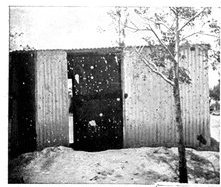
SHED RIDDLED BY SHRAPNEL.
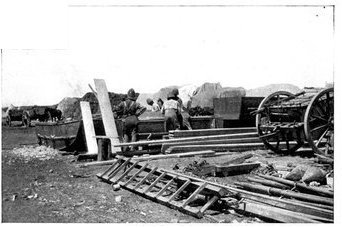
MAKING PONTOONS FOR BRIDGING THE MODDER.
On December 2, Mr. Steyn came in person to Jacobsdal to ply his
reluctant burghers with exhortations. He brought with him a special
message from Mr. Kruger, in which the Transvaal President expressed his
own wish to come to the front and fight. "My age," he said, "does not
permit me to join my sons, otherwise I should have been at the front
by this time. Your Honour's directions and advice must be before them
continuously. For the decisive struggle is fast approaching which is
to prove whether or not we shall surrender the country. By no means
must we give up the country, even if it costs us half of our men. Your
Honour must impress upon the officers and burghers that they must
resist to the death. In the name of the Lord, with this determination,
and with a prayerful attack, I have confidence that we shall secure the
victory. For Christ has said, 'Whosoever would keep his life shall lose
it, but whosoever would lose it for truth's sake shall keep it.'"
With Mr. Fischer, President Steyn addressed the men and visited the
hospitals.
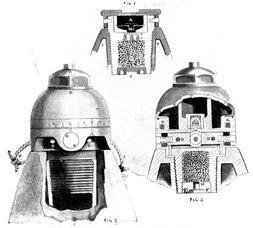
FUZES USED ON BRITISH SHELLS.
Fig. 1 is a percussion fuze, for exploding a shell on coming in contact
with any solid object. The steel needle A forces the copper
washer B against the detonating composition C,
exploding the pistol powder D, thus firing the charge in the shell
through the aperture E. Figs. 2 and 3 represent the exterior
and interior of a time-fuze; it is prepared for use by loosening
the cap A, and turning the dome B until the index
C is set at the required number of seconds, when the cap is
again tightened. The safety pins D D are then withdrawn by
means of the cords F F attached to their heads. On being
fired, the centrifugal motion causes the detonating pellet, released by
the removal of the safety pins, to press against a steel needle, which
fires it and thus sets light to the quickmatch. The fuze composition
runs round the channel marked G, behind the index, which regulates the
amount to be burnt before exploding the charge.
[Pg 172]
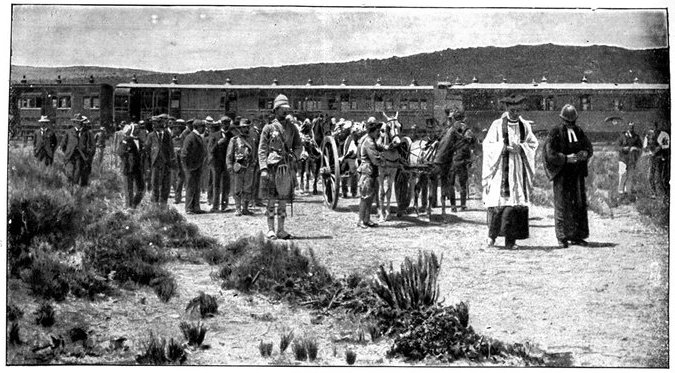
FUNERAL OF GENERAL WAUCHOPE.
CHAPTER X.
THE BATTLE OF MAGERSFONTEIN.
New bridge over the Modder—Lord Methuen
reinforced—British communications
threatened—Position of Magersfontein—Boer
defences—Boer methods—Difficulty of relieving
Kimberley—Skirmishing—Lord Methuen's plans—Choice of
Sunday—Disposition of troops—Attack on Magersfontein
kopjes—General Wauchope's premonitions—Night
march—Boers open fire—Demoralisation of Highland
regiments—Accounts of the fighting—General Wauchope's
death—Collapse of Highland Brigade—Artillery
support—Reinforcements—Heroism on the field—Protest
against Lord Methuen's orders—Artillery cover
Highlanders' retreat—Incidents of the battle—British
retirement to Modder River—British losses—Cronje's
account—Criticism of Lord Methuen's tactics—Burial of
General Wauchope.
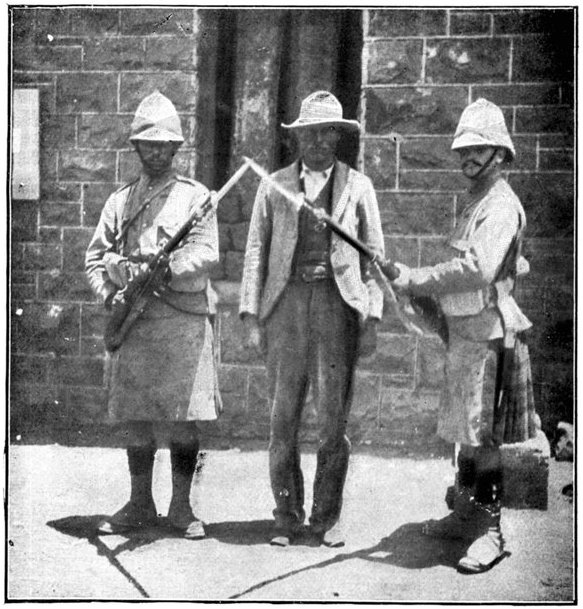
GORDONS IN CHARGE OF A PRISONER.
Showing the khaki aprons worn to hide the kilts.
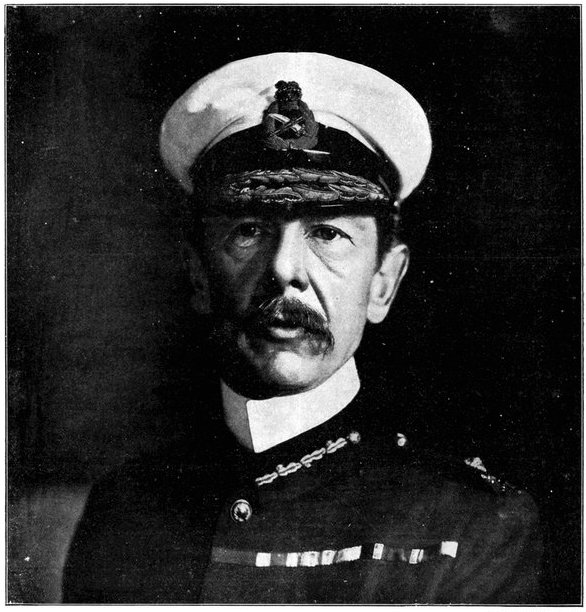
[Photo by Elliott & Fry.
MAJOR-GENERAL SIR HENRY EDWARD COLVILE, K.C.M.G., C.B.
Commands the 1st Brigade (Guards) of the South African Field Force.
He was born in 1852, educated at Eton, and entered the Grenadiers in
1870. Was Aide-de-Camp to the General commanding at the Cape, 1880-83;
served in the Soudan Expedition of 1884; the Nile Expedition (D.A.A.G.
Intelligence Department), 1884-5; and with the Egyptian Frontier
Force, 1885-6, as Chief of the Intelligence Department. He saw service
in Burma in 1893, and in the same year was sent to Uganda as Acting
Commissioner, and the following year commanded the Unyoro Expedition.
Major-General 1898; in command of Infantry Brigade at Gibraltar 1899.
New bridge over the Modder.
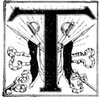
The day after the battle the British column cleansed and occupied the
Dec. 2-10, 1899.] Lord Methuen's Army Reinforced.
Lord Methuen reinforced.
[Dec. 7, 1899.
Boer camp, and the Engineers set to work to replace the railway bridge
over the Modder. So seriously had the iron girders been damaged that
it was necessary to build a new timber bridge, diverting the railway.
The work was by no means easy, as the Modder is liable to rise eight
feet in a few hours, after the heavy thunderstorms which prevail in the
country, so that the new bridge had to be of great strength, while,
as the river banks are high, deep cuttings had to be excavated on
either side. Yet so skilful and energetic were the railway engineers
that by December 7 trains were able to cross to the British camp, and
tents, supplies, and heavy baggage were sent forward to the troops. A
pontoon bridge had been completed some[Pg 173] days earlier, thus securing
communications with the south. At the same time the search-light with
Lord Methuen's army began nightly to exchange signals with Kimberley.
Far away to the north, as the night fell, a beam of light struck the
sky from the besieged city and spent its strength in the flickering
dots and dashes of the Morse code. The welcome news came that all was
well, and that the city was secure behind massive earthworks. While
the army waited, to rest the men and give time for the arrival of
reinforcements, supplies, and ammunition, it was joined by a regiment
of Lancers (the 12th), the G battery of Horse Artillery, one long
naval 4·7-inch gun, and four Highland battalions—the 2nd Seaforths,
1st Highland Light Infantry, 1st Gordons, and 2nd Royal Highlanders or
Black Watch. Last of all, to complete its artillery, came one battery
of 5-inch howitzers, firing 50-lb. shell. Thus, deducting all losses,
Lord Methuen[Pg 174] had 11,000 infantry, 850 cavalry and mounted infantry,
and 750 artillery with thirty guns, not counting the naval weapons. On
the line of communications were half the Northampton battalion and some
small detachments from other regiments.
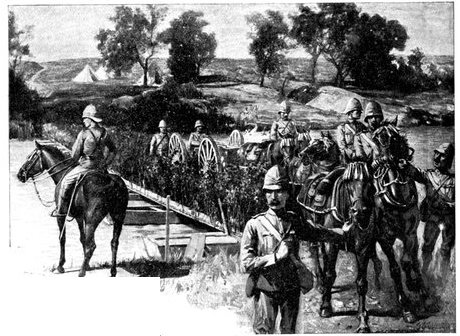
F. J. Waugh.] [After a photo.
ARTILLERY CROSSING THE PONTOON BRIDGE OVER THE MODDER WITH ONE OF THE
HOWITZERS.
British communications threatened.
The last reinforcements arrived from Orange River on December 10. Three
days earlier an unpleasant incident showed how easy for an active enemy
would be the interruption of Lord Methuen's line of communications.
Early on the morning of December 7, a detachment of Northamptons, who
had been left to hold the railway at Enslin, close to the scene of Lord
Methuen's victory of Graspan, heard two loud explosions. A scout was
sent out to ascertain the cause, but as the grey light of dawn gave
place to clear day, the origin of the explosions was manifest. A force
of the enemy from Jacobsdal, 1,500 strong, with three guns, was seen
to be in position to the east of the railway and close to it. The line
to the north had been broken and a culvert destroyed. Fortunately, the
Boers had not yet cut the telegraph wire, and just before they did so,
a message was despatched to Modder River camp announcing the enemy's
presence and appealing for help. At once Lord Methuen despatched
the 62nd Field Battery, the 12th Lancers, and half a battalion of
Highlanders to aid the hard-pressed Northamptons.
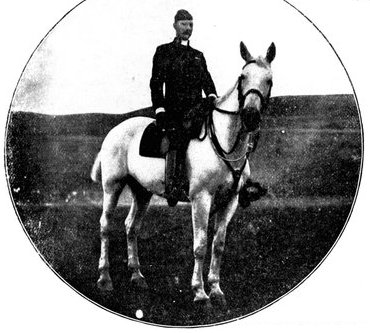
[Photo by W. J. Johnston, Banchory.
THE REV. J. ROBERTSON, CHAPLAIN OF THE HIGHLAND BRIGADE, AT
MAGERSFONTEIN.
Dec. 7, 1899.] Advantageous Position of the
Enemy.
The Northamptons numbered 200, 140 of whom were posted in a small fort
which had been constructed at Enslin round the station; the other
sixty were upon a kopje near the fort and commanding it. The British
force, though without artillery and grievously outnumbered, held its
own bravely in face of the heavy Boer shell and rifle fire. At last,
about noon, the 62nd Battery arrived and opened fire, and the Boers
fell back, leaving on the field five dead, among whom was an officer in
the uniform of the Free State artillery. The British losses were two[Pg 175]
dangerously and nine slightly wounded. General Prinsloo is known to
have been in command of the Boers; his object is believed to have been
the capture of the howitzer battery, the departure of which from Orange
River Station for the north was known to the enemy.
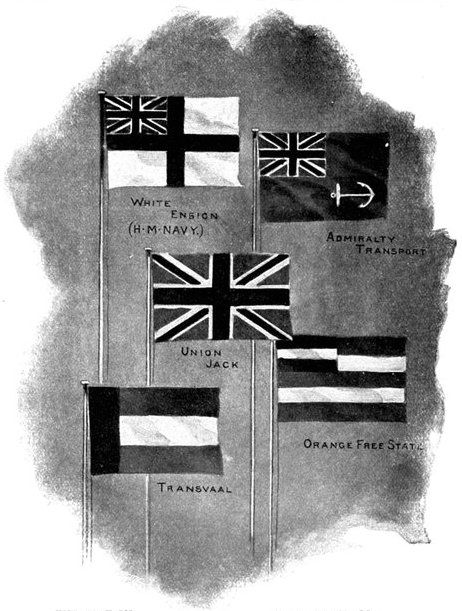
THE BRITISH AND BOER FLAGS.
The white ensign (having a red St. George's cross and the Union in
the corner) is used by Her Majesty's ships; transports fly the blue
ensign with the golden anchor of the Admiralty. The Transvaal flag has
three horizontal stripes, red, white, and blue, with a green vertical
stripe next the staff. The Free State flag is (or rather was) the
only flag of any state having orange as one of its colours; it was
striped alternately orange and white, with red, white, and blue stripes
occupying the first quarter.
The railway was rapidly repaired and communications reopened. The
troops holding it were greatly strengthened by the arrival of the
Canadian and Australian regiments at Belmont, thus rendering any
further attempts to break the line impossible for a small force.
Position of Magersfontein.
During the pause, the enemy's position north of Modder River was
reconnoitred. It was found that the Boers had retreated only some five
or six miles from Modder River, to a line of heights fifteen miles
long, which ran in a semi-circle, with Merton Siding as its centre.
On the left this line of heights descended in a gentle, grassy slope,
covered with thick brushwood and heavily entrenched, to the River
Modder, and so could not be turned. Through the centre of the position
passed the railway line to Kimberley, between two strongly entrenched
kopjes. Away on the enemy's right were yet more kopjes, and to the
rear of the main Boer position was a second series of entrenchments at
Spytfontein. The key to the whole line of works was Magersfontein, a
high hill or group of hills near the Boer centre and to the east of the
railway. The strength of the Boers was only vaguely known. The guesses
of the scouts and the reports of friendly Kaffirs placed it at anything
from 10,000 to 25,000 men. Though considerable reinforcements had been
received from Natal before the battle, it is probable that it did
not much exceed the former figure. Even so, it was equal or superior
in strength to Lord Methuen's division, and had all the advantage of
a strong position, yet further reinforced by skilfully constructed
earthworks.
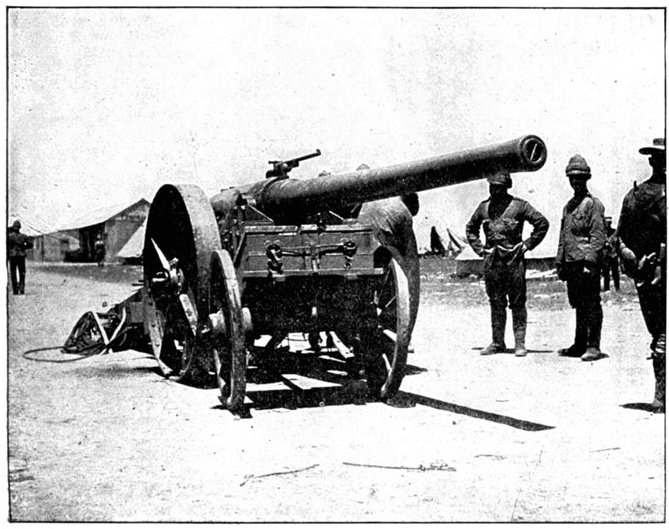
"JOE CHAMBERLAIN": THE 4·7-INCH NAVAL GUN SENT TO LORD
METHUEN AT MODDER RIVER.
[Dec. 6, 7, 1899.
Boer defences.
Guided by the lessons of the previous battles the Boers had thrown
up[Pg 176] their main lines of trenches at the foot of the hills, not on the
slopes or summits. Near Magersfontein they had utilised a long, dry
watercourse, which gave the most admirable protection, and which was
further strengthened by trenches and earthworks. In front these works,
as at the Modder, were hidden from view by the cacti and brushwood,
which thickly covered the level ground. The trenches were deep enough
to give ample shelter to men standing upright; bomb-proofs had been
excavated, in which the men lining the defences could obtain perfect
security during the artillery bombardment—the only thing feared by
the Boers; finally, a high wire fence, by some lucky chance for the
Boers, already existed, running along the front of the works, about 300
or 400 yards away, so as to hold assailants under fire and hamper the
action of the British cavalry. This was supplemented by several lines
of barbed-wire entanglement. The Boer guns were skilfully posted on
the heights, as previous experience had shown that, if placed in the
trenches, they drew the British fire where it was most destructive.
Amongst them were one or two long-range 6-inch Creusots, several field
guns, and a number of "Pom-Poms."
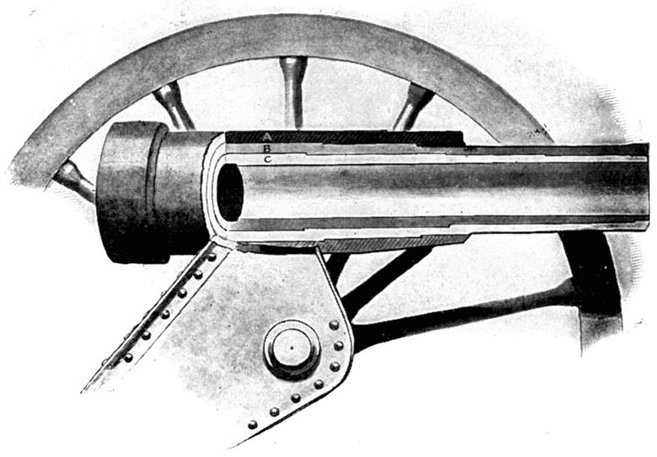
SECTION OF A 5-INCH HOWITZER,
Showing its inner tube C, on which is shrunk first an outer tube B,
then the jacket A. The breech-ring—the projecting portion at the
back—serves both to give additional strength to the breech and for the
attachment of the hydraulic buffers which take up the "recoil."
Boer methods.
An American who visited their position thus describes their plan of
defence at this point:—"The Boers know how to select their ground
and use it with the greatest judgment. They are confident now that
Methuen cannot pass them without losing half his army. Their new mode
of fighting is to put great numbers of their best shots, armed with
Mausers and using smokeless powder, out on the flats in rifle shelters.
On the sky-line of the hills they post their Martini-Henry men with
the old black powder cartridges. The latter are to draw the artillery
fire, while the Mauser men in front are to shoot down the English
infantry and cavalry at closer quarters. All the men have the greatest
confidence in Cronje. He did not believe that the English would attack
him for some time after the Modder fight, but declared that, when they
did, the more men they brought the greater their loss would be."
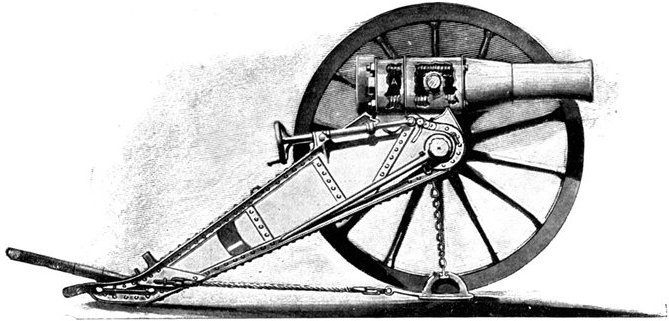
A 5-INCH HOWITZER, AS USED BY THE BRITISH AT
MAGERSFONTEIN.
Partly in section, showing the hydraulic buffers and the apparatus
for raising and lowering the muzzle. This weapon can be fired at an
elevation of forty-five degrees; it is intended to throw its shell high
into the air so that it shall fall within the enemy's earthworks or
other defences.
Difficulty of relieving Kimberley.
Dec. 6-9, 1899.] No Alternative to a Frontal
Attack.
Lord Methuen had positive orders to relieve Kimberley, and the
execution of these grew harder with each day's delay. The enemy's
position was steadily strengthened; fresh works were pushed out;
reinforcements were called up from all quarters, as the Boers laid
enormous stress upon the capture of the diamond city with Mr. Rhodes
inside it. There was no obvious way round; to march off to the west and
endeavour to turn the Boer right would have led the column through a
waterless country, and have left the enemy free to throw their whole
force upon the British line of[Pg 177] communications, thus fatally severing
Lord Methuen from his base. To march to the east, in the direction
of Jacobsdal, would have meant once more crossing the Modder in the
face of a highly mobile enemy, who could move two miles to the British
one—in other words, a repetition of the Modder River battle. There was
only sufficient transport to carry five days' supplies, so that no wide
detour was possible. The last course remained—a desperate course as
it proved—to take the bull by the horns and assault the Boer position
full in the front.
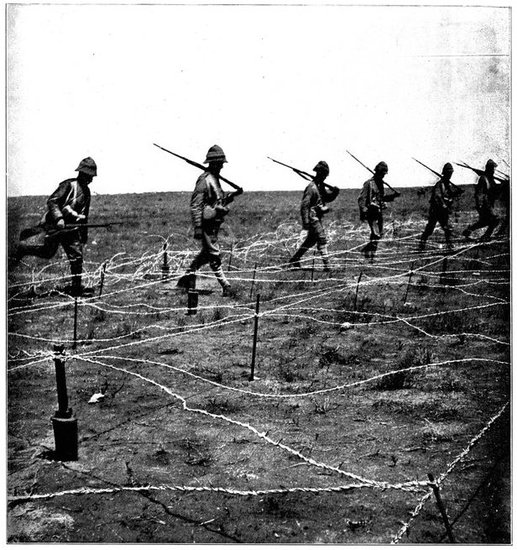
THE BARBED-WIRE ENTANGLEMENTS AT MAGERSFONTEIN.
These entanglements conduced greatly to the defeat of the Highland
Brigade. The photograph was taken after the position had been abandoned
by the Boers.
Skirmishing.
[Dec. 9, 10, 1899.
On December 6 there was skirmishing between the Boer outposts and
the British scouts, two of Rimington's "Tigers" being captured by
the enemy and two Lancers wounded. On the 7th Lieutenant Tristram,
of the newly arrived 12th Lancers, was so unlucky as to be badly
wounded and taken prisoner when on patrol. On the 9th an artillery[Pg 178]
reconnaissance was undertaken; it began with an ineffective bombardment
of the Magersfontein hills by the 4·7-inch gun. At the same time the
cavalry moved out towards the gap of almost level ground between
Magersfontein and the Modder and drew a scattering fire, while the
horse artillery battery fired a few rounds at a distance of 6,000 yards
from the Boer works without producing the slightest impression. With
wise self-restraint the Boers avoided disclosing their position, and
the reconnaissance taught the staff little or nothing. The greatest
difficulty all through Lord Methuen's brief but fierce campaign was to
locate the enemy exactly. And in no case could this be accomplished
till battle had been joined and the main attack delivered.
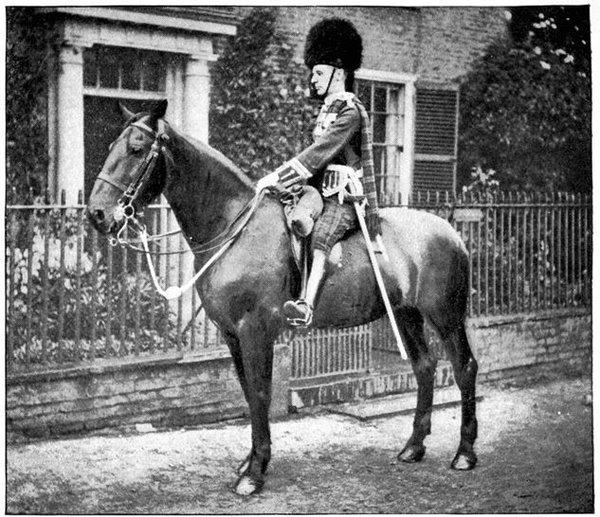
[From a private photo, supplied by Mr. T. Kemp, Dalkeith.
MAJOR-GENERAL WAUCHOPE.
Entered the Navy in 1859 as midshipman on board the St. George. Six
years later he entered the Army; served in the Ashanti War, 1873-4, the
Egyptian War of 1882, and the Nile Expedition of 1884-5. Commanded the
First Brigade at Omdurman and Khartoum, 1898, and the Highland Brigade
at Magersfontein, 1899, where he was killed.
Lord Methuen's plans.
Next day, Sunday, the 10th, Lord Methuen made his plans. That evening
the Boer trenches were to be bombarded for two hours just before
sunset. During the night the Highland Brigade, under Major-General
Wauchope, was to march out and at dawn deliver an assault upon the
Magersfontein kopjes. In this terrible enterprise it was to be
supported by the Guards' Brigade and the whole strength of the British
artillery. The plan was kept absolutely secret and no one outside the
staff could more than conjecture what was in hand.
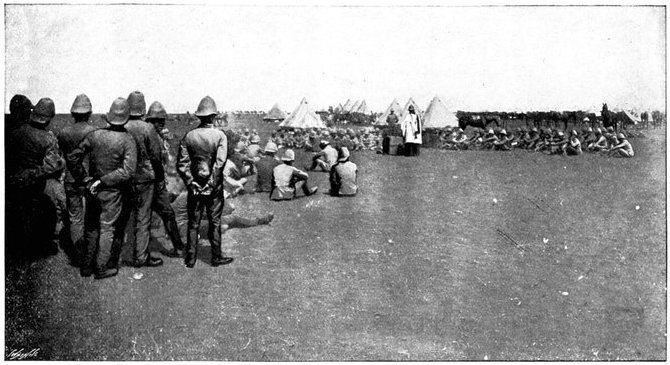
DIVINE SERVICE IN CAMP AT MODDER RIVER.
Dec. 10, 1899.] Sunday Selected for the
Bombardment.
Choice of Sunday.
On Sunday there was Church Parade, the troops assembling for divine
service in full marching order upon the open veldt. It was a dramatic
scene, which came vividly back to many memories[Pg 179] when the bloody work
of the following night and day had stretched so many of the worshippers
lifeless upon the veldt. It seems unfortunate that Lord Methuen should
have chosen Sunday for the beginning of the attack, seeing that, by
a tacit understanding between the two opposed armies, this day was
considered one of peace and rest. Putting Sabbatarian prejudices
aside—and they must, as all men would allow, have at times to yield to
real military necessities—it may be doubted if there was any necessity
on this occasion which enjoined the immediate delivery of the attack.
To have postponed it by twenty-four hours would have done no man any
harm and would have spared the nation the sorrow of learning that many
Boers had been killed by lyddite shells while engaged in prayer and
worship. Just as after the battle of Bull Run, in the American Civil
War, a popular explanation of the Northern defeat was that the Northern
generals had desecrated the Sabbath by attacking on that day and had
provoked the anger of God, so in England there were some who attributed
the British repulse at Magersfontein to this profanation of a holy day.
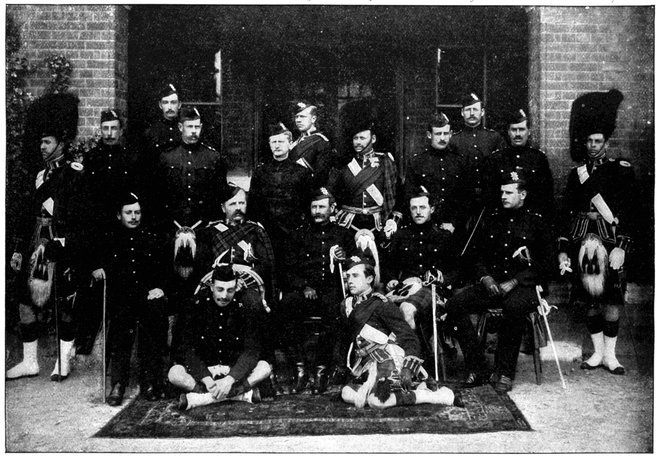
1. Lieut. A. S. Grant. 2. Capt. Hon. J. F. T.
Cumming-Bruce (killed). 3. Lieut. W. P. Nunnerley. 4. Major P. J. C.
Livingston. 5. Lieut. H. C. W. Berthon (killed). 6. Capt. C. Eykyn.
7. Lieut. S. A. Innes (wounded). 8. Capt. E. J. Elton (killed). 9.
Lieut. N. N. Ramsay (killed). 10. Lt.-Col. Coode (killed). 11. Capt. W.
Macfarlane, Adjt. (killed).
OFFICERS OF THE BLACK WATCH, MOST OF WHOM WERE WOUNDED OR KILLED AT
MAGERSFONTEIN.
Disposition of troops.
[Dec. 10, 1899.
Attack on Magersfontein kopjes.
On Sunday afternoon the last preparations were made. Messages had been
flashed to Kimberley to convey the welcome news that the arrival of
the column might be expected at any moment; trains were ready to bring
away refugees from the diamond city; everyone was alert and confident.
At 2 p.m., without kit, but with half-a-days' rations, the force moved
out to battle. First went the Lancers, then the Highlanders with the
five batteries of guns and howitzers, and last of all the Guards'
Brigade, who followed at sunset. The Ninth Brigade, composed of the
Yorkshiremen, Northumberlands, Northamptons, and Lancashires, had the
task of guarding the camp. The column struck out to the north-east,
deployed its guns, and opened a tremendous fire with lyddite shells
and shrapnel upon the Magersfontein kopjes. "The lyddite[Pg 180] explosions,"
writes Mr. Whigham, the Morning Post correspondent, "began along
the top of the Magersfontein ridge, each shell throwing up a cloud of
wreckage like a gigantic mushroom suddenly springing from the hill top,
while the shrapnel of the field and horse batteries searched every nook
and cranny of the rocks." Some of the earlier shells fell amidst a
number of Boers assembled for prayer and are said to have killed forty,
but after this there was little loss, for the reason that there was no
enemy on the kopjes. The Boers were lining the trenches at the foot of
the hills, where they were in perfect safety, as the artillery made no
effort to search these works, which were, indeed, quite invisible. In
consequence, they were able to watch this terrific bombardment with the
same interest and amusement as if it had been a firework display. Not
a shot did they fire in reply, and their calculated silence speedily
produced an impression in the British Army that they either had
abandoned or would at nightfall abandon their lines.
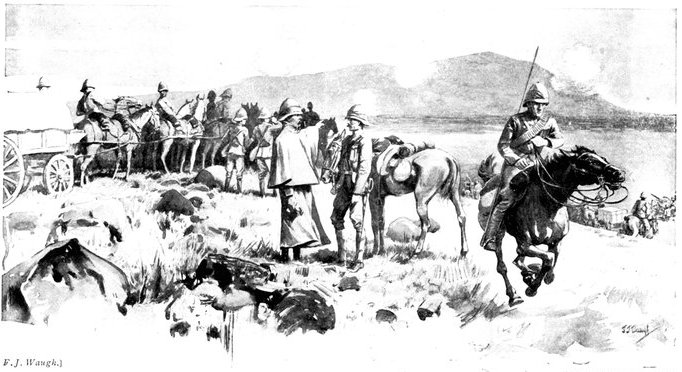
F. J. Waugh.] [After a sketch on the spot by W. B.
Wollen, R.I.
LORD METHUEN WATCHING THE BOMBARDMENT OF MAGERSFONTEIN.
General Wauchope's premonitions.
Dec. 10-11, 1899.] Disheartening Conditions of the
Night March.
At 6·45 p.m. darkness came on and the bombardment ceased. The evening
was gloomy and the sky heavily overcast, yet a fitful moon showed
through the clouds. The troops bivouacked where they had stood
during the bombardment, the Highlanders directly to the south of
Magersfontein, the Guards on the right, and the batteries in place,
ready to open fire at the ranges which they now well knew. A hasty
meal was made of biscuit and bully beef. Silence was maintained and no
one might raise his voice above a whisper; no fires were allowed; even
pipes could not be lighted. In rear of the infantry Lord Methuen gave
General Wauchope his last orders; then the Major-General instructed
his battalion commanders as to what was to be done. It was noted by
many after that sad night that for days before the Major-General had
seemed to forebode his swiftly coming end. His very look bore the
"reflection of death." In every campaign in which he had fought he
had been wounded; now, it was said, he knew that he was fated to die.
Yet, like a brave and proud soldier, he never spoke of these things.
He was reported to have strongly protested to Lord Methuen against
the night attack, and more especially against the order to march
in quarter column, though on rough ground at night this was a not
unreasonable disposition. Be this as it may, there were no witnesses at
the interview, and the story can only be founded upon vague conjecture.
It was also said that he had remarked to an intimate friend upon the
nature of his instructions, which seemed to him at once too vague in
their indication of the enemy's position and too precise in prescribing
the formation to be adopted. There[Pg 181] is certainly a concurrence of
evidence that the General was rendered uneasy by his orders and
anticipated the worst results.
Night march.
The night march was to begin at 12·30, the Brigade in quarter column,
which means that the eight companies of each battalion were to be
in eight lines, one behind the other and six paces apart. The four
battalions also were behind each other, so that the front of the mass
of men was but one company, or about 100 men, shoulder to shoulder, and
the depth thirty-two ranks. Thus, half-a-dozen men might be stricken
down by a single bullet and a hundred killed by one shrapnel skilfully
timed. The reason for the closeness of the formation was the difficulty
of keeping the men together in the darkness. Ropes were to be used
to enable the troops to maintain their order. On nearing the enemy's
position at 3·25 a.m., or just before daybreak, the Black Watch was to
deploy on the right to the east of Magersfontein, the Seaforths next
to them, and then the Argyll and Sutherlands, with the Highland Light
Infantry in reserve. The three leading battalions were to extend,
placing each of them two companies in the firing line, two in support,
and four in reserve.
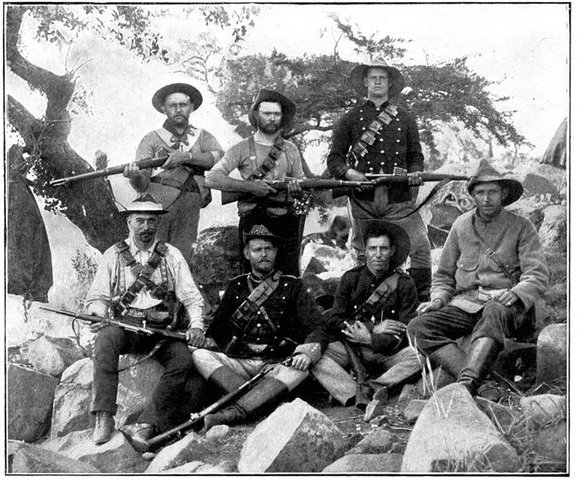
HOW THE MAUSER IS LOADED.
A group of Boers, some of whom are in the act of pressing the clips of
five cartridges each into the magazines of their rifles.
The men—even the company officers—knew nothing of what was intended
beyond the fact that they were to march out, and, as they supposed,
attack the kopjes. They were given no food before they started and
had nothing with them but their emergency ration. Some of them, no
doubt, were nervous and highly wrought, with the natural anxiety of
men going into battle for the first time against a redoubtable enemy,
and thus it was that two rifles were accidentally discharged just
before the brigade began its eventful march. About 1 a.m. the head of
the column began to move off like a phantom host into the impenetrable
darkness. The young moon had set and the obscurity was intense. About
half-an-hour after the march began, the night turned from sweltering
heat to intense cold and simultaneously a torrential rain descended
as a violent thunderstorm broke over the troops. The flashes of
lightning were vivid and incessant; they affected the compasses which
Major Benson, guiding the column, carried, one in each hand, and the
resulting uncertainty delayed the advance. Moreover, the apparently
level veldt was found upon closer acquaintance to be full of pitfalls
in the darkness. At every moment men stumbled over ant-hills, or
boulders, or caught in the six-feet-high Vaal bushes which covered the
ground.
Soaked through, chilled to the bone, sleepless, breakfastless, and
weary, the Highlanders continued their advance, and each minute the
night seemed to the men's anxious eyes to grow blacker. The ground had
not been carefully reconnoitred beforehand, although it is a recognised
rule that[Pg 182] night attacks must only be made over country which has been
thoroughly examined by the staff; so that it was difficult to avoid
some confusion. On the extreme right could now be seen the flashing of
a light; its meaning no one understood, but this much was certain, that
it was not shown by a Britisher. It caused a feeling of apprehension,
as it revealed that someone amongst the enemy was aware of the march
and was following it. On the British left, far ahead in the enemy's
position, showed an answering light. It burnt brightly and steadily,
and the men watched it with fascinated curiosity. They did not know
that at 2 o'clock that morning the enemy had manned the trenches, and
was now only waiting their approach to begin the slaughter.
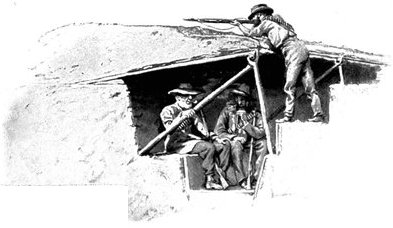
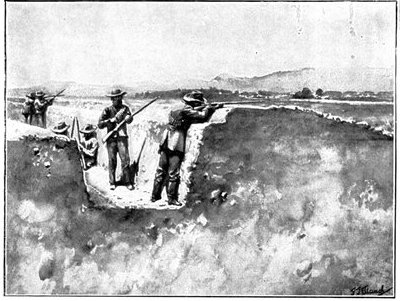
SHELTER TRENCHES.
These diagrams show how some of the Boer trenches would look if cut
through. Examples of both kinds were found at Magersfontein. The
British in the besieged towns used similar protections. Often sandbags
were added for further protection.
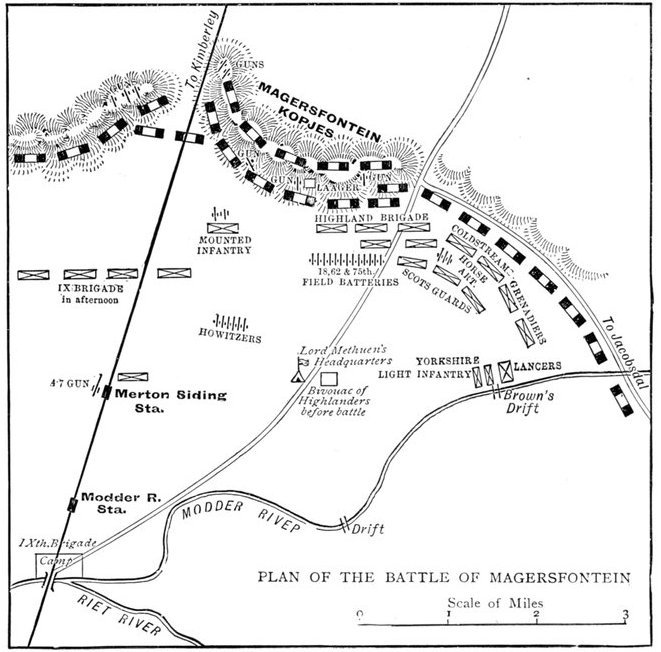
PLAN OF THE BATTLE OF MAGERSFONTEIN
Dec. 11, 1899.] The Highlanders Taken by
Surprise.
Boers open fire.
The brigade, still in its close formation, was nearing the foot of the
hills, which could dimly be made out looming through the darkness.
The Black Watch, in the front of the column, were, unfortunately, in
great confusion, having encountered first a high, wire fence, difficult
to negotiate, and then a particularly dense and tangled patch of
brushwood, in passing through which they were unable to avoid making
much noise and losing their formation. This may have delayed the
deployment, but if the statement of one of General Wauchope's staff can
be believed, neither the staff itself nor the officers of the brigade
had any distinct knowledge of the enemy's position, or knew that there
were trenches in front of the Highlanders. Be this as it may, already
Major Benson had suggested to General Wauchope that, as the hour was
nearly 4 o'clock, and the day was already beginning to break, it
was time to open out. The General had, it would seem, misunderstood
his orders and supposed that he was to maintain close formation up
to a point near to the enemy's[Pg 183] lines. It is alleged, with doubtful
truthfulness, that again and again he exclaimed, "This is madness!" At
last, however, he determined to extend his brigade. The madness, if
madness of others it was, had gone far enough. As the Seaforths worked
round the thicket to the right and regained touch of the Black Watch,
the order to extend was given to the four battalions. But just as the
order was issued and before it had been executed, the bright light
ahead on the left went out, and at that instant a single rifle was
fired.
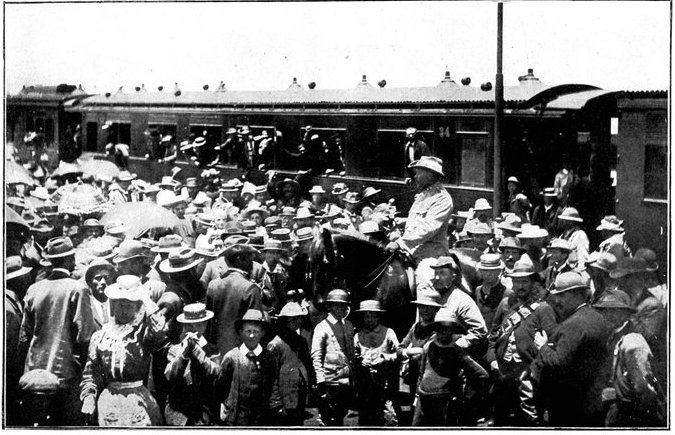
[Barnett, Photo.
BOER REINFORCEMENTS LEAVING PRETORIA: COMMANDANT SCHUTTE ADDRESSING
THEM.
Demoralisation of Highland Regiments.
This was the signal for a deadly volley from the Boers. To the
amazement of the Highlanders the ground just in front of them seemed to
burst into a sheet of flame, not 100 yards away. As a matter of fact
the distance was 400 yards or a little more, but in the semi-darkness
of the dawn, now at last breaking over the hills, and in the
bewilderment of the complete surprise, the enemy seemed much nearer.
The fire was such as troops in close order had never before in history
experienced. From the magazine rifles of the Boers poured a continuous
stream of lead upon the struggling, confused mass of British soldiers,
"packed like sardines." The disorder was terrible; in the darkness the
men could not discern their officers or sergeants and knew not whom to
obey or how and where to rally. All manner of cries and orders were
heard: "Lie down!" "Extend!" "Fix bayonets!" "Charge!" "Retire!" "No,
Forward!" Two companies did charge, but, stung by the hail of bullets
from in front and fired into also by the excited men behind, had to
fall back. The fatal order "Retire," pronounced by some unauthorised
person, was repeated and caught up. It accorded with the dictates of
instinct and of panic fear, and a great part of the Black Watch bolted
back in the wildest disorder, breaking the ranks of the Seaforths and
throwing them also into dire confusion.
Accounts of the fighting.
[Dec. 11, 1899.
The accounts of the soldiers who fought give a vivid picture of that
terrible scene. "The whole of the hillside was lit up with the most
damnable discharge of rifles that anyone can possibly imagine," says
a colour-sergeant of the Black Watch. "They seemed to be formed up in
tiers all up the hillside, and were pouring magazine fire into us at
a terrific rate. Then came all sorts of shouts—'Lie down!' 'Charge!'
'Extend!' and of the whole brigade there was[Pg 184] only the front rank of
'A' Company of ours that could have used their rifles, as everybody
else was straight in rear of them. Well, two companies in front did
charge, but were stopped by barbed wire fences and entanglements
fifteen yards from the trenches and mostly shot down. Others broke
to right and left or retired, and after waiting about a minute for
a bullet to hit me, as it appeared impossible to escape one, and as
it did not arrive, I thought perhaps it was advisable to go with the
remainder. With proper handling we could have cleared the Boers out
in two hours; as it was, we were taken into a butcher's shop and left
there."
A Seaforth Highlander says:—"When we started to extend they opened
fire on us, and such a hailstorm of bullets I don't want to experience
again. It was seen that someone had blundered. We were fairly at their
mercy; we were in the wrong position and had to retire. And what a
rabble—bullets in thousands coming after us; men falling right and
left. We rallied up in line and made one effort, and stuck to it,
advancing and firing all the time."
"It was not fighting, it was simply suicide. Men were hung on the wire
like crows and were riddled with bullets," says another soldier. "Our
hearts were broken after the reception we got at the start."
One of the Argyll and Sutherland Highlanders writes:—"We were just
thinking that the Boers had retired, and were about 100 yards from
their trenches when we were greeted with a storm of bullets from
thousands of men, and the whole brigade fled for their lives. The men's
hearts were broken at the start, and they were like children all the
day. Men were advancing and retiring by themselves trying to fight,
but there were no officers to do the leading so we could expect to do
nothing."
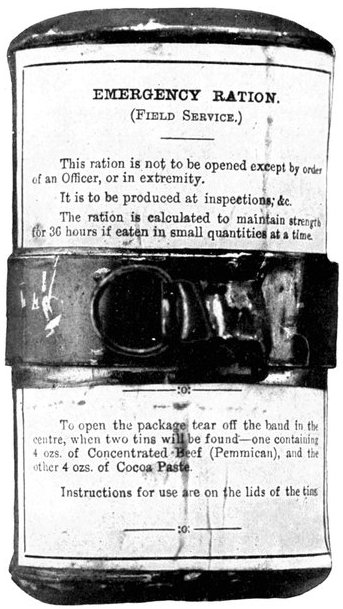
THE EMERGENCY RATION
Carried by every soldier in his haversack and produced at every
inspection. It was the only food available for the men in exposed
positions at Magersfontein.
"We got the word to retire," wrote a private of the Black Watch, "and
while we were doing so the bullets were flying like hailstones all
round us. It was a miracle how I escaped. I got my rifle blown out of
my hand, and a bullet through my helmet, and another grazed my leg,
taking away a bit of my spat. I never witnessed such a horrible sight
in my life. General Wauchope was shot at the beginning when we charged.
When he saw the mistake that happened, he said, 'Rally round, Black
Watch; it is not my fault,' and fell riddled with bullets. We formed up
again, and advanced to about 200 yards from the hill, and lay down and
kept up firing."
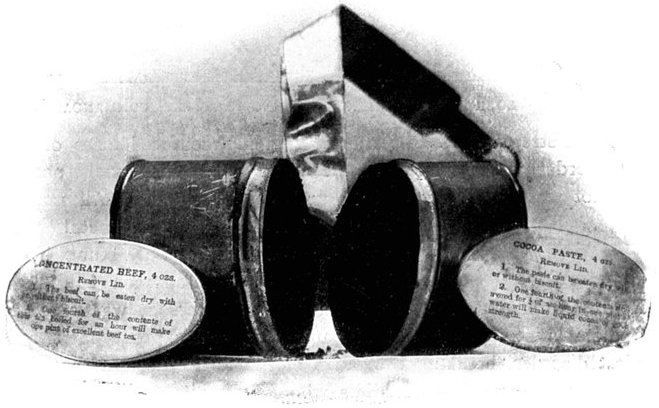
THE EMERGENCY RATION OPENED, SHOWING CONTENTS.
[Pg 185]
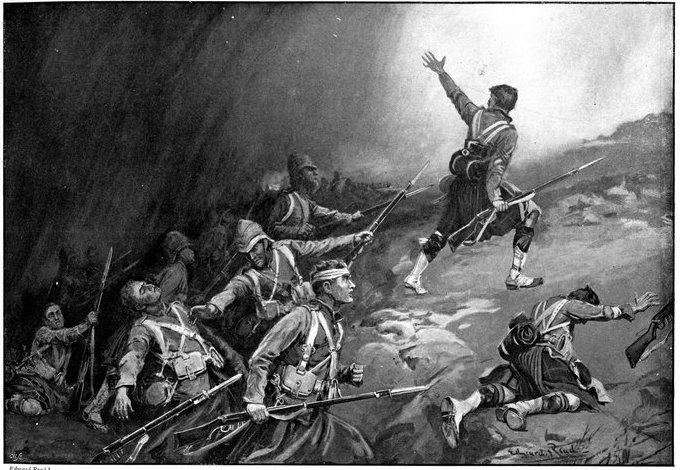
Edward Read.]
THE CHARGE OF TWO COMPANIES OF THE BLACK WATCH AT MAGERSFONTEIN.
[Pg 186]
[Dec. 11, 1899.
But no letter shows better the powerlessness of the men than this
from a Highland Light Infantry man:—"What could we do? It was dark;
the men did not know where they were. Somebody shouted 'Retire!' and
we did—well, not a retire, but a stampede; 4,000 men like a flock
of sheep running for dear life. Had we opened out in attacking or
skirmishing order, we could have rushed the trenches, but in the
formation we were in we were helpless. After they rallied they had not
the heart to fight after being led into a trap at the start; but we
stood it wonderfully well, although only a half-hearted affair."
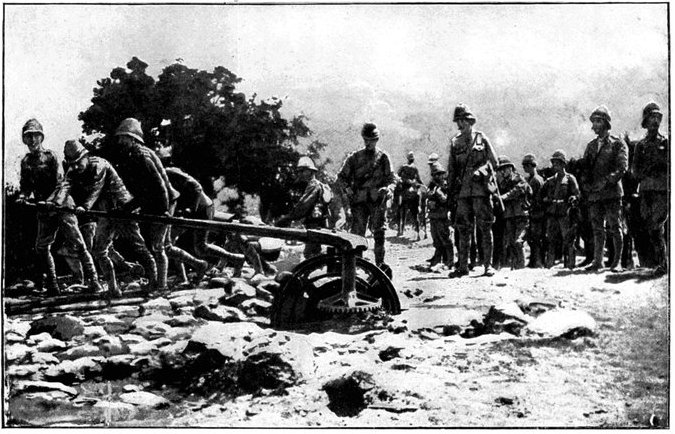
THE WATERWHEEL WHICH SUPPLIED THE BOERS AT
MAGERSFONTEIN.
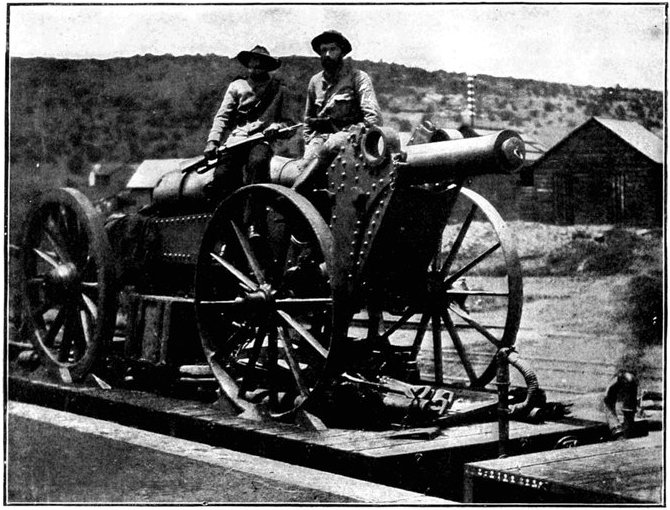
CREUSOT 15-CM. (6-INCH) GUN.
As used by the Boers from the hill top at Magersfontein, and outside
Ladysmith and Mafeking.
General Wauchope's death.
Dec. 11, 1899.] The Limit of Endurance Passed.
Amongst the very earliest victims of the murderous fusillade is said to
have been the noble and devoted General Wauchope. His body was found
well in advance, riddled with bullets. That he ever uttered the words
attributed to him, "Don't blame me, my lads, it was not my fault," is
not to be believed. The story circulated in camp after the battle, but
like so many camp legends seems to have no solid foundation. It was
alien to the fallen General's character; alien to his high sense of
discipline and to his pride as a British soldier. As he had silently
obeyed and executed an order which he may well have feared would prove
to be disastrous, so he went silently and uncomplainingly to his death,
leaving posterity to do his memory justice. As to the time and manner
of his death there is some dispute. Many declared that he fell at the
first murderous volley; but one private asserts that he lay down with
those of the Black Watch who did not bolt, and after some little time[Pg 187]
determined to go back to the remnant of his brigade, further towards
the rear. He was begged not to do so, but rose with four others and was
almost instantly killed.
Collapse of the Highland Brigade.
Those who have read of "heroism," of "fearlessness of death," and all
the popular phrases which describe the bearing of the soldier on the
field of battle, may deem the true story, which we have given above,
ignominious and dishonourable to the Highland Brigade. Yet when the
truth is told, such incidents happen on every battlefield, and the best
and bravest men are subject to sudden collapse under the conditions
that this brigade had to encounter. At dawn it is a physical fact
that the intellectual force known as morale is at its feeblest. The
men were hungry, drenched, cold, confused, surprised, exposed to a
more than decimating fire. Death had come suddenly amongst them at an
unexpected moment, with all the awful and heart-rending sights of the
battlefield. On every side were dead, and dying, and wounded men—a
chaos, a babel of cries dominated by the furious rattle of the Boer
musketry. The inevitable happened, and the men, without leaders or
guidance, went back instead of forward. There are limits to devotion
and self-sacrifice.
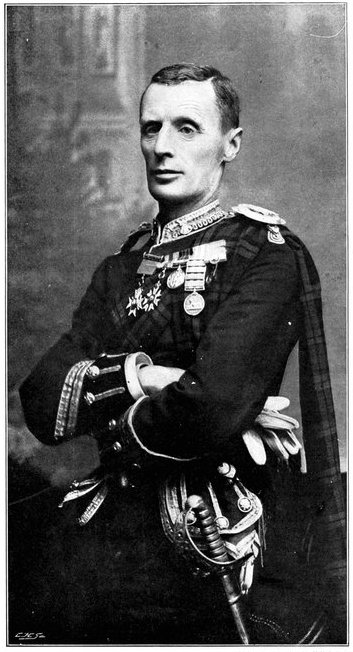
[Photo by Horsburgh, Edinburgh.
GENERAL WAUCHOPE.
Some particulars of his career are given beneath the equestrian
portrait on page 178.
[Dec. 11, 1899.
Nor did the Black Watch fall back far. The men, in spite of the
terrible shaking they had received, were speedily rallied; they lay
down a thousand yards or more from the enemy's position, and opened a
spasmodic fire upon the Boers. The Seaforths rallied, too, and advanced
by rushes, drawing close to certain outlying Boer rifle pits. They
lost heavily. Officers and men, to quote the letter of an officer who
led the rushes, "were bowled over like rabbits." Some of the Black
Watch, who had not retired but had advanced in spite of the Boer fire,
actually reached and entered the enemy's trenches, but, unsupported,
were made prisoners. In all, of that famous and gallant regiment, about
one fourth fell at the first deadly volley from the Boers. In the two
leading companies, 200 strong, three-fourths were shot down. A chaplain
in the ranks, who was knocked down in the rush to the[Pg 188] rear, declared
that the panic was awful, but that there lived no men who would have
done otherwise than they did.
Artillery support.
The two other Highland battalions, though greatly confused and involved
in the sudden panic, did not suffer as severely, being further to the
rear. They were likewise rallied. Things were in this posture: the
attack had hopelessly failed, and the ground before the shattered
Highland Brigade was strewn with killed and wounded, many of the latter
destined to receive wound after wound under the cruel fire when it
grew light enough to see more plainly. At once, with a crash and a
roar, came a lyddite shell, aimed from the 4·7 at the enemy's position,
bringing the Highlanders welcome news that they were no longer to fight
unsupported. Then followed the din of the thirty British howitzers
and field guns, bombarding the Boer trenches might and main to take
the pressure off the Scotsmen. Their much-needed aid was not without
effect. It was no longer possible for the Boers to fire with complete
impunity, and though the Highlanders could not retreat or move without
drawing a storm of bullets, they no longer lost heavily. Like the
British troops at the Modder River, they lay flat on the ground behind
what cover they could find. Yet their trials were by no means at an
end. To have to remain prostrate, motionless, without food or water for
sixteen weary hours till twilight fell, under a tropical sun, in sight
of their own wounded, to whom little or no help or comfort could be
given, was a dismaying prospect for men who had already endured so much.
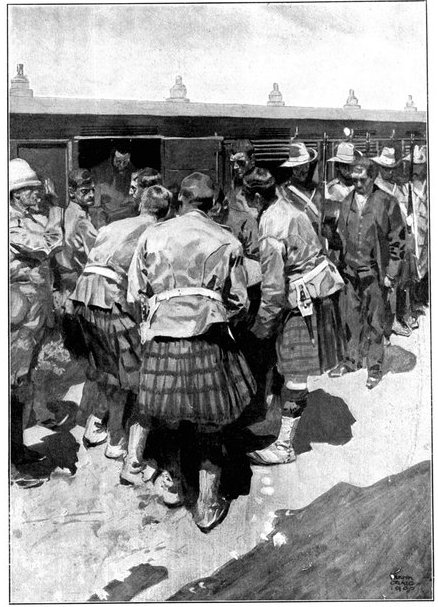
Frank Craig.] [
After a photograph.
PLACING THE BODY OF GENERAL WAUCHOPE IN THE TRAIN AT MAGERSFONTEIN.
General Wauchope was temporarily buried near his men at Magersfontein.
His body was afterwards exhumed and carried by rail to Matjesfontein,
in Cape Colony, where it was buried with military honours in a
beautiful cemetery four miles from the railway station. A picture of
the start from Matjesfontein station is given on page 172.
Reinforcements.
Dec. 11, 1899.] Magnificent Conduct of the
Artillery.
The battle was as good as lost, for one third of Lord Methuen's little
army had been stricken down or so demoralised in the brief minutes
of the night attack, that little could henceforth be expected of it.
To assault the unbroken enemy in the full light of day was a course
which could hold forth no promise of success, and which must have
involved enormous losses. To withdraw the Highland Brigade was equally
impossible. The only plan that could be followed was to bombard the
enemy's position assiduously, holding the ground already won, in
the hope that the Boers might here, as at Modder River, be cowed by
British stubbornness and decide upon an eventual retreat. Lord Methuen
reinforced the shaken Highlanders by two[Pg 189] battalions of Coldstreams on
the right; the two other Guards' battalions were held ready to give
support, the Grenadiers on the right and the Scots Guards on the left.
The 9th Lancers, the 12th Lancers, the mounted infantry, and G Battery
of Horse Artillery pushed in on the extreme right and attempted a
turning movement. They were at once very hotly engaged.
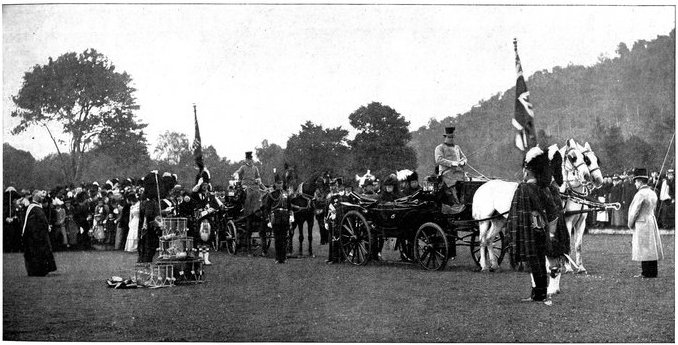
[Photo by Milne, Aboyne.
HER MAJESTY PRESENTING NEW COLOURS TO THE 2ND BATTALION SEAFORTH
HIGHLANDERS AT BALMORAL, September 29, 1899.
The 2nd Battalion of the Seaforth Highlanders, which lost heavily at
Magersfontein, had greatly distinguished itself in the Afghan War and
the Chitral and Black Mountain Expeditions. Last September Her Majesty
presented the battalion with new colours at Balmoral. The Queen, in
doing so, said to Colonel Hughes-Hallett: "I rejoice to be able once
more to present new colours to this distinguished regiment, in which I
take an especial interest from its being associated with my dear son
the Duke of Albany." The old colours are deposited for safe keeping at
Balmoral. A week or two before Her Majesty had presented new colours to
the Gordons.
[Dec. 11, 1899.
The three field batteries—18th, 62nd, and 75th—which had so
distinguished themselves at Modder River, here also proved the
salvation of the British column. But for their devoted efforts and the
superb conduct of G Horse Battery, the repulse might well have been
converted into a complete disaster. The field guns opened at a range
of about 2,000 yards, and, as the morning advanced, gallantly pushed
forward to a point only 1,200 yards from the Boer trenches, where they
were without cover and exposed to the enemy's rifle fire. G Battery
had simultaneously closed in to 1,500 yards, and the big howitzers to
something under 3,000. At first the [Pg 190]Boer artillery seemed inclined
to engage in a duel with the British guns, but after forty or fifty
rounds it ceased its fire. Our weapons were left free to sweep the
sides of the kopjes and the closely-lined but invisible trenches with
shrapnel. It is not probable that they inflicted heavy losses; the
enemy was much too well covered for that. But they absolutely prevented
any counter attack during the critical hours of the morning; they shook
the accuracy of the Boer fire; they gave Lord Methuen time to make
fresh dispositions; and they cheered and encouraged the Highlanders in
the fighting line by the sense of moral support which their furious
racket caused. The calm intrepidity of the gunners especially attracted
the wonder and admiration of all on the battlefield, and, strange
to say, despite their exposed position and proximity to the enemy,
they suffered only the most insignificant losses. The horse artillery
at first came in for a heavy shelling, but not a driver moved or
dismounted. The sergeant-major walked coolly to and fro inspecting the
formation and harness, as if he were on parade.
Over the battlefield hovered the great war balloon which had but
recently arrived, and from the car the movements of the enemy to the
rear and on either side of the Magersfontein position could be at times
discerned. A steady stream of reinforcements was made out coming from
Spytfontein and the extreme right of the Boer lines, and there were
signs that the enemy was, in his turn, preparing a flanking attack
against the British right. Only the steadiness of the Guards and the
accuracy of their fire foiled this purpose. To increase the pressure
upon the enemy's centre, Lord Methuen about noon sent forward the
Gordons to the help of the Highlanders. The Gordons had but recently
arrived and had been held back, in consequence, to guard the supply
train. They extended and pushed into the fight in separate half
battalions, under a vigorous fire.
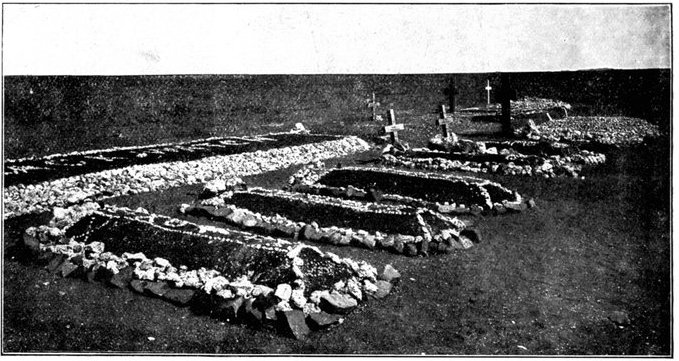
GRAVES OF THE HIGHLAND BRIGADE AT MAGERSFONTEIN.
The long grave on the left is that of the Black Watch. In front, the
single graves of officers killed at the battles of Magersfontein and
Spytfontein. General Wauchope was originally buried here (see note to
illustration on page 188).
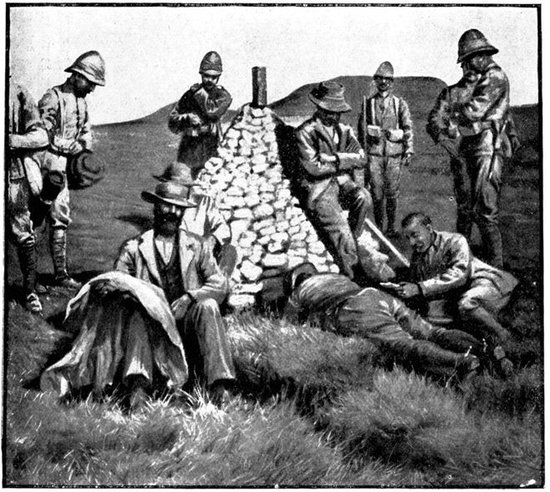
BOER PRISONERS AT MODDER RIVER.
[Pg 191]
Dec. 11, 1899.] No Food, no Water.
The wounded of the Highlanders, lying close to the Boer trenches, were
able to see a good deal of the enemy's movements. One of the Boers, a
German in appearance, attracted great attention. Faultlessly dressed,
with patent leather boots, and a cigar in his mouth, he was seen
walking among the ant hills, alternately using field glasses and rifle,
and picking off the British officers. The volleys and individual fire
of our men failed to bring him down. He seemed to bear a charmed life.
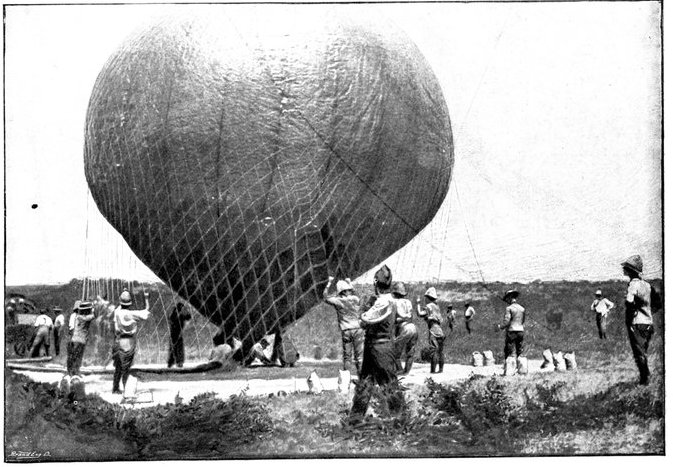
FILLING THE WAR BALLOON.
Here again, as at Modder River, as the sun rose higher and higher and
the heat grew intense, the men suffered agonies of thirst. The water
bottles had long since been emptied. "The troops," wrote a Black Watch
private, "were dying for want of food and water. The sun had risen
about eight o'clock, and we lay there getting our legs burned and
blistered—frightened to move, as the bullets were flying all around."
Great, however, as were the torments of the whole and uninjured, even
more terrible were those of the wounded lying out at the very front,
close to the Boer trenches, and far beyond the reach of aid from the
stretcher companies and ambulances. Yet the restraint of the stricken
men was wonderful. The wounded, says Mr. Ralph, did not writhe or
groan. Only one or two dying men cried for the doctor or begged to be
killed. Others exclaimed in a low voice, "Oh, dear, dear, dear!" All
wanted water and cigarettes. They accepted their lot with a sad and
noble resignation. Many had been hit with expanding bullets, which, in
defiance of the conventions of war, the Boers only too often employed.
These described the sensation thus: "You feel," they said, "exactly as
if you had received a powerful shock from an electric battery, and then
comes a blow as if your foot (or arm, or whatever part it might be),
was crushed by a tremendous mallet." The Mauser bullets, where they did
not hit the bone, merely produced a stinging, burning sensation.
[Dec. 11, 1899.
Heroism on the field.
Many gallant efforts were made by the medical officers and others to
succour the wounded. Lieutenant Douglas, of the Black Watch, under a
tremendous fire, advanced and attended to Captain Gordon, who was badly
wounded, and to others of the Gordons. Band-Sergeant Hoare, of the[Pg 192]
Seaforths, was equally conspicuous for his coolness and daring. He,
unaided, carried a wounded officer on his back 800 yards to the rear.
Here, as elsewhere, the stretcher bearers distinguished themselves
by their calm disregard of death. Among the many noble deeds of this
terrible day, that of Major Lambton, of the Coldstreams, deserves to be
recorded. He refused to allow the bearers to carry him, when wounded,
off the field, because this would have drawn upon them a heavy fire and
would have imperilled their lives. In consequence, he was left upon the
ground thirty-seven hours without food or water.
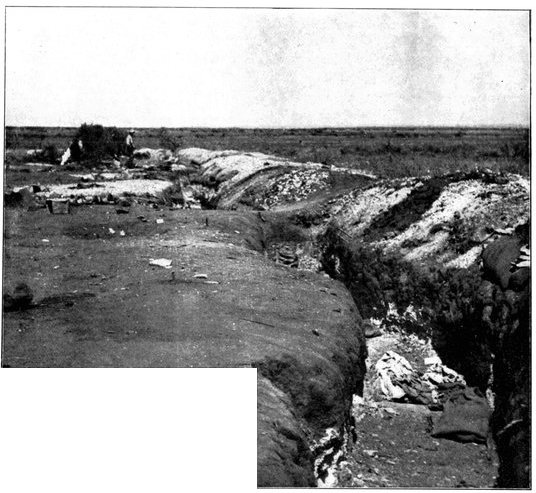
TRENCHES AT MAGERSFONTEIN.
Protest against Lord Methuen's orders.
From which the Highland Brigade were shot down. From a photograph taken
after their evacuation by the Boers.
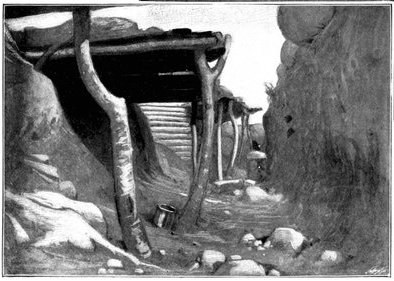
A SHELTER-TRENCH AT MAGERSFONTEIN.
Dec. 11, 1899.]
The Highlanders Give Way again.
Meantime, the Gordons and the Guards were gaining ground considerably;
the Guards even got near enough to catch a sight of the enemy in
their trenches now and then, and to observe that from time to time
they refreshed themselves from the gin bottles, which were always
found in great plenty in the captured Boer positions. Soon after one,
Lord Methuen sent orders to the Highlanders to hold their position
till nightfall, when the Guards and the Gordons were to assault the
trenches at the point of the bayonet. The difficulty of sending
instructions to the fighting line upon the modern battlefield is shown
by the fact that Lieutenant Cuthbert, the bearer of Lord Methuen's
message, received a volley from the Boers, which killed his horse
and riddled his accoutrements, fortunately without touching him.
The order had been given in the teeth of the vigorous protests of
one of the Guards' Colonels, who pointed out to Lord Methuen the
hopelessness of undertaking such an enterprise with weary, hungry
men, and without any adequate support. It was not that he or his men
were afraid, but that one brigade had already been shattered, so that
the virtual destruction of another must mean the complete ruin of the
column—perhaps even its envelopment at Modder River camp, with the
most disastrous consequences. Were[Pg 193]
Magersfontein taken, the second Boer position remained to be dealt
with. Thus there was nothing to be gained by adopting the desperate
course of imperilling the safety of the whole division upon another
night assault.
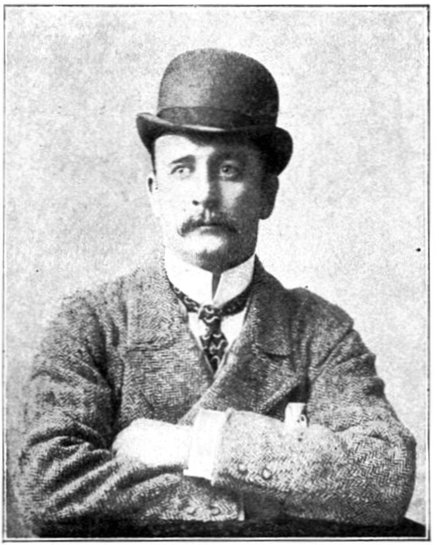
[Photo by Russell.
THE MARQUIS OF WINCHESTER.
The premier Marquis of England, killed at Magersfontein.
And now the continual crackle of the rifle fire, which had somewhat
abated for the last two hours, suddenly swelled in volume. Away in
the front rose dense clouds of dust as from the march of a large body
of men. At first it was thought that the movement proceeded from the
Boers; but the painful truth was soon revealed. The Highland Brigade
had given way once more. Threatened with a flank attack by the enemy,
under a heavy cross fire, the shaken, thirst-tortured infantry could
hold its ground no longer. Colonel Hughes-Hallett, whom the death of
his senior officers had left in command, saw the plight of his men and
gave the order to retire. "Back they came," says the Morning Post
correspondent, "in a wave that no officer could stop. From a point of
vantage on the Horse Artillery hill one could see them swarming like
bees over the veldt till they were almost out of range, and the guns
were left out in the open with no one to support them. It was, perhaps,
the most unpleasant sight that a British soldier of to-day has ever
beheld."
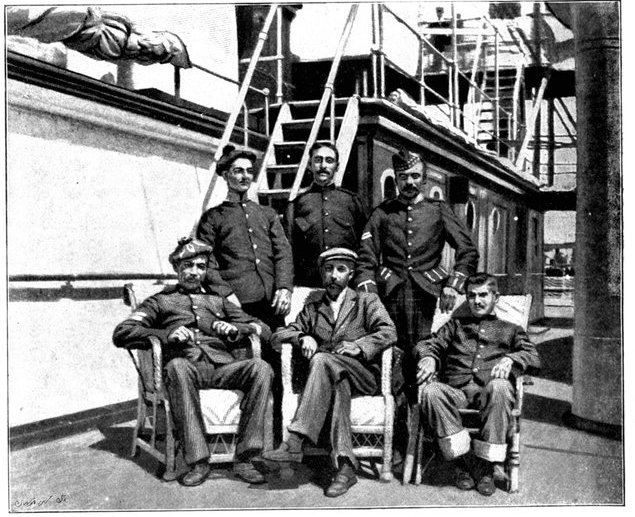
"BACK FROM THE JAWS OF DEATH."
Artillery cover Highlanders' retreat.
This group of men represents as marvellous a series of escapes from
death as can well be imagined. The man sitting on the left of the
picture, Corporal Williams, was wounded by a Mauser bullet, which
entered beneath the left eye, passed through the palate and mouth, and
out at the root of the neck. Standing by him is Private Aitchison (A.
& S. Highlanders), shot through the forehead an inch above the brow,
the bullet passing clean through the head. Next to him is Private Carr
(R.H.A.), shot in the middle of the neck, the ball passing through
the mouth, concussing the spine. Standing on the right of the picture
is Corporal McKenzie; in his case the bullet entered the left armpit,
passed through the lung, and emerged just below the heart; he was shot
again in the abdomen, the bullet emerging on the left side of the
heart. Sitting on the right is Private Boughton (1st Border Regiment),
shot through the nose and left tonsil, the bullet passing through the
skull and out at the back of the head. All are perfectly recovered
except Private Carr, who experiences some loss of power in the right
arm. In the centre is Surgeon Harris, who took charge of these
convalescents on board the Umbria which brought them home.
Colonel Hughes-Hallett's intention was only to fall back a short
distance and not thus to leave the guns exposed; but the disheartened
men were difficult to control. As the Highlanders fell back, the Boer
fire became furiously rapid, and only the tempests of shrapnel from the
British field guns prevented the casualties from mounting to enormous
figures. Some of our guns actually got off not less than two rounds
apiece in the minute. Yet, in spite of this all-important aid, the
Highlanders suffered severely and had many casualties. The Gordons were
left in an exposed position when the Highlanders fell back, and many of
them were carried away in the retirement and thus were involved in the
confusion. A few, however, stubbornly held their ground and rendered
inestimable service. Their commanding officer, Colonel Downman, was
mortally wounded, and was gallantly carried by Captain Towse towards
the rear.
[Pg 194]
[Dec. 11, 1899.
Incidents of the battle.
The retreat of the Highlanders left the artillery in a position of
the extremest peril. A single bold dash on the part of the Boers, and
the guns, it seemed to many, must have been lost. They were now far
in advance of the infantry line and quite without support. Yet the
Boers would not venture out of their trenches and trust themselves
upon the open ground, and so the opportunity was lost. Only the small
Scandinavian contingent, seventy men strong, pushed boldly forward and
seized a kopje on the right. But here it was steadily received by the
Guards; a murderous rifle fire was poured into it, and of its seventy
men, but fourteen escaped unhurt and were taken prisoners. The others
were killed or wounded by the rifle fire and shrapnel. At this moment
a corporal of the Seaforths, who had been taken prisoner, disarmed,
and placed in one of the advanced Boer trenches, under guard of an
armed man, escaped. He snatched up his bayonet, attacked the Boer, and
disarmed him in return, carrying off his Mauser and bandolier. With
these trophies he safely regained his comrades.
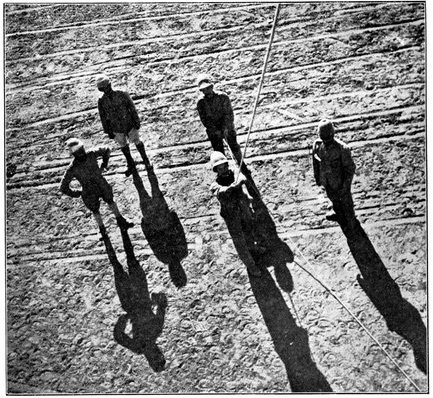
SOLDIERS ON THE VELDT AS SEEN FROM THE WAR BALLOON.
To protect the guns, the Scots Guards were sent forward, and vigorous
efforts were made to rally the shaken Highlanders. Major Ewart rode
up with a message from Lord Methuen that all he asked was for the
men to hold their ground till nightfall. Staff officers, officers,
sergeants, and corporals set a fine example, reminding the heart-broken
débris of what had been the day before the best fighting brigade in
the British Army, of the call of duty and honour. The pipers wailed
sorrowfully in their effort to stir the men by the sound of the martial
notes to which they had often marched to glory. Major Milton, though
he had received three bullets and was mortally wounded, was among
those who distinguished themselves in the effort to encourage the
Highlanders. "Men," he said, "you are not conquered, but repulsed."
And it is to the credit of the men that, after the fearful surprise
of the night attack, after the long ordeal of the terrible morning,
they rallied once more, once more went back to face death and torture,
and took ground close to the guns, where with difficulty they found
some shelter from the bullets of the Boers. "Whoever," says a German
officer, writing of Mars-la-Tour, "has been in so murderous a conflict
as this will know what moral force, what confidence in one's own
efficiency are requisite for such conduct at a time when nothing
remains of a brigade but paper numbers. This force of will is needed in
an army that is determined to conquer."
[Pg 195]
Dec. 11, 1899.] The Boers Checked on our Right.
Throughout these tragical events, as in the earlier part of the day,
the conduct of the artillery had been beyond all praise. Exposed
to every shot the gunners stood firm, even when the troops before
them were melting away under the trials of battle. Their magnificent
behaviour saved the British Army from a great disaster, for, had they
wavered, had they even relented their impetuous fire, Lord Methuen's
force must have been riven in two. Magnificent, too, was the conduct
of the Coldstreams. They, also, stood like a rock in the rout, though
their position was one of great danger. It was at this time that Major
the Marquis of Winchester fell dead, "displaying an almost reckless
courage." But a few days before, not far from the very spot on which
he died, he had jestingly spoken of his rumoured fall in the battle of
the Modder River. And now death had claimed him. Throughout the day he
had insisted upon walking to and fro along the firing line, instructing
the men as to where they were to aim their fire. Bullets rained around
him; several passed through his helmet and his clothes, but he seemed
to bear a charmed life. The fatal shot pierced his spine.
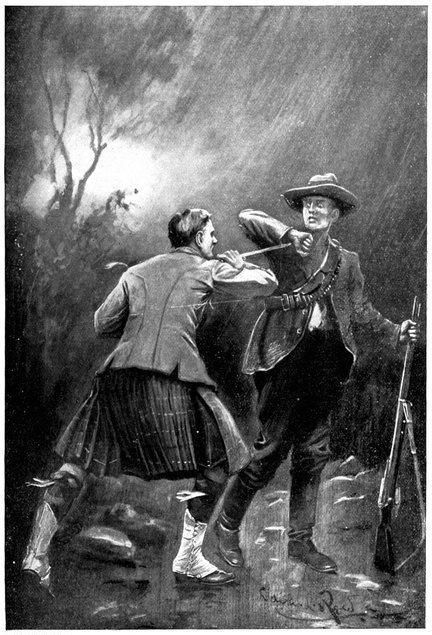
Edward Read.]
ESCAPE OF A CAPTURED CORPORAL OF THE SEAFORTHS.
[Dec. 11,
1899.
The fight still grew in fierceness and intensity, though the second
crisis had passed when the Boers failed to take advantage of the
confusion of the Highlanders. Away on the left, General Pole-Carew,
with the greater part of the Ninth Brigade, was demonstrating along
the railway line and feeling the enemy's right to discover if it could
be turned, as had been done at Modder River. But these efforts were
unsuccessful; the line of entrenchments continued interminably far to
the west, and was clearly held by the enemy in sufficient force to
render an assault hopeless. Away on the right, the Boers seemed to be
developing an attack and could be seen from the balloon concentrating
for an advance. Hereabouts there was a considerable gap in the British
line between the Grenadiers, on the right of the Coldstreams, and some
companies of Yorkshire Light Infantry, who held a drift across the
Modder and who were supporting the two Lancer regiments and the mounted
infantry. The Yorkshiremen, however, met and defeated the Boer effort.
With trivial loss they stormed a ridge held by the enemy, close to the
river, and repulsed the counterstroke with a coolness and valour for
which they received well-merited praise from Lord Methuen. In this
brisk encounter they fired no less than[Pg 196]
22,000 rounds. The Yorkshire Mounted Infantry had already begun to
bring in the wounded on this flank and were far away from support when
they were vigorously attacked by the Boers. Here Sergeant Casson,
Lance-Corporal Bennett, and Private Mawhood did fine service, kneeling
down in the open and by a steady and continuous fire checking the
enemy. The Lancers' Maxims, too, were invaluable.
The afternoon was now declining, and it was evident to all, except to a
few who took the Boer movement towards the British right for a retreat,
that the battle was lost beyond hope. But the Guards would none the
less have been sent in at dusk had not a fresh misfortune come as a
blessing in disguise. Suddenly, after a prolonged silence since the
early morning, the Boer artillery began to fire shell and shrapnel at
the British guns. Just behind these guns were placed the sad remnants
of the Highlanders—a dispirited mass of men in close order. One or two
projectiles came shrieking amongst them, whereupon, suddenly and as if
at the word of command, the men of the brigade once more precipitately
retired, turning their backs upon the enemy and pouring in complete
disorder past Lord Methuen's flag. This was the crowning touch—the
culminating disaster. There now remained no troops whatever to support
the Guards; for the Ninth Brigade would be needed to guard the flanks
and the camp.
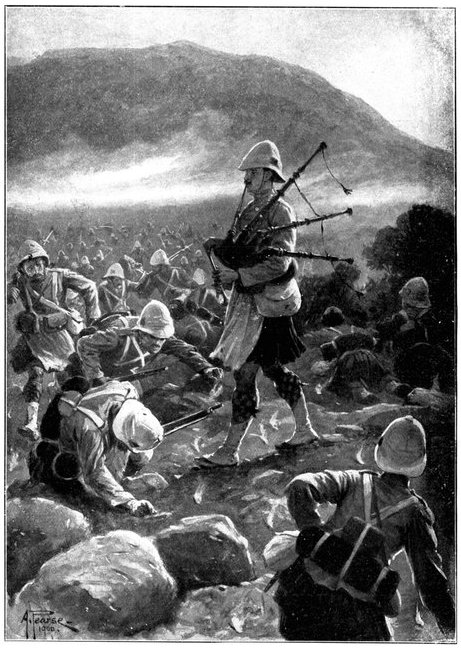
CORPORAL McKAY, OF THE ARGYLL AND SUTHERLAND
HIGHLANDERS, PLAYING TO RALLY HIS FUGITIVE COMRADES.
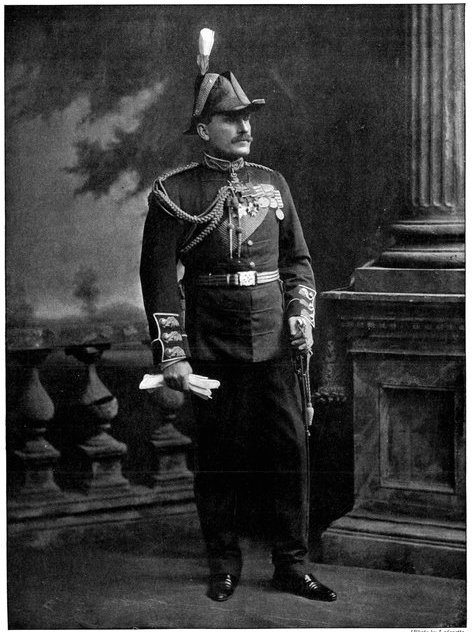
[Photo by Lafayette.
MAJOR-GENERAL HECTOR MACDONALD, C.B., D.S.O.
Served in the Afghan War of 1879-80; accompanied Sir F. (now Lord)
Roberts on his march to Cabul, and was present at the battle of
Kandahar; served in the Boer War of 1881; at Majuba his bravery won his
life at the hands of the enemy; he was Garrison-Adjutant at Assiout
(Upper Egypt) in 1885, and was in the Sudan during the operations of
1888-91. In 1896 he took command of the 2nd Infantry Brigade under Sir
H. (now Lord) Kitchener, and in 1897-8 commanded Egyptian brigades,
being present at the battles of the Atbara and of Khartoum. He was
appointed an aide-de-camp to the Queen in 1898. While acting as
Brigadier-General commanding at Umballa (India), he was summoned to
take command of the Highland Brigade, under Lord Methuen, in succession
to General Wauchope. The appointment of "Fighting Mac," as he is
called, was hailed with satisfaction by the Brigade.
[Dec. 11-12, 1899.
Lord Methuen now determined to cling stubbornly to his position, in the
hope that here, as at Modder River, the enemy might retire during the
night. Accordingly, though the infantry and artillery fell back from
the most advanced positions, there was no general retreat. The whole
force bivouacked on the field. The night, like its predecessor, was
bitterly cold. It was again impossible to remove the wounded from the
ground before the Boer trenches. Only a very few had been brought in
by the devoted efforts of the medical staff and the stretcher bearers.
The others had to spend a cruel night, tortured by cold, [Pg 197]
[Pg 198]after the
sufferings caused by the fierce heat of the day. Many officers and men
were twenty, thirty, even thirty-six hours upon the ground, without
food or water and with wounds undressed. Further to the rear the
wounded were carefully attended to and sent back to camp during the
night.
British retirement to Modder River.
With day, the artillery recommenced its fire. The men of the Guards
during the night had entrenched their position and were in good
spirits, ready even for an assault upon the Boer lines in broad
daylight. Meantime, Lord Methuen scrutinised the Boer trenches and
received the reports of his Intelligence Department. Everything showed
that the enemy still held their position. General Colvile was for
continuing the battle, to wear the Boers down, but the other officers
were all for a retirement, and it was evident that what the whole force
could not effect upon December 11, was out of the question for it on
the 12th, with quite one third its strength for all practical purposes
eliminated. During the night the supply train had fallen back to the
old camp, and now a general retirement was ordered. The moment the
Boers observed that the British force was retreating, they opened a
hot fire from all their guns. But the range was long and the effects
of the fire insignificant; it did not shake or demoralise the British
infantry, who slowly and steadily, as if on parade, marched back the
three miles to Modder River camp, defeated but not disgraced.
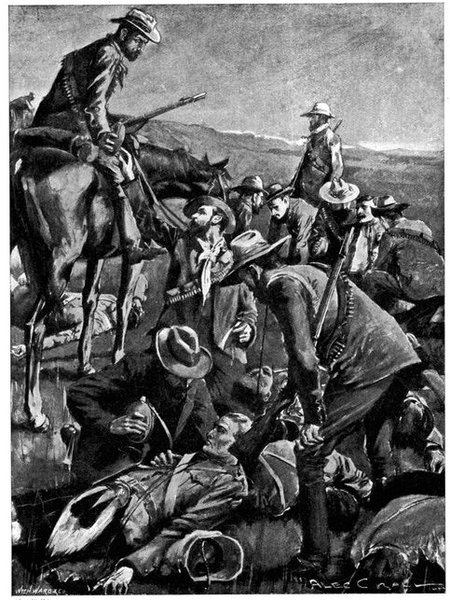
Alec Ball.]
BOERS TENDING THE BRITISH WOUNDED AT MAGERSFONTEIN.
Dec. 12, 1899.] Losses of the Highland Brigade.
Very early in the morning, a flag of truce had come in from the Boers
requesting Lord Methuen to remove the British wounded who were lying
close to the trenches, in the most urgent need of medical help. The
motive of this message was kindly and humane, and it should be said
that the enemy had treated the Highlanders with tenderness, giving
them food and water and roughly bandaging their wounds. The ambulances
at once pushed in, drivers and stretcher-bearers being blindfolded by
the Boers, who streamed out of their trenches to watch the operations.
"They were," says Mr. Ralph, "courteous, helpful, and respectful. By
not one word did they give offence." Yet two regrettable incidents
occurred. The first was that one of[Pg 199] the ambulance men was found
to have a revolver, and was seized and made prisoner by the Boers,
despite his explanations and expostulations. The other was that the
naval 4·7 opened fire suddenly upon the trenches. The officer in
charge was unaware of the flag of truce, and saw, as he supposed, the
Boers issuing for an attack upon our men. Fortunately, his shots had
no effect and soon ceased, but the Boers were so incensed at what
they considered treachery, that they opened a hot fire upon the Horse
Artillery near them. The Horse Artillery made no reply, and, seeing
this, the Boers also ceased fire.
British losses.
Thus the battle had been fought and had issued in a complete check to
Lord Methuen's division. The Highland Brigade had temporarily ceased to
exist as a fighting force; its shaken and demoralised soldiers needed
to be strengthened by rest and drafts of fresh men before they could
again be sent into action. "I do not hesitate to admit that for months
after Mars-la-Tour," says a German officer, who had passed through an
ordeal as terrible as that to which the Highland Brigade was subjected,
"the effects of the fire remained on my nerves. Troops that have to
undergo anything of the kind are demoralised for a long time—not
only rank and file, but officers as well." The subtle force known as
morale, which is the mark of the good soldier, had been exhausted by
the nervous strain of that night and day of continuous fighting.
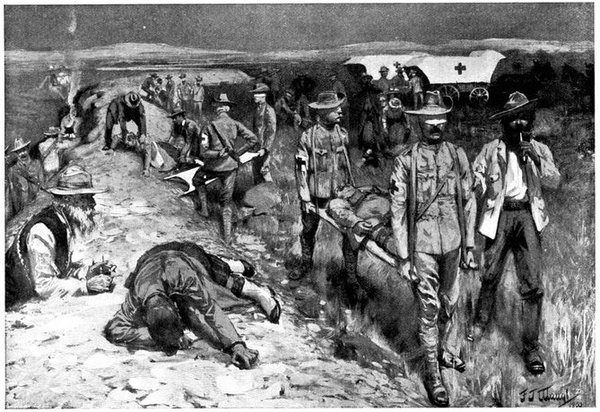
F. J. Waugh.]
REMOVING THE WOUNDED, BLINDFOLD.
The British stretcher-bearers, during the truce at Magersfontein, were
not allowed to see the Boer defences; they were led along the lines
blindfold.
The losses of the Brigade were, in detail, as follows, according to Mr.
Ralph:—
|
Killed. |
Wounded. |
Missing and Prisoners. |
Total. |
| Staff |
1 |
2 |
0 |
3 |
| 2nd Black Watch |
73 |
208 |
73 |
354 |
| 2nd Seaforths |
48 |
141 |
8 |
197 |
| 1st Highland Light Infantry |
15 |
77 |
3 |
95 |
| 1st Argyll and Sutherlands |
26 |
61 |
19 |
106 |
|
163 |
489 |
103 |
755 |
[Dec. 12, 1899.
As each battalion would not muster more than 750 or 800 men present
and fit for duty, it follows that about one fourth of the Brigade was
put out of action. The Black Watch was by far the worst sufferer;
it lost nearly half its strength, the Seaforths about one quarter,
and the other two battalions each about one eighth. The Boers took
sixty-nine unwounded prisoners of the Brigade—a gallant little party,
which had actually fought its way into their trenches, and had there
been overwhelmed by numbers. They captured ten wounded men and buried
fifteen whose names are not known. Of the prisoners they had taken, no
less than forty-two were, through some error, reported to have been
killed; their relatives were notified accordingly, and it was not till
some weeks afterwards that the mistake was corrected, and that these
men, so to say, came back from the dead.
The rest of the British forces engaged lost but lightly. They had 17
killed, 105 wounded, and 10 missing. The total list of casualties, as
officially issued, is not in entire agreement with Mr. Ralph's figures,
but places the loss at 171 killed, 692 wounded, and 107 missing, a
total of 970, or not far from one tenth of the force engaged. As to the
Boer losses there was really no information. Stories went round the
camp to the effect that the slaughter wrought by the lyddite shells
and shrapnel had been awful, whole commandos being "wiped out." But as
the Boer trenches were in sandy soil where the lyddite shells would
do little damage, and as the gunners had great difficulty in locating
their exact whereabouts, it is most improbable that the enemy suffered
heavily. Three or four hundred killed, wounded, and prisoners would be
a fair approximation to their casualties.
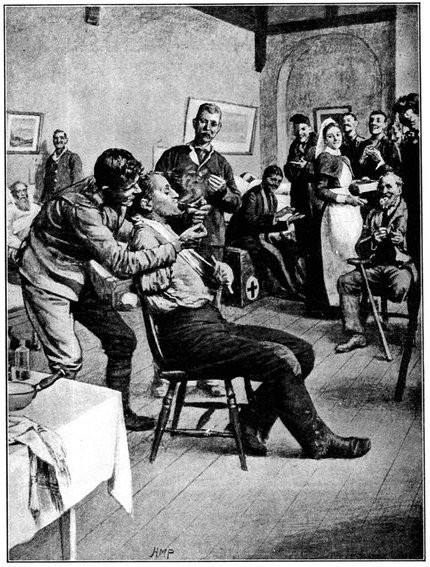
H. M. Paget.]
FOES IN THE FIELD BECOME FRIENDS IN HOSPITAL.
Many incidents such as that here depicted, in which a British soldier
is lighting the pipe of a wounded and helpless Boer, have occurred
in the hospitals, and not a few on the field of battle itself. A
nurse relates how two men, a Briton and a Boer, both fresh from the
operating-table, lay side by side eyeing each other; how Tommy pulled a
couple of cigarettes, which had been given him, from under his pillow
and handed one to his wounded enemy, and how both men, under the stress
of pain and mutual commiseration, burst into tears. On another occasion
a wounded Boer, lying on the hot hillside, offered his water-bottle to
a wounded Englishman, who in return shared his ration of bread with the
Boer.
Cronje's account.
Cronje's official account of the battle rendered full justice to the
bravery and determination of the British troops. It was as follows,
and it will be seen that it was comparatively accurate, though it just
doubled the British losses:—
Dec. 12, 1899.] Cronje's Account of the Battle.
"Having received large reinforcements, and his army having rested since
November 28, Lord Methuen advanced against General Cronje's army, which
occupied a position extending for many miles on both sides of the
railway. The fighting was opened by a heavy cannonading at four in the
morning, under cover of which dense masses of infantry moved towards
our position. They were received with a heavy, steady fire, which
repulsed the advance before the English had come[Pg 201] within measurable
distance. A second attack met the same fate. The bravery of the English
was wonderful against the hail of Mauser bullets that met them. About
this time the corps of Scandinavians, who had a great record for
reckless courage, charged. They were cut off on a scrub-covered kopje,
and lost several killed and wounded and many were taken prisoners. In
the afternoon all the British reserves were brought into the attack,
which was delivered with sublime courage. The plains north of the
Modder River were black with the forces deployed for the charge. But no
courage could break through the Boer defences, and late in the day the
British retreated to the Modder River, leaving the ground covered with
their dead and dying.
"Exclusive of the losses suffered by the Scandinavians, of whom
eighteen were killed and forty-three wounded and taken prisoners, the
Boer loss was insignificant. The English loss in killed and wounded
is calculated to be 2,000. Prisoners we have taken say that the Black
Watch was quite cut up."
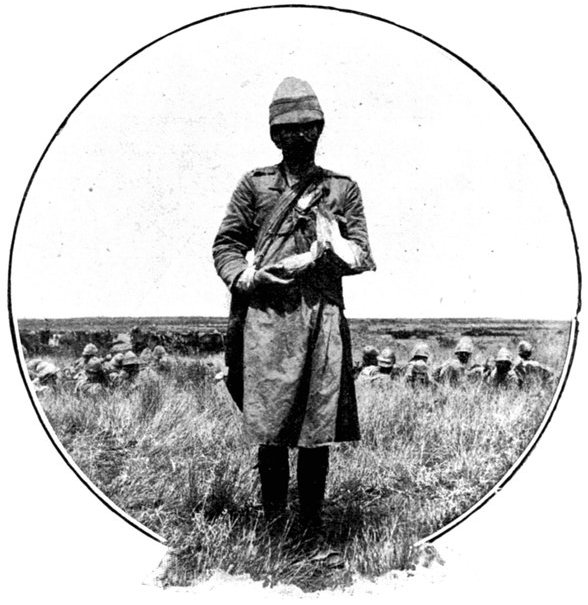
A WOUNDED HIGHLANDER ON THE BATTLEFIELD AT
MAGERSFONTEIN.
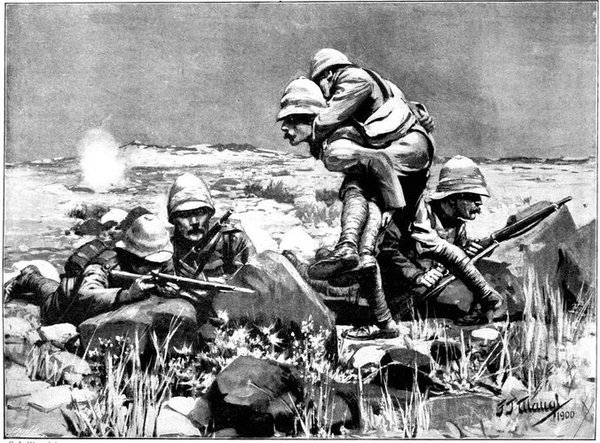
F. J. Waugh.]
CHECKING A FLANKING MOVEMENT.
Lieut. Riley, of the Yorkshire Light Infantry, with a sergeant and
two or three privates, made a desperate stand on the extreme right of
the British position at Magersfontein, with the object of rescuing a
wounded comrade. It afterwards turned out that by this gallant conduct
they had contributed materially to the foiling of the Boer attempt to
outflank the British.
[Dec. 12, 1899.
"But I shall never forgive myself, nor would you if you had seen the
poor British mowed down at Magersfontein," wrote an English traitor
present[Pg 202] with the Free State forces, to his father. "But not a man
did I fire at. That I made up my mind not to do.... You should see
our entrenchments, for we burrow under the ground, and never get hit.
Millions of pounds must have been shot away by the English gunners,
and you, father, will have to pay for all the waste. It made me laugh
to see the firing hour after hour and not one of our men hit. The
English all start their engagements like that. They fire two days, and
as they always follow the same childish plan we know they will not
attack until after a day or two's bombardment. Then we come out of our
burrows and simply shoot them down like deer. But I have not stained
myself with English blood, and don't mean to.... It makes me proud of
my fellow countrymen, and the good-class Boers regret having to kill
such plucky fellows as they come along to their death. Like the Battle
of Balaclava, it is not war, but it is magnificent. Poor chaps; I am
sure they can never see us. One whole day of hard fighting we never
showed ourselves, and I see by the papers that hundreds of English were
killed, and especially the Scotsmen. Our loss was trifling. You cannot
hit men with rocks protecting them all round, and who are underground
when the cannons fire."
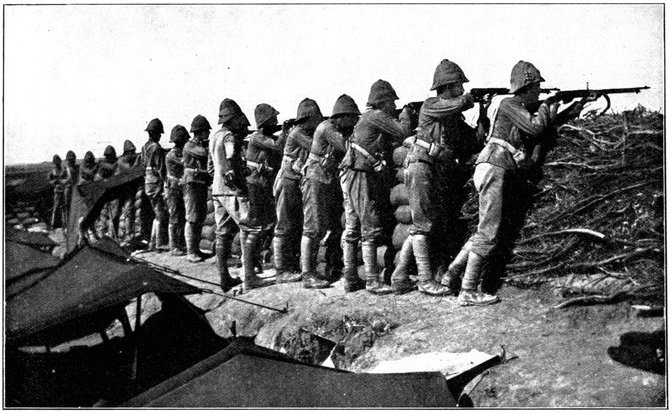
MANNING A FORT AT MODDER RIVER.
One of the many defensive works thrown up by Lord Methuen after the
battle of Modder River.
"Nothing," says Lord Methuen, in his official despatch, "could exceed
the conduct of the troops from the time of the failure of the attack
at daybreak. There was not the slightest confusion, though the fight
was carried on under as hard conditions as one could imagine, for the
men had been on the move from midnight and were suffering terribly
from thirst.... The attack failed; the inclement weather was against
success; the men in the Highland Brigade were ready enough to rally,
but the paucity of officers and non-commissioned officers rendered this
no easy matter. I attach no blame to this splendid Brigade."
Criticism of Lord Methuen's tactics.
Dec. 12, 1899.] Lord Methuen addresses the
Highlanders.
In the camp the battle gave rise to much indignant comment upon the
manner and disposition of the night attack. It was pointed out that
such attacks are exceptionally perilous when made upon a vigilant,
well-armed enemy, behind trenches and entanglements. It was asserted
that every precaution required by the rules of military science had
been disregarded; the ground had not been accurately and carefully
reconnoitred; the exact location of the Boer trenches had not been
ascertained. The march in close order up to the enemy's position[Pg 203]
was, indeed, defended by some as being both the natural formation
for such a movement by night and the formation sanctioned by the
drill book. But the experience of Lord Methuen's brief campaign
had at least shown that open order could be used on a fairly fine
night, and if the terrible weather of the night of December 10-11
rendered a night march impracticable, it was said that the attempt
ought to have been postponed to some more favourable opportunity. The
strongly-held opinion was that General Wauchope, an officer famous for
his carefulness and attention to detail, had religiously carried out
his instructions. But the official despatch clearly proves him to have
deployed long after the hour which had been fixed in conversation with
Lord Methuen.
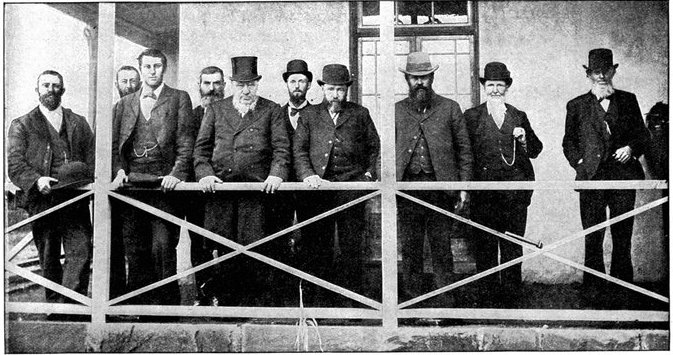
PRESIDENT KRUGER AND SOME OF HIS SUPPORTERS.
This photograph, although not of recent date, is interesting because it
includes, besides the President, several men whose names have become
familiar during the war.
Shortly after the battle Lord Methuen made a somewhat infelicitous
speech. Addressing the men of the Highland Brigade, he sympathised with
them over the heavy losses they had sustained. "The advance," he said,
"was executed exactly to the time and place that I had given orders
for, and we were within an ace of carrying the position in a short and
decisive engagement. Everything depended upon one word; that word was
'Forward!'" No doubt there was this much in what he said, that had the
Highlanders dashed at the trenches when they received the first fatal
volley, they would have captured the position. But the General must be
a judge of human nature and must know exactly what he can expect of his
troops. The Highland Brigade was not composed of automata, and a strain
had been imposed upon the nerves of the men which it was quite beyond
their power to resist.
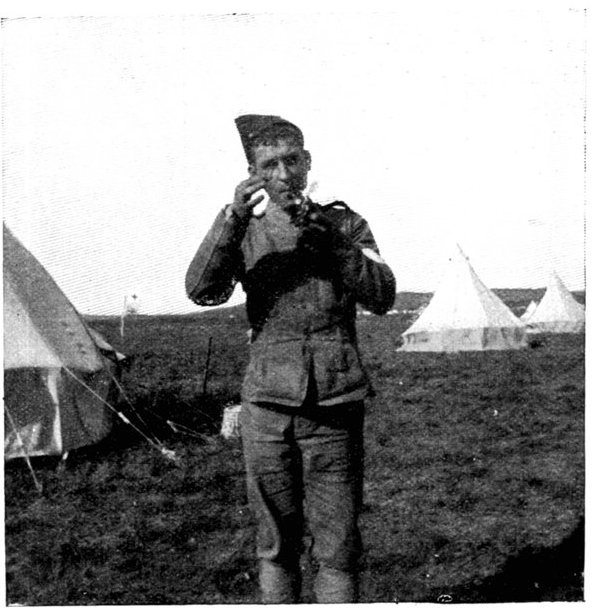
[Photo by Staff-Sergt. Ryan.
MATCHES AT A PREMIUM.
An orderly of the R.A.M.C. using a burning-glass to light his pipe.
[Pg 204]
[Dec. 12, 1899
Among the few Boer prisoners taken in this engagement was a double-dyed
traitor and thief named Greener. This man, a Sergeant-Major of the
Royal Engineers, had been detected in wholesale theft at Aldershot.
Deserting the colours and betraying the country which had given him
birth, he fled to South Africa and took service with the Boers. So far
as we can discover, the extraordinary leniency of the British suffered
this rogue to retain his life. By any other nation he would have been
summarily executed under the orders of a drum-head court martial.
After the action the chaplain of the Highland Brigade gave the dead
Highlanders the solemn rites of Christian burial. He went to and fro
among the enemy, who received him with an honourable regard when he
came to inquire after the wounded and missing. "He told me," says Mr.
Ralph, "that there were Englishmen, Irishmen, and Scotchmen among them,
as well as the mercenary Germans and Scandinavians, serving for a gold
krüger a day—which is to say, a pound sterling Dutch.... Everybody
was courteous." And though they blindfolded the bearers and ambulance
men, they did not fear his presence, open eyed, in their midst, nor
did they put him under oath as to what he might reveal or hide. Their
confidence, it need scarcely be said, was in no way abused.
Burial of General Wauchope.
With the men he had so valiantly led was buried the fallen General.
The piper wailed "Lochaber no more" as they bore him and his stubborn
countrymen from the battlefield to the fast-growing burial ground near
Modder River town, where lie the bravest of the brave. "There," says
the Daily News correspondent, "moved with slow and solemn tread
all that remained of the Highland Brigade. In front of them walked
the chaplain with bared head, dressed in his robes of office; then
came the pipers with their pipes, sixteen in all, and behind them,
with arms reversed, moved the Highlanders, dressed in all the regalia
of their regiments, and in the midst the dead General borne by four
of his comrades." The sad impressiveness of the funeral service was
deepened by the circumstance that away to the north stood the defiant
enemy—that round the grave were gathered, in battle-torn uniforms, the
men who had faced the storm of bullets and borne the brunt of the fatal
assault, only to win the bitterness of defeat. The bright hopes with
which they had set out had been shattered and, it might be said, were
buried in this grave with the fallen General. Man had proposed; God had
disposed.
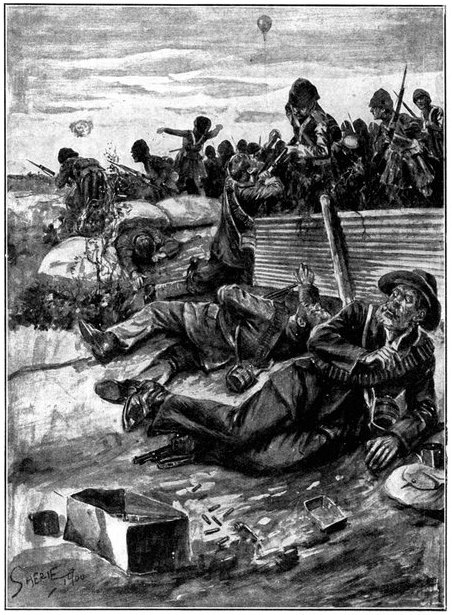
[After a Sketch by Mr. Fred Villiers.
A BOER TRENCH CAPTURED BY THE BRITISH AT MAGERSFONTEIN.
This trench, which was in an advanced position, was stormed and
captured by the Highlanders. All its defenders, forty-seven in number,
fell to their bayonets.
[Pg 205]
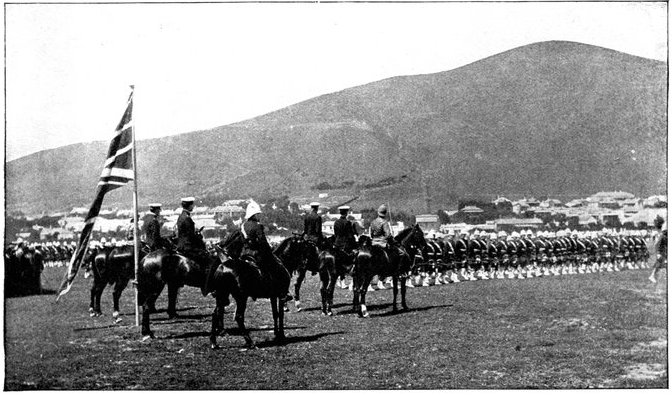
CAPETOWN HIGHLANDERS.
General Sir F. W. E. Forestier-Walker, commanding lines of
communication, inspecting Volunteers on Green Point Common; Capetown
Highlanders marching past.
CHAPTER XI.
THE NATION UNDER DEFEAT.
Critical position of Great Britain—Her prestige in
danger—Crass ignorance of military affairs—German
system—Responsibility of Statesmen and
Generals—Government unprepared—Necessity of
reorganisation—Former national crises—Measures taken
for defence—Change of Generals—Lord Roberts' military
career—Lord Kitchener in the Sudan—Embarkation for
South Africa—General Hector Macdonald—Offers of the
Colonies—Australian and Canadian contingents—Mr.
Seddon's loyal speech—Volunteers from Asiatic
dependencies—London's contribution—Imperial
Yeomanry—Gloomy outlook.
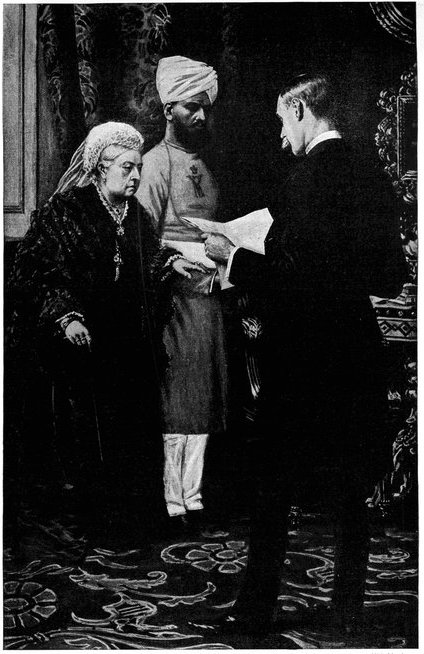
S. Begg.] [By permission of the "Illustrated London
News," from the large photogravure published by them.
HER MAJESTY RECEIVING NEWS FROM THE SEAT OF WAR.
Critical position of Great Britain.
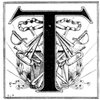
Thus three times within the space of a single week had the British
Dec. 1899.] The Empire in Peril.
columns marched forth to defeat. The Army Corps, the much-trusted
Generals, had gone out to South Africa, and yet there was nothing of
that irresistible tide of success which, it was fondly hoped, would
sweep away the Boer oligarchy. The results of the week's battles were
2,600 British soldiers dead, wounded, or in the enemy's hands, and
complete checkmate in every field of the war. Kimberley, Mafeking, and
Ladysmith had not been relieved; far from it, the forces which were to
have achieved this eagerly desired result were themselves, it seemed,
in grave danger. Lord Methuen might at any time be cut off from his
base; General Gatacre might be driven back to the sea; even General
Buller, with 20,000 British troops on the line of the Tugela, might
be in peril, if only the Boers were equal to their opportunities. And
dangers even more terrible than these loomed upon the stormy horizon.
How if the Cape burst into rebellion and the Dutch there threw in their
lot with their victorious kinsmen? How if our enemies of the Continent
seized upon the occasion to overthrow the Empire? Nowhere had Britain
a friend. France, Russia, and Germany were equally outspoken in bitter
and contemptuous criticism. Not the Governments, but the nations of the
Continent hated and envied us in equal degree, and if only the signal
for attack had been given, would have rushed upon us with malignant
ardour. But the Governments, though they bore us no goodwill, waited
and hesitated. Much depended upon Russia, and the Czar, the young
Nicholas, played a part at this juncture which the British nation will
remember with gratitude. He set his face firmly against any treacherous
attack. He restrained his war party and declined to profit by our
troubles. He may have felt that war with England would [Pg 206]
[Pg 207]have brought
our one friend, Japan, into the field with consequences not altogether
pleasant for Russia, but none the less we may honour him for his
chivalrous attitude.
Her prestige in danger.
And the most grievous feature of our defeats was that they were
inflicted by a people numerically weak, without an army in the true
sense;—by a number of peasants and farmers, upon the very flower of
the British Army. The strongest, the best appointed, and, it was hoped,
the best led force that had ever left our shores, equipped with all
the contrivances of modern war, with field telegraphs, war balloons,
howitzers, naval guns, and lyddite shells, had failed. It had failed
completely—almost beyond repair—and it could place to its credit not
a single great success. One or two battles in which we had gained the
day, with heavy loss and without inflicting proportionate damage upon
the enemy, had, indeed, been paraded as glorious victories, but their
very insignificance, in relation to the task to be accomplished, was a
sad commentary upon the depths to which we had fallen. It was not that
the British soldier had failed in courage. That "last validity of noble
veins" he still retained. Upon every field of the war his demeanour
had compelled the enemy's admiration. Our military annals, splendid
though these are, contain nothing finer than the advance of the Dublin
Fusiliers at Colenso, of the Guards at Belmont, and of the Marines at
Enslin, or the conduct of General Pole-Carew and his devoted band in
the anxious hours when the Modder River fight swayed to and fro and
the balance inclined against us. And yet, though hundreds of brave
men now lay festering in the sun or in their shallow graves on the
far-off veldt, and hundreds more filled those homes of silent agony,
the hospitals, nothing had been accomplished. The fame of the Army,
the prestige of the nation, the very existence of the Empire, were in
grievous peril.
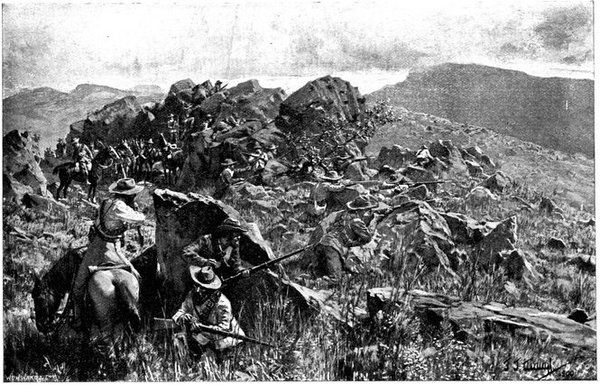
F. J. Waugh.]
WHY THE BOERS WERE ABLE TO HOLD US IN CHECK.
It is clear now that the earlier victories of the Boers were largely
due to their prudent habit of keeping out of sight.
[Dec. 1899.
Thus in a few short days had the British people been brought face
to face with the tragic realities of war. The scales fell from all
eyes; it was clear to every man that this was a struggle for life or
death, a struggle in which defeat must mean the loss of South Africa
and the shaking of the British Empire to its very foundations, and
in which victory at the best could never regain for us what we had
forfeited—our reputation before the world. Not yet did the nation
know, or it might well have shivered, the hesitation, the doubts, the
ignorance of the true meaning of events which[Pg 208] marked its leading
men. Not yet did it fully comprehend the grave defects which had
characterised its army in the field. It had illusions still of which
two more months of unsuccess were at last to deprive it; it had yet
to learn how all precautions had been neglected; and blind animal
courage substituted for skilful leading.
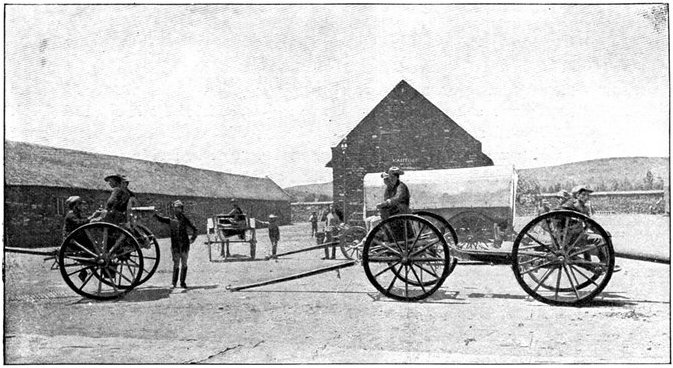
TWO OF THE GUNS
CAPTURED FROM DR. JAMESON, IN A FORT AT PRETORIA.
The photograph is almost the only one which has been taken within any
of these forts. Observe the loop-holed wall beyond the sheds.
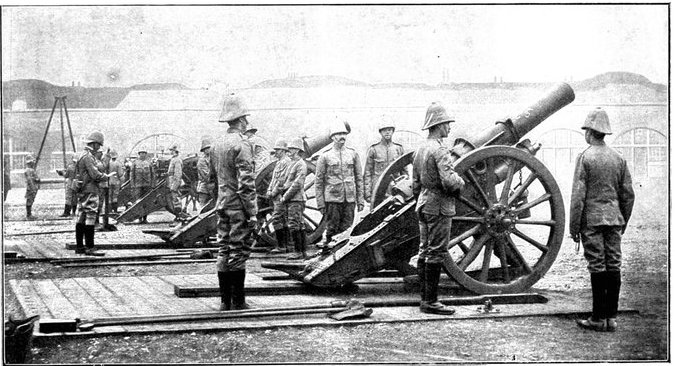
[Photo by Cribb.
A 6-IN. HOWITZER BATTERY.
The first two guns are shown elevated to an angle of thirty-five
degrees, which is the position in which they are usually fired.
Crass ignorance of military affairs.
Dec. 1899.] "Nobody to Blame."
Terrible, indeed, is the price which a nation must pay for neglecting
the study of war. "Above all for empire and greatness," said our own
immortal Bacon, "it importeth most that a nation do profess arms as
their principal honour, study, and occupation." But the people had
never troubled about such things; it was taught and it knew nothing of
the conduct of war; its press gave space to the trivialities of sport,
none to the serious business of arms; its Parliament emptied as if by
magic when naval and military affairs were discussed; its Government
and Cabinet were composed without exception of men ignorant of war.
For generations attention had been riveted upon the question which of
two parties was to govern, regardless of the consideration that there
can be no country to rule unless there is an armed force prepared
to overcome the enemies who may assail that country's existence. We
had told one another that we were a great, a strong, an invincible[Pg 209]
people. We had come to believe—or the less instructed of us had come
to believe—that an Englishman was far more than a match for any
foreigner. We had been ruled by "majorities of politicians, without the
knowledge requisite in the governors of a great empire, believing that
every interest should be subordinated to their preservation of place."
In the words of Lord Charles Beresford, in twenty years there had been
but three men in the House of Commons who understood the problem of
national defence. One of these—perhaps the ablest—Sir Charles Dilke,
had met the common fate of men who strive to warn their country; he
had been quietly brushed aside by the politicians as a mere alarmist.
Yet he had steadily predicted the breakdown of the Army in its first
serious war, and his prophecy had come true.
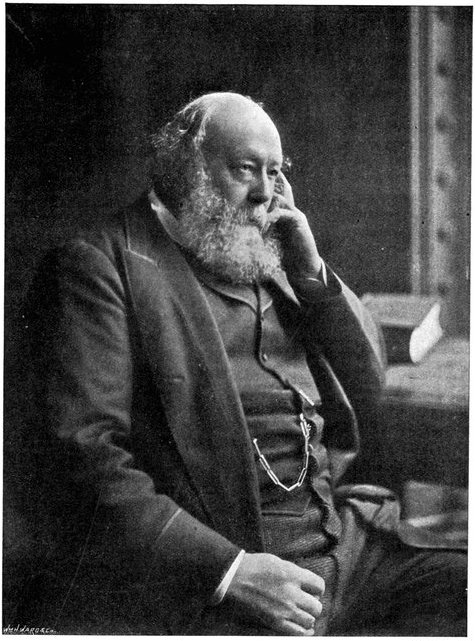
[Photo by Russell.
THE MOST HONOURABLE THE MARQUIS OF SALISBURY, K.G.,
Prime Minister and Secretary of State for Foreign Affairs.
German system.
And now when defeat came no one was responsible. "In Germany," said
a German commentator, "had the Army failed as the British Army
has failed, had the War Minister organised defeat and been caught
unprepared, that minister would have been execrated as a traitor and
imprisoned in a fortress for the rest of his natural life." But, then,
though we had copied much from Germany—all the trifles which do not
go to make success—we had neglected the real virtues of the German
system—its magnificent education, its careful study of war, its
unceasing preparation, its constant manœuvres, its lofty sense of duty
to the nation, and its organisation by which there is a man to hang if
things go wrong.
Responsibility of Statesmen and Generals.
[Dec. 1899.
The mistakes of generals in the field kill hundreds, the ignorance of
ministers in the Cabinet slays thousands. And for the terrible roll
of wasted lives, for the long-drawn agony of the heroic defenders of
Ladysmith and Mafeking, it is needful that someone should be hereafter
called to account. Our soldiers, we have seen, did their duty. They
faced death and mutilation because they had learnt in a noble school
to offer[Pg 210] up the last and greatest sacrifice—life itself—sooner than
face dishonour. To men who bear themselves thus, both statesmen and the
nation owe a duty in their turn. They must provide the best weapons,
the best training, the best leadership, the best equipment, that the
sacrifice may not be made in vain; they are responsible in the sight
of posterity and of God, if they needlessly waste human lives or bring
sorrow and bereavement upon thousands of homes; they are not asked,
like our devoted reservists, private soldiers, and officers, to face
the scorching heat and the devouring thirst of the march, the chills
of the sodden bivouac, the blood and torture of battle; they have
not to confront death;—the one has only to be ready to resign place
and power, and the other to watch carefully and intelligently and to
be prepared to make pecuniary sacrifice. Yet how many statesmen have
resigned for the Army's sake, and how many of the public have troubled
about or interested themselves in the Army's efficiency?
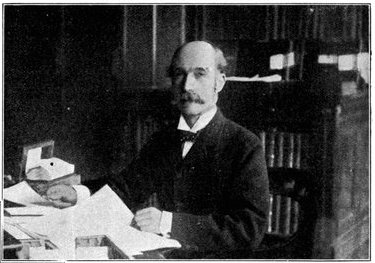
THE SECRETARY OF STATE FOR WAR.
PHOTOGRAPHED AT THE WAR OFFICE.
[Copyright 1900 by Underwood & Underwood.
THE MARQUIS OF LANSDOWNE, K.G.
Secretary of State for War since 1895; was Under-Secretary for War,
1872-74, and Under-Secretary for India, 1880; Governor-General of
Canada, 1883-88; Viceroy of India, 1888-93.
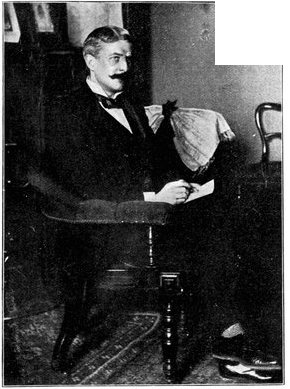
UNDER-SECRETARY FOR WAR.
[Copyright 1900 by Underwood & Underwood.
MR. GEORGE WYNDHAM, M.P.
Parliamentary Under-Secretary of State for War since October, 1898.
Born in London, 1863; educated at Eton and Sandhurst; entered the
Coldstream Guards in 1883, and served in the Suakin campaign and at
Cyprus, 1885; Private Secretary to the Right Hon. A. J. Balfour,
1887-92; Captain of Cheshire Yeomanry.
The Government unprepared.
Dec. 1899.] Shortcomings of the War Office.
It was urged, indeed, as an excuse for our failures that other armies
had made deplorable mistakes—notably the German in the war of 1870.
This no one will deny. But the point is that in spite of these mistakes
the German Army won every battle, and that the German government and
nation had taken every step which science and the sense of duty could
suggest to prepare for war. Could as much be said of Britain? Those
who have followed the story will have marked the lack of transport
and of cavalry, the insufficient proportion of artillery, the want of
maps, and the delay in the preparation of troop-ships. They will have
noted that the reports of the Intelligence Department as to the enemy's
strength were put on one side and neglected. They will know that the
strenuous warnings of Sir Alfred Milner and of the Natal Government as
to the imminence of war were calmly disregarded. They will remember
that defects in the Army, pointed out year after year by critics in the
House of Commons and in the press, had remained unremedied. They should
reflect that the Army and its leaders had been denied the inestimably
valuable exercise of annual manœuvres until the last year before
the war. Even then the manœuvres were not of a nature to yield real
instruction. And the mere fact that in the gravest[Pg 211] emergency ministers
turned to Lord Roberts and Lord Kitchener, showed that they had not
chosen, as they ought to have chosen, the generals who were believed by
all to be best qualified for a difficult campaign.
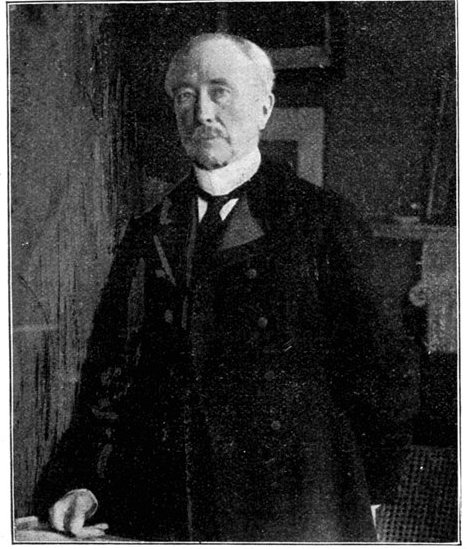
THE HEADS OF THE WAR OFFICE.
[Copyright 1900 by Underwood & Underwood.
FIELD-MARSHAL VISCOUNT WOLSELEY, K.P.
Commander-in-Chief of the Army since 1895. (See note to portrait on
page 59.)
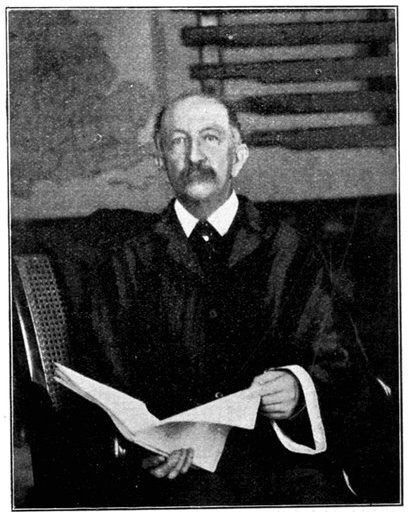
[Copyright 1900 by Underwood & Underwood.
GENERAL SIR EVELYN WOOD, V.C.
Adjutant-General to the Forces since 1897. Born 1838; educated at
Marlborough; Barrister, 1874; entered the Navy, 1852; served with the
Naval Brigade in the Crimea, 1854-5; joined the 13th Light Dragoons,
1858; served with 17th Lancers in India, 1858; in the Ashanti, Kaffir,
Zulu, and Transvaal Wars, 1879-81; commanded at Chatham, 1882-3; raised
the Egyptian Army, 1883; and served with the Nile Expedition in 1894-5,
since which time he has held the command of the Eastern (1886-8) and
Aldershot (1889-93) Divisions.
Necessity of reorganisation.
Nor are these small things, nor has their importance passed away. Far
greater conflicts may lie before us in the near future, and we may have
to encounter, not undisciplined peasants, but armies amply supplied
with cavalry and artillery—armies which can attack as well as defend.
The future safety of the Empire depends upon our so organising and
constituting our military system that we shall never again be taken by
surprise, and never again be found inferior in the field. Our Army,
our generals, had become the slaves of routine, as a wise foreign
officer wrote. They had failed to understand what the Boers had fully
grasped—the need of high intelligence as well as brute courage in the
fighting man, and the immense potentialities of modern weapons. It is
not the least unsatisfactory reflection that the fighting men whom we
recruited at the eleventh hour for war from the ranks of our Colonists,
proved themselves as good as our professional soldiers. That this
should be so illustrated the inefficiency of our military training. For
in what other profession could thousands of tyros hope to vie with the
experts?
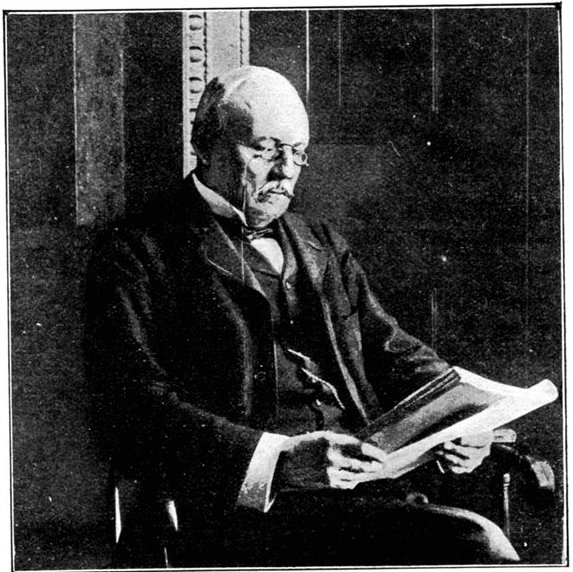
[Copyright 1900 by Underwood & Underwood.
SIR R. H. KNOX, K.C.B.
Permanent Under-Secretary of State since 1897. Born 1836; entered the
War Office, 1856; Accountant-General to War Office, 1882-97.
[Dec. 1899.
"War is an affair of the immortal soul," it has been said. It is the
final test of the greatness of a nation. The Power which cannot hold
its own upon the field of battle has deserved humiliation, and has been
"weighed in the balance and found wanting." It is character which gives
victory in war; and the whole purpose of life is to create and refine
character.[Pg 212]
Character is required in the soldier to carry him through the dangers
of the battlefield and the hardships of campaigning; in the nation to
enable it to face temporary reverses with courage, and to accept the
loss of those near and dear with resignation; and in the statesman to
enable him to resist injudicious clamour for economy, and to make sure
that the preparations for war are adequate and complete. The statesman
must foresee and lead; if he does neither he is unfit for his post of
trust.
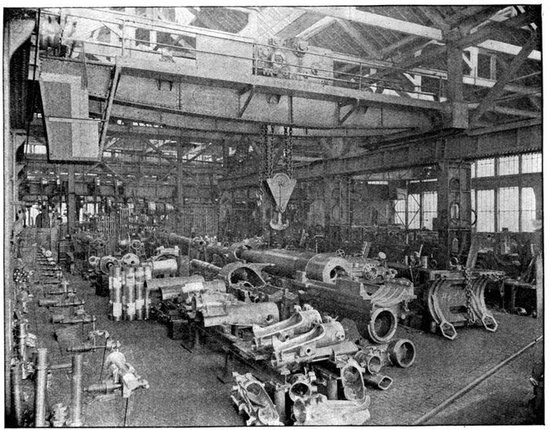
BIG GUNS IN PROCESS OF MANUFACTURE.
This is one of the workshops at Sir W. Armstrong, Whitworth & Co.'s
celebrated factory at Elswick. A large naval gun may be seen just
beneath the travelling crane.
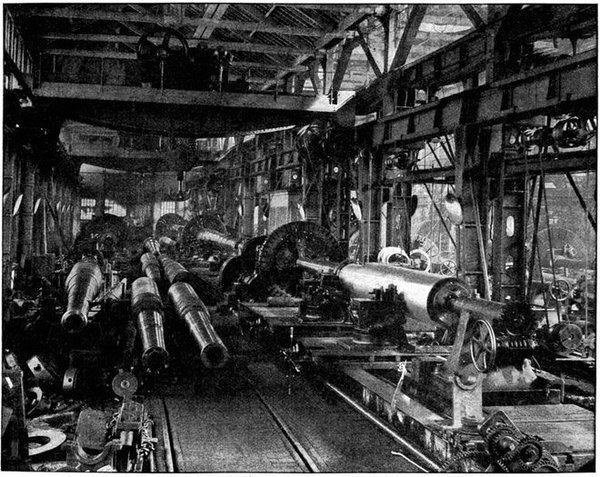
GIANT LATHES AT THE ELSWICK WORKS.
And some of the big guns which have just been turned upon them.
Former national crises.
Dec. 16, 1899.] Meeting of the
Committee for National Defence.
Not since the far-off times of Trafalgar had the national danger been
so great. In the Crimea it could truthfully be said that the British
Army was uniformly successful, and that the horrors of the winter of
1854-5 were due simply and solely to a defective commissariat. Besides,
there we had been outnumbered by the enemy; here we outnumbered them.
Then we had had the alliance of France, Sardinia, and Turkey, the
friendship of Austria, and the not unfriendly neutrality of Prussia;
now we were assailed and vilified by the people of every great nation
in Europe. The[Pg 213]
Indian Mutiny as a crisis could not be compared with this, for in
India, when once reinforcements had arrived, there was a continuous
series of successes. Not since the time of the American War of
Independence, more than a hundred years back, had we encountered such
frequent reverses. Yet though it was accustomed to easy victories, the
English race did not quail under the blow. No voice outside the ranks
of the least of the Little Englanders was raised for a surrender.
With one accord men called upon the Government to take the fullest
measures to restore the fortunes of the war. Everything demanded would
be granted; nay, the press, with a wise foresight which deserves the
gratitude of the country, urged the Ministry to far greater armaments
than those which the Cabinet had in mind. It would have been well in
this matter if the press had had its way.
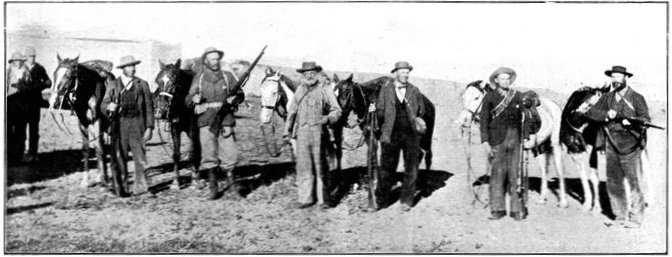
WARRIOR-FARMERS: COMMANDANT DE WET AND HIS SONS.
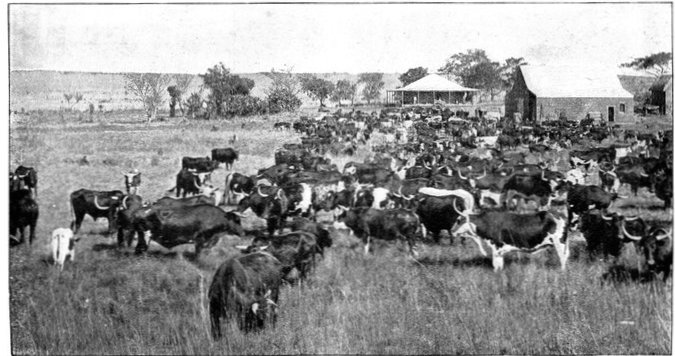
[Photo by N. P. Edwards.
A PROSPEROUS BOER CATTLE-FARM.
Measures taken for defence.
[Dec. 16, 1899.
To take steps to meet the danger, the Committee of the Cabinet for
National Defence—a committee which had the radical defect of being
composed wholly of civilian ministers without military knowledge or
experience—was held on December 16, the morning after the final news
of General Buller's defeat at Colenso reached London. The members of
the committee were Lord Salisbury, Mr. Balfour, the Duke of Devonshire,
Lord Lansdowne, and Mr. Goschen. Their deliberations were secret; the
measures upon which they[Pg 214] finally decided were in no way heroic—were,
indeed, hardly adequate to the perils of the situation. It had been
expected that they would call for 40,000 or 50,000 volunteers, place
under arms the Volunteers and Militia, and mobilise a good part of
the fleet, at the same time despatching to South Africa the largest
possible number of trained soldiers, and making the utmost use of the
zeal of the colonies.
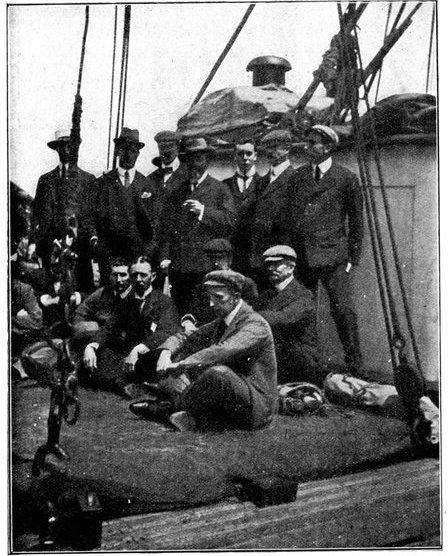
A DISTINGUISHED GROUP.
This group, photographed on board the Carisbrooke Castle, which
arrived at Capetown, November 14, 1899, includes several men who have
distinguished themselves in the war. The foremost officer is Capt.
Manns; seated immediately behind him is the Earl of Dundonald, the
inventor of the "Dundonald Galloping Carriage" for light guns, and
grandson of Lord Cochrane, the naval hero of the beginning of the
century. Next to him, the end figure in the seated row, is Col. Martin,
who commanded the 21st Lancers in their celebrated charge at Omdurman.
Next to the Earl of Dundonald on the other side is Capt. French,
employed at the base drilling the South African Light Horse, and
sitting close beside, and a little behind him, is the Duke of Hamilton,
whilst the Hon. G. Saumarez sits with his face partly hidden behind the
chain. In the standing row the officer on the extreme right is Major
Hoare; next to him is Carlisle Carr, who swam the Tugela under fire
and brought over the ferry-boat. The gentleman standing with his hands
in his pockets is A. P. Bailey, of Johannesburg, who gave a complete
ambulance to the Government.
Dec. 16-23, 1899.] Lord
Roberts to Command.
Actually the steps taken were these: All the Reserves not yet embodied
were called out. The Fifth Division was already on its way out, and a
Sixth Division had been offered General Buller upon November 30. Now it
was definitely announced that both a Sixth and a Seventh Division would
as soon as possible proceed to the front, and be followed, probably,
by an Eighth Division. Strong reinforcements of artillery, including
five batteries of horse artillery, nine of field artillery, and three
batteries of the invaluable 5-inch howitzers were to be despatched as
fast as they could be mobilised, thus almost doubling our strength of
guns in the field, and adding 102 more field-guns to the 114 pieces
sent out with the Army Corps. Besides these, it was intimated that
more siege guns, including huge 6-inch howitzers and heavy weapons
of position, would be provided when they could be supplied by the
manufacturers and the Royal Arsenal. The Commander-in-Chief in South
Africa, whose action had hitherto, if report could be believed, been
restricted by the Treasury and financial considerations, was to be
given a free hand to raise as many colonial volunteers as possible
in the Cape and Natal. Of the Militia, two battalions had already
volunteered for service outside the British Isles, and were about
to embark for Malta, whilst a third was destined for service in the
Channel Islands; nine more battalions were to be asked to tender
their help for garrison purposes in our coaling stations and imperial
fortresses, and an additional number of battalions was to be called
up for home service to supply the places of those who, under this
arrangement, would be sent abroad. A corresponding number of regular
troops would thus be released for service in the field. And now at last
the Volunteers, whose patriotic self-sacrifice had hitherto received
such scant acknowledgment at the hands of the War Office, were to be
called upon to show what stuff they were made of. They were to be asked
to furnish contingents for more serious work than Easter "reviews"
or Hyde Park parades.[Pg 215]
Two distinct volunteer forces were to be raised in England for work
in South Africa: the first, to be known as Imperial Yeomanry, was to
provide 8,000 mounted infantry. It was to be organised in battalions
464 strong, each composed of four companies of 116 officers and men.
The second force, recruited from the ranks of the Volunteers, was to
supply an infantry company for each regular battalion in the field,
or, in all, a total of about 9,000 men. The City of London was itself
to organise and equip a small force of four guns of the Honourable
Artillery Company, two companies of mounted infantry, and a battalion
of infantry. Finally it was announced that the patriotic offers of our
great colonies would no longer be declined.
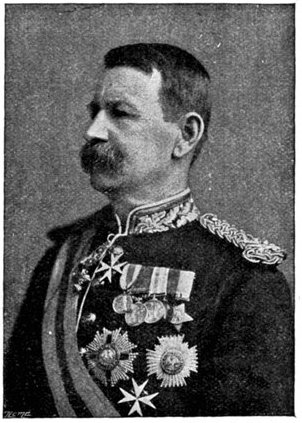
[Photo by Bassano.
LIEUT.-GENERAL SIR CHARLES WARREN, G.C.M.G., K.C.B., R.E.
Born 1840; entered the army in 1857; conducted excavations in
Palestine, 1867-70; Commissioner for delimiting Griqualand West,
1876-7; commanded the Diamond Fields Horse in the Kaffir war of 1877-8;
served also in Griqualand, 1878; commanded an expedition into Arabia
Petræa for the punishment of the murderers of Professor Palmer, 1882,
and the Bechuanaland Expedition in 1884-5; Commissioner of Metropolitan
Police, 1886-8; commanded Straits Settlements, 1889-94, and Thames
District, 1895-8; appointed to the command of the Fifth Division of the
South Africa Field Force, November 13, 1899.
Change of Generals.
But even more important than these additions to the material strength
of our forces in South Africa was the change in generals. Sir Redvers
Buller himself is believed to have suggested to the Home Government
after his Colenso defeat that it would be well to place Lord Roberts
in supreme command, and this step was now taken by the Committee of
Defence. If such advice were given, it was a fine, magnanimous and
disinterested action to General Buller's credit, and one for which
the nation may well honour him. As Lord Roberts' chief of the staff,
the ablest and the greatest of our younger generals was selected, the
Sirdar, Lord Kitchener of Khartoum. He was in the Sudan, but, when
asked by telegraph whether he would take this anxious and difficult
post under the new commander-in-chief, he replied, with alacrity:
"Delighted to serve in any capacity under Lord Roberts."
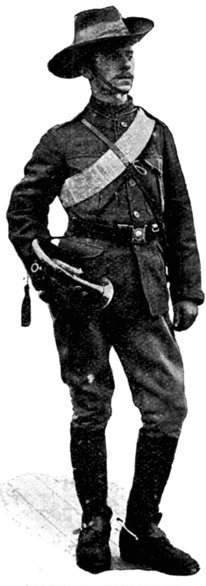
[Photo by Art Repro. Co.
A BUGLER OF THE CITY OF LONDON IMPERIAL VOLUNTEERS.
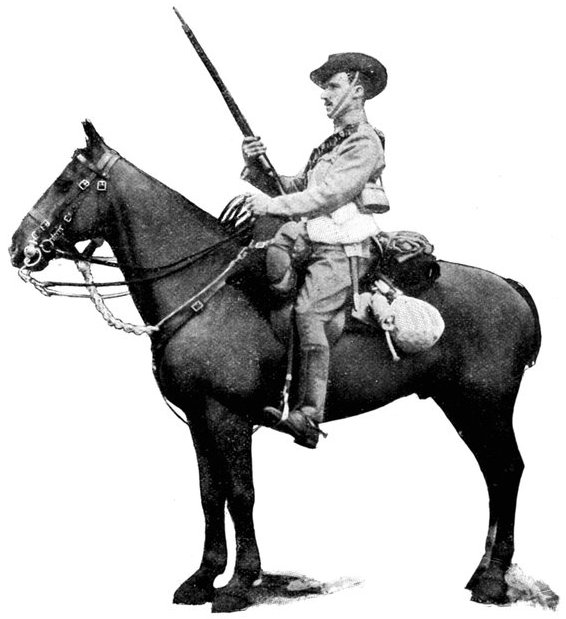
[Photo by Gregory.
A SERGEANT OF THE IMPERIAL YEOMANRY.
Lord Roberts' military career.
[Dec. 16-23, 1899.
The new commander-in-chief, Field-Marshal Lord Roberts of Kandahar, was
in his sixty-eighth year, yet, despite his age, he had retained the
vigour and energy of youth. Nineteen years before, in 1881, he had gone
out to South Africa to avenge Majuba, and had been recalled when Mr.
Gladstone changed his mind and decided to make a humiliating compromise
with the Boers. Now he was to achieve the work which then Fortune had
withheld from him. No soldier was more beloved and venerated by the
nation, to which his name had long been a household word. The feeling
of admiration and respect for him was strengthened by the thought that
he went forth fresh from the bereavement caused by the loss of his only
son, the gallant and devoted Lieutenant Roberts, who had laid down his
young life in the desperate attempt to save the guns at Colenso. In
sacrificing his private sorrow at the public[Pg 216] call, the Field-Marshal
set a heroic example of resignation under affliction. If he was popular
in the best sense with the nation, he was adored by the Army, which
knew him for an officer of the most remarkable personal courage,
strategic insight, and equability. In the Indian Mutiny he had won that
highest distinction our Army can give—the Victoria Cross—by attacking
two Sepoys and capturing from them a standard. His serenity of temper
and self-restraint were extraordinary. When at Poplar Grove he saw his
whole plan for the capture of the Boer army deranged by the hesitation
of a subordinate, though other great leaders would have stormed with
rage, he uttered not a complaint or a reproach. Closing his field
glass, he rode off in silence. As a leader of men, his sympathetic
Irish temperament enabled him always to win the enthusiasm of his
troops. They would have followed him anywhere. A few words from him at
once raised the courage of the shattered and decimated Highland Brigade
and restored to it the spirit which had marked it before Magersfontein.
A telegram in his magic style cheered Mafeking in its sore distress
and raised the spirit of its garrison to elation; his praise supported
his noble army through the trials of the weary march to Bloemfontein;
a speech from him renewed the flagging energy of thirsty, famished
men. His exquisite tact smoothed the ruffled Colonials, who had, in
the earlier stages of the war and by other commanders, been studiously
disregarded and snubbed. Small in stature as great in mind, he was
known among his men by one of those affectionate nicknames which
testify to a commander's popularity with his soldiers. Just as
Marlborough was christened by his troops "Corporal John," just as
Napoleon was to his men "the little Corporal," so Lord Roberts was
"Bobs" to his followers.
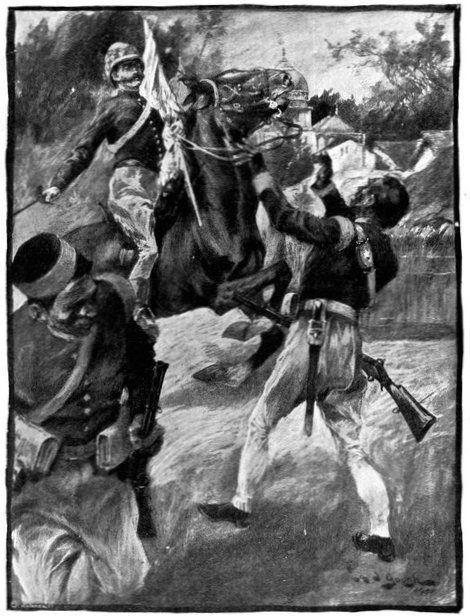
A. J. Gough.]
HOW LORD ROBERTS WON HIS V.C.
The Victoria Cross was awarded to Lieut. Frederick Sleigh Roberts,
Bengal Artillery, for distinguished bravery at Khodagunge on January 2,
1858. Two Sepoys were seen in the distance going away with a standard.
Lieut. Roberts went after them and engaged them both. They pointed
their muskets at him, and one of the men pulled his trigger, but the
cap did not explode, and Roberts immediately cut him down and seized
the standard.
[Pg 217]
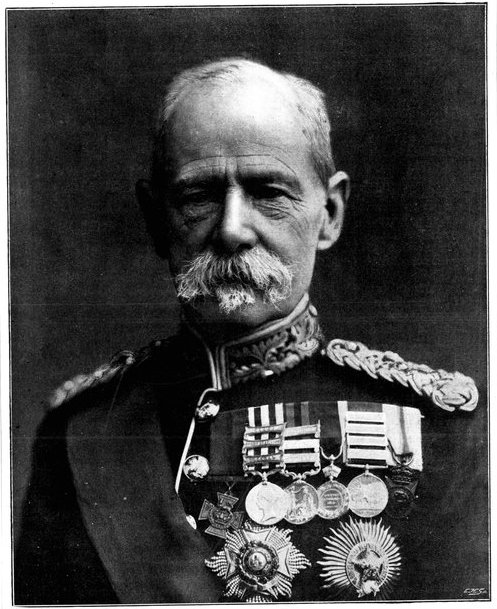
[Photo by the London Stereoscopic Co.
FIELD-MARSHAL LORD ROBERTS OF KANDAHAR AND WATERFORD, V.C., K.P.,
G.C.B., G.C.S.I., G.C.I.E.
This portrait, perhaps better than any other of the many which exist,
brings before one the true character of this great soldier. There is no
fencing with the steady, penetrating, and yet not unkindly gaze of the
eyes. The whole face speaks of that perfectly-balanced combination of
justice and mercy, vigour and refinement, inflexibility and consummate
tact, which have made Lord Roberts equally loved and feared. "His
army," says Mr. Julian Ralph with absolute truthfulness, "will do
anything for him; march longer, starve harder, go without tents,
blankets, and rum more days and weeks, and die in greater numbers for
him than for any other man alive."
Dec. 16-23, 1899.] Lord Roberts of Kandahar.
[Dec. 16-23, 1899.
In his character was that strength which simple faith and reliance upon
a Higher Power gives to the greatest among men. "Pray as if everything
depended upon God, act as if everything rested with yourself"—the
motto of the saint—was, it may be, one secret of his success. "He has
never been known to use an oath," writes Mr. Ralph in his exquisite
sketch of this noble figure. "And, indeed,[Pg 218] there must be comparatively
few men whose religion influences them so deeply as does his in every
affair of life. He never parades his piety, never forces it upon
those around him. Yet on every Sunday since he joined his army he has
attended Divine service. Not a word has he ever spoken to his staff
suggesting or ordering their presence—yet he is certain to attend the
weekly service—an example to the army so modestly and so persistently
presented that it cannot help but be powerful. When he took the
sacrament at Driefontein, the other day, in the face, one might say,
of the whole army, it was without a hint of the parading of religion.
All saw in it an act of simple faith. It is almost as hard to reconcile
his gentleness and sympathy with the firm—sometimes stern—course
which a general so supreme in command, and at the head of so large an
army, must often have to follow. I have asked many of his friends how
he can be both sorts of men at once—how he can possess traits which we
imagine must war with one another. 'He does possess them, that's all,'
is the best answer I have had; 'I don't know how, but he does.'"
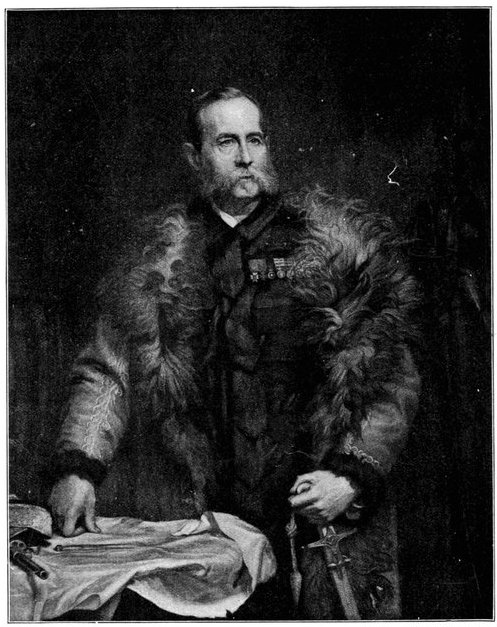
W. W. Ouless, R.A.] [
By permission of Messrs. Graves.
LIEUT.-GENERAL SIR FREDERICK SLEIGH ROBERTS (NOW LORD ROBERTS).
In the bearskin coat which he wore in Afghanistan.
As with Lord Nelson, to look upon him was to love him. "I have known
many great faces, but that of Lord Roberts is a face apart. I fancy
that, in the minds of their worshippers, some of the soberer gods of
the old mythologies had faces like his," wrote Mr. Ralph. And the face
portrayed the man, at once stern and gentle, noble and humble, patient
with the vast patience of one who knows men and their petty failings,
steadfast and strong.
Dec. 16-23, 1899.] Lord Roberts' Generalship.
For the command in South Africa Lord Roberts had many peculiar
qualifications. He was no stranger to the art of making war against
a brave, half-civilised enemy in difficult and mountainous country.
If in the Abyssinian War of 1868 he had seen nothing worth the name
of serious war, he had in the little wars with the hill tribes on
the Indian frontier, and especially in the second Afghan war, gained
valuable experience. In many ways the Afghans resembled the Boers.
Both peoples were soldiers by instinct and expert shots, with a talent
for taking cover. The Afghans in the war of 1877-8, the Boers in the
struggle of 1899-1900, were both for the first time acting in masses
with the help of artillery. Both could rely upon the great distance
to be traversed by the British troops[Pg 219] and the comparative barrenness
of their country, which yielded scanty supplies of food and forage,
as their best auxiliaries. But of the two races the Boers were
incomparably the more formidable enemies.
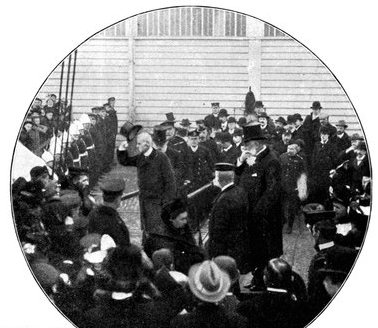
[Photo by Gregory.
LORD ROBERTS GOING ON BOARD THE S.S. "DUNOTTAR CASTLE" AT SOUTHAMPTON.
Lady Roberts accompanying him to witness his departure, December 23,
1899.
Lord Roberts' generalship in the Afghan War had been of a very high
order. In command of the Kuram column he distinguished himself early
in 1879, so that in the autumn of that year he was appointed to lead
the army which was to avenge the murder of the British Resident at
Cabul. On October 1 his real advance began. It was made with startling
rapidity, and on the 13th he marched through the streets of Cabul. Here
his small army had to pause, as in March and April 1900 the British
Army had to halt at Bloemfontein, and the enemy rallied, inflicting
more than one minor reverse upon his troops. But it was his great march
from Cabul to Kandahar, in the summer of 1880, which best illustrated
his judgment and daring. Cutting loose from his base, living on the
land as General Sherman had done in the famous march to the sea, he
led his little column, 10,000 strong, on August 8, out of his camp
at Cabul. On the 31st he entered Kandahar, having covered in the
twenty-three days 320 miles, and this in sweltering heat. So rapid were
his movements that he everywhere forestalled his enemies and met with
no opposition on the march.
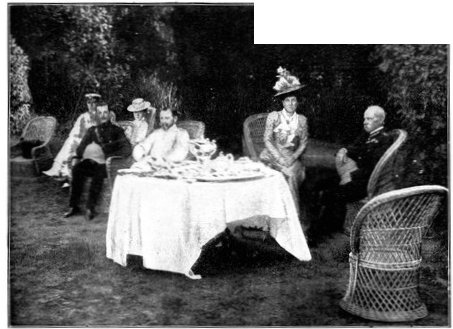
[Photo by E. Kennard.
LORD ROBERTS AT ADMIRALTY HOUSE, SIMON'S BAY.
[Dec. 16-23, 1899.
Not only was Lord Roberts great in war; in the quiet times of peace
he strove earnestly for military reform. He especially distinguished
himself during his Indian and Irish commands by the[Pg 220] emphasis which
he placed upon good shooting and the development of the soldier's
intelligence. He did not want his men to be the soulless automata of
the eighteenth-century barrack square. It is admitted by all, that
under him the Indian Army was raised to a pitch of efficiency which
it had never possessed before, and which, perhaps, has not marked it
since. Some who did not know him may have feared that here was another
reputation, won in savage or barbarous warfare, going to be lost in
that land where the fair fame of so many had suffered swift eclipse.
They may have asked themselves, if he failed with Lord Kitchener, who
was left. Yet those who knew him and had served under him felt no such
concern. To them his success was certain.
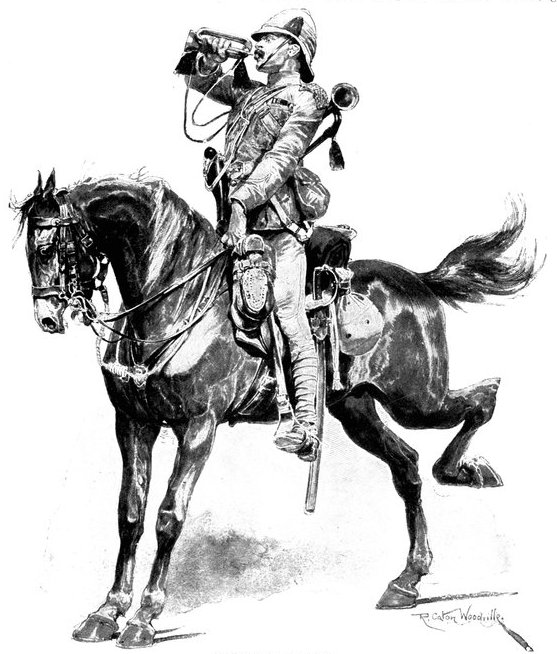
SOUNDING THE "CHARGE."
A cavalry trumpeter carries both a bugle for field calls, and a trumpet
for the more elaborate camp and barrack calls.
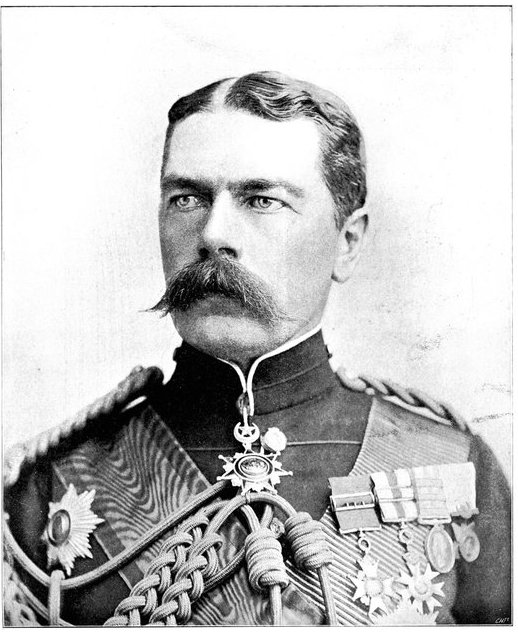
MAJOR-GENERAL LORD KITCHENER OF KHARTOUM, G.C.B.,
K.C.M.G., R.E.
Chief of the Staff to Lord Roberts in South Africa since December
23, 1899. Horatio Herbert Kitchener was born in 1850, the son of the
late Lieut.-Colonel H. H. Kitchener. He was educated at the Royal
Military Academy at Woolwich, and entered the Royal Engineers in
1871. He was engaged in the Palestine Survey, 1874-8, and the Cyprus
Survey, 1878-82. Commanded the Egyptian Cavalry, 1882-4; served in
the Sudan Campaign, 1883-5; Governor of Suakin, 1886-8; Colonel,
1888; Adjutant-General of the Egyptian Army, 1888-92; Major-General,
1896; commanded Dongola Expeditionary Force, 1896; and the Khartoum
Expedition, 1898, in which campaign he finally overthrew the power of
the Khalifa.
Dec. 1899.] Lord Kitchener in Egypt.
[Dec. 1899.
Lord Kitchener in the Sudan.
His chief-of-the-staff, Lord Kitchener of Khartoum, was in his fiftieth
year, but already, as the reconqueror of the Sudan, was by far the most
famous and trusted of the younger British[Pg 221] generals. His earlier years
had passed uneventfully, but with that energy and intense earnestness
of purpose which distinguishes the genius from the common-place man,
he studied and learnt Arabic, while most of his fellow-officers
were amusing themselves. Present at the bombardment of Alexandria,
in spite of and not because of orders received, he was employed by
Lord Wolseley when[Pg 222] that General came to Egypt for the Tel-el-Kebir
campaign. Thenceforward, Kitchener belonged to Egypt, and his career
is inseparably entwined with Egyptian history. He saw the sad tragedy
of the abandonment of the Sudan; he smarted with his countrymen at
the bitter shame of the betrayal of Gordon, and took part in the
expedition which came too late to save the martyred general. His eyes
must have fastened upon that prophetic page in Gordon's journals:—"I
like Baker's description of Kitchener. 'The man whom I have always
placed my hopes upon, Major Kitchener, R.E., who is one of the few
very superior British officers, with a cool and good head, and a hard
constitution combined with untiring energy.'"
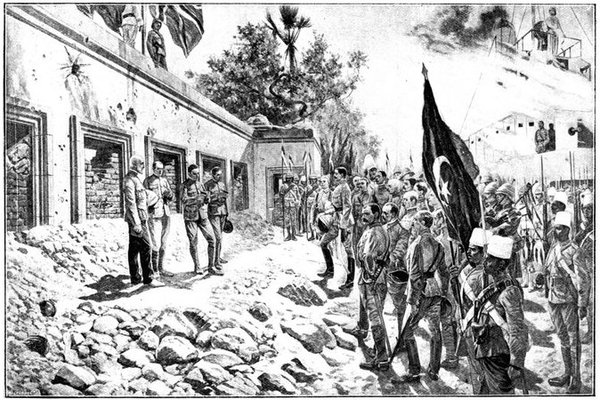
R. Caton Woodville.] [
By permission of Fishburn
& Jenkin, Doré Gallery, New Bond Street, publishers of the large
Engraving.
THE GORDON MEMORIAL SERVICE: THE SUPREME MOMENT OF LORD KITCHENER'S
CAREER AS SIRDAR, September 4, 1898.
The battle of Omdurman and the capture of Khartoum were followed by
a ceremony surely as touching as any in history. To the roar of a
salute from the gunboat on the Nile, the British and Egyptian flags
were run up side by side, and cheers for the Queen were led off by the
Sirdar himself. Then, amidst a silence broken only by the guns, "four
chaplains," says Mr. G. W. Steevens—"Catholic, Anglican, Presbyterian,
and Methodist—came slowly forward and ranged themselves, with their
backs to the palace, just before the Sirdar. The Presbyterian read the
Fifteenth Psalm. The Anglican led the rustling whisper of the Lord's
Prayer. Snow-haired Father Brindle, best beloved of priests, laid his
helmet at his feet, and read a memorial prayer bareheaded in the sun.
Then came forward the pipers and wailed a dirge, and the Sudanese
played 'Abide with me.' Perhaps lips did twitch just a little to see
the ebony heathens fervently blowing out Gordon's favourite hymn; but
the most irresistible incongruity would hardly have made us laugh at
this moment. And there were those who said the cold Sirdar himself
could hardly speak or see, as General Hunter and the rest stepped out
according to their rank and shook his hand. What wonder? He has trodden
this road to Khartoum for fourteen years, and he stood at the goal at
last."
Dec. 1899.] Lord Kitchener as a General.
His experience was wide and various. It was not only in the conduct
of war, but also in civil administration that he had made for himself
a name. Though he never courted popularity and had no influence of
any kind, his sheer ability carried him forward. That unerring judge
of men who trained Sir Alfred Milner, Lord Cromer, selected Kitchener
as Sirdar in 1892. The new Egyptian commander made of the army under
his charge a miracle of efficiency at an insignificant cost. Quietly,
methodically, he organised and prepared for the reconquest which, he
knew, must come in time, when the conscience of the British nation
awoke. He made no mistakes; he took the utmost pains to find out what
the enemy was doing, conscious that victory in war largely depends
upon perfect information. The Egyptian Intelligence Department was as
efficient as the Egyptian Army. And when at last the long-desired hour
struck and the British and Egyptian troops marched southward into the
desert "to avenge Gordon," everything was ready, everything went like
clockwork. Firket, the Atbara, and Omdurman followed in regular and
mechanical succession. The man "who[Pg 223] had made himself a machine" did
his work surpassingly well. All that the nation heard about its new
general delighted it. The very gossip which was meant to discredit him
only increased his reputation. His dislike for triflers and idlers,
his aversion from all kinds of favouritism, his determination to
insist upon strict discipline, competence, and knowledge in those
whom he employed, might estrange from him the darlings of fortune,
but were a recommendation to the people of England. He was outwardly
cold and stern, like many deep natures, but no general is unpopular
with his troops if he always succeeds. With Lord Kitchener the men
felt instinctively that every thing would be foreseen, all precautions
taken, and nothing overlooked. They knew that everyone would do his
duty, or if not that the Sirdar would want to know the reason why.
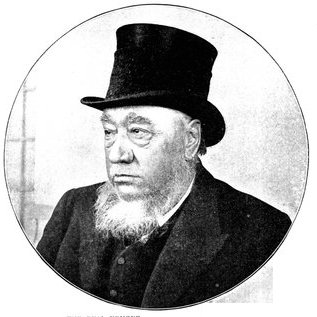
THE REAL KRUGER.
Two Portraits taken on April 24, 1900.
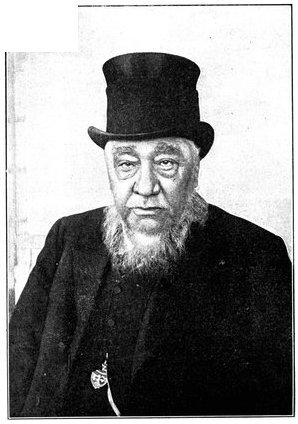
[Copyright of the "Review of Reviews."
[Dec. 1899.
Lord Kitchener, then, took with him to Africa the prestige of a great
name, the reputation of continual success, and the habit of handling
large masses of troops. No living English general, not even Lord
Roberts, had ever had under him in war so many troops as Lord Kitchener
led into the field in 1898, when he marched to Omdurman 8,200 British
and 17,600 Egyptian soldiers, with sixty-four field guns and Maxims.
Last, but not least, Lord Kitchener had seen little of the mischievous
kind of fooling which at Aldershot, under the specious guise of Field
Days, served rather to render our generals inexpert and our soldiers
careless of the methods of war, than to familiarise them with something
approaching the real conditions of battle. His training had been that
of actual war, his power of organisation was undoubted, and even
his bitterest detractors had to confess that he was a successful[Pg 224]
leader. But what, perhaps, most recommended him to his country was his
seriousness of purpose and his concentration of aim. His very face
bore in every line the look of iron resolution, of a spirit which
fears nothing and calculates everything. And that, perhaps, was why
the swift genius of Mr. Steevens christened him "the machine." For he
rose superior to the accidents of fortune and the tragedies of life;
nothing seemed to shake his coolness or weaken his purpose. Here was a
general who would never show the not ignoble weakness which wrecks so
many would-be leaders—the unwillingness to incur losses, the inward
rebellion against sending brave, devoted men to death. Yet that his
nature was not without a strain of sentiment was proved by that strange
commemoration service, held on the scene of Gordon's death, in sight
of the still reeking battlefield of Omdurman, which set the seal upon
the purpose of ten long years, and to some extent obliterated the shame
felt by his countrymen for the death of that noble man. The interest
which attached to Kitchener's personality was enhanced by the fact that
he was something of a riddle to his countrymen, who suspected that
under the outer veil of iciness which marked him, as it marked Moltke,
lay concealed the warmer qualities of the heart.
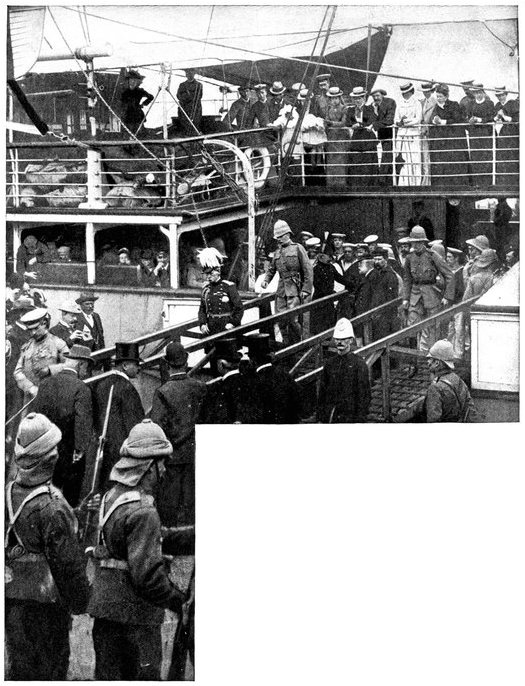
ARRIVAL OF LORDS ROBERTS AND KITCHENER AT CAPE TOWN,
January 4, 1900.
[Pg 225]
Dec. 23, 1899.] The New Generals hasten out.
Embarkation for South Africa.
On Saturday, December 23, Lord Roberts left London to embark upon the
Dunottar Castle. A great popular demonstration marked his departure.
An immense crowd, in which were merged and lost members of the Royal
Family, Cabinet Ministers, guardsmen, soldiers who had in the already
far-off past marched with him to victory, and the great unwashed,
were impartially assembled upon the platform of Waterloo. It was
noticed that nearly all were in black—a sombre hue typical at once
of the nation's sorrow under its defeats and of its sympathy with the
general in his personal bereavement. Amidst a thunder of cheering the
new Commander-in-Chief stepped into the train, already in motion. The
cheers continued till he was lost to view. Thus, with the knowledge
that he bore with him the regard and devotion of his race, he went
forth to his work.
At Southampton the demonstration was repeated. Meantime Lord Kitchener
embarked in the cruiser Isis at Alexandria on the 22nd. The Isis
steamed her fastest—eighteen knots—to Malta, where she met the
Dido, and that good warship covered the rest of the distance to
Gibraltar, where the Dunottar Castle was to be met. The extreme haste
gave evidence of the seriousness of the emergency. From Gibraltar the
liner headed for the Cape by the usual route, and the time of the
voyage was used by the Field-Marshal and his Chief-of-the-Staff to
work out their strategic plans for the new campaign that was to change
disaster into triumph.
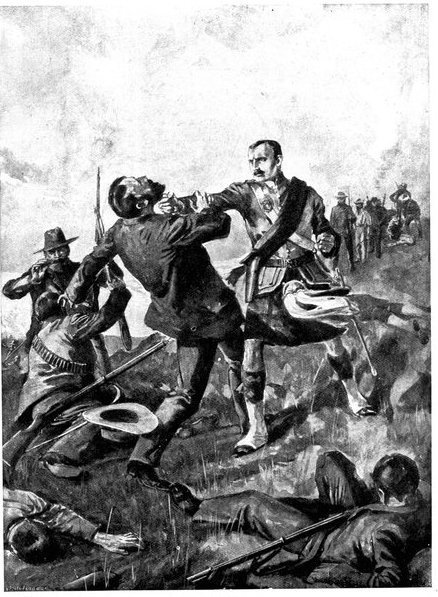
A. C. Ball.]
HECTOR MACDONALD AT MAJUBA.
When the Gordon Highlanders were beaten back on the disastrous day of
Majuba, Lieutenant Macdonald, still unwounded, rallied his men for a
last stand. He was disarmed, but met the onslaught of a group of Boers
with his fists, knocking down three of the enemy in succession. His
pluck was appreciated; a Boer who had felt the weight of his blows
called to one of his fellows, who was in the act of covering Macdonald
with his rifle, to "spare that brave man." He was spared, and of course
taken prisoner; but General Joubert treated him with consideration,
even returning to him his sword—the sword which had but recently been
presented to him by his fellow officers at Kandahar.
General Hector Macdonald.
[Dec. 1899.
Other changes and new appointments in the higher ranks of the Army were
made about this same time. From India General Hector Macdonald was
summoned to lead the Highland Brigade. He was an officer of extreme
popularity and with a remarkable history, which proves that in the
British[Pg 226]
Army, as in the hosts of Napoleon, "a career is open to talent."
Beginning life as a draper's assistant, he enlisted in the ranks.
Under Lord Roberts in Afghanistan he rose like a rocket, winning by
superb bravery step after step—corporal, sergeant, colour-sergeant,
and lieutenant in quick succession. He fought at Majuba, where his
splendid courage led the Boers to spare his life. With the Gordons he
held the kopje on the western face of the mountain to the very last,
and all but two of his men were killed or wounded. He was one of the
distinguished group of officers who, as time went on, found employment
in the Egyptian Army, where his great military aptitudes were given
full scope. He shared in all the Sirdar's victories, and at Omdurman,
in command of the First Egyptian Brigade, showed admirable generalship,
contributing in no small degree to that great success.
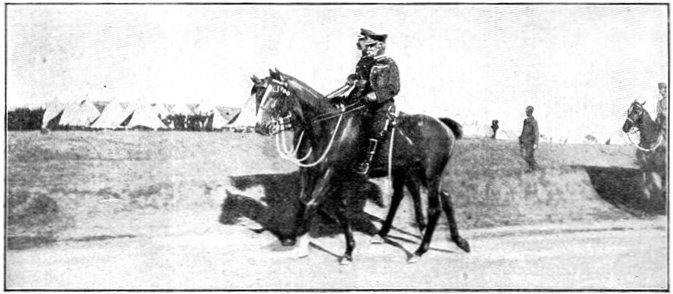
LORD ROBERTS AND HIS CHIEF-OF-STAFF, LORD KITCHENER.
This photograph was taken at Cape Town, when the two generals were on
the way to inspect the City Imperial Volunteers.

GENERAL HECTOR MACDONALD AND HIS FORMER SUPERIOR.
On his way to the Modder River, General Hector Macdonald encountered
Col. Macbean of the 1st Gordon Highlanders, under whom he had served
as Colour-Sergeant of the 92nd, when Macbean was Captain of the same
Company.
Offers of the Colonies.
Dec. 1899.] Magnificent Offers of the Australasian
Colonies.
The news of the British reverses was expected by all the enemies of
England—enemies within and without—to prove the final blow to the
British Empire. "The British Colonies," said one of the more moderate
French journals, "will certainly secede when disaster weakens the
Mother country's grasp upon them." Mr. John Morley in his famous
article, "On the Expansion of England," had argued before the war, in
much the same style, that at the first sign of peril the Australians
and Canadians would "cut the painter." "Is it possible to suppose," he
had asked, "that Canadian lumbermen or Australian sheep farmers would
contribute anything towards keeping Basutos and Zulus quiet?" The
question was answered, and answered speedily and dramatically, when
upon the top of the sad messages announcing from South Africa defeat
upon defeat, came telegram after telegram from the great self-governing
Colonies, offering far more than money—their own flesh and blood.
Then it was seen and realised at last that the Empire was one and
indivisible—that it was something which, like the Church, neither
distance nor climate could disunite. Never before in history had the
Colonies of a great state spontaneously offered for distant service
thousands of men. And thus were triumphantly justified the foresight
which had led England to concede to her settlers the largest measure
of self-government and the new spirit of pride in the Empire which
had first found definite expression in the celebrations of 1897. Then
Colonial troops had marched in all the pomp of peace through[Pg 227] the
streets of the capital; now they were to march of their own free will
to the bloody work of a desperate war.

Sir W. G. Armstrong, Whitworth, & Co.]
12-POUNDER GUN AND LIMBER.
This gun is one of a battery presented to Lord Roberts by Lady Meux,
manufactured at the Elswick Works and manned by Elswick Volunteers.
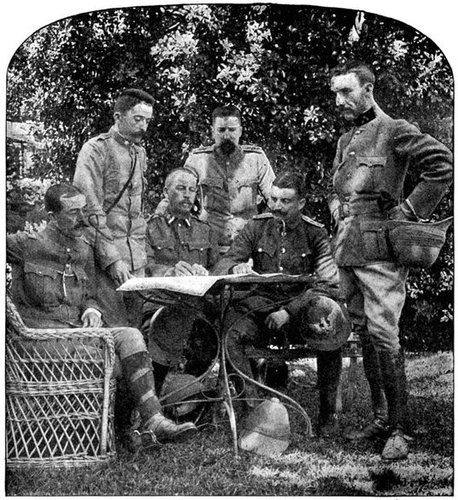
[Copyright 1900 by Underwood & Underwood.
FOREIGN MILITARY ATTACHÉS.
Commissioned to accompany the Commander-in-Chief in South Africa.
Australian and Canadian contingents.
[Nov.-Dec. 1899.
On December 14, before the news of Colenso was known, the Premier of
New South Wales had telegraphed to Mr. Chamberlain asking him whether
the Home Government would care for more men from New South Wales. A
statement to that effect in the Sydney Parliament was greeted with
the wildest enthusiasm, the members rising and singing "God save the
Queen." Mr. Chamberlain lost no time in replying. His answer ran:—"The
Imperial Government is prepared to entertain the offer of further
troops, mounted men preferred. It is indispensable that the men should
be trained and good shots, supplying their own horses." Victoria,
Queensland, South Australia, West Australia, New Zealand, and Tasmania,
all agreed to contribute men. The total strength of the new contingent
was fixed at 1,000 mounted infantry, but this total was largely
exceeded. A field battery and a field hospital were despatched in
addition by the New South Wales Government, while New Zealand supplied
four Hotchkiss guns. The patriotism of the Colonial Parliaments was
equalled by the patriotism of the peoples who had to find the men and
money. Great landowners came forward with offerings of horses; citizens
subscribed thousands of money for the perfect equipment of the force
and the pensioning of dependents of the men who volunteered. Doctors in
good practice volunteered to accompany the troops, and the difficulty
was not to obtain men, but to settle who was to go and who to stay
behind. Ten thousand men could with ease have been enlisted in a week.
The Colonial Administrators were not content with sending help; they
sent it quickly, and their forces were the first of the new levies to
appear in the field. Moreover, they quietly assembled and drilled yet a
third contingent, to be ready for the worst. The total strength of the
second contingent was, as far as can be ascertained, as follows:—New
South Wales 900 men, Victoria 300, New Zealand 234, Queensland 150,
South Australia 100, West Australia 90, and Tasmania 45.[Pg 228]
From first to last Australia placed over 8,000 men in the field, or
nearly a complete division. As an example of the general enthusiasm may
be mentioned the fact that an insurance company offered a pension of
a pound a week for life to the first Australian who won the Victoria
Cross, an honour which fell to Trooper Morris, of the New South Wales
Lancers.
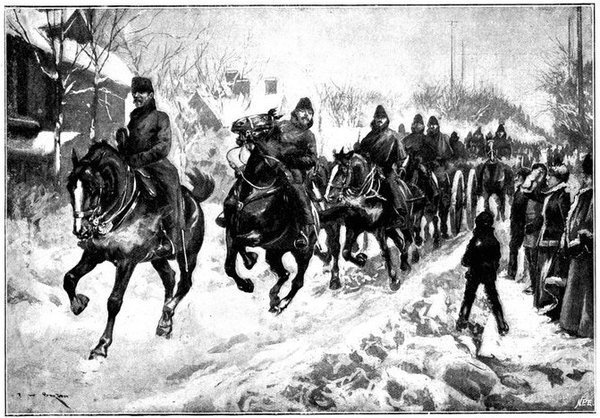
F. W. Burton.] [
After a photo by J. B. Bawden.
FROM CANADA'S SNOWS TO AFRICA'S BAKING SANDS.
The farewell parade of D Battery, Royal Canadian Artillery, in Ottawa.
Canada had offered a second contingent as far back as November 7, so
that her Government may claim the credit of first realising the danger.
The offer was not accepted till the December defeats had taught the
British Ministry the perils of the situation. On December 18, Sir
Wilfrid Laurier held a Cabinet Council and instructed the Militia
Department to prepare the new contingent with the utmost expedition.
Its strength was fixed at three squadrons of mounted rifles and three
batteries of artillery, mustering a total of 1,044 men. The Premier
of the North West Territories announced, even before the appeal was
made, that he would undertake to raise 1,000 expert horsemen and good
marksmen at twenty-four hours' notice in his territories alone. When
the call for volunteers came, here, as in Australia, many times as many
men offered themselves as could be accepted. Finally, the strength
of the second Canadian contingent was raised to 1,300 men with six
12-pounder guns, but even so, it was far below the wishes of the
people. The men who were picked were active and intelligent, accustomed
to an outdoor life, sitting their horses like centaurs. They speedily
showed in war that they were a full match for the Boers, man for man,
in marksmanship, the art of taking cover, and stubborn courage, while
they had that high spirit which preaches attack rather than defence,
and which the Boers, among their many fine qualities, altogether lacked.
Dec. 1899.] Fighting Men, not Fault-finders,
Wanted.
Among Canada's most splendid contributions was Lord Strathcona's Corps.
At his own expense, over and above the contingent 1,300 strong, he
raised in the North West 400 "rough riders," armed them, and equipped
them for service. They were all unmarried men of fine physique, and,
like[Pg 229] all the Canadians sent to the front, good horsemen and excellent
shots. Nor was the Canadian Agent-General content with this magnificent
gift. He conveyed the corps at his own cost to Capetown, so that the
400 men were landed in South Africa without the expenditure of a penny
by the British Government.
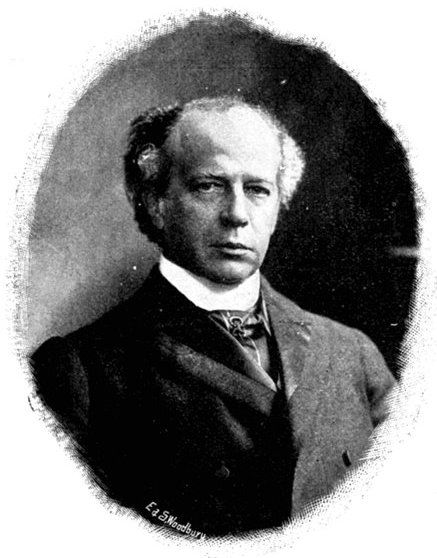
[Photo by Lafayette.
THE RIGHT HON. SIR WILFRID LAURIER,
The patriotic French-Canadian Premier of Canada.
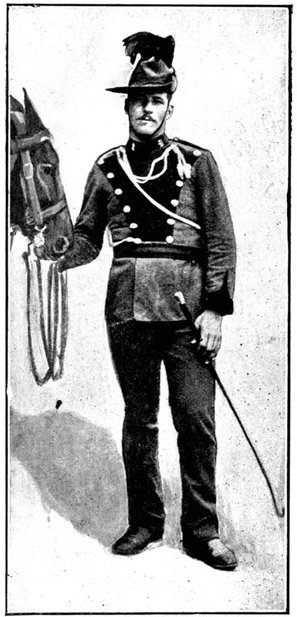
[Photo from Mrs. Craigmile, Banchory.
TROOPER TOM MORRIS,
Of the New South Wales Lancers; the first Colonial to be recommended
for the V.C.
Mr. Seddon's loyal speech.
A speech of Mr. Seddon's, the Premier of New Zealand, made at this
time, perhaps best explains the enthusiasm of the colonies and proves
the fervour of their devotion, though he was himself speaking only
for New Zealand. "At the present time," he said, "fighting men, not
fault-finders, are required in the interests of the Empire. The war is
only nominally with the Boers; actually it is with all those who are
jealous of the growing power of the British Empire, and who, rejoicing
at our reverses, are aiding and abetting the Boers. The reverses
suffered are only temporary: they will be followed by the invariable,
inevitable success of British arms. The people of New Zealand are
determined that the prestige of the British Empire, to which they
belong, shall be maintained at all hazards. Though New Zealand is
Radical and Democratic, even termed by some Socialistic, there is in
the present emergency an amount of imperial patriotism in the country
not to be surpassed elsewhere in Her Majesty's dominions."
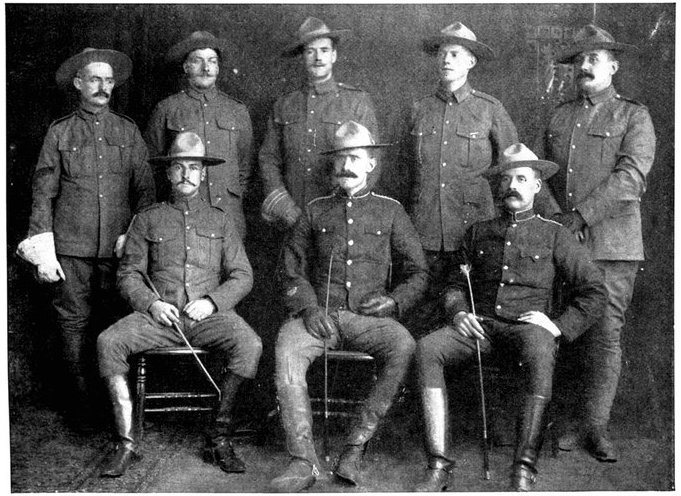
[Photo by Notman, Montreal.
STALWART CANADIANS.
This group consists of volunteers, all over six feet in height. Three
of them are bankers; several are members of the North-West Mounted
Police.
Volunteers from Asiatic dependencies.
[Dec. 1899.
The feeling of Australasia and Canada was echoed wherever the British
flag flew. In India, native princes offered their purses, their armies,
and their swords. Native regiments voluntarily subscribed a[Pg 230] day's pay
to the War Fund. In India, in Ceylon, and in the Straits Settlements,
small corps of mounted volunteers were raised and despatched to the
front. There would have been no difficulty in providing hundreds of men
in India alone, and that without drawing upon the garrisons, but the
Europeans could not well be spared from their posts. In South Africa
itself volunteering proceeded with the greatest alacrity, and some
thousands of men were raised in Cape Colony among the British and the
loyal Dutch.
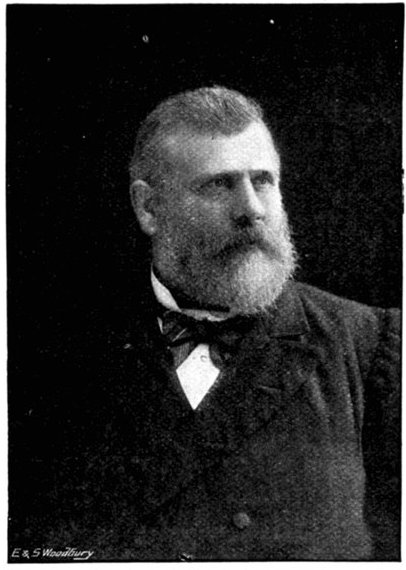
[Photo by Talma, Melbourne.
THE RIGHT HON. R. J. SEDDON,
Premier of New Zealand since 1893.
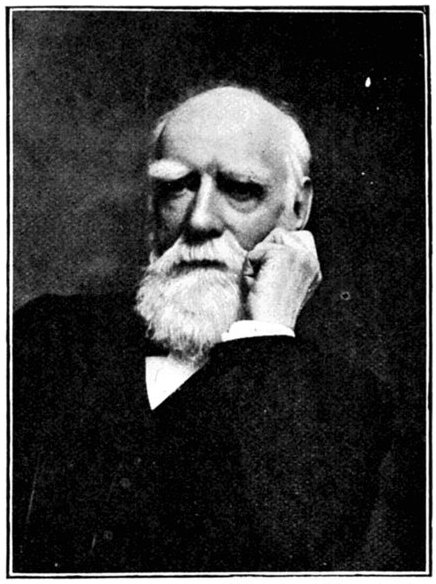
[Photo by Elliott & Fry.
LORD STRATHCONA,
High Commissioner for Canada.
At home the call for volunteers met with an eager response. On Monday,
December 18, the 3rd Durham Light Infantry (Militia) volunteered to
a man for foreign service. The 3rd York and Lancaster Regiment on
parade on the same day was addressed by the colonel, and those who
would volunteer ordered to slope arms, whereupon every man responded.
The Cornwall, East Surrey, West Surrey, Gordon Highlanders, Royal
Warwickshire, and Yorkshire Artillery Militia all followed suit. In
no case did any militia battalion when invited to give its services
show the smallest reluctance. The volunteers were equally eager
and enthusiastic. Thus the colonel of the 3rd Middlesex Volunteer
Artillery, when asked how many men would give their services, answered,
"The whole regiment will do so if required." It may be questioned
if sufficient use was made of this eagerness, and bitter complaints
were heard from the volunteers as to the unreasonable severity of the
medical examination of those finally selected.
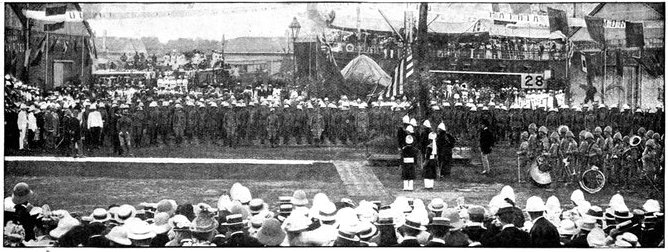
INSPECTION OF LUMSDEN'S HORSE BY THE VICEROY OF INDIA,
AT CALCUTTA.
In the photograph the Viceroy, Lord Curzon,* in light coat and hat, is
seen amidst the group on the left, on his way to the dais after the
inspection.
London's contribution.
Dec. 1899.] The Wives, Widows, and Children cared
for.
The City Council, at a meeting held on December 20, decided to select
detachments of twenty picked marksmen from volunteer regiments and
to form them into its battalion of City Imperial Volunteers, 1,000
strong. The sum of £25,000 was contributed to the equipment of this
force by the City Funds, and the freedom of the City was promised
to every volunteer in the organisation. Of this and other patriotic
movements in the Empire's capital we shall have more to say shortly.
Private individuals came forward with the most splendid generosity to
contribute to the fund raised to defray the cost of the force. Messrs.
Wilson, of Hull, the great shipowners, offered free of charge the use
of a fitted transport for three months—an offer which was,[Pg 231] it was
calculated, equivalent to the gift of £15,000. Besides the infantry
battalion, the City provided a battery of four guns and a detachment of
mounted infantry. All ranks and all conditions showed equal alacrity
in helping the cause. Those who were of fighting age and physique were
ready to give their lives; the rest contributed money to the best of
their ability. Working men subscribed their pence and shillings to
keep in comfort the wives and children of their comrades who had gone
to the front. And unquestionably the manner in which the nation had
done its duty by raising hundreds of thousands for the wives, widows,
and children of the soldiers, and for the comfort of the wounded
contributed in no small degree to the alacrity with which the call to
arms was met. The soldier was everywhere what he should always have
been—a privileged and honoured man.
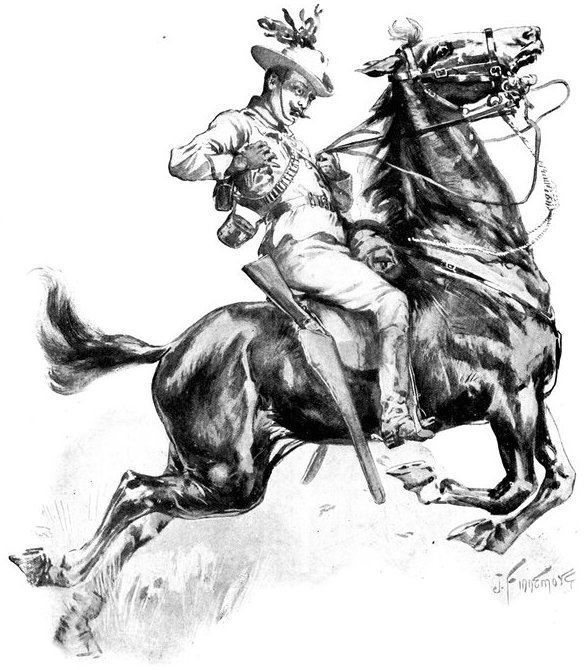
HIT!
A wounded New South Wales Mounted Rifle.
[Pg 232]
[Dec. 1899.
Imperial Yeomanry.
For the raising and equipment of the Imperial Yeomanry, 8,000 strong,
private effort and subscription were entirely responsible. The work
of organisation was undertaken by Lord Chesham, and in every county
committees were formed to further the recruiting of the corps. The idea
was to enrol young men who were good riders and good shots, and it
was carried out with very fair success. There was no want of men; the
only difficulty was to find suitable men. The great nobles and wealthy
families of the country were forward in volunteering. The Duke of
Marlborough, Earl Dudley, Lord Alwyne Compton, the Marquis of Hertford,
the Hon. T. A. Brassey—a well-known writer upon naval matters—and
the Hon. Schomberg K. M'Donnell, private secretary to Lord Salisbury,
were a few typical names from the long list of those who sacrificed
comfort and ease for a life of pain and hardship in South Africa. Among
the various corps raised were companies of rough riders, composed of
"bachelor gentlemen" who provided their own arms, and several companies
the ranks of which were entirely filled by gentlemen. In all, nineteen
battalions were enlisted, in each case four companies strong, the
companies numbered consecutively from 1 to 76. More might have been
raised, but in March, 1900, enlistment was stopped by the Government.
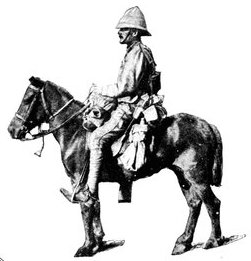
[Photo by Surgeon-Major Beevor.
FROM FAR BURMA.
A volunteer, mounted on his little Burmese pony.
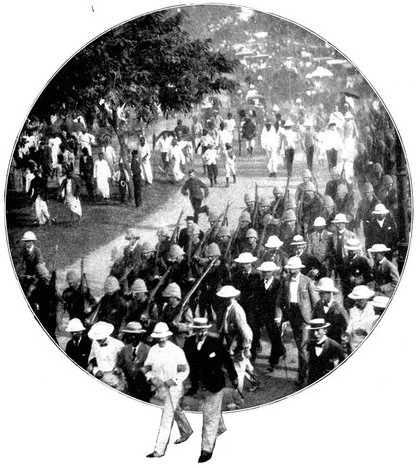
[Photo by Skeene, Colombo.
VOLUNTEERS FROM CEYLON.
The contingent of Ceylon Mounted Infantry (mostly tea-planters, and
good riders and marksmen) leaving Colombo for the Cape, Feb. 1, 1900.
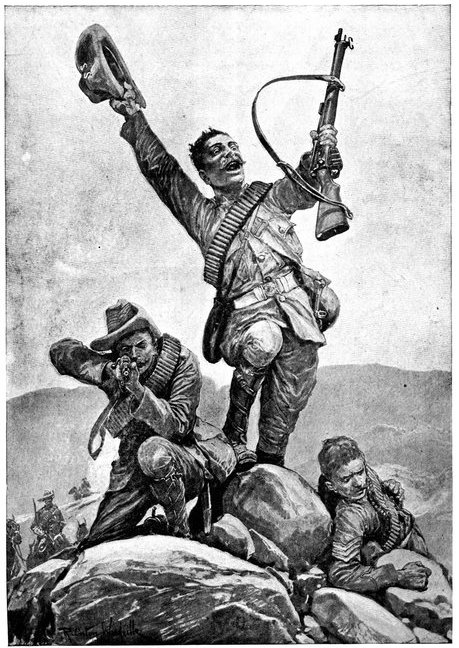
R. Caton Woodville.]
FIRST ON THE TOP!
Some of London's Volunteers show their mettle.
Gloomy outlook.
[Dec. 1899.
In this national uprising passed the last days of December and the
first weeks of January. It was a sad Christmas and a sad New Year, and
there was ample cause for gloom in the country. Yet the eagerness with
which England and the Colonies had replied to the call to arms was a
source of encouragement and hope, though the question might still be
asked, with some uneasiness, whether even now a sufficient force was
being prepared for the difficult work of a prolonged war of conquest.
Still, 50,000 men of the regular army or the volunteers, 15,000 of
the militia, and some 10,000 colonists were now preparing to take the
field in South Africa. The new generals who were to organise victory
by throwing this great [Pg 233]
[Pg 234]force into the balance were already upon
their way to the scene of action. But weeks, if not months, must pass
before the new divisions and battalions could enter into line, and in
that time much might happen. Could Ladysmith, could Kimberley, could
Mafeking, protract their resistance through this period of delay? That
was the question which rendered this period one of such harassing
anxiety, for the fall of these places would unquestionably be followed
by the great insurrection of the Cape Dutch, which was the last and
crowning calamity to be feared. It is very clear that the Boers had all
along counted on this movement on the part of their blood relations
in British territory; and it is equally certain that they would not
have counted in vain had they themselves shown a more daring and
enterprising spirit. In every direction disloyal Afrikanders were doing
their utmost to assist the Boers and to hinder the British; their sons
were they "knew not where;" they had left their homes on mysterious,
or not mysterious, hunting expeditions, rifles in hand and good horses
beneath them. More rifles were only awaiting a safe opportunity for
producing them. The guarding of lines of communications had to be as
strenuous as if the Cape Colony had been an enemy's country. Much more,
therefore, than the fate of the garrisons themselves depended on the
power of the beleaguered towns to hold out until the British forces
could assume the offensive.
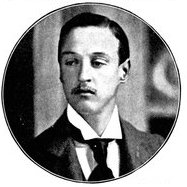
SOME NOBLEMEN AT THE FRONT.
[Photo by Elliott & Fry.
THE DUKE OF MARLBOROUGH.
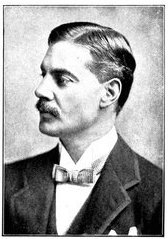
[Photo by Russell & Sons.
LORD ALWYNE COMPTON.
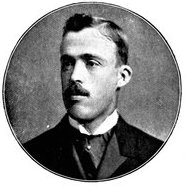
[Photo by Elliott & Fry.
THE HON. T. A. BRASSEY.
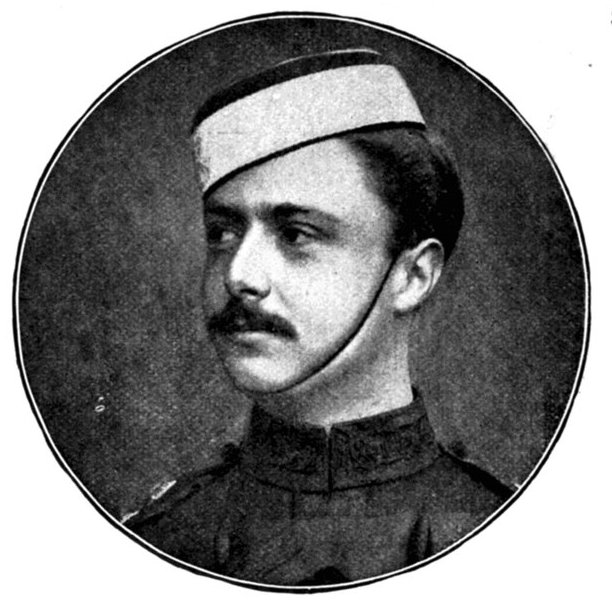
[Photo by Russell & Sons.
EARL DUDLEY.
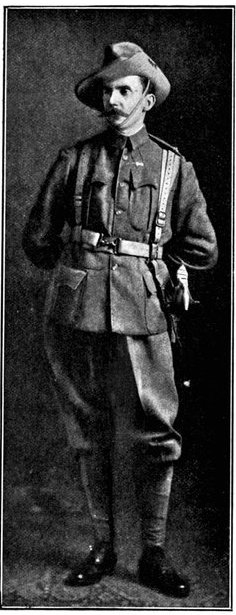
[Photo by Elliott & Fry.
THE HON. SCHOMBERG McDONNELL,
In the uniform of the City Imperial Volunteers.
[Pg 235]
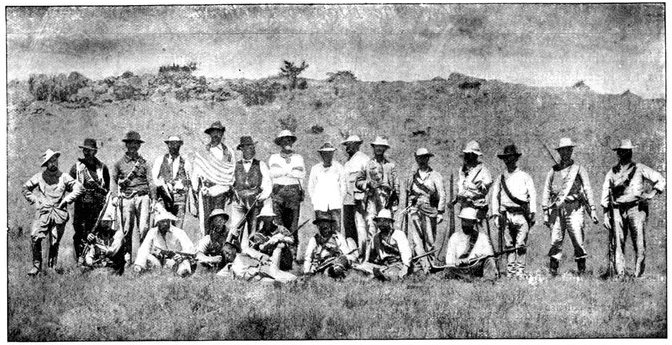
AMERICANS IN THE BOER ARMY BESIEGING LADYSMITH.
This photograph shows Mr. Webster Davis, rifle in hand, amidst the
American mercenaries serving with the Boer army. Mr. Davis was formerly
Assistant Secretary of the Interior Department of the United States
Government. He proceeded to South Africa during the course of the
war, and after following some of the Boer commandos into the field,
he returned to America, where he took a prominent part in a pro-Boer
agitation, making public speeches in favour of the independence of the
Boer Republics.
CHAPTER XII.
THE FLANK MOVEMENT IN NATAL.
Further preparations for the relief of Ladysmith—Burial
of Lieutenant Roberts—Destruction of Colenso
road-bridge—Picket surprised by Boers—Fifth Division
reaches Natal—Want of howitzers—Arrival of a balloon
and traction engines—Christmas in camp—Disposition
of relief force—Boer positions—Mr. Winston Churchill
escapes—Boer attack on Cæsar's Camp—Messages from
Ladysmith—Relief force attacks Colenso—Advances
on Springfield and Hussar Hill—Fail to draw the
Boers—Further message from Ladysmith—Storm ends
a desultory movement—The flag still flying in
Ladysmith—Heroes in rags—Mud everywhere—Composition
of the relief force—The army moves—Hampered by
baggage—Difficulties of the march—Dundonald
seizes Zwart Kop—The pont intact—The Boers
entrenching—General Buller's plan of attack—The
crossing of Potgieter's Drift.
Further preparations for the relief of Ladysmith.
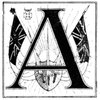
After the disastrous reverse at Colenso a long pause followed before
the relief army in Natal again took the field. The pause was necessary
to allow of the bringing up of reinforcements in men and artillery,
since, on the one hand, the battle of Colenso had demonstrated clearly
that General Buller's 25,000 men were not equal to the work of forcing
a passage to Ladysmith, and on the other the transference of ten
British guns to the enemy had fatally weakened the British artillery.
It is to be noted, however, that the Boers made little use of the
captured guns; they professed to regard them, perhaps correctly,
as of antiquated pattern with insufficient range, and preferred
their own Krupps, Creusots, and Maxims, not being hampered by an
organisation which considers it part of its duty to remain always a
little behind rivals and competitors in its armaments. In this and in
other directions the "simple farmers" showed that their simplicity was
superior in its shrewdness to the learning of the British artillerists.
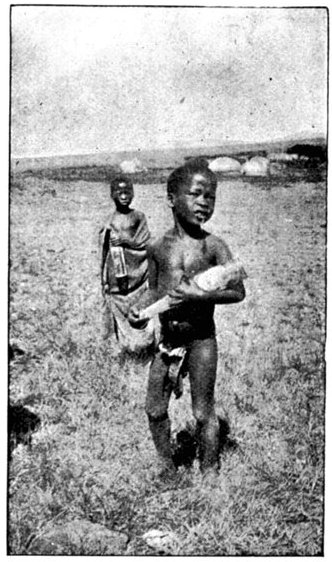
[Photo by Capt. Foot.
LITTLE MILK CARRIERS,
Bringing supplies to a picket under fire on the Tugela.
[Dec. 15-21, 1899.
Burial of Lieutenant Roberts.
Two days after the battle the gallant Lieutenant Roberts, who had
fallen mortally wounded in the effort to save the guns, died and was
buried with five soldiers who, like him, had succumbed to their wounds.
He lies at Chieveley in sight of the stubborn lines of entrenchments[Pg 236]
which on that mournful Friday repulsed the onslaught of the finest
infantry in the world. To pay him the last honours General Clery and
his staff were present at the funeral. Thus was all his early promise,
all the hope of his family, laid in an untimely grave. He never knew
that he had won the coveted honour of the Victoria Cross; life and
glory slipped from him at once in painless forgetfulness. What England
lost we can only guess from the achievements of his heroic father.
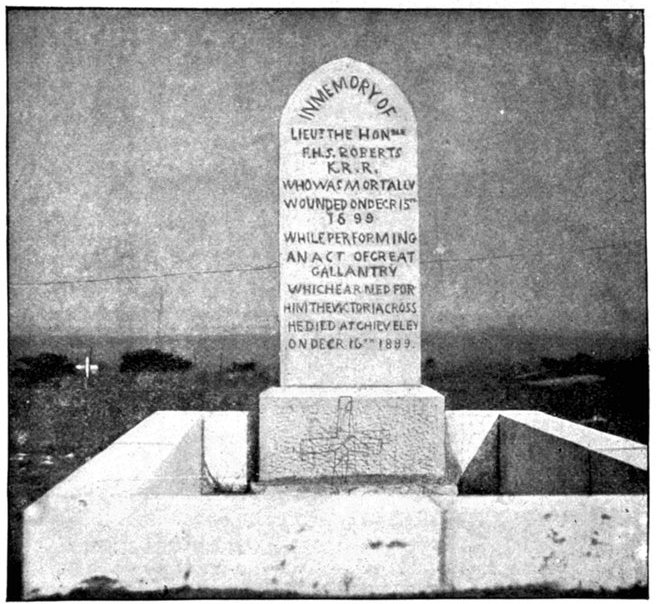
GRAVE OF LIEUTENANT ROBERTS, V.C., AT CHIEVELEY.
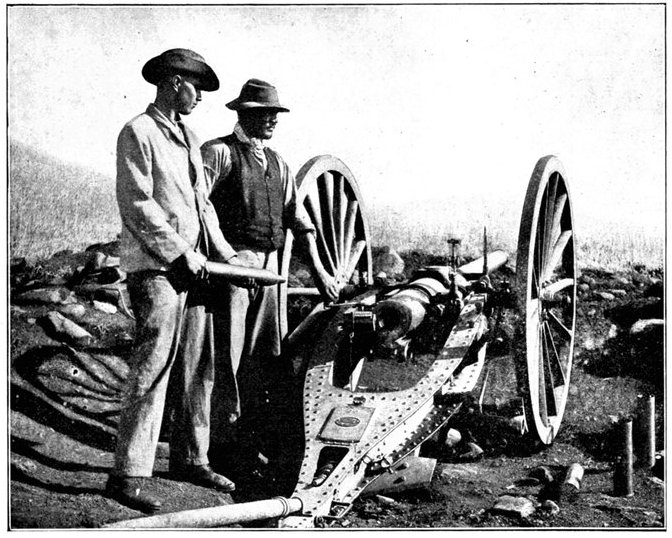
A BOER QUICK-FIRING GUN AND ITS CREW.
Destruction of Colenso road-bridge.
Picket surprised by Boers.
In the days after the battle the Boers displayed their wonted
inactivity. They made no attempt to annoy General Buller seriously, and
were content with sending small parties of skirmishers south of the
Tugela, who hung round the British camp at Chieveley, sniping water
parties, patrols, and outposts. On December 19 the naval guns opened
a heavy fire on Colenso road-bridge, which was still standing, with
the object of destroying it and cutting off the retreat of the Boers
who were south of the river. The existence of a Boer bridge north of
Hlangwane was not known at this date. After three hours of continuous
shelling a projectile struck and exploded a Boer mine, placed in the
structure of the bridge, and a whole span was destroyed. From day to
day the naval weapons fired a few shots at the Boer lines, whenever a
party of the enemy was seen, and thus caused the Boers some loss. But
these were the only incidents which broke the repose of the British
camp. The soldiers, indeed, chafed at the monotony and inaction; they
were eager to bring the war to a close and to return home; they feared,
too, for Ladysmith, and would have wished to be allowed perpetually to
harass the enemy. On the 20th a picket of seven men belonging to the
13th Hussars was surprised by the Boers, through the negligence of a
corporal. The enemy surrounded the handful of men and fired upon them,
killing two. The other five escaped. Next day, however, the British
cavalry had their revenge; nine Natal Carbineers lay in ambush near
the bodies of the slain Hussars, and, when a small party of Boers
approached to plunder the dead, fired on them, killing or wounding
four.
[Pg 237]
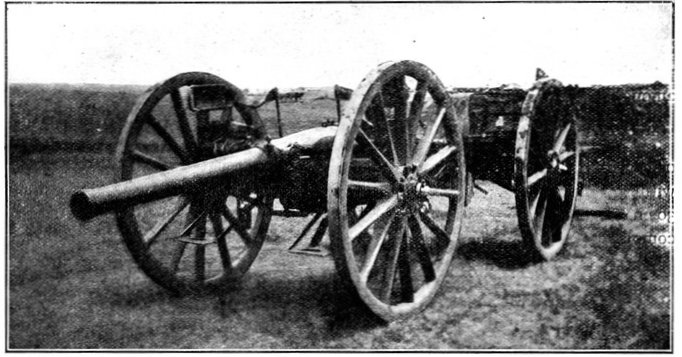
THE GUN OF THE 66
TH BATTERY WHICH WAS SAVED BY
CAPT. SCHOFIELD AND LIEUT. ROBERTS (see page
99).
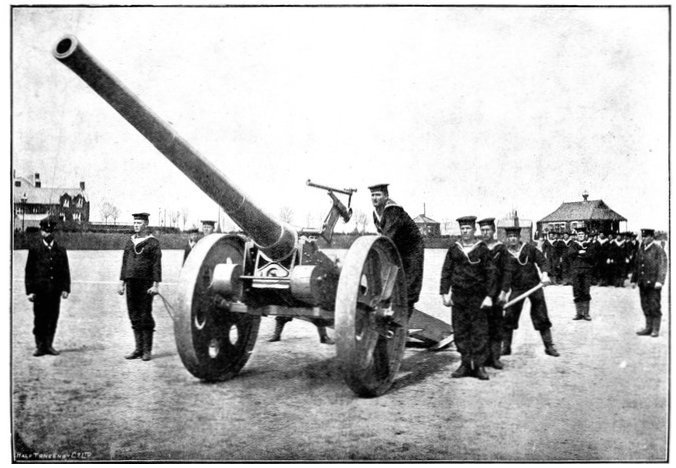
[Photo by Cribb.
SIGHTING THE 4·7 NAVAL GUN.
This photograph gives some idea of the great length of the weapon,
which accounts in no small measure for the accuracy of its fire.
Dec. 20-27, 1899.] Arrival of the Fifth Division.
Fifth Division reaches Natal.
[Dec. 1899.
Want of howitzers.
In the week which followed the battle reinforcements began to arrive.
Sir Charles Warren with the Fifth Division, 9,000 combatants strong,
had left England in November, and a part of his command had reached
South Africa even before the week of defeats. At first it had been
intended to use his division in the central field of war, for the
operations around Colesberg, and two battalions, the 2nd Royal Warwick
and 1st Yorkshires, with his cavalry regiment, the 14th Hussars, were
sent to that point. But when General Buller urgently needed more men,
he had to call for the rest of the division, which sailed round to
Durban and concentrated at Estcourt, six battalions and three batteries
strong. It was thus composed:—
| Tenth Brigade. |
Eleventh Brigade. |
| Major-General J. T. Coke. |
Major-General E. R. P. Woodgate. |
| 2nd Dorsetshire. |
2nd Royal Lancaster. |
| 2nd Middlesex. |
2nd Lancashire Fusiliers. |
|
1st South Lancashire. |
|
1st York and Lancaster. |
| 19th, 28th, and 78th Field Batteries. |
[Pg 238]
These reinforcements numbered about 7,000 combatants. In addition,
one extra field battery, the 73rd, and a single howitzer battery, the
61st, were sent to Natal, bringing up the total of batteries to ten,
of which, however, two, from the losses in guns, horses, and men at
Colenso, had virtually ceased to exist. Even at full strength ten
batteries, or sixty field guns, would have been a miserable proportion
for an army of 30,000 infantry and cavalry, and there were deep and
well-founded complaints among the correspondents—who, perhaps,
accurately reflected the feeling of the younger officers—as to the
paucity of howitzers, after the proved efficiency of these weapons
at Omdurman. "Here they are simply clamouring for guns, guns, guns,"
wrote an officer of the Fifth Division, "and guns we send them,
undrilled, unready, outclassed in range, and with raw horses and raw
reservists.... To cross the river and face the Boer position with only
30,000 and no heavy artillery to speak of must mean heavy loss, and we
feel very bitter." All these complaints were fully justified by events,
yet British Ministers were, at the very hour when this was written,
professing that the British artillery was all that could be desired and
more than ample in strength, and British "experts" were explaining at
home that the folly and wickedness of the Boers in arming themselves
with "guns of position" were the causes of all the evil. Unhappily,
it turned out that the enemy's "guns of position" could be moved and
handled just as readily as our short-range field pieces.
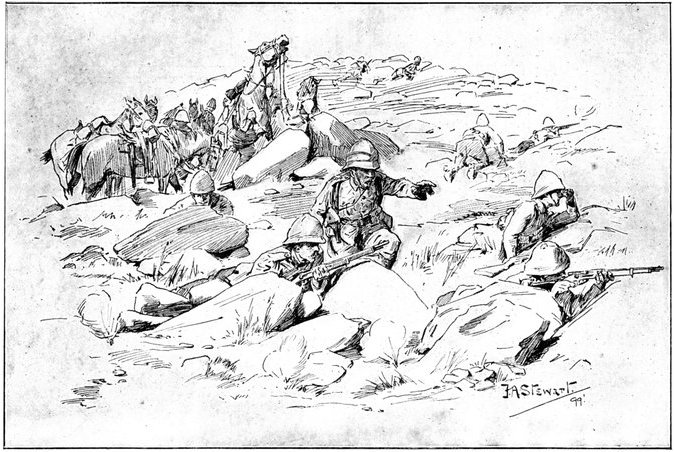
[Facsimile of a sketch on the spot by F. A. Stewart.
THE PICKET OF THE 13
TH HUSSARS IN DIFFICULTY (see page
236).
Arrival of a balloon and traction engines.
With the additional guns came a tardy balloon. Even here there had been
some miscalculation, as the balloon had been constructed for work at
the altitude of Aldershot, and not for the high plateaux and rarified
air of mountainous Natal. It was, in consequence, deficient in lifting
power, though even with this defect it was able to render valuable
service. Other adjuncts were a dozen powerful traction engines for
use with the transport. They performed splendidly, climbing mountain
sides and fording spruits with an agility not to be expected from
their ponderous nature. "They require few attendants, don't gibe, and
each can easily haul twelve tons," wrote Mr. Burleigh. The ox-waggon
of South Africa carried only a quarter of a ton, so that one traction
engine was equivalent to forty waggons.
[Pg 239]
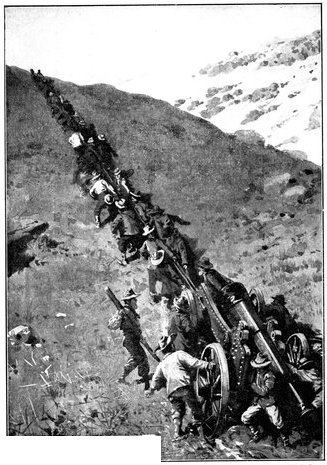
[Sketched by a correspondent with the Boers.
HOW THE BOERS GOT THEIR HEAVY GUNS INTO POSITION.
Dec. 25-30, 1899.] Christmas at the Front.
Christmas in camp.
In spite of the sad memories of Colenso, the army managed to spend a
cheerful Christmas. "Let us eat and drink, for to-morrow we die" is
the spirit of the soldier—not in any irreligious sense, but in the
sense that continued familiarity with death and the knowledge which all
have that their turn may come on the morrow, mercifully assuages the
bitterness of sorrow for the fallen. Were it not so a camp would indeed
be a melancholy place. The bluejackets turned out with effigies of John
Bull and Mr. Kruger, the latter somewhat battered—it was explained
from "the effects of lyddite"; the soldiers diverted themselves
with sports and pastimes; at night the camp fires resounded with
familiar choruses; and had any Boer looked in upon the scene he would,
doubtless, have wondered at the lightness of heart with which the
British Army made war. Yet over all brooded the shadow of the coming
battles and bloody conflicts which were at last to win the difficult
way to Ladysmith; and to the north could be heard from time to time the
thunder of the Boer guns bombarding the besieged town, and the thud of
the Boer shells.
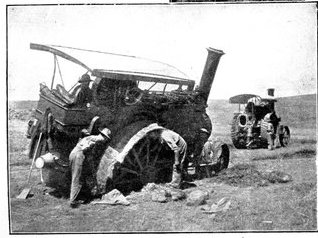
A TRACTION ENGINE STUCK IN THE MUD.
Disposition of relief force.
[Dec. 1899.
Boer positions.
The relief force was temporarily scattered at the close of the year
to facilitate supplying it with food and water. Two brigades were
left at Chieveley, two more[Pg 240] were placed at Frere, and at Estcourt
was Warren's Division. On December 30, fifty Boer waggons were seen
returning from foraging in the district between the Little and Big
Tugela, but nothing was done to intercept them. Meantime the cavalry
and mounted infantry executed frequent reconnaissances upon the Boer
flanks. A body of Thorneycroft's Mounted Infantry pushed out on the
left towards Springfield and Potgieter's Drift without encountering
the enemy. It was observed, however, that the Boers were constructing
trenches and works along the line of frowning heights which fringe the
northern bank of the Tugela, continuing westwards from Colenso until
the great dividing chain of the Drakensberg is reached. They were known
to have bridged the Tugela far above Potgieter's Drift, and even at
Springfield and on the line of the Little Tugela they were seen raising
fortifications from time to time. Already they anticipated a turning
movement by the west and were making ready, with their usual wise
prevision, to meet it in the most unpleasant manner.
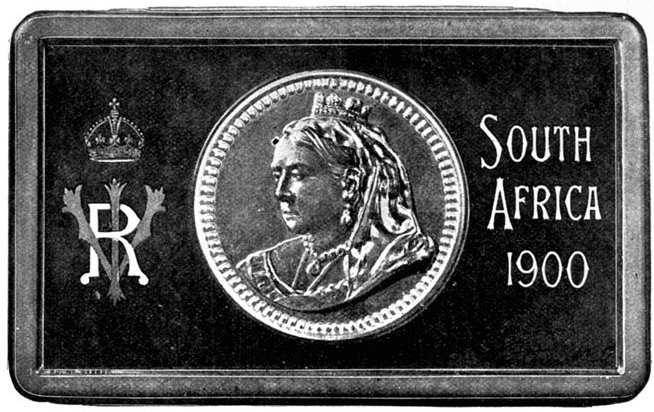
THE QUEEN'S CHOCOLATE BOX.
With her customary kindness and forethought, Her Majesty caused to be
despatched to the troops in South Africa, shortly before the close of
the old year, a very large number of elegantly-designed blue, red,
and gold tin boxes containing chocolate in cakes, at once the most
sustaining and appetising form of food. Every soldier at the front had
a box specially assigned to him; in nearly every case they were duly
delivered, and in all they were immensely appreciated. Often they were
sent home by the recipient untouched, that they might be treasured as
heirlooms.
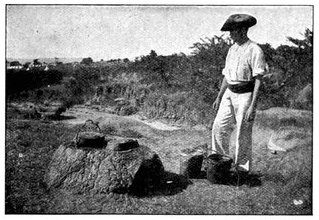
A REGIMENTAL COOK AT CHIEVELEY.
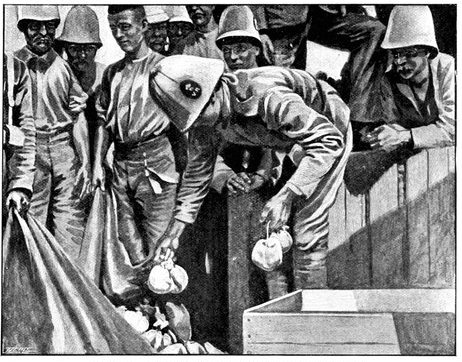
SERVING OUT CHRISTMAS PUDDINGS AT CHIEVELEY.
Messrs. Lyons thoughtfully provided 10,000 puddings for the troops,
most of which arrived in time for Christmas.
Mr. Winston Churchill escapes.
Dec. 11-12, 1899.] Mr. Winston Churchill's Daring
Escape.
It was about this time that Mr. Winston Churchill rejoined the army
in Natal, after effecting an escape from his Boer prison which reads
like a chapter in some wild romance. After the armoured train affair
he was sent to the State Model Schools in Pretoria, where the British
officers were confined. The place was built of brick, standing in a
gravelled playground, which was surrounded by a ten-foot-high iron
fence except on the east, where was a high wall. Inside the fence
were armed sentries, stationed at intervals of fifty yards. Attempts
to bribe the sentries to connive at Mr. Churchill's escape failed. At
night the yard was brilliantly lighted by electric lights,[Pg 241] placed
in its centre. These, however, blinded by their glare the sentries
who stood behind them and cut off the view of the eastern side of the
enclosure at a point where stood the offices of the school. If the two
nearest sentries under the eastern wall had their backs turned, escape
was possible for one or two determined men. December 11 was fixed by
Mr. Churchill and a friend of his, Captain Haldane, for the attempt.
But the sentries gave them no chance. On the evening of the 12th Mr.
Churchill alone made a second effort. For an hour he watched the
sentries through a chink in the offices; the moment at last came when
they turned their backs and began to talk. In an instant he laid hold
of the top of the wall, scaled it, and dropped over it into the garden
of a villa. There he threw himself down under some bushes and waited.
The villa was brilliantly lighted up and full of people; presently two
men came out of it and stood, it seemed, watching him. A cat and a dog
scurried past him, rustling the leaves and fixing attention on the very
place where he lay in ambush. Yet he was not seen. The two men turned
and went out of the garden, and he followed them boldly, with four
slabs of chocolate and £75 as his equipment.
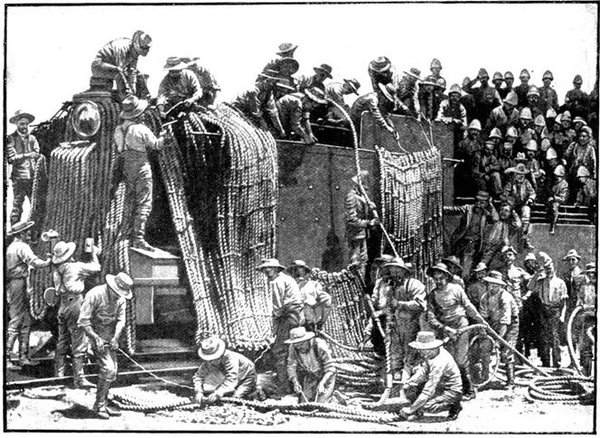
BLUEJACKETS PROTECTING AN ARMOURED TRAIN WITH ROPE
FENDERS.
This train ran on the line between Pietermaritzburg and Colenso.
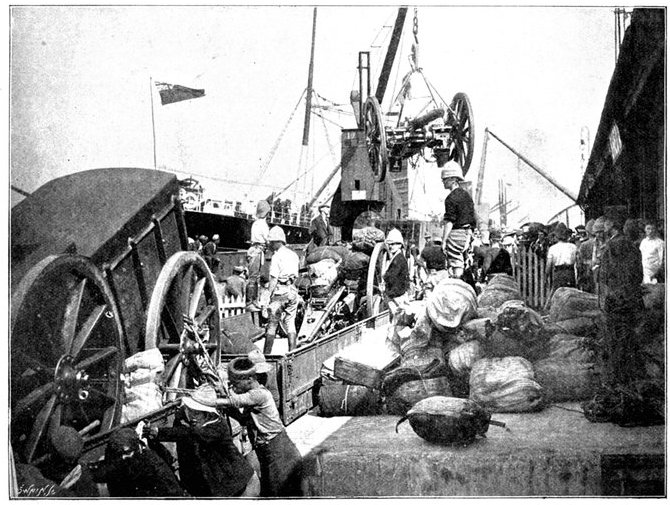
UNSHIPPING STORES AT DURBAN FOR GENERAL BULLER'S ARMY.
[Dec. 11-12, 1899.
Once in the streets of Pretoria he steered by the stars to where he
conjectured the Delagoa Bay railway to lie. He struck a railway—it
seemed to be the right one—and walked along it till[Pg 242] he passed a
station; then he stopped and hid, determined to board a passing train
in motion. Readers may guess the pluck and coolness required for such
an undertaking. A train came in sight at last; stopped at the station;
started and thundered past the fugitive. "I hurled myself at the
trucks," writes Mr. Churchill, "clutched at something, missed, clutched
again, missed again, grasped some sort of handhold, was swung off my
feet—my toes bumping on the line—and with a struggle seated myself on
the couplings of the fifth truck." The truck was laden with empty coal
sacks, and under these Mr. Churchill buried himself and slept.
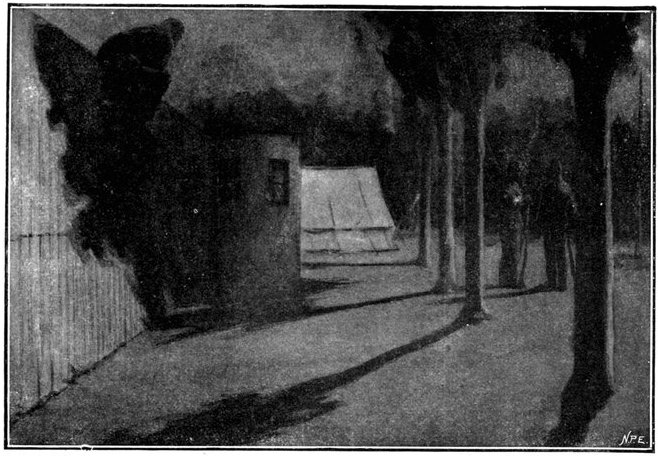
J. Nash, R.I.] [From a sketch by Winston Churchill.
MR. WINSTON CHURCHILL SCALING THE WALL OF THE PRISON AT PRETORIA.
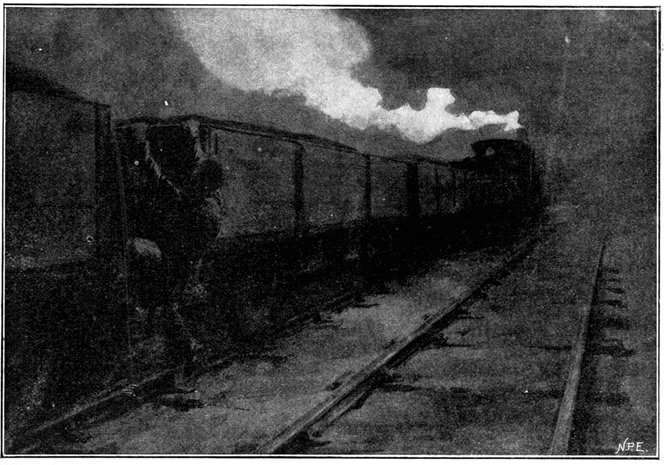
J. Nash, R.I.] [From a sketch by Winston Churchill.
MR. CHURCHILL BOARDING A GOODS TRAIN.
Dec. 12, 1899-Jan. 6, 1900.] Mr.
Churchill Rejoins Buller.
When he woke it was still night. Fearing discovery by day, he leapt
from the train with no more hurt than a severe shaking, and as dawn
came hid in some broken ground amidst trees. He drank at a pool of
water and ate one of his cakes of chocolate. And then, thinking over
his situation—to quote his own strangely moving words—"I realised
with awful force that no exercise of my own feeble wit and strength
could save me from my enemies, and that without the assistance of
that High Power which interferes more often than we are always prone
to admit in the eternal sequence of causes and effects I could never
succeed. I prayed long and earnestly for help and guidance. My prayer,
as it seems to me, was swiftly and wonderfully answered. I cannot now
relate the strange circumstances which followed, and which changed my
nearly hopeless position into one of superior advantage. But after the
war is over I shall hope to somewhat lengthen this account, and so
remarkable will the addition be that I cannot believe the reader will
complain." "More things are wrought by prayer Than this world dreams
of," echoes the poet. And fresh from contact with the Boers, who yet[Pg 243]
believed in God, the fugitive sought and found that help without which
the best efforts of man cannot prosper.
That night Mr. Churchill once more set out along the railway, walking
and hoping to board a train. But no train came, and progress was slow
and difficult. Five more days and nights he spent in this fashion;
on the sixth his chance came. He found in a siding a train labelled
Lourenço Marques; boarded it and wormed his way to the bottom of a
truck laden with sacks of wool or some other soft material, and lay
there perdu for two-and-a-half days, till at last Delagoa Bay was
reached. Once the truck was searched, yet he was not discovered. At
Delagoa he took a steamer for Natal, sending on the way an earnest
appeal to the British nation to persist in the war and despatch to
South Africa a quarter of a million men. Thus providentially set free
by the Hand which carries through dangers and trials the men who have
a great work to do in the world, he rejoined General Buller's army in
time to share the hopes and sorrows of the famous flank march.
Boer attack on Cæsar's Camp.
The early days of January passed and the signs of an immediate advance
accumulated. In all the camps action was in the air; the last touches
were being put to the transport; an embargo was laid upon all news
which might instruct England or the enemy of what was in preparation.
These indications could not have escaped the watchful eye of the Boer
Government, and early, very early, in the morning of January 6 the
Boers struck their blow. At 2 a.m. the British camp at Chieveley was
awakened by the distant tumult of a heavy artillery fire away towards
Ladysmith. The thunder of the guns was continuous and ominous. All the
morning it lasted, while the British soldiers listened, and chafed, and
wondered, and, as the truth dawned upon them, prayed that Ladysmith
might that day uphold the honour and greatness of England.
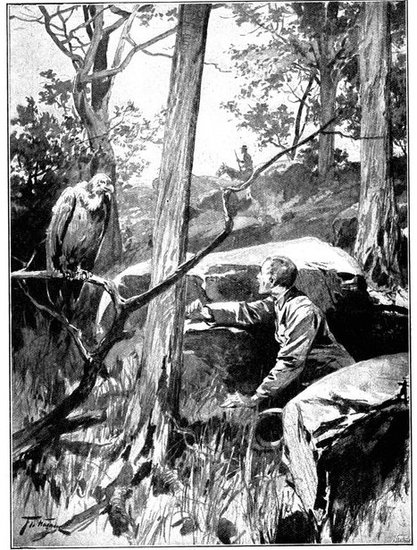
F. de Haenen.] [
From a sketch by Winston Churchill.
WAITING FOR NIGHT.
After dropping from the goods train, Mr. Churchill hid for fourteen
hours in a wood, consumed with thirst, and watched, as he relates in
his letter to the Morning Post, by a vulture, "who manifested an
extravagant interest in my condition, and made hideous and ominous
gurglings from time to time."
[Pg 244]
[Jan. 6, 1900.
The morning passed in anxiety and the growl of the guns ceased. The day
was black and stormy, but at times the sun broke through the clouds and
the heliographs flashed fitfully. From Ladysmith came these messages of
alarm:—
Messages from Ladysmith.
"9 a.m. Enemy attacked Cæsar's Camp at 2·45 this morning in
considerable force. Enemy everywhere repulsed, but fighting still
continues."
"11 a.m. Attack continues, and enemy has been reinforced from south."
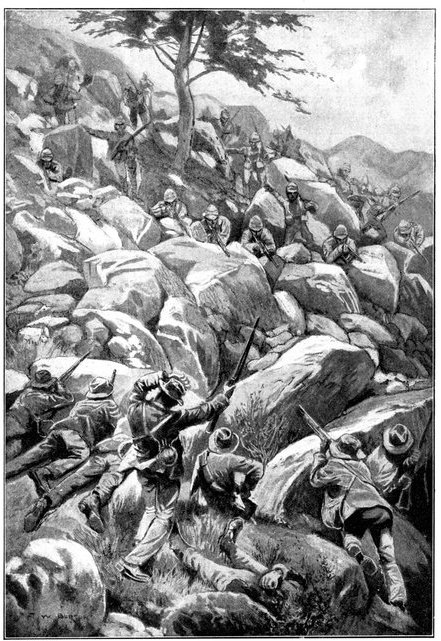
F. W. Burton.]
THE BOER ATTACK ON CÆSAR'S CAMP.
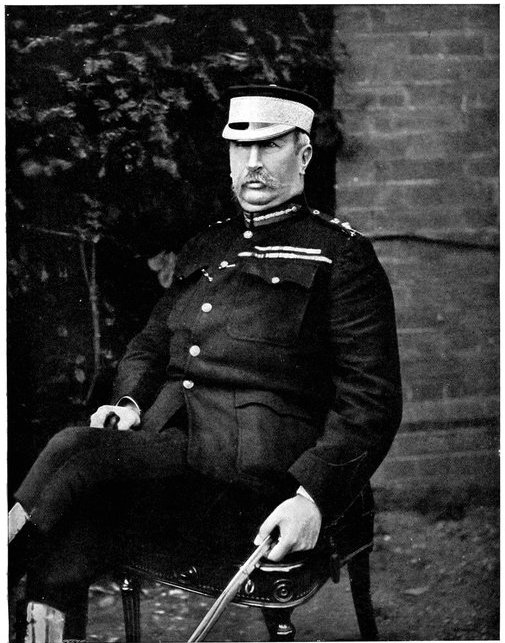
[Photo by C. Knight, Aldershot.
GENERAL SIR REDVERS BULLER, V.C.
Commander-in-Chief of the forces in South Africa up to the date of Lord
Roberts's arrival. A brief account of General Buller's military career
is given on page 77.

THE NAVAL 4·7 GUNS SHELLING THE COLENSO LINES.
[Jan. 6, 1900.
Relief force attacks Colenso.
Advances on Springfield and Hussar Hill.
Failure to draw the Boers.
No sooner was the danger realised—the fact understood that a British
garrison was fighting for its very life almost within sight of a
British army of 30,000 men—than it was felt that this army could
not stand by inert and un-helping. But the scattering of the British
relief force precluded all serious attack; it was impossible in the
time available to bring up the men from Frere and Estcourt; the most
that could be attempted was to send in the two brigades at Chieveley
to make a show of assault upon the Colenso lines, and so prevent
the Boers from weakening their strength at this point. Even so the
demonstration was tardily made. It was soon after 2 a.m. that the Boer
artillery began its fierce bombardment of Ladysmith; it was not till 2
p.m. that General Hildyard's and General Barton's Brigades, with three
batteries of artillery, marched out of camp and swept down the open,
undulating plain which intervened between Chieveley and Colenso. Now,
too, the naval guns opened a heavy fire upon the Colenso works. The
Boers could be seen riding back in small parties from the direction
of Ladysmith towards Colenso, so that the spell was working. On the
flanks the 13th Hussars moved out to Springfield and Thorneycroft's men
deployed in the direction of Hlangwane, advancing to [Pg 245]
[Pg 246]Hussar Hill.
The infantry opened out in scattered order, and pushed forward towards
the battleground of December 15. The field batteries opened fire and
there was a dress rehearsal of a battle—continuous long-range firing
on the part of the British, to which the enemy only replied with the
shots of a few marksmen from near the village of Colenso. The vast
entrenchments, stretching mile after mile, were silent; the enemy's
artillery obstinately refused to disclose itself. Just at this point
another message, terrifying in its suggestiveness, came through from
Ladysmith:—
Further message from Ladysmith.
"12·45 p.m. Have beaten enemy off at present, but they are still round
me in great numbers, especially to south, and I think renewed attack
very probable."
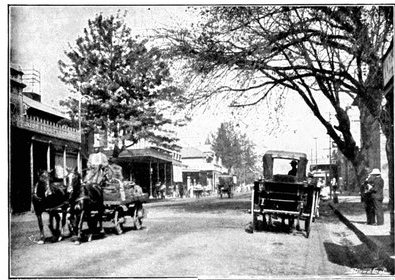
CHURCH STREET, PIETERMARITZBERG.
After this came silence. Black clouds covered the sky; the sun failed;
and the British headquarters and army were left in heartbreaking
suspense.
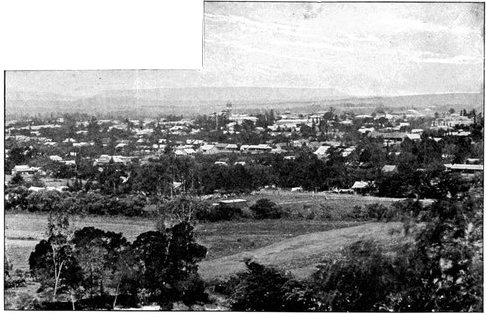
BIRD'S-EYE VIEW OF PIETERMARITZBURG, LOOKING EAST.
Pietermaritzburg, called after two Boer leaders, Pieter Retief and Gert
Maritz, is the seat of Government in Natal, and since the beginning of
the war has served as the official military base for the operations in
that colony. The town has normally a population of about 20,000, of
whom half are whites. It is beautifully situated amid sloping hills
and fertile pastures, and is 70 miles distant from Durban. It is a
metropolis in miniature, and the churches, hotels, banks, clubs, town
hall, legislative council buildings, museum, and library are worthy of
the capital of the "Garden Colony."
Jan. 6, 1900.] Ladysmith in Peril.
Storm ends a desultory movement.
The attack on Colenso was not pressed. Ladysmith was fighting for its
life; thousands of British soldiers were burning to give Sir George
White the best aid that could be given, by a vigorous assault upon
Colenso, which by all appearances was not strongly held, and from which
we now know that[Pg 247] the Boers had withdrawn 7,000 men, and yet there was
nothing more than a long-range interchange of fire. General Clery in
command—for General Buller was seemingly not present—rode out well
in advance of his men, but even this daring and calculated exposure
of himself and his staff did not draw the Boers. It was a melancholy
day, unsatisfactory in every sense, and, had the enemy's assault on
Ladysmith succeeded, would have provoked bitter outcry at home, where
the difficulties which faced the relief column were, perhaps, not fully
appreciated. As the afternoon closed upon the desultory and ineffective
demonstration, the storm broke over the country with appalling
violence. Thunder and lightning, hail and rain, raged over the frowning
heights before the British soldiery, and intense darkness put a stop to
the one-sided engagement. Dripping and depressed, the men marched back
to camp, uncertain as to the fate of Ladysmith.
Rain and gloom continued all next day, broken only by a flash of
sunlight, which brought yet more disquieting news. The fresh message
from Sir George White was this:—
"January 6, 3·15 p.m. Attack renewed. Very hard pressed."
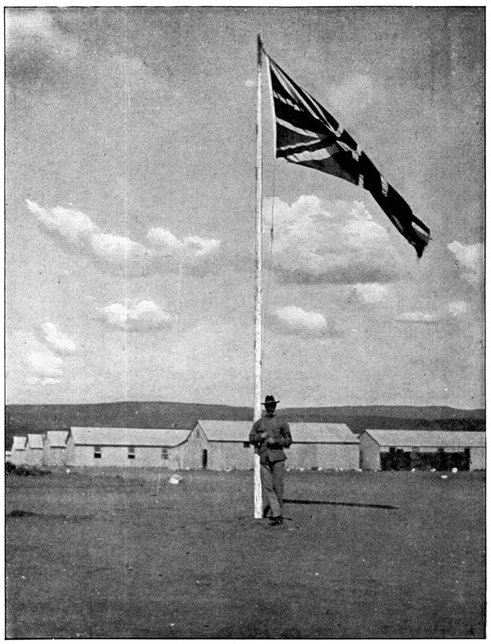
THE UNION JACK AT LADYSMITH:
The flag which was never hauled down throughout the siege.
The flag still flying in Ladysmith.
The Boer guns could not be heard, so that, for all men knew, the
garrison had fallen. Yet one of those strange rumours, which in the
old-world days told the Greeks, as they joined battle at Mycale, that
their countrymen, hundreds of miles away, had on the same day beaten
back the barbarian, ran swiftly through the camp. How or whence it
comes, this sudden and unaccountable second-sight, no man can tell, and
psychologists can but conjecture. For the story told with substantial
truth that at 5 p.m. of the previous day, at which precise hour General
Ian Hamilton and the Devons had sent the foe reeling down from Wagon
Hill, the Boers had been repulsed and 400 of the enemy taken prisoners.
Not till the following day was definite news forthcoming. Then it was
known that with terrible loss the heroic garrison had driven back the
Boers and kept the British flag flying over Ladysmith. Ian Hamilton,
the wounded of Majuba, had been the hero of the defence.
Satisfaction reigned in the camps, though there were some who asked,
when the losses were known, how it would be if the Boers repeated their
assault. But now the signs of immediate movement filled the air and
fixed all attention. The relief army was preparing to strike its second
blow.
[Pg 248]
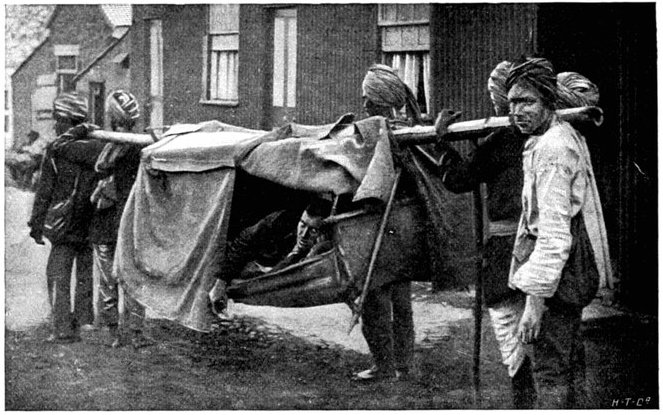
INDIANS CARRYING A WOUNDED OFFICER IN A DOOLIE.
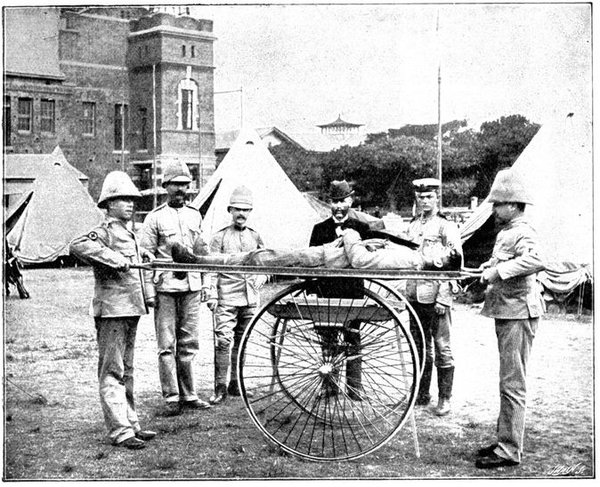
FOR THE GREATER COMFORT OF THE WOUNDED.
The McCormack-Brook wheeled stretcher-carriage is largely used in South
Africa.
[Jan. 6-9, 1900.
Heroes in rags.
Mud everywhere.
Jan. 9, 1900.] Composition of the Second and Fifth
Divisions.
On the 6th the base hospitals at Pietermaritzburg had been cleared of
the wounded; on the 8th the Frere hospitals were likewise emptied,
and that evening 700 civilian stretcher-bearers, or "body-snatchers"
as they were called by the troops, arrived at the front. They were a
nondescript lot of men, ill-clad, poorly-shod, but, as their deeds upon
the battlefield showed time and time again, surpassingly brave. For
them there were no laurels, no honours, no mentions in despatches, not
even the gaudium certaminis which so often paralyses the sense of
fear. Yet they did their duty and something more; with placid devotion
they followed the fighting line, and many of them laid down their
lives in noble efforts to succour the wounded and dying. All honour,
then, to this ragged corps! In the last few days torrents of rain and
continual thunderstorms had made of the veldt a morass, of the roads
bottomless sloughs of despond, and of the spruits and watercourses,
which furrowed the country side, roaring torrents; but the plight of
Ladysmith admitted of no excuses or delays. On January 9, at last, the
advance began. From Estcourt, Sir Charles Warren's Division pushed
forward to Frere, after a terrible march through the mud, and slush,
and tropical rain. "The hills," writes Mr. Atkins, the Manchester
Guardian's correspondent, "seemed to melt down like tallow under heat;
the rain beat the earth into liquid, and the thick, earthy liquid ran
down in terraced cascades.... From Estcourt to Frere the division
waded, sliding, sucking, pumping, gurgling through the mud: the horses
floundered or tobogganed with all four feet together; the waggons
lurched axle-deep into heavy sloughs and had to be dragged out with
trebled teams of oxen." "Crossing the swollen spruits was fearful,"
writes an officer. "At one place my horse fell and I went into the
water head over heels and had to swim. The whole veldt was one sea of
deep, slushy mud." At one point a strange river appeared—a roaring
torrent[Pg 249] of a few hours' growth—and checked the column. An engineer
officer sounded and reported ten feet. The pontoons were called for,
when a bold colonial rode up, looked at the stream, spurred his horse
in, and quietly sped across. As the rest of the column followed him,
there were many jests at the expense of the engineer officer. The men
had a miserable bivouac that night at Frere, where most of the wet
soldiers had to lie out in the mud. Yet the men bore the discomfort
cheerfully, with the spirit of Mark Tapley, and made the best of a bad
job.
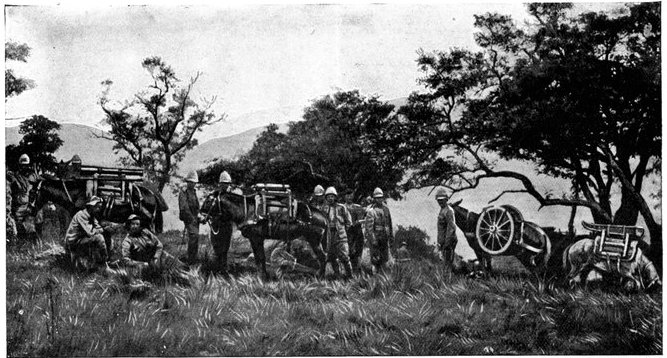
[Photo by Middlebrook.
HOW THE MOUNTAIN BATTERY IS CARRIED.
The photograph shows the form of saddle which is used for transporting
the portions of a mountain battery. One mule is laden with the "chase"
of the gun itself, another with the breech, and two more with the
wheels and the trail.
Composition of the force.
The army was now reorganised for the work before it. The following was
its new composition:—Under Sir Charles Warren for the flank movement
were the Second and Fifth Divisions; General Buller kept only the corps
troops under his immediate orders.
| SECOND DIVISION. |
FIFTH DIVISION. |
| LIEUT.-GENERAL SIR F. CLERY. |
LIEUT.-GENERAL SIR C. WARREN. |
| Second Brigade. |
Fifth Brigade. |
Fourth Brigade. |
Eleventh Brigade. |
| Major-General Hildyard. |
Major-General Hart. |
Major-General Lyttelton. |
Major-General Woodgate. |
| 2nd East Surrey. |
1st Connaught Rangers. |
1st Rifle Brigade. |
2nd Royal Lancaster. |
| 2nd West Yorkshire. |
1st and 2nd Royal Dublin Fusiliers. |
1st Durham Light Infantry. |
2nd Lancashire Fusiliers. |
| 2nd Devonshire. |
1st Royal Inniskilling Fusiliers. |
3rd King's Royal Rifles. |
1st South Lancashire. |
| 2nd West Surrey. |
1st Border Regiment. |
2nd Scottish Rifles. |
1st York and Lancaster. |
| 7th, 64th, and 73rd Field Batteries. |
19th, 28th, and 63rd Field Batteries. |
| CORPS TROOPS. |
| GENERAL (COMMANDING-IN-CHIEF) SIR R. BULLER. |
| Tenth Brigade. |
Cavalry Division. |
| Major-General Coke. |
Major-General Lord Dundonald. |
| 2nd Dorset. |
13th Hussars. |
| 2nd Middlesex. |
1st Royal Dragoons. |
| 2nd Somerset. |
South African Light Horse. |
|
Thorneycroft's Mounted Infantry. |
|
Bethune's Mounted Infantry. |
|
Natal Carbineers. |
| Imperial Light Infantry. |
Mounted Infantry King's Royal Rifles. |
|
Imperial Light Horse. |
| 78th Field Battery, 61st Howitzer Battery, 4th Mountain Battery. |
Naval guns (two 4·7 in., eight 12-pounders). |
[Pg 250]
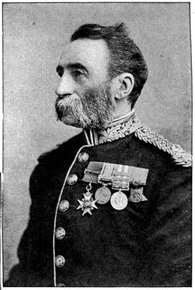
[Photo by Bassano.
MAJOR-GENERAL SIR C. F. CLERY, K.C.B.
In command of the Second Division in Natal since October
1899, with local rank of Lieut.-General. He entered the Army
in 1858; was Professor of Tactics at Sandhurst from 1872-5;
Deputy-Assistant-Adjutant-General in Ireland (1875-7), and at Aldershot
(1877-8); was Chief Staff Officer of the Flying Column in the Zulu
War, 1878-9; Brigade-Major at Alexandria in the Egyptian War of
1882; Assistant-Adjutant-General in the Sudan Expedition in 1884;
Deputy-Adjutant and Quartermaster-General in the Nile Expedition of
1884-5; Chief of Staff in Egypt 1886-8, and Commandant of the Staff
College 1888-93. He commanded the 3rd Infantry Brigade at Aldershot
1895-6, and was Deputy-Adjutant-General to the Forces from that date
until he left for Africa.
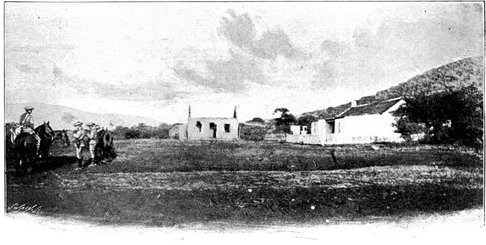
THE PRICE OF LOYALTY IN NORTHERN NATAL:
A farmhouse laid in ruins by the Boers.
[Jan. 9-10, 1900.
General Barton with the Sixth Brigade was directed to entrench himself
at Chieveley, and was given as his artillery the other six naval
12-pounders, two dummy 4·7's which the ingenuity of the bluejackets
had constructed, and the remnants of the field batteries destroyed
at Colenso. To guard Frere camp, the Composite Rifle Battalion, made
up of drafts for the regiments in Ladysmith, was detailed. The total
force available for offensive action was, when all deductions had been
made, 15,000 infantry, 2,500 cavalry and mounted men, and fifty-eight
guns, excluding the Mountain Battery, which was of no use in the field,
and was never employed because of its want of range and power. The
general theory in the British camp was that the advance would be made
by the right flank in the direction of Hlangwane and Weenen, which many
thought was the easiest line of approach to Ladysmith. Circumstantial
reports had already reached Durban to the effect that a part at least
of Sir Charles Warren's Division was marching along the Weenen road.
But these conjectures were falsified by events; it was by the left
flank that General Buller had determined to make his next throw.
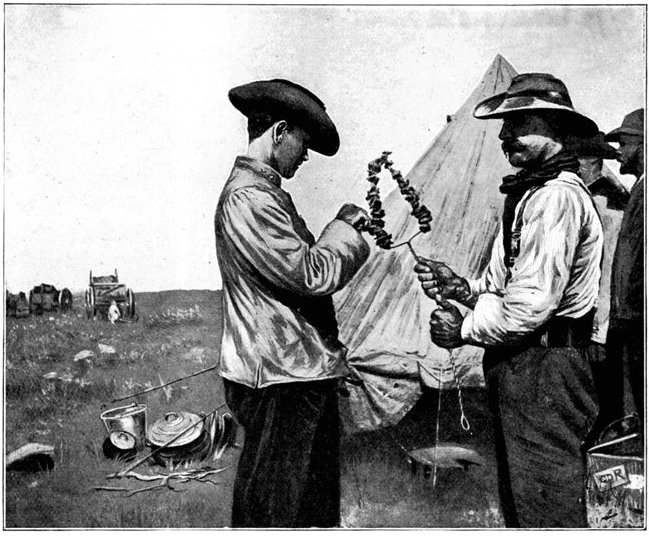
GRILLED STEAK À-LA-BOER.
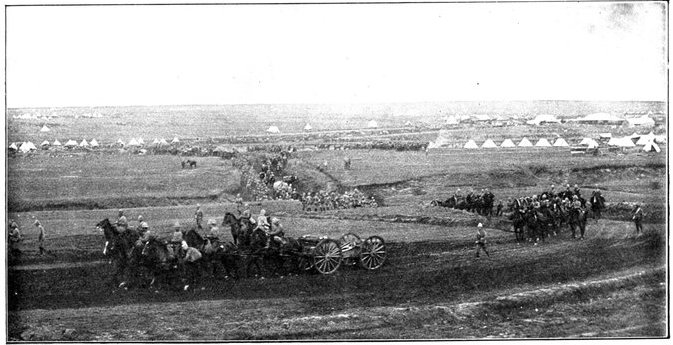
GENERAL WARREN'S BRIGADE MARCHING OUT FROM FRERE.
The depressions seen in the middle distance are called by the Boers
"dongas."
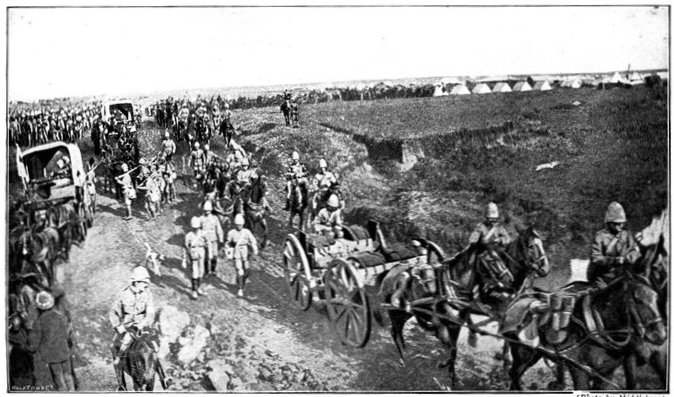
[Photo by Middlebrook.
AN ARMY ON THE MARCH: GUNS AND AMBULANCE CARTS CROSSING A DONGA.
Jan. 10, 1900.] Forward Movement.
The army moves.
[Jan. 10, 1900.
The 10th, after the deluge of the 9th, was sunny and intensely hot.
The earlier hours of the day the men spent in drying their dripping
belongings, while the hundreds of transport waggons were packed with
twenty days' stores and provisions for the whole force. As the[Pg 251]
afternoon drew on and the heat of the sun abated, the march to the west
began. Battalion followed battalion, brigade followed brigade, and last
of all came interminable strings of ox-waggons, carts, ambulances,
cannon, and all the vast paraphernalia of an army in motion. The men
turned their backs upon Colenso and the scene of the defeat of December
15; they strode blithely along towards the Upper Tugela—into a land
new to most, a land of promise and hope. Nor could they know that they
were facing disaster upon disaster, defeat piled upon defeat, or that
after a month of march, and battle, and toil they were doomed to return
empty-handed[Pg 252] and rebuffed. No such thoughts troubled the hearts of the
men; for them it was enough that the hour of action had come, and that
vengeance was at last to be taken for Colenso and the dismal past.
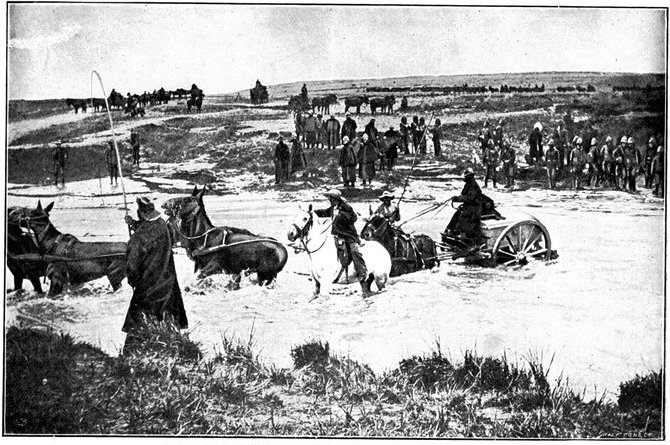
AMMUNITION CARTS AT A DRIFT: MULES OBJECTING TO CROSS.
Hampered by baggage.
The march of the column was vexatiously slow. The exceeding badness of
the tracks—for to call them roads is impossible—the quantity of water
in the spruits and rivulets, and the enormous amount of baggage caused
continual halts in the centre and rear of the column. A hundred years
ago Napoleon wrote that no army carries with it so much baggage as the
British, and his criticism was justified. In the interval we have not
improved. Says Mr. Churchill: "The vast amount of baggage this army
takes with it on the march hampers its movements and utterly precludes
all possibility of surprising the enemy. I have never before seen even
officers accommodated with tents on service, though both the Indian
frontier and the Sudan lie under a hotter than the South African sun.
But here to-day, within striking distance of a mobile enemy whom we
wished to circumvent, every private soldier has canvas shelter, and the
other arrangements are on an equally elaborate scale. The consequence
is that the roads are crowded, drifts are blocked, marching troops are
delayed, and all rapidity of movement is out of the question. Meanwhile
the enemy completes the fortification of his positions and the cost of
capturing them rises. It is poor economy to let a soldier live well
for three days at the price of killing him on the fourth." The Boer
somehow managed to do without these elaborate arrangements. He found it
possible to subsist without being constantly accompanied by a supply
train; he carried a sufficiency of food with him, and slept in the
open, or in some rough improvised shelter behind a heap of stones. With
his strip of dried beef, bag of biscuits, 200 rounds of ammunition, and
his rifle, he could cover in one day the distance which the British
Army could only accomplish in three. And as Napoleon has said that the
strength of an army should be gauged by its numbers, multiplied by the
number of miles it can move in a given time, it followed that four or
five thousand Boers were a match for General Buller's whole army.
[Pg 253]
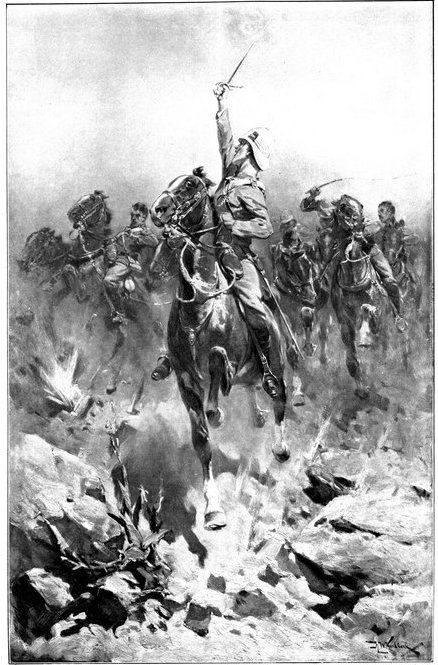
Painted by H. W. Koekkoek.]
HORSE ARTILLERY IN A TIGHT PLACE.
[Pg 254]
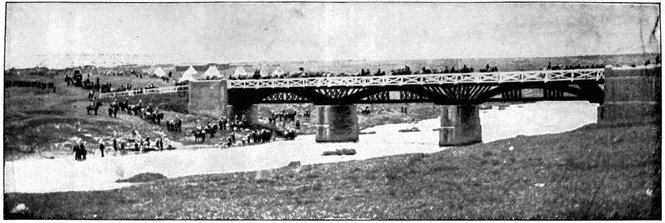
SPRINGFIELD BRIDGE: THE PIVOT OF THE FLANKING MOVEMENT.
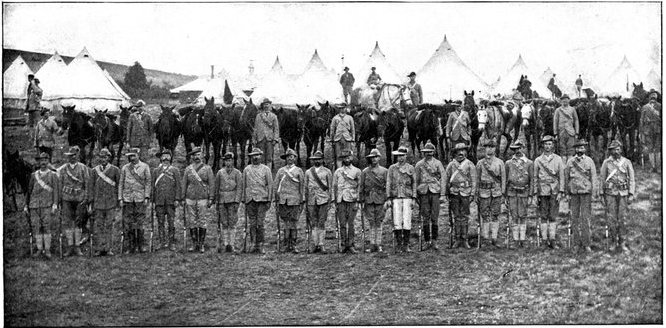
MURRAY'S MOUNTED SCOUTS:
Natal farmers who volunteered when the Boers invaded that colony.
[Jan. 10, 1900.
Difficulties of the march.
Jan. 10-11, 1900.] Springfield Bridge Seized.
On this occasion the average of the infantry was scarcely a mile
an hour. At the start Sir Charles Warren's men had to ford the
Blaauwkrantz in flood, and the drifts were choked with waggons,
carts, and refractory teams of oxen and mules. "The passages through
the spruits were nightmares," says Mr. Atkins, "carts overturned in
the water, wheels off, mules mixed up, fighting and knotted in their
harness and half drowning, oxen with their heads borne down under
water and heaving with all their mighty strength to the opposite bank,
a gun or a waggon stuck, and the river of traffic looping round it
as water flows round an island; spare teams of oxen moving about to
help the unfortunate out of difficulties, a traction engine with one
wheel almost buried in soft mud and two other engines pulling at it."
One ox-waggon which stuck close to Frere station could not be moved
by eighty oxen, and must have been abandoned but for the traction
engines, one of which was harnessed to it with a steel hawser and
hauled it triumphantly out of difficulty. The march, in consequence
of these incidents, which, at first diverting enough, rapidly palled
upon the men, was weary to a degree. Great caution had to be observed,
for though the Tugela was in heavy flood and the Boer bridges broken,
no one could be certain that the enemy had not some force south of
the river carefully watching the British flanks and ready to cut off
stragglers and vehicles in difficulty. The first halt for the infantry
of the Second Division was to be made at Pretorius' Farm, six miles on
the Frere side of Springfield and[Pg 255] ten miles from Frere, and for the
Fifth Division at Springfield itself; but that point was not reached
by many of the men till long after midnight. At midnight the weather
had broken once more and a terrific thunderstorm swept over the hills,
drenching the tired men and inflicting upon them the misery of a sodden
bivouac after their hard day's march. They slept as best they could,
wrapped in their great-coats and blankets, in the mud and slush.
Hildyard's Brigade, with the two great 4·7's dismounted from their
carriages and placed upon carts, had already struck into the column,
half way to Pretorius' Farm, coming from Chieveley, so now the turning
force was complete.
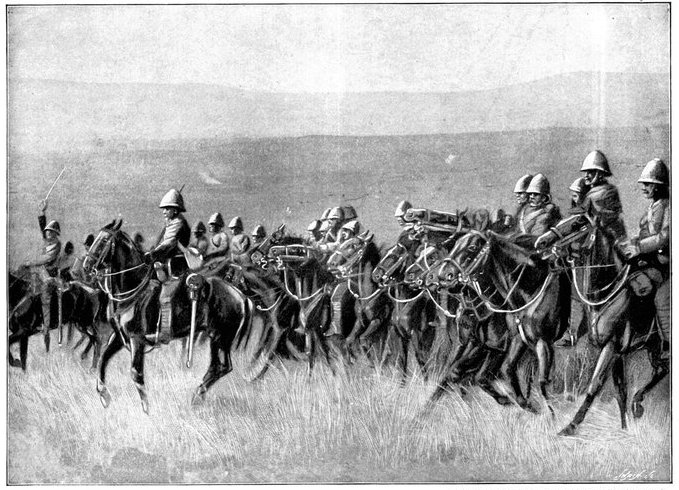
[From an instantaneous photograph by the Biograph Co.
LORD DUNDONALD'S CAVALRY ON THE WAY TO POTGIETER'S DRIFT.
[Jan. 11, 1900.
All the 10th and 11th the troops were on the march, streaming westwards
in an unending column. On the 11th the cavalry under Lord Dundonald
pushed forward, in advance of the army, to seize Springfield bridge—a
long, wooden structure which spans the Little Tugela, and which,
according to spies' accounts, had been left standing by the Boers. The
country through which the troopers rode was pleasant upland, recalling
to many the Yorkshire moors or the fells of Cumberland, only that far
away, to north and west, rose in a fantastic wonderland of rugged
heights the summits of the Drakensberg. Valleys with verdant herbage
ran up into the mountains and were lost in the browns and purples of
the savage rocks. It was a scene of beauty in the soft glow of the
afternoon sun, with the white mists of night already rising from the
valley bottoms—a delectable country, but void and untenanted by man.
The sparse farms were empty; the war had driven away their owners—some
to the British Army to avoid being commandeered and insulted by the
invader, others to the Boer forces in guilty alarm at the approach
of the "rooineks." And, strangest of all, there was no trace of the
enemy. His scouts and pickets were nowhere seen; as the troopers moved
cautiously and inquiringly over the broken terrain, no volleys flashed
out from the folds of the spruits.[Pg 256]
Would it be so when Springfield bridge was reached, or must a battle be
fought before the British could win possession of the Little Tugela?
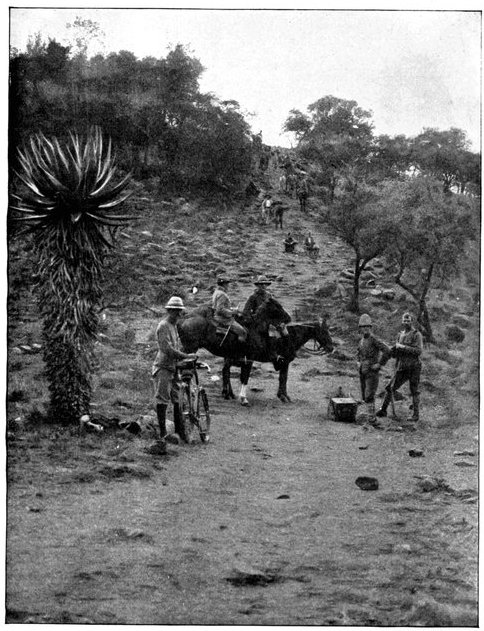
[Photo by Middlebrook.
THE FIRST STEEP BIT ON ZWART KOP.
Up which guns and ammunition had to be dragged by hand labour. Zwart
Kop looks down on Potgieter's Drift from the east, as Spearman's Hill
does from the south-west.
Dundonald seizes Potgieter's Drift.
At length the bridge came into sight. It was uninjured, and there
was still no enemy. More than this, word came from the patrols in
advance—Murray's Natal Mounted Scouts—that they had scoured the
country beyond, up to Potgieter's Ford and the Big Tugela, and found it
also empty. The bridge was crossed, and now it entered Lord Dundonald's
head, in spite of his orders, which required him only to "seize
Springfield Bridge," to push on yet further, and endeavour to secure
Potgieter's. The danger was that this ostentatious abandonment of the
district by the Boers might mean some devilish trick—some ambush of
the kind to which our army had now grown accustomed in South Africa. In
that event no support would be at hand, for the infantry and artillery
of the Fifth Division would be nine miles behind at Springfield. Yet,
weighing the chances, Lord Dundonald dashingly determined to take
the risk. He detached 300 men with two guns to hold the bridge; with
the South African Light Horse—a splendid body of men—a company of
mounted infantry, and four guns of the 78th Field Battery, he struck
out resolutely for Potgieter's Drift, and the great hill known as
Spearman's Hill, which commands it. At 6 p.m. the goal was reached.
There was still no enemy; only half-a-dozen Boers could be seen, and
these, wonderful to relate, were washing themselves in the river, and
scuttled off like terrified insects when the cavalry came into view.
The 700 British troopers started to climb the hill, dragging with
them the guns, with inconceivable toil, and as night fell reached
the summit. It was found to be fortified with trenches, laboriously
excavated, and stone walls or schantzes, raised by the enemy—evidence
at once of Boer activity and insight. Messages were forthwith sent
back to Pretorius' Farm to apprise General Buller of the success
achieved and to ask of him immediate support. For if the Boers should
attack—and even with the Tugela in flood they might know of drifts
or have bridges ready—Spearman's Hill could scarcely be held by this
handful of men. The night was an anxious one, but it passed without
incident. With day the real danger vanished, and all eyes could drink
in the wonderful panorama that lay below.
[Pg 257]

TRANSVAAL COINS.
The illustration shows the reverse side of some of the Transvaal coins.
The head of President Kruger (as below) appears on the obverse of each.
An artificial value attaches to some of them on account of the very
limited number issued.
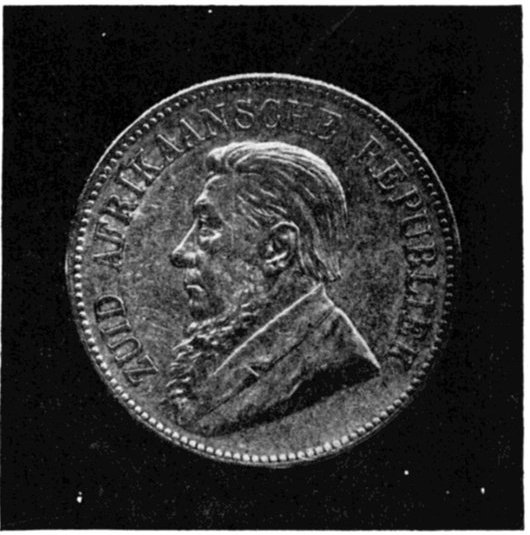
OBVERSE OF A TRANSVAAL CROWN-PIECE.
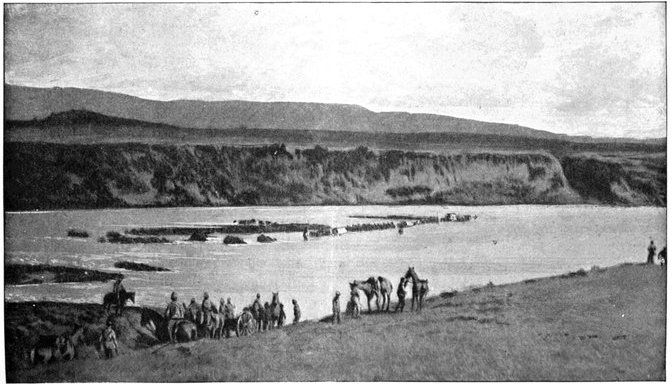
POTGIETER'S DRIFT: BRITISH FORCES CROSSING.
Jan. 11, 1900] A Frontal Assault Inevitable.
The hill pitched precipitously down, with an occasional shelf or
terrace, 700 feet into the Tugela below. The river ran, a brown streak
of muddy water, flecked with foam, betwixt high rocky banks, through
a valley of enchanting beauty. It curved and doubled back upon itself
in the most sinuous fashion; from under Spearman's Hill two tongues of
land projected northward fenced in by the two inverted ⋃'s which the
stream hereabouts described. Between these two tongues and on the north
of the river an undulating plain rose gently to the mountains, which
ran parallel to the river course and shut it in. Exit from this plain
there was none without scaling the mountains; on three sides, south,
east, and west, was the river, on the fourth the mountain ridge. Thus
there was no means of outflanking the enemy when once the army had
crossed the river. A frontal assault would be inevitable; and already
the Boers could be seen in small parties on the crest of the mountain
line, building schanzes, digging trenches, and improvising defences.
[Pg 258]
[Jan. 11, 1900.
The pont intact.
In the panorama the most striking object was the great mountain known
as Spion Kop or Taba Myama—though the latter name is applied rather to
the western part of the crest and slope, and Spion Kop to the eastern
summit. It dominated the whole region, rising away to the north-west of
Spearman's Hill, at a point where the chain of hills tends upwards to
the north-west to meet the Drakensberg. It was flat-topped and grassy
on the summit; then it fell away in sheer cliff, but with a narrow
and steep incline at one point to the south, where it could just be
scaled; then again its lower slopes descended in gentle undulations
to the Tugela. On the northern side, so far as could be ascertained,
its slope was gentle. So incorrect were the British maps that it was
placed many miles out of its position, far away to the west, and this
though it was a mountain famous in history as the point from which the
Boer leaders gazed upon Natal and "saw the land that it was good." And
beyond it rose the dim outlines, blue with the morning haze, of the
troubled sea of mountains which fills Northern Natal; on the horizon
the Biggarsberg; then the hills near Elandslaagte, Bulwana and the
crests held by the British garrison at Ladysmith; then again to the
left the craggy fortresses of the Drakensberg, with waterfalls pouring
down their precipitous walls, and melancholy corries and patches of
green upland pasture breaking their sombre tints of purple and grey. It
was an enchanting vision that unfolded itself—Nature in her grandest
and sublimest aspect. Just under Spearman's Hill lay the spidery line
of the ferry; the pont itself was at the opposite side of the river,
but the rope was intact.
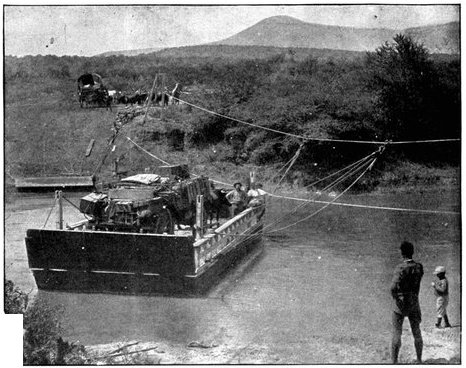
A PONT OR FERRY ON THE TUGELA.
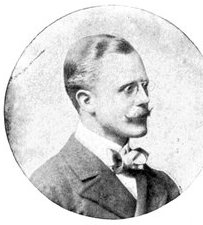
[Photo by Lambert Weston.
LIEUTENANT T. H. CARLISLE, S.A.L.H.
This is the officer mentioned on page 214 (note to illustration) under
the name of Carlisle-Carr, who with six of the South African Light
Horse swam the Tugela and brought over the pont.
Jan.
11, 1900.] The Boers Entrenching.
The Tugela at this point swirls along a rocky bed with precipitous
banks at the rate of ten miles an hour when in flood, varying in width
from 100 to 300 feet. To pass the drift, which is always difficult and
dangerous except when the stream is exceptionally low, marks on the
rocks have to be consulted. The road does not run direct across the
river, but makes a wide bend; it descends to the river bed from the
level of the surrounding veldt by a very steep and narrow cutting.
There are huge boulders in the stream, hidden in its turbid waters,
which render the crossing particularly awkward for waggons. Into
this treacherous torrent presently plunged Lieutenant Carlisle and
six of the rank and file of the South African Light Horse—Sergeant
Turner, Corporals Barkley and Cox, and Troopers Godden, Howell, and
Collingwood—all volunteers, and swam for the other side to seize
the pont. They reached it safely, released it, and started in it to
recross, but in mid stream were fired upon by the Boers. Fortunately,
only Lieutenant Carlisle was slightly wounded. A covering party of
twenty British troopers returned the fire with small effect. In the
course of the morning the 1st Durham Light[Pg 259]
Infantry and 2nd Scottish Rifles, speedily followed by the rest of
General Lyttelton's Brigade, arrived, and Spearman's Hill was at length
secure.
The Boers entrenching.
From Spearman's Hill the Ladysmith heliograph could be seen
endeavouring to call up the British. The signalmen were speedily in
communication, when they learnt that Sir George White's officers
could make out the enemy in large numbers moving west and south to
the threatened point. And the men on Spearman's Hill, for their part,
could see hundreds and thousands of small dark figures at work upon
the slopes and crests of the mountains opposite. "Every favourable bit
of ground they could be seen inspecting," says Mr. Burleigh, "while
hundreds toiled in every direction. Their object was unmistakable—to
draw line after line of trenches and to erect forts which would command
every inch of ground from the river front up to and beyond the crested
ridges four miles north. Besides that, to the west, they were crowning
lofty Spion Kop with defences and gun-positions." In a word, while
the British infantry were slowly and painfully marching to find the
enemy's right flank, the Boers by virtue of their mobility had already
prolonged that flank so far to the west that it could not be turned.
Yet the confidence in the British army as to the success of the move
was so great that already officers were betting two to one on the
relief of Ladysmith before the lapse of another week.
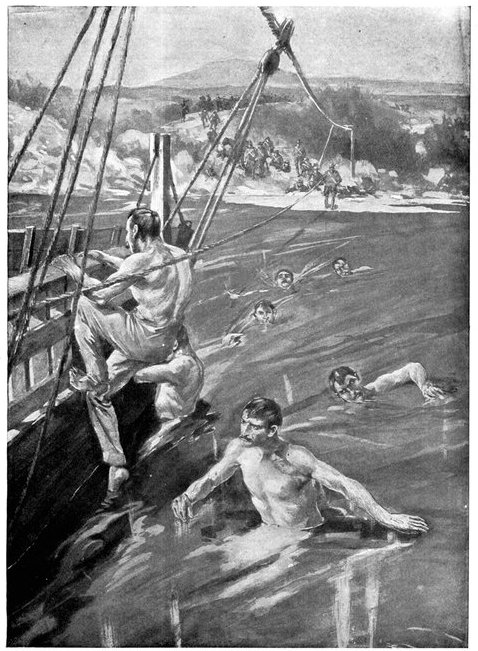
Alec Ball.]
THE CAPTURE OF THE PONT AT POTGIETER'S DRIFT.
General Buller's plan of attack.
[Jan. 11-16, 1900.
After the seizure of Spearman's Hill and Potgieter's Drift, a long
interval of apparent inactivity on the British side followed. The
naval guns arrived at Potgieter's Drift and were placed in position
on the hill, but they refrained from shelling the Boer lines. General
Buller fixed his headquarters hard by at Spearman's Camp. Meantime,
the British troops anxiously watched the Boers. "What are we showing
ourselves and our guns here for?" was the question which they asked
each other, to draw the not too satisfactory answer, "To give the
enemy plenty of time to get[Pg 260] ready." Yet, as a matter of fact, this
criticism was not altogether just. Though in the light of after
events it can be seen that a rapid blow would have had many chances
in its favour, though, as Napoleon said, "Celerity is better than
artillery," such action must have carried with it grave risks. General
Buller, preferring caution and sure-going, wished to attract all the
attention of the enemy to Potgieter's and then to strike elsewhere.
Five miles west of Potgieter's were two fords known as Trichard's and
Wagon Drifts; five miles east another known as Skiet Drift. Roads to
these ran from Springfield, and the movement of troops along the roads
could not be seen by the enemy, owing to the heights which fringed the
south bank of the Tugela. When all his preparations were complete,
ample supplies of food and ammunition accumulated at Springfield, and
his army concentrated, General Buller had determined to move General
Warren across at Trichard's Drift with instructions to turn the enemy's
right. Thus the apparently foolish and purposeless demonstration at
Potgieter's was not without its object. Great delay was caused by the
state of the unmetalled roads and the immense difficulty of moving over
them 650 ox-waggons. Between Frere and Springfield there were no less
than three places where all the waggons had to be doubled-spanned and
where some even required three spans. There the oxen had to be detached
from two waggons and attached to a third, while the vehicles behind
them were brought to a dead stop. The marching of the troops was not
altogether well-managed, since the men had alternately to run and halt,
than which nothing could be more wearying.
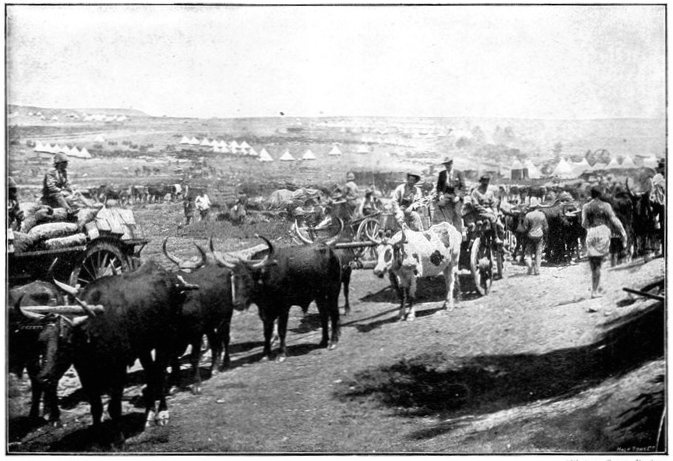
[Photo by Caney, Durban.
BREAKING CAMP: OX-WAGGONS MOVING OFF.
Jan. 16, 1900.] Preparations for the Coming
Battle.
At last, on January 16, a supply of seventeen days' provisions was
ready at Springfield. The position of the British Army was now as
follows:—At Spearman's Camp and Potgieter's Drift were General
Coke's and General Lyttelton's Brigades, forming the centre of the
British Army. Watching Skiet Drift, near which the enemy had been
seen in some force, and guarding the British right, was the greater
part of Bethune's Mounted Infantry. At Springfield the main force was
concentrated—three brigades strong, with six batteries, under the
command of Sir Charles Warren. On the evening[Pg 261] of the 16th this force
marched north-westwards to Trichard's Drift, where it was to pass the
river next day. With it went the Cavalry Division under Lord Dundonald.
Sir Charles Warren's orders were, having crossed the Tugela, to advance
north-westwards along the front of the Boer position, leaving Spion Kop
on his right, and swinging his force round the westward extremity of
the Boer line of defence, in the neighbourhood of Acton Homes. Thence a
comparatively open stretch of country extended to the neighbourhood of
Ladysmith.
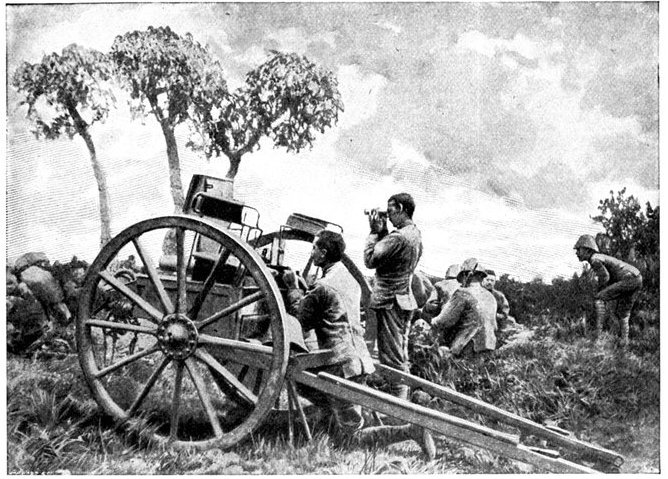
THE SCOTTISH RIFLES' MAXIM ON ZWART KOP.
The crossing of Potgieter's Drift.
To draw off the enemy's attention from this, the decisive movement,
a demonstration in force was to be made from Potgieter's Drift. As
columns of dust rose from the direction of Springfield, betokening
the advance of Warren's three brigades, the camp at Spearman's Farm
showed signs of activity. The infantry struck their tents; the cavalry,
whose camp was in full view of the Boer lines, left theirs standing
and marched off to the west; all the naval guns pushed forward to good
positions on Spearman's Hill. Then, first Lyttelton's and afterwards
Coke's Brigades deployed and in open order descended to the river. The
Scottish Rifles and Durham Light Infantry led the way. One officer,
Captain Harrison, advanced into the water carrying with him a rope;
the stream had fallen and now ran only waist deep at the ford. Then
came two or three more men, and last a long line holding hands.
Simultaneously a number of pontoons were got to work, and the ferry,
which had stuck obstinately and refused to move, was repaired by the
Natal Naval Volunteers. Away in front the Boers watched without firing
a shot. They could be seen manning their trenches on the hills, but
they gave no sign of life, intending, perhaps, as at Modder River and
Colenso, to allow the "rooineks" to approach within some hundreds of
yards, and then to massacre them with their magazine fire at their
leisure.
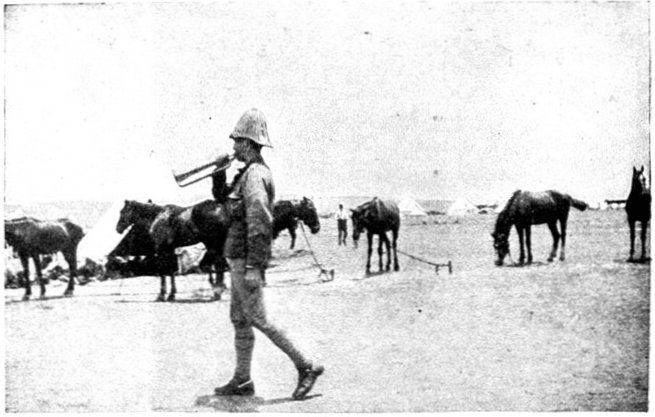
DINNER HOUR IN CAMP.
A trumpeter of Thorneycroft's Horse going the rounds.
First one and then another chain of infantry made the passage with much
floundering in the water. The companies, as they crossed one by one,
formed up on the opposite bank. When the two leading battalions were
complete they advanced rapidly for a mile along the undulating plain to
the north of the river and seized a line of low kopjes. The night drew
on with troops everywhere in motion.
[Pg 262]
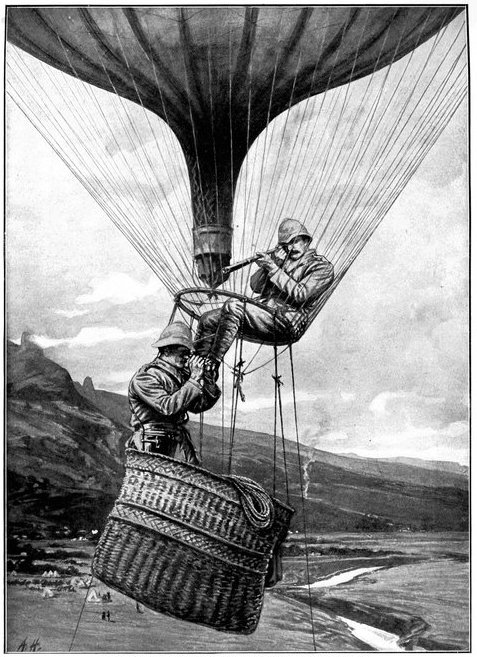
DIRECTING THE ADVANCE ON POTGIETER'S DRIFT FROM THE
BALLOON.
The Boers made ineffectual attempts to destroy the balloon by
shell-fire.
[Pg 263]
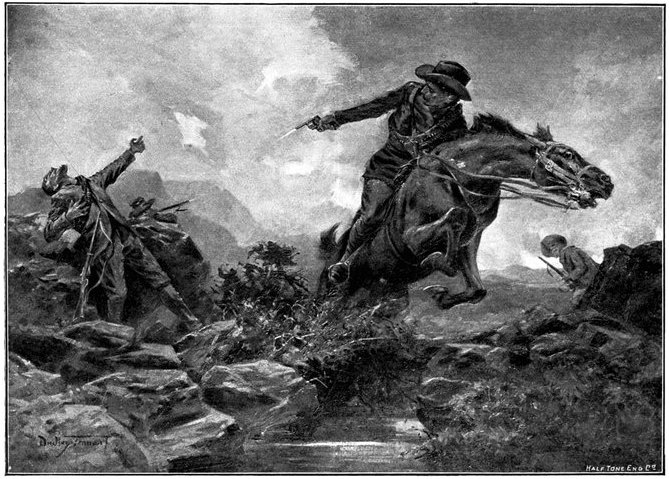
PERILOUS DUTY: A DESPATCH RIDER WAYLAID BY BOERS.
Warren's Divisions cross the Tugela—The enemy entrenching—The
artillery and transport cross—A long delay—Spion
Kop bombarded—Lyttelton's feigned attack—The
cavalry seize Acton Homes—Desultory movements
before Spion Kop—Change of plan—Advance on the
left ordered—Capture of Three-tree Hill and Bastion
Hill—Death of Major Childe—Assault ordered and
countermanded—Lyttelton's advance—Warren telegraphs
for howitzers—Rumoured relief of Ladysmith—Another
day of little progress—Pathetic humour—Assault
ordered and postponed—Another council of war—Warren
reinforced—The storming force—Ascent of Spion
Kop—A Boer picket surprised—The storming force
halts too soon—Tardy reinforcements—Botha
determines to recapture the hill—Positions of the
opposing forces—The Boers bombard the British
position—Woodgate wounded—Thorneycroft put in
command—A frightful struggle—Lack of artillery
support—Boer attempts to rush the position—The
King's Royal Rifles storm a ridge—Desperate
straits—Confusion of commands—Thorneycroft determines
to withdraw—Scene on the hill after the battle—Losses
in the action—The retreat—Causes of the defeat.
Warren's Divisions cross the Tugela.
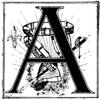
All through the night of January 16-17 General Lyttelton's Brigade
[Jan. 16-17, 1900.
was crossing the Tugela at Potgieter's Drift, fording the river or
ferrying over in the pontoons and ferry-boat. Before dawn the six
5-inch howitzers had followed the infantry and taken their post in
the line of kopjes, at One Tree Hill, the foremost point which the
British advance had reached. Meantime, General Hildyard with the
Second Brigade, to impress the Boers with the belief that the main
attack would be delivered from the east, and to divert attention
from the west, had deployed his men and made as if to cross at
Skiet's Drift. But, as night wore on, he too, had stolen off towards
Trichardt's Drift, ten miles to the west, whither in eager haste all
Sir Charles Warren's force was marching. Three brigades of infantry,
six batteries of artillery, and almost all the cavalry and mounted
infantry were concentrating upon this point. Rain fell in torrents,
hampering the movement and delaying the transport; yet before dawn the
combatants were in place and ready to begin. "It was not possible,"
says Mr. Churchill,[Pg 264] "to stand unmoved and watch the ceaseless living
stream—miles of stern-looking men, marching in fours so quickly that
they often had to run to keep up, of artillery, ammunition columns,
supply columns, baggage, slaughter-cattle, thirty great pontoons,
white-hooded, red-crossed ambulance waggons, all the accessories of an
army hurrying forward under cover of night—and before them a guiding
star, the red gleam of war." The march through the mud, however,
had wearied the men; still more so the alternations of running and
halting, which showed that the staff, from unfamiliarity with the
work of handling and moving large bodies of troops, had made faulty
arrangements. And thus, when in the small hours of the early morning
the column, anxious for action, looked down upon the river, and up
across it at the solemn precipices of Spion Kop beyond, nothing
happened. Perhaps the pontoons to bridge the stream had dropped behind
on the muddy roads; perhaps the general thought it inexpedient to
launch weary troops forthwith against the enemy. But to the men the
delay seemed exasperating; they knew that they would pay dearly for it
with their lives and that they had made haste in vain, since the Boers
were to be allowed time to extend their lines yet further to the west,
once more compelling a frontal attack.
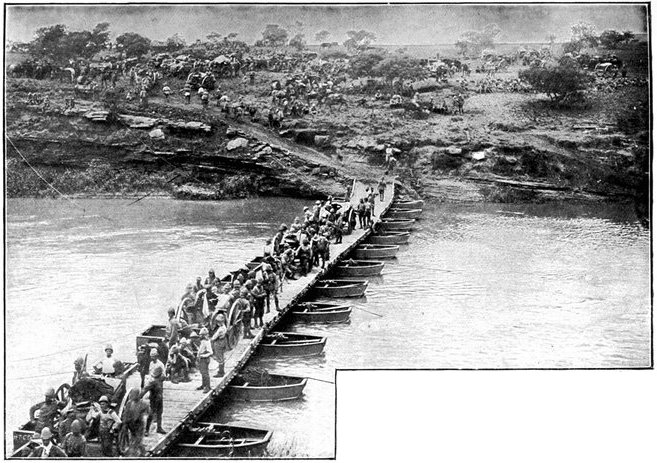
[Photo by Middlebrook.
AMMUNITION COLUMN CROSSING THE TUGELA BY A PONTOON BRIDGE.
The enemy entrenching.
Jan. 17, 1900.] Warren's Divisions Cross the
Tugela.
The night and the early hours of the day passed in inactivity. On the
hills opposite the Boers were already at their work of raising stone
breastworks and laboriously digging and blasting entrenchments, while
hour after hour reinforcements poured in. To the Boer the spade was a
weapon only one degree less useful than the rifle. Our soldiers, taught
to despise cover and untrained in the use of entrenchments, watched
with mingled contempt and apprehension these proceedings of the enemy,
and, as line after line of defences showed faintly on the green and
brown surface of the hills, wondered at the measured deliberation of
their own generals, contrasting strangely as it did with the furious
energy of the men opposed to them. At last, about 8 a.m. of January 17,
the crossing began. A patrol of Light Horse rode down to the river; the
Devons and West Yorkshires followed; the field batteries on the heights
overlooking the drift drew up in line and prepared to open; from the
right through the morning air came the thunder of the howitzers and the
heavy thud of the naval guns on Spearman's Hill, telling that General
Lyttelton was already in action. The uproar of battle re-echoed through
this remote mountain land and reverberated in the lonely eyries of
Taba Myama. Thick wet mist still enveloped the hill-tops and[Pg 265] gave the
country an air of eeriness and mystery; it lifted only towards mid-day
as the sun's rays dispelled it. The West Yorkshires were the first to
cross, ferried over in pontoons; the engineers set to work to build two
bridges, both above the drift, the one of pontoons and the other of
trestles. The first was completed in a couple of hours. The work was
scarcely interrupted by the Boers. A handful of snipers fired a few
shots at the British covering party of infantry and killed a soldier of
the Devons, but beyond this the enemy showed no disposition to harass
the attacking force, although, had they done so, there is little doubt
that they could have inflicted considerable loss. Their unwillingness
to leave cover, on this as on many other occasions during the campaign
in Natal, permitted operations to be carried on with comparative
safety, which a more enterprising enemy could have rendered highly
dangerous, or even disastrous. With the Boers it was an object to risk
as little as possible their lives and limbs; on our side the error was
quite in the opposite direction.
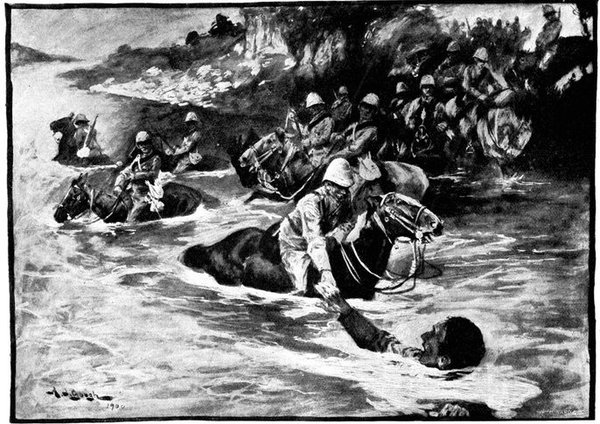
A. J. Gough.]
DROWNING OF A TROOPER OF THE 13th HUSSARS.
Several men and horses were swept away by the current in the crossing
of Wagon Drift, and one trooper was drowned in spite of Captain
Tremayne's gallant attempt to rescue him.
The British field batteries opened fire and searched the north bank of
the river with a storm of shrapnel, while the infantry discharged a
few volleys. There was no return of their fire by the Boers, and the
cannonade died away.
The artillery and transport cross.
[Jan. 17-18, 1900.
After the West Yorkshires and Devons, General Hart's Irish Brigade
streamed across the river and marched to a bivouac on the further bank.
The cavalry and mounted infantry had to use a difficult and dangerous
ford, known as Wagon Drift, a mile lower down the stream. Owing to the
swiftness of the current, which runs here at something like ten miles
an hour, there were some misadventures; several men were swept away,
and were with difficulty rescued by their comrades; one unfortunate
trooper of the 13th Hussars was drowned although every effort was
made to rescue him. It now only remained to pass the artillery, the
transport, and the waggons of the column across, but this proved by far
the most tedious and troublesome part of the[Pg 266] operation. Nearly 500
ox and mule-waggons, in addition to ambulances, guns, and ammunition
waggons, were sent over. The work occupied all the afternoon and
evening of the 17th and the morning of the 18th. The rest of General
Hildyard's Brigade and the whole of General Woodgate's Brigade had
already joined the battalions which were bivouacking without tents on
the north of the stream. The army was across and ready to strike a
blow when its transport would permit, halted in a land which was an
earthly paradise—"a country of arable soil and splendid pasture, where
brown-clad doves emit plaintive love songs, of twittering tomtits and
green-plumaged sunbirds, of huge, gray-coated secretary birds and gaudy
butterflies that would gladden the heart of the entomologist."
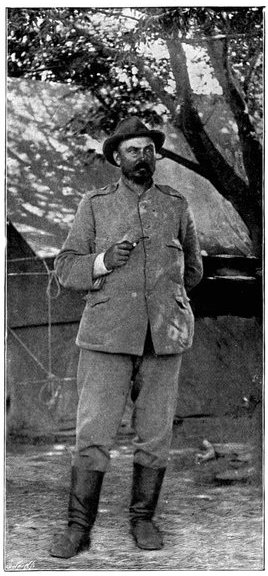
COMMANDANT GENERAL LOUIS BOTHA.
Was born in Natal some thirty-six years ago, and settled down in the
Transvaal when he had nearly reached man's estate. He does not come of
a fighting stock, but has hitherto been known as a successful farmer.
In the early days of the war, however, he showed such conspicuous
military ability that he was, upon Joubert's death, and despite his
comparative youth, elected Commandant General of the Boer forces. He
is fairly well educated for a Boer, and talks English fluently when
he pleases. He is married to a lady of Irish descent, whose maiden
name was Emmet, and who claims relationship to Thomas Addis Emmet, the
United Irish leader of 1798, and to Robert Emmet, executed for high
treason in 1803.
A long delay.
The afternoon and evening of the 17th passed in inactivity so far as
the infantry and artillery were concerned. Only a few shots were fired
by the artillery to disconcert the Boers. There was much questioning
in the British camp as to the reason for the long delay, since to the
men rapid movement seemed essential for success against the enemy. The
Boers could be seen everywhere, well out of range, at work upon the
lines of defences on the hills and kopjes. The British army was sitting
still and giving General Botha—who was now in command of the Boers
at this point—ample time to concentrate his forces and make all his
dispositions. The wait at Potgieter's was easy to explain, for that
had not been the point chosen for the decisive attack. But the wait
after crossing at Trichardt's Drift admitted of no such simple excuse.
Everything depended upon celerity. The facts were that General Warren
did not venture to leave his baggage in charge of a small rearguard and
to push on along the Boer front, and that the crossing of such a river
as the Tugela, with its high banks, awkward approaches, and difficult
fords, was necessarily a slow and troublesome work, giving the enemy
abundance of opportunity to gather men and oppose a determined
resistance.
Spion Kop bombarded. Lyttelton's feigned attack.
Jan. 18, 1900.] A British Ambuscade.
On the 18th General Lyttelton's Brigade advanced in widely extended
order from One Tree Hill—as the chief of the kopjes near Potgieter's
Drift was named—towards the Boer lines, supported by the fire of the
naval guns and howitzers. The shells searched the eastern face of Spion
Kop, which had been assiduously bombarded on the previous day, causing
the Boers, as they themselves admitted, heavy losses, and interrupting
communication between their camps and laagers. Clouds, now yellow and
green with the fumes of lyddite, now brown with the dust which its
explosion threw up, flecked the slopes of the hills. But the enemy
made no reply whatever. The great war balloon rose slowly into the
air near One Tree Hill, and the officer in the car signalled that he
could see the Boers lining their entrenchments, but could discover no
guns. Thereupon the British infantry—the Scottish Rifles on the left,
the 3rd King's Royal Rifles in the centre, and the 1st Rifle Brigade
on the right—pushed forward in a convex line, making all possible
use of cover. The object was to draw the enemy, to distract[Pg 267] their
attention from Sir Charles Warren, and to discover their positions. But
they obstinately refused to be drawn; instinctively they had divined
our purpose. Only from the hill on the British right front, known as
Brakfontein, came a few shots which wounded two men. A second line of
kopjes, one mile in advance of One Tree Hill, was reached and gained
without incident, and there the brigade halted till night, and then
under cover of darkness fell back.
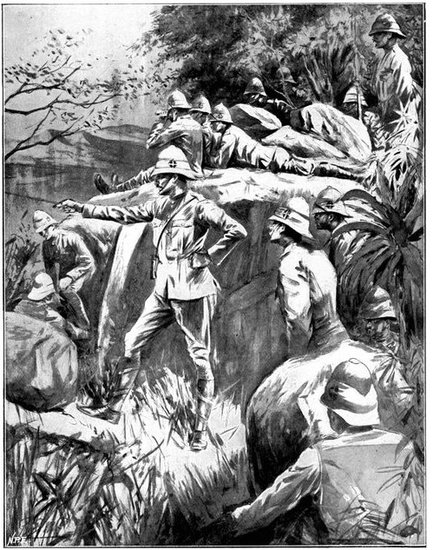
"THE OUTLOOK" OVER THE TUGELA.
An officer of the Scottish Rifles explaining to his men the
dispositions of the enemy.
The cavalry seize Acton Homes.
[Jan. 18-19, 1900.
During this interval of inactivity and demonstrations the mounted men
under Lord Dundonald had been employed on more serious work. While Sir
Charles Warren was collecting his baggage and transport, and moving his
infantry force slowly a couple of miles northward, under the shadow of
Spion Kop, the cavalry and mounted infantry rode six miles up the road
to the north-west to the hamlet of Acton Homes. About mid-day a small
force of Boers was made out, also moving west, and Major Graham of the
Natal Carbineers, with 350 men of that body, of the Imperial Light
Horse, and of the King's Royal Rifles' Mounted Infantry, was permitted
to snare it if he could. He pushed forward rapidly, unobserved by the
enemy, and seized a point commanding the road, where his men lay in
ambush and waited. The Boers with unusual carelessness had sent out
a German to scout, who reported that the way was clear. They came on
unsuspectingly, and, but for a carbineer who fired before orders had
been given, would have been destroyed to a man. As it was, at 300
yards range, they received a deadly volley and at once broke and ran
over the smooth, open plain, some to the nearest kopje, others, more
daring, across the veldt towards the Boer camps some miles away. The
party which had taken refuge in the kopje was speedily surrounded, and
an attempt was made—and abandoned when the Boer fire showed that it
must cause unnecessary loss—to rush the position with the bayonet.
"We got within fifty yards of the Dutchmen," said one of the King's
Royal Rifles, "but it was too hot to go further." So the storming
force retired, and a steady rifle fire was directed upon the kopje
to bring the Boers to their senses. Once they showed the white flag
without ceasing their fire, but the British troops had been warned what
to expect, and paid no attention. Then a second time the white flag
fluttered up and the shooting of the Boers stopped;[Pg 268] with difficulty
the British officers checked their indignant men. Several of the
enemy rose and held up their hands; the kopje was taken. Twenty-four
unwounded Boers were made prisoners, and, in addition to these, eight
were found badly wounded. Ten more lay dead on the kopje, among them
Field-Cornet de Mentz of Heilbron, who, though badly wounded at the
beginning of the fight, had continued firing till he bled to death.
Besides these losses, the party of Boers which had made its escape
eastwards had also suffered to the extent of fifteen or twenty killed
and wounded. The British casualties were only four—two men shot
through the head and killed, and an officer and a private wounded. The
affair, however, had no serious results and no strategical importance,
though it showed that our Colonials were fully a match for the Boers in
wiliness. To the Natal Carbineers the credit belongs.
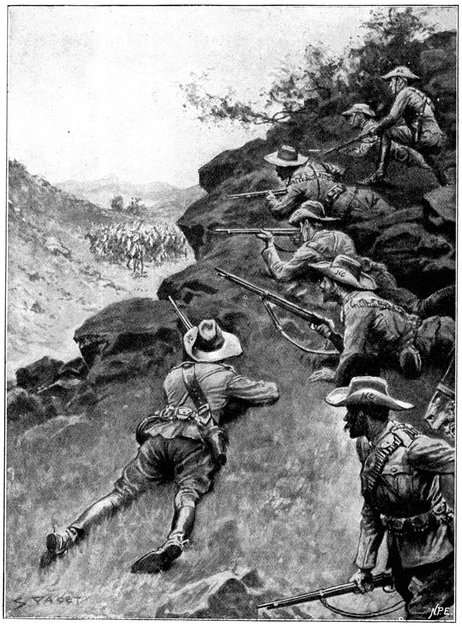
BOERS AMBUSCADED BY BRITISH AND COLONIAL TROOPS UNDER
MAJOR GRAHAM OF THE NATAL CARBINEERS.
No sooner had the enemy surrendered, than the British soldiers vied
with each other in striving to comfort and succour the Boer wounded.
The soldiers crowded round them, "covering them up with blankets or
mackintoshes, propping their heads with saddles for pillows, and giving
them water and biscuits from their bottles and haversacks. In an
instant anger had changed to pity. The desire to kill was gone," wrote
Mr. Churchill. The British mounted troops were ordered to return after
their success, as the news had been heliographed from Ladysmith that
a large force of Boers was moving with guns to cut them off, and they
were beyond the reach of infantry support. Thus the original intention
of seizing the Boer line of communications to the Drakensberg was
abandoned without further effort.
Desultory movements before Spion Kop.
On the 19th, in very leisurely manner, Sir Charles Warren began his
infantry movement along the western foot of Spion Kop. That height was
the pivot upon which the Boer centre rested; its slopes and precipices
parted the two wings of the British army—the right wing under General
Lyttelton at Potgieter's, watching the eastern face of the great
mountain, the left wing, five miles away, watching the western face
and endeavouring to work round it without delivering a frontal attack
upon the works which crowned its ridges. The artillery vigorously
shelled the Boer lines; the naval guns from Spearman's Hill enfiladed
the eastern ridge of Spion Kop, and two brigades of British infantry
in skirmishing formation pushed forward up the rocky slopes and ridges
in the direction of Spion Kop, at once to guard the baggage from
molestation and to occupy the enemy.
[Pg 269]
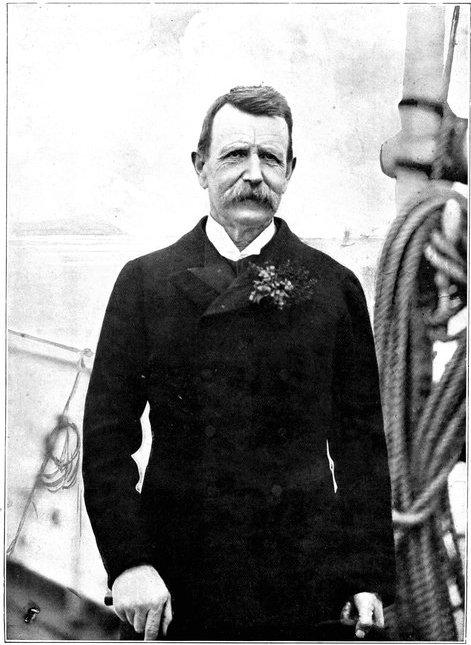
[Photo by Gregory.
LIEUTENANT-GENERAL SIR CHARLES WARREN G.C.M.G., K.C.B., R.E.
[Jan. 19,
1900.
A few facts concerning Sir Charles Warren's career are given below the
small portrait on page 215. He was appointed by Lord Roberts (April
26, 1900) Military Governor of Griqualand West "while that part of the
country is in a disturbed condition."
[Pg 270]
The transport was forwarded to Venter's Laager, an advance of
four whole miles in the day, while the mildest kind of long-range
fighting proceeded, and the troops wondered whether "make haste
slowly"—"slowly" in this case being at the pace of the snail—was wise
tactics. On the right of the British troops the Boers looked down from
the hills—it might seem with ironical contempt—upon the half-hearted,
purposeless moves of the great army below. They were active enough in
ever extending their lines of defence to the north-east, whatever the
British were doing. Yet, prudently guarding against possibilities,
their heavy waggons were already on the road to the Free State and
the Transvaal. Sir George White, they argued, might well break in
upon their retreat if General Buller's army gained any success. In
the afternoon the action slowly relaxed its vigour; the steady and
continued rifle and cannon fire gave place to desultory sniping, and
the troops bivouacked in their aerial perches among the rocky ridges.
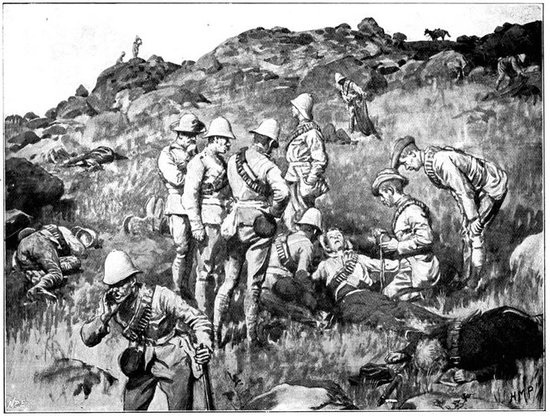
BRITISH SOLDIERS TENDING BOERS AFTER THE BATTLE AT
POTGIETER'S DRIFT. (See page
268.)
Change of plan.
Jan. 19, 1900.] Frontal Attack to be Made.
"In war," says the great Prussian organiser of victory, Scharnhorst,
"what the general does matters little. Everything depends upon the
unity of action and vigour with which he does it." And so it was no
very reassuring symptom when, after reaching Venter's Laager, Sir
Charles Warren assembled the generals, the staff, and the commanders
of the artillery and engineers, and pointed out to them that there
were two lines of advance—the one devious and round-about, by way of
Acton Homes, the other passing up by Fair View and the centre of the
Boer position to the western side of Spion Kop, at a point where the
summit of the ridge dropped considerably. To move by Acton Homes, he
urged, was impossible, as his food and provisions would not permit of
it. To take waggons up the Fair View road would necessitate sending
all the transport back to the south of the Tugela and capturing the
enemy's positions by a frontal attack, the men marching with three
or four days' provisions in their haversacks. The assembled generals
acquiesced;[Pg 271] and thus, in spite of a general order, which is said
to have been issued by General Buller at the beginning of the flank
movement, to the effect that there would be "no turning back from the
relief of Ladysmith," the original flank movement was abandoned. A
message was sent to General Buller couched in the following terms:—
"Sent 7·54 p.m. Received 8·15 p.m.
"Left Flank, 19th January.
"To the Chief of the Staff,
"I find there are only two roads by which we could possibly get from
Trichardt's Drift to Potgieter's, on the north of the Tugela, one by
Acton Homes, the other by Fair View and Rosalie; the first I reject as
too long, the second is a very difficult road for a large number of
waggons, unless the enemy is thoroughly cleared out. I am, therefore,
going to adopt some special arrangements which will involve my stay
at Venter's Laager for two or three days. I will send in for further
supplies and report progress.—Warren."
It will be observed that it did not in clear language state that a
frontal assault was to be substituted for the flanking movement, yet it
contained enough to tell the Commander-in-Chief in Natal that a radical
change of policy was purposed. Sir Redvers Buller appears to have
offered no objection. He answered to the effect that further supplies
would be sent.
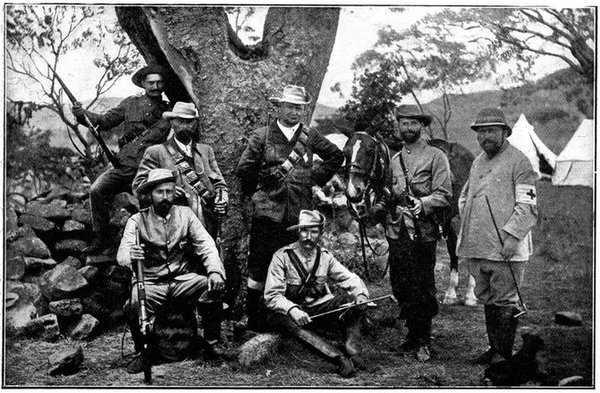
OFFICERS OF THE GERMAN CORPS UNDER GENERAL LOUIS BOTHA.
[Jan. 19-20, 1900.
It would be supposed that this discovery might have been made by a
personal reconnaissance two days earlier, as soon as General Warren's
troops had effected their passage at Trichardt's Drift. The saving of
these two days might well have meant the difference between victory and
defeat. Even if the maps were bad—and General Buller described the
march as a march "into an unknown country," while it is a fact that
Spion Kop was not shown in the sketch of the country round Ladysmith,
issued by the Intelligence Department—an examination of the lie of
the land by the generals must have disclosed on the 17th what does
not appear to have been realised till the evening of the 19th. The
desperate straits of Ladysmith rendered prompt and rapid action of the
most vital importance.[Pg 272]
Yet two days were spent in bringing the transport across, and then in
making the discovery that it was the most dangerous encumbrance and had
better have been left on the south side of the Tugela.
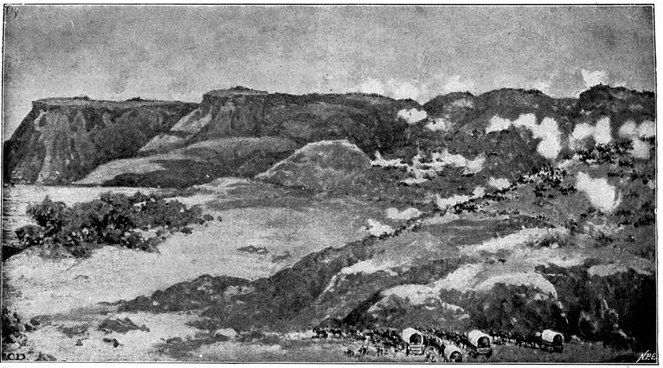
F. C. Dickinson.] [
After a sketch by a British
officer.
THE ACTION AT THREE TREE HILL.
In this sketch the Boer position is along the crests of the hills.
Halfway up the hill near the centre the British are seen advancing;
on the nearer hill are two batteries of Royal Artillery, and the
Lancasters and Lancashire Fusiliers "sniping"; in the foreground the
ambulances. In the actual battle little or no smoke was to be seen;
it has been exaggerated in the sketch in order to make the positions
clear.
Advance on the left ordered.
On the 19th there had been nothing more than long-range skirmishing
in which the British losses were comparatively small. On the 20th it
was determined to force the attack. Accordingly, on the night of the
19th, General Warren instructed General Clery, with General Hart's and
General Woodgate's Brigades, and the six field batteries, to push the
advance on the extreme left, against the enemy's positions on the long
ridge which ran down from Spion Kop to the north-east. The ground over
which the British troops were to advance is described as a succession
of ridges, intersected at right angles by watercourses, cutting deep
gorges in the mountain side, and thus sundering and separating the
attacking force. Of shelter there was little or none; the advance had
to be made from ridge to ridge, always under the fire of the vigilant
enemy.
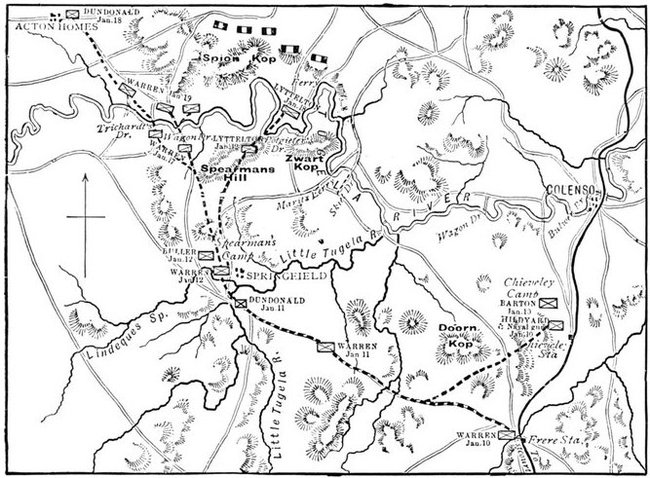
MAP SHOWING THE MOVEMENTS OF SIR CHARLES WARREN'S ARMY
UP TO THE NIGHT OF SPION KOP.
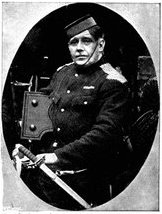
[Photo by Bartlett, Shrewsbury.
MAJOR CHILDE.
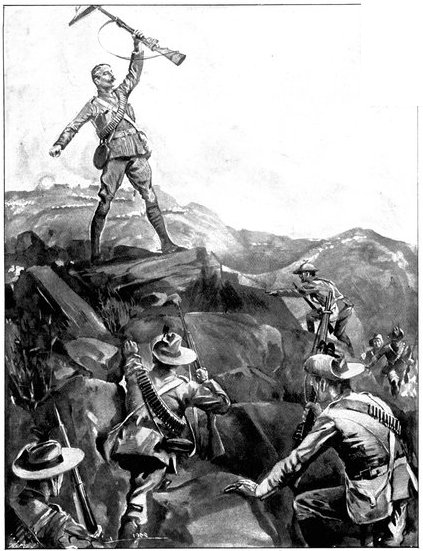
Alec Ball.]
PRIVATE TOBIN CAPTURES BASTION HILL.
Jan. 19-20, 1900.] Capture of Three Tree Hill.
Capture of Three Tree Hill and Bastion Hill.
[Jan. 20, 1900.
During the night of the 19-20th a forward move was made. General
Woodgate pushed out from the British[Pg 273] camp and seized Three Tree
Hill—a bastion jutting out from the north-western flank of Spion
Kop. The Boers offered no resistance. The hill was the centre of a
vast amphitheatre, crowned on all sides by Boer entrenchments; and
though far below the crests which towered above it, it was the best
artillery position that could be found, and here three of the British
field batteries were planted. When day broke, the battle opened with
the usual bombardment on the part of the field guns, the naval guns
from Spearman's Hill and the howitzers from Potgieter's shelling the
Boer position on Spion Kop from the other side. All day "the hills
crashed with guns and rattled with musketry. At a little distance you
might have supposed," writes Mr. Atkins, "that the resonant noises came
from some haunted mountain, for the hills looked sleepy, and peaceful,
and deserted, and there seemed to be no reason for all these strange
sounds—the bark of field guns, the crackle of musketry, the rapping of
Vickers-Maxims, and the tat-tat-tat-tat-tat-tat of Maxims." All day the
thin straggling lines of British infantry pushed slowly forward—almost
invisible upon the slopes of the hills—but in spite of splendid
efforts the progress was painfully slow. The advance was made at first
by small scattered parties of men, quickly following each other and
using all the cover[Pg 274] that could be found, hurrying from kopje to kopje.
Then in heavier masses the main body of the infantry followed. General
Hildyard's Brigade was on the left, General Hart's in the centre, and
General Woodgate's on the right. On the extreme left were the cavalry
and mounted infantry, who accomplished the one great feat of the
day—the capture of Bastion Hill.
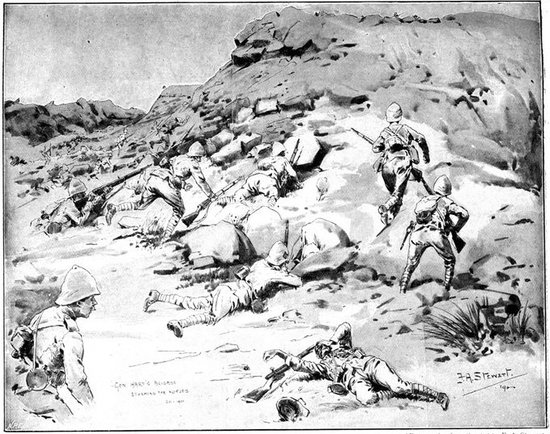
[From a sketch on the spot by F. A. Stewart.
THE IRISH BRIGADE STORMING THE KOPJES NEAR WARREN'S CENTRE. January 20,
1900.
Bastion Hill, like Three Tree Hill, ran out at right angles from the
main range of Spion Kop. By Lord Dundonald's order the South African
Light Horse under Major Childe were sent to examine it, and if they
did not find it strongly held, to seize it. They extended, approached
under a heavy fire from the Boers at over 7,000 yards—a range at which
British field artillery is useless—and climbed in open order its
steep, almost precipitous sides. A private named Tobin led them all.
Alert and agile, he bounded up the slopes, and reached the summit ten
minutes before the rest of his comrades. All watched him, expecting
every instant to see him fall, but he found only a picket of Boers,
who fled at his appearance. Turning round, he waved his helmet on his
rifle, and the Light Horse rushed up and occupied the hill. There was
something ominous in the ease with which it had been taken, and the
Boer reason for leaving it unfortified was soon manifest.
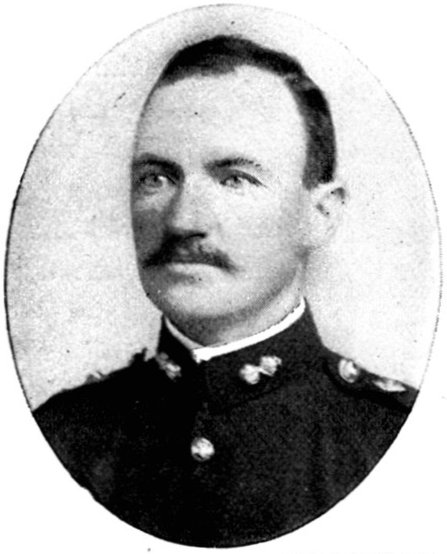
[Photo by Caney.
CAPTAIN C. A. HENSLEY.
Killed at Venter's Spruit (see page 275).
Jan. 20, 1900.] Bravery of the Irish Brigade.
Death of Major Childe.
Behind it rose a crescent-shaped ridge, hardly visible from below,
but which was now seen to command it. The top of Bastion Hill itself
was bare of shelter, and upon it from this further crest was poured
a murderous[Pg 275] fire—shrapnel and rifle. Towards evening Major Childe
was struck and killed by a well-timed shrapnel, which laid low six
of his brave troopers. Upon him, in the days before the battle, the
presentiment of death had sat heavily. He had asked the night before
that on his grave should be placed this epitaph, with its words of
eternal hope and consolation: "'Is it well with the child?' And she
answered: 'It is well.'" His wish was fulfilled. Beneath Bastion Hill
he lies to-day, and on the cross which marks his grave these simple
words are carved. Around him, on the solemn hills, within sight of his
resting-place, sleep the valiant comrades who in these sorrowful days
of defeat laid down their lives for their country. And his epitaph is
theirs.
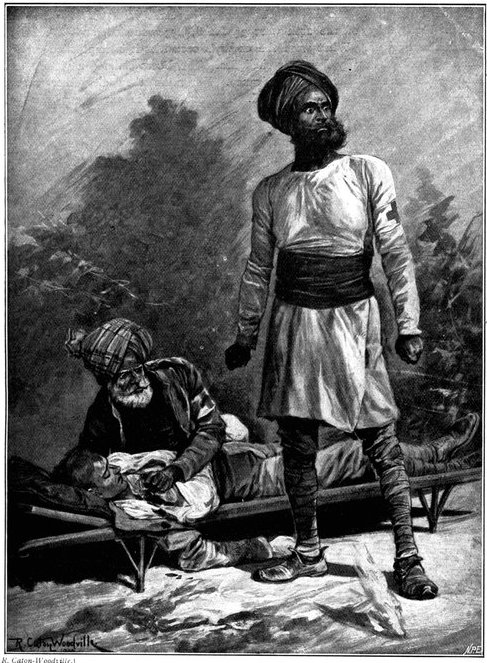
R. Caton Woodville.]
THE DANGERS OF MERCY: INDIAN AMBULANCE BEARERS UNDER FIRE.
Assault ordered and countermanded.
[Jan. 20, 1900.
Nearer Sir Charles Warren's centre the Irish Brigade under General
Hart displayed all its usual and reckless valour. The men went forward
with dash and fury, eager to wipe out old scores, and, had they been
given a free hand, might have secured then the success which a month
later their efforts and self-sacrifice achieved. Upon them the Boer
artillery opened with great effect, the Pom-Poms and captured British
15-pounders from Colenso maintaining a rapid fire. The guns were hard
to locate, and so were not easily silenced by the British batteries.
There fell Captain Hensley, who had fought all through the war, in
Natal, at Dundee, at Farquhar's Farm, and at Colenso—a man greatly
beloved. Towards the middle of the afternoon it was determined to
press home the assault on the enemy's position. The British batteries
accordingly redoubled their[Pg 276] fire; the grass along the amphitheatre of
hills took fire, and great clouds of smoke rose, blowing down upon the
Boer marksmen. But for some reason or other, not for the first time,
the generals changed their minds. The assault was countermanded, and
the troops fell back a very little from the most advanced positions.
As the evening wore on, General Hildyard extended his left to Bastion
Hill, driving back a small Boer commando, and sent a force of infantry
to relieve the South African Light Horse. With darkness the firing died
down, and the troops had again to bivouac on the bare mountain sides.
The day had been one of scorching heat, and to it, as is not unusual
at high altitudes, succeeded a night of bitter cold. The British
casualties in General Warren's force from the arrival at Trichardt's
Drift to the evening of the 20th were 34 killed, 293 wounded, and
2 missing, so that the losses were fast mounting up. What were the
enemy's casualties it is impossible to say, but by their own accounts
they suffered heavily from our shell fire. The Boers claimed a victory,
and asserted that General Botha had checked the British advance. Nor
were they altogether wrong, since we could show only the most trivial
advantage gained. The one point in our favour was that the British
casualties could be replaced, whereas the Boer casualties could not.
Throughout the day the conduct of the civilian stretcher-bearers
excited the most unstinted admiration and praise. They went forward
stolidly to the very firing line, and could be seen bending over the
dead and succouring and removing the wounded with faithful devotion and
superb coolness amidst the hail of bullets and shells. The Boers fired
on them with the utmost impartiality, for the enemy either could not
or would not see the red-cross badge. Not a few of the bearers were
themselves killed or wounded.
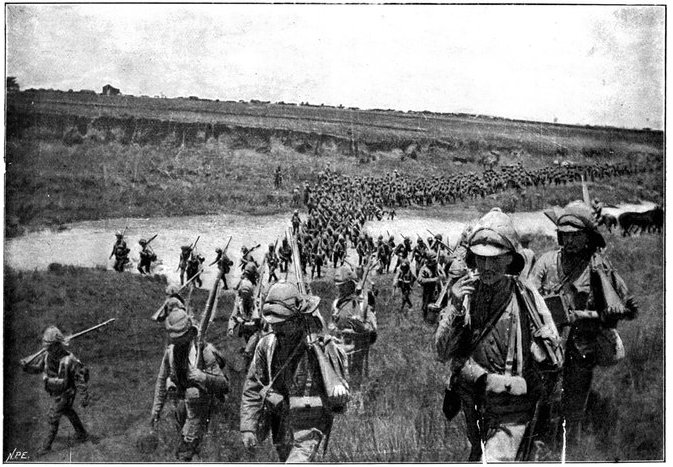
THE ROYAL LANCASTER REGIMENT CROSSING A DRIFT (WITH
THEIR BOOTS ON) ON THE WAY TO SPION KOP.
The conduct of the day's fighting provoked some bitter, perhaps
intemperate, complaints of the British generals' tactics. It was said
of one of the Brigade Commanders that "he took personal command of the
York and Lancaster and the South Lancashire regiments, and ordered a
futile bayonet charge at an enemy nearly fifteen hundred yards away.
This attracted such heavy fire that the two regiments sought shelter
and declined to follow their officers another yard."
[Pg 277]
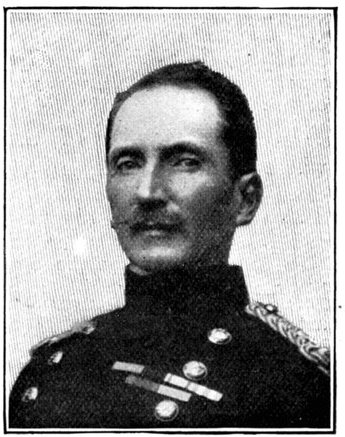
[Photo by Chas. Knight.
MAJOR-GENERAL HART.
Major-General A. FitzRoy Hart, C.B., commanding the 5th Brigade of the
10th Division.
Jan. 20-21, 1900.] Ineffectiveness of the British
Guns.
Lyttelton's advance.
On the afternoon of the 20th, to support Sir Charles Warren's attack,
General Lyttelton advanced directly upon the Boer trenches which lined
the eastern slope of Spion Kop and the southern slope of Brakfontein.
This was a totally distinct movement from Sir Charles Warren's, and was
directed from Potgieter's Drift. The howitzers and naval guns aided the
infantry with their fire. At the same time Bethune's Mounted Infantry
were ordered to move along the river to the east; they speedily came
into contact with the enemy in strong force, and as their orders were
to do nothing more than demonstrate, retired. But the presence of the
enemy in strength in this quarter, close to Skiet's Drift, seriously
menaced the British line of communications. Meantime, General Lyttelton
pushed up to within 1500 yards of the main Boer entrenchments, and
after long-range firing slowly fell back, with two killed and fifteen
wounded or missing.
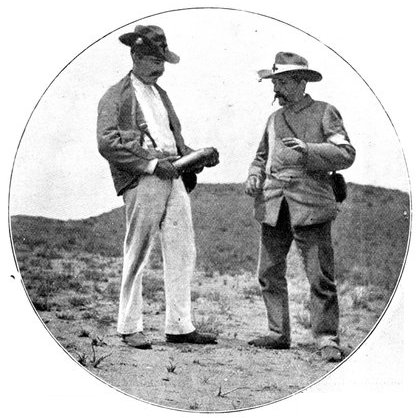
[Photo by Barnett.
RUSSIAN DOCTORS WITH THE BOER ARMY PICKING UP BRITISH SHELLS.
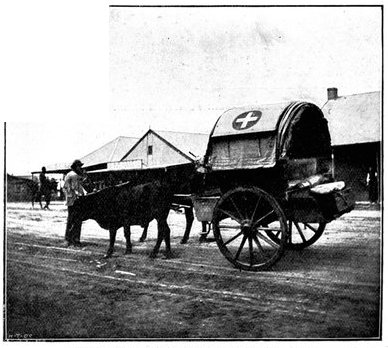
INDIAN AMBULANCE CART WITH BULLER'S ARMY.
Warren telegraphs for howitzers.
[Jan. 21, 1900.
On January 21 Sir Charles Warren renewed the engagement on the left.
The day again opened with an artillery bombardment conducted by the
six field batteries. But though the guns fired thousands of shells
they produced little effect. Being so far below the level of the Boer
trenches, they could not direct their fire to advantage, and they
failed to silence the enemy's works or to overpower the Boer artillery.
This latter could use its range to advantage, while good positions for
the British guns could not be found. Three Tree Hill—the trees on
which had already vanished—was too far off for the capacity of our
15-pounders; on the steep slopes where the infantry were fighting it
was impossible from the nature of things to handle artillery. Howitzers
alone could do the work, and there were but six howitzers in General
Buller's whole[Pg 278] army, and all these at Potgieter's Drift with General
Lyttelton. For them Sir Charles Warren telegraphed, but to move them
from One Tree Hill to Three Tree Hill over mountains and along bad
roads was necessarily the work of some time. Four were sent and arrived
early in the morning of the 22nd.
Rumoured relief of Ladysmith.
All the morning of the 21st the advance continued in the centre and
on the extreme left, where Generals Hildyard and Hart were engaged.
The Boers were massing in this quarter, and two batteries had to be
moved from the British right to the left to give additional support
to the troops. As on the previous day, General Hart's Irishmen were
again foremost in battle—"perched on the edge of an almost precipitous
hill"—and suffered heavily. The men were gladdened and roused to the
most desperate efforts by a rumour which ran along the line, to the
accompaniment of cheering, that Ladysmith had been relieved by Lord
Dundonald's cavalry while the enemy's attention was occupied by the
infantry attack. Like other rumours this story was absurd; it needed
little reflection to show that if the mounted men had not been able to
remain at Acton Homes without fear of being surrounded, they could not
have pushed through the very heart of the Boer position with waggons
and stores. Their arrival in Ladysmith without supplies would have been
only a serious embarrassment for the garrison; to move with a heavy
train of transport under the Boer trenches was almost impossible.
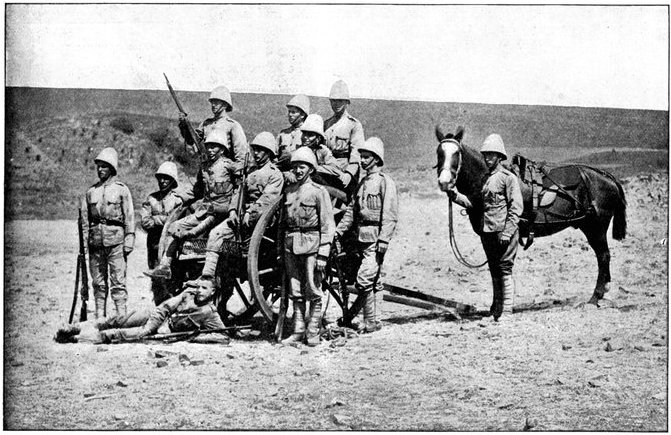
ROYAL DUBLIN FUSILIERS AND THEIR MAXIM, FORMING PART OF
HART'S IRISH BRIGADE.
A curious fact, which illustrates the difference between British and
Colonial methods of fighting, was observed on this day. A squadron
of South African Light Horse held a kopje all day under heavy fire,
but, by carefully taking cover, without losing a man. Near at hand two
companies of British regulars held a hill under much the same fire,
and, untrained in the art of concealing themselves, lost no less than
twenty men.
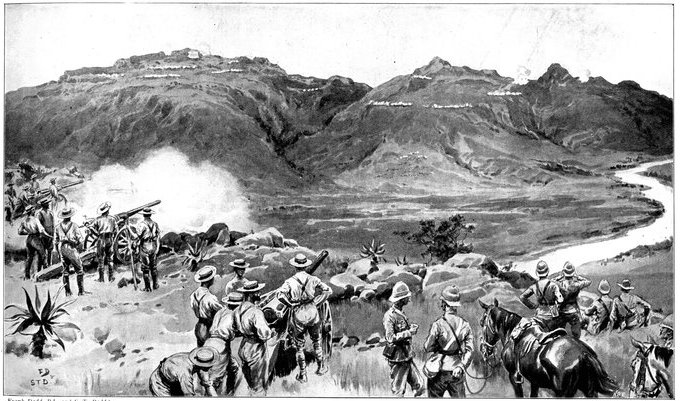
Frank Dadd, R.I., and S. T. Dadd.] [After a sketch
made on the spot.
GENERAL VIEW OF THE FIELD OF BATTLE BEFORE SPION KOP.
[Jan. 21, 1900.
The fighting on the 21st precisely resembled that of the 20th. Ground
was gained, but so slowly that it became evident the advance to
Ladysmith at this rate would be the affair not of weeks but of months.
Bastion Hill, captured on the previous day, had to be abandoned, as it
was found [Pg 279]
[Pg 280]shelterless and useless. Its loss was of no importance.
And if the advanced Boer line of trenches was taken, with considerable
loss, behind it showed a second line at a distance which varied from
400 to 1,000 yards, composed of earth redoubts, stone breastworks or
schanzes, and deep trenches blasted or hewn with pickaxes and crowbars
in the friable rocks. These defences gave ample cover; the artillery
could not properly reach them; rifle fire made no impression upon
them; and in front of them stretched a smooth, grassy slope forming
a superb glacis. The text-books were useless; theory gave little
help, for it had been anticipated that artillery would so shake the
defenders' nerves as to destroy the accuracy of the enemy's fire and
render assault possible. But whenever an attempt was made to rush the
Boer positions, the enemy showed in the most unpleasant fashion that
their nerves were not shaken and their fire was as well aimed as ever.
Undoubtedly it would have been possible, with such superb troops as the
seasoned veterans of Colenso, to storm the Boer line, but only with
the heaviest losses. What prevented the attempt being made was the
fear that behind this second system of defences might lie a third, and
behind that again a fourth, so as to render the effort unavailing. Yet
there were voices raised for this desperate and determined course, and
a bold general might well have decided upon it, as likely to prove less
bloody and less trying in the end than these days of protracted and
ineffectual skirmishing.
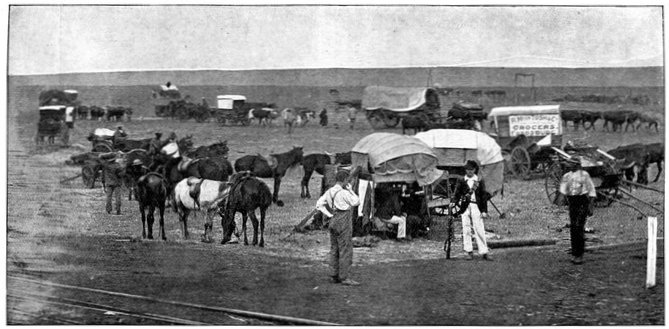
ARRIVAL OF SUPPLIES FOR THE BOERS INVESTING LADYSMITH.
Another day of little progress.
The painful fact was that Sir Charles Warren's army was assaulting a
fortress of immense strength held by splendid soldiers—assaulting,
too, without the assistance of an overpowering artillery and long-range
field guns. No effort was spared by the brigadiers and subordinate
officers. General Hart, sword in hand, was in his usual place, the
van; the bravest of men, he sent his staff to cover, that the risks
he faced might not be theirs. But the hopelessness of the work was
slowly dawning upon everyone. At the close of the day, when the firing
ceased, the army had again to mourn grievous losses. Twenty-four were
killed, 223 wounded, and four missing, yet practically nothing had been
accomplished beyond a display of splendid courage and endurance. Once
more the troops bivouacked amongst the rocks, but it was evident that
their efforts could not be indefinitely repeated.
Pathetic humour.
Jan. 21-22, 1900.] Buller holds Councils of War.
A few incidents may be chosen from the many reported by the chroniclers
of this arduous day to show the spirit of our troops and the
tragi-comic humours of the battlefield. A lad of nineteen, says Mr.
Churchill, sat behind shelter in the Irish Brigade's firing line.
"His right trouser leg was soaked with blood. I asked him whether he
was wounded. 'No, sir; it's only blood from an officer's head,' he
answered, and went on munching his biscuit." Two soldiers sat side by
side in one of the lulls of firing, the one eating biscuit, the[Pg 281] other
flicking stones at him. Something struck the eater a sharp blow on the
neck, and he turned angrily to the other man. "What did you throw that
stone at me for?" "I didn't throw it." "Liar!" And the two were ready
to fight, when the red stain showed that the second spoke the truth. It
was a bullet. A private was seen trudging into the firing line with a
puppy under his arm. Did he wish for companionship in the loneliness of
a modern battle, where each man has to stand or fall by himself?
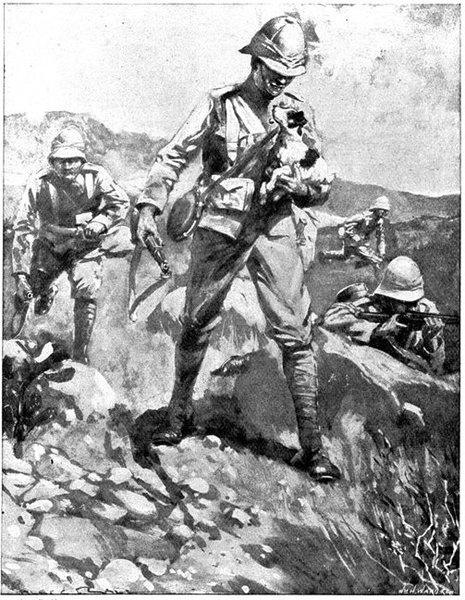
Alec Ball.]
TOMMY'S TRUSTY COMRADE.
Assault ordered and postponed.
On the 22nd General Coke's Brigade marched to reinforce General Warren,
from Potgieter's Drift; the howitzers arrived, and two on each flank
began to fire, while the infantry held the ground already won and made
no more effort to advance. There was, all this and the following day,
a desultory engagement in which no advantage was gained by the British
troops. Early on the 22nd General Buller rode over to see what progress
had been made. A council of war was held, and it was decided that the
last hope of success was to storm Spion Kop. To reach this decision
had taken nearly a week—a week of useless marching, counter-marching,
and bloodshed for the army, a week of starvation and agonised suspense
for Ladysmith. The orders were issued to General Coke to assault Spion
Kop that night with his Brigade. The General, however, objected most
strongly—and with good reason, after Stormberg and Magersfontein—to
making such an attack over ground which he did not know and had not
personally reconnoitred. In response to his objections Sir Charles
Warren postponed the attempt till the night of January 23.
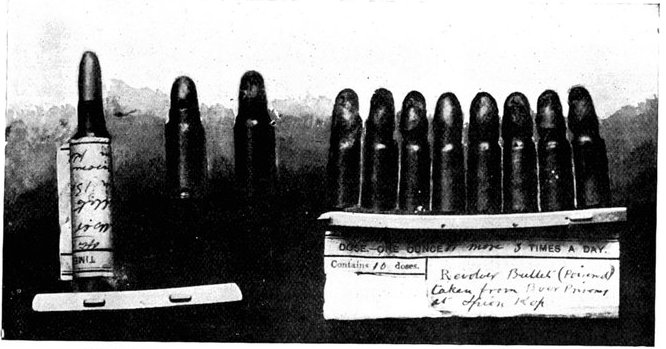
POISONOUS BULLETS TAKEN FROM A BOER PRISONER AT SPION
KOP.
These bullets have a coating of metallic oxide, which could not fail
to poison any wounds they might make. It is perhaps not necessary to
suppose they were intentionally poisoned, but the use of bullets in
such condition shows a callous and criminal disregard of the laws of
civilised warfare.
[Jan. 23, 1900.
Another council of war.
The morning of this day a fresh council of war was held, though
councils of war have ever been considered the refuge of the irresolute.
General Buller—Commander-in-Chief of the Natal army—"pointed out"
that for four days Sir Charles Warren "had kept his men continuously
exposed to[Pg 282] shell and rifle fire, perched on the edge of an almost
precipitous hill; that the position admitted of no second line, and
the supports were massed close behind the firing line in indefensible
formations," and that "it was too dangerous a situation to be
prolonged." But the Commander-in-Chief gave no orders; he only told
his subordinate either to attack or withdraw, and shrank from the
responsibility of making the decision himself. To use his own phrase,
he still "advocated" a turning movement by the left. But finally he
assented to the storming of Spion Kop—it was the second time this
question had been debated—though he thought General Woodgate better
suited for the work, inasmuch as General Coke was still lame from a
broken leg.
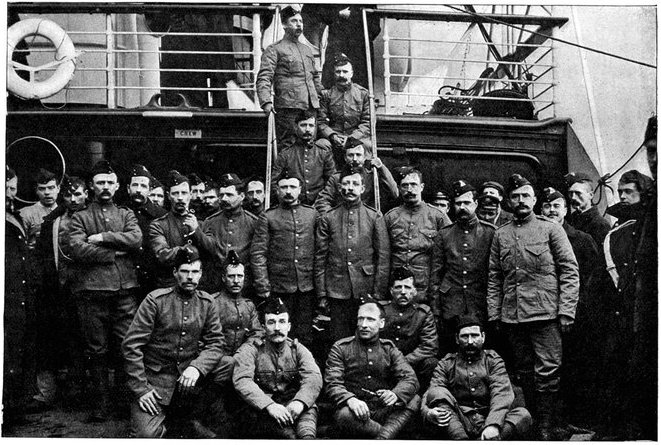
[Photo by the Absent Minded Beggar Corps.
THE 2nd LANCASHIRE FUSILIERS EMBARKING AT SOUTHAMPTON, December 2, 1899.
This battalion greatly distinguished itself under General Woodgate
in the "week of battles" leading up to the attack on Spion Kop, and
furnished the largest contingent for that bloody battle.
Warren reinforced.
Jan. 23, 1900.] The British Silently Ascend Spion
Kop.
Throughout this day the troops were exposed to a heavy shell fire,
which, without causing many casualties, was yet exceedingly galling,
and it grew hourly clearer and clearer that there were no other
alternatives but General Buller's "withdraw or assault." Steps were
taken to prepare for the attack on Spion Kop. Careful reconnaissances
were made, and the Imperial Light Infantry and other reinforcements
were added to Sir Charles Warren's command. From Chieveley, where
General Barton's Brigade had exchanged long-range fire with the Boers
on the 19th and 23rd, two battalions were withdrawn and added to
General Lyttelton's Brigade. In this direction nothing of importance
had happened. On the 19th a picket of South African Light Horse, while
scouting along the Tugela to the west of Colenso, had been ambushed by
the Boers and six men captured; on the 23rd a patrol near Hlangwane had
been surprised, but was able to make its escape. It was clear, however,
that the enemy were in no great strength at Colenso, so that the two
battalions left at Chieveley were ample to hold the rail-head. It is
now known that General Joubert expected the main attack at Potgieter's
Drift, and had concentrated most of his men opposite this point,
leaving his left at Colenso and his right beyond Spion Kop,[Pg 283] towards
Acton Homes, excessively weak. On the Spion Kop side, according to
Boer accounts, General Botha had but 2,000 men. The Boers persistently
understated their real force, but it is possible that their strength in
this quarter did not exceed 4,000.
The storming force.
At six in the evening the storming force paraded. It was composed of
eight companies of the 2nd Lancashire Fusiliers, six companies of
the 2nd Royal Lancaster, two companies of the 1st South Lancashire,
190 dismounted men of Thorneycroft's Mounted Infantry, and half of
the 17th Company of Royal Engineers—in all about 1,800 men. The
officers—General Woodgate himself—carried rifles. The orders were the
usual ones for night attack—no firing, but attack with the bayonet.
The night was favourable—intensely dark with a fine rain—but if
this concealed the approach of the forlorn hope from the enemy, it
added greatly to the difficulty of climbing the precipitous mountain.
Before the foot of the height was reached it was 10 o'clock. The
ground traversed up to this point had been rough in the extreme, steep
hillocks alternating with deep-cut watercourses and mimosa copses. Over
these the men blundered in the dark, taking every precaution to hide
their movements from the Boers. Smoking and talking were forbidden;
the little force picked its way in silence. All was still but for the
fitful sputtering of the rifle fire exchanged between the outposts,
which echoed in the mountain hollows on the left. The cannon on Three
Tree Hill were silent; the bivouacs and positions of the two combatant
armies were veiled in darkness. Only from Three Tree Hill came the
gleam of lanterns—the signals telling the column that all was well.
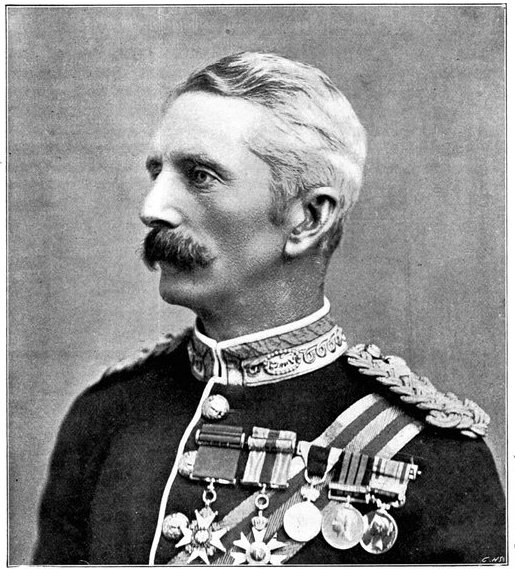
[Photo by Bassano.
MAJOR-GENERAL WOODGATE.
Edward Robert Prevost Woodgate, C.B., C.M.G., was a son of the Rector
of Belbroughton, Worcestershire. Born 1845; entered the Army as ensign
in the 4th (King's Own Royal Lancaster) regiment in 1865; served
with the Abyssinian Expedition against King Theodore, 1868; in the
Ashanti War of 1873-74; on the staff in the Zulu War of 1878-9, when
he obtained the Brevet of Major; served as staff officer in the West
Indies, 1880-5, and as regimental officer in India, 1885-89; promoted
Lieut.-Col., 1893; C.B., 1856; and Colonel, 1897; appointed to command
the Regimental District of the Kings Own at Lancaster, September,
1897; raised the West African Frontier Regiment in Sierra Leone, and
suppressed the native rebellion, 1898-9; invalided home and made
C.M.G., and given command of Leicestershire district. In December,
1899, he was appointed to the command of the Ninth Brigade in South
Africa; he led the assault on Spion Kop, and was killed while defending
the position gained upon that hill, January 24, 1900.
Ascent of Spion Kop.
[Jan. 23, 1900.
At this point began the real ascent of the mountain by an exceedingly
steep and narrow path, which worked up the almost precipitous slopes.
After a short halt, General Woodgate and Colonel Blomfield led the way,
in front of the Lancashire Fusiliers, and the whole force in Indian
file moved upwards with the utmost caution. The mountain side abounded
in boulders and brushwood, offering the best of cover for the enemy;
there were many points where the track, which was at best only a goat
path, ran along narrow ledges with a sheer[Pg 284] drop on the outside, and
here a single determined enemy might have caused heavy loss and even
defeated the assault. Along this difficult and tedious route crawled
the infantry in light marching order, expecting each moment to hear
among the rocks the crack of the Boer rifles. But no sound or cry of
alarm came, and, shrouded in obscurity, the forlorn hope slowly neared
the shoulder where was known to be one of the "mauvais pas" of the
mountain. Hereabouts a large white spaniel suddenly emerged from the
darkness, and discovery seemed certain. Yet the animal came quietly up,
and allowed a soldier to catch it, when it was promptly led to the rear.
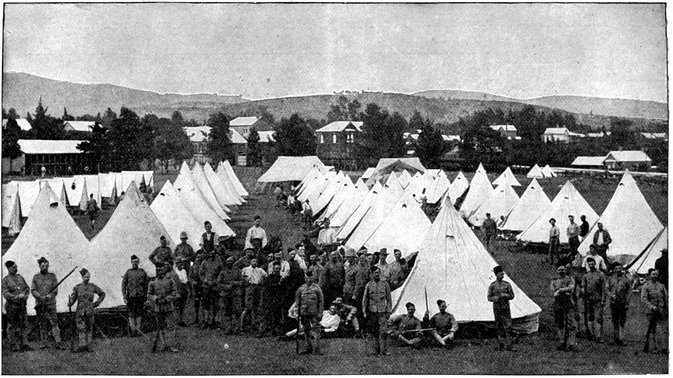
[Photo by Caney.
THORNEYCROFT'S HORSE IN CAMP AT PIETERMARITZBURG.
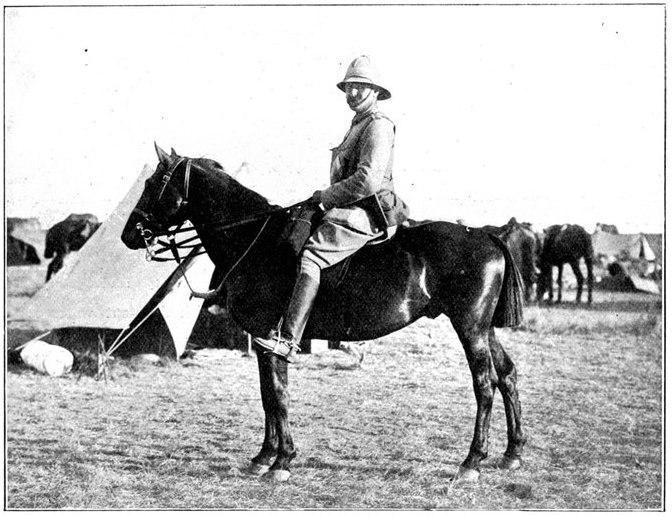
LIEUT-COL. (LOCAL BRIGADIER-GENERAL) THORNEYCROFT.
Lieut.-Colonel A. W. Thorneycroft, in command of Mounted Infantry in
South Africa, was born in 1859. He was originally in the Militia;
joined the Royal Scots Fusiliers in 1879; fought in the Zulu campaign,
and in the Transvaal War of 1881, when he defended Pretoria; was
appointed Deputy Assistant Adjutant-General in Natal in September,
1899, and formed the regiment of Irregulars which did service at
Colenso and Spion Kop. Colonel Thorneycroft is a brave and daring
leader and a great sportsman, and has trained his men to be excellent
scouts.
[Pg 285]
Jan. 24, 1900.] The Attacking Force Challenged.
Those who have clambered among our British hills—and better those
who know the Alps—will realise some of the perplexities of this
night ascent. At times the path was lost, and was recovered with
difficulty; no lantern could be used in awkward places, and the men
had simply to trust to luck and to the fidelity of the guides, helping
each other at every turn, and giving a hand at the points where the
way was dangerous. General Woodgate, who was in bad health and had
constantly to be assisted, was always in the very forefront. Progress
was necessarily slow, and the greatest care had to be taken to prevent
the men losing touch of each other. When the shoulder of the mountain
was reached, Colonel Thorneycroft deployed his men to the left, while
General Woodgate, with the Lancashire Fusiliers, took post in line on
the right. The most critical moment of the assault had come.
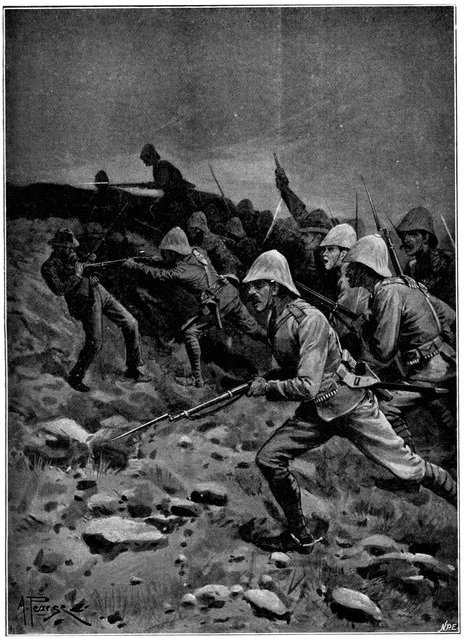
A. Pearse.] [After a sketch by Ernest Prater.
BAYONETING THE BOER SENTRY ON SPION KOP.
[Jan. 24, 1900.
A Boer picket surprised.
It was now half-past three of the morning of January 24—a day
hereafter to be one of dark memory in the British army. Impenetrable
blackness shrouded the summit of the mountain; a thick, wet mist
encompassed it, and hid from the sight of the expectant officers and
men the details of the strange new land upon which the forlorn hope had
debouched. It could be felt rather than seen that the shoulder opened
out to a plateau, which rose steadily towards the north, but how far it
extended was not known. From below it had appeared only a narrow ridge,
bounded on all sides, except that from which the night assault had been
delivered, by sheer precipices, and the utmost caution had to be used
in the obscurity, as at each step an abyss might open before the feet
of the advancing line. In the preternatural stillness which prevailed
upon the mountain top there was no token of the enemy's presence. No
outposts had been encountered; the only sign of life visible was when
from time to time the mist lifted, and far below and behind the lights
of Three Tree Hill could be discerned twinkling in the darkness. The
land seemed to lie lapped in sleep. And then suddenly the looked-for
challenge came. Out of the mist sounded the shrill cry of a man in
mortal terror.[Pg 286] It said in Dutch, "Halt! Who goes there?" Instantly
General Woodgate answered "Waterloo!" There was the flash of many
rifles, a rush, a scuffle, and the Lancashire Fusiliers were among the
Boers. It was only a weak picket, ten or fifteen men strong; the Boer
sentry was bayoneted at once; half-a-dozen others who had taken refuge
behind a stone wall were surrounded, and, though they made a gallant
stand, were overborne by numbers. In this fight Colonel À Court, of
General Buller's staff, had a narrow escape. Closing with one of the
enemy, he tried to use his Mauser pistol, but in this critical moment
found the safety catch was set, and had to snatch up a great stone,
with which he felled his opponent.
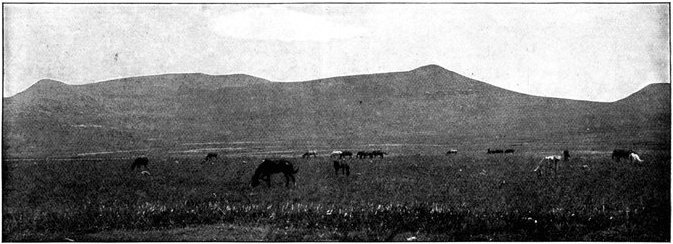
[Photo by Middlebrook.
GENERAL VIEW OF SPION KOP FROM ACROSS THE RIVER.
The storming force halts too soon.
This brush with the Boers took place a little south of the real summit,
at a point where stood a grove of mimosa bushes, and where there was
fair cover. But from this point onward no difficulty was encountered;
the slope relented; the ridge opened out into one of those table-lands
which are a feature of South African mountain scenery. Breathless and
weary, the men pushed forward without any opposition, their movements
veiled in the mist through which the first grey light of dawn was
now breaking. They stood upon "a fog-bound island in the air." The
plateau, 400 yards wide, seemed to trend away interminably to the
north-east. And here the first great mistake, as after events proved,
was committed. Instead of pushing on to the uttermost extremity of the
summit, the forlorn hope halted about 5 a.m. at a Boer trench which was
captured without episode. Possibly the troops, wearied by their seven
hours' climb in the darkness, were incapable of any further desperate
effort. They must needs be prepared to maintain their position
throughout the day—a day which might well be one of the fiercest
fighting—and so rest was essential.
Some attempt was made to provide cover while the mist still veiled the
mountain top. Yet, by reason of this very mist, the exact position of
the enemy could not be ascertained or the defences constructed where
they were most needed. The surface of the hill was not favourable to
entrenching; it was of rock, friable indeed, but not to be cut with
spades, and the covering of earth was of the thinnest. Perhaps the
weariness of the infantry and the want of sufficient entrenching tools
would have precluded the construction of serious defences even had the
ground been wholly favourable. The men were in no condition to set to
work as navvies. All these things must be remembered when it is asked
why the troops did not entrench themselves. Here, as at Majuba, the
omission was fatal; here, as there, the same explanation will suffice
for the neglect of so obvious a precaution. What trenches were made
were only scratched in the thin soil, a few inches deep, and though
serviceable enough against rifle fire, were utterly ineffectual against
artillery. Stones to build breastworks were wanting; there were many
boulders on the summit, but these were too large to be moved. The Boer
works were remodelled as well as was possible under the circumstances.
This done, the little force waited for the lifting of the mist, when
the ordeal of battle would begin, and when for the first time the exact
situation could be discerned.
[Pg 287]
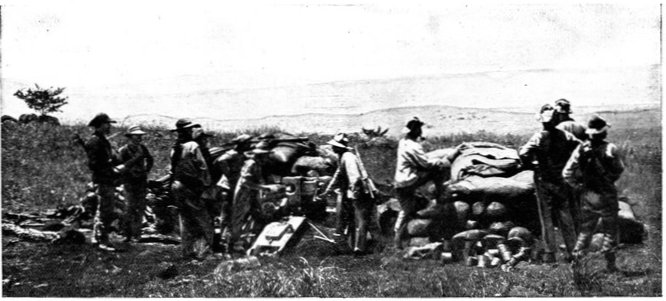
BOERS FIRING A KRUPP HOWITZER.
The photograph was taken outside Ladysmith; guns and gunners were
removed to Spion Kop when Warren developed his attack.
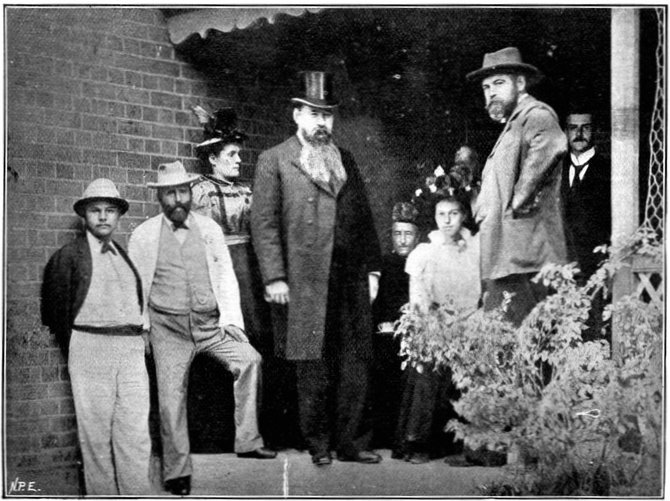
[From a photograph taken at Newcastle Station.
PRESIDENT STEYN'S VISIT TO NATAL.
Jan. 24, 1900.] The Attacking Force not Promptly
Supported.
Tardy reinforcements.
[Jan. 24, 1900.
Far below, the main body of the British army had heard the rattle of
the Boer outposts' first volley and the sound of cheering, succeeded
by silence, which told that the summit was won. As the dawn broke they
prepared for another day of battle, supposing that this achievement
would be followed by a general assault upon the enemy's positions. But
reinforcements were not promptly sent to join the forlorn hope in its
cloudland. No attempt was made to push artillery up to its support;
the mountain battery, which was with the army for this special work,
was not sent forward—and it is possible that its weak short-range
pieces firing smoke-producing powder would have been only a source
of embarrassment and loss. The way was so steep that it was doubted
whether heavier guns could be sent up. Already there was evident that
same want of energy and determination to conquer at all costs which
had exerted such a detrimental influence on the fighting of the past
week. From out of the mist could now be heard the occasional crack of
rifles, indicating that the outposts on the mountain were exchanging
shots. It was clear[Pg 288] that the enemy had not fallen back, but was, on
the contrary, prepared to dispute the very possession of Spion Kop.
Botha determines to recapture the hill.
Meantime, the remnants of the Boer picket had reached General Botha's
headquarters and given the alarm. With quick decision and judgment,
which proved his capacity, the General ordered that the mountain should
be recaptured at all costs. It was the key of the position, unlocking
the door to Ladysmith. Through the mist horsemen sped to the camps of
the commandos, bidding them ride hard to the rescue. From all points
the Boers began to stream along the ridges which meet at Spion Kop,
and prepared to assault in their turn, encouraged by President Steyn,
who was present upon the field in person. Their cannon, four Krupps
or Creusot weapons, one at least of heavy calibre, and four or five
"Pom-Poms" were trained in readiness for the mist to lift, to shower
death and destruction upon the forlorn hope. A party of forty men
worked forward along the ridge, and, even before the sun dispersed the
clouds, opened a sniping fire.
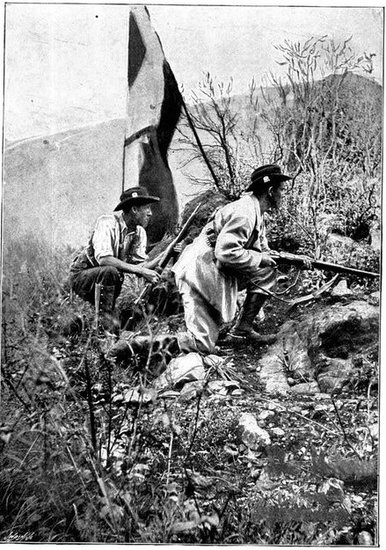
[From a photograph.
TWO OF THE DEFENDERS OF SPION KOP.
Positions of the opposing forces.
Jan. 24, 1900. The Boers Bombard Spion Kop.
As the sun came through the mist, bringing the certainty of a fiercely
hot day, the British garrison could at last perceive the real
situation. The summit of Spion Kop had been but half occupied; the
northern end was in the hands of the Boers, who held a trench upon it.
Moreover, the table-land on the summit sloped down to the north, and
lay open to the enemy's fire from kopjes, rising from the long mountain
ridge, which surrounded it on three sides. The ridge forked at Spion
Kop, whose summit thus formed a projecting natural bastion; one line of
heights ran up to the north-west in the direction of Acton Homes—the
line of heights which Sir Charles Warren's infantry had assailed day
after day—another ran due eastward, prolonging the Boer positions in
front of Potgieter's Drift. The British force on Spion Kop was thus
most critically placed. It had no guns, yet it was exposed in the
closest of formations to gun fire; reinforcements could only reach it
by a long and arduous climb, whereas the Boers, by pushing their men
along the ridges which they held, could arrive comparatively fresh; it
could be attacked from every side except the south by a converging and
enfilading fire; its cover was all but useless, for it was now seen
that the trenches faced in the wrong direction. Added to this there was
the curious want of attention to detail which had neglected the laying
of a field telegraph so as to connect the summit with headquarters;
a want of oil for signal lamps; and a paucity in the numbers of
heliograph-operators and flag-signallers with the forlorn hope. This
neglect of the means of communication disastrously affected the
operations at every turn. Generals Warren and Buller did not know what
was happening on the summit, and never went there to see.[Pg 289]
The British artillery, if report can be believed, fired repeatedly on
the British troops, through inadvertence and ignorance of the precise
positions occupied. Finally, when uncertainty as to who was in command
on the mountain arose, it could not be immediately solved by an appeal
to headquarters.
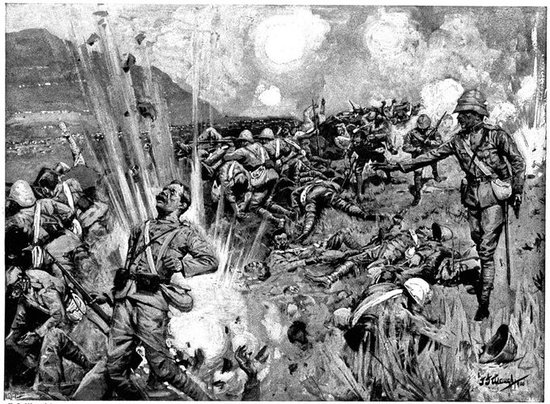
F. J. Waugh.]
THE FIGHT ON SPION KOP.
This drawing is based on a Boer photograph taken on the spot
immediately after the battle. The concentrated fire of the enemy was so
terribly effective that our men were compelled to shelter themselves
behind the dead bodies of their comrades.
The Boers bombard the British position.
From the British position on Three Tree Hill a breathless watch had
been kept on the clouds that veiled the summit. As the fleecy whiteness
was dispersed about 8 o'clock, the roll of musketry began. At the same
time the artillery opened fire, the naval guns shelling two precipitous
kopjes which rose just to the east of Spion Kop, while the field guns
on Three Tree Hill thundered at the western ridge. The Boer guns had
already broken silence and commenced a furious bombardment of Spion
Kop, raining shells upon General Woodgate's force. Simultaneously the
Boer marksmen in small parties poured in a deadly rifle fire from
the kopjes on the three sides of Spion Kop; they began, too, to work
towards the British trenches, taking all possible advantage of cover.
All the early morning men were pouring in, and the assailants grew
steadily in strength. The crackling of the rifles swelled into a heavy
and continuous roar, and upon the portion of the mountain held by the
British, shell, 94 lb., 15 lb., 12 lb., and 1 lb. in weight, fell at
the rate of seven to ten a minute, throwing up dense clouds of dust,
blowing human beings into unrecognisable fragments, inflicting the most
ghastly wounds, terrifying those whom they did not slay. A cyclone
of death had smitten the summit. No words can describe the appalling
uproar and confusion; all around the thunder of the guns and the
incessant roar of rifles; on the summit clouds of dust and the yells
and oaths of the combatants; the groans of the wounded; the shrieks of
the dying—man slaying man with every terrible circumstance that the
imagination can picture.
[Jan. 24, 1900.
Woodgate wounded.
Under the stress of this terrible fire the British infantry held firm,
Thorneycroft's volunteers on the left, Blomfield's Lancashire Fusiliers
on the right. If a man showed his head or lifted his arm he was[Pg 290] as
good as out of the battle; so deadly, so overwhelming was the Boer
fire, that he was sure to be hit. From the summit already trickled a
steady stream of men towards the rear—towards the point where among
the mimosas a hospital had begun its merciful work. With the wounded
were a few unwounded—stragglers and skulkers—but not many. The
British soldier in these dreadful moments is rarely untrue to the call
of duty. He was at a grave disadvantage, for the rifle with which he
was armed was awkward to load lying down; the Boer weapon with its clip
holding five cartridges could be charged easily in a second or two. It
may be that this was a trifle, but none the less the defect made its
presence felt. So fierce, so breathless was the battle that no one had
time for thought. From general to private on the summit the one concern
was to hold the ground, to beat back the enemy, who came on like
demons, to fling the dead from the trenches, and to remove the wounded.
Here, as in the earlier battles of the war, there were some wonderful
escapes. Colonel Thorneycroft, a man of great stature and extraordinary
personal courage, was always upright among his men—always a mark for
the enemy's bullets, which tore and riddled his clothing, but, strange
to say, left him unharmed. General Woodgate had set a splendid example,
walking coolly to and fro till, some time before 10 a.m., he was struck
in the eye, while watching through his glass the effect of the British
fire, and mortally wounded. He was borne off the field murmuring, "Let
me alone! Let me alone!"
"It was as though hell had been let loose," was the concise description
of a wounded officer. From below the sight was dreadful enough. "I
saw three shells strike a certain trench within a minute," writes Mr.
Atkins; "each struck it full in the face, and the brown dust rose and
drifted away with the white smoke. The trench was toothed against the
sky like a saw—made, I supposed, of sharp rocks built into a rampart.
Another shell struck it, and then—heavens!—the trench rose up and
moved forward. The trench was men; the teeth against the sky were men.
They ran forward bending their bodies into a curve, as men do when they
run under a heavy fire; they looked like a cornfield with a heavy wind
sweeping over it from behind.... They flickered up, fleeted rapidly and
silently across the sky, and flickered down into the rocks without the
appearance of either a substantial beginning or end to the movement."
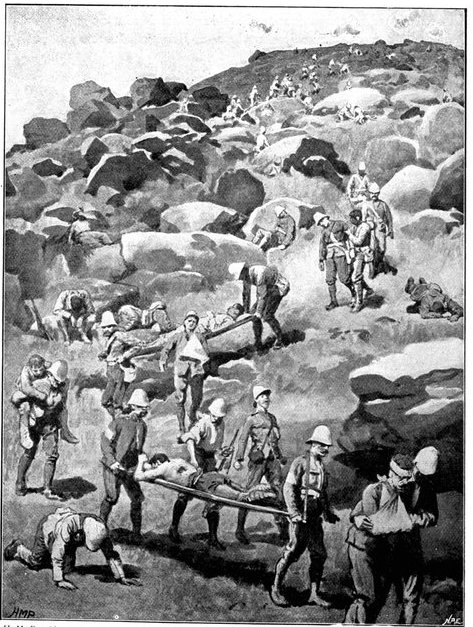
H. M. Paget.] [
From a sketch made on the spot.
A LONG LADDER OF PAIN.
Bringing down wounded men from Spion Kop.
[Pg 291]
Jan. 24, 1900.] Confusion of Commands.
Thorneycroft put in command.
The Boers suffered heavily in their turn, but not so heavily, as they
were in open formation, with better shelter, and out of sight of the
British gunners. They had not to face the fearful shell fire which made
of the British position a veritable shambles. As they gained ground and
were able to enfilade one of our most advanced trenches, the situation
grew more and more critical. Colonel Crofton, of the Royal Lancasters,
upon whom the command had now devolved by seniority—General Woodgate
having fallen—was greatly alarmed. Towards 10 o'clock he heliographed
to headquarters this startling message: "Reinforce at once or all lost.
General dead." It was clear that a crisis had arrived demanding every
effort. Sir Charles Warren replied by ordering up General Coke with
the 2nd Middlesex, 2nd Dorsetshires, and Imperial Light Infantry—the
last a volunteer battalion raised at Durban, which was now to have
its terrible baptism of fire—and by a message that Colonel Crofton
must hold out to the last and must not think of surrender. But Colonel
Crofton's words had roused the uneasiness of General Buller, who from
Spearman's Hill was watching the battle. Apparently unaware that
General Coke was on the way up, he telegraphed to Sir Charles Warren at
Three Tree Hill—"Unless you put some really good, hard-fighting man in
command on the top, you will lose the hill. I suggest Thorneycroft."
General Warren complied with his Commander-in-Chief's "suggestion."
Colonel Thorneycroft was appointed to command, "with local rank of
Brigadier-General." Thus the confusion was made worse, as half the
men on the top and most of those on their way up were unaware of this
change. It was as at Sedan, where, in the space of a few hours, there
were three commanders, with fatal results.
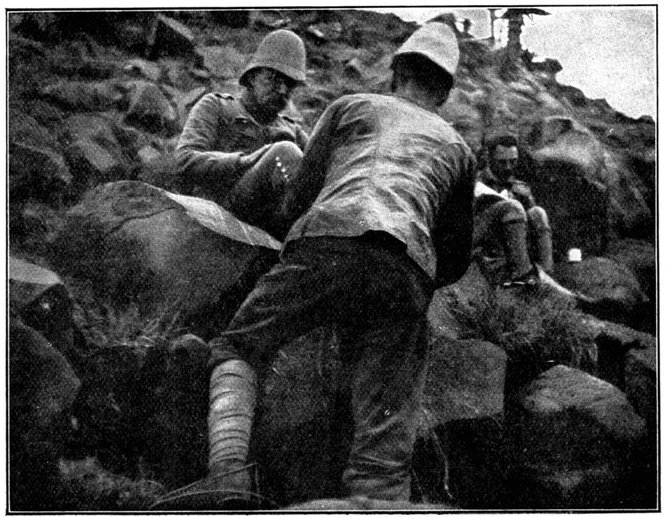
[From a photograph.
GENERAL SIR CHARLES WARREN GIVING INSTRUCTIONS DURING THE SPION KOP
FIGHT.
General Warren was having a slight wound bound up when the photograph
was taken.
Besides the Middlesex Regiment, the Dorsets, and the Imperial Light
Infantry, who had earlier in the morning moved up to the head of
the valley dividing Three Tree Hill from Spion Kop, and who were
now sent up to the actual summit of Spion Kop, other help had been
despatched. With a soldierly intuition which did him infinite credit,
General Lyttelton at Potgieter's Drift had seized the extremity of the
emergency and had directed the 2nd Scottish Rifles to cross at Kaffir's
Drift, above Potgieter's, and advance up the southern slope of the
mountain. Yet, as the distance to be covered was great, it was not till
late in the afternoon that they reached the scene of action. Further to
the left Generals Hart and Hildyard made as though they, too, intended
to assault the positions opposed to them, and had they been permitted
so to do, it is certain that much of the pressure would have been taken
off the forlorn hope on Spion Kop. However, a sharp fire was exchanged
with the Boers, and then these two brigades fell to watching and
waiting, unable to aid their comrades who were fighting for dear life
on that grim summit. They could see the human anthill on the sky-line
in confusion; tiny figures running to and fro; other figures with the
gesture of command rallying the rout and restoring order. Instinctively
they realised the tremendous gravity of the struggle.
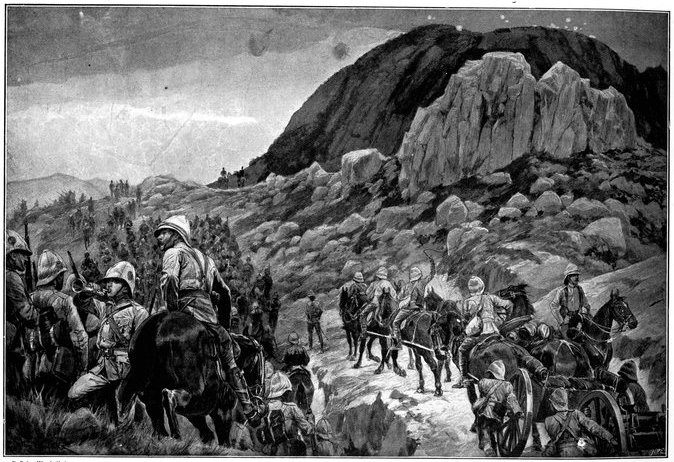
R. Caton Woodville.]
REINFORCEMENTS FOR SPION KOP.
It was not until the night of the 24th that an attempt was made to get
guns to the top of the hill. It was then too late; the hill had been
abandoned, and the shattered remnants of the British force were already
descending.
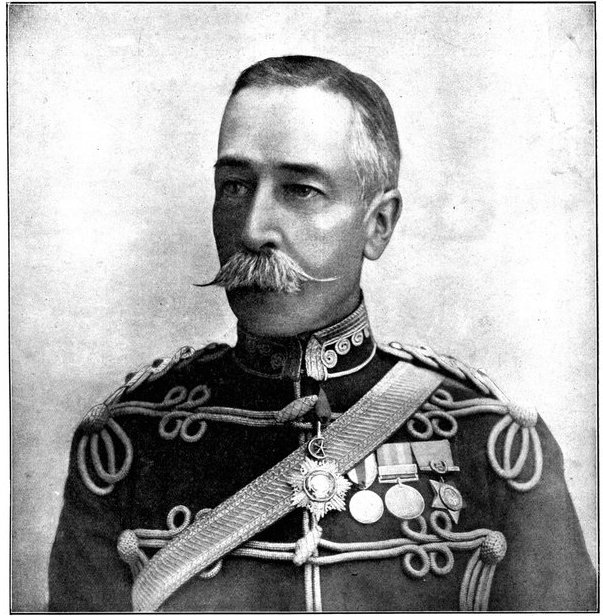
[Photo by Wyrall & Son, Aldershot.
MAJOR-GENERAL COKE.
John Talbot Coke was educated at Harrow; entered the Army as 2nd
Lieutenant in the 21st Foot in 1859, and was transferred to the 25th
Foot (afterwards named the King's Own Scottish Borderers) in 1860;
Captain, 1866; Major, 1879; Lieutenant-Colonel, 1885; Colonel, 1889;
was put on half-pay, 1898. He served with the Suakin Field Force in
1888 during the investment of Suakin; was present in the engagement
of Gemaizah; served in the operations on the Sudan frontier in 1889;
was appointed senior officer at Mauritius in 1898, with local rank of
Major-General, and left there to command the 10th Brigade of the South
African Field Force, 1899.
Jan. 24, 1900.] Thorneycroft allows no Surrender.
A frightful struggle.
[Jan. 24, 1900.
As the morning wore on, the fight on the summit grew fiercer and
fiercer. Fresh troops were continually arriving, for in the daylight
the climb was not so excessively difficult, till the small space was
packed with men. Just before the first reinforcements came up there was
a moment when [Pg 292]
[Pg 293]disaster was narrowly avoided. The British force in
one of the outlying trenches was demoralised by its losses and by the
fire. About twenty men threw up their hands and shouted that they would
surrender to the Boers not a hundred yards away. On this, says Mr.
Winston Churchill, Colonel Thorneycroft dashed to the spot. "The Boers
advancing to take the prisoners—as at Nicholson's Nek—were scarcely
thirty yards away. Thorneycroft shouted to the Boer leader: 'You may go
to——! I command on this hill and allow no surrender. Go on with your
firing.' Which latter they did with terrible effect, killing many. The
survivors, with the rest of the firing line, fled 200 yards," but then
were rallied and regained the lost ground. It was owned by the Boers
themselves after the battle that the British soldiers had "fought with
desperate bravery and died like men." Despite the disadvantage of the
ground, despite the tremendous bombardment, they could not and would
not be forced back. The heaps of dead grew higher; an[Pg 294] awful breastwork
of corpses was built to shelter the living; the trickle of wounded to
the rear became a stream; but the fight flickered to and fro and the
summit was still held.
Lack of artillery support.
From the shoulder of the hill by the mimosas, where the maimed men
crowded in a heart-rending throng round the dressing station, the
reinforcements emerged upon that bare plateau of death. There were now
the best part of 5,000 men, crowded into an area of little over three
acres. But no guns came, though all looked long and eagerly for them.
A couple of "Pom-Poms," a pair of 15-pounders, would have restored
confidence by their roar. But there were no "Pom-Poms" with the army,
and the artillery officers could not undertake to move their guns up
to the height by the precipitous track. It only remained to suffer and
die. In that atmosphere, thick with the fumes of cordite, of melinite,
and of the powder in bursting shells, suffocating with smoke and dust
and heat, the burning thirst of the battlefield laid its parching grip
upon the throats of the combatants, and men cried and screamed for
water. Yet water there was none, or, if there had been, there was no
time to seek it, and no chance of carrying it alive into the firing
line. Units were now commingled, companies confounded with companies,
battalions with battalions; so many officers were down that there were
few to lead and inspire the men in the fighting line. About 2 p.m. a
white flag was raised over part of the British trenches, and 150 of
the 2nd Lancashire Fusiliers under Captain Freeth surrendered. In this
battalion the losses of officers had been terrible, and the consequent
demoralisation great. Among those who fell was the ill-fated son of
Hicks Pasha, Captain Hicks. Blown to pieces by a shell, while bravely
leading his men, no trace of him could be found, and his fate was for
months uncertain.
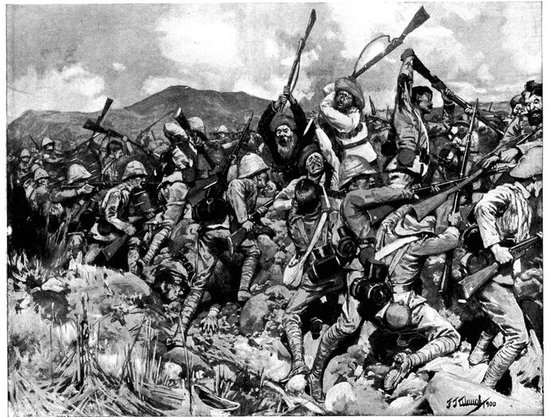
F. J. Waugh.]
THE BRITISH TROOPS MEETING A BOER RUSH ON SPION KOP.
Jan. 24, 1900.] An Officer's Experiences in the
Battle.
Boer attempts to rush the position.
The rifle fire of the British troops was so shaken by the hail of
shells, that the Boers were able repeatedly to close, and were only
driven back time after time by desperate bayonet charges. They[Pg 295] had
set their hearts upon repeating Majuba, and capturing or driving back
in utter rout the British troops. Again and again their leaders called
upon our men to surrender, and were received each time with derisive
shouts, though some small parties raised the white flag. They asserted,
indeed, that our officers slashed the men with swords to make them
fight—a story which is disproved by the fact that, like the men, the
officers carried rifles; and they further accused us of firing upon
those who had been made prisoners. There may have been such incidents,
but not through any set purpose or with the fixed deliberation which
attended their own too frequent breaches of the laws of war.
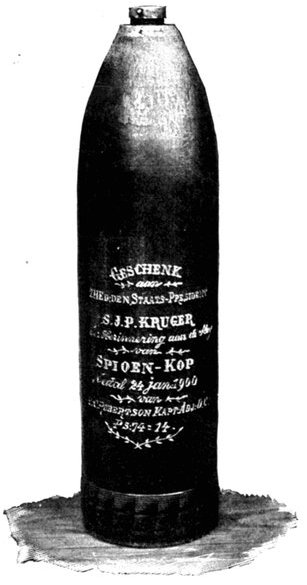
LYDDITE SHELL FROM A BRITISH NAVAL GUN.
Fired at Spion Kop and not exploded. Presented by the finder to
President Kruger.
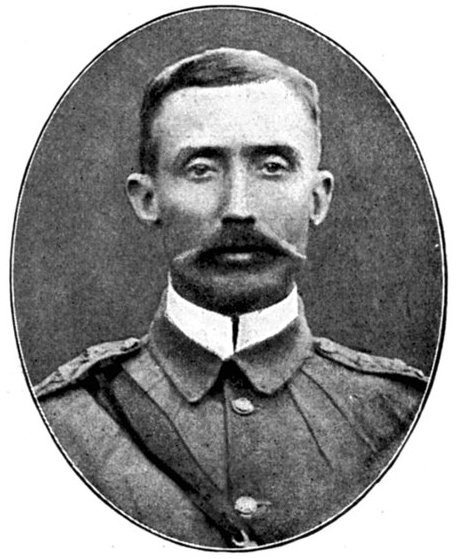
CAPTAIN HICKS.
Killed at Spion Kop. Was the son of Hicks Pasha, the unfortunate
General who, with all his forces, was massacred in the Soudan, Nov.
1883.
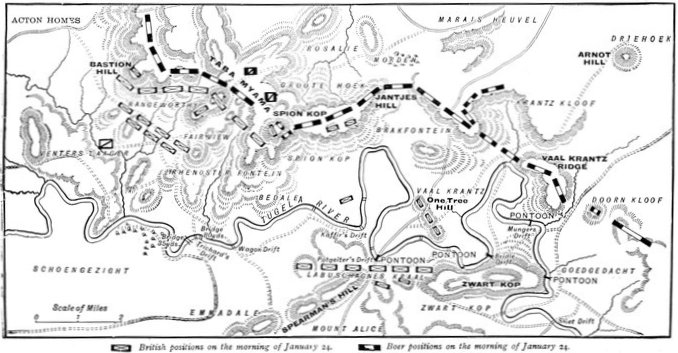
MAP OF THE BATTLE OF SPION KOP.
Partly based, by permission, on the map in Mr. Winston Churchill's
"London to Ladysmith via Pretoria."
[Jan. 24, 1900.
The personal story of a wounded officer of the 2nd Middlesex is
worthy of repetition, as it gives a clear account of the afternoon's
battle. "I crawled," he says, "a little way with half my company, and
then brought up others in the same manner. The men of the different
regiments already on the hill were mixed up, and ours met the same
fate. It was impossible, under the circumstances, to keep regimental
control. One unit merged into another; one officer gave directions
to this or that unit, or to another battalion. I saw some tents on
the far side of the hill to our front, and knowing the enemy must be
there, opened with volleys at 1,800 yards, when we saw a puff of smoke,
indicating that one of the Boer guns had just fired. We lay prone,
and could only venture a volley now and again, firing independently
at times when the shower of bullets seemed to fall away, and the
shells did not appear likely to land specially amongst us. Everywhere,
however, it was practically the same deadly smash of shells, mangling
and killing all about us. The only troops actually close to me then
were a party of the Lancashire Fusiliers inside a schanze, F Company
of the Middlesex, and a mixed company of other troops[Pg 296] on the left
front. A good many shells from the big guns burst near us, and a
lance-corporal of the Fusiliers was killed. The only point I could see
rifle fire proceeding from was a trench, the third, I believe, occupied
by our troops on the right, and looking towards Spearman's.
"Presently I heard a great deal of shouting from this trench, in
which were about fifty men. They were calling for reinforcements, and
shouting, 'The Boers are coming up.' Two or three minutes afterwards, I
saw a party of about forty Boers walking towards the trench. They came
up quite coolly; most of them had their rifles slung, and all, so far
as I could observe, had their hands up. Our men in the trench—they
were Fusiliers—were then standing up also, with their hands up, and
shouting, 'The Boers are giving in, the Boers are giving in.' I did
not know what to think, but ordered a company of my regiment to fix
bayonets. We waited to see what would happen. Just then, when the
Boers were close to the trench, someone—whether an enemy or one of
our men—fired a shot. In an instant there was a general stampede, or
rather a mêlée, my men rushing from their position and charging,
while the Boers fired at the men in the trench, knocking several back
into it dead. Previous to this, a Boer came towards me saying, 'I won't
hurt you.' He looked frightened, and threw down his rifle. Immediately
afterwards a Boer fired, and there was a frightful muddle. I fired
at one Boer, and then another passed. We were fighting hand to hand.
I shot the Boer and he dropped, clinging, however, to his rifle as
he fell, and covering me most carefully. He fired, and I fell like a
rabbit, the bullet going in just over and grazing the left lung. I lay
where I fell until midnight. Subsequent to my being hit, parties of
Boers passed twice over me, trying on the same trick, holding up their
hands, as if they were asking for quarter. But our men refused to be
taken in again, and fired, killing or driving them back." Thus it would
seem that the Boers were guilty of acts even more questionable than
those with which they charged our men.
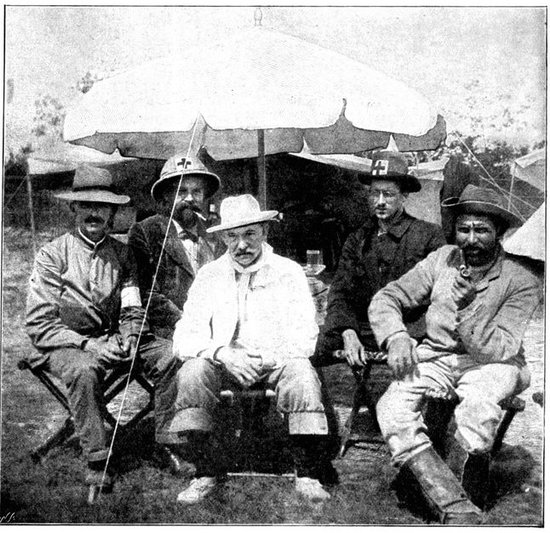
BOER DOCTORS AND AMBULANCE.
Early in the afternoon the Scottish Rifles arrived, and were at once
thrown into the firing line. They served to defeat the last determined
Boer attempt to rush the position, replacing the shattered fragments
of the Lancashire Regiments. At the same time mules came up with a
supply of ammunition, which had been running low, and with a certain
amount of water, which was served out to the wounded. The most critical
moment had passed, though the murderous shell fire still continued. So
determined were the Boer rushes that at times the enemy came within
thirty yards. Yet, as the day went on, and the sun began to sink,
ground was distinctly gained.
[Pg 297]
Jan. 24, 1900.] Lyttelton's Attempt to Divert the
Enemy.
The King's Royal Rifles storm a ridge.
A second move of General Lyttelton's unquestionably contributed to the
repulse of the Boers. Again, of his own initiative, he sent his finest
battalion, the 3rd King's Royal Rifles, to assail the eastern face
of Spion Kop. They marched by way of Kaffir's Drift, direct upon two
precipitous kopjes which rose from the ridge a mile or so from the main
summit, the left half battalion upon the western, and the right half
battalion upon the eastern kopje. The resolute skill with which they
went forward is described as the most splendid feat of the day. The
Boer trenches succeeded one another, line after line, along the slope
of the ridge; line after line they were carried with swift rushes.
Repeated charges with the bayonet were made, but the enemy always fell
back before coming to hand-grips. The attention of the Boers being
mainly concentrated upon Spion Kop, the Rifles were not opposed with
the fierceness that might have been expected; yet their advance was by
no means bloodless. They left on the field some seventy or eighty men,
but about 5 p.m. they effected a lodgment on the crest, and stormed
the two kopjes. At this point, unhappily, they began to suffer from
the fire of the British artillery on Three Tree Hill, which, unaware
of their success, burst several shrapnel over them. Their position was
isolated—between them and Spion Kop intervened a deep valley—and it
was difficult to support them fully. They were, therefore, recalled
from the heights they had won as evening drew on. They fell sullenly
back, indignant at being called off just when it seemed to them that
success was within their grasp; yet, in the light of after events, it
was fortunate that they were not left at their post of peril. "We were
wild at getting the order to retire after getting right up to the top,"
writes one of the King's Royal Rifles. "We had to come down again in
the dark, nearly breaking our necks, falling over rocks and down into
deep holes. I did not get back to our camp till 6 o'clock the next
morning. I had been sitting all night with a chap that had got wounded,
but I had to leave him in the morning, or I should have got captured by
the Boers."
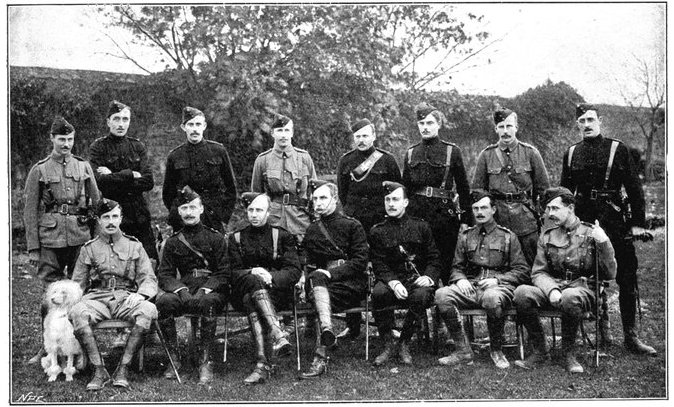
OFFICERS OF THE THIRD KING'S ROYAL RIFLES, WHO SERVED IN
LYTTELTON'S BRIGADE AT SPION KOP.
Col. Buchanan Riddell, commanding, sits in the centre of the group,
with the Adjutant, C. W. Wilson, on his right. Colonel Buchanan Riddell
was killed on January 24.
[Jan. 24, 1900.
Desperate straits.
Throughout the afternoon few messages and few signals had come from the
summit of Spion Kop. The heliographs were shattered by the Boer fire;
the flag signallers were struck down by the hail of bullets. Heliograms
from Sir Charles Warren asking what the situation was remained[Pg 298]
unanswered. It was even doubtful whether General Coke or Colonel
Thorneycroft was in command. Some time in the afternoon a report came
in from General Coke couched in the most ominous terms. It stated that
unless the British artillery could silence the Boer guns, it would
be impossible for the force to endure another day on the summit, and
described the situation as most critical. The report was fully borne
out by the personal information of the war correspondent, Mr. Winston
Churchill, who had made his way to the top, passing on his climb some
hundreds of wounded or dying men. "Streams of wounded," he wrote,
"met us and obstructed our path. Men were staggering along alone, or
supported by comrades, or crawling on hands and knees, or carried on
stretchers. Corpses lay here and there.... There was, moreover, a small
but steady leakage of unwounded men of all corps. Some of these cursed
and swore. Others were utterly exhausted, and fell on the hillside in
stupor. Others, again, seemed drunk, though they had had no liquor.
Scores were sleeping heavily.... We were so profoundly impressed by the
spectacle and situation that we resolved to go and tell Sir Charles
Warren what we had seen.... One thing was quite clear—unless good and
efficient cover could be made during the night, and unless guns could
be dragged to the summit of the hill to match the Boer artillery, the
infantry could not, perhaps would not, endure another day. The human
machine will not stand certain strains for long."
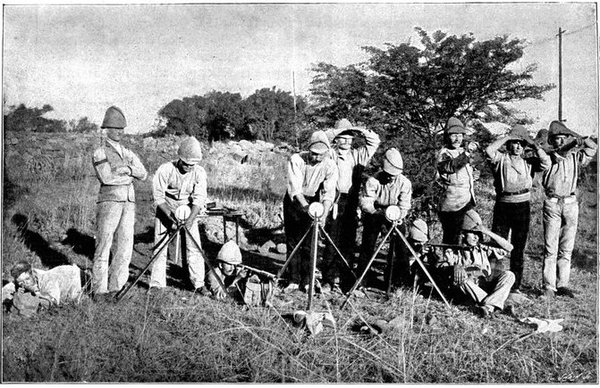
THE HELIOGRAPH.
The photograph represents the heliographs signallers in the besieged
town of Ladysmith communicating with Buller's relief column.
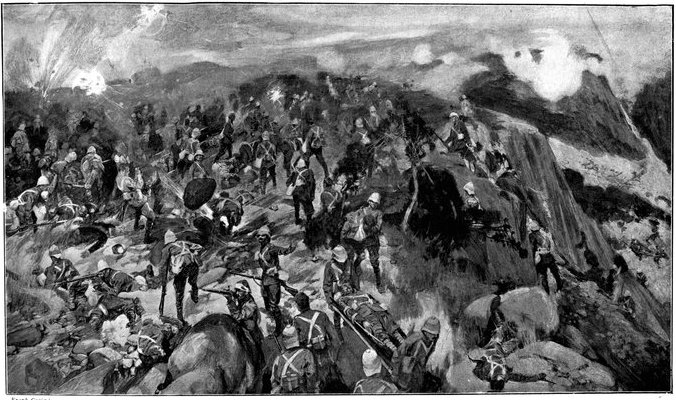
Frank Craig.]
SPION KOP DURING COLONEL THORNEYCROFT'S DEFENCE.
Confusion of commands.
[Jan. 24, 1900.
News so disquieting proved the need for the most determined
effort—even for the presence of General Warren in person upon the
mountain, when all doubts as to who was in command would have been set
at rest, and the dispirited troops reassured by the presence of their
real leader. Instead of going, General Warren signalled to General
Coke to withdraw all but two battalions from the summit, placing the
men thus withdrawn under what shelter the southern slope afforded, and
directed General Coke to come in person and confer with him. General
Coke, unaware that Colonel Thorneycroft had been appointed to command,
handed over his charge to Colonel Hill of the 2nd Middlesex, as Colonel
Crofton, the next officer in point of seniority, had already been
wounded. Thus was confusion worse confounded, [Pg 299]
[Pg 300]and the uncertainty as
to who was really in command further increased. There was no one in
authority; no officer of high rank was there to reorganise the defence
and cheer the men; no general to think of the future as well as of the
moment. Colonel Thorneycroft, who was actually directing the fighting
line, where his conduct was superb, could spare not a moment from the
vehemence of the conflict. Worst of all, he did not know that at last
guns and sandbags were coming up, with a large number of engineers to
complete the entrenchments.
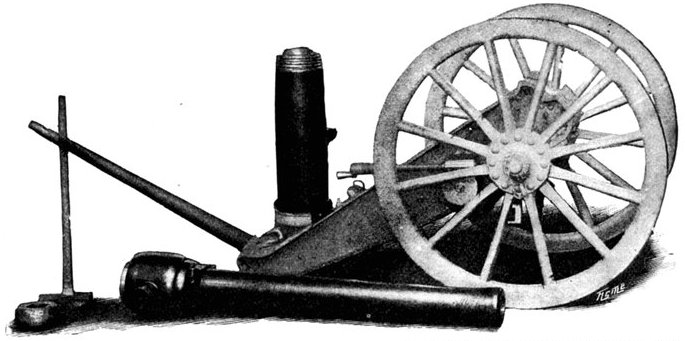
[Photo by Sir W. Armstrong, Whitworth & Co.
7-POUNDER MOUNTAIN GUN.
Showing how the gun itself takes to pieces. The wheels can also be
quickly taken off the carriage for transportation, as shown in the
illustration on page 249.
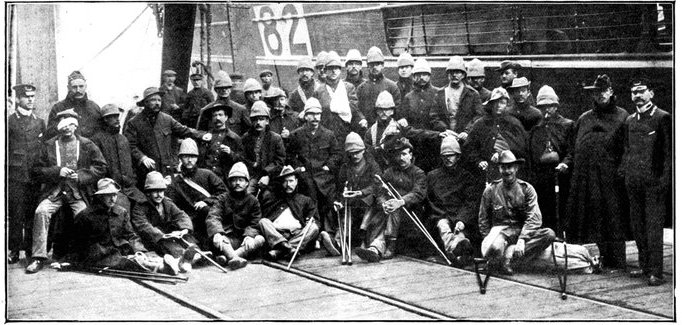
[Photo by Miell & Ridley, Bournemouth.
SOME OF THE WOUNDED FROM SPION KOP AND COLENSO.
Photographed on their return to England.
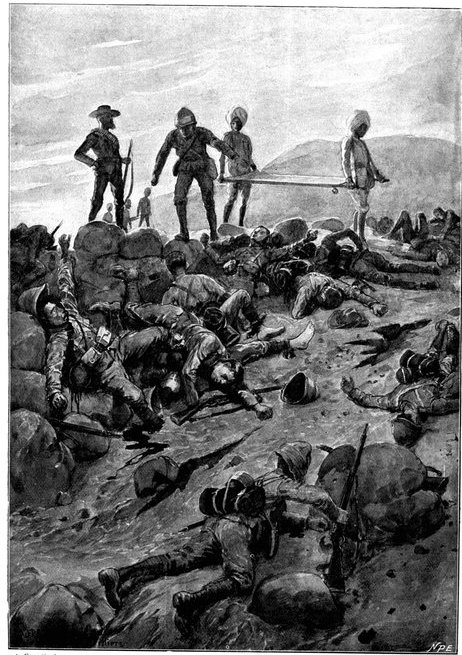
A. Forestier.] [After a sketch by Fred. Villiers.
DAWN ON SPION KOP: SORTING THE LIVING FROM THE DEAD.
Jan. 24, 1900.] Victory Hangs in the Balance.
It is said by Mr. Churchill that the artillery officers when questioned
as to the practicability of moving guns up to the summit, replied
that it was impossible, and that even if the guns could be got there
they would be shot to pieces. Lieutenant James, of the Royal Navy,
however, the officer in charge of the naval guns, replied that he
could go anywhere, or at least make the attempt. Accordingly, two of
his 12-pounders and the Mountain Battery were ordered to leave for the
top. It is Mr. Churchill's opinion that the path was impracticable
for field guns, and, as we have often seen, the British mountain guns
were of such a pattern and so short-ranged that they could have done
nothing against the Boer Krupps, Creusots, and "Pom-Poms." So that,
after all, little was lost by failing to send up guns earlier. The
movement of the guns did not begin till darkness was closing down. The
crackle of rifles still proceeded from the summit of Spion Kop, but the
heavy, incessant bombardment had now abated. Truth to tell, the Boers
were in the most grievous discouragement. If we had suffered, they had
suffered too. All their artillery fire had failed visibly to shake our
soldiers' grip on the hill; from the rear of their firing line, as from
ours, there was a procession of unwounded but faint-hearted men. Their
numbers were less than ours, and their men were worn out with incessant
fighting. As night fell, the signs of an imminent[Pg 301] retreat were clearly
manifest to observers in the Boer rear, at Ladysmith. The garrison made
no effort to harry the enemy or precipitate the decision; weakened by
hunger, it could only watch from a distance the terrific contest on
which its fate hinged—watch and pray. As hour followed hour, it saw
shell and shrapnel burst; saw the scurry of tiny figures on the summit
of Spion Kop; saw, too, the victorious advance of the Rifles; saw the
flight of large parties of Boers, north-westwards and northwards. And
then darkness descended upon the doubtful field. But the Boers were
in a mind for flight—so much was certain. Some hundreds of their
men, as their surgeons afterwards owned, had been killed or wounded,
and these hundreds could never be replaced. In fact, that moment had
arrived which comes in all stubbornly contested conflicts, when the
men on each side feel themselves beaten, and when all depends upon the
general. The Boers had Louis Botha—young, brave, active, a born leader
of men—who had held a small band steady through the evening, and had
even succeeded in bringing up reinforcements. The British troops had
no one but Colonel Thorneycroft, and he, weary with twenty-four hours
of terrible conflict, appalled by the manner in which the force on the
summit had melted and suffered in the struggle, unconscious that the
enemy was equally hard hit, and with no knowledge that help was at
hand, was in no condition to reach a cool and balanced judgment.
[Pg 302]
[Jan. 24-25, 1900.
Thorneycroft determines to withdraw.
In the darkness the firing continued, but intermittently. Straggling
and skulking had increased; the trickle to the rear had swelled to a
stream; there were even stories of panic and flight, which were eagerly
caught up by the Boers from demoralised prisoners. But Mr. Churchill,
who a second time visited the position in the darkness, tells us that
the mass of the infantry were determined to hold on to the last.
Already, however, the fatal decision had been reached. On his own
authority, and in despite of the vigorous protests of Colonel Hill,
Colonel Thorneycroft had determined to withdraw, though his orders
were to hold the position to the last. He could not communicate with
Generals Buller and Warren or receive the instructions which, had they
only been present in person, they would undoubtedly have given. There
was no oil for the signal lamps, a sad instance of the fatal result
of the want of that attention to detail which has always marked the
great commanders. It added irony to the event that the British Staff
down below, in utter ignorance of what was proceeding above—and since
the morning no Staff officer had appeared on the summit—was making
arrangements for a general assault all along the line, as the retreat
began. Many of the wounded had to be abandoned when the shattered
companies and battalions, covered by a strong rearguard, withdrew
through the darkness, and stole down the precipitous path. One of the
bloodiest, certainly the most terrible, of the battles of the war had
reached its end.
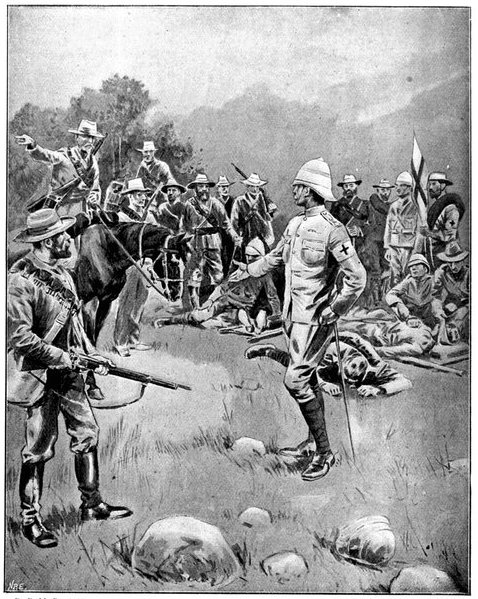
R. B. M. Paxton.] [
After a sketch by Ernest Prater.
MAJOR WRIGHT DEMANDING POSSESSION OF THE WOUNDED.
The Boers at first refused to allow the British Volunteer Ambulance
men to carry off the wounded. Major Wright, who had been wounded at
Elandslaagte and was now serving under the Red Cross, persisted in his
demand, claiming his right under the Geneva Convention, and finally
carried his point in a personal interview with Commandant Botha.
Scene on the hill after the battle.
Jan. 25, 1900.] Boer Estimates of Comparative
Losses.
Dawn broke upon the summit, and parties of Boers stole forward to
renew the weary assault. But the place was tenanted only by the dead
and dying—a vast charnel-house testifying gloriously to the devoted
heroism of the resistance. Two hundred British corpses, many torn by
shells and dismembered beyond recognition, lay upon the mountain top,
and beside them lay many burghers in their last long sleep. "In some
of the trenches and parts of the kopje where the fire was hottest,"
writes a Boer correspondent, "bodies were actually entangled, as if the
dying men had clutched each other in the death struggle, the spirit of
battle in their souls as they sped from earth. On all sides were mute
evidences of the desperate nature of the battle. Dozens of stones were
spattered with blood, and empty Lee-Metford shells lay about everywhere
by the bucketful, testifying that the English had spent an enormous
amount of ammunition. Many[Pg 303] cartridge belts were found entirely empty."
In one trench, raked steadily by the Boer fire, sixty bodies lay within
a hundred feet. And all about was the strange pathetic litter of the
battlefield; letters and papers, testaments, battered helmets, broken
firearms. Here and there the long grass had caught fire, burning mules
and men.
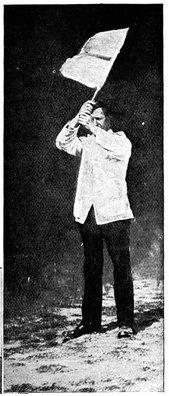
[Photo by Cribb.
FLAG SIGNALLING.
The impossibility of using this mode of communication was one of the
minor causes of the loss of Spion Kop. (See page 297.)
Even the Boers themselves were strangely moved by the evidence of
the heroism with which their as heroic attacks had been encountered.
Yet, in their usual fashion, they were not content with the victory
which they had achieved, but must needs fall to magnifying it by
misrepresenting alike the British losses and their own. They professed
to have buried 620 dead on Spion Kop and placed our total loss in
killed at 1,000. Mr. Webster Davis, an American official, who had
been mysteriously converted to Krugerism at Pretoria, went over the
battlefield and pretended to have counted 400 British dead, even after
the 620 had been buried. Which, it may be said, only served to show
that American politicians do not always tell the truth. Their own
killed the Boer official version placed at 51, their wounded at 123,
and this, they said, was the "heaviest loss yet sustained by our forces
in any engagement." The pretty effort of fiction deceived no one.
Though they were elated—and justly elated—at their great success, it
is well known that the feeling of satisfaction passed when the losses
were counted. One man, Louis Botha, had won the day; had the British
army possessed its Botha, what might it not have achieved, asked even
the plain burghers. And the time was coming when the British army
should find a Botha—and a greater than Botha—a general who had skill
to plan, faith to inspire, and capacity unflinchingly to execute.
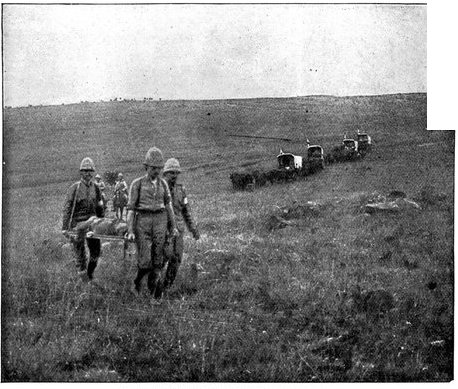
ON SPION KOP THE DAY AFTER THE BATTLE.
One of many sad processions which merged into one long train at the
foot of the hill.
[Jan. 25, 1900.
The Boers placed the strength of the force which assaulted Spion Kop at
half that of the total number of British left dead upon the field. That
is to say, they pretended that 100 or 150 men dislodged between 4,000
and 5,000 British infantry, who, by even the Boer accounts, displayed
remarkable bravery. It is needless to comment upon the story. Were it
true, every officer and man who returned[Pg 304] from Spion Kop deserved to
be condemned as a coward. The evidence is strong that the Boers were
numbered, not by the fifty or the hundred, but by thousands. They made
their supreme effort in this quarter, and it succeeded. A word of
reproach is due for the ghoulish and horrible photographs of the field
of battle which the Boer generals allowed to be taken, and which the
Boer Government permitted to be paraded in the shops of Pretoria and
Johannesburg.
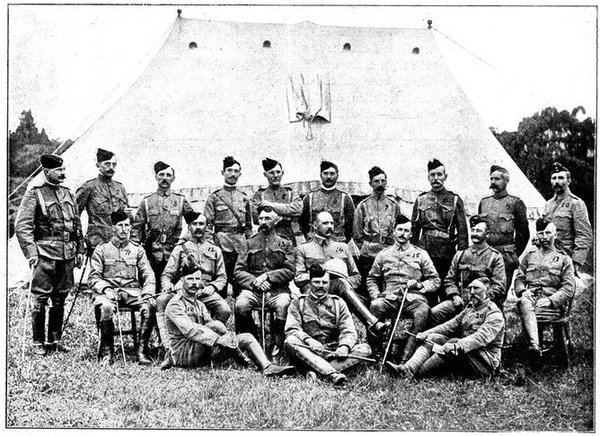
- 1. Lieut. Otto (wounded).
- 2. The Hon. J. L. H. Petre (killed).
- 3. Capt. Knappe (wounded).
- 4. Lieut. Bosomworth.
- 5. ——
- 6. Lieut. Prettijohn.
- 7. Dr. Bensusan.
- 8. Lieut. Steer.
- 9. ——
- 10. Quartermaster Clipman.
- 11. Lieut. Brown (wounded).
- 12. Lieut. Martins (wounded).
- 13. Capt. Bettington (wounded).
- 14. Col. Thorneycroft.
- 15. Capt. Morris.
- 16. Lieut. Sargent.
- 17. Capt. Hendry.
- 18. Lieut. Flower-Ellis (missing).
- 19. Lieut. Jenkins (killed).
- 20. Lieut. Baldwin (wounded).
OFFICERS OF THORNEYCROFT'S MOUNTED INFANTRY. (
Numbered from left to
right, and commencing with the back row.)
Losses in the action.
It is difficult to ascertain exactly what were the losses on this
terrible day. The official return lumped together the casualties
for the week of battles, which amounted to 27 officers and 245 men
killed, 53 officers and 1,050 men wounded, and 7 officers and 351 men
missing. The vast proportion of the missing were prisoners, but a few
were among the killed. Of the men lost, about 200 were killed and
about 500 wounded on Spion Kop. By far the heaviest sufferers were the
companies of Thorneycroft's Mounted Infantry, which fought with such
blind devotion on that blood-stained summit. They went up 194 strong;
they returned with only 72 unwounded men. The 2nd Lancashire Fusiliers
out of a total of 800 had to mourn a loss of 250, but of these many
were prisoners. The Imperial Light Infantry, whose first battle this
was, out of 850 men lost 31 killed and 91 wounded or missing. It is
typical of the complete disorganisation which the fight produced that
the one battalion, the Scottish Rifles, which preserved the best order,
could muster only 270 out of 800 men at the foot of the mountain. The
reason was, not that its losses were especially heavy, but that in the
darkness and confusion no formation could be maintained.
Jan. 25, 1900.] Stories of the Wounded.
The patience, the valour of the common soldier throughout the week,
fully merited General Buller's epithet of "splendid." "The men,"
writes Mr. Treves, the distinguished surgeon with the army, "were[Pg 305]
much exhausted by the hardships they had undergone. In many instances
they had not had their clothes off for a week or ten days. They had
slept in the open without great-coats, and had been reduced to the
minimum in the matter of rations. The nights were cold, and there was
on nearly every night a heavy dew. Fortunately, there was little or no
rain. The want of sleep and the long waiting upon the hill had told
upon them severely. There is no doubt also that the incessant shell
fire must have proved a terrible strain. Some of the men, although
severely wounded, were found asleep upon their stretchers when brought
in. Many were absolutely exhausted and worn out independently of their
wounds. In spite of all their hardships, the wounded men behaved as
splendidly as they always have done. They never complained. They were
quite touching in their unselfishness and in their anxiety 'not to
give trouble.' One poor fellow had been shot in the face by a piece of
shell, which had carried away his left eye, the left upper jaw with
the corresponding part of the cheek, and had left a hideous cavity at
the bottom of which his tongue was exposed. He had been lying hours on
the hill. He was unable to speak, and as soon as he was landed at the
hospital he made signs that he wanted to write. Pencil and paper were
given him, and it was supposed he wished to ask for something, but he
merely wrote, 'Did we win?' No one had the heart to tell him the truth."
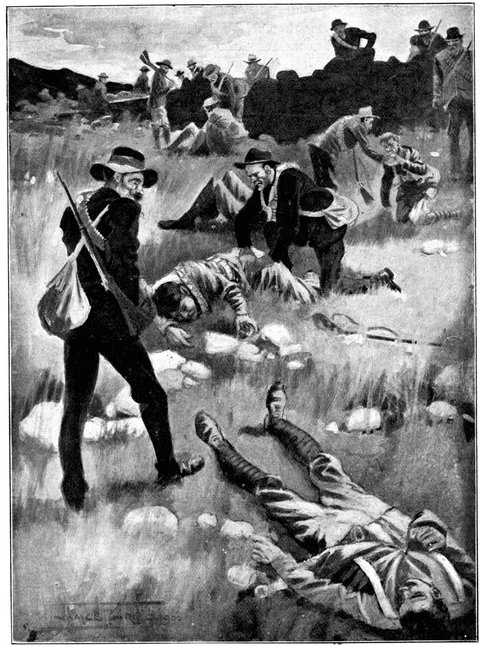
J. Greig.]
AFTER THE BATTLE OF SPION KOP.
Whilst the Boers treated our wounded with tenderness they did not
hesitate to turn out the pockets of the dead and dying.
[Jan. 25, 1900.
There were many striking instances of gallantry. Captain Murray, of
the Scottish Rifles, though wounded in four places, essayed to lead a
charge on the Boer trenches, and so doing was shot dead. Captain the
Hon. J. H. Petre, of Thorneycroft's, displayed throughout the most
determined valour; twice wounded, he remained in his place and was
killed. Sergeant Mason, of Thorneycroft's, a crack shot, engaged in a
terrible contest with three Boers. One he knocked over at his first
shot, the second he mortally wounded, the third saw him and took cover
before he could fire again. Five bullets passed through his helmet;
others tore his clothes; one at last struck his right shoulder. He
changed his rifle to his[Pg 306] left shoulder and finally hit his adversary.
The Boer fell forward with his head over a boulder, and Mason crawled
away to have his wound dressed. In the dressing station on the brow of
the hill the army doctors displayed their wonted bravery under fire.
One man at least was killed in the surgeon's hands; others were wounded
afresh while they were being bandaged.
Among the strange incidents of the day was this, which is vouched
for by Mr. Burleigh. While the Boers were attacking the Lancashire
Fusiliers, a man in khaki, who looked like an officer, suddenly
appeared in one of the British trenches and ordered those holding it
to move out of it, as they were of no use where they were. Several
obeyed, when they found that he was leading them towards a strong
force of Boers among the rocks. "They are friends," said the supposed
officer, as the men hesitated. But, fortunately, a private, who had his
suspicions aroused, challenged the man in khaki, and, when he could
give no satisfactory explanation of his presence, bayonetted him.
Nearly all the British party were thereupon shot down.
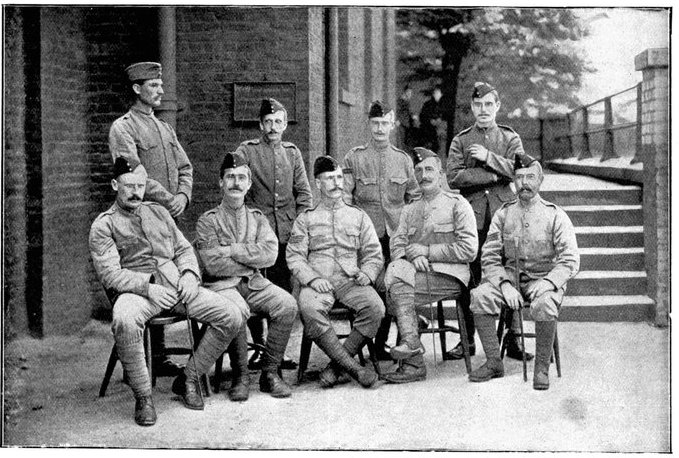
[Photo by Colour-Sergeant Morris.
SURVIVORS OF THE
2nd MIDDLESEX WHO FOUGHT AT SPION KOP.
Non commissioned officers transferred to the new 3rd Battalion Middlesex
Regiment at Woolwich.
The retreat.
When morning came, Generals Buller and Warren learnt to their surprise
and consternation that the position had been abandoned. General
Buller's first intimation of the true situation was when a naval
officer on Mount Alice gazed through the naval telescope and saw that
there were only Boers and ambulance men upon the summit. The general
seemed to have grown suddenly older; he looked wearied and depressed.
Forthwith he rode out to Trichardt's Drift and at last assumed command.
A general retreat was ordered upon the spot; all the troops were to
withdraw to the south of the Tugela as soon as the baggage could be
moved across.
Fresh from a reverse more disastrous than that of Colenso, the army
was yet able to retire unmolested; the bridges themselves were taken
to pieces for future use, General Buller being the last man across. On
the morning of the 27th the enemy dropped a few shells into the river
without effect, and the turning movement was a thing of the past.
Jan. 25-27, 1900.] The Army Recrosses the Tugela.
In his telegraphic report, General Buller especially praised the
conduct of the Scottish Rifles, King's Royal Rifles, Lancashire
Fusiliers, and 2nd Middlesex. He pointed, too, with a satisfaction[Pg 307]
which caused deep uneasiness at home, because it seemed to show that
the British Army was in very truth a beaten force and had been on
the very edge of disaster, to the ease with which the 20,000 British
soldiers had been withdrawn to the south of the river.
Causes of the defeat.
The causes of the defeat were many. In the first place must be set
a faulty military system. The Boers, observes Mr. Churchill, would
have placed 300 men on Spion Kop, who, by taking cover and shooting
carefully among the rocks, would have suffered but little from the
artillery fire. The British generals massed first 2,000, and then 5,000
men upon the height—a target for every shell. The failure to construct
serviceable entrenchments has already been noticed, and in some degree
explained, but it is possible that if the British infantry had been
regularly trained to the use of the spade, the difficulties would have
been overcome. The fog was an element by no means favourable to our
success; it prevented the troops from seeing where to advance, and gave
the enemy time to rally and collect. The breakdown of all organisation
and organising power at the close of a day of desperate and prolonged
conflict is not altogether to be wondered at.
"If at sundown the defence of the summit had been taken regularly in
hand, entrenchments laid out, gun emplacements prepared, the dead
removed, the wounded collected, and, in fact, the whole place brought
under regular military command, and careful arrangements made for the
supply of water and food to the scattered fighting line, the hill would
have been held, I am sure," wrote General Buller. "As this was not done
I think Colonel Thorneycroft exercised a wise discretion."
In his despatch, covering and commenting upon the various reports, Lord
Roberts gave the final and well-balanced judgment of a great soldier.
He held that General Buller's original plan for a turning movement had
been well conceived and had every probability of success if only it
had been executed. He blamed, for the failure upon Spion Kop, General
Buller, because of his "disinclination to assert his authority and
see that what he thought best was done"; Sir C. Warren, because of
his "errors of judgment" and "want of administrative capacity," and
because he had not himself visited the summit in the hours of crisis;
and Colonel Thorneycroft, because of his "unwarrantable and needless
assumption of responsibility." But the nation will not forget that
while the gravest mistakes were made, they were made by generals who
were brave, patriotic Englishmen, under the stress and anxiety of
conflict. It is painful to have to record the fact that the man who was
probably least to blame was the one singled out for punishment. Colonel
Crofton was retired from his command, because of the brief message he
had signalled to headquarters announcing the dangerous position on
Spion Kop. Some months later, after the publication of the despatches,
Sir C. Warren was recalled from Natal and given an administrative post
in Griqualand West.
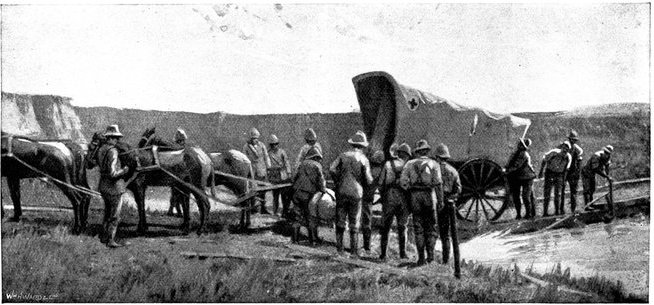
AN AMBULANCE WAGGON STUCK FAST ON A BROKEN BRIDGE NEAR
POTGIETER'S DRIFT.
[Pg 308]
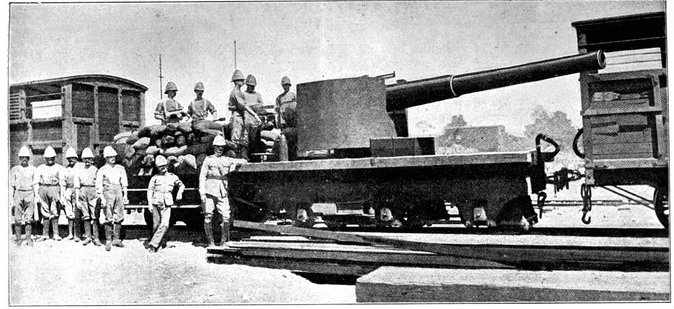
NAVAL 6-INCH GUN ON ITS SPECIALLY-DESIGNED TRUCK.
Substantial reinforcements—Guns taken to summit of Zwart
Kop—Plan of attack on Vaal Krantz—Lie of the
land—Another crossing of the Tugela—Demonstration
towards Brakfontein—Bombardment of Vaal
Krantz—Infantry storm the height—Difficulty of
holding the position—Disappearing guns—Renewed
attacks—Council of war—Evacuation of the
ridge—Losses—Disappointment in Britain.
Substantial reinforcements.

Twice beaten back, twice discomfited, neither the general nor his
army lost heart. No sooner had the army withdrawn across the Tugela
than, in a review, General Buller told his men that he held the key
to Ladysmith, and hoped yet to be in that town in a week. It is
possible that this speech was made in accordance with suggestions
from Capetown, so that the enemy's attention might be diverted from
the great campaign, now about to begin in the west. Meantime he was
strongly reinforced. Three thousand drafts from home reached him, more
than replacing the losses of Colenso and Spion Kop. Not less important
was the addition now made to his artillery. Two siege 5-inch guns
supplemented his 4·7 weapons of position, and a great 6-inch naval gun
on a special mounting was also sent up from Durban. Besides these,
another Field Battery and A Horse Artillery Battery joined him, and
thus, as the guns lost at Colenso were now replaced, he found himself
with seventy-eight serviceable guns—an immense change from the days
of Colenso and of the first operations in Natal. He received, too,
the best part of another cavalry regiment—the 14th Hussars. General
Woodgate, mortally wounded on Spion Kop and now lying betwixt life and
death, was replaced in command of his brigade by Colonel Wynne. Thus
all was ready for a fresh attempt.
Guns taken to summit of Zwart Kop.
Feb. 4, 1900.] Vaal Krantz to be Seized.
The army remained in its camp at Spearman's Farm, close to Potgieter's
Ford, until February 4. The wait was utilised to move six naval
12-pounders, two field guns, and the mountain battery, to the summit
of Zwart Kop. The slopes of the mountain were so steep and precipitous
that the work was one of no little difficulty and danger. Steel hawsers
were employed, attached to trees on the summit, to warp up the heavier
weapons; the little mountain 7-pounders were carried up on mule-back,
but even the mules found it hard to keep their footing, and one in
the battery fell and was killed. The first of the naval 12-pounders,
too, had overturned on its way up and caused no little trouble. On
January 30, the cavalry pushed out far to the west in a reconnaissance,
the object of which was to distract the attention of the Boers, but[Pg 309]
they saw little of the enemy. The troops at Chieveley, to keep up the
mystification, demonstrated at their end of the line and shelled the
Boer works at Colenso.
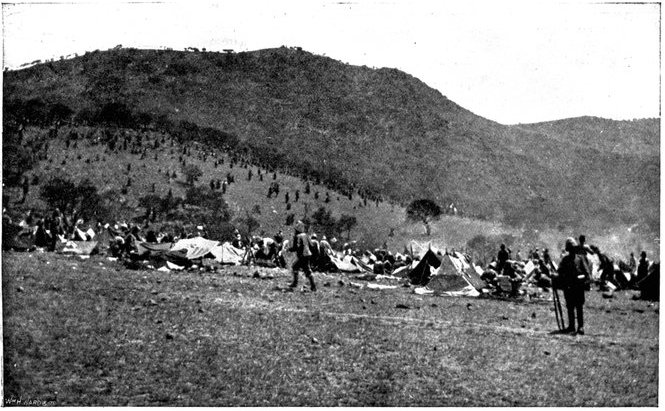
BIVOUAC ON THE TUGELA AFTER SPION KOP.
The camp of the 3rd King's Royal Rifles on the evening of February 4.
Plan of attack on Vaal Krantz.
Lie of the Land.
[Feb. 4-5, 1900.
The serious attack, however, was to be made from near Potgieter's
Drift. Between Spion Kop, to the west of the drift, and Doorn Kloof,
a yet higher summit which rose from the Tugela to the east, ran a
comparatively low ridge, fronting Spearman's Hill and Zwart Kop. The
left and western end of the ridge, known as Brakfontein, commanded
the broad tongue of land which ran up from Potgieter's Drift in the
direction of Ladysmith. It was strongly defended by four lines of Boer
trenches, so constructed as to give complete cover against the British
fire. Though demonstrations had been made against it during the week
of battles, it had been found too strong for serious attack. But the
right and eastern end of the ridge, known as Vaal Krantz, and rising
just above the curve of the easternmost of the two inverted ⋃'s which
the Tugela hereabouts describes, was not so strong. It was a bare,
rocky, razor-backed ridge with comparatively flat ground to the east,
over which ran a road to Ladysmith. Still further to the east rose
Doorn Kloof, as it was somewhat incorrectly called, Doorn Kop being the
real name, the highest mountain on the Tugela line and also the most
irregular in outline—a picturesque tangle of peaks and watercourses
and wooded valleys, affording the best of shelter to the Boers. Against
Vaal Krantz General Buller determined to make his real effort; while
once more demonstrating in the direction of Brakfontein. On February 4,
instructions were issued to the leading officers. The Brigade to which
General Wynne had just been appointed was to make the demonstration
against Brakfontein, supported by General Coke's Brigade, by thirty-six
field guns, the howitzers, and the position guns. The artillery was
gradually to withdraw during the demonstration, and to come into action
against Vaal Krantz. General Clery's Division, composed of the Second
Brigade under General Hildyard and the Fifth Brigade under General
Hart, with the Fourth Brigade under General Lyttelton temporarily
attached, was to take position halfway up the eastern inverted ⋃, as if
it intended to join in the attack on Brakfontein, but instead of doing
so was at the appointed moment to build a new bridge over the Tugela
and advance against Vaal Krantz. General Lyttelton was to storm this
position after a thorough artillery preparation, when the guns[Pg 310] were to
follow him and take post on Vaal Krantz ridge, while the First Cavalry
Brigade under General Burn Murdoch, composed of the 1st Dragoons, 13th
and 14th Hussars, and A Battery of Horse Artillery, was to press up the
road which ran under the Vaal Krantz ridge towards Ladysmith, breaking
in upon the Boer rear. Lord Dundonald with the rest of the mounted men
was to guard the British right from any counter-attack. Such was the
plan, and it offered good promise of success. Now for the execution.
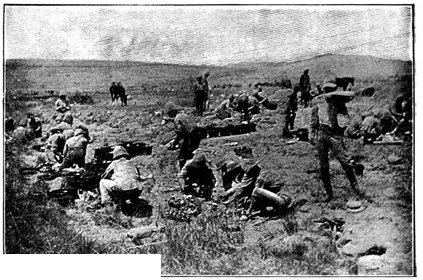
IN CAMP: GETTING DINNER READY.
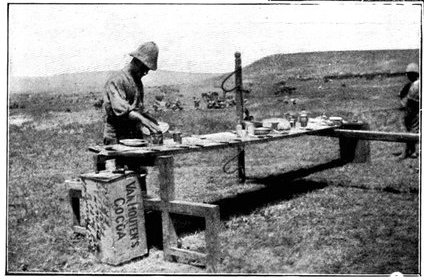
OFFICERS' MESS: PREPARATIONS FOR BREAKFAST.
Another crossing of the Tugela.
On the 4th the troops began to move. Generals Hart and Hildyard crossed
from the British left to the right; General Lyttelton withdrew from One
Tree Hill and was replaced by Wynne; in all directions great clouds
of dust rose from the rough tracks, indicating to the eyes of the
expectant Boers the march of thousands of men. With dawn of the 5th the
cavalry struck its camp on the left and also moved off—the squadrons
at a walk. Pontoon bridges already spanned the Tugela to the east of
Potgieter's Drift, allowing men readily to cross from the neighbourhood
of One Tree Hill to the tongue of land enclosed by the river which
runs up to Vaal Krantz. Yet another bridge was to be built at Munger's
Drift, on the further side of the tongue, to allow the passage of
troops from this tongue to the northern bank of the Tugela. The
engineers with the pontoon train were ready, waiting to get to their
work as soon as the demonstration against Brakfontein fully occupied
the attention of the Boers.
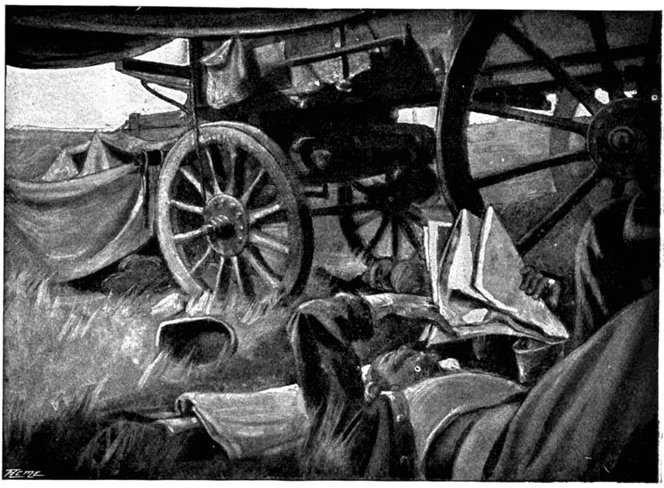
SUNDAY AFTERNOON IN CAMP ON THE TUGELA.
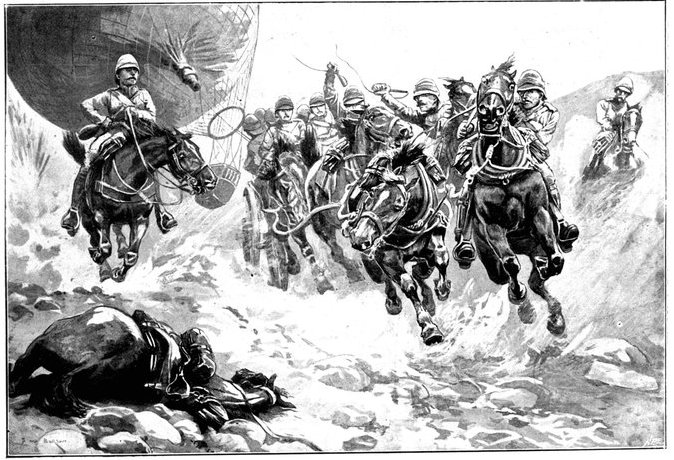
F. W. Burton.]
RETIRING THE BALLOON.
During the action at Vaal Krantz, the balloon came under heavy fire,
and had to be retired out of range by means of the rope which holds it
captive.
Demonstration towards Brakfontein.
Feb. 5, 1900.] The Artillery get into Action.
[Feb. 5, 1900.
The morning was hot and misty, and not till after 7 a.m. could the
battle begin. Then the six batteries of field artillery deployed
in front of One Tree Hill and opened a vigorous fire upon a quite
invisible enemy. There was nothing[Pg 311] to aim at except the Boer trenches,
which appeared, as usual, untenanted. The enemy were grimly watching,
with orders not to return a shot till the British infantry approached
within 500 yards. Next, two battalions, the York and Lancasters and the
South Lancashires, extended and moved forward towards Brakfontein in a
long thin line of brown dots, followed by the batteries in succession.
"Round the guns the long thin lines split and joined together again
in front and went on," writes Mr. Atkins. "Here and there the lines
were thick where the men had not yet had room to extend. Officers
blew their whistles and threw their arms apart, and the knotted part
of the line moved crabwise until the proper intervals were observed."
Gradually the advance developed till the Boers began to feel real alarm
for Brakfontein. The infernal thunder of the field guns and 4·7's,
which had now joined in the game, echoed up through the valleys and
reverberated among the mountain heights. And then at last the enemy's
guns began to reply. These were barely a dozen in number, but they
were well-placed; on Doorn Kloof was a huge 6-inch Creusot, which did
not as yet disclose its presence; on the eastern slope of Spion Kop
were two Krupp field guns, and at other points along the line were
the much dreaded "Pom-Poms." Towards ten o'clock all the smaller Boer
weapons began to fire; columns of dust spurted suddenly up beside the
British batteries, telling that the enemy shot true; Maxim shells and
shrapnel bullets lashed the surface of the veldt around them. But the
gunners fired stolidly and steadily, and, as on many other occasions,
the Boer projectiles caused trivial loss. The British howitzers now
opened, hurling into the clouds from their squat throats the 50-lb.
lyddite shells, which, when they fell, burst with a fearful concussion,
tearing men in pieces. A correspondent with the Boers notes that in
one case the upper and lower parts of one body were found no less than
100 feet apart. For some hours the shells fell on Brakfontein at the
rate of ten a minute, but, wonderful to relate, the Boer casualties
were by no means large. To direct the British fire the war balloon was
sent up and information as to the enemy's whereabouts was transmitted
from the[Pg 312] observer in the car by telephone. This, by the way, was the
second balloon to be employed by General Buller's army; the first had
been damaged by Boer shrapnel, and eventually torn against rocks and
rendered useless during the Spion Kop week.
And now it seemed to the Boers that once more victory was falling
to them. The British attack was distinctly relaxing; battery after
battery could be seen retiring in perfect order, crossing the Tugela
by the pontoon bridge and moving off to the right. The enemy did not
at once seize the fact that all this sound and fury veiled a mere
demonstration, and that a withdrawal had been ordered from the first.
The Boer guns redoubled their fire, and elicited a vigorous return from
the heavy naval weapons on Zwart Kop, which were unmasked suddenly by
felling trees in front of them.

[From photos by a British officer.
VIEW OF VAAL KRANTZ FROM BELOW ZWART KOP.
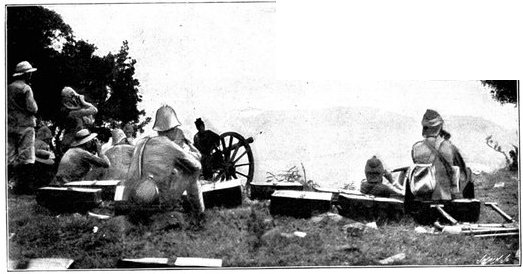
BRITISH ARTILLERY ON ZWART KOP FIRING AT VAAL KRANTZ.
Officers and correspondents watching the effects of the fire. The smoke
from bursting shells is seen on the distant hill.
Feb. 5, 1900.] A Brilliantly-managed
Demonstration.
The engineers at Munger's Drift had got to work upon their bridge as
the booming of the bombardment began. The Boers were not long in seeing
them, and opened upon them a rifle and cannon fire which wounded eight
men. In thirty minutes the task was accomplished with all the coolness
and method which the Royal Engineers invariably displayed under fire.
All was ready for the real attack upon Vaal Krantz, and at once General
Lyttelton's Brigade crossed the river and extended, while battery by
battery the guns stole off from in front of Brakfontein and deployed
to support the infantry on the right. The withdrawal was effected in
superb style; at intervals of ten minutes the six field batteries and
the howitzers retreated, and, as they went, the shrapnel from the Boer
guns rained round them. "Forward trotted the teams with the limbers
for one battery, the unflinching gunners meanwhile loading and firing
to the last minute," writes Mr. Burleigh. "When all was in readiness,
the guns moved off in perfect alignment, the six upon one axle, as if
on show parade. And yet it was deadly war, for the Boer shells were
falling and tearing up the ground upon all sides.... The last three
to be withdrawn were ammunition waggons. All the wounded and left
material were placed very deliberately upon the two which had teams.
For five minutes they waited,[Pg 313] putting things to rights and rearranging
harness, under a rainstorm of shells. Then they walked off the field,
followed by shells, step by step." "Was there ever anything finer than
British gunnery or so extravagantly dangerous?" was the reflection
of another correspondent at this wonderful spectacle. Even the third
ammunition waggon, the horses of which had been killed or wounded, was
not abandoned. The gunners ran it back by hand and so saved it from
capture. The ground was open and there was no cover of any kind, yet
the casualties in the batteries were only about fifteen.
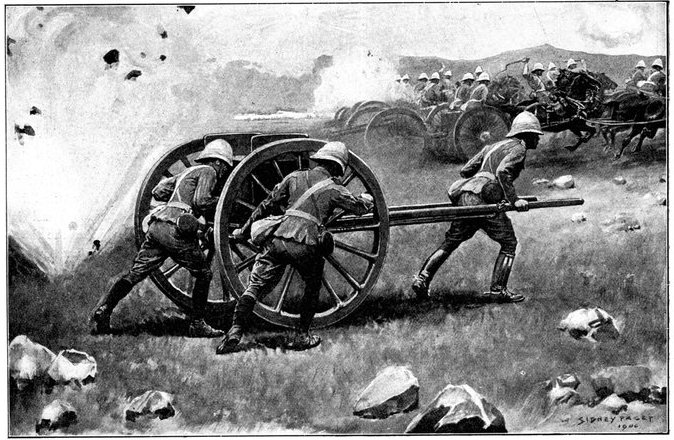
S. Paget.]
"WAS THERE EVER ANYTHING FINER, OR SO EXTRAVAGANTLY DANGEROUS?"
Gunners of the 78th Battery recovering a limber under a heavy fire.
It now remained to bring back General Wynne's two battalions from their
yet closer contact with the enemy. They had reached a point only 1,200
yards from the nearest Boer works at Brakfontein, and as the officers'
whistles blew and the line of khaki-clad men leapt up from the ground,
the enemy at last opened a fierce, spluttering rifle fire. Yet again
the casualties were not heavy, though the running of the gauntlet of
that storm of fire from invisible marksmen for about 1,000 yards must
have been a grim experience. The total loss in the two battalions was
about fifty killed and wounded. The retirement of our men gave scope
for the usual Boer legends. Some professed that our infantry had fled
in panic, while the field glasses of an American correspondent with
the Boers were so powerful that they revealed to him desperate efforts
on the part of our officers to check the flight and to persuade the
men to advance. Whence he argued that Thomas Atkins "was beginning to
funk it." Had he only been able to see into General Buller's mind he
would have known otherwise. In fact, this demonstration was brilliantly
managed with insignificant loss of life—no small achievement against
such an enemy as the Boers.
[Feb. 5, 1900.
Bombardment of Vaal Krantz.
Soon after noon the batteries began the bombardment of Vaal Krantz, and
all the heavy guns joined in the infernal concert. Never in this war
had there been such an artillery display before. The naval guns and
5-inch siege pieces divided their attention between Vaal Krantz and
the dongas under Doorn Kloof, where the Boer guns, from their higher
altitude, had the distinct advantage; the 12-pounders and mountain
guns fired wholly at the tangle of watercourses under Doorn Kloof;
the[Pg 314] field batteries and howitzers concentrated their efforts against
Vaal Krantz. The slopes and ridge of that eminence were torn with
projectiles of all kinds; the usual method being first to fire a couple
of lyddite shells and then a half-dozen of shrapnel in a terrific
volley. Not a living being should have been left on the hill if the
theories of artillerists were correct. But in actual fact the execution
was by no means what was expected. A good many Boers were killed and
wounded, but a number of determined men still held their ground and did
not flinch. A Boer correspondent tells us:—"Scattered about, crouching
low among the boulders, and in the innumerable tiny ravines, the Boers,
with the phlegm of their race, patiently endured the storm and waited
for Tommy Atkins to come within rifle range. The boulders which covered
them were shattered and splintered by the iron hail, but the Boers did
not budge. It is really marvellous how the burghers manage to fight
effectively while keeping so perfectly concealed. A wounded English
officer, who was brought into the laager after the fight, told me that
the men who carried him off the field were the first Boers he had
seen. During the fight he had not caught a glimpse of a single man."
Some idea of the nature of the artillery fire concentrated upon this
point may be gathered from the fact that this correspondent picked up a
double handful of shrapnel bullets in a space only 50 feet square.
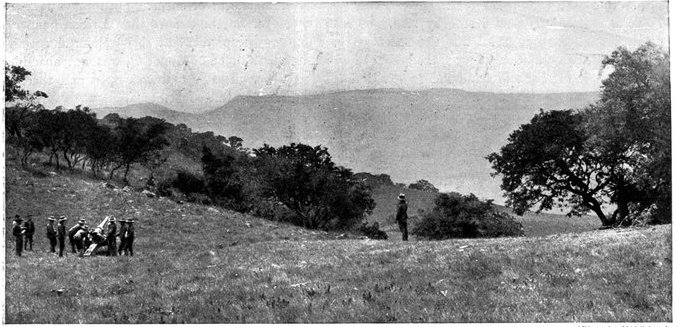
[Photo by Middlebrook.
ONE OF THE NAVAL GUNS ON ZWART KOP BOMBARDING VAAL KRANTZ.
The puff of smoke on the distant hill shows where a Boer magazine was
exploded—it is believed, by a British shell.
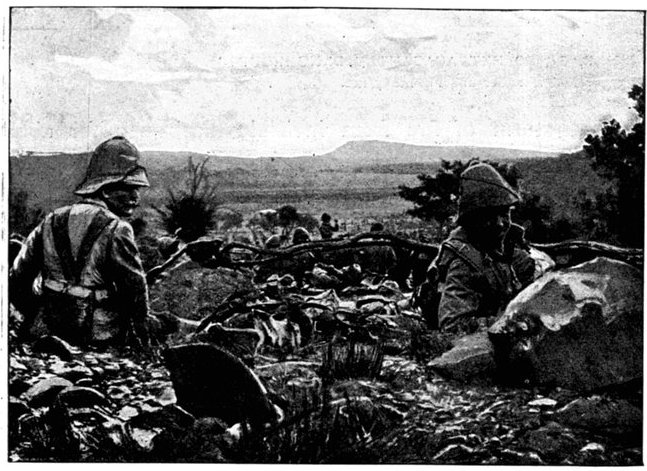
[Photo by Capt. Foot.
A LULL IN THE BATTLE.
This photograph was taken under fire during the battle of Vaal Krantz,
and shows the Brakfontein position in the distance. The men in the
foreground are awaiting the order to advance.
Infantry storm the height.
Feb. 5, 1900.] Capture of the Ridge.
From Zwart Kop the Vaal Krantz ridge was seen to be veiled in the dust
and smoke thrown up by the bursting shells, and it was thought—and
with good reason, as afterwards appeared, notwithstanding the Boer
correspondent's tale of unflinching burghers—that the greater part of
the enemy's force had retired from the hill. The artillery preparations
had been completed as never before; the time had come for the infantry
to storm the position. The 1st Durham Light Infantry on the left,[Pg 315]
and the 3rd King's Royal Rifles on the right accordingly extended and
pushed forward under a sharp, enfilading rifle fire from the dongas
below Doorn Kloof, and under a hail of bullets from the Boer guns'
shrapnel. Unshaken, they pressed steadily on, availing themselves of
every inch of cover—now vanishing from view as they sank down behind
the ant heaps, now rising and rushing forward in a wavy line. They
reached the foot of the smoking ridge, breasted it, and with a cheer
gained the Boer trenches, from which the enemy fled precipitately,
leaving only half-a-dozen armed Kaffirs to fight to the last. The
Kaffirs were shot down, though not until one of them, who was wounded
and who had been spared, had put a bullet through a British officer's
wrist. Their presence showed that the Boers were ready without scruple
to arm and employ black men against whites.
As the storming of Vaal Krantz began there was an exciting episode,
a Boer "Pom-Pom" galloping from Vaal Krantz towards the Doorn Kloof
dongas across open ground. The British artillery aimed at it shell
after shell, but, so hard is a fast-moving object to hit at uncertain
ranges, that the gun and its team escaped injury and went to earth in a
donga, amidst a cloud of smoke from bursting shells.
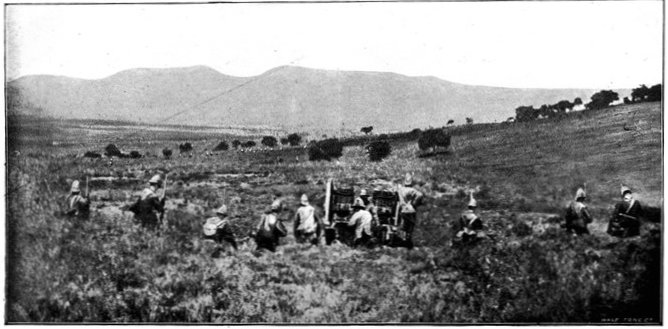
[Photo by Lieut. Salmond.
THE 1ST DURHAM LIGHT INFANTRY ADVANCING ON VAAL KRANTZ.
This photograph shows the Durhams in the act of passing one of the
field guns. It was taken under fire, and is a quite typical view of a
modern battlefield—the infantry advancing in open order, the gunners
taking what shelter their gun affords. Even the insignificant size of
the figures, especially of those near the trees in the middle distance,
lost as they are in the expanse of landscape, is quite characteristic.
Except for the noise, and the occasional dropping of a wounded man, a
spectator would hardly know that anything serious was going on.
Difficulty of holding the position.
About 4 p.m. the eastern end of Vaal Krantz was in British possession.
But the Boers still held trenches along the western end, while
from their positions on and under Doorn Kloof they could direct an
enfilading fire upon General Lyttelton's Brigade. It had been intended
to move the British artillery on to the ridge, but this was now found
to be impossible. In the first place, the ridge itself was razor-edged,
steep, and rocky, so that guns could not be handled upon it; in the
second place, beyond it, but within easy rifle range, was a second
ridge of even greater strength, still in the hands of the Boers. Thus
the gunners would be too close to the enemy for the safe working of
their guns, and the episode of Colonel Long's artillery at Colenso had
shown that it was not good to be too close to the Boer marksmen. The
long grass, too, on the sides of the ridge had been set on fire, and
the dense volumes of smoke which this caused would have been a further
obstacle to the gunners. The A Horse Artillery Battery was, however,
sent forward, and it shelled the ridges held by the enemy. Towards
evening the Boers delivered a vigorous counter attack, endeavouring to
dislodge the British force from Vaal Krantz, but General Lyttelton's
battalions, reinforced by the 2nd Devons from General Hildyard's
Brigade, beat off the attempt with little difficulty, though it was
found impossible to hold the eastern end of the ridge.
[Pg 316]
[Feb. 5-6, 1900.
Disappearing guns.
The night of the 5th was spent by the British troops in entrenching the
position they had won, and providing cover against the enemy's shell
fire. The Boers, on their part, were busy concentrating men from the
east and the west to meet further attacks, and were mounting their
6-inch Creusots on the summit of Doorn Kloof. General Joubert's whole
army was rapidly gathering to drive back the bold assailants, who
had effected a lodgment in the centre. During the night skirmishing
proceeded between the outposts, and with dawn the Boers opened a heavy
fire upon Vaal Krantz and the British camps to the south of the Tugela.
Several of the shells from the 6-inch guns on Doorn Kloof actually
burst within a few yards of the British headquarters. Efforts were
made to silence these inconveniently long-range weapons, but without
success; and though, in the expressive words of a correspondent, the
whole ground round these guns smoked with exploding shells like a lime
kiln, the weapons were never hit or disabled. They were mounted on the
disappearing principle, and their ugly muzzles only showed for a few
seconds on the sky-line, vanishing when their messages of destruction
were sped.
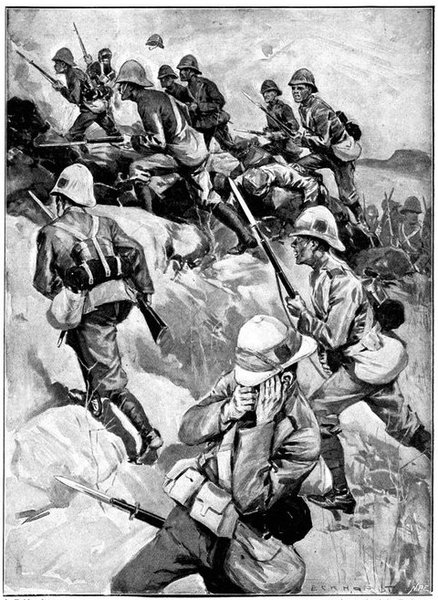
O. Eckhardt.] [After a sketch by E. Prater.
THE DURHAM LIGHT INFANTRY CAPTURING VAAL KRANTZ.
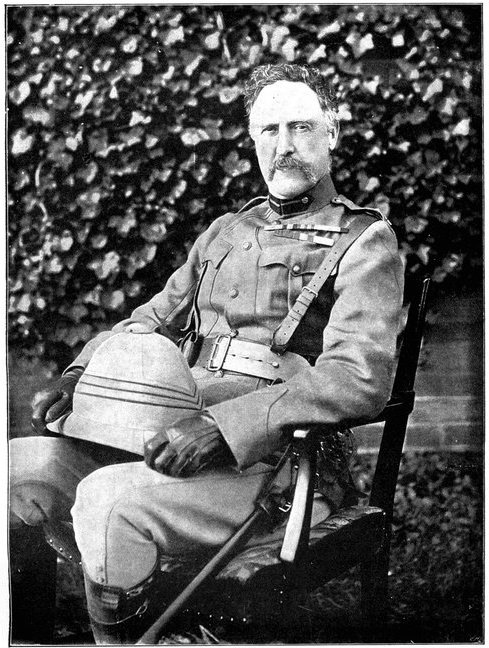
[Photo by C. Knight, Aldershot.
MAJOR-GENERAL LYTTELTON.
A short sketch of Major-General Lyttelton's military career is given on
page 84. He took a distinguished part in the actions during the "week
of battles" before Spion Kop, and commanded the attacking force at Vaal
Krantz.
Renewed attacks.
[Feb. 6, 1900.
To support General Lyttelton's men on Vaal Krantz, General Hildyard
had already advanced to the foot of the hill, and held his Brigade in
readiness to move at a moment's notice. Here, as before Spion Kop,
and in precisely the same manner, the British advance had come to a
standstill. Before, it was Spion Kop that flanked and enfiladed our
line of attack; now, it was Doorn Kloof, and, unless this frowning
mountain could be stormed, there was little prospect of any success. So
councils of war deliberated, while a protracted, aimless battle raged
along the front. On the afternoon of February 6, the Boers suddenly
attacked Vaal Krantz and gained some ground; for whole minutes, indeed,
it appeared as though the hill might be lost. But General Lyttelton
speedily rallied his men, and with the Durhams and King's Royal Rifles
regained the ground that had been lost by a brilliant bayonet charge.
During the day a fresh pontoon bridge was built just under Vaal
Krantz, [Pg 317]
[Pg 318]so as to give easier access to that fiercely disputed point.
At nightfall General Hildyard's men replaced General Lyttelton's weary
battalions, and yet more trenches were constructed. In the darkness the
Boers made a third attack upon the hill, but as before were repulsed
with some trouble.
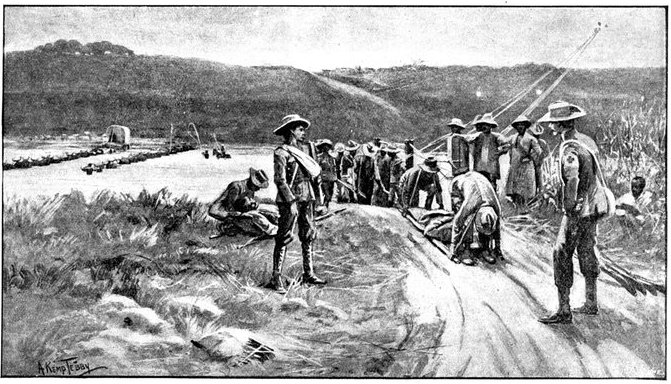
VOLUNTEER AMBULANCE-MEN BRINGING THE WOUNDED ACROSS THE
RIVER BY MEANS OF THE PONT OR RAFT.
Council of War.
Unless a resolute advance was made, Vaal Krantz was an utterly useless
possession. It was exposed to fire from three sides; it was not a
good artillery position; it had little natural strength; and it was
now ascertained to be very far from being the "key to Ladysmith." The
original intention, to follow up its seizure by a flank attack upon
Brakfontein, had to be abandoned, because troops massing for such an
attack would have been exposed to a devastating artillery fire from
Doorn Kloof. The same consideration compelled the withholding of the
cavalry who were to have menaced the Boer rear. Nothing remained,
if the advance was to be pressed, but to storm the ridge which rose
behind Vaal Krantz, and to assault and capture at the same time the
lofty eminence of Doorn Kloof. A council of war was held to determine
the course which should be taken. General Hart alone—"No-Bobs" as his
soldiers called him, from the fact that he never bent his head before
the storm of bullets—was for such an assault, which, it was allowed,
must cost the lives or limbs of thousands of men. He was for going
forward at all risks, and for storming Doorn Kloof. But the other
officers were against so bold, so desperate, a course. They were for
withdrawing and trying yet another line of approach to Ladysmith. To
this General Buller was himself inclined, in view of the frightful
difficulties of the country before him. Accordingly, a general retreat
was once more ordered; General Hildyard's Brigade was to evacuate Vaal
Krantz that night—the night of the 7th—and, with the rest of the
army, to fall back to Springfield and Chieveley.
Evacuation of the ridge.
Feb. 5-7, 1900.] The "Key to Ladysmith" lost.
Losses.
The retreat was accomplished with perfect order and success. General
Hildyard's troops fell back with all their wounded; once more the
Tugela was recrossed, and the bridges taken to pieces. The enemy
offered no other molestation than a few shells, but watched with
exultation the long lines of troops and waggons moving slowly eastwards
all the 8th. There were some among the Boers who supposed that the
relief of Ladysmith had been finally abandoned, and in the British
force there was at least talk of such a dreadful possibility. The
soldiers were gloomy and dispirited, yet they still had confidence
in themselves and in their commanders, notwithstanding the errors of
the past month. Only two brigades out of the five[Pg 319] composing General
Buller's army had been seriously engaged, and all longed for a real
trial of strength. The British losses in the fighting at Vaal Krantz
were by no means heavy. The killed were 25, wounded 344, and missing
5. The Boers on their part owned to 21 killed and 31 wounded, but
their losses were probably nearly equal to those of the British, with
a larger proportion of killed, owing to the effect of the tremendous
shell-fire directed upon Brakfontein and Vaal Krantz. According to Boer
accounts, no fewer than 5,000 projectiles were thrown against these two
positions by the British guns. Seldom have more shots been fired with
less effect.
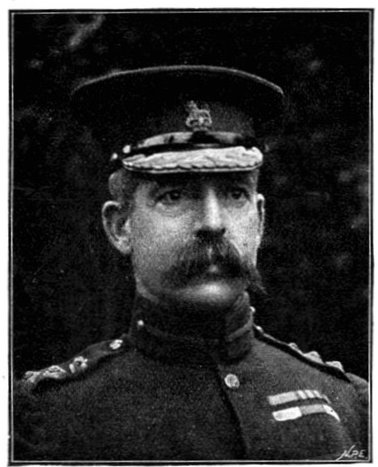
[Photo by Knight, Aldershot.
MAJOR-GENERAL WYNNE.
Commanding the Eleventh Brigade of the South African Field Force,
was born in Ireland in 1846; joined the 51st Light Infantry in
1863; Adjutant, 1868-71; Superintendent of Signalling in the Jowaki
Expedition, 1877; and served in the Afghan War of 1878-9; employed on
special service in South Africa in 1881; commanded the 4th Battalion
Egyptian Army, 1883-5; and has since held appointments as Deputy or
Assistant-Adjutant-General at the Curragh, at Malta, and at Aldershot.
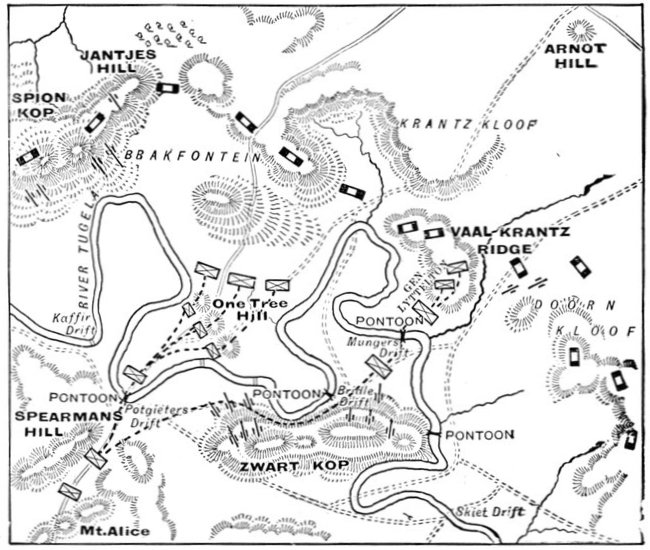
MAP OF THE ACTION AT VAAL KRANTZ.
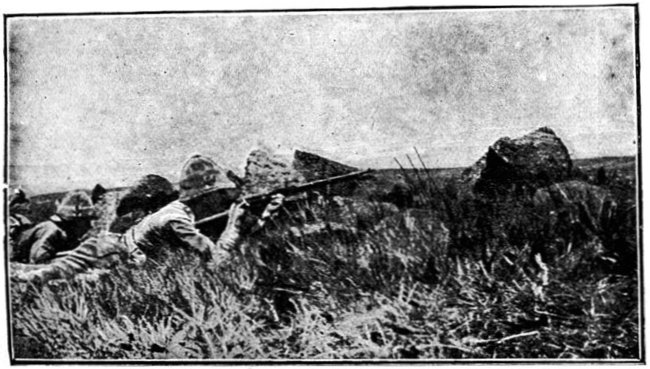
THE WEST YORKSHIRE REGIMENT HOLDING VAAL KRANTZ.
Disappointment in Britain.
The repulse at Vaal Krantz—for defeat it could scarcely be
termed—marked the nadir of British fortunes in South Africa. It was
the third occasion on which a British army had attempted to fight its
way to Ladysmith and had failed. It was the climax of a long series of
reverses—Stormberg, Magersfontein, Colenso, Spion Kop, and now Vaal
Krantz—the darkest hour before the dawn. Yet already the preparations
for the new campaign, which was to change disaster into triumph, were
completed. By a dramatic coincidence, as General Buller's troops
tramped sadly back to Chieveley, Lord Roberts and Lord Kitchener were
speeding on their way to Modder River Camp to inaugurate the invasion
of the Free State and to effect the rescue of Kimberley. Orders were
forthwith sent by the Field-Marshal to General Buller, to relieve
Ladysmith at all costs. The load of responsibility was lifted from
his shoulders, and he proved in the weeks to come that he had laid to
heart the lessons of his costly experience. In England, the news of
Vaal Krantz only accentuated the gloom which Spion Kop and the earlier
defeats had caused. It was feared that General Buller's task was an
impossible one, and that Ladysmith, exhausted by hunger and ravaged
by disease, must, notwithstanding its superb defence, succumb to the
grimly-resolute foe. Yet England still persevered—
"Baffled and beaten back, she works on still:
Weary and sick of soul, she works the more,
Sustained by her indomitable will,"
though face to face with "the sense that every struggle brought
defeat."
[Pg 320]
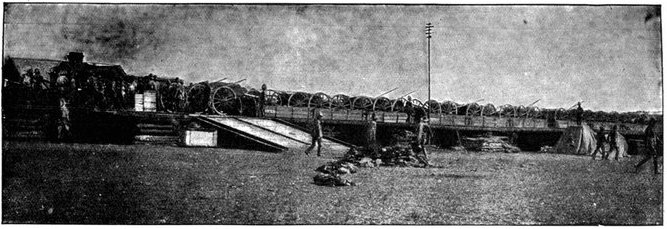
A FEW GUNS FOR GENERAL FRENCH LEAVING RENSBURG STATION.
CHAPTER XV.
COLESBERG AND THE WEST.
General French's position—Engagements near Arundel and
Rensburg—The Boers fall back on Colesberg—British
camp moved to Rensburg—Fighting round Coles
Kop—French's mobility—Loss of a commissariat
train—Both sides reinforced—General Schœman
repulsed—Death of Major Harvey—Boers driven
back—Disaster to the Suffolks—Occupation of
Slingersfontein—Guns and supplies hauled up
Coles Kop—Small actions near Colesberg—Boer
attack near Slingersfontein—Guarding the railway
junctions—Gradual withdrawal of British forces—A
ride for life—Accuracy of Australian shooting—Coles
Kop and Slingersfontein evacuated—British retire to
Arundel—Seizure of German steamers—Lord Roberts
conciliates the Colonials—Reorganisation of
transport—Roberts' and Kitchener leave Capetown—Lord
Methuen keeps the enemy busy—Demonstrations towards
Koodoesberg Drift—Roberts in camp—Preparations for
the great blow—Composition of the Grand Army.
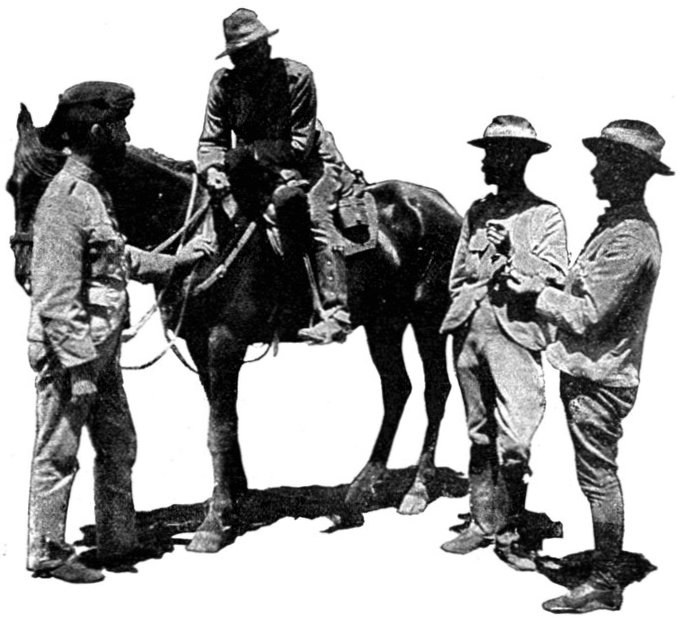
NEW SOUTH WALES LANCERS WITH GENERAL FRENCH.
General French's position.
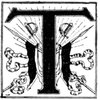
Throughout December skirmishing continued in the Colesberg district of
Dec. 11-13, 1899.] Fighting on Extended Lines.
Cape Colony between General French's small army and the Boer commandos
which had marched into the Colony in November by way of Norvals Pont,
with the object of menacing or breaking Lord Methuen's communications
with the sea. In Chapter VII. we left General French with just under
3,000 men, including the garrisons at Naauwpoort and Hanover Road;
his headquarters on December 8 at Tweedale, twenty-six miles south of
Colesberg Junction; and his outposts eighteen miles further north, near
Rensburg. He had available for action against the Boers a wing of the
Berkshires, the 6th Dragoon Guards, O and R Horse Artillery Batteries,
a troop of New South Wales Lancers, the New Zealand Mounted Infantry,
some companies of regular mounted infantry, and a few colonial scouts.
The strength of the Boers was ascertained by reconnaissance to be
about 2,000, and to deal with such a force more men were required. On
December 8 and 9, the 10th Hussars and 6th Dragoons were sent forward
to him from Capetown, and these were followed a day or two later by a
squadron of the 2nd Dragoons, who were, however, shortly afterwards
withdrawn and despatched north. General French, whose tactics were
ceaselessly to harass the enemy, but not to allow himself to be drawn
into a serious action before his strength was adequate, lost no time
in making use of his reinforcements. On the 11th a reconnaissance[Pg 321] was
directed to Vaal Kop, a high ridge close to Rensburg, which was held by
the enemy. For the first time the Horse Artillery came into action in
South Africa, a section of R Battery shelling Vaal Kop and inflicting
some loss upon the Boers. They abandoned the hill, which was at once
seized and held by the British.
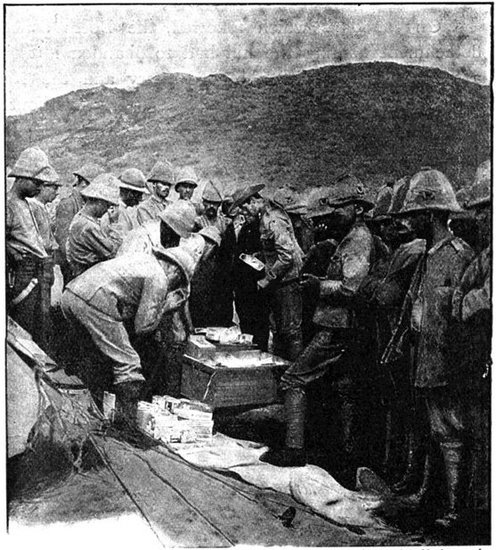
[Copyright 1900 by Underwood & Underwood.
LUXURIES FROM HOME.
Arrival in camp of a consignment of tobacco, cigarettes, and other
luxuries.
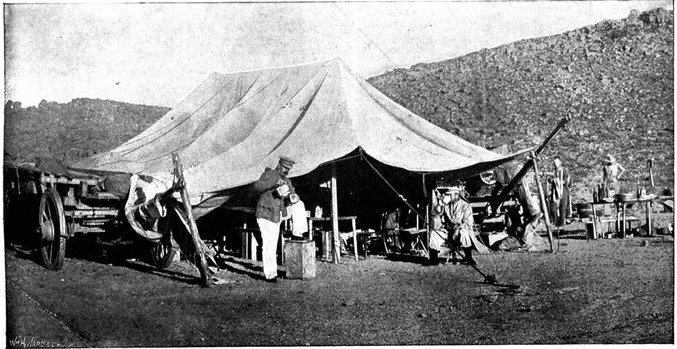
[Photo by R. C. E. Nisson.
COLONEL PORTER TAKING HIS EARLY MORNING COFFEE.
Engagements near Arundel and Rensburg.
Upon December 13 the Boers made an attempt to dislodge General French.
Early in the morning some 1,800 of them were seen to be advancing
towards Arundel in three parties. They drove in the British pickets,
but, as soon as their intentions were perceived, Colonel Porter marched
out with 1,000 cavalry and four guns of the Horse Artillery. The enemy
brought up two guns, which, however, could do nothing against our Horse
Artillery. They were shelled and driven back. Later in the day the
British horsemen found the Boers in some force at Kuilfontein Farm,
a little to the west of Rensburg, and ejected them by the summary
process of artillery fire. The enemy lost no less than forty killed
and wounded on this day; the British losses, including some casualties
in a patrol skirmish on the day before, were only nine wounded and
missing. All through the 13th, Vaal Kop was resolutely held by a tiny
British garrison of 100 men and two guns. The fighting was remarkable
for the enormous extent of country covered by the forces engaged. The
Boers fought on a front of fully fourteen miles; the British, with a
yet smaller strength of men, extended over an even longer line. The
mobility of the cavalry and Horse Artillery proved to be such that the
Boers were filled with uneasiness. They summoned reinforcements, which
were at once despatched from the Free State.
[Pg 322]
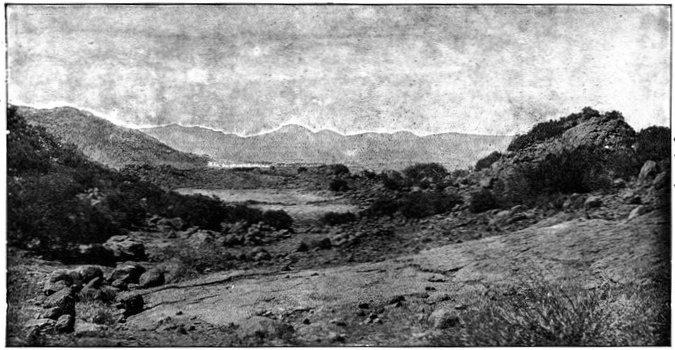
ARUNDEL CAMP FROM THE HILLS TO THE NORTH.
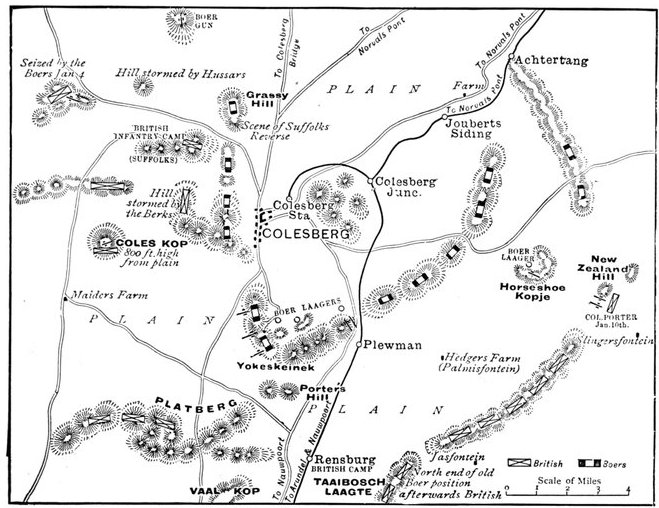
MAP OF THE ACTIONS AROUND COLESBERG.
[Dec. 14-20, 1899.
The Boers fall back on Colesberg.
Dec. 30, 1899.] Movements around Colesberg.
On the days which followed, the Boers concentrated so serious a fire
upon Vaal Kop that the detachment holding the hill had to abandon it
on the 16th. Two days later General French made a reconnaissance with
the O Battery and the New Zealanders to the east of Rensburg, and came
under an unexpected fire, but, fortunately, without suffering much,
though the New Zealanders lost two men. The Boers were found to have
mounted a heavy position gun at Taaiboschlaagte, a ridge a little to
the east of Rensburg, whence they harassed the British force with
shells at a range of 7,000 yards. For ten days no further progress
was reported on the part of the British arms, though the Boers were
steadily annoyed by "sniping" and fire from the Horse Artillery guns.
But on December 27, General French noted signs that the enemy meditated
retirement. Waggons were seen proceeding towards Colesberg, and,
reinforcements having joined him in the shape of the 1st Yorkshires
and half a battalion of the 1st Suffolks, he was able to press their
flanks more vigorously. Finally, on the 29th, the Boers evacuated their
positions at Rensburg, and fell back to Colesberg. Their position at
that point protected the railway, which runs by Norvals Pont to the
Free State, and the road[Pg 323] bridge, which spans the Orange River at
Botha's Drift. There was good water, whereas the country near Rensburg
was almost waterless, a fact which seriously hampered General French in
his operations.
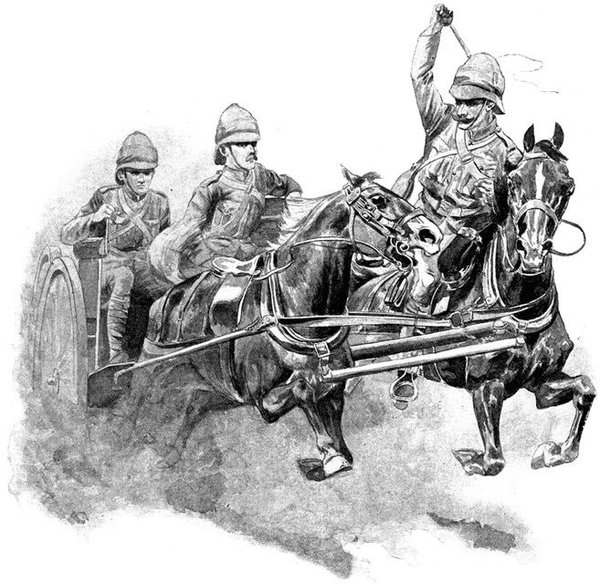
MAXIM WITH GALLOPING CARRIAGE COMING INTO ACTION.
British camp moved to Rensburg. Fighting round Coles Kop.
[Dec. 30, 1899-Jan. 4, 1900.
French's mobility.
On December 30, the General pushed forward, reconnoitred the Boer
positions, and seized a kopje known as Porter's Hill, 2,000 yards
from the curve of the ⋃-shaped line of kopjes which nearly
surrounds Colesberg, and a little north of Rensburg. Here several of
the Horse Artillery 12-pounders were placed in position; at the same
time the British camp was moved forward from Arundel, where it had been
established on December 18, to Rensburg. On the night of the 31st,
Maeder's Farm, just under Coles Kop, was seized. A few hours later,
early in the morning of January 1, the Berkshires, under the personal
command of General French, rushed a strong kopje, to the east of Coles
Kop and about a mile from the line of rocky hills held by the Boers.
A strong picket of the enemy was surprised and driven back in great
confusion. When daylight came, under a heavy fire, the British cavalry,
with the object of turning the Boer flank, pushed up to the topmost
extremity of the Boer ⋃, and the artillery opened a vigorous
fire on the western arm of the ⋃. The Boers replied at once with
15-pounders and "Pom-Poms." While a sharp cannonade was proceeding in
this quarter, Colonel Porter, from Porter's Hill, attempted to gain a
lodgment on the curve of the ⋃; the New Zealanders, who made the
attempt, displayed the utmost gallantry, but were too few to achieve
any result. Owing to some slackness on the part of the cavalry on the
British left, who, in spite of repeated orders from General French,
failed to push forward and occupy a detached kopje commanding the roads
both to Botha's Bridge and to Norvals Pont, the day's fighting yielded
no solid result.[Pg 324] Had General French's instructions been carried out,
the Boer retreat would have been threatened and Colesberg rendered
untenable. The ineffectual moves of the cavalry only served to draw the
enemy's attention to the importance of the position. Late in the day
the enemy delivered a counter stroke against the British right, but
this was skilfully defeated by the 6th Dragoon Guards. In this action
both armies—neither of which exceeded 3,000 men—fought and manœuvred
over a front of twenty miles. Under these novel conditions General
French again showed remarkable skill in adapting his tactics to those
of the enemy. Indeed, his procedure puzzled and alarmed the Boers, who
had never met this kind of British general before or felt the mobility
of cavalry. The British losses were three killed and a few wounded.
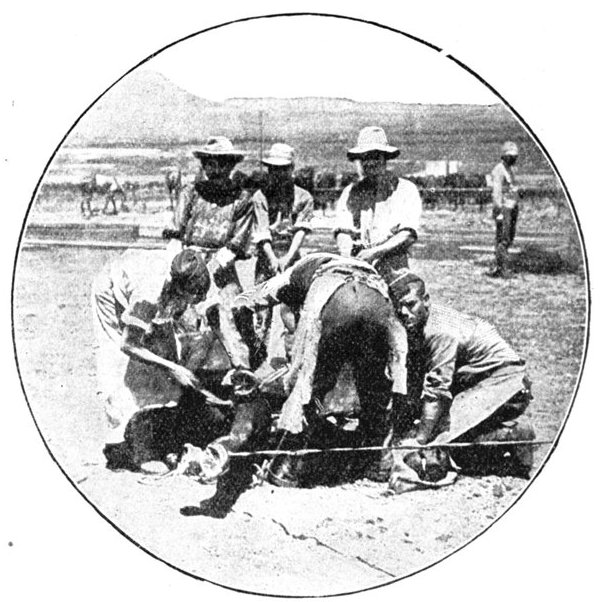
[Copyright 1900 by Underwood & Underwood.
SHOEING AN ARGENTINE HORSE AT THE REMOUNT DEPOT, NAAUWPOORT.
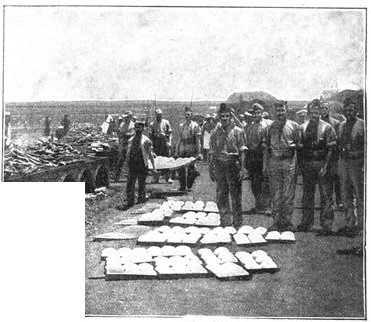
[Copyright 1900 by Underwood & Underwood.
BAKING BREAD IN THE FIELD OVENS OF THE R.A.S.C. AT NAAUWPOORT.
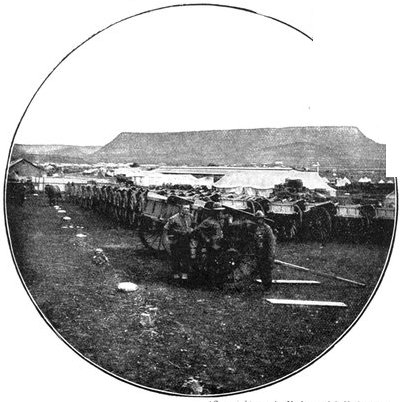
[Copyright 1900 by Underwood & Underwood.
TRANSPORT WAGGONS FOR THE FRONT, NAAUWPOORT.
Loss of a commissariat train.
Both sides reinforced.
Jan. 4, 1900.] Boer Attempt to Outflank.
Three days were spent in securing the ground which had been won.
Opposite the kopje that the cavalry had failed to seize, at the
northern extremity of the Boer position, 400 of the Suffolks were
forthwith entrenched. An unfortunate accident, however, marred our
success. A commissariat train standing in the station at Rensburg broke
loose, ran down the incline towards Colesberg Junction, and when half
way to that point, left the rails. 22,000 rations thus fell into the
enemy's hands. An attempt was made by a company of Suffolks to recover
the supplies, but the Boers opened so hot an artillery fire that the
British had to withdraw. As General French reported that with slight
reinforcements he could drive the enemy from Colesberg, yet more
troops were sent him—the Household Cavalry Regiment, the other half
of the 1st Suffolks, the 1st Essex, and the 20th Field[Pg 325]
Battery. But, as the Boers were simultaneously reinforced, these troops
could not turn the scale.
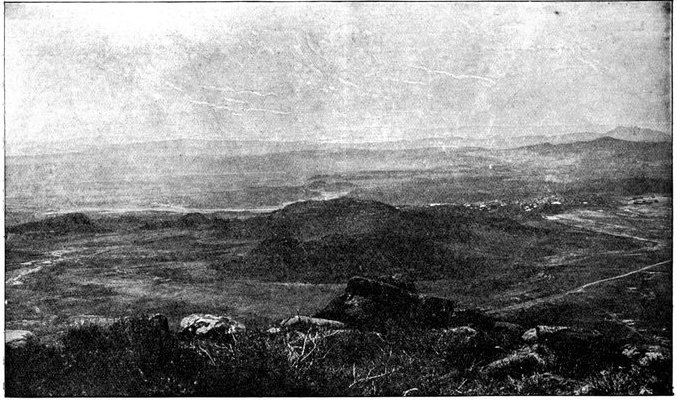
Photo by R. C. E. Nisson.]
COLESBERG FROM COLES KOP.
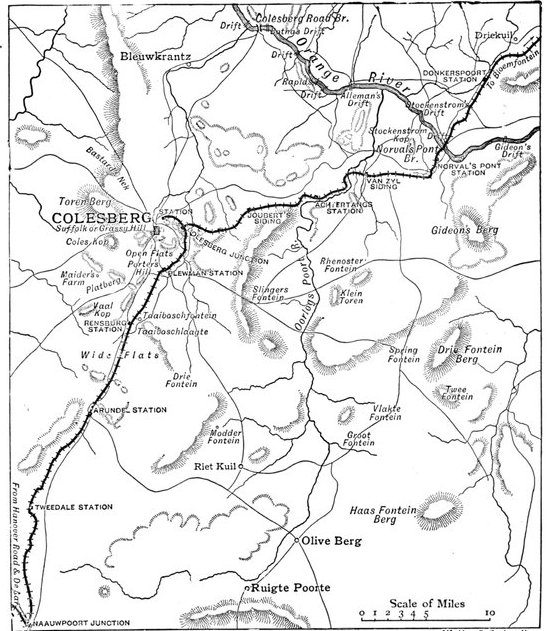
Walker & Cockerell sc.
MAP OF THE COUNTRY BETWEEN ARUNDEL AND NORVALS PONT.
The district in which General French kept the Boers occupied whilst
Lord Roberts developed his plans for the relief of Kimberley and the
capture of Cronje.
General Schœman repulsed.
[Jan. 4-5, 1900.
Death of Major Harvey.
Boers driven back.
Early on January 4, the Boers under General Schœman made a sudden
attempt to get round the British left. They pushed out in the darkness,
unperceived by our cavalry, and seized a group of kopjes to the rear
of the Suffolks. But when once there they found themselves in a trap.
The ground around the kopjes was level and coverless; the 10th Hussars
with two guns of O Battery opened on their rear, while a squadron of
the 6th Dragoons with the other four guns of the Battery attacked them
in front. So hot was the fire that about 500 of the Boers decided that
it was time for them to quit. They dashed off across the plain towards
Colesberg, shelled by the Horse Artillery, and hotly pursued by the
Hussars and Dragoons. A small party, however, took up a position upon
a low, boulder-covered hill,[Pg 326] whence they opened a fire, which checked
the Hussars. Colonel Fisher dismounted his men at once, and boldly
carried the hill by rushes on foot, in which operation Major Harvey
fell, gallantly leading his men. His sad death is thus described by one
of his privates:—"I shall never forget our old Major Harvey. He said:
'Come along, my squadron; there are a few Boers just round the corner,'
and we went to shift them. We could only go about a dozen at a time,
and the old Major led us. He got shot in the mouth, but was able to
say: 'Never mind me, men; let them have it!' But he got two more shots
in the head, and dropped dead. Just then we had to lie down, hundreds
of bullets dropping around us." The 6th Dragoons got home with their
lances.[3] There still remained 200 of the enemy on the hill, who could
not be made to move, although a heavy shell fire was directed upon
them. On this, the mounted infantry were sent in to clear them out. The
infantry pushed in so as to threaten the Boer retreat, when another
hundred of the enemy bolted. As the soldiers neared the foot of the
kopjes the remnant also hurriedly retired, but could not all get away;
twenty-one were captured, and the enemy's total casualties in killed
and wounded were placed by General French at ninety. The British loss
was only six killed and fifteen wounded.
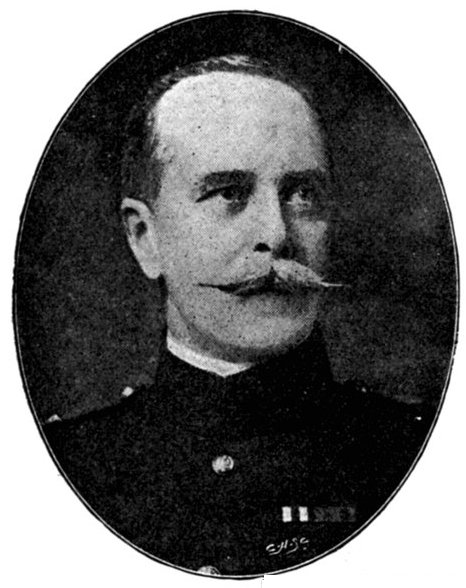
[Photo by. Elliott & Fry.
LIEUT.-COL. WATSON.
Killed while leading the 1st Suffolks at Rensburg.
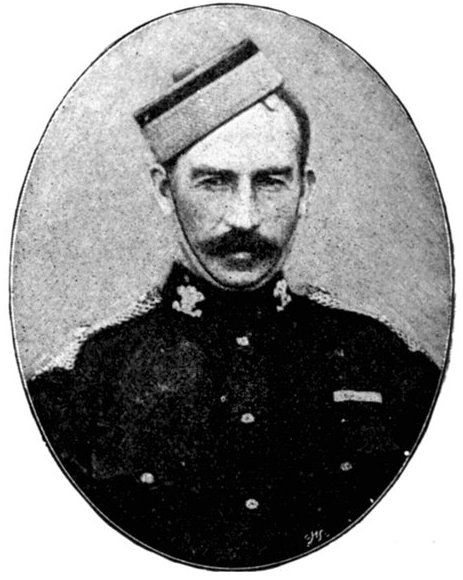
[Photo by Knight, Aldershot.
MAJOR HARVEY.
Of the 10th Hussars, killed at Rensburg.
Disaster to the Suffolks.
On the 5th, the Boer lines were shelled and a careful examination was
made of the grassy kopje at the north-western extremity, known as
Grassy or Suffolk Hill. It was this kopje which the cavalry had failed
to seize on January 1. Colonel Watson, of the Suffolks, was anxious to
make a night attack upon this eminence, and on the evening of the 5th
was informed by General French that he might attempt it, only he was
to give the General notice, so that the artillery and cavalry could
co-operate. Orders were issued to the gunners to be ready to fire upon
Grassy Hill. Nothing more was received from Colonel Watson at the
British headquarters, but about 2 a.m. of the 6th, heavy firing was
heard in the direction of the kopje, and presently the news arrived
that the attack, delivered by four companies of Suffolks, had been
ignominiously repulsed.
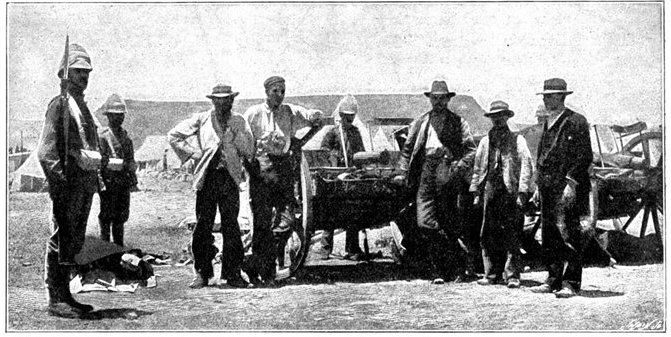
TIRED OF THE WAR.
A group of Boer prisoners taken near Naauwpoort who seemed glad to be
captured.
Jan. 5-6, 1900.] Attack on Grassy Hill.
What actually happened was thus portrayed by survivors. "We were[Pg 327]
awakened about midnight and ordered to prepare to march," was the
story of Private Alexander, one of the wounded prisoners. "Instead
of boots we were to wear our slippers, so as to make as little noise
as possible. There were eight companies of us, commanded by Colonel
Watson. Well, we marched for five miles over broken country, stumbling
most of the way, and stopped when we reached the foot of a certain
kopje. It was then about two in the morning; there was no moon, and
consequently it was quite dark. We advanced a little way up the kopje,
when the Boers opened a deadly fire. They could not have seen us, but
it was quite evident that they had heard us. It was too warm for anyone
to live long, and we heard Colonel Watson call for a trumpeter, who was
to be asked, we thought, to sound the order to retire. At that time
our men were scattered around the kopje in extended order, and the
sound of a man's voice would not have reached them all. There was no
bugler to be found. 'A' and 'H' Company were then ordered to advance,
and when near the firing line we were told to fix bayonets and prepare
to charge. But the charge was interrupted by a deep ditch between us
and the Boer position, and we were obliged to fling ourselves to the
ground. Both companies returned the Boers' fire, but it was impossible
to stand against the shower of bullets which assailed us. 'A' and 'H'
mustered about 200 men, and everyone was either killed or wounded or
was compelled to surrender. The other companies managed to retire.
Captain Brett, of 'A' Company, was wounded in the left shoulder, and he
is now a prisoner at Pretoria. Captain Brown, of 'H,' was struck in the
chest, and I hear has since died. Lieutenant Carey, of 'A,' was shot,
and never moved afterwards."
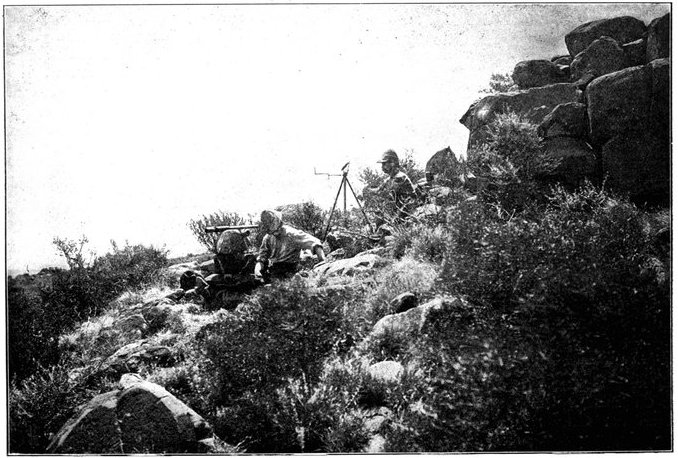
SIGNALLING ON THE TOP OF COLES KOP.
[Jan. 6-7, 1900.
Even more graphic is the story of another man who escaped. "We were
paraded about 1·30 a.m. on the 6th, under Lieutenant-Colonel Watson and
ten other officers. We had orders not to fire a single shot, and if
we were fired on to take no notice, but keep straight on and make no
noise. We then started on the advance on Red Hill, which was about a
mile and a half away from our camp. When we were about half way there,
we were halted and ordered to fix bayonets and carry the hill at the
point of the bayonet. Soon after starting again we heard a kind of
call from a bird (but I believe it was[Pg 328] a signal call), and we saw two
lights on our right, yet no notice was taken of them. We kept on until
about twenty paces from the top of the hill. All this time we were in
close column. Colonel Watson called the officers round him, and they
were in front of the column when a signal shot was fired by one of the
Boer sentries and we lay down flat. About two or three minutes after
the first shot was fired, we heard running of feet, and thought it was
our own men, but all at once the top of the hill seemed in flames,
and the bullets were flying all round us. Still we lay there waiting
for the order to charge, but it never came. After lying under fire
for about ten minutes, the Colonel gave the order to retire, and the
men on the left retired. Major Graham, on the right, gave his men the
order to charge—which they did, at a very serious cost. Major Graham
himself was shot through the left arm, and the bullet penetrated his
side and came out under his right lung. The Colonel was killed, his
head being almost blown off by the explosive bullets the Boers were
using. The adjutant was also killed by the Colonel's side." It does
not appear to be the fact that any officer gave the order to retire,
and General French's dry comment may be near the truth—that success
would have been obtained, though not without loss, "had the majority
of the men not been seized with panic and retired." The losses in this
disastrous little affair were heavy; 28 were killed, 24 wounded, and
113 "missing," 34 of whom were wounded prisoners in the enemy's hands.
The Boers acknowledged a loss of 8 killed and 12 wounded, and this was
probably about the truth. General French had his whole force under
arms, but would not permit any attempt to retrieve the reverse, judging
wisely that it would only result in a further loss of lives, which at
this juncture was specially to be avoided.
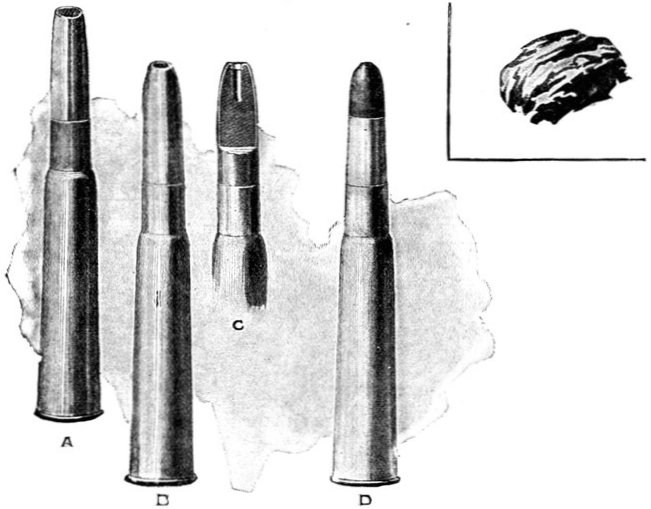
EXPANDING BULLETS.
These have often been spoken of as "explosive bullets," and sometimes
as "man-stopping," or "soft-nosed bullets." When they penetrate the
body they spread out or "mushroom," assuming some such form as that
indicated in the illustration in the corner, inflicting terrible
wounds, and leaving a gaping hole at the point of exit. A shows the
origin of the Dum-dum bullet, which is so called because it was first
made at the Arsenal of Dum-dum in India. The nickel coating of the
bullet is filed away at the top to allow the lead to expand. B is the
British regulation Dum-dum, now prohibited, and C is a section of the
same. D is the soft-nosed expanding bullet, of which hundreds were
found in the Boer trenches at Paardeberg and elsewhere.
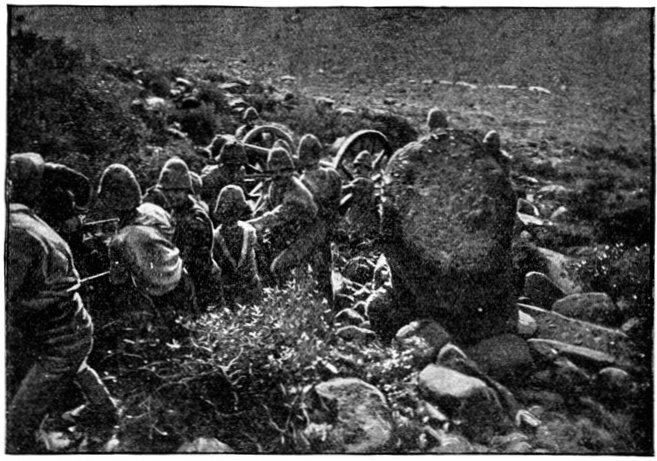
BEGINNING THE ASCENT OF COLES KOP.
Taking guns to the top of the hill, 800 feet high. This photograph
gives some idea of the difficult character of the ground over which the
men had to drag their guns by hand labour.
Occupation of Slingersfontein.
Jan. 11-15, 1900.] Artillery on Coles Kop.
On January 7, General French with a squadron of Household Cavalry
pushed out a reconnaissance to the east and examined a position near
Slingersfontein. The enemy opened a long range fire, and succeeded in
cutting off and capturing Captain Ricardo with four troopers. Two days
later, Slingersfontein was occupied by Colonel Porter with a force of
600 men and four guns, after a brush with the enemy in which the New
Zealanders distinguished themselves. To cover the movement the rest
of the artillery shelled the enemy's lines. From his new position,
Colonel Porter could see all that was going on in the Boer rear,
and noted the arrival[Pg 329] of large reinforcements from Magersfontein
and Ladysmith. General French, in fact, was acting as a magnet and
attracting the enemy's forces. The Boers opposed to him were now about
4,000 or 5,000 strong, and in the course of the next few days were yet
further strengthened to 6,000 or 7,000. On his part, General French was
reinforced by half the 1st Welsh Regiment and the 4th Field Battery,
and was promised a part of the Sixth Division, now beginning to reach
South Africa.
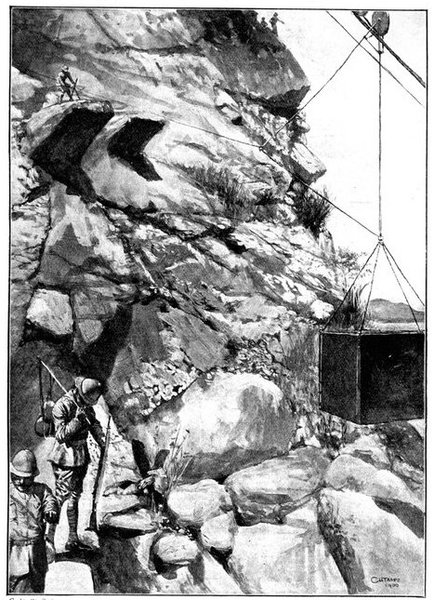
C. H. Taffs.] [After a sketch by F. Villiers.
THE WIRE HOIST USED FOR DRAGGING AMMUNITION AND SUPPLIES UP COLES KOP.
Guns and supplies hauled up Coles Kop.
On January 11th, by great efforts, Major Butcher, commanding the 4th
Field Battery, succeeded in hauling two 15-pounders to the top of
Coles Kop. Five hawsers were used, and in four hours the work was
accomplished and the weapons were ready to open fire. Some days later,
as the conveyance of food, water, and ammunition to the summit was
found extremely laborious in consequence of the precipitous nature
of the hill, the engineers rigged up a wire hoist, which proved
invaluable. Bridging wire, which bears a strain of 2,000 lbs., was
employed for this purpose. On the same day, General French with
Colonel Porter's cavalry made a vigorous attempt to reach the enemy's
rear from Slingersfontein. Major Hunter Weston with a section of
mounted engineers and a troop of cavalry was directed to pass round
their flank and destroy the Norvals Pont railway. As, however, strong
Boer reinforcements rode up from Norvals Pont, it was impossible to
accomplish this, and the Boers were able to extend their left flank
so as to threaten General French in his turn. Not caring to risk a
decisive action, he fell back to Slingersfontein. On the 12th, the guns
on Coles Kop suddenly opened on the Boer laagers, causing the enemy the
utmost annoyance and some loss. All their camps had to be moved, but
it was not possible to shell the town of Colesberg itself, as there
were many British sympathisers and prisoners in it, a fact of which the
Boers were not slow to avail themselves.
[Jan. 15-16, 1900.
Boer attack near Slingersfontein.
On the 14th 400 men with two guns were pushed out from the British left
towards Colesberg Road bridge, which was shelled at long range, but not
destroyed. The enemy endeavoured to intercept the retreat, without,
however, any success. On the following day the Boers made a determined
attack upon the extreme British right near Slingersfontein, where was
a high steep kopje held by one[Pg 330] company each of the 1st Yorkshires and
New Zealanders. During the night the enemy worked round unobserved to
both the east and west sides of the hill; a particularly strong party
established itself among the rocks at the foot of the western slope,
which was very steep. With daylight the attack from the east was
openly developed, and from all quarters the Boers poured in a heavy
fire on the men holding the hill. While the attention of our outpost
was thus occupied, the Boers to the west crept up and actually got
among the Yorkshires before their presence was detected. Captain Orr,
commanding the outpost, was wounded, the sergeant-major was killed,
and the Yorkshires were left without leaders or guidance. At this most
critical moment, Captain Madocks, of the Royal Artillery, who was doing
duty with the New Zealanders, saved the day. Calling upon his gallant
Colonials to follow him, he dashed to the western face of the hill,
ordered the Yorkshires to fix bayonets, and charged at their head,
followed by four New Zealanders, of whom the two on either side of him
were instantly shot dead by the enemy. Madocks himself grappled a huge
Boer, clad in a frock coat, who was urging on his men, and killed him.
Several more of the Boers were shot or bayoneted; the rest fled in
complete confusion, leaving no less than twenty-one dead behind them.
As usual the Boers pretended that they had "one man wounded," though
the corpses were seen and counted by our soldiers. The British loss
was eight killed, five wounded, and two missing; among the killed was
the gallant son of Mr. Gourlay, a member of the Legislative Council of
New Zealand. The Boers were estimated to have had at least fifty men
wounded.
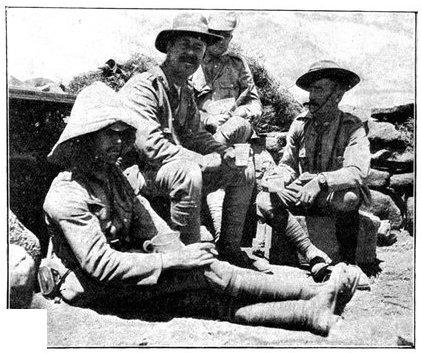
CAPTAIN ORR (in centre) AND OFFICERS OF THE NEW
ZEALANDERS ON NEW ZEALAND HILL, COLESBERG.
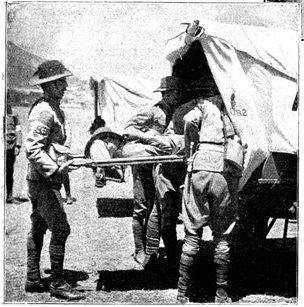
[Copyright 1900 by Underwood & Underwood.
NEW ZEALAND AMBULANCE AT WORK AFTER THE ACTION AT NEW ZEALAND HILL.
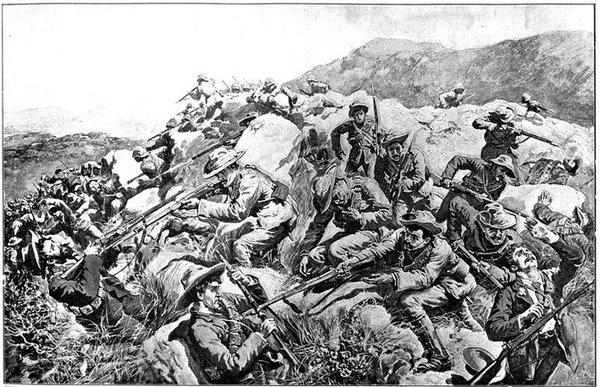
W. Small.] [
From a sketch by G. D. Giles.
NEW ZEALANDERS TO THE RESCUE: SAVING A PICKET OF THE YORKSHIRE REGIMENT
NEAR SLINGERSFONTEIN.
On January 15 a picket of the Yorkshire Regiment, about forty strong,
with thirty New Zealand Mounted Rifles were holding the spur of a
hill, since called New Zealand Hill, near Slingersfontein, when some
Boers suddenly attacked the Yorkshires at the extremity of the steep
spur. Their officer and sergeant were struck down, and the men would
have been lost had not Captain Madocks with some New Zealanders made a
sudden onslaught, rallied the Yorkshires, and routed the Boers.
[Jan. 16-22, 1900.
On January 16 there was another skirmish with the Boers near
Slingersfontein. A patrol of twenty-five Australian Mounted Infantry
and New South Wales Lancers under Lieutenant Dowling left that
position to reconnoitre northwards to Norvals Pont. On its return the
patrol was ambushed at a watering place six miles north of Colonel
Porter's camp, and the men killed, wounded, or captured, with the
exception of three, who got away and returned with the sad news to
camp. The Australians made a desperate stand before surrendering,
and inflicted some loss upon the Boers. But the affair showed the
complete knowledge of every British movement obtained by the enemy,
no doubt through the many Boer sympathisers within the British lines.
On the 18th, strong reinforcements from the Sixth Division reached
General French. The 1st Royal Irish and 2nd Worcestershire, speedily
followed by the 2nd Wiltshire, all of which battalions were included
in Major-General Clements' Brigade, arrived, [Pg 331]
[Pg 332]and with them two
5-inch howitzers. Thus strengthened, General French was able yet
further to prolong his line. Strong outposts were established at
Kleinfontein, some miles to the north-east of Slingersfontein, and at
Rhenosterfontein, not far from Norvals Pont station. The enemy, alarmed
for their communications, called up yet more reinforcements, and it
was estimated that at this date their force was about 9,000 strong,
while General French had now under his command near Colesberg almost as
many combatants. His perpetual worrying of the Boers was thus serving
two purposes—preventing them from doing any mischief in Cape Colony,
and compelling them to weaken their forces elsewhere. The front held
by the Boers at this date was thirty miles, and that of the British
thirty-eight miles: but by means of field telephones and telegraphs in
our lines reinforcements could promptly be called up to any threatened
point.
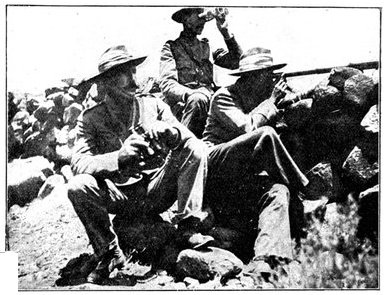
NEW ZEALAND OFFICERS WATCHING AN ENGAGEMENT NEAR
COLESBERG.
The gallant Captain Madocks in the centre.
Small actions near Colesberg.
On January 19 and 20 the howitzers shelled the Boer camps and Grassy
Hill, but, so far as could be seen, without much effect. On the 19th,
Lieutenant De Crespigny with two troopers of the Household Cavalry
came under heavy fire, and had to ride for their lives. One of the
men had his horse shot under him, when De Crespigny gallantly rode
back to his rescue and brought him off. On the 25th, General French
directed a vigorous reconnaissance against the Boer right, which had
not of late been much disturbed. With 3,000 infantry and cavalry, and a
battery each of Horse and Field Artillery, he moved up to Rietfontein
Plessis, on the Colesberg bridge road, while the rest of his troops
demonstrated all along the enemy's line. He succeeded in reaching a
point from which, with sharp fighting, he had every chance of getting
on the enemy's lines of communication, but, as the Boers were in force
and Lord Roberts's orders to avoid anything like a general action were
peremptory, the movement was not pressed. On the other flank, General
Clements shelled the Boers, who replied with their 40-pounder, killing
the General's orderly at the first shot.
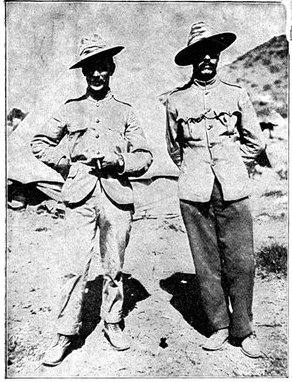
CAPTAIN MADOCKS (left) AND LIEUTENANT HUGHES (right).
Survivors of the Boer attack at Slingersfontein.
Two days after this affair four Englishmen, who had been "commandeered"
by the Free State authorities, deserted from the enemy. They brought
information that the Boers were about 5,000 strong in Colesberg, with
another force at Norvals Pont, and stated that the enemy had eight
guns, in addition to two of the captured British 15-pounders, which the
Boer gunners did not understand, and could not use effectively.
Jan. 22-Feb. 8, 1900.] French quits
Colesberg.
Guarding the railway junctions.
Gradual withdrawal of British forces.
General French had not only to watch Colesberg; he had also to think of
the railway junctions to his left and right rear at De Aar and Rosmead,
and to endeavour to reach a hand to General[Pg 333] Gatacre. The arrival of
more and more British troops relieved him of much of his anxiety for
his extreme right. The Thirteenth Brigade of the Sixth Division was
now at hand, and, under General Kelly-Kenny, pushed along the railway
from Rosmead Junction towards Stormberg, halting at Thebus on the
26th, and opening up communication with General Gatacre, by way of the
mountain roads. After these operations a comparative calm followed
during the last days of January and the first week of February. Quietly
the British forces at Colesberg and Thebus were reduced, the greater
part of the cavalry, much of the infantry, and all the Horse Artillery
being moved north to Modder River, in readiness for the great advance
into the Free State. The Boers at Colesberg, now under the command of
General De Wet, a Free Stater, who had graduated at Cambridge, do not
appear to have promptly seized the situation, or ascertained that they
were only confronted by a skeleton force under General Clements. But on
February 8, receiving information from a traitorous farmer, they began
to show more activity. On this day there was a sharp interchange of
artillery fire. A "Pom-Pom" on Horseshoe Kopje, which had caused great
annoyance, was shelled by the howitzers; one of the lyddite projectiles
burst just by the gun, and flung one of the Boer gunners no less
than 100 yards through the air. On the 9th, a reconnoitring party of
Australians, fifty strong, moved out on the right, and was engaged by a
party of 400 Boers, who lay hidden in some kopjes. With the Australians
were two correspondents, Mr. Hales and Mr. Lambie, who had a thrilling
experience, thus described by Mr. Hales:—
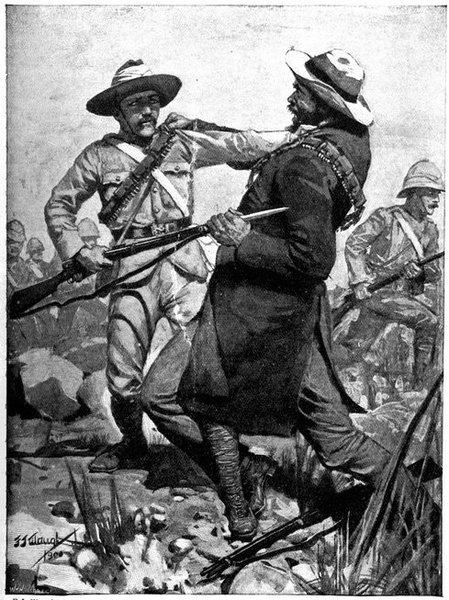
F. J. Waugh.]
CAPTAIN MADOCKS GRAPPLING WITH THE BOER LEADER.
[Feb. 8, 1900.
A ride for life.
"We had drifted a few hundred yards behind the advance party," he
writes, "but were a good distance in front of the rear guard, when a
number of horsemen made a dash from the kopjes, which we were skirting,
and the rifles began to speak. There was no time for poetry, it was a
case of 'sit tight and ride hard,' or surrender and be made prisoners.
Lambie shouted to me: 'Let's[Pg 334] make a dash, Hales,' and we made it. The
Boers were very close to us before we knew anything concerning their
presence. Some of them were behind us, and some extended along the
edge of the kopjes by which we had to pass to get to the British line
in front; all of them were galloping in on us, shooting as they rode,
and shouting to us to surrender, and had we been wise men, we should
have thrown up our hands, for it was almost hopeless to try and ride
through the rain of lead that whistled around us. It was no wonder that
we were hit, the wonder to me is that we were not filled with lead,
for some of the bullets came so close to me that I think I should know
them again if I met them in a shop window. We were racing by this time;
Lambie's big chestnut mare had gained a length on my little veldt pony,
and we were not more than 100 yards away from the Mauser rifles that
had closed in on us from the kopjes. A voice called in good English:
'Throw up your hands, you d—— fools.' But the galloping fever was on
us both, and we only crouched lower on our horses' backs, and rode all
the harder, for even a barn-yard fowl loves liberty.
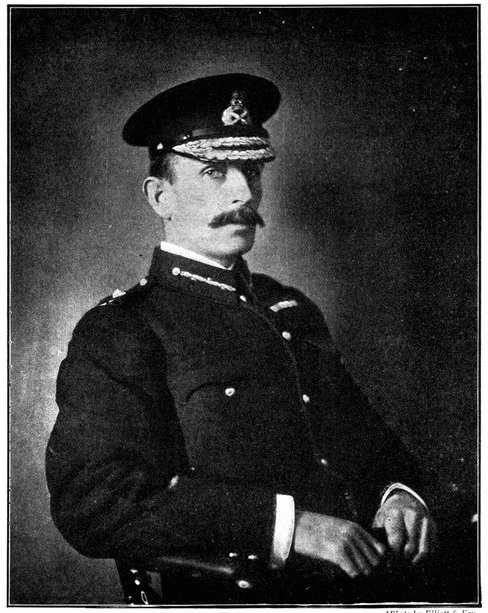
[Photo by Elliott & Fry.
GENERAL CLEMENTS.
Ralph Arthur Penrhyn Clements, D.S.O., A.D.C., commanding the 12th
Brigade, South Africa Field Force, is the son of the late Rev. J.
Clements, sub-dean of Lincoln Cathedral. He was educated at Rossall;
Lieut. 24th Foot (afterwards called South Wales Borderers), 1874;
Captain, 1880; Major, 1886; Lieut.-Colonel, 1887; Colonel, 1896;
Aide-de-Camp to the Queen, 1896; served in Kaffir and Zulu wars, 1879,
and in Burmah, where he gained the D.S.O., 1885-89.
"All at once I saw my comrade throw up his hands with a spasmodic
gesture. He rose in his stirrups, and fairly bounded high out of his
saddle, and as he spun round in the air I saw the red blood on the
white face, and I knew that death had come to him sudden and sharp.
Again the rifles spoke, and the lead was closer to me than ever a
friend sticks in time of trouble, and I knew in my heart that the next
few strides would settle things. The black pony was galloping gamely
under my weight. Would he carry me safely out of that line of fire or
would he fail me? Suddenly something touched me on the right temple;
it was not like a blow, it was not a shock; for half a second I was
conscious. I knew I was hit; knew that the reins had fallen from my
nerveless hands; knew that I was lying down upon my horse's back, with
my head hanging below his throat. Then all the world went out in one
mad whirl. Earth and heaven seemed to meet as if by magic. My horse
seemed to rise with me, not to fall, and then—chaos."
[Pg 335]
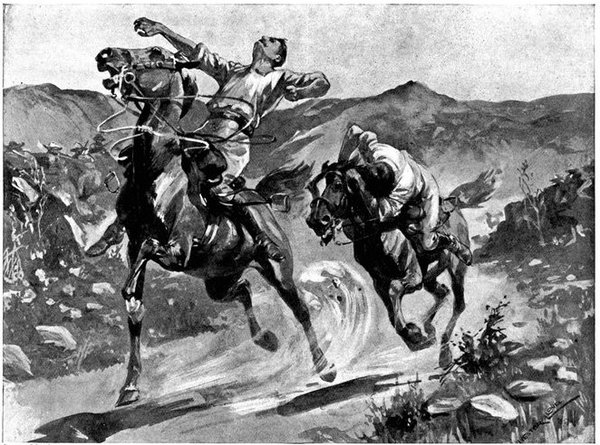
Ivester Lloyd.]
A RACE FOR LIFE.
Two newspaper correspondents risk their lives in an attempt to escape
capture.
Feb. 8-12, 1900.] Fine Work done by the
Australians.
Accuracy of Australian shooting.
Coles Kop and Slingersfontein evacuated.
[Feb. 12-15, 1900.
British retire to Arundel.
The Australians showed great steadiness and courage. A small party
under Captain Cameron dismounted and covered the retreat of the others
with a rapid and accurate fire. "They shot like lightning, not volley
after volley straight in front of them, as do regular soldiers," said
a Boer afterwards, "but every man picked his man and shot to kill.
We dared not face them." The Boers endeavoured to work round them
and cut them off, but at the right moment the colonials made a dash,
mounted their horses, and rode off under a hail of bullets, with only
one man slightly wounded. There can be no doubt that their skill in
taking cover saved them from heavy loss, if not from annihilation.
About a dozen Boers are said to have been killed. Mr. Hales was taken
prisoner, but was afterwards released by the enemy. He had been only
stunned by a fall from his horse. Another reconnoitring party of twenty
Australians under Captain Moor had a precisely similar experience on
this same day near Slingersfontein. They were surrounded on a kopje,
and the Boers called to them to surrender. They replied by shouts of
defiance, telling the enemy that "Australia is here to stay," and by
their steady fire kept the burghers at bay. Meantime, Sergeant Edwards
and two troopers ran the gauntlet of the enemy's rifles, and brought
news to the nearest camp that the Australians would hold out till
dusk. The 6th Dragoons were sent out to support them, and succeeded in
getting them away with one killed and three wounded. On this same day
the Boers began to drive in the British left, seizing Bastard's Nek,
placing a 40-pounder in position there, and menacing the position at
Coles Kop. On the 10th several British patrols were cut up, and Boer
parties appeared on the road between Rensburg and Slingersfontein. The
position was becoming untenable, and General Clements was hard put to
it to hold his own. On the 12th the Boers vigorously attacked all along
the line, and our troops were compelled hastily to abandon Coles Kop,
sending down the two guns from the top. The half battalions of the
Berkshires and Wiltshires[Pg 336] were compelled to fall back upon Maeder's
Farm, suffering considerable losses, the Wiltshires alone losing
thirteen men. The 6th Dragoons and Australians covered the retirement
in this quarter, and prevented the Boers, who came on in great
numbers, from doing much damage. On the British right a determined
attack was delivered by the enemy upon Slingersfontein, supported
by the "Pom-Pom" and some field guns. They assaulted the kopjes on
this flank, which were held by three companies of Worcesters under
Captain Hovell, and, though their onset was repulsed, the Worcesters
lost heavily, no less than fifteen men being killed and twenty-nine
wounded. Severe punishment was, however, inflicted upon the Boers. The
Bedfordshires and Royal Irish were also engaged, and were driven back
on Slingersfontein. The Boers were seen to be moving their 40-pounder
into a position whence it could shell the British camp, whereupon a
further retirement was at once ordered. Under cover of darkness the
troops evacuated Slingersfontein and concentrated at Rensburg. Even
this point could not be long held, and on the 14th General Clements had
once more to retreat to Arundel, after severe fighting. An "unfortunate
occurrence" marked the retirement. Two companies of Wiltshires, who
were on outpost duty near Rensburg, did not receive the order to
evacuate their position and fall back with the rest of the troops, and
remained behind. On the morning of the 15th they were surrounded on
some kopjes and attacked by the Boers in overwhelming force. Escape
was impossible; General Clements was too weak to give them any help or
extricate them, even if he had known of their situation, and, after
a brave resistance, in which 12 officers and men were killed and 45
wounded, 103 unwounded men laid down their arms. They had suffered
terribly from thirst before they surrendered. The Boers claimed that
their own losses were only the now invariable "two killed and four
wounded."
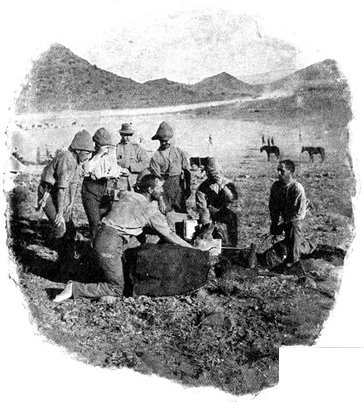
[Copyright 1900 by Underwood & Underwood.
MAKING GAS FOR WAR BALLOONS AT SLINGERSFONTEIN.
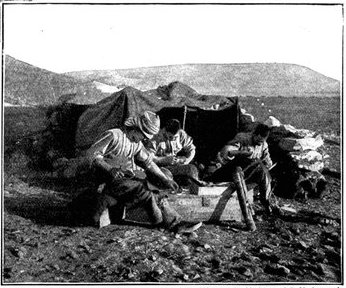
[Copyright 1900 by Underwood & Underwood.
SHOEMAKERS OF THE 1st ROYAL IRISH REGIMENT IN THE CAMP AT
SLINGERSFONTEIN.
Dec. 30, 1899-Jan. 10, 1900.]
Difficulties with Germany.
Thus General Clements with about 3,000 men had been dislodged in a few
days, defeated, and driven back to the point from which, two months
before, General French had started. Yet he had none the less rendered
good service by keeping a large force of Boers occupied in operations
which brought them no substantial success, at the very time when they
should have been hurrying north to save Cronje. After the 15th the
Boers seem to have discovered that they were confronted only by a
skeleton[Pg 337] force and to have at last realised their mistake. But it was
already too late; the 150 miles from Arundel to Paardeberg could not
be covered in time to effect a junction with General Cronje, and that
gallant burgher had to be left to his doom. Meantime General Clements
was reinforced, and in view of the weakening of the Boers in his front,
was no longer in serious danger.
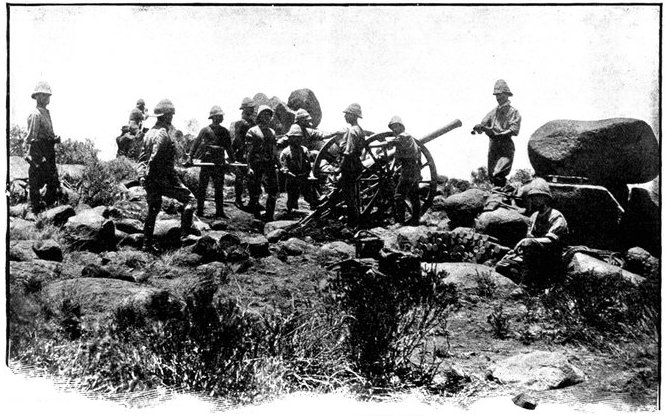
Photo by R. C. E. Nisson.]
FIELD ARTILLERY ON COLES KOP.
A 15-pounder of the 4th Field Battery under Lieutenant Maine firing
from the top of the hill.
Seizure of German steamers.
While these things were happening in Colesberg and at the front, grave
political difficulties had arisen at home over the seizure of the
German steamers Herzog, Bundesrath, and General, on the charge
of carrying contraband to Delagoa Bay. The Bundesrath was brought
into Durban as prize to the British cruiser Magicienne on December
30. On being chased she had changed the position of her cargo, an act
which was certainly calculated to give rise to grave suspicions. A
search of nine days' duration at Durban, however, failed to disclose
any contraband in her hold, and the German Government in the most
peremptory manner demanded her immediate release. It insisted that
Delagoa Bay being a neutral port, German ships could carry what
they liked to that place, though it also gave an assurance from the
steamers' owners that there was no contraband on board. Before a
definite answer had been returned to its demand, the General was
stopped and searched at Aden, on January 4, and the Herzog, on
January 6, was brought into Durban as prize of the cruiser Thetis.
At this news German public opinion, which had all through the war
been bitterly hostile to England, was thoroughly aroused, and the
German Government took action which savoured of open unfriendliness,
demanding the immediate release of all three vessels and the payment of
compensation. Yet it was notorious that the three ships were crowded
with foreigners, enlisted in Europe by the Transvaal secret agents, and
proceeding to the front to take part in the war. The German Government
had made use of British troubles at an earlier period to obtain Samoa,
and now employed its dispute with England as an argument for a greater
German Navy—to be used, it was hinted, in the not remote future
against England.
[Jan. 1900.
Lord Roberts conciliates the Colonials.
On January 10 Lord Roberts and Lord Kitchener had reached Capetown.
Their first step was to do all that was possible to stimulate the
enrolment of Colonial troops. Almost immediately after landing Lord
Roberts visited Rosebank Camp, where the South African Light Horse had
their quarters. One regiment had already been raised and sent to the
front in Natal, and now two more were[Pg 338] added, known as Roberts' and
Kitchener's Horse respectively. Furthermore, Lord Roberts appointed
a distinguished Colonial officer, Colonel Brabant, who had great
experience in South African war, a Major-General, and proposed that he
should command a division composed entirely of Cape Colonials. This
action roused general enthusiasm. Hitherto the British officers of the
army had looked askance at the Colonial and pronounced his methods
irregular. Indeed, so much friction had arisen between the Colonial
levies and the British staff that many of the Colonials were anxious to
leave the ranks, in which their only rewards were constant snubbings
from the military authorities. Lord Roberts by his exquisite tact put a
stop to all this. He chose for his own bodyguard these very Colonials
as a sign that he appreciated their services. He soothed the ruffled
susceptibilities of all, and sent everyone back to his place with
the feeling that the new Commander-in-Chief was a man of exceptional
detachment from his environment—free from all prejudices and from all
traces of red-tape, absolutely just and impartial. And what was more,
he charmed as well as soothed. It was said of the great Chatham that no
one left his presence without feeling himself a nobler and a stronger
man. The same was true of Lord Roberts.
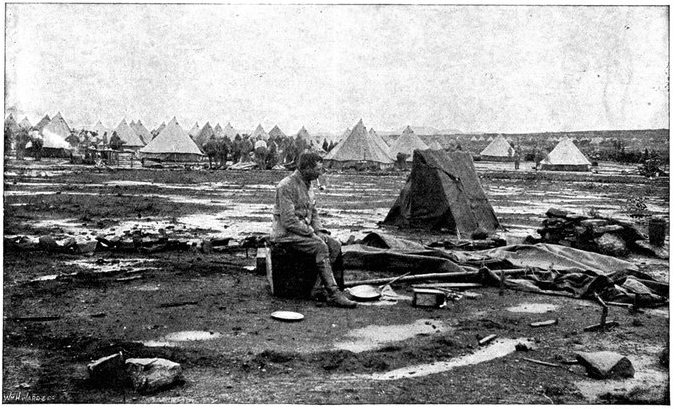
[Photo by R. C. E. Nisson.
THE WRECK OF A HAPPY HOME.
A disconsolate war correspondent amidst the ruins of his tent after
a thunderstorm. The photograph illustrates how readily the dry and
parched veldt is transformed into a swamp.
In all, the troops placed in the field from first to last by Cape
Colony amounted to about 18,000 men, distributed in the following
regiments:—
| Duke of Edinburgh's Rifles |
1,189 |
| Cape Garrison Artillery |
566 |
| Capetown Highlanders |
464 |
| Port Elizabeth Guards |
518 |
| East London Rifles |
673 |
| Grahamstown Rifles |
560 |
| Kimberley Regiment |
800 |
| Capetown United Rifles and Cape Police |
1,000 |
| South African Light Horse |
600 |
| Brabant's Horse: 1st Regiment |
600 |
| " " 2nd Regiment |
600 |
| " " 3rd Regiment |
about 400 |
| Roberts' Horse |
600 |
| Kitchener's Horse |
600 |
| Railway Pioneers |
1,200 |
| Bayly's Mounted Rifles |
450 |
| Nesbitt's Horse |
400 |
| Orpen's Horse |
300 |
| Kimberley Light Horse and other Irregulars at Kimberley |
3,200 |
| Griqualand Mounted Rifles |
1,200 |
| Cape Mounted Rifles |
492 |
| Kaffrarian Mounted Rifles |
540 |
| Queenstown Mounted Rifles |
200 |
| Frontier Mounted Rifles |
145 |
Jan.-Feb. 1900.] Reorganisation of the Army and
the Transport.
Even this list is not complete and exhaustive, though it is fuller
than many which have appeared. Of these troops some were employed in
guarding Capetown itself, where a supposed plot on the part of Boer
sympathisers to seize the town on the first day of the new year,
had caused great uneasiness; others were placed on the lines of
communication; and about 3,000 were slowly concentrated in the east of
Cape Colony, where, under General Brabant—a man almost as loved and
trusted as Lord Roberts himself, and proved by after events to be a
bold and skilful General, never beaten in the field—they were to take
part in the new campaign as soon as Lord Roberts gave the signal for
the great forward move. Had the Colonials only been listened to at the
outset, many defeats and much dishonour would have been avoided. For,
from the first, they had preached the necessity of fighting the Boers
with mounted men. They now, under the wise Lord Roberts, were given a
full share of hard work and glory, and became a source of real terror
to the Boers, who never were comfortable when they were about.
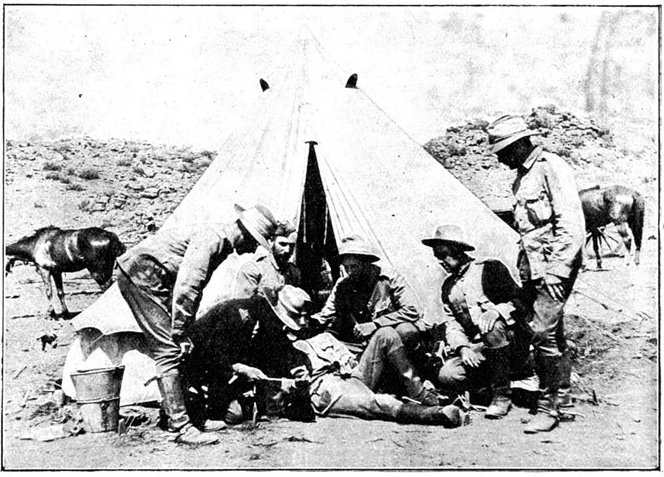
DR. BURNS ATTENDING A WOUNDED NEW ZEALANDER.
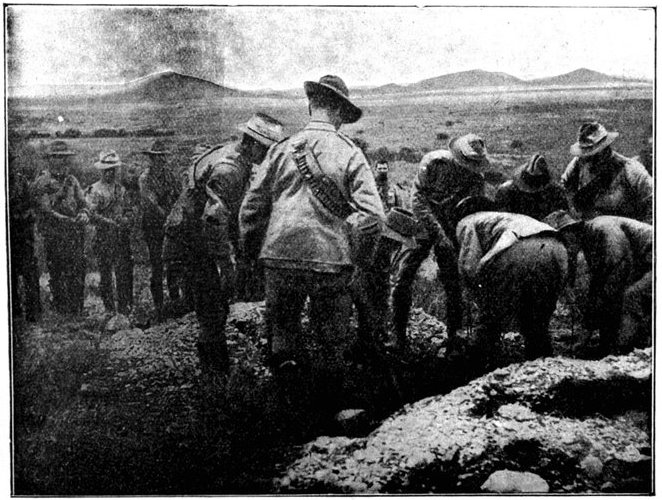
NEW ZEALANDERS BURYING THEIR DEAD COMRADES.
Reorganisation of transports.
[Jan.-Feb. 1900.
While Lord Roberts was organising troops and rearranging the
distribution of the forces in South Africa, while day by day
battalions, and batteries, and squadrons poured in from England, the
rough material with which to build the edifice of the new campaign,
Lord Kitchener on his part was busy with the transport and discipline
of the army. Rumour has it that he impounded some score of gay young
officers whom he found at Capetown with leave from the front, and set
them to drive quills in his quartermaster's department. This did not
make him beloved, but it proved he was determined that all should do
their duty. He ruthlessly cut down the allowance of transport, took
away from the regiments their regimental waggons, and organised a
separate and distinct transport service. He found that the train of
waggons had been much scattered, and one of his first acts was to
recall about 400 teams and vehicles from Queenstown in the east of the
Colony. The work of organisation and preparation to which he devoted
his time was neither glorious nor particularly interesting, but it was
necessary if the army was to be able to move away[Pg 340] from the railways,
and he accomplished it with success, even if after events did not prove
all his innovations to have been judicious.
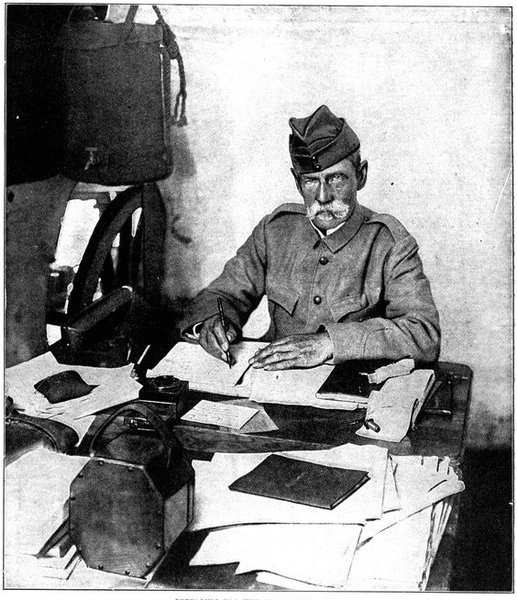
PREPARING FOR THE GREAT CAMPAIGN.
Lord Roberts in his travelling headquarters waggon. The photograph
was taken while the Field-Marshal was in the midst of the work of
reorganisation.
Feb. 6, 1900.] Preparations at Capetown
Completed.
Roberts and Kitchener leave Capetown.
Till the time came for striking, and striking hard, Lord Roberts'
instructions to his commanders in the western field of war were to
abstain from anything calculated to bring about a decisive battle;
30,000 men were already at sea or arriving in Cape Colony—among
them the Sixth and Seventh Divisions, the City Imperial Volunteers,
several Militia battalions, the first detachments of Yeomanry, and a
large number of Australian and Canadian Mounted Rifles. Of the troops
already on the spot,[Pg 341] a considerable number were being converted into
mounted infantry. Thus week after week passed in the most strenuous
activity, till at last, on February 6, the Commander-in-Chief and
his Chief-of-the-Staff stole off surreptitiously—for there were
many thousands of Boer sympathisers in the Colony, and attempts to
derail and wreck trains were of almost daily occurrence—to the
far-away Modder River Camp, whence the great movement was to begin.
To deceive would-be assassins, of whom, unfortunately, there were
many in the Colony, a special train with fifty armed men on board was
ostentatiously despatched. Lord Roberts, however, did not travel in it;
instead, he boarded the ordinary train outside Capetown, and in this
manner began his journey to the north.
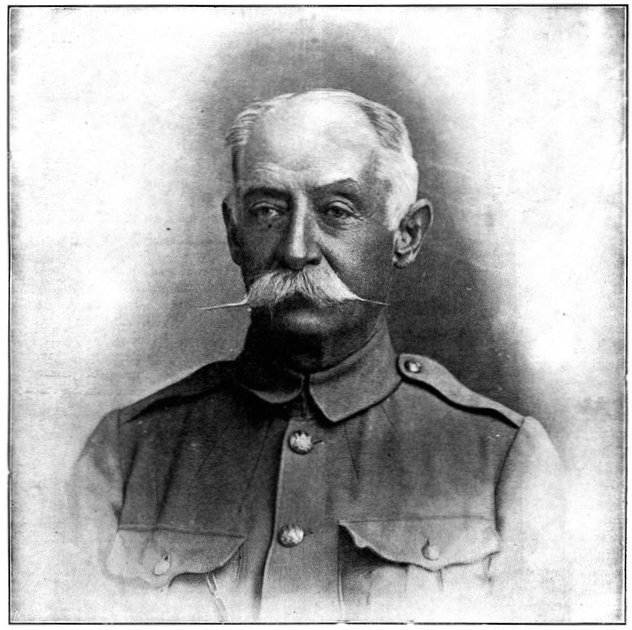
[Photo by Lloyd, Pembridge Square.
BRIGADIER-GENERAL BRABANT.
Is about sixty years of age. He entered the 2nd Derby Militia as Ensign
in 1855, but went abroad and joined the Cape Rifles a year later, rose
to the rank of Captain, and retired in 1870. He was elected, in 1873,
member of the Legislative Assembly for East London; Field-Commandant of
Colonial (Cape) Forces, 1878; Col. of Cape Yeomanry, 1879; served in
the Basuto War and was created C.M.G. in 1880; Brigadier-General, 1899.
[Dec. 13, 1899-Jan. 3, 1900.
At Modder River there had been inactivity since the disastrous day
of Magersfontein—inactivity broken only by reconnaissances and
demonstrations. As far back as December 13, a reconnaissance had
been directed from Orange River Station to Zoutpan's Drift, some
miles to the east of the great
[Pg 342] bridge by which the railway from
De Aar to Modder River crosses the Orange River. Seventy men of the
mounted infantry and of Rimington's Guides were sent out under Captain
Bradshaw; at Ramah, a farm just upon the Free State frontier, they
were surprised by the enemy in some force, and lost four killed and
eight wounded, including Captain Bradshaw, killed. The Boers, after
inflicting this loss, fell back.
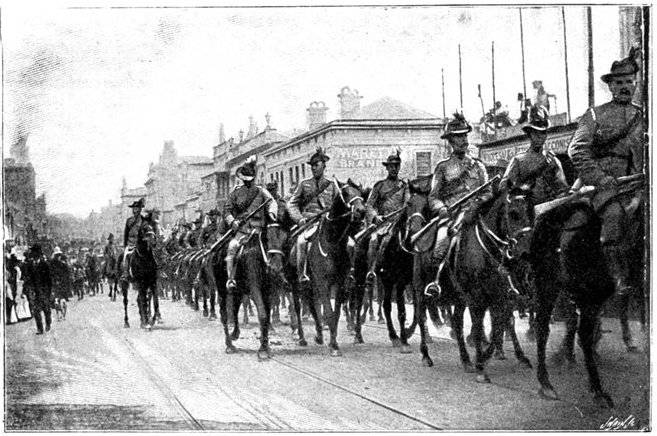
DEPARTURE OF THE SECOND QUEENSLAND CONTINGENT FROM
BRISBANE.
The first contingents supplied by the Colonies were sent off with wild
enthusiasm by the great crowds which witnessed their departure. A more
sober, but not less impressive, loyalty marked the departure of later
contingents. War had, even to the man in the street, become a dread
reality.
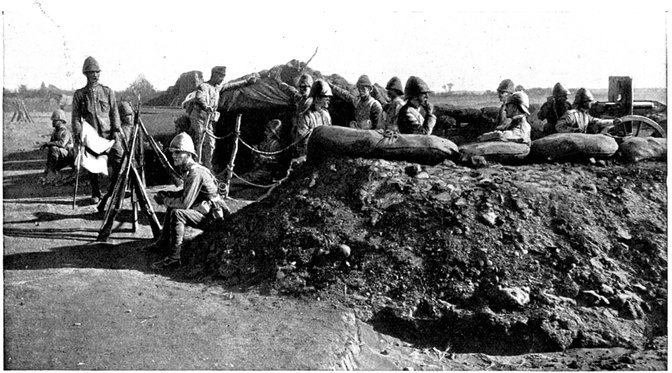
ON THE WATCH: AN OUTPOST AT MODDER RIVER, AFTER THE
BATTLE OF MAGERSFONTEIN.
Lord Methuen keeps the enemy busy.
Jan. 8-Feb. 4, 1900.] Minor Movements
from Modder River Camp.
Meantime Lord Methuen at Modder River shelled the enemy almost daily
with his 4·7 naval guns and howitzers. More than once the Boers at
night, evidently in constant dread of attack, opened suddenly a
terrific rifle and Maxim fire. On December 31 a small composite force
under Colonel Pilcher was despatched from Belmont to attack a laager
of rebels at Sunnyside, near the little village of Douglas, to the
north-west of Belmont. The force was remarkable in that it was made up
of Canadians, Australians, and Imperial troops, including as it did the
Toronto company of Canadians, 100 strong, 200 Queenslanders, 40 mounted
infantry of the Munster Fusiliers, and 200 of the Duke of Cornwall's
Light Infantry, with two guns of the Horse Artillery. Great precautions
were taken to prevent the enemy gaining any knowledge of the intended
move. No one was allowed to leave the British camp for some time
before the march began, and all natives were shut up and their names
repeatedly called. Early in the morning of January 1, the force was
close to the enemy's camp. The rebels were in complete ignorance of its
approach; and the camp was asleep when the British guns suddenly opened
fire. The Queenslanders and Canadians at once worked in splendid style
towards the astonished Boers, making every use of cover. The great bulk
of the enemy bolted when the burghers found their flanks threatened;
a few, however, were cut off by the British advance and raised the
white flag; forty-three prisoners and the rebel laager fell into our
hands. From Sunnyside the column marched to Douglas and re-hoisted the
British flag there, but on January 3 had to retreat, taking with it all
the loyal inhabitants, and to return[Pg 343] to Belmont. Against this small
success had to be placed the loss of Kuruman, where 120 of the Cape
Police and native half-breeds had for months defied the Boers, holding
out in the school-house.
On January 8 an important reconnaissance was made into the Free State.
From Modder River moved the 9th and 12th Lancers, a force of mounted
infantry, and a section of G Horse Artillery Battery; from Enslin a
squadron of the 2nd Dragoons, with detachments of mounted infantry,
and from Belmont the Australians and Canadians. The Boers were seen to
be in strength at Jacobsdal, but there were none of them to the south
of the Riet. About the same time Zoutpan's Drift was occupied, and a
British post permanently established in the enemy's territory.
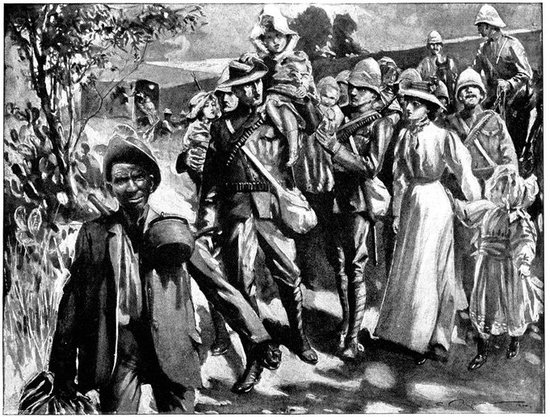
A. C. Ball.]
THE RETREAT FROM DOUGLAS.
The Canadians carried the children of the loyalists and kept up the
spirits of the whole party by singing.
On January 16 Lord Methuen made a demonstration against Magersfontein,
where the Boer works had of late been considerably extended and
strengthened. His object was to draw the enemy away from Kimberley,
and also to ascertain to what extent they had weakened their force by
detachments sent to Colesberg and Ladysmith. A bombardment of the Boer
works speedily brought the burghers up in force from Jacobsdal, and it
was found that their lines were well held.
Demonstrations towards Koodoesberg Drift.
[Feb. 5-9, 1900.
On January 26 General Macdonald arrived and took over the command of
the Highlanders, from whom he had a tremendous reception. To deceive
the Boers and draw off their attention from the British right, where
Lord Roberts intended to deliver his serious blow, a demonstration to
the left was ordered. Accordingly, on February 4, General Macdonald,
with the Highland Brigade and the 62nd Field Battery, moved to
Koodoesberg Drift, an important crossing of the Modder, sixteen miles
to the west of Modder River Camp; at the same time General Broadwood
with Roberts' Horse, the mounted infantry, and a battery of Horse
Artillery, advanced to Sunnyside, the scene of Colonel Pilcher's
victory. General Macdonald,[Pg 344] after a terrible march in scorching heat,
found Koodoesberg Drift deserted, and entrenched himself there on both
sides of the river, on the 5th. Next day, towards evening, a commando
of Boers approached and skirmishing began. The enemy was reinforced,
and, seeing a chance of cutting them off, General Macdonald sent for
cavalry on the morning of the 7th. Skirmishing went on all day, and the
British suffered some loss from the enemy's fire, amongst the killed
being the famous golfer, Lieutenant Tait. Four regiments of cavalry
with two horse batteries, under General Babington, arrived in the
evening of the 7th; but the Boers were not to be caught, and made off
at dark. As the object of the demonstration had been fully attained,
the whole force was then ordered back to Modder River Camp. The British
casualties were eight killed and thirty-nine wounded.
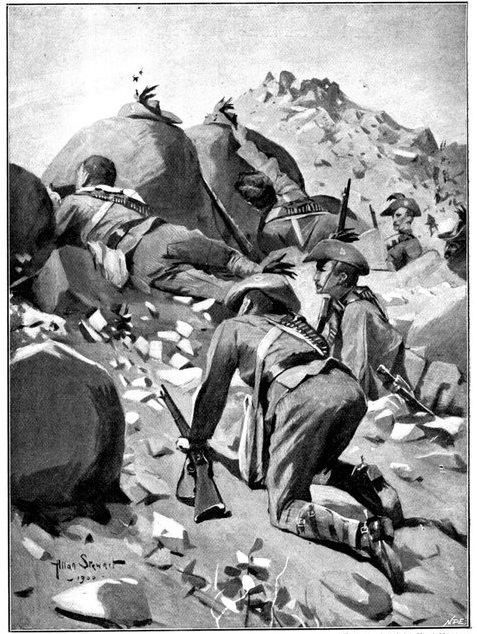
[From a sketch by Fred Villiers.
COLONEL PILCHER'S COLONIALS DRAWING THE ENEMY'S FIRE BY PLACING THEIR
HATS WITHIN VIEW.
Roberts in camp.
On February 9 Lord Roberts arrived at Modder River, and was received
with an enthusiasm that knew no bounds. His first act was to review the
Highlanders just returned from Koodoesberg Drift, and congratulate them
upon their steady behaviour. He told them that stiff work lay before
them, and yet, striking the note of hopefulness, he added that success
was certain. His speech had the best effect. Next day a redistribution
of the troops took place, and a new Division, the Ninth, was formed of
the battalions which had reinforced Lord Methuen from the time when
he began his advance from Orange River; General Sir H. Colvile was
appointed to command it, and General Pole Carew was transferred from
the Ninth Brigade to the Guards' Brigade to take General Colvile's
place. All was now ready for the great forward move.
General Kelly-Kenny with a brigade of the Sixth Division, General
French with a large force of cavalry and infantry from Colesberg,
and the whole Seventh Division recently landed from England had
concentrated at Modder River Camp. As the plain grew white with the
tents of 35,000 combatants, Cronje's advisers, watching, grew more and
more uneasy. "They will turn your flank" was day by day the warning
of Major Albrecht. But Cronje had a firm belief that no British force
would ever be able to leave the railway, and a flanking movement on
Lord Roberts' part was impossible unless this was done.
Feb. 10, 1900.] Roberts Ready to Strike.
Preparations for the great blow.
In striking from Modder River instead of Colesberg and Norvals Pont,
Lord Roberts had two objects. He wished to begin his campaign with
a tremendous blow—and such the destruction of Cronje would prove.
He would also be saved the delay which must inevitably be caused by
bridging[Pg 345] so wide a river as the Orange. If all went well he might
be able to turn rapidly upon the Colesberg Boers after settling with
Cronje. Whatever happened, he was certain of relieving Kimberley, which
the Boers were now shelling with a great 6-inch gun.
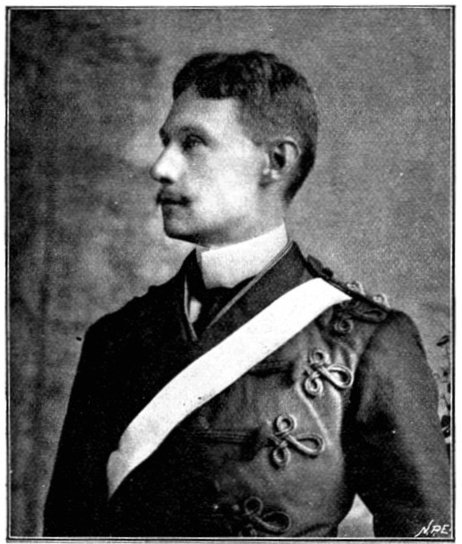
[Photo by Robinson, Dublin.
LIEUT.-COLONEL T. D. PILCHER.
(Of the Bedfordshire Regiment), commanding Mounted Infantry.
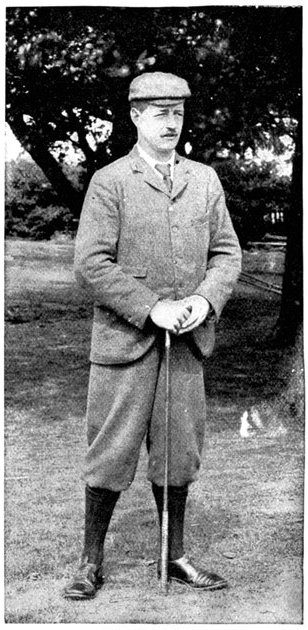
LIEUT. TAIT.
Amateur golf champion. Killed at Koodoesberg.
Since the losses had not entirely been made good by drafts, the
strength of Lord Roberts' army, as it stood ready to strike on February
10, may be estimated at 26,000 infantry, 4,000 cavalry, 3,500 mounted
infantry, and about 120 guns, including the 6-inch howitzers of the
siege train. It was by far the largest and the best organised wholly
British force that had ever taken the field. Australians, Canadians,
and Ceylon planters were among the mounted infantry; Afrikanders, among
the Cape volunteers; but the great majority came from within the limits
of the British Isles.
Composition of the Grand Army.
Lord Roberts' army was composed of four infantry divisions and one of
cavalry, as follows:—
| FIRST DIVISION. |
SIXTH DIVISION. |
| LIEUT.-GENERAL LORD METHUEN. |
LIEUT.-GENERAL KELLY-KENNY. |
| 1st (Pole-Carew's) Brigade. |
9th (Douglas's) Brigade. |
18th (Stephenson's) Brigade. |
13th (Knox's) Brigade. |
| 3rd Grenadier Guards. |
1st Northumberland Fusiliers. |
1st Essex. |
2nd East Kent. |
| 1st Coldstream Guards. |
1st Loyal North Lancashire. |
1st Yorkshire. |
1st Oxfordshire Light Infantry. |
| 2nd Coldstream Guards. |
2nd Northamptonshire. |
1st Welsh. |
1st West Riding. |
| 1st Scots Guards. |
2nd Yorkshire Light Infantry. |
2nd Royal Warwick. |
2nd Gloucester. |
| 83rd, 84th, and 85th Field Batteries. |
76th, 81st, and 82nd Field Batteries. |
| SEVENTH DIVISION. |
NINTH DIVISION. |
| LIEUT.-GENERAL TUCKER. |
LIEUT.-GENERAL COLVILE. |
| 14th (Chermside's) Brigade. |
15th (Wavell's) Brigade. |
3rd (Macdonald's) Highland Brigade. |
19th (Smith-Dorrien's) Brigade. |
| 2nd Norfolk. |
2nd Cheshire. |
| 2nd Lincoln. |
1st East Lancashire. |
1st Argyll and Sutherland. |
1st Gordon Highlanders. |
| 1st King's Own Scottish Borderers. |
2nd South Wales Borderers. |
1st Highland Light Infantry. |
2nd Duke of Cornwall's Light Infantry. |
| 2nd Hants. |
2nd North Stafford. |
2nd Seaforth Highlanders. |
2nd Shropshire Light Infantry. |
| 18th, 62nd, and 75th Field Batteries. |
2nd Royal Highlanders. |
Canadian Regiment. |
| CAVALRY DIVISION. |
MOUNTED INFANTRY. |
| LIEUT.-GENERAL FRENCH. |
| 1st (Porter's) Brigade. |
2nd (Broadwood's) Brigade. |
3rd (Gordon's) Brigade. |
Hannay's Brigade. |
Ridley's Brigade. |
| 6th Dragoon Guards. |
10th Hussars. |
16th Lancers. |
| 6th Dragoons. |
12th Lancers. |
9th Lancers. |
| 2nd Dragoons. |
Household Cavalry. |
Roberts' Horse. |
| G, O, P, Q, R, T, and U Horse Artillery Batteries. |
| CORPS TROOPS. |
| City Imperial Volunteers (Mounted Infantry). |
| Kitchener's Horse. |
| Rimington's Scouts. |
| 38th Field, 65th Howitzer Battery. |
| Siege train (including four 6-inch howitzers). |
| Four 4·7-inch naval guns; four 12-pounders. |
That night of the 10th the search-light in the British camp answered
the message of Kimberley with the glad words—"We are coming."
[Pg 346]
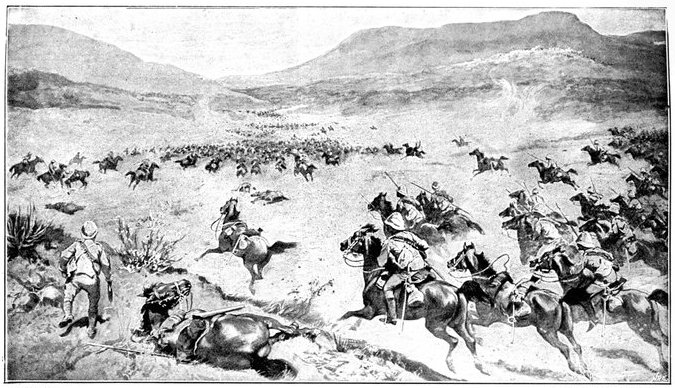
W. S. Small.] [From a sketch by G. D. Giles.
CLEARING THE ROAD TO KIMBERLEY: THE BRITISH CAVALRY CHARGING AT KLIP
DRIFT.
CHAPTER XVI.
THE GRAND ARMY RELIEVES KIMBERLEY.
Lord Roberts addresses the officers—Cavalry
leaders—Advance to Ramdam—French at Waterval
Drift—De Kiel's Drift secured—Sunset on the
veldt—Cronje's optimism—The cavalry push
forward—Heat and thirst—Veldt on fire—Rondeval and
Klip Drifts seized—Advance of the infantry—Halt
at the Modder—Cavalry opposed—Lancers clear
a nek—In touch with Kimberley—Capture of
Alexandersfontein—Entry into Kimberley—Bivouac
in a Boer camp—C.I.V.s' baptism of fire—Seizure
of Jacobsdal—Convoy attacked by De Wet—Waggons
abandoned—Cronje's retreat—The Boers carry off their
big guns—Orders to head Cronje.
Lord Roberts addresses the officers.
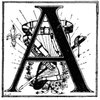
As the night of the 10th fell, there was an unwonted bustle in Modder
River Camp. Train after train laden with troops went rattling southward
through the darkness, carrying battalions and batteries to the points
of concentration down the line. The whole cavalry division was under
orders to start at 3 a.m. Lord Roberts, in his plain khaki uniform,
with no sign of his countless orders and decorations, had, earlier
in the evening, ridden round the various camps. He now convened the
commanding officers of the cavalry division and made them one of his
brief speeches. They were about, he said, to start upon an expedition
which he knew they would welcome as an opportunity of maintaining the
traditions of British cavalry. They formed the largest British cavalry
division that had ever worked together as a whole. The object of their
operations was the relief of Kimberley. Things were so desperate that a
dash must be made, and he would follow as best he could with the rest
of the army. Lord Kitchener had put the need for sacrifice even more
strongly. The cavalry, he had said, were to reach Kimberley even if
they left half their strength upon the road.
Cavalry leaders.
Stirring words these to great cavalry leaders such as those now
gathered at Modder River Camp. There was the short, quiet, restrained,
unimposing figure of General French—the ablest officer that the war
had hitherto revealed. There were the trim and alert Broadwood and
Gordon, both with good service to their record and each commanding
a brigade of three regiments of horsemen. The third brigade, until
General Porter's arrival, was under Colonel Alexander. In the very
note of Lord Roberts' orders to them was that touch of confidence and
decision which sweeps men with it and tells them that they are being
splendidly led.
[Pg 347]
Feb. 10-11, 1900.] The Army leaves Camp.
Advance to Ramdam.
All down the line men were in movement. From Orange River Camp, on
the morning of the 10th a great convoy, hundreds of waggons strong,
was advancing on Ramdam, an important road-junction, in charge of a
strong force of mounted infantry under Colonel Hannay, whose task it
was to clear of the enemy the country to the south of the Riet. All
the 11th he was in contact with a party of 300 or 400 Boers, detached
from Cronje's force, who hung upon his flanks and rear, skirmishing
continually, but none the less he held steadily on his way to Ramdam.
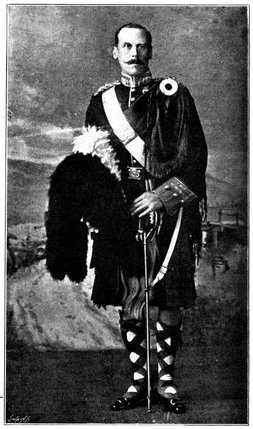
[Photo by Elliott & Fry.
LIEUT.-COLONEL HANNAY.
(Argyll and Sutherland Highlanders).
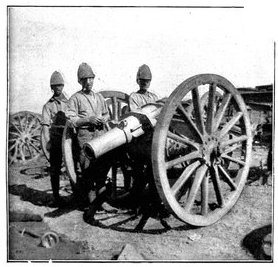
HOWITZERS OF THE 37th BATTERY.
Photographed immediately after the fight at Sunnyside, in which they
had taken an active part.
[Feb. 11-12, 1900.
Punctually at 3 a.m. of the 11th, the day of prayer and intercession
for success in England, General French led out his cavalry regiments
and his horse artillery in magnificent procession—the last seven
batteries or 42 guns strong. The night had not yet given way to dawn,
when he struck due south from Modder River Camp, leaving his tents
standing to deceive the enemy. The spectacle was a very fine one.
"Out of the moonlit dust," writes an officer, "one could discern a
squadron of Lancers trotting up into position, the lances standing out
against the sky-line, the heads and shoulders of the men being just
visible, while the lower portion of their bodies and the horses faded
into obscurity. Then there would come with a heavy rumble a battery
of artillery, similarly vignetted in the moonlit dust, or, perhaps,
an ambulance section, with its red cross, or a battalion of mounted
infantry, while hoarse, short words of command caught the ear on all
sides." The troopers marched light with only their arms, the clothes
they wore, and five days' rations. In the darkness the horses stumbled
often over the holes of the ant-bears. Now and then a cavalryman would
come heavily to earth; at times a half-dozen of men and horses would
be floundering in one confused heap, and the cry was heard on every
side—"Hole here!" "Hole to the right!" The horses were for the most
part in bad[Pg 348] condition. They had not recovered from the long sea voyage
before they were put to the hardest of work in an unfamiliar climate.
The mounted infantry men, too, were not skilled in the art of sparing
and saving their horses. The move in the fierce heat to Koodoesrand
Drift, at General Macdonald's demand, had put a great strain upon one
of the cavalry brigades, from which it had not entirely recovered. And
so, as in the twilight the dust-shrouded column swept down towards
Ramdam, twenty miles away, some of the horses already began to show
signs of weakness. The railway was followed as far as Graspan, so as
to afford not the slightest indication of the division's object. Then
turning east, Ramdam was struck about mid-day. The place which bulks
so large upon the map was merely a farmhouse with one or two hovels
near, a well, and a "pan" or large pond of water, dry except during
the rains. The thirsty men crowded round the well; the horses were
taken down to the pan, for the day had been one of broiling heat. Here
Colonel Hannay's men fell into the column, reporting a loss of 39
killed, wounded, or missing; here, too, drafts and details from the
base joined up, swelling the gathering of cavalry; and here presently,
as night came on, long columns of infantry of the Sixth Division began
to arrive. Far off on every side to the west rose clouds of dust,
marking the advance of a great army. Three divisions were upon the
move, besides the cavalry. First came the Sixth, then the Seventh, and
last the Ninth Division, each a day apart, heading steadily for Ramdam
and the Riet.
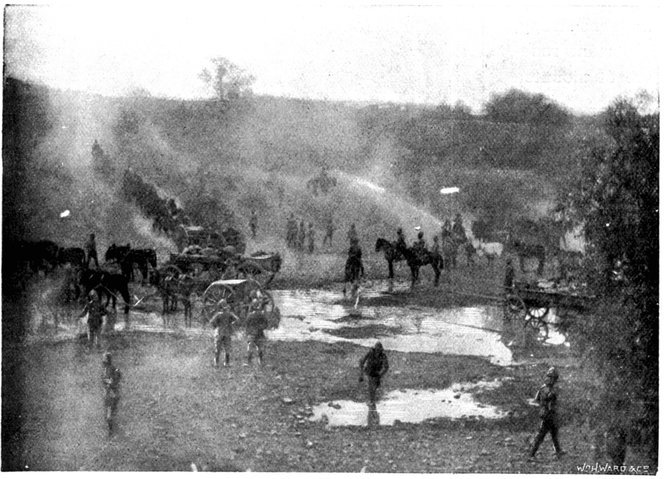
DE KIEL'S DRIFT.
Getting the water-carts, &c., across amidst clouds of dust.
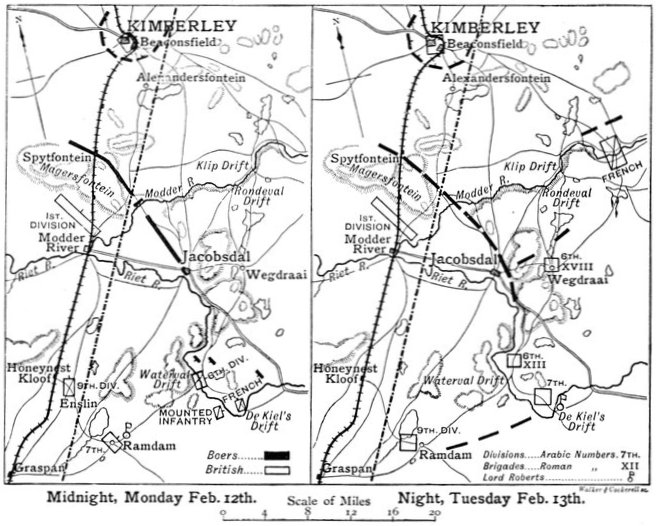
[Walker & Cockerell sc.
Midnight, Monday Feb. 12th. Night, Tuesday Feb. 13th.
French at Waterval Drift.
Feb. 12, 1900.] Passage of the Riet.
So far General French himself had not been in touch with the enemy.
But on the morning of the 12th, when his troops saddled up and started
on a short seven miles ride to Waterval Drift upon the Riet, it was
clear that the Boers were approaching. They were the same party that
had been engaged by Colonel Hannay on the previous day, reinforced[Pg 349] by
400 men from Magersfontein. The start was made at 3 a.m., yet though
Rimington's famous scouts, who knew every inch of the ground, were
guiding, the darkness just before dawn was such that a halt became
imperative, and the general's intention of seizing the drift before
clear day broke was frustrated. As the red light of early dawn showed
over the kopjes to the east, the march was resumed, and about 6 a.m. a
few shots were fired upon the British left flank when the column neared
the drift, and a gun galloped out into the open and began a rapid and
well-directed fire upon the British troops. General French found that a
kopje in his immediate front was strongly held. What was to be done?
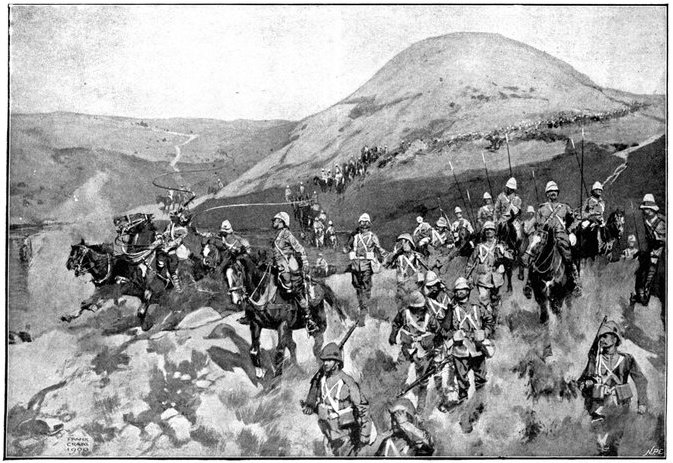
Frank Craig.] [
From a sketch by G. D. Giles.
THE CROSSING OF THE RIET.
Showing the kopjes south of the river which the enemy tried, too late,
to seize.
De Kiel's Drift secured.
[Feb. 12-13, 1900.
For the moment the Horse Artillery were ordered to silence the Boer
gun—a task which it achieved with the greatest expedition. Then the
general boldly determined to try a new kind of strategy, which was
nothing more nor less than to walk his men round the Boers, and leave
them disconsolately holding their kopje against no one, and reflecting
sadly upon the fact that at last the "rooineks" could move as fast
as or faster than themselves. But not wishing as yet to disclose his
real intentions, he directed General Gordon with one brigade to go
through all the elaborate ritual of an attack, shelling the kopjes and
holding the enemy's attention. While this display was in progress,
General French with his two other brigades, turned, leaving Waterval
Drift on his left, and rode rapidly east, cutting loose from all his
communications, towards De Kiel's Drift, five miles higher up the Riet.
Here signs of the enemy's presence were again unmistakably felt, but
the river was reached and forded just in the very nick of time. In
fact, the Boers rode up only five minutes after the passage had been
secured. On the south side were two high kopjes, which appeared as if
they had been simply designed for Boer warfare, and which in the hands
of the enemy might have caused no small amount of trouble and loss.
These General French seized and occupied with dismounted men without a
moment's delay. As word was passed back along the[Pg 350] line that the river
had been gained, the men pressed forward with inconceivable eagerness
to the streak of green foliage which told at last there was water to
drink, and that the object of the day's march had been won. The drift
was a very difficult one, the road winding round between the kopjes
and dropping sharply to the stream. Still higher up, Roberts' Horse
crossed under fire, and in so doing lost four killed or wounded. The
Boers, when they saw that De Kiel's Drift was lost and that the British
cavalry were upon their line of communication, fled in the utmost
confusion, yet managed to remove the two guns which they had with them.
Could only the Horse Artillery have come rapidly into action after
crossing the drift, they might have been severely punished. But the day
had been suffocatingly hot, and the men and horses were so ungovernably
eager to drink, that delay was inevitable. As the sun went down General
French established his headquarters at a farm near the ford, whence he
found that the inmates had fled in such haste that they had left behind
them hot coffee, upon which the general and the staff rioted.
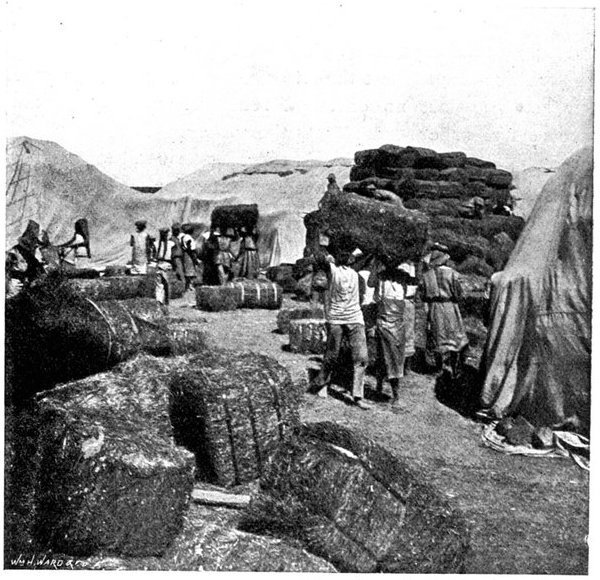
[Copyright 1900 by Underwood & Underwood.
HANDLING FODDER AT ORANGE RIVER CAMP.
The necessity for bringing up fodder for the horses from the immense
stores accumulated at Orange River Camp occasioned some delay in the
advance on Kimberley.
Sunset on the veldt.
Cronje's optimism.
All through the day, through the heat and dust, the Sixth Division had
been marching from Ramdam to the fords; it headed for Waterval Drift,
and its advance began to arrive with the supply train just as the
cavalry off-saddled. "That train crossing the dark veldt at sunset had
a weird beauty of its own," writes Mr. Battersby, the Morning Post
correspondent. "The evening was absolutely still and clear, and the
grey, soft smoke of dust, which every footfall lifted, clung about the
miles of waggons like a cocoon. Looking westward, where the train rose
over the roll of ground about the pan, the dust that drifted across the
sunset became a wondrous smoke of gold, filled with strange creatures
and monstrous shapes, black as a silhouette and spidery thin. The smoke
faded to rose, and from rose to silver, as the track sank into the
dark shadow of the down, and the beasts and carts which filled it took
again their own shapes and size." And as the Sixth Division moved up to
Waterval Drift, the Seventh with Lord Roberts entered Ramdam, and the
Ninth, acting as rearguard, approached Enslin. Only the First Division
now remained at Modder River Camp to watch Cronje and prevent him from
breaking out to the west or striking at the camp. Even now that the
British turning movement was making such progress, the Boer leader
obstinately clung to his belief that all it portended was an attack
upon Magersfontein by way of Jacobsdal, for which he was perfectly
ready, or, at the worst, an attempt to cut the communications of the
commandos operating at Colesberg; told Count Villebois de Mareuil, when
that worthy strove to alarm him, that he had been a soldier from before
Villebois was born, and knew what he was about; and he derided those
who pointed out the ominous clouds of dust far away to the south.
The cavalry push forward.
Feb. 13, 1900.] Advance of the Cavalry.
Early in the morning of the 13th Lord Roberts arrived to see the
cavalry march off. Delay had been necessary to obtain supplies and to
feed the horses, as their forage did not come in till it was broad
daylight. The Field-Marshal warmly praised General French and his men
for the skill and success of their movement. It was a most auspicious
opening to a splendid campaign, and filled all with renewed confidence.
The infantry, too, had indeed deserved well. The marching of the Sixth
and Seventh Divisions through the heat had[Pg 351] been superb, for though
the distance was not great, the tracks were sandy and exceedingly bad,
and the dust suffocating. In the best of spirits, about 11·30 a.m.,
the Cavalry Division moved off, with orders to cover a distance of
twenty-five miles and seize by nightfall the important fords over the
Modder River known as Klip Drift and Rondeval Drift. The lateness of
the start, though unavoidable, added greatly to the difficulty of the
task. The sun was already high and the heat great as the horsemen went
forward over the plain in magnificent array. Behind them the advance
brigade of the Sixth Division was already marching out, to follow in
their wake to Wegdraai, a farm with good water, half way between the
Riet and Modder. Behind this brigade again, the rest of the Sixth
Division and the whole of the Seventh Division were nearing Waterval
Drift, and the Ninth Division was on its way to Ramdam.
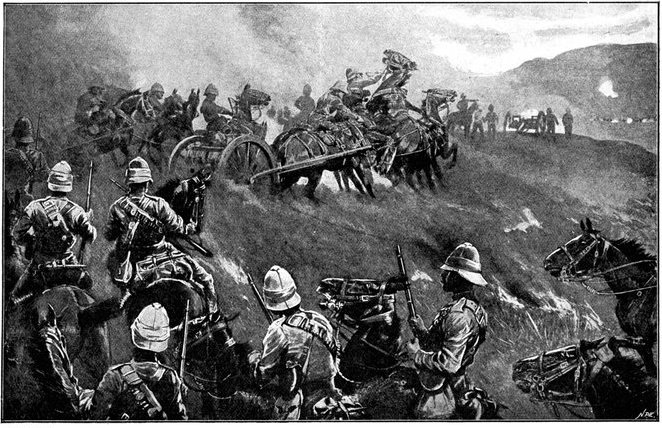
J. Charlton.]
BETWEEN TWO FIRES: THE ENEMY'S AND THE BURNING VELDT.
Heat and thirst.
Veldt on fire.
[Feb. 13, 1900.
Laying a field cable as it advanced, the Cavalry Division turned on
its northward sweep, and soon after noon sundered the telegraph wires
which connected Jacobsdal with Bloemfontein. Patrols were pushed out
towards Jacobsdal and ascertained that this place was held in no great
strength. At Wegdraai was a splendid well full of cool water, but the
orders were peremptory that it was to be left for the Sixth Division,
and so, notwithstanding heat and thirst, the column had to move on,
though this was the only well on the arid plain between the Riet and
Modder. The horses now began to show signs of great suffering, as
well the poor beasts might, for there was neither shade nor verdure
to break the intensity of the heat and vary the monotony of the dull
brown steppe. The veldt grass was parched and brown—as brown as the
veldt itself—and presently, some troopers, dropping matches in it
as they passed, set it ablaze. A great sheet of flame swept with the
wind behind the cavalry, but as the men rode faster than the fire
could travel, little heed was paid to the conflagration. By this fire
the field telegraph was destroyed and communication with Lord Roberts
lost, while the heat and smoke it caused were further sources of trial.
It was only because the Boers offered no serious resistance that the
results were not far worse. At one point the scouts were suddenly
driven in, and almost without notice heavy firing broke out. The
British line was taken between two fires, and choosing to perish by the
shots[Pg 352] of the Boers rather than in the flames, dashed forward, when the
enemy fled; but for some instants matters looked critical. The front
covered by the cavalry as it went forward was one of enormous extent.
"From flank to flank," wrote Captain Boyle, a Yeomanry officer with
General French's headquarters, "the distance was so great that at times
the General's gallopers could not move their horses out of a walk,
though the message was important." Horses were dropping out right and
left, the artillery in especial suffering.
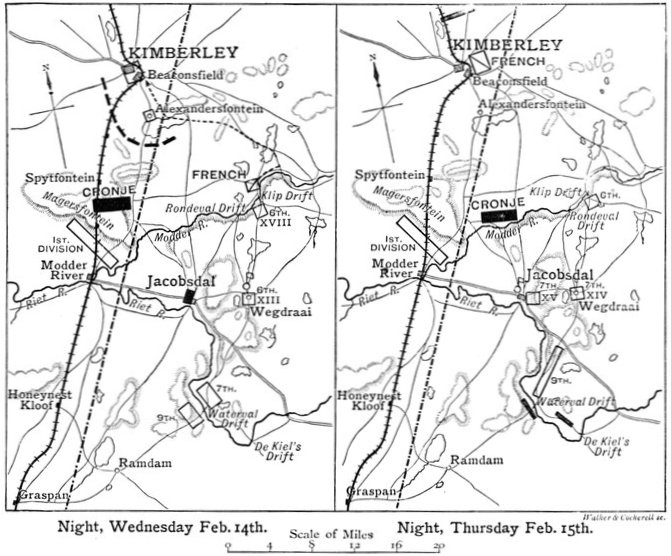
Walker & Cockerell sc.
Night, Wednesday Feb. 14th. Night, Thursday Feb. 15th.
Rondeval and Klip Drifts seized.
And now, about 5·30 p.m., the goal of the day's march came into
view. To the north could be seen a line of dreary green—the bushes
which fringe all South African rivers. General French went forward
to reconnoitre, halting his division and changing its formation.
Gordon's Brigade was deployed on the left, Broadwood's on the right,
and Alexander's ordered to follow as a rearguard. It had already
dropped much behind and had lost no less than sixty of its horses.
A few minutes' examination and reflection convinced General French
that the wisest course was to push on rapidly for the drift, even
though there were clear traces of the enemy, and though a Boer laager
could be seen by the stream. Gordon on the left was to seize Rondeval
Drift, Broadwood to take Klip Drift. Each Brigadier unlimbered his
horse guns and shelled the enemy before crossing. But there was no
real resistance; the Boers, aghast at the rapidity and resolution of
General French's movements and staggered by the shrapnel from the
Horse Artillery 12-pounders, fled in utter confusion, abandoning
three laagers, 150 waggons, much ammunition, and a quantity of
cattle and sheep. "Some of the larger cases in the Boer camp, marked
'biscuits,' of which there was a regular stack, were found to contain
rifle ammunition," says a correspondent with the division. "The marks
on the cases showed that they came from Europe viâ Delagoa Bay."
The telegraph line from Magersfontein to Bloemfontein was broken,
and Cronje left without other means of communication than those the
heliograph afforded. Thus the Modder Drifts were won, and now the way
to Kimberley was all but open. The seizure of the drifts was, in the
judgment of a competent officer, the crisis of the whole elaborate
series of movements which ended a fortnight later in the glorious
success of Paardeberg. For if General French had waited or hesitated,
the Boers would have called up reinforcements and a desperate fight
would have been necessary before the river could have been crossed.
And in the delay which must thus have been caused, Cronje might well
have escaped. General French had risked much, since, so far as he
knew, the Boers had 6,000 to 7,000 men along the Modder line and at
Magersfontein, while no support could reach him until, at the earliest,
the evening of the 14th. His total losses did not exceed half-a-dozen
officers and men, and about 100 horses.
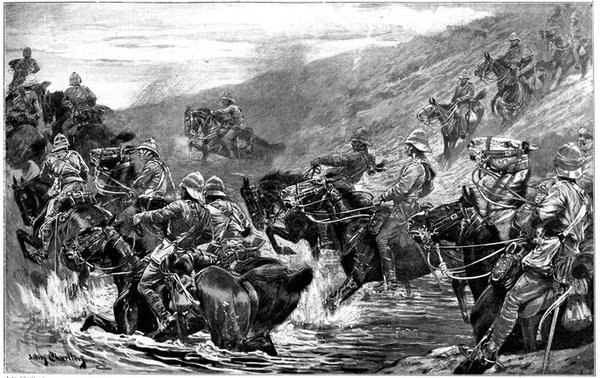
John Charlton.] [From a sketch by G. D. Giles.
THE RUSH TO KIMBERLEY: THE 10th HUSSARS CROSSING KLIP DRIFT.
Advance of the infantry.
[Feb. 13-15, 1900.
Behind him the infantry divisions continued to push steadily forward
through the burning heat. At nightfall the 18th Brigade of the Sixth
Division was at Wegdraai, half way between the Riet and Modder, the
13th Brigade at Waterval Drift, the Seventh [Pg 353]
[Pg 354]Division with Lord
Roberts at De Kiel's Drift, and the Ninth Division at Ramdam. So
trying was the march, that from De Kiel's Drift fifty-seven officers
and men had to be sent back to the rear in ox-waggons, prostrate with
heat and exhaustion. On the evening of the 13th Cronje was still at
Magersfontein, though the severance of his telegraph wires must have
caused him great uneasiness.
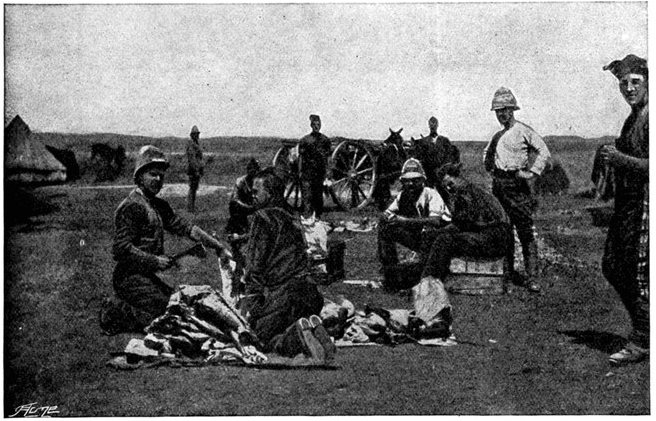
BUTCHERS WITH GENERAL FRENCH'S FLYING COLUMN.
Halt at the Modder.
As General French's cavalry bivouacked for the night on the banks of
the Modder, a tremendous dust storm swept over the country, hiding
every feature from sight. Under cover of it the Boers must have moved
down, for when night fell their pickets were in touch with ours on
the north bank of the river. As it was vital to economise supplies,
the cavalrymen were rationed from the cattle captured in the Boer
laagers. It was decided to rest all the 14th for two reasons—because
the horses were exhausted, and because it was considered necessary that
the infantry should arrive and hold the drift before the cavalry left
for Kimberley. Meantime the soldiers rioted on the hot bread, poultry,
and fruit captured in the Boer camps, bathed in the river, and examined
the strong position at the drift, which the Boers had so unaccountably
abandoned. A good deal of skirmishing went on all day; the Boers
brought up guns and shelled one of the British camps on the north of
the stream, but were driven off by the Horse Artillery. It was clear
that they were becoming uneasy as to their communications; but Cronje
delayed and hesitated, and that day's indecision destroyed him.
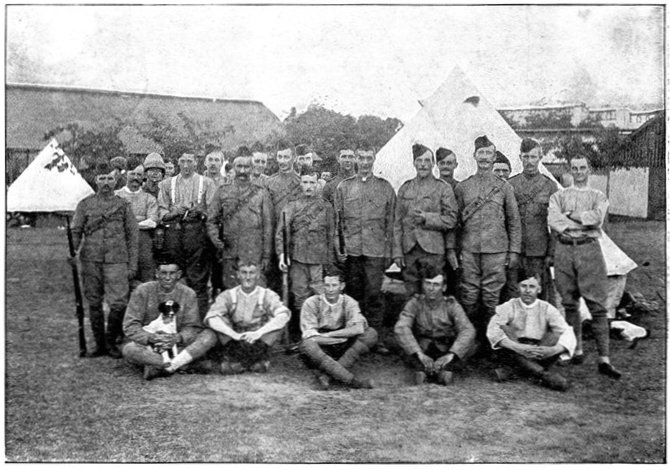
PART OF THE IRISH SQUADRON OF ROBERTS' HORSE.
Feb. 15, 1900.] Drawing near Kimberley.
Messages had been sent back by General French begging that the infantry
might hurry forward, and very late in the night of the 14th-15th the
advance[Pg 355] brigade of the Sixth Division, with Lord Kitchener, General
Kelly-Kenny, and three field batteries, marched in. They were guided in
by Captain Laycock, who rode out alone to find Lord Kitchener, and who
was sniped at everywhere in the darkness. With early morning the rest
of the Sixth Division arrived, hot and weary. Of the other divisions,
the 15th Brigade of the Seventh Division was moving on Jacobsdal, the
14th of the same division on Wegdraai, and the Ninth Division just
beginning its northward march from De Kiel's Drift. The First Division
still observed Magersfontein. All along the line of march small parties
of Boers were in touch with the British troops, and great caution had
to be observed. That afternoon people in Kimberley watched with curious
interest what looked like great columns of smoke on the plains near
Jacobsdal. It was the dust raised by the British army on its march to
their relief.
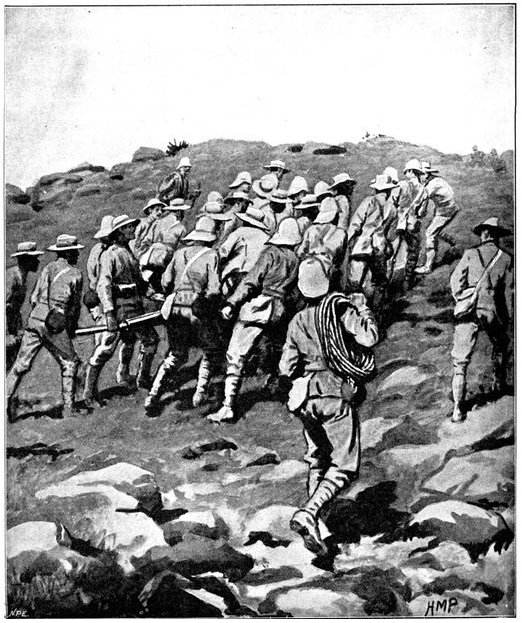
H. M. Paget.] [
From a sketch by G. D. Giles.
BRITISH BLUEJACKETS CARRYING THEIR GUN.
Wheel of the carriage of a 12-pounder gun collapsed, whereupon the
sailors lifted it from its carriage and hauled it to the top of a
kopje, a distance of two miles.
[Feb. 15, 1900.
Cavalry opposed.
On the morning of the 15th Lord Kitchener and General Kelly-Kenny
rode round the cavalry camps. The field batteries and two naval guns
replaced and set free the Horse Artillery. One of the naval 12-pounders
was stationed upon a kopje overlooking the drift, after an incident
which well illustrated the resourcefulness of our bluejackets. "On
moving the gun," says a correspondent, "one of the wheels collapsed;
but the sailors lifted the gun from its carriage, and hauled it
a distance of two miles to the top of the kopje. It was a great
performance, and well deserved the thanks which Lord Kitchener conveyed
to them." The tired infantry went on outpost duty instead of the
cavalrymen, and after breakfast the three cavalry brigades and the
seven horse batteries drew up and moved out with definite orders to
reach Kimberley that night. The sight, as the endless line of cavalry
rode off across the veldt, about 9 a.m., was a very fine one. On the
left was Broadwood with his Hussars, Lancers, and heavy Household
Cavalry; in the centre was General Porter, just arrived, with his
Dragoons; on the left Gordon with the Lancers' gay pennons and the
more sombre squadrons of Roberts' Horse. Scarcely had the line left
the river—heading[Pg 356] directly to the east with the object of deceiving
the enemy, and leading them to suppose that the object of the ride was
Bloemfontein rather than Kimberley—when a Boer gun opened fire on the
British left, sending several shells among the cavalry. At once two
batteries of Horse Artillery went rattling to the front, deployed,
and returned the fire. The three field batteries from Klip Drift also
pushed out to support General French. The Horse Artillery suffered
considerable loss, thirteen officers and men being killed or wounded.
The cavalry extended to the right, when from kopjes on the left front
as well as the left flank and left rear came a heavy fire from what
was evidently a large force of Boers; on the right front upon a kopje
the enemy also showed in some strength. It was now that General French
had an opportunity to show his skill and generalship. Without any
hesitation he gave General Gordon orders to charge with his men and
clear a nek between the kopjes. The nek was about 2,500 yards wide,
smooth, and level. At the same time the Horse Artillery was ordered to
scourge the kopjes with shrapnel.
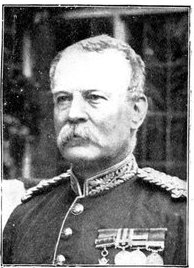
BRIG.-GENERAL J. R. P. GORDON.
Joined the 15th (King's) Hussars as 2nd Lieutenant in 1879, when he was
18 years of age, and served in the Afghan War of 1880; Lieutenant and
Adjutant in 1881; served in the Boer War of that year, the Bechuanaland
Expedition of 1884-5, in Burma 1887, Lagos 1892, and Ashanti 1895-6;
Captain 1888, Major 1895, Lieut.-Colonel 1897; appointed to the command
of the 3rd Brigade of the Cavalry Division in South Africa, with local
rank of Brigadier-General, Feb. 1900.
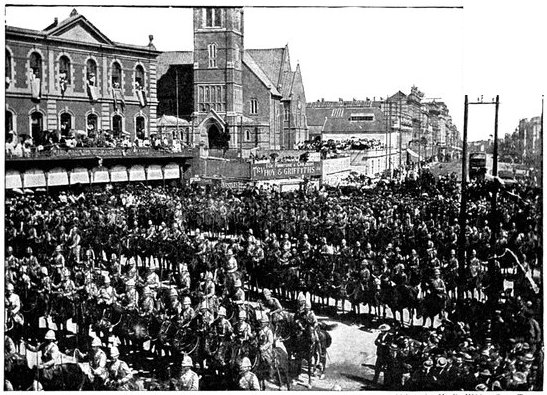
[Photo by H. B. White, Cape Town.
RECEPTION OF THE
16th LANCERS, CAPE TOWN.
The 16th Lancers, who did such excellent work on February 15, were
dispatched from India to South Africa on the application of Lord
Roberts. On their arrival at Cape Town a request was made that the
regiment should march through the town. The request was granted, and
the fine regiment, whose list of battle honours is surpassed by no
other cavalry regiment, and equalled only by one, was received with the
wildest enthusiasm.
Lancers clear a nek.
Feb. 15, 1900.] In
Sight of Kimberley.
Gordon's men swept into line and thundered off, in dense clouds of
dust, the dreaded 9th and 16th Lancers with their lances ready, and
General French ordered his two other brigades to follow at a gallop.
The cavalry avalanche broke upon the Boers with terrible vehemence;
those who had not mounted their ponies and precipitately ridden off,
were caught by the glistening steel of the lances, and there were
some grim scenes in the brief seconds of the hand-to-hand encounter.
It was well known that the Boers on their part rarely gave quarter to
Lancers, whom they especially dreaded, and shot down mercilessly when
they could. The cause was some story told by a romancing Lancer private
after Elandslaagte—that he had stuck prostrate Boers "like pigs." Some
fifty Boers were killed or wounded in this charge, and the general
effect upon the enemy was thoroughly to demoralise them. The Lancers
pushed on five miles in their furious gallop, maintaining, however, the
most perfect order, and then were halted to allow the Horse Artillery
guns to come up. Broadwood's[Pg 357]
Brigade pressed on yet further, and secured the débouché from the long
nek upon the plains which surround Kimberley. The gate to Kimberley had
been won.
The British losses in this dashing movement were ridiculously small.
Less than a dozen men were killed or wounded. At a deserted farm an
excellent well was discovered, and the men were able to quench their
thirst; unhappily there was nothing for the horses, which were much
exhausted. The night of the 14th-15th had been marked by one of those
tropical downpours, so common in the rainy season, and the surface of
the veldt was in consequence slushy and wet, trying the artillery and
cavalry horses more than ever.
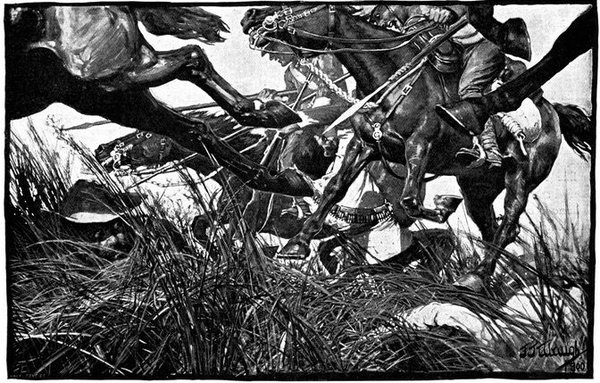
F. J. Waugh.]
A CHARGE OF LANCERS, FROM THE BOER POINT OF VIEW.
In touch with Kimberley.
Capture of Alexandersfontein.
And now, about 3·30 p.m., as a ridge was breasted, far away over the
plain the tall chimneys and mine gear of Kimberley came into sight.
The column broke into a tumult of cheering. On the extreme left
could be seen the kopjes of Magersfontein; over the veldt sounded
the heavy booming of guns, and from time to time the puffs of smoke
from bursting shells showed that an artillery fight was in progress.
Broadwood moved off to the left with orders to demonstrate to the
enemy that the British cavalry were behind them. General French, with
the heliographers, climbed a small kopje on the right and set to
work to open communication with the besieged garrison. For long his
heliograph winked and flashed without attracting any notice, and all
grew impatient. Then at last came an answering flash. But the garrison
took General French's division for a force of Boers, and replied to
his anxious signals with chaff, such as the signallers of the two
opposed armies often exchanged. They lavished upon him a great deal
of fictitious detail, until presently it dawned upon them that the
British cavalry were in truth approaching. Then at last they informed
General French that they had captured Alexandersfontein, a point seven
miles from Kimberley and only five miles from the cavalry, and that the
direction by which he was advancing was the best. Already, far away,
the note of cheering came over the veldt. The British troops holding
Alexandersfontein were rejoicing at the coming of their comrades.
[Pg 358]
[Feb. 15, 1900.
Entry into Kimberley.
The onward movement was speedily resumed. Two squadrons were ordered
to push on with all possible speed into Kimberley itself, and before
them the enemy were seen to be galloping off to the east as fast as
Boers could go. To cut off their retreat, if possible, General French
swerved to the right, when suddenly a Boer gun to the east of Kimberley
opened a sharp fire. General Porter at once brought up his horse guns
and replied, but the enemy had no stomach for a fight. They hastily
fell back, taking with them their gun, and unfortunately the British
horses were too exhausted to pursue. Far away from the north at Kamfers
Dam was heard the heavy note of the great Boer 6-in. Creusot, still
showering its deadly bolts upon the town, in ignorance that its prey
had already as good as escaped. Then, as night fell, and the array of
troopers and guns entered into the town, weary, thirsty, sweating, but
conscious of a deed done that would ring through the world and fill
with exultant joy the British race, the sullen boom of this weapon
ceased also, and peace returned to Kimberley.
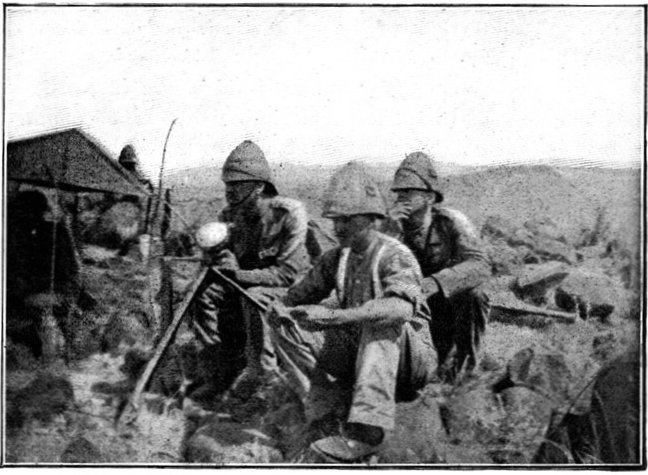
COLONEL RHODES HELIOGRAPHING TO HIS BROTHER, Mr. CECIL
RHODES, BESIEGED IN KIMBERLEY.
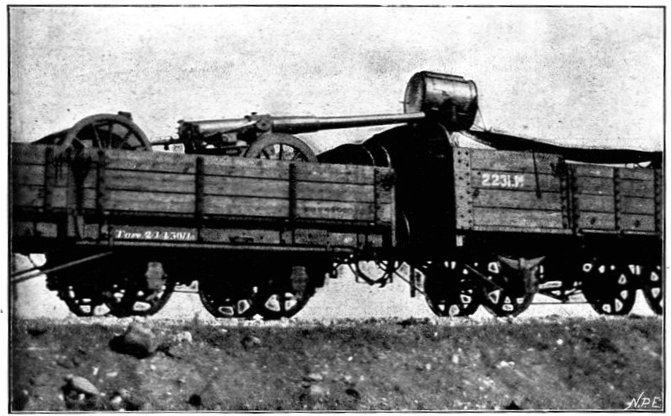
THE NAVAL SEARCHLIGHT WHICH TALKED WITH KIMBERLEY DURING
THE SIEGE, AND ONE OF THE 12-POUNDER NAVAL GUNS.
Thousands were already pouring into the streets to greet the British
cavalry and their gallant leader. Perhaps some were disappointed in
the silent, small, undemonstrative man who trotted awkwardly in—for,
like Napoleon, General French was not a showy horseman—seemingly
unconscious that he had achieved something which would be for ever
remembered in military history. Yet with this man rested the honour of
the march. "It should never be forgotten," writes a soldier who rode
with him, "that what decided the fate of the day was the General's
masterly decision in the early morning to cut his way through what then
seemed to be an almost surrounding of us by the enemy, and, instead
of losing time by waiting to fight them, to leave them and risk their
being on our flank and rear for the rest of the day." An even greater
result than the relief of Kimberley was the demonstration which this
march afforded of the fact that the Boers were helpless against flank
attack by a mobile cavalry. The Boer tactics suddenly collapsed now the
day of frontal assaults was over, and in that hour the danger to the
British Empire passed away.
Bivouac in a Boer camp.
Feb. 15, 1900.] Seizure of Jacobsdal.
In the final rush another Boer laager was captured, with a great
quantity of stores and ammunition. The bulk of the British force
bivouacked in or near this camp, where there was a good supply of
water; only General French and some hundreds of his men entered the
delivered city. It still remained to be seen whether Kimberley was
really free, or whether,[Pg 359] as Boer sympathisers inside and outside the
town pretended, General French had simply walked into a trap set by
Cronje.
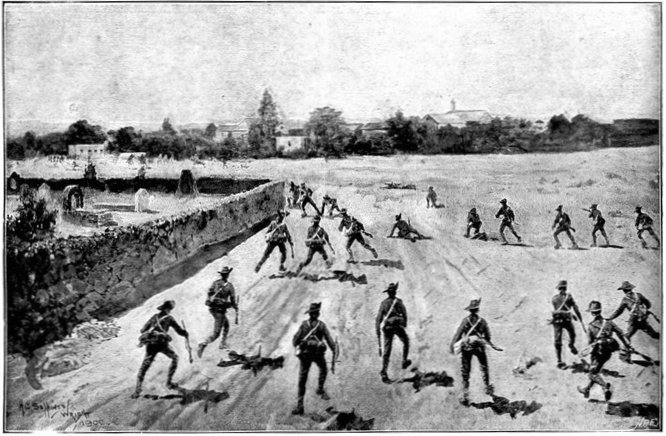
H. C. Seppings Wright.] [After a sketch by Fred
Villiers.
THE CITY IMPERIAL VOLUNTEERS' BAPTISM OF FIRE.
C.I.V.s' baptism of fire.
Seizure of Jacobsdal.
[Feb. 15, 1900.
On the morning of the 15th the general advance of the Seventh and
Ninth Divisions had been resumed. The 15th (Wavell's) Brigade of the
Seventh Division was directed upon Jacobsdal; the other brigade and
the Ninth Division began their march to join the Sixth Division at
Klip Drift. Jacobsdal was not seized without a brush with the enemy.
On the 14th it had been visited by our patrols and found unoccupied,
but with the hospitals full of British and Boer wounded. On their way
back the patrols were attacked by the Boers, and nineteen men wounded
or captured. They had come into contact with a small detachment sent
by Cronje to hold the village. Early in the afternoon of the 15th, the
15th Brigade approached the place. It was a small, peaceful-looking
village of white houses, bowered in green trees, pleasant of aspect
amid the arid brown expanse of the treeless veldt. But it soon began
to wear another and far less peaceful aspect. The British advance was
covered by a cloud of scouts drawn from the City Imperial Mounted
Infantry Volunteers. They were within 800 yards of the village, when
suddenly a terrific fire was opened from gardens on the outskirts.
The sergeant-major in charge of the party and two privates were
wounded. The men behaved with great steadiness and bravery upon this
historic occasion—the first time that a Volunteer Force had been
under fire. But the Boer resistance could not be maintained in the
face of a British brigade 4,000 strong. The 75th Field Battery was
brought up, the town was shelled, and the enemy hastily retired towards
Magersfontein and Cronje's entrenchments. Lord Roberts arrived, and
at the head of his troops made his entry. There was no looting or
plundering. The British Army, always famous for its rigid discipline
in war, filed in in perfect order, and paid for everything which it
took. Military police patrolled the streets; sentries stood in front
of every store. The hungry and thirsty khaki-clad men bought up all
the bread and milk that they could get, and the Boers began almost
to bless a war which had brought them such customers. They had[Pg 360]
expected merciless treatment, for the Boer Governments, to stiffen
their people's resistance, had studiously spread the report that where
the British came they ravished, plundered, and destroyed. The wives
of the burghers, however, avenged the invasion of the Free State by
the exorbitance of their prices, and thus turned the tables upon the
conquerors. One of Lord Roberts' first acts was to visit the large
German hospital which was established in the village. In it he found 37
British wounded; all the arrangements were admirable in the extreme.
Indeed, if more than one British officer can be believed, in comfort
and attention to the suffering it far outdistanced the British field
hospitals.
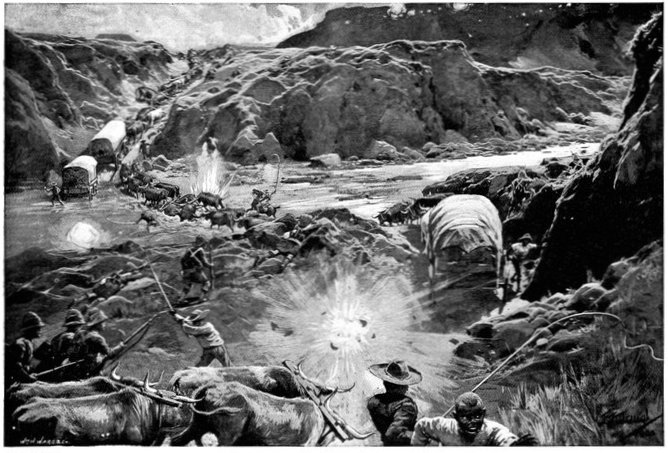
F. J. Waugh.
THE LOSS OF THE CONVOY AT WATERVAL DRIFT.
Feb. 15-17, 1900.] Loss of a Convoy.
Convoy attacked by De Wet.
In the rear of the grand army marched a convoy of over 200 waggons,
laden with immense quantities of stores, forage and provisions for the
army, and drawn by over 3,000 head of oxen—a month's supplies for
a force of 40,000 men. They were in charge of a quite small escort,
composed of a company of Gordons and eighty mounted infantry. The
convoy had moved slowly behind the army, where, it was thought, no
danger was to be feared, from Ramdam to Waterval Drift. At Waterval
Drift it began its crossing of the river under cover of the Ninth
Division, some 10,000 men strong. But the drift was of such an
execrable nature that its passage by the enormous train of waggons
was a matter of many hours, and at this moment, when troops might be
wanted, and badly wanted, on the banks of the Modder, time could ill
be spared. The banks of the Riet at Waterval, as is common with South
African streams, were steep; at the bottom lay the river bed, 100 yards
wide, with only a trickle of water in the centre and everywhere else
soft sand three feet deep, in which the waggons sank up to their axles,
inflicting the most prodigious labour upon the teams of oxen and mules
that dragged them. Three teams had regularly to be employed to drag
each laden vehicle up the northern bank, which meant that two waggons
had to stand still for each one that moved. And thus it came to pass
that after hours of waiting, the Ninth Division marched off before the
crossing was nearly completed. The convoy was left to its diminutive
escort. "There are no Boers in the country," said everyone.[Pg 361] Yet at
this very moment De Wet with a party of about 1,000 men, summoned from
Colesberg to Cronje's help, was riding up the Riet from the squalid
hamlet of Koffyfontein. A great way off he saw the dust and heard the
tumult of shouts and cracking whips that proceeded from the convoy,
and, after reconnoitring and discovering that there was no British
force near capable of resistance, opened a tremendous fire, just after
9 a.m.
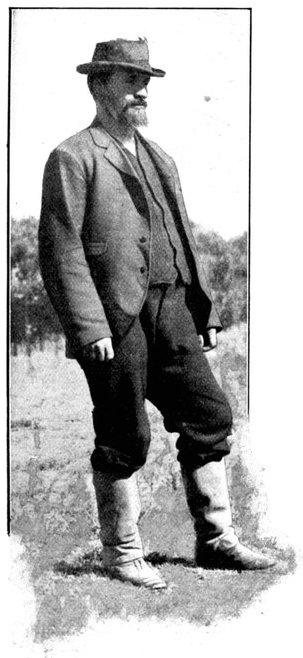
COMMANDANT CHRISTIAN DE WET.
The Gordons at once extended and replied, while the officer in charge
of the convoy telegraphed to Lord Roberts detailing his position and
asking for reinforcements. Some squadrons of Kitchener's Horse, the
1st Scottish Borderers, and a battery of the Seventh Division were
promised, and, though well on the way to Wegdraai, received orders
to march back with all speed. But already the Boers had brought up
guns, and were playing upon the convoy with deadly effect. The oxen
were falling fast, though the men did not suffer so much, being under
cover. But when at last the boom of the British field battery to the
north told that relief had arrived, the Boers ceased their bombardment,
and could be seen falling back. Kitchener's Horse now came up, and
attempted, but without complete success, to turn the Boer flank. The
convoy had been saved—for a time. All that were left of the oxen were
at once sent down to the river to be watered, a difficult process with
so many beasts when the drivers could not be found. But as they came up
again from the river a fresh mishap occurred. The Boers again opened
fire, killed or drove away the men in charge, and the animals forthwith
went grazing along the river banks, direct towards the enemy. Attempts
were made unsuccessfully to head them off, but only a few could be
saved. Of the 200 waggons, 176 were left helpless for want of cattle.
Waggons abandoned.
Lord Roberts learned these facts and made his decision. Should he save
the convoy with its immense stores, and perhaps allow Cronje to escape,
or should he sacrifice everything to the destruction of Cronje's army?
Many generals would have wavered; the risk of continuing the advance,
with what appeared to be a strong mobile Boer force well supplied with
artillery in his rear, was no pleasant prospect, and if anything went
wrong might prove simply disastrous. But Lord Roberts had learned that
nothing great can be achieved without risk. He issued orders to the
small force with the waggons to abandon them under cover of darkness
and steal away. No lights were to be shown and no noise made. At 2
a.m. of the 16th the escort began its retreat. To crown the list of
misadventures, half-a-dozen men of the Gordons and some small parties
of stragglers were not warned of the withdrawal. Next day they were
captured by the Boers, who carried off or burnt the 176 abandoned
waggons.
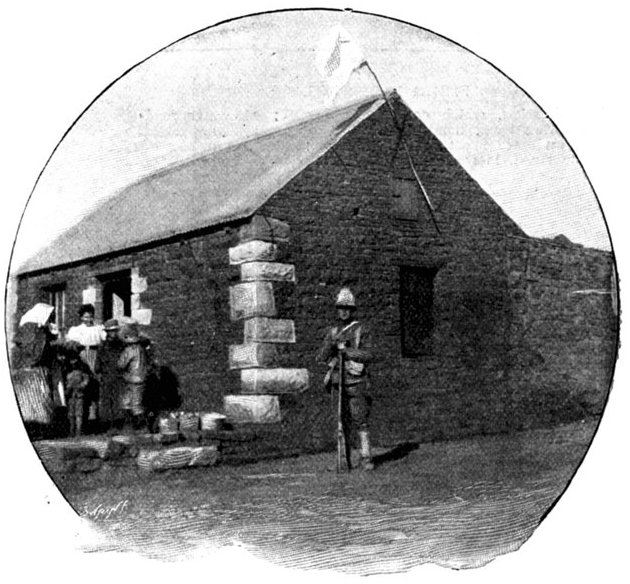
A BOER FARMHOUSE FLYING A WHITE FLAG.
A British soldier on guard to prevent looting.
The loss of the convoy was a blow the effects of which were felt all
through the march to Bloemfontein, as the forage, stores and provisions
it contained could not be replaced without grave delay. Who was to
blame for the utter inadequacy of this escort, it is impossible as yet
to ascertain.
[Pg 362]
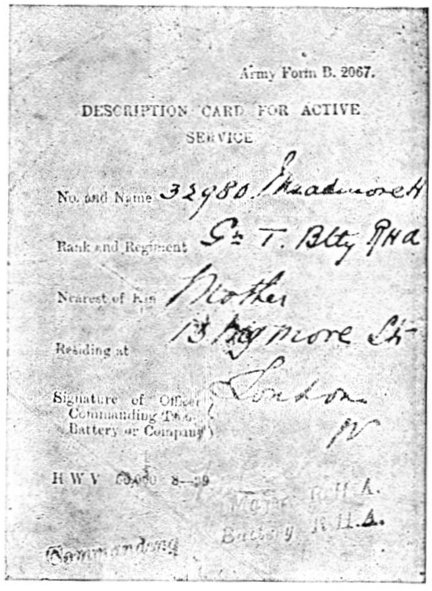
DESCRIPTION CARD.
Carried by every soldier sewn into the lining of his jacket. It is of
white glazed calico.
[Feb. 15-16, 1900.
Cronje's retreat.
All through the 15th the Sixth Division had been engaged in skirmishing
with the Boer force through which General French had cut his way.
This force hung about the drift, and exchanged fire at long range,
but though its "sniping" caused some annoyance, it was too weak to
effect anything serious against a whole infantry division, with three
batteries of artillery. At Magersfontein, Cronje had now at last
arrived at the decision to retreat. Already burghers were riding off
right and left, in a wild helter-skelter, heedless of commands and
orders. What little discipline existed in the Boer camp had been
greatly weakened by the presence of the enemy in the rear. About noon,
at the instance of the Field Cornets, a council of war was summoned.
High words were exchanged between Cronje and the European adventurers,
who pointed out the peril of each instant's delay. But the final
vote was for retirement, mainly through the insistence of the Free
Staters, who were full of fear for their cattle and their farms. All
outposts were withdrawn, and with the utmost precipitancy the burghers
were called in from the trenches. The Boers abandoned everything
except the essentials—food, ammunition, and the waggon train—and
received orders to march with dawn along the Modder River, in the
direction of Bloemfontein. What had led Cronje to this determination
was the sight of General French's division scudding across the plain
to Kimberley, and the columns of dust that rose in all directions on
his left, betokening Lord Roberts' march. But his rooted opinion that
the British could never move a large force away from the railway, his
persistence in the belief that the object of all the British manœuvres
was another assault on Magersfontein—this time from the direction of
Jacobsdal—and his failure to seize the true purpose of the British
Commander-in-Chief, had already undone him. In spite of frantic efforts
it was now all but impossible for him to escape from the net which
Lord Roberts had so skilfully spread. Nor was his force anything like
so strong as the British officers opposed to him had believed. Instead
of eight or ten thousand it had melted in the last few hours till it
probably did not exceed at this juncture 5,000 men. About these were
fully 26,000 British infantry and over 7,000 mounted men. The odds were
such as to render the struggle all but hopeless.
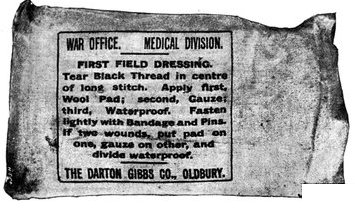
FIELD DRESSING.
The dressing, which consists of a sheet of waterproof, gauze, cotton
wool, bandaging, and two safety pins, packed first in an extra sheet
of waterproof and then in a bag of lining material, is sewn into one
of the bottom corners of the jacket of every man who goes on active
service, the description card occupying the corresponding corner on the
opposite side.
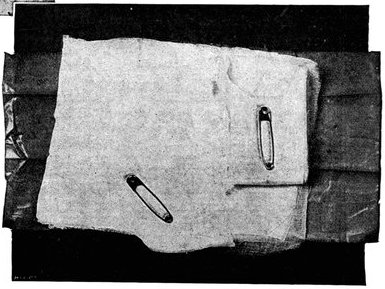
Feb. 16, 1900.] Cronje's Retreat.
Just before dawn Cronje's army fell back from Magersfontein—the
position which for now more than two months had held the army of Lord
Methuen in complete check. So skilfully was the[Pg 363] operation effected
that no sign of the Boer retreat was detected by Lord Methuen's
Division, closely watching the enemy's trenches, till the bird had
flown. But as the day wore on, the scouts and pickets noted that the
place look deserted, and that there seemed to be no one about. They
pushed carefully in, examined the works more closely, and, as no
shots were fired at them, grew in audacity. Finally they entered the
trenches, and brought Lord Methuen word that the position had been
abandoned. He at once advanced to Magersfontein with his division, and
thus, without striking a blow or firing a shot, opened the way from the
south to Kimberley.
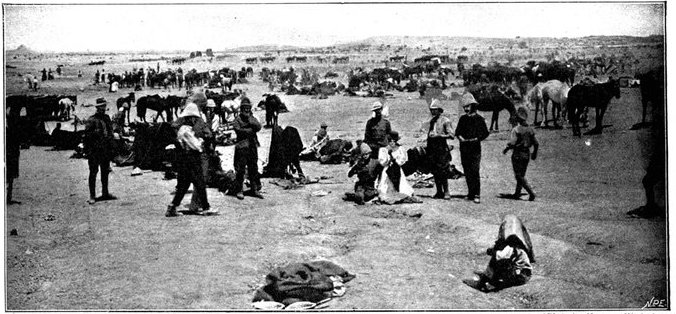
[Photo by Hancox, Kimberley.
GENERAL FRENCH'S TROOPS BIVOUACKING IN THE BOER LAAGER OUTSIDE
KIMBERLEY.
The state of the Boer trenches gave clear evidence of the haste with
which the enemy had retreated. Mr. Ralph, who examined them, gives
this interesting description:—"The Boers had gone away in such a
hurry that they had no time to take their belongings with them.
Evidently the order was 'every man for himself, and no time must be
lost.' Consequently the position was littered with trunks, saddles,
tin boxes, bags of mealies, of mealie flour, and of rice. Cartridges
were as thickly strewn about as if they were as cheap as dead leaves in
autumn. Blankets and clothing were also much in evidence. In places the
frightened Boers had made an effort to hide their leavings by piling
them in the trenches, and then throwing skins or canvas over them, and
dirt and tree branches on top of all. In their trunks we found usually
only clothing and letters. Much that they had been using was of British
make, largely taken from the British dead. Dozens and dozens of bullock
hides were in use there, for shelters and for coverings. These had been
taken fresh from the backs of the cattle, and the sun was making them
fizzle and bubble, frying the fat and tissue on the underside of each,
so that they exhaled a nauseating stench. But this formed the least
part of the effluvia. A plague of flies helped to make the pest spot
still more unendurable. From every shelter, and pole, and bush hung
strips of biltong (jerked beef or venison), for they had not dared to
stop even long enough to take away this main staff of their lives."
The Boers carry off their big gun.
[Feb. 16, 1900.
To the north of Kimberley a considerable force of Boers, with the great
gun from Kamfers Dam, was in full retreat, though much troubled by the
unwieldiness of this weapon. Anxious if possible to capture it, General
French had started out at 3·30 a.m. of the 16th with all available
men and guns. His horses were in such a state that rapid movement was
out of the question. He rode due north, followed by the infantry in
the town, who came on by rail, and got as far as Macfarlane's Siding,
two stations north. Continual skirmishing with the Boer rearguard was
the chief feature of the day, and the cavalry engaged suffered some
casualties, about a dozen men being killed or wounded. The horses
were too worn out to get near the big gun, and the Boers succeeded
in carrying it off, but they had to abandon[Pg 364] a laager at Dronfield,
with one gun, several waggons, and a great quantity of stores. In the
British division neither men nor horses had food or water from early in
the morning till late at night, and the suffering of all was terrible.
The horses in particular, already sorely tired by their 150 miles'
ride from Modder River Camp to Kimberley, began to drop right and left
in the most alarming manner. Those that still staggered on were mere
bundles of skin and bone, in the most urgent need of a week's rest and
food, which, however, was not to be theirs.
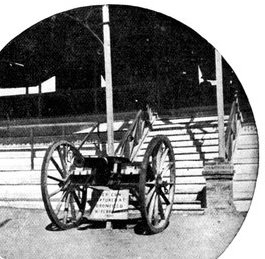
THE BOER GUN CAPTURED AT DRONFIELD.
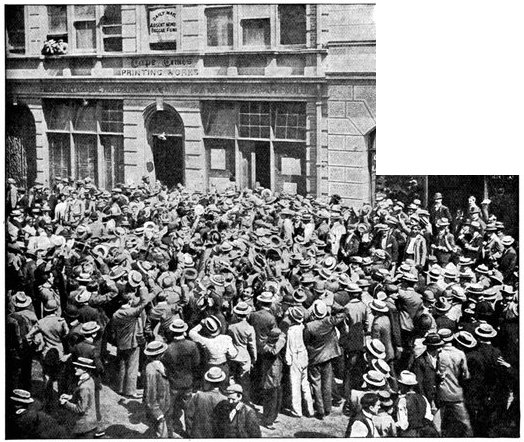
RECEPTION IN CAPE TOWN OF THE NEWS OF THE RELIEF OF
KIMBERLEY.
Orders to head Cronje.
Already a messenger had come in from the south-east to say that
Cronje's force was moving swiftly along the Modder, had destroyed the
field telegraph, and was engaged with the British infantry at Klip
Drift. But no confirmation of the intelligence and no order from the
British headquarters as yet reached General French, nor did he hear the
sound of guns. He concluded therefore that the report was erroneous or
at least premature; moreover, the state of his horses rendered another
long ride back to Klip Drift all but impossible of immediate execution.
He gave his staff leave to sleep late into the morning, after their
four days of continuous hard work, and himself retired to sleep the
sleep of the just, when an order of the highest importance from Lord
Kitchener arrived. It stated that Cronje was in full retreat from
Magersfontein, with all his waggons, baggage, and four guns, along the
line of the Modder to Bloemfontein, that Lord Kitchener had already
engaged him, and if General French, with every available horse and man,
could head him and prevent his crossing the river at the Paardeberg
Drifts, the infantry from Klip Drift would follow with all speed,
overtake him, and surround him. Such a message admitted of no excuses
or delays—not that General French was the man for either—and orders
were at once issued for the only brigade available and three batteries
to start with the dawn. But it is now time to turn from General French
and his doings to the tale which the people of Kimberley had to tell
him.
END OF VOLUME I.
⁂ For revised figures of losses, and some corrections, see Preface.
[Pg 365]
Silently corrected simple spelling, grammar, and typographical errors.
Retained anachronistic and non-standard spellings as printed.
Applied errata listed on p. vi to the main text.
*** END OF THE PROJECT GUTENBERG EBOOK 48534 ***


